







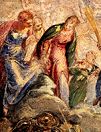





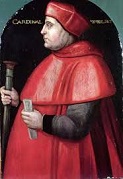


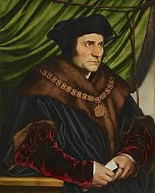





















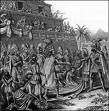



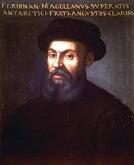

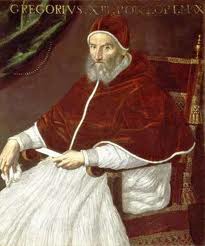















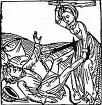












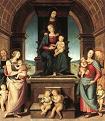

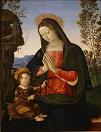


1500 World pop: 425M-540M; Peru: 10M; Dresden: 2,565; after the 1453 fall of Constantinople, Venice has 4K Greek immigrants, making it "another Byzantium" (Johannes Bessarion). 20K+ die of the plague this year and last in London. The Norse pop. of Greenland disappears by this year. The English Era of Expansion begins (ends 1648) as surplus agriculture begins in England, causing it to climb out of famine and launch frontier settlement throughout the world. According to Am. historian Norman Frank Cantor (1929-2004), this year marks the end of the Medieval Era or Middle Ages; "A high and strong culture is declining, but at the same time and in the same sphere new things are being born. The tide is turning, the tone of life is about to change" (Johan Huizinga); Europe begins to be run by bureaucratic monarchies. Between this year and 1800 Europe is at war 270 years out of 300? By now Spanish gold mines are producing $1M worth of gold annually; as treasure pours into Spain, however, prices rise. It takes until the year 1750 for the human technical knowledge in this year to double, according to French economist Georges Anderla (1921-2005); last in 1 C.E. On Jan. 26 Brazil (named after brazilwood, which produces a valuable red dye) is discovered by Spanish sailor Vicente Yanez Pinzon (1461-1513) in a 4-ship fleet at Cape Santo Agostinho (Cabo Santa Maria de la Consolacion) near Cape Sao Roque; his four ships then turn NW and discover the estuary of the Amazon River 4 mo. later, mistaking it for the Ganges River and naming it Rio Santa Maria de la Mar Dulce; Pinzon then sails between Trinidad and the mainland and reaches the Gulf of Paria in Venezuela on May 1, then turns N, passes the Windward and Leeward Islands to the W, followed by Puerto Rico and Hispaniola to the N, then NW through the Bahamas, where he loses two ships, then returns to Palos in Sept.; meanwhile on Apr. 22 (24?) after leaving Lisbon on Mar. 9 with 13 ships and 1K crew on a royal trade expedition to India along Vasco da Gama's route along the Cape of Good Hope, Portuguese sailor Pedro Alvares (Álvares) de Cabral (1467-1526), lands in Brazil, claiming it for his king under the name Island of the True Cross; his shipmate Diogo Dias dances on the beach to the pipes of the Tupiniquim, easing their fears; Cabral sails for India after leaving a small force there; after losing half his fleet in a storm, he reaches SW India and founds the first Euro settlement his co-capt. Pero (Pedro) Vaz de Caminha (1450-1500) writes to the king of Portugal about newly-discovered Brazil that "The best fruit that can be taken from it... will be saving its people" (by Christianizing them); in 1503 Fort Kochi (Emmanuel) is built, and ruled by Portugal unti l663. On Feb. 17 the Battle of Hemmingstedt in Schleswig-Holstein sees the peasant republic of Dithmarschen defend itself against the Black Guard of King John (Hans) of Denmark by flooding the dikes. In the summer Portuguese explorer Gaspar Corte-Real (1450-1501) leaves Lisbon, and discovers Newfoundland ("Terra Verde"), visiting varous points between Labrador and the Bay of Fundy. After Polish prince Alexander Jagiellon (1461-1506) of Lithuania tries to force a number of Orthodox nobles to convert to Roman Catholicism incl. his wife Elena (Ivan III's daughter), Ivan III invades the Lithuanian borderlands again, taking Toropets and Dorogobuzh, and starting the Second Russian-Lithuanian War (ends 1503); on July 14 after the Russians fail to take Smolensk, the Battle of Vedrosha on the Vedrosha River 30 mi. W of Kaluga sees 40K Russians under Prince Daniil Vasiliyevich Shchenya (-1519) defeat 40K Polish-Lithuanian forces under hetman (since 1497) Konstanty Iwanowicz Ostrogski (1460-1530), killing 8K and taking many POWs, incl. Ostrogski, who escapes after three years; the Russians conquer Bryansk and turn it into a fortress. On July 15 (10:00 p.m.) Don Alfonso of Aragon (b. 1481), happy 2nd husband of 6-mo. happy pregnant Lucrezia Borgia is nearly assassinated on the steps of St. Peter's in Rome by 40 assassins on horseback, and even though she tries to rescue him and put him under guard, and either he or she sends men who shoot arrows at her brother Cesare Borgia (who is jealous of his beauty, while he suffers from pockmarks from syphilis, and wants the bum knocked off since his original plans to use him to marry somebody else fell through), he sends his henchman Don Micheletto to trick them to go into an adjoining room before strangling him; after she has son Rodolfo and mourns his loss they exile her to Nepi to shut her up. On July 19 Isabella I's son Dom Miguel da Paz (b. 1498), heir to Spain and Portugal dies, leaving her daughter Juana (Joanna) the Mad and her hubby Philip I the Handsome as heirs to Spain. On Aug. 10 (St. Lawrence's Day) Portuguese explorer Diogo Dias becomes the first Euro to sight Madagascar, naming it Sao Lourenco, connecting it with the Arabic Island of the Moon reported in 1490 by Portuguese explorer Pero (Pedro) da Covilha (Pêro da Covilhã) (1460-1527). In Aug. the Battle of Modon (Second Battle of Lepanto) is another V for the Ottoman fleet under adm. Kemal Reis, who bombards the Venetian fortress of Modon (Methoni) in W Peloponnese (held since 1125) (until 1686) and captures the town, after which he engages the Venetian fleet off the coast of Coron (Koroni) on the Gulf of Messina in the SW Peloponnese (the 2nd "eye of the republic of Venice" along with Modon) and captures the town (until 1686) along with a Venetian cmdr., leaving no stops for Venetian ships sailing to the Levant; he then sails across to Sapienza Island and sinks the Venetian galley Lezza; in Sept. he assaults Voiussa, and in Oct. he takes on Cape Santa Maria on Lefkada Island before returning to Constantinople a happy camper in Nov., after which Turkish cavalry is called in, reaching N Italy itself by 1503. On Sept. 12 Duke Albert the Bold (b. 1443) dies, and his eldest son George the Bearded (1471-1539) becomes duke of Saxony, becoming known for his excellent education and for remaining Catholic even though his younger brother Henry IV the Pious goes Protestant. On Sept. 15 John Morton (b. 1420) dies, and Winchester bishop (since 1493) Thomas Langton (-1501) is elected to succeed him as archbishop of Canterbury, but he dies next Jan. 27 before his election is confirmed, and Salisbury bishop (since 1500) Henry Deane (1440-1503) is elected next Apr. 26, becoming the first monk to become archbishop of Canterbury (until ?). In Sept. Amerigo Vespucci returns to Spain. On Oct. 21 emperor (since 1464) Go-Tsuchimikado (b. 1442) dies, and on Nov. 19 his eldest son Go-Kashiwabara (1464-1526) (personal name Katsuhito) becomes Japanese emperor #104 (until May 19, 1526), going on to scrape the bottom as far as imperial authority vis a vis the shogun. In Oct. Christopher Columbus is arrested in Hispaniola by gov. Francisco de Bobadilla for injustice to the Indians, and sent home to Spain in chains for rehabilitation; now that he's gone, Bobadilla is as cruel or even crueller to them? On Nov. 11 the secret Treaty of Granada is signed between Louis XII and Ferdinand II of Aragon partitioning the kingdom of Naples between them, and making Louis XII king of Naples, the Terra de Lavoro, and the Abruzzi, while Ferdinand becomes grand duke of Puglia and Calabria. On Nov. 16 after eight Franciscan friars arrive in India from Lisbon (the first Roman Catholic missionaries in India), three of them are massacred in Calcutta (Kolkata), and the remainder move to Muslim Cochin on the Malabar (W) coast, arriving on Dec. 24 under cmdr. Pedro Alvares Cabral; the ruler of Cochin is Unniraman Koyikal I (d. 1503); big surprise, since the Diaspora of the 1st-2nd cents., Cochin has been a safe haven for the coochie-coo Jews. Duke Ludovico Sforza the Moor recovers Milan from the French, but 2 mo. later they reconquer it, capture Sforza, and imprison him in France, where he dies in prison in 1508; the Sforza Dynasty of Milan (founded 1450) ends; the poor duchy of Savoy now lies between the French possessions of Milan and Naples. The Tartars stage two large attacks on Poland. Muhammad Shaybani Khan (1451-1510), a descendant of Genghis Khan leads the Uzbeks against the Timurids, capturing Samarkand and taking over Transoxiana (Turan), once (1447) ruled by Ulugh Beg from the Timurids, founding the Shaybani Dynasty (ends 1510). The Diet of Augsburg establishes the 20-member Council of Regency (Reichsregiment) for administering the Holy Roman Empire, and divides Germany into six "circles"; German king Maximilian I doesn't like it, and dissolves it in 1502, and after HRE Charles V revives it in 1521 in weakened form it ends up being dissolved in 1531, ending any chance for the HRE to become a unified nat. state. Emanuel (Manuel) I of Portugal marries Maria, Infanta of Spain. Leonardo da Vinci joins up with Cesare Borgia as a military engineer and cartographer, making him many maps using modern surveying methods, incl. one of the first making reference to America; by spring Borgia is defeated, and Leonardo returns to Florence, reduced to the role of a mere artist again; Cesare Borgia leads another expedition which conquers Romagna, Italy. Niccolo Machiavelli is sent by Florence to France to deal with the French king. Pope Alexander VI proclaims a Year of Jubilee, and preaches a Crusade against the Turks, imposing a tithe to pay for it; meanwhile German monk Martin Luther (1483-1546) issues a great proto-Protestant soundbyte: "I persuade myself verily, that the Day of Judgment will not be absent full three hundred years. God will not, cannot, suffer this world much longer... The Great Day is drawing near in which the kingdom of abominations shall be overthrown." In this cent. Archangel in Russia begins an extensive trade with England and Holland, causing the town of Vologda 290 mi. NNE of Moscow to become a commercial center until the founding of St. Petersburg in 1703. In this cent. the Russian Cossacks settle the lower Don River, setting up the Territory of the Don Cossacks, ruled by the khan of the Crimea. In this cent. the Islamic kingdoms of Buayan and Magindanao on Mindanao in the S Philippines are founded. In this cent. Muslim Dyula-speaking Africans begin migrating from the declining Mali Empire into NE Ivory Coast, founding the city of Bego, later the city of Kong, displacing the animist native pop. In this cent. Spanish settlers from Castile begin planting Listan (Listán) Prieto (negro) ("Listan" = "Palomino") grapes in the Canary Ialdns, which are later brought to the Spanish colonies in Peru, and in Calif. in the late 18th cent. by Franciscan missionaries, where they become known as Mission grapes. In this dangerous cent. nice safe Vanitas (Lat. "emptiness") still life paintings become popular in Flanders and the Netherlands (until the late 17th cent.), portraying the vanity of earthly life. In this cent. the word "doctor" (Lat. "docere" = to teach) gains a medical connotation; late in the cent. the word "nurse" (Lat. "nutrire" = to suckle) gains the meaning of someone who looks after the infirm (Lat. "infirmus" = weak") rather than just a wet-nurse. In this cent. unusual numbers of women get into positions of rulership. In this cent. the Warburg Family of German Jews is founded by Simon von Cassel (d. 1566), who takes his surname from the city of Warburg; they continue to modern times. In this cent. the Jesuit School of Salamanca in Spain develops economic theory to a high level, only to be forgotten until the 20th cent., when their similarity to the Austrian School of Economics turns on Joseph Alois Schumpeter in his "History of Economic Analysis" (1954). In this cent. sailors from Genoa, Italy begin wearing denim, causing the word "jeans" to be coined; they get the stuff from Nimes, hence "serge di Nimes"? By this time German becomes the written language of the educated classes in Germany, and after Luther's 1522 pub. of the German trans. of the Bible, German spreads from midland Germany to the masses via public readings. In this cent. hereditary serfdom is reestablished in Poland, Russia, and Prussia. The Italian Renaissance begins to spread to England. The cuisine of Florence becomes #1 in Europe, causing Paris to adopt it and create French cuisine; Marco Polo brings a noodle dish from China that the Italians turn into pasta; Jewish immigrants from Catholic Spain bring the original pizza to Italy. A renaissance in painting begins in the Netherlands and Germany, with Albrecht Durer more than keeping up with his Italian rivals. In this cent. coffee (kahve) reaches Persia from Arabia; after being studied by physicians until they pass it, it spreads throughout the country in rocking chess-playing coffeehouses, displacing tea as the most popular beverage until around 1800. In this cent. the Lake Chad area of Africa is split among the rival kingdom of Kanem-Bornu (ends 1900) and the sultanate of Bagirmi (Baghermi) (1522-1897). Jews begin to borrow secular names (don't say Christian names) from Europeans. During the reign of Henry VII high class English women begin to wear a profusion of hair with heavy side locks; during the reign of Henry VIII men begin to part their hair in the center and comb it straight down the sides. The Neshnabek (True People, later the Potawatomi) migrate from the land N of Lakes Superior and Huron to an area along the E shore of Lake Michigan. The Venetian Art Style begins to diverge from that of Florence and Rome. The Galliard lively sexy French dance for two dancers in triple time filled with leaps, jumps, and hops becomes popular this cent. and next, and a favorite of Queen Elizabeth I of England. In this cent. the Cairn Terrier is bred to flush and kill rats in manmade cairns in the Scottish Highlands. In this cent. the Norman village of Creton begins producing Cretonne, heavy unglazed printed cotton or linen cloth, used for curtains. The High Gothic period in German art (begun 1250) ends, and the High Renaissance period in European art begins (ends 1525). The first regular postal route between Vienna and Brussels opens. Silver guilders are introduced in Germany (and Austria until 1892). The U. of Valencia in Spain is founded. In this cent. Islam is introduced to Maluku (E Indonesia), starting with the sultans, then their familes and kin-based settlements, and reaching the entire pop. by the next cent. In this cent. the steel Rapier (from Sp. "espada ropera" = sword for wearing with clothing) becomes a status symbol in Spain, to be worn at all times; the best are made in Toledo. This year incunables (incunabula), books made from woodblocks with moveable type that imitate manuscripts are discontinued; since the invention of printing, over 1K printing offices have turned out approx. 10M books under 35K titles. In this cent. the first commercial colleges are founded in Venice. About this year the English word "fuck" first appears in a satirical poem aimed at the Carmelite friars of Cambridge U. About this time Italians coin the term "influenza" for diseases attributed to the influence of the stars. In this cent. the Scots begin making whiskey from malted barley. In this cent. it becomes a custom to attach satirical verses to the Pasquino, a classical statue in Rome. About this time the Polish Winged Hussars are first mentioned. In this decade the May Morris Dance (allegedly of Moorish origin), celebrating the Robin Hood story reaches its height of popularity. In this cent. the Poodle dog breed is developed in Germany - so why do they call it the French Poodle? In this cent. the Cittern, a cheap version of the lute with a flat rather than curved back (the guitar of its day) becomes a common barber shop instrument in England for customers to entertain each other; the top of the pegbox is often decorated with a small poorly-carved head, causing the reference to "cittern-heads" in Shakespeare's "Love's Labour Lost". Sports: Early in this cent. the first annual horse race is held in Chester, England near the Dee River. In this cent. the dance slash martial art form of Capoeira is developed in Brazil. Architecture: The Cathedral of Our Lady in Antwerp (begun 1352) is finished. King's College Chapel in Cambridge, Henry VII's Lady Chapel in Westminster (known for perfect fan vaulting) (last great architectural masterpiece of the Middle Ages?), and St. George's Chapel in Windsor are all built early in this cent., becoming the last gasp of English Gothic architecture. Ahu Akivi is built on Easter Island. Inventions: Early in this cent. the Spanish begin sailing Galleons, giant lumbering heavily-armed ships with three masts and 3-4 decks (a modification of the galley) used to transport gallons of treasure from South Am. (the Spanish Main) and other lands to home turf - click if you want to become a buccaneer? About this year Chinese inventor Wan Hu allegedly devises a flying chair using 47 rockets, which explodes, killing him, becoming the world's first astronaut; Wan-Hoo Crater on the Moon is later named after him. About this time the Chinese invent a rotary disk cutter for cutting jade. In this cent. the Yo-Yo is invented in the Philippine Islands; it weighs 4 lbs. and has a 20-ft. cord. In this cent. the Shirt is invented, and the word "buttonhole" coined. In this cent. black lead Graphite Pencils come into use in England. In this cent. modern copper-zinc brass comes into use, replacing the ancient copper-tin alloy. In this cent. the Spanish introduce the Musket (Sp. "little fly"), accurate to 400 yards, which replaces the arquebus; the slow reloading procedure necessitates the carrying of a pike for defense, which leads to the invention of the Bayonet. In this cent. Faience tin-glazed pottery with a pale buff body is first manufactured in Faenza in N Italy. In this cent. the Water Pipe (Bong) for smoking is introduced in Ming China. Science: The first Caesarian Section since Julius Caesar in 100 B.C.E. is carried out by pig gelder Jakob Nufer in Switzerland. Early in this cent. mercury starts to be used to treat syphilis. About this time Haast's Eagle, which grows up to 40 lb. and lives in the mountains of New Zealand becomes extinct; a predator, it might have preyed on humans? In this cent. (next cent.?) the elusive 10-ft.-tall 1K lb. Elephant Bird (Vouron Patra) (Aepyornis maximus) of Madagascar, the world's largest bird (with the world's largest egg) becomes extinct. A German engraving from about this time depicts a doctor wearing a mask with a birdlike beak containing perfume to protect against the Black Death. In this cent. the advent of the printing press causes the ranks of academics to be swamped with experimentalists looking to pub. more and more? Art: Anon., Globe of the World; engraved onto an ostrich egg, incl. the New World, showing North Am. as two tiny islands. Hieronymus Bosch (1450-1516), The Temptation of St. Anthony; The Ship of Fools - good title for the entire cent.? Sandro Botticelli (1445-1510), The Mystical Nativity; contains a message predicting the End of the World within three years based on predictions of Girolamo Savonarola. Vittore Carpaccio (1460-1526), Life of St. George (9 scenes) (1600-). Albrecht Durer (1471-1528), Self-Portrait; Lamentation for Christ (1500-3); Hans Durer (Dürer); The Great Passion (12 woodcuts). Gentile Bellini (1427-1507), Queen Caterina Cornaro. Il Giorgione (1478-1511), Doge Agostino Barbarigo (1420-1501). Michelangelo (1475-1564), The Entombment (1500-1) (unfinished); commissioned for the Church of Sant'Agostino in Rome; he gives the money back before returning to Florence. Il Perugino (1450-1523), Madonna and Child; Family of the Madonna (1500-2). Pinturicchio (1454-1513), Madonna Adoring the Child. Jean Poyet, The Massacre of the Innocents; illustration for the book "Hours of Henry VIII". Nonfiction: Anon., The Key of Solomon (Clavis Salomonis); a grimoire (magician's handbook). Hieronymus Brunschwig (1450-1512), Liber de Arti Distillandi (Das Buch der Rechten Kunst zu Distillieren); the first herbal and the first illustrations to depict chemical apparatus and operations. Juan de la Cosa, Map of the New World; earliest known map of the New World, by a shipmate of Christopher Columbus, who dedicates it to him, along with a vignette of St. Christopher carrying Infant Jesus on his shoulders. Desiderius Erasmus (1466-1536), Adagia (Paris); collection of 800 Latin and Greek proverbs stolen from his vast reading; he later blows it up to 3K proverbs and changes the title to "Adagiorum Chiliades" (The Thousand Proverbs), then runs it up to 4,658 by his death; many Euro "commonsense sayings" can be traced to this pub., incl. "One step at a time", "Make haste slowly", "Be in the same boat", "Lead by the nose", "From Heaven to Earth", "Weigh anchor", "Grind one's teeth", "Walk on tiptoe", "Even a child can see it", "Out of tune", "A point in time", "To call a spade a spade", "Give as good as one gets", "Can't live with women or without them", "Between a rock and a hard place", "Can't teach a dog new tricks", "Crocodile tears", "The bowels of the Earth", "Look a gift horse in the mouth", "Die laughing", "Break the ice", "Sleep on it", "Walk a tightrope", "Nowhere near the mark", "Complete the circle", "In the land of the blind the 1-eyed man is king". Plays: Anon., Mariken van Nieumeghen; Dutch miracle play about a woman selling her soul to the Devil; written about this time. Poetry: Francesco Berni (1497-1535), Burlesque Rhymes; invents the burlesque (It. "burla" = mocking jest) form in lit. Novels: Anon., Till Eulenspiegel (Lubeck); German Schwank book. Births: Spanish "Sun never sets" Hapsburg-Valois-Trastamara-Aragon king (1516-58) and HRE (1519-58) Charles V of Burgundy (d. 1558) on Feb. 24 in Prinsenhof Castle, Ghent, Flanders; son of Philip I the Handsome of Burgundy (1478-1506) and Juana the Mad of Castile (1479-1555); paternal grandson of HRE Maximilian I (1459-1519) and Mary of Burgundy (1457-82); maternal grandson of Ferdinand II the Catholic of Aragon (1452-1516) and Isabella I the Catholic of Castile (1451-1504); brother of HRE Ferdinand I (1503-64), Eleanor of Austria (1498-1558), Isabella of Austria (1501-26), Mary of Austria (1505-58), and Catherine of Austria (1507-78); father of Philip II (1527-98); cousin of Mary I of England; heir of four Euro royal houses, who becomes the top Hapsburg ever - fill it up with burgundy, mad Juana? English Roman Catholic (last) archbishop of Canterbury (1556-8) cardinal (1536-) Reginald Pole (d. 1558) on Mar. 12 in Stourton Castle, Staffordshire; son of Welsh knight Sir Richard Pole (1462-1505) and Margaret Pole, 8th countess of Salisbury (1473-1541), daughter of Edward IV 's and Richard III's brother George Plantagenet, 1st duke of Clarence (1447-78); maternal grandson of George Plantagenet, 1st duke of Clarence and Isabelle Neville, duchess of Clarence; educated at Magdalen College, Oxford U. German scholar Joachim Camerarius the Elder (d. 1574) on Apr. 12 in Bamberg; his family name is Leibhard, but his forebears were all called Kammermeister (chamberlain to the bishops of Bamberg). Italian duke of Mantua (1519-40) Federico II Gonzaga (d. 1540) on May 17 in Mantua; son of Francesco II Gonzaga (1466-1519) and Isabella d'Este (1474-1539); brother of Ferrante I Gonzaga (1507-57); created duke in 1530. Italian "Perseus and Medusa" goldsmith-sculptor Benvenuto Cellini (d. 1571) on Nov. 3 in Florence. Austrian Anabaptist leader Jacob (Jakob) Hutter (d. 1536) in Moos, St. Lorenzen, Pustertal. English Pilgrimage of Grace leader (atty.) Robert Aske (d. 1537) in Aughton (near Selby); 3rd cousin of Jane Seymour. Spanish conquistador Hernan Perez de (De) Quesada (d. 1544) in Granada, Castile. Portuguese naval cmdr.-explorer Joao (João) de Castro (d. 1548) in Lisbon. English poet-courtier Thomas Sternhold (d. 1549) in Blakeney, Glucesteshire; educated at Oxford U.; groom of the robes for Henry VII and Edward VI. Italian Mannerist artist Il Tribolo (Niccolo di Raffaeli di Niccolo dei Pericoli) (d. 1550) (b. 1507?) in Florence. English Protestant bishop Nicholas Ridley (d. 1555). Italian scientist Niccolo Tartaglia (Ital. "stammerer") (d. 1557). German painter-engraver Hans Burgkmair the Younger (d. 1559); son of Hans Burgmair the Elder (1473-1531). Spanish viceroy of Peru #5 (1556-61) Andres Hurdato de Mendoza y Cabrera, 3rd Marquis of Canete (Andrés Hurtado de Mendoza, 3rd Marquis of Cañete) (d. 1561) in Canete; descendant of Juan Hurtado de Mendoza, 1st marquis of Canete (-1490); father of Garcia Hurtado de Mendoza, 5th marquis of Canete (1535-1609). German painter Christoph Amberger (d. 1562); disciple of Hans Holbein. English bishop of London (1539-58) Edmund "Bloody" Bonner (Boner) (d. 1569); educated at Oxford U. Italian "Eustachian tube" anatomist Bartolommeo (Bartolomeo) Eustachio (Eustachius) (Lat. "giving fruit") (d. 1574) in San Severino (near Macerata). Italian Renaissance chef (to Pope Pius IV and Pope Pius V) Bartolomeo Scappi (d. 1577) in Dumenza, Lombardy. Deaths: Scottish poet Robert Henryson (b. 1420). English archbishop of Canterbury (1486-1500) Cardinal John Morton (b. 1420) on Sept. 15 in Knole, Kent. English bishop John Alcock (b. 1430) on Oct. 1 in Wisbeach Castle. Japanese emperor #103 (1464-1500) Go-Tsuchimikado (b. 1442) on Oct. 21. German duke Albert of Saxony (b. 1443) on Sept. 12 in Emden; buried in Meissen. Italian philosopher Lodovico Lazzarelli (b. 1447) on June 23. Portguese explorer Bartholomeu Dias (b. 1450) on May 29. Italian prince Alfonso of Aragon (b. 1481) in July in Rome (murdered). Portuguese infante Miguel da Paz (b. 1498) on July 19 in Granada.




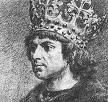
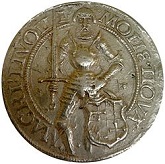
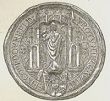
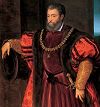

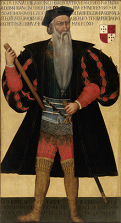

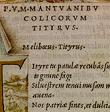

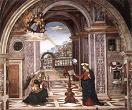


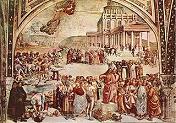

1501 In Mar. after Rodrigo de Bastidas reaches Venezuela, then Colombia, he discovers the Magdalena River, finally exploring the whole coastline from Cape de Vela to the Gulf of Darien, incl. the coast of Panama. In Apr. the Moorish revolt in Grenada (begun Dec. 1499) is quashed. In May Gaspar Corte de Real (b. 1450) returns to Newfoundland, then disappears mysteriously after sending back two of his vessels - lost and found land? On May 14 Italian explorer Amerigo Vespucci (1454-1512) leaves Lisbon and sails along the coast of South Am., spreading joy to the natives, and convincing himself that this isn't Asia but a vast unexplored new continent, which he calls Mondus Novus (the New World). On June 1 Pope Alexander VI issues a bull instituting religious censorship of all printed books. On June 17 king (since 1492) Jan I Olbracht (b. 1459) dies, and in Dec. his brother Alexander I Jagiello (1461-1506) becomes king of Poland (until 1506), signing a truce with Bajazet II. On Aug. 9 the Danish-Swedish War begins (ends 1512) as King Hans of Denmark-Norway-Sweden receives a letter of succession from the Swedish nobles, and they siege queen consort (since Oct. 6, 1497) Christine (Christina) (1461-1521) in her castle in Stockholm (until 1502). On Aug. 29 after skillful use of heavy cavalry and artillery fire, the Battle of the Siritsa (Seritsa) River 6 mi. S of Izborsk is a V for 12K troops (8K infantry, 4K cavalry) of the Livonian Order under grandmaster (since 1494) Wolter von Plettenberg (1450-1535) over 40K toops of the grand duchy of Moscow under Vasily Nemoy Shuysky and the Pskov Repub. under Danil Shchenya. On Sept. 1 Lucrezia Borgia marries her 3rd hubby (his 2nd wife) Alfonso I d'Este (1476-1534), son and heir to Duke Ercole I d'Este of Ferrara (d. 1505), a great art patron who finds her repugnant; when the duke dies in 1505, she and her husband take over Ferrara, establishing a court which becomes known for its artists, writers and scholars, while his army becomes known for its top-of-the-line artillery, which he is so proud of he poses for portraits with his arm over a cannon's mouth; meanwhile the accusations of intrigues, murders, and deviltry fly, starting with having his brother Ferrante and half-brother Giulio convicted in Sept. 1506 of treason and put on the gallows, after which their sentence is commuted to life in priz in the Torre dei Leono, after which Ferrante dies after 34 years, and Giulio is pardoned in 1559 after 53 years, being laughed at in the streets for his outdated clothes. Louis XII of France, in alliance with Ferdinand II the Catholic of Aragon conquers Naples; after the French enter Rome, Pope Alexander VI declares Louis XII king of Naples; the Peace of Trent in N Italy between France and HRE Maximilian I recognizes France's conquests in Upper Italy. On Oct. 30 Cesare Borgia (illegitimate son of Pope Alexander VI) allegedly holds the Ballet (Banquet) of the Chestnuts in the Palazzo Apostolico, featuring an orgy with 50 "honest prostitutes", who crawl naked on a floor strewn with you know what. The Medici Dynasty (House of Medici) in Florence is overthrown by a popular uprising, which declares the First Florentine Repub. (ends 1512); cousins (raised as brothers) Giovanni Medici and Giuliano Medici flee for Rome to plot a return. Spanish scholar (chaplain to Ferdinand II and Isabella I) Peter Martyr D'Anghiera (1457-1526) is sent to Egypt to dissuade the sultan from taking vengeance on the Christians in Egypt and Palestine for the defeat of the Moors in Spain. 16-y.-o. Catherine of Aragon (1485-1536), youngest surviving child of Ferdinand II and Isabella I of Spain makes a perilous journey to England to marry 14-y.-o. prince Arthur Tudor (1486-1502), son of Henry VII; Arthur's 10-y.-o. brother Prince Henry Tudor (later Henry VIII) is her escort; 4 mo. later Arthur dies of "sweating sickness", and Prince Henry is put at the head of the line for both the crown and her hand - lucky young Anakin Skywalker? Schaffhausen W of Lake Constance (northernmost canton) joins the Swiss Confederation, along with East Basel (West Basel in 1579). Circassian Al-Ashraf Kansawh al-Ghawri (Qansuh al-Ghauri) (1441-1516) becomes the next-to-last sultan of the Mamluk Empire (until Aug. 24, 1516), going on to complain to the pope about the Portuguese navy rounding the Cape of Good Hope and entering the Indian Ocea and Red Sea, and builds a fleet to take them on. Shiite cmdr. Ismail of Ardabil, leader of the Twelver Shia militant Safaviyya order and his army of 7K Shiite Qizilbash Red Heads defeat an army of 30K Sunnis under the leader of the White Sheep (Aq-Qoyunlu) Turk dynasty under Alwand Mirza at the Battle of Shurer in Azerbaijan, and captures their capital of Tabriz; Ismail proclaims himself shah Ismail I (1487-1524) (until May 23, 1524), founding the Turkish-based Shiite Persian Safavid (Safawod) Dynasty (ends 1722, then 1729-36), which converts Iran to Shia Islam after importing religious authorities from the Levant, becoming a rival to the Sunni Ottoman Empire and pissing them off by suppressing Sunni subjects and sending missionaries into Anatolia to stir up the Turkomans; the Safavid Dynasty goes on to expand Persian rule to all of Iran, Azerbaijan, Armenia, most of Georgia, the North Caucasus, Iraq, Kuwait, and Afghanistan, and parts of modern-day Syria, Turkey, Pakistan, Uzbekistan, and Turmenistan, reestablishing Persia as an economic stronghold between the East and the West, with an efficient state bureaucracy that patronizes fine arts and architecture; Ismail I becomes a prolific poet under the alias Khatai (Pers. "sinner"), establishing Azerbaijani as a lit. language. That's one small step for Africans, one giant leap for Europeans? The Spanish (Castilian) crown authorizes the African slave trade under its monopoly, giving permission to Flemish, German, Dutch, Genoan, and Portuguese merchants to engage in it; next year the first African slaves in America arrive in the Spanish colony of Santo Domingo (modern-day Dominican Repub.), ordered by newly-appointed Hispaniola gov. (1502-9) Nicolas de Ovando y Caceres (Nicolás de Ovando y Cáceres) (1460-1518); by 1503 there are so many that Ovando asks that the flow be stopped; at first they only accept Africans instructed in the Christian faith, prohibiting those from Muslim Moorish backgrounds - let's go round up some loose what? The seaport of Durazzo in Albania is captured by the Turks (until 1913). Philibert II the Handsome of Savoy does it and marries Margaret of Austria, only daughter of HRE Maximilian I and Mary of Burgundy; too bad, handsome or not, he shoots blanks and leaves, er, dies childless in 1504. Portuguese explorer Joao de Nova (1460-1509) discovers Ascension Island off the W coast of Africa; too bad, he fails to report it, causing fellow Portugese explorer Alfonso de Albuqurque (1453-1515) to rediscover it in 1503 on Ascension Day (40th day of Easter) and name it; otherwise barren, it is a good place to hunt egg-laying green turtles. After Columbus brings sugar cane plantings, Hispaniola has its first sugar cane harvest. The U. of Santiago in Spain is founded. Michelangelo leaves Rome and returns to Florence (until 1505). It's a phenomenon known as deja vu? Pope Alexander VI creates his son Cesare Borgia as duke of Romagna, who seizes the principality of Piombino, fails to acquire Bologna and Florence, then takes Camerino and the duchy of Urbino. Il Sodoma (1477-1549) of Lombardy moves to Siena, Italy (after studying with Leonardo da Vinci?), founding the High Renaissance Sienese School of Painting with Pinturicchio. The Devil's Armor is hung in the village church of Santa Reparata S of Florence after a young man wearing it allegedly takes the name of the Virgin in vain as he passes by and could not take the armor off until he received her forgiveness, later donating it as a thanksgiving gift; in 1942 an artillery shell bursts in the church, making marks on it :) - Edward Harris, Hannibal (1999). Inventions: Space-saving Italic Script (Chancery Cursive) is first used in an Italian ed. of Virgil, becoming the first octavo (pocket-sized) book. Nonfiction: Idris Bitlisi (-1520), Hesht Bihisht; a history of the first eight Ottoman sultans, written at the order of Bayezid II. Desiderius Erasmus (1466-1536), Enchiridion Militis Christiani (The Manual of the Militant Christian); his 2nd most popular work; modeled on St. Augustine's "Enchiridion of Faith, Hope and Charity"; one of the first secular works to teach the basics of Christian morality to the new middle class, written for a woman friend whose hubby was fooling around; the word "enchiridion" (dagger) is a warning that she might Bobbit him? Aldus Manutius (1449-1515) (ed.), Works of Virgil; the first octavo (pocket-sized) book, introducing space-saving italic script, with a record press run of 1K (vs. the usual 200-500). Ottaviano dei Petrucci (1466-1539) pub. the first printed book of music in Venice. Giorgio Valla, De Expetendis Fugiendis Rebus. Art: Giovanni Bellini (1430-1516), Doge Leonardo Loredan (1505-5). Pinturicchio (1454-1513), The Annunciation. Raphael (1483-1520), St. Sebastian (1501-2). Luca Signorelli (1441-1523), Deeds of the Antichrist (Oviedo Cathedral); uses foreshortening. Leonardo da Vinci (1452-1519), Madonna with the Yarnwinder; survives only in copies. Plays: Conradus Celtis (1459-1508), Ludus Dianae; allegorical play; he also discovers mss. in Nuremberg of plays by 10th cent. nun Roswitha of Gandersheim (935-1000). Poetry: Gavin Douglas (1474-1522), The Palice of Honour; a dream allegory dedicated to James IV, a big patron of the arts. Births: German physician-botanist ("Father of German Botany") Leonhard (Leonhart) Fuchs (d. 1566) on Jan. 17 in Wemding, Bavaria; one of the Three Founding Fathers of Botany with Otto Brunfels and Hieronymus Bock. Italian physician-botanist Pietro Andrea Gregorio Mattioli (Matthiolus) (d. 1577) on Mar. 12 in Siena; educated at the U. of Padua. Italian polymath physician-mathematician-astrologer Girolamo (Geronimo) Cardano (d. 1576) on Sept. 24 in Pavia. Dutch Anabaptist leader David (Jan) Joris (Jorisz) (Joriszoon) (d. 1556) in Bruges. French "Delie" Lyonnese School poet-musician Maurice Sceve (Scève) (d. 1564) in Lyon. Portuguese physician (pioneer of tropical medicine) (Sephardic Jewish converso) Garcia de Orta (d'Orta) (d. 1568) (b. 1502?) in Castelo de Vide; Spanish Jewish immigrant parents; educated at the U. of Alcala de Henares, and U. of Salamanca. Deaths: Italian Venetian doge (1486-1501) Agostino Barbarigo (b. 1420) on Sept. 20 in Venice. Persian poet Mir Ali Shir Nava'i (b. 1441). Portuguese explorer Gaspar Corte Real (b. 1450). Italian feminist writer Antonia Pulci (b. 1452). Polish king (1492-1501) Jan I Olbracht (b. 1459) on June 17.
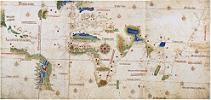





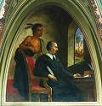



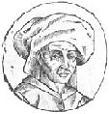



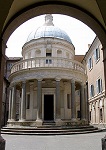
1502 On Jan. 1 Amerigo Vespucci reaches Bahia de Todos Santos, then travels down the coast of South Am. to the River Plata; he returns to Lisbon on July 22, and concludes that South Am. is an independent continent, and is not India. On Jan. 20 Portuguese explorer Gaspar de Lemos founds Rio de Janeiro (Port. "January River") (modern pop. 6M) in Brazil near Mt. Corcovado. In Jan. James IV of Scotland signs a Treaty of Perpetual Peace with Henry VII of England; excommunication by the pope is agreed to as the penalty for breaking the treaty, and all future English and Scottish kings have to renew it within 6 mo. of accession; as if he hadn't just signed a perpetual peace treaty with England, James IV of Scotland establishes a royal navy to protect merchant shipping and defend against the English navy, and refuses to give up his alliance with the French, receiving assistance in the form of money, materials, and shipwrights; since the English go on to violate the treaty, incl. the notorious case of the 1504 murder of Scottish march warden Sir Robert Ker of Ferniehurst (-1504) by English "Bastard" John Heron, it turns out to be a wise move - you're white and you can sing, okay? On Feb. 12 after receiving the title of adm. in Jan., Vasco da Gama (1460-1524) leaves Lisbon on his Second Voyage around Africa with 20 ships, discovering the Seychelles, then arriving in Calcutta on Oct. 30, killing Muslims and spreading Christianity all the way, after which he founds and gives Portuguese protection to Cochin (Emakulam), the first European settlement in India, and the center of Roman Catholic penetration. On May 11 after being returned to favor and getting an order last Sept. 3 to replace his enemy Francisco Bobadilla, Christopher Columbus (1451-1506) begins his Fourth Voyage (last), leaving Cadiz with four ships (Capitano, Vizcaino, Santiago de Palos, El Gallego) and 140 men, with instructions to discover the Malacca Straits and not engage in trade, carrying a 2-year supply of food and Arabic speakers, arriving in Hispaniola on June 29, along with newly-appointed Hispaniola gov. (1502-9) Nicolas de Ovando y Caceres (Nicolás de Ovando y Cáceres) (1460-1518); (a lares or cmdr., and member of the Military Order of Alcantara), future Incan Conquistador Francisco Pizarro Gonzalez (1471-1541), and future Dominican missionary Bartolome (Bartolomé) de las Casas (1484-1566), who accompanied him on his 3rd voyage in 1498, and starts out as a planter; Columbus arrests Bobbin' Bob and ships him to Spain, where he dies in a thrilla' of a shipwreck caused by a hurricane; Columbus goes on to discover Martinique (400 mi. NE of Venezuela), reaches Nicaragua on July 30, seizes a large native canoe containing cacao beans on Aug. 15, visits Costa Rica on Sept. 18, and lands in Portobelo (Porto Bello) (Sp. "Beautiful Port) in Panama on Nov. 2 and plants a colony; the Chibchan-speaking Cuna-Cuna (Cuna) (Kuna) (Guna) (San Blas) (Tule) Indians of Panama have several cases of hereditary albinism, causing legends of white Indians to arise; Ovando later becomes gov. of Santo Domingo, bringing 1.5K Spanish families to populate it and spread their seed into the new white Lebensraum, while instituting hyper-cruel genocidal measures against the West Indies aborigines, which reduce them from 500K in 1492 to 60K in 1507 - pardon me while I vomit? In Mar. after 7 mo. the siege of Queen Christine of Denmark ends when she promises to return to Denmark along with the 70 of 1K men she has left; too late, her hubby King Hans (d. 1513) arrives three days later with a large fleet, but since she is in Swedish hands he returns to Denmark, and she remains hostage until next year, after which King Hans' failure to retake Sweden mars his disposition for life. In May Miguel Corte Real (b. 1451) leaves Lisbon to search for his brother Gaspar, reaches Newfoundland, then mysteriously disappears; in 1503 King Manuel I sends another expedition to learn their fate, but they return after finding nothing, causing him to forget the idea of a Northwest Passage and concentrate on India; an archeologist later discovers evidence that he reached Mass. and lived until the year 1511. In July Alexander I of Poland attacks Novgorod; Ivan III attacks Smolensk, but is defeated by the Livonian Order. In Dec. having lost its ports in the Morea, and Durazzo in Albania, Venice signs the Peace Treaty of Lepanto with the Ottomans, ending the Fourth Ottoman-Venetian War (begun 1499), leaving Venice only Monemvasia, Nafplion, and Patras; the Ottomans are now the #1 naval and commercial power in the E Mediterranean - more reason to Go West, Young Man? The remaining revolting Moors in Granada crushed; Gibraltar is annexed to the Spanish crown; Isabella I the Catholic of Castile (1451-1504) forces the remaining Muslims in Spain to choose between conversion and exile so she can distribute Muslim land and people to Christian Castilians, causing many to feign conversion according to the Muslim doctrine of taqiyya (lying for the cause of Islam), while many flee to the N coast of Africa, found citadels and states, and turn into pirates known as Corsairs, going on to prey on Mediterranean and Atlantic shipping as far N as Britain and Iceland, and recruiting Christian converts to Islam; they are not stopped until 1816; meanwhile, copycat French corsairs begin attacking the Spanish fleet off the coast of Europe, the Azores, and Canaries, following them into the Caribbean; the English then say "let's get some" and follow their lead, and by 1650 the Golden Age of Piracy begins (ends 1726); meanwhile the Roman Catholic Spanish attempt to wipe out all traces of the infidel Moors in Spain, burning 1M Arabic mss. and churning out tons of coverup lit. and art. Ahuizotl dies and is cremated on a funeral pyre, and his nephew Montezuma (Moctezuma) II (1479-1520) becomes emperor of the Aztecs; in 2007 underground chambers in Mexico City containing the remains of Ahuizotl are uncovered. Joao de Nova discovers uninhabited Saint Helena Island in the S Atlantic Ocean 1.2K mi. W of Africa on the same latitude as the Angolan-Namibian border. Cesare Borgia's enemies join forces and rebel, inflicting several defeats on his army, but after French intervention is threatened, a number of the rebels withdraw and capture the town of Senigallia from duke Guidobaldo I of Urbino in an attempt to placate him; after Borgia arrives, he orders the entire group arrested, and has two of the leaders executed. Niccolo Machiavelli (1469-1527) becomes the right hand man of Soderini, the gonfalonier (life pres.) of Florence, and reorganizes the Florentine army (ends 1512). The U. of Wittenberg is founded in Wittenberg, Saxony-Anhalt, Germany by elector Frederick III the Wise, becoming a hotbed of the Protestant Reformation, with alumni incl. Martin Luther and Philipp Melanchthon, and Luther's house the Lutherhaus becoming part of the campus; Shakespeare's Prince Hamlet becomes a student :); in 1817 it merges with the U. of Halle (founded 1691). Henry VII's mother Margaret, countess of Richmond and Derby founds professorships of divinity at Oxford and Cambridge. Portuguese traders take the first peanuts from Brazil and Peru to Africa; they reach China by 1573. Aldus Manutius of Venice founds the New Academy for Greek classical scholars, which counts as members Desiderius Erasmus (1466-1536) (in Italy from 1506-9) and Thomas Lincare, with rules written in Greek; the revival of Greek studies in Europe is led by Erasmus, who corresponds with over 500 scholars and politicians, giving advice and unfreezing the gloomy Roman Catholic atmosphere; too bad, Erasmus won't begin publishing his hit books dissing monasticism and scholasticism until he masters Latin later in this decade (around age 40). Architecture: The Church of St. Mary's in Danzig (Gdansk) (begun 1379) is finished, becoming one of the largest brick churches on Earth. After moving from Milan, where he had been court architect to Duke Ludovico Sforza in 1476-99, Urbino-born architect Donato Bramante (1444-1514) designs the Tempietto (It. "small temple") in San Pietro in Montorio Church in Rome on the alleged spot of the martyrdom of St. Peter, becoming the first example of the Tuscan order (a variation on the Doric order) in the Renaissance, bringing the High Renaissance to Rome. Nonfiction: Anon., The Cantino Planisphere (World Map); produced in Lisbon and smuggled to Italy by Albert Cantino, agent for the duke of Ferrara; the earliest map of South Am. showing part of Brazil and the Treaty of Tordesillas line of 1494. Ambrogio Calepino, Cornucopiae; the first polyglot dictionary; written by an Augustinian monk; starts out with Latin and Greek, then is extended to Italian, French, and Spanish, reaching 11 languages in the 1590 Basil ed. Amerigo Vespucci (1454-1512), Letters About the American Indians; explicit soft-core letters with juicy details about how they go around naked, their sexual habits, cannibalism, communism, etc., which go through many reprints in many languages throughout the cent., becoming one of the first printed bestsellers - the first porno on the Internet? Art: Giovanni Bellini (1430-1516), Baptism of Christ. Lucas Cranach the Elder (1472-1553), Crucifixion (Vienna). Gerard David (1460-1523), St. John the Baptist (triptych) (Bruges) (1502-7). Raphael (1483-1520), Solly Madonna; St. Sebastian (1502-3). Music: Josquin des Prez (1450-1521), First Book of Masses (Missa La Sol Fa Re Mi); by Louis XII's court composer; pub. by Ottaviano de Petrucci. Plays: Gil Vicente (1470-1536), Celebration of the Birth of Joao (John) III (pastoral monologue) (first play) - burning with love? Poetry: Conradus Celtis (Conrad Celtes) (1459-1508), Amores. Jacopo Sannazaro (1458-1530), Arcadia; pastoral romance about the frustrated love of Sincero for Phyllis, becoming the first non-dramatic Renaissance pastoral; written in the 1480s, a pirated ed. is pub. in Venice, and becomes a big hit. Births: Portuguese mathematician Pedro Nunes (Petrus Nonius) (d. 1578) on Jan. 11 in Alcacer do Sol; born into a Jewish converso family; educated at the U. of Salamanca, and U. of Lisbon (Coimbra); teacher of Christopher Clavius (1538-1612). German Wittelsbach elector Otto Henry, Elector Palatine (d. 1559) on Apr. 10 in Amberg; son of Ruprecht of the Palatinate (1481-1504) and Elisabeth of Bavaria-Landsut (1478-1504); brother of Duke Philip the Contentious of Palatinate-Neuburg (1503-48). Portuguese king #15 (1521-57) (founder of the Inquisition) Joao (John) III (the Pious) (the Grocer) (d. 1557) on June 7 in Alcacova Palace, Lisbon; son of Manuel I the Great (1469-1521) and Infanta Maria of Aragon (3rd daughter of Ferdinand II of Aragon and Isabella I of Castile). French prince of Orange (last from the House of Chalon) Philibert of Chalon (d. 1530) in Nozeroy, Franche-Comte; son of John IV of Chalon-Arlay. English Lady Jane Grey backer politician-gen.-adm. John Dudley, Viscount Lisle, Earl of Warwick, Duke of Northumberland (d. 1553) in London; son of Edmund Dudley (1462-1510); husband of Jane Dudley, daughter of Sir Edward Guilford; has seven children, Robert Dudley, earl of Leicester (1533-88), Guilford Dudley (1536-54), John Dudley, viscount Lisle and earl of Warwick (1530-54), Ambrose Dudley, viscount Lisle and earl of Warwick (1531-90), Mary Dudley (-1586), and Katherine Dudley (-1620). Spanish conquistador (Yucatan) Francisco de Montejo y Leon (El Mozo) (the Son) (d. 1565); son of Francisco de Montejo y Alverez (1479-1553). Italian painter Giulio Campi (d. 1572) in Cremona; son of Galeazzo Campi (1477-1536); brother of Antonio Campi (-1591) and Vincenzo Campi (1536-91). Spanish conquistador (Philippines) Miguel Lopez de Legazpi (d. 1572). Deaths: Italian Pitti Palace architect Luca Fancelli (b. 1430). Scottish royal mistress (of James IV) Margaret Drummond (b. 1475). English prince Arthur (b. 1486) (sweating sickness).


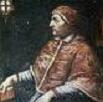



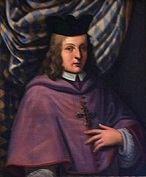
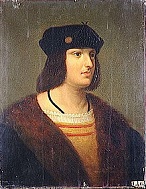



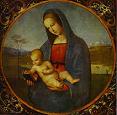

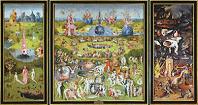
1503 On Jan. 9 after encountering a tropic storm with a water spout, Christopher Columbus lands at the mouth of Rio Belen, after which the natives lead him to a gold mine, causing him to establish a fort and garrison there, leaving one ship behind and returning to Spain with the loot, after which the natives siege it, but luckily Columbus finds out and returns to rescue them, and on Apr. 16 he leaves for home, but on June 20 is marooned in Jamaica after leaving a ship full of teredo worm holes in Puerto Bello and finding the two remaining ships also full of holes, but barters with the natives for a canoe, which he sends to Hispaniola with Diego Mendez for help, but the canoe is captured and Mendez returns, only to be sent again; meanwhile the mean Porras brothers Francesco and Adelanto turn the crew against Columbus, and 48 men abandon him and set out for Hispaniola in 10 canoes, but after encountering storms return. In Feb. after wreaking savage vengeance at a trading station in Calcutta, Vasco da Gama leaves India for Portugal; Alfonso de Albuquerque and his cousin Dom Francisco da Alameda help create the first Portuguese fortresses and trading posts in Cochin and Quilon, laying the foundation stone of Fort Cochin (Kochi) on Sept. 26; Unniram Koyikal I dies, and Unniraman Koyikal II (-1537) becomes ruler of Cochin (until 1537). On Apr. 28 after the Sack of Castellaneta in Apula, Italy (the heel) sees the citizens push back a French occupation force under the Louis d'Armagnac, Duke of Nemours (1472-1503), the Battle of Cerignola near Bari in S Italy sees 6.3K Spanish troops under gen. ("The Great Captain") ("Father of Trench Wafare") Gonzalo Fernandez de Cordoba (1453-1515) defeat the duke's 9K-man army, whose pikes and cannons are no match for the Spanish arquebuses; the duke is KIA. On June 10 Amerigo Vespucci leaves Lisbon for the New World on his Fourth Voyage. On Aug. 8 30-y.-o. James IV of Scotland marries Henry VII's 14-y.-o. daughter Margaret Tudor (1489-1541) in Holyrood Abbey in what becomes known as the Union of the Thistle and the Rose, putting the Scottish kings in line for the English throne if the Tudor line becomes kaput; Scottish poet William Dunbar (1460-1520) writes The Thrissill and the Rois, an allegorical prothalamion (prothalamium) in honor of the marriage, which features a 3-day tournament in Holyrood Palace courtyard that attracts famous champions from N Europe and in which the king leads from the front to wow his nobles, impressing Spanish ambassador Don Pedro de Ayala, who draws a flattering portrait of the couple after failing to get the king to marriage a Spanish princess, and expressing the hope that he will now give up his mistresses (no way?); Dunbar later writes the poem The Wooing of the King when He was in Dunfermeline, about his love romps, making James IV into the first JFK, whose amorous affairs don't affect his political popularity, and Margaret Tudor into the first Jackie?; the paltry £10K dowry shows that Henry VII isn't too enthusiastic about his daughter marrying down? On Aug. 18 Pope (since 1492) Alexander VI (Rodrigo Borgia) (b. 1431) dies of accidental poisoning after he toasts to a couple of cardinals he was plotting to poison with the wrong cup (official explanation: malaria?); his Vatican apts. are sealed until the 19th cent.; on Sept. 22 Francesco Todeschini-Piccolomini is elected Pope (#215) Pius III (1439-1503), but he dies on Oct. 18 after he is poisoned, er, the long investiture ceremony breaks his health, and on Nov. 1 Giuliano Dell (Della) Rovere is elected Pope (#216) Julius II (1443-1513) after the shortest conclave in papacy history, in which bribery is suspected, taking the name of 4th cent. Pope Julius I (337-52); he becomes known as "Il Pontiface Terribilis" for his pride and ambition, also "the Warrior Pope", fighting to end the power of the Borgia family over the Papal States, and reconcile the warring Orsini and Colonna families of Rome; too bad, he's also a pedophile who likes boys - because something is happening here and you don't know what it is, do you, Mr. Jones? In Aug. after the death of Cesare Borgia's father Rodrigo Borgia (Pope Alexander VI), his enemies seize Urbino, Pesaro, Rimini, and other portions of his dominions within two mo., then Pope Julius II deprives him of the rest of his holdings and gives him safe passage to Spanish-held Naples. On Dec. 1 George the Rich of Bavaria-Landshut (b. 1455) dies, leaving no male heir, but remembering that an old agreement with the other Bavarian duchy of Bavaria-Munich to give succession to them in this case was technically illegal since the HRE is supposed to get it, he instead wills his duchy to his daughter Elisabeth of Bavaria-Landshut (1478-1504) and her hubby Duke Ruprecht of the Palatinate (-1505) (bishop of Freising in 1495-8), which is okay to him since they are related branches of the fractured House of Wittelsbach; too bad, mean duke Albert IV the Wise of Bavaria-Munich (1447-1508), remembering the 1329 Compact of Pavia dividing up the House of Wittelsbach between the Bavarian and Palatinate lines decides to keep the split going, beginning the bloody Landshut War of Succession (ends 1505), a 3-way struggle for control of beer-loving Bavaria between the Wittelsbach duchies of Bavaria-Munich and Bavaria-Landshut and Ruprecht's Palatinate branch, which ends in many Landshut villages being reduced to ashes (Ergolding, etc.). On Dec. 29 the Aragonese under gen. Gonzalo Fernandez de Cordoba, Duke of Terranova and Santangelo (1453-1515) defeat the French under the Marquis of Saluzzo with a surprise attack at the Battle of the Garigliano near Gaeta, Italy, ending French resistance in Naples. After the Crimean Tartars pillage the S Lithuanian towns of Slutsk, Kletsk, and Nesvizh and threaten Vilnius, grand duke Alexander Jagiello of Lithuania agrees to a truce with Ivan III of Moscow, ending the Second Russian-Lithuanian War (begun 1500), giving Russia about one-third of the grand duchy, incl. the area around the Upper Oka River, Smolensk, and a score of other towns (Vyazma, Chernihiv, Novhorod-Siverskyi), but keeping the Lithuanian borderlands; Poland surrenders the left bank of the Dnieper River to Russia; the pissed-off Lithuanian nobles appeal to Poland for military aid, leading to continuing wars through the 1560s; Alexander orders the building of a defensive wall around Vilnius (completed 1522). The Casa Contrataccion (Colonial Office) (La Casa y Audiencia de Indias) us established in Seville by Queen Isabella I to control all Spanish exploration and colonization, leaving a 20% tax (Quinto Real) on all precious metals entering Spain, along with other taxes of 10%-40%; in 1508 it pub. the Padron (Padrón) Real, the official secret map required to be kept by all ship pilots. The island of Sandbar, er, Zanzibar becomes a Portuguese colony. After getting a special papal dispensation to set aside the decree of the Lateran Council of 1215 that prohibits all marriages to the fourth degree by consanguinity or affinity (based on Leviticus ch. 18), Prince Henry Tudor of Wales (the future Henry VIII) is betrothed to 18-y.-o. allegedly virginal (ask her duenna?) widow Catherine of Aragon - everybody's taking a supermodel today, everybody's gonna get laid? James IV of Scotland makes a pilgrimage to Whithorn Cathedral in Dumfries and Galloway, having his mistress Janet Kennedy brought to Bothwell in Lanarkshire to bake his cookies; still feeling his oats, he later hooks up with Isabella Stewart, daughter of James Stewart, 1st earl of Buchan, who bears daughter Lady Janet Stewart, Lady Fleming (1505-63), who becomes a governess to her niece Mary Stewart, queen of Scots (and a mistress of Henri II of France?), and finds yet more time for Bessie Bertram and Janet Bare-Arse, who both receive royal gifts for services rendered. Portuguese merchant-explorer Antonio de Saldanha discovers Table Bay at the N end of the Cape Peninsula at the base of Table Mountain in South Africa (later home of Robben Island of Nelson Mandela fame). Santo Domingo gov. Nicolas de Ovando of Santo Domingo begins distributing enslaved Indians in encomiendas (Spanish-run fiefdoms of Indians slaves) to work the gold mines; meanwhile the Spanish found 15 towns on the island. 30-y.-o. Nicolaus Copernicus becomes doctor of canon law in Ferrara. Wealthy famous German sculptor Veit Stoss is defrauded of a large sum of money, forges the name of the embezzler on a promissory note to get even, is caught and branded on both cheeks as a punishment; he then starts a war with the town council of Nuremberg over payment of fees, and gets imprisoned twice, until HRE Maximilian I intercedes in 1508 and restores peace. Ercole I d'Este of Ferrara becomes the patron of French-Flemish composer Josquin des Pres (until 1504); too bad, plague breaks out in Ferrara in the summer, causing the duke and his family to scoot this year, and him the next, after which he settles in Sur-le-Conde on the French-Belgian border (SE of Lille), where he becomes provost of the college church of Notre Dame for life. Ludovico di Varthema (Barthema) (Vertomannus) (1470-1517) of Bologna, Italy becomes the first Euro non-Muslim to make the Hajj to Mecca posing as a Muslim, going on to pub. Itinerario de Ludouico de Varthema Bolognese in Rome in 1510. Architecture: Pope Julius II decides to raze the 4th cent. Basilica of Constantine in Rome on the edge of the Tiber River housing the bones of St. Peter and erect the vastly more ambitious St. Peter's Basilica, a total rebuilding job, with orders that it be taller than the #1 house of God, the 10-story Benedictine Abbey of Cluny in Burgundy, France; he appoints Urbino-born High Renaissance architect Donato Bramante (1444-1514) as chief architect, with indulgences proclaimed for those aiding the effort; Bramante begins the rebuilding work in 1506 and never finishes it, although his plans and drawings for the Vatican Palace and St. Peter's become famous after being executed by Michelangelo. Canterbury Cathedral (begun 1070) is finally finished after 433 years with the tower featuring fan vaulting by John Wastell - I don't know if you remember but I fell in love with you in these umpteen walls? Henry VII's Chapel in Westminster Abbey is begun (finished 1519). Inventions: The pocket handkerchief is invented by ?. Nonfiction: The first English tr. of Thomas a Kempis' Imitation of Christ (1427) is pub. Art: Hieronymus Bosch (1450-1516), The Garden of Worldly Delights (The Millennium) (triptych) (1503-4). Matthias Grunewald (1465-1528), The Mockery of Christ; his paintings of the agony of Christ make him the #1 late German Gothic artist? Filippino Lippi (1457-1504), Virgin and Saints. Il Perugino (1446-1524), The Marriage of Joseph and the Virgin Mary; model for Raphael's "Sposalizio"; really painted by Lo Spagna? Raphael (1483-1520), Diotalevi Madonna; Madonna Connestabile (Madonna and Child with Book) (1503-4); Norton Simon's 2nd favorite painting of all time; The Crucifixion; shows flying angels catching the blood from Jesus' wrists and side in cups, while contemplative saints watch on, and one seems to have his hand out looking for a few drops; meanwhile Christ's usual expression of agony is missing - gimme summa dat blood? O draconian devil, o lame saint? Smile while you say that to the world's numero uno painting? Leonardo da Vinci (1452-1519) begins painting the surprisingly small 30.5 in. x 21 in. sfumato (smoky style) Mona Lisa (La Giocondo) (oil on a poplar board) (finishes in 1506); there are hidden lit. references to the works of Petrarch and Horace?; the model is Mona Lisa del Giocondo (nee Gherardini) (1479-1542), wife of Florentine merchant nobleman Francesco del Giocondo; she is mourning the death of her baby daughter so she wears a transparent veil; after spending four years on the portrait he leaves it with the Giocondos, then, shortly before going to France at the invitation of Francis I, he paints another portrait at the request of Giuliano de Medici of his mistress Costanza d'Avalos Piccolomini (-1560), whose nickname is La Gioconda (the Smiler); he uses the excuse that it is incomplete to keep it with him until death; the painting in the Louvre is the 2nd one, while the first one ends up in London; Raphael also makes a sketch of one of the two portraits; her face is 83% happy, 9% disgusted, 6% afraid, and 2% angry; the eye trick is caused by the left half of her face being bigger than the right, and the horizon on her left side being higher than on her right side; her eyebrows are shaved, her mouth is closed, her hair is parted, her hands are crossed, and her arms are not bare; an X-ray of the Louvre painting shows three different versions of the subject under the final one. Births: Italian Mannerist painter Parmigianino (Girolamo Francesco Maria Mazzola) (d. 1540) on Jan. 11 in Parma. German Roaman Catholic cardinal Johannes (Johann) (John) Gropper (d. 1559) on Feb. 24 in Soest. Spanish Hapsburg archduke of Austria (1521-64) and HRE (1556-64) Ferdinand I (d. 1564) on Mar. 10 in Alcala de Henares (near Madrid); son of Philip I the Handsome of Austria (1478-1506) and Joanna the Mad of Castile (1479-1555); younger brother of HRE Charles V (1500-58); motto: "Let justice be done though the world perish". Italian scholar Antonio Francesco Grazzini (Il Lasca) (Leuciscus) (d. 1584) on Mar. 22 in Florence. German Wettin elector of Saxony (1532-47) ("Champion of the Reformation") and duke (547-54) John Frederick I (the Magnanimous) (d. 1554) on June 30 in Torgau; eldest son of elector John the Steadfast (1468-132) and 1st wife Sofie of Mecklenburg-Schwerin (-1503) (dies on July 12); husband (1526-) of Sybille of Cleves (1512-54) (sister of Anne of Cleves); father of John Frederick II (1529-95); cousin of Maurice (1521-53). Danish-Norwegian king (1537-59) Christian III (d. 1559) on Aug. 12 in Gottorp; son of Frederick I and 1st wife Anna of Brandenburg. German Wittelsbach count palatinate of the Rhine and duke Philip the Contentious of Palatinate-Neuburg (d. 1548) on Nov. 12 in Heidelberg; son of Ruprecht of the Palatinate (1481-1504) and Elisabeth of Bavaria-Landsut (1478-1504); brother of Otto Henry, elector Palatine (1502-59). Italian Mannerist painter Agnoli di Cosimo (Il Bronzino) (d. 1572) on Nov. 17 in Florence; pupil of Raffaellino del Garbo and Pontormo. Italian duke of Parma #1 (1545-7) Pier Luigi Farnese (d. 1540) on Nov. 19 in Rome; bastard son of Cardinal Alessandro Farnese (Pope Paul III); helped sack Rome in 1527. The man who can write history before it happens is born a Jew and baptized a Christian by age nine at a time when being Jewish is close to a death sentence? French doctor, astrologer and Wandering Jew (crypto-Christian) prophet Michel de Nostredame (Nostradamus) (d. 1566) on Dec. 14 (noon) in St. Remy, Provence; eldest of four sons of Jaume (Jacques) and Reyniere, Jews who convert to Catholicism by 1512; youngest son Jean becomes procureur of the parliament of Provence, and writes ribald Provencal songs and commentaries. English "Tottel's Miscellany" 6' poet-diplomatist (father of the English sonnet) Sir Thomas Wyatt (OF "small fighter") (d. 1542) in Allington Castle, Kent; father of Sir Thomas Wyatt the Younger (1521-54); educated at St. John's College, Cambridge U. French printer Robert I Estienne (AKA Robert Stephanus) (d. 1559) in Paris. French anatomist Charles Estienne (d. 1564); born in a famous family of French humanist printers. Spanish poet and statesman Diego Hurtado de Mendoza (d. 1575). Deaths: German printer Peter Schoeffer (b. 1425) in Mainz. Italian pope (1492-1503) Alexander VI (Rodrigo Borgia) (b. 1431) on Aug. 18 in Rome; his apts. in the Vatican are sealed for fear of future popes being associated with the Borgias, and are not reopened until 1889 by Pope Leo XIII. French nobleman Peter II, duke of Bourbon (b. 1438) on Oct. 10 in Moulins. Italian pope (1503) Pius III (b. 1439) on Oct. 18. Swedish regent Sten Sture the Elder (b. 1440) on Dec. 14. Bavarian duke (of Landshut) George the Rich (b. 1455) on Dec. 1 in Ingolstadt. Italian painter Giovanni Donato da Montorfano (b. 1460) in Milan. English queen consort (1486-1503) Elizabeth of York (b. 1466) on Feb. 11 in Richmond. French gen. Louis d'Armagnac, duke of Nemours (b. 1472) on Apr. 28 in Cerignola, Italy (KIA).











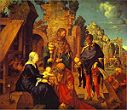

1504 On Jan. 31 Louis XII of France and Ferdinand II of Aragon sign the Treaty of Lyons, ceding Naples to Aragon; Ferdinand II of Aragon becomes Ferdinand III of Naples, giving the Spanish crown control of the Two Sicilies (until 1713); in 2018 the code used by Ferdinand II and Gonzalo de Cordoba, containing 88 symbols and 237 letters is finally cracked. In Jan. after working day and night since 1501 under dripping water, rarely taking his shoes off, workaholic Italian Florentine sculptor Michelangelo di Lodovico Buonarroti Simoni (1475-1564) finishes sculpting his dangly 16'4" Carrara marble Statue of David (most famous penis in history?), and unveils it to the Florentines, who adopt it as a symbol of their city and its republican aspirations, and make it the first statue displayed on a plinth since Roman times (they are young, beautiful David with the big slingshot and pouch of smooth stones at the ready, and the Medicis are big bad dumb Goliath?); the hard work doesn't seem to shorten Big Mike's lifespan any? On Jan. 21 London bishop (since 1502) William Warham (1456-1532) becomes lord chancellor of England, and archbishop of Canterbury on Mar. 9 (until Aug. 22, 1532), the last before the big split with the Mother Church. There's some things money can't buy, but for everything else there is Mastercard? The myth of white racial superiority based on the ease of scamming the less bright (white is bright) is born in the Americas? On Feb. 29 after Columbus and his crew, anchored in two damaged ships off Jamaica for a year get in trouble with the local Arawaks, who refuse to give them any more food in exchange for worthless trinkets, and learning of a total lunar eclipse in his Rabbi Abraham Zacuto Almanac, Columbus hornswaggles the chieftains to give food by pretending to blot out the Moon like he predicted three days earlier; they are finally rescued from Jamaica on June 29 by a relief caravel from Hispaniola, and return to Spain on Nov. 11, riddled with disease; too bad, Columbus claims to have found rich gold fields in Veraguas on the Isthmus of Panama, causing the area W of the Gulf of Darien to be misnamed Castilla del Oro, while the area to the E is called Nueva Andalusia, which incl. the N coast of South Am., and the combined areas are called Tierra Firme. In May Cesare Borgia is arrested in Naples for conspiracy, and imprisoned in the Castle of Medina del Campo (until 1506). On June 18 Amerigo Vespucci returns to Lisbon. On July 2 Bogdan III the One-Eyed (1470-1517) becomes prince (voivode) of Moldavia (until 1517); after demanding the hand of Elisabeth, sister of Polish king Alexander the Jagiellonian twice and being refused, he raids S Poland until they give her to him; in return he lets up on the Roman Catholic Church in Moldavia. On Sept. 10 Philibert II the Handsome (b. 1480) dies childless, and his half-brother Charles III the Good (1486-1553) (who had started life out with no expectations of inheriting any monarchy but got lucky when his father got lucky in 1496, putting him in this position) becomes surprise duke of Savoy (until 1553). On Sept. 12 Duke Albert IV of Bavaria-Munich defeats the Bohemian allies of Rupert of the Palatine in Wenzenbach, and kills him and his wife Elisabeth on Aug. 20 and Sept. 15 with the help of hero knight Gotz (Götz) von Berlichingen (1480-1562); they died of dysentery?; the HRE now has to decide whether he will exercise his own right to take Landshut or give it to Albert IV. On Sept. 22 wanting to keep Brittany independent of France, Anne of Brittany concludes the First Treaty of Blois, whereby the HRE recognizes French rule of Milan, betrothing 4-y.-o. Prince Charles (son of Juana the Mad and Philip I and grandson of HRE Maximilian I) (future HRE Charles V) to her infant daughter Claude, with the promise of both Brittany and Burgundy; too bad, the Valois kill the deal for fear of reducing the size of France, and the engagement is broken off in 1506 in favor of her French cousin Francis, duke of Angouleme (future Francis I); they marry in 1514. It's all about Ferdie? On Nov. 26 Queen (since Dec. 11, 1474) Isabella I of Castile and Leon (b. 1451) dies, and their mentally unstable daughter Joanna (Juana) the Mad (1479-1555) becomes queen of Castile (until Apr. 12, 1555) under her father Ferdinand II's regency; her husband Philip I the Handsome contests his rights to become joint ruler, but it doesn't really matter as both are absent in Flanders, leaving Ferdinand a free hand as actual ruler; Ferdinand V of Castile is no more, but he's still Ferdinand II of Aragon and Sicily, and Ferdinand III of Naples; early next year he persuades the Cortes that Joanna is too soft in the head to rule alone - plenty of bling to wear on armed forces' day? Babar (Baber) (Zahir ud-Din Muhammed) (1483-1530) captures Kabul, and establishes a kingdom in Afghanistan. The Funj Sultanate of Sennar (Sinnar) (Blue Sultanate) in E of Darfur in N Sudan with capital at Sennar is founded as a confederation of Islamic sultanates and dependent mainly animist tribal cheftaincies by Amara Dungas (-1534), who during the Ottoman conquest of Egypt in 1517 successfully uses diplomacy to stop the Ottoman armies from advancing into his realm, and officially converts it to Islam in 1523, reaching its peak in the 16th cent.; it becomes kaput on June 14, 1821 when Mehmet Ali's son Ismail leads an army into Sennar without resistance and deposes last king (since 1805) Badi VII, then annexes it to Egypt on Feb. 13, 1841, later becoming part of Anglo-Egyptian Sudan and the Repub. of Sudan. The Scottish parliament sends Alexander Gordon, 3rd Earl of Huntly (-1524) with a royal fleet to pacify the Highlands. James IV of Scotland dumps his brother Duke James of Ross, and appoints his bastard son Alexander Stewart (1493-1513) as archbishop of St. Andrews to get his hands on the rich revenues, causing grumbling. Am. Indian Taino queen Anacaona (b. 1474), AKA the Golden Flower of Hispaniola is hanged by Spanish gov. Nicolas de Ovando along with her nobles for rebellion, and she goes on to become a heroine in Haiti. The Vienna-Brussels postal service is extended to Madrid. Pope Julius II gives the Shroud of Christ (Shroud of Turin) its own special feast day. Pope Julius II issues a bull establishing the U. of Santiago de Compostela in Galicia, N Spain. Thomas More (b. 1478) becomes an English MP, and pisses off Henry VII by urging a decrease in a proposed appropriation, causing him to order his father imprisoned, not releasing him until a fine is paid and More leaves Parliament. The Islamic Funj Sultanate of Sennar (Sinnar) AKA the Blue Sultanate in N Sudan is founded (ends 1821). Architecture: The limestone-brick Amiriya Madrasa in Rada in S Yemen is built. Inventions: Peter Heinlein (Henlein) (1480-1542) of Nuremberg, Germany invents the coiled mainspring Pocketwatch (Watch) (portable clock), called the Nuremberg Live Egg; it only has an hour hand, and is so heavy it has to be worn on a belt or around the neck. Art: Lucas Cranach the Elder (1472-1553), Rest on the Flight to Egypt. Albrecht Durer (1471-1528), The Adoration of the Magi; The Life of the Virgin (1504-05) (16 blocks); Adam and Eve (engraving); Philosophia, Mother of the Liberal Arts (engraving) (made for Conrad Celtis). Il Giorgione (1477-1510), Madonna Enthroned Between St. Francis and St. Liberale (triptych altarpiece of Castelfranco Cathedral). Michelngelo (1475-1564), Statue of David (Jan.) (begun 1501) (16'4" Carrara marble); most famous penis in history? Raphael (1483-1520), Spozalizio (The Engagement of Virgin Mary) (The Marriage of the Virgin) (first major work); Granduca Madonna (Madonna del granduca). Births: Italian Pope (1566-72) Pius V (Anthonio/Michele Ghisleri) (d. 1572) on Jan. 17 (St. Anthony's Day) in Bosco, Milan. Italian Mannerist "Rape of Helena" painter-sculptor-architect (in France) Francesco Primaticcio (d. 1570) on Apr. 30 in Bologna; spends most of his career working on Chateau Fontainebleau; known for his long-legged babes. English archbishop of Canterbury (1559-75) Matthew Parker (d. 1575) on Aug. 6 in Norwich. German landgrave of Hesse (1509-67) (Lutheran champion) Philip I (the Magnanimous) of Hesse (d. 1560) on Nov. 13 in Marburg, Hesse; son of William II of Hesse (1469-1509) and 2nd wife Anna of Mecklenburg. English adm. Sir George Carew (d. 1545); brother of Sir Peter Carew (1514-75). Spanish conquistador (founder of Guadalajara) Cristobal de Onate (Cristóbal de Oñate) (d. 1567) in Vitoria (Onate), Spain; son of Juan de Onate (Basque "at the foot of the mountain pass") of the House of Haro; father of Juan de Onate (1552-1626). English "Ralph Roister Doister" playwright-cleric Nicholas Udall (Udal) (Woodall) (Uvedale) (d. 1556) in Hampshire; educated at Westminster School, Winchester College, and Corpus Christi College, Oxford U; convicted in 1541 of buggery with two of his pupils at Eton College. Italian organist-composer Francesco di Bernardo Corteccia (d. 1571). Deaths: German astronomer Bernard Walther (b. 1430) in Nuremberg. Moldavian Christian prince (1457-1504) Stephen III the Great (b. 1433) on July 2 in Suceava, Romania; won 34 of 36 battles against the Ottomans. Italian architect-sculptor Gian Giacomo Dolcebuono (b. 1445) in Milan. Spanish queen Isabella I the Catholic of Castile and Leon (b. 1451) on Nov. 26. Italian astronomer Domenico Maria Novara (b. 1454) in Bologna. Dutch priest-reformer Jan Standonck (b. 1454) on Feb. 4/5. Florentine painter Filippino Lippi (b. 1457). German Wittelsbach bishop of Freising Ruprecht of the Palatinate (b. 1481) on Aug. 20 in Landshut (KIA?) (dysentery?).

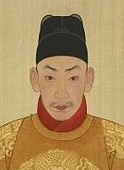



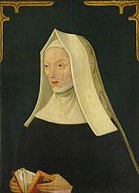
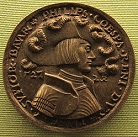
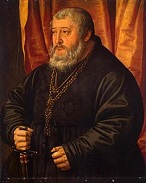
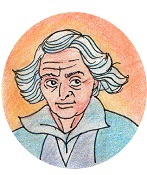
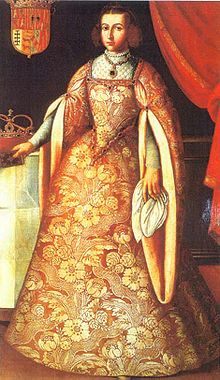

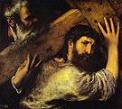


1505 On Mar. 22 after signing the Treaty of Blois with Louis XII of France, who cedes his claim to the kingdom of Naples and the kingdom of Jerusalem to her, conditional on a male heir being produced, dead Isabella I the Catholic's husband Ferdinand II the Catholic marries teen fox (granddaughter of his half-sister) Germaine de Foix (1488-1538), daughter of Louis XII's sister. In May Amerigo Vespucci begins his Fifth Voyage (ends Dec.). On June 8 emperor (since Sept. 22, 1487) Hongzhi (b. 1470) dies, and on June 19 his 14-y.-o. eldest son Zhengde ("right virtue") (Zhu Houzhao) (1491-1521) becomes Ming emperor #10 of China (until Apr. 20, 1521), becoming friendly with the Muslims and commissioning Muslim eunuchs to produce blue-white porcelain with Persian and Arabic inscriptions, and being rumored to convert to Islam although his debauched lifestyle denies it; European syphilis reaches Canton; an edict prohibiting the slaughtering of pigs is passed during his reign; eunuch minister Liu Jin (1451-1510), leader of the Eight Tigers group of court eunuchs establishes his power in the Chinese govt., imprisoning 300+ officials and becoming the most corrupt official in Chinese history, the emperor in all but name? On July 2 (Wed.) German cocksman, er, law student Martin Luther (b. 1483) is struck by lightning in Erfurt (a four in a million chance?), and on July 16 sees the light and enters the St. Augustine Monastery (Augustinekloster) in Erfurt (130 mi. SW of Berlin) (until 1511). On July 30 German king Maximilian I holds a meeting at the Reichstag (Diet) in Cologne, and gives Bavaria-Landshut to Albert IV of Bavaria-Munich, finally uniting Bavaria (split since 1349) and ending the Landshut War of Succession (begun 1503), but reserves the fragmented Palatinate-Neuberg (Junge Pfalz), stretching from the Upper Danube in Franconia to the N end of the Upper Palatinate to George the Rich's grandsons Philip the Upright (Aufrichtige), Elector Palatine (1448-1508) and Otto Henry, Elector Palatine (1502-59), with capital at Neuberg an der Donau, and Palatine Count Frederick II as regent; for his trouble the HRE takes the city of Kufstein in the Tyrol on the Inn River (location of a neat 13th cent. fortress) for himself, and gives the imperial city of Nuremberg important territories, incl. Lauf, Hersbruck, and Altdorf; when Otto Henry grows up he becomes one of the top German Renaissance builders, building a magnificent palace in Neuburg an der Danau and improving Heidelberg Castle. On Oct. 27 grand duke (since 1462) Ivan III the Great (b. 1440) dies, and on Nov. 6 his son Vasily (Vasilii) (Basil) III Ivanovich (Gavril) (1479-1533) becomes grand duke of Muscovy (Moscow) and "sovereign of all Russia" (until Dec. 3, 1533). John Zapolya (1487-1540) and the anti-foreign Hungarian nobles secure a decree by the Hungarian Diet that after the death of the current king Vladislaus I, no foreign ruler will be chosen as king of Hungary - the Hungarian language is too hard for foreigners to learn? On Nov. 24 Ferdinand II of Aragon and Philip I the Handsome sign the Treaty of Salamanca, agreeing to rule horsehead-shaped Castile (the main cut of Spain) jointly with Ferdinand's daughter Juana the Mad; Henry VII repudiates the betrothal of his son Prince Henry to Catherine of Aragon, since her dead mother Isabella I's kingdom of Castile and Leon is breaking up and it's time to flush the garbage?; Catherine is left stranded without support in England. HRE Maximilian I begins reforming the Holy Roman Empire into a universal Hapsburg monarchy. The spics, er, Spanish Castilians take Qassasa and Marsa al-Kabir in the Maghreb (Maghrib) (Morocco, Algeria and Tunisia). The Uzbeks recapture Samarkand from the Timurids. Hugh Roe O'Donnell dies, and his son Sir Hugh Dubh (pr. "doo") O'Donnell (-1537) becomes king of Tyrconnell in Ulster, Ireland (until 1537), expanding O'Donnell power into N Connaught while developing an alliance with the English crown authorities in Dublin, getting knighted by Henry VII in London in 1513 after a 1511 pilgrimage to Rome; meanwhile he leaves his boy son Manus O'Donnell (-1564) in charge, who turns traitor and allies with the hated O'Neills, causing daddy to appeal to the Maguires for aid, leading to another clan war in 1522. Spanish navigator Juan de Bermudez (Bermúdez) (-1570) discovers Bermuda (650 mi. E of N.C.). in his ship La Garza en route from Hispaniola to Spain. The Khmer royal court moves from Phnom Penh to Udong. You're ruining my genius career, you bum? Ferdinand Magellan (1480-1521) sets out on his first expedition to the East Indies to install adm. Dom Francisco de Almeida (1450-1510) as the first Portuguese gov. (viceroy) of the East Indies, incl. India, where he works to exclude Muslims and Venetians from a slice of the commerce pie - I want to give you this Capitol One check for a million dollars? The Kilwa Sultanate off modern-day Tanzania, ruled since 1277 by the Abu Moaheb family is overthrown by the Portuguese, and begins fragmenting, with some being absorbed by Oman. In 1505 Sri Lanka (Ceylon) is discovered by Portuguese explorer Lourenco de Almeida (1480-1508) (son of Francisco de Almeida), who founds a settlement. Humanist churchman John Colet (1467-1519) becomes dean of St. Paul's in London (until 1519), going on to preach against auricular confession and clerical celibacy and promote Bible reading, influencing Erasmus. Albrecht Durer visits Venice for the 2nd time, and keeps a studio there until 1507, studying the Venetian masters, esp. Giovanni Bellini (1430-1516), which ends his problem with angularity and stiffness in his figures. Monte Cassino Abbey in Italy, founded in the 6th cent. by St. Benedict of Benedictine Rule fame is joined with the monastery of St. Justina of Padua. The U. of Seville in Spain is founded as the Colegio Santa Maria de Jesus. Christ's College at Cambridge U. (founded 1437) is refounded by Lady Margaret Beaufort, Countess of Richmond and Derby (1443-1509), mother of Tudor king Henry VII; alumni later incl. John Milton and Charles Darwin. The Barber Surgeons of Edinburgh is founded. A comet "as big as the Moon" is seen in London - ahoo, werewolves of London? James IV of Scotland builds the £8K ship Margaret at Leith using an imported wooden keel, then establishes larger royal dockyards at Newhaven and Airth on the Forth River to build larger ships. Architecture: Pope Julius II commissions Michelangelo to build his Tomb of Pope Julius II in the Church of San Pietro in Vincoli, in the hills above the Colosseum, complete with 42 large statues; too bad, after spending over a year designing it and transporting marble from Carrara, the project is abandoned for lack of funds, and he takes until 1545 to finish it after joining the Spirituali and turning Moses' head away from the altar to signify that he doesn't look to the Church for salvation. The Mosque of Bayezid II in Constantinople is finished, becoming the first Ottoman monument showing influence from the Hagia Sophia basilica. Science: Italian mathematician Scipione del Ferro (1465-1526) partially solves the cubic equation, obtaining the full solution in 1520. Nonfiction: Christopher Columbus (1451-1506), Book of Prophecy (Prophecies); compiled before his 1502 voyage; how the Holy Spirit and the Scriptures inspired his discovery of the New World, predicting the End of the World in 155 years. Johannes Scotus, World Map. Jakob Wimpfeling (1450-1528), Epitome Rerum Germanicarum. Art: Giovanni Bellini (1430-1516), Altarpiece of Church of San Zaccaria, Venice. Vittore Carpaccio (1460-1526), Life of the Virgin Mary (6 scenes); incl. Donors in Adoration. Albrecht Durer (1471-1528), The Life of the Virgin (engravings). Il Giorgione (1477-1510), Trial of Moses; Judgment of Solomon (twin paintings). Lorenzo Lotto (1480-1556), The Maiden's Dream. Il Perugino (1445-1523), Combat of Love and Chastity. Raphael (1483-1520), Small Cowper Madonna. Il Sodoma (1477-1549), Life of St. Benedict (32 scenes) (1505-8) (Convent of Monte Oliveto, Siena). Titian (1477-1576), Christ Carrying the Cross (Chapel of San Rocco, Venice); Man of Sorrows (Scuola di San Rocco, Venice). Leonardo da Vinci (1453-1519) begins to paint the life-size Battle of Anghiari (a little fracas in which one man is killed falling off his horse) in the Council Chamber of Florence's Palazzo Vecchio, but is called to Milan before finishing; later in this cent. Giorgio Vasari paints murals over it; in 2005 the image is found intact behind a false wall. Poetry: William Dunbar (1460-1520), The Dance of the Sevin Deidly Synnis (1505-8). Births: German Hohenzollern prince-elector #6 of Brandenburg (1535-71) (Roman Catholic-turned-Protestant) Joachim II Hector (d. 1571) on Jan. 31 in Colln; eldest son of Joachim I Nestor (1484-1535). Polish poet ("the Father of Polish Literature") Mikolaj (Nikolaj) (Nicholas) Rej of Naglowice (d. 1569) on Feb. 4 in Zurawno (modern-day Zhuravno, Ukraine). Swiss "Chronicon Helveticum" historian Aegidius (Giles) (Glig) Tschudi (d. 1572) on Feb. 5 in Glarus; known for his map drawings. English noblewoman Jane Boleyn (nee Parker), Viscountess Rochford (d. 1542) in Norfolk; sister-in-law of Anne Boleyn; lady-in-waiting to Catherine Howard. German adventurer Nikolaus Federmann (Nicolas de Federman) (d. 1542) in Ulm. English ambassador (to the HRE and Flanders) Philip Hoby (Hobby) (Hobbye) (d. 1558) in Leominster; half-brother of Sir Thomas Hoby (1530-66). French marshal (Roman Catholic) (favorite of Henry II) Jacques d'Albon, Seigneur de Saint-Andre () (d. 1562). Scottish Protestant reformer ("the Thundering Scot") John Knox (d. 1572) in Haddington; educated at the U. of Glasgow. English Bible scholar Richard Taverner (d. 1575) in Brisley (near Norwich); educated at Corpus Christi College and Cardinal College, Oxford U., and Cambridge U. Belgian Walloon composer Mattheus Le Maistre (d. 1577) in Roclenge sur Geer. Italian violinmaker family founder Andrea Amati (d. 1578) in Cremona; father of Antonio Amati (1550-) and Girolamo Amati (1551-1635); grandfather of Nicolo Amati (1596-1684); great-grandfather of Girolamo Amati (Hieronymus II) (1649-1740). French surgeon Pierre Franco (d. 1578); inventor of the suprapublic lithotomy cataract operation, and surgical repair of hernia; forerunner of urology. English organist-composer Thomas Tallis (d. 1585). Spanish "The Sinner's Guide" Dominican mystic monk poet Luis de Granada (Louis of Granada) (d. 1588) in Granada. Deaths: German composer Jakob Obrecht (b. 1430). Italian duke of Ferrara (1471-1505) Ercole I d'Este (b. 1431) on June 15. Polish-Lithuanian queen consort (1454-92) Elizabeth of Austria (Hapsburg) (b. 1436) on Aug. 30 in Cracow. Russian tsar (1462-1505) Ivan III the Great (b. 1440) on Oct. 27 in Moscow. Egyptian Muslim scholar Imam Jalaluddin al-Suyuti (b. 1445); leaves 20 vols. of Quranic studies, incl. Commentary of the Two Jalals. Chinese Ming emperor #9 (1487-1505) Hongzhi (b. 1470) on June 8. Algerian Muslim scholar Muhammad ibn Abd al-Karim al-Maghili (b. ?) in Tlemcen; known for bloodily expelling the city's Jews, who had lived there since 70 C.E.
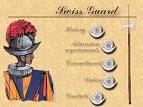






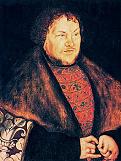


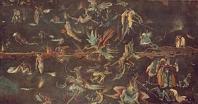
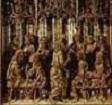




1506 On Jan. 21 the Swiss Guard (Guardia Swizzera), consisting of 10 officers and 110 men (all required to be Swiss, and non-officers required to be non-married) begins guarding Pope Julius II; their colorful vertical-striped tunics are said to have been designed by artist Michelangelo. In the spring 30K Crimean Tartars (allies of Moscow) under Menli I Girai's sons Fetih I Giray and Burnas I Gray invade Lithuania, and are routed on Aug. 6 by 7K-10K Lithuanians under marshal (since 1500) prince Michael (Mikhail) Lvovich Glinski (1470-1534) in the Battle of Kletsk. In Mar. the Battle of Cannanore is a decisive V for a small Portuguese fleet under Lourenco de Almeida over a 200+ ship Indian fleet manned by Hindus, Arabs, and Turks equipped with cannons manufactured with the help of two Italians from Milan. On May 20 Christopher Columbus (Cristobal Colon) (b. 1451) ("Don Cristobal Colon, Almirante") dies in Valladolid, Spain in wealth and luxury, marking the end of an era. Who needs a mad queen in Castile? On July 12 Philip I the Handsome (Fair) of Castile (b. 1478) becomes king of Castile (the first Hapsburg), briefly uniting the the kingdoms of Castile and Aragon through his wife Joanna the Mad, heir presumptive to the crown of Aragon; on July 27 the Treaty of Villafafila (Villafáfila) is signed by Ferdinand II the Catholic and Philip I the Handsome in Benavente, Zamora, confirming the incapacity of mentally unstable Juana the Mad to rule, and requiring Federinand II to cede all power to Philip I, who is proclaimed king of Castile and the Indies; too bad, on Sept. 25 he suddenly dies in Burgos, Castile of typhoid fever (poisoned by Ferdinand II?), and his wife Joanna (Juana) the Mad of Castile (1479-1555) (Isabella I's daughter) attempts to rule from Torquemada, causing Castile to go into anarchy, plague, and famine that kills half the pop., causing a council of regency under Archbishop Cisneros is created, who invite her daddy Ferdinand II to arrive next July, who quickly restores health and order, and talks her on July 30 into abdicating in his favor, after which in Feb. 1509 she is confined to the Santa Clara Convent in Tordesillas (near Valladolid) for life, while remaining legal queen of Castile (until Apr. 12, 1555), taking her hubby Philip's corpse with her to talk to, causing rumors that she went er, mad; Ferdinand II (the Catholic) assumes the regency of Castile (until Jan. 23, 1516), while Philip's dominions in the Low Countries go to his son Charles (later HRE Charles V). On Aug. 19 king (since Dec. 12, 1501) Alexander I dies, and on Dec. 8 his brother Zygmunt (Sigismund) I Stary (the Old) (1467-1548) becomes king of Poland and grand duke of Lithuania (until Apr. 1, 1548). On Nov. 12 after the king sets the Darien (Atrato) River as the boundary for the Terra Firme provinces of Castilla del Oro and Nueva Andalusia, Alonso de Ojeda (1465-1515) (new gov. of Nueva Andalusia) sails from Hispanola on two ships with 300 men, and on Nov. 15 Diego de Nicuesa (1464-1511) (former rich popular ladies man and official royal carver in Madrid, but an arrogant incompetent prick in the New World, causing him to be less popular than Ojeda), new gov. of Castilla del Oro sails from Hipanola on five ships with 700 men; Ojeda lands near Cartagena and tries to convert and subdue the pesky natives and squeeze them for gold, ending up pissing them off and getting most of his force killed, after which Nicuesa's force happens by after getting lost, and magnanimously rescues them, massacring every last Indian during their victory celebration, and taking a large booty; too bad, after ignoring his shipmates' advice and getting lost again, Nicuesa's ship runs aground off the coast of Panama, and half of his men are killed by hostile natives and disease by the time they make it to their destination overland at Belen, after which they find the land laid waste by the Indians to starve them, forcing them to move to new digs in Puerto Bello (Sp. "beautiful port"), finding a half-buried anchor left by Columbus, after which they are soon driven out by the Indians. In Nov. Cesare Borgia (b. 1476) escapes from prison in Naples to Navarre and joins the king in an expedition against Castile, where he is KIA in battle in Viana next year - another episode of Toy Story, starring the Artist Formerly Known as Prince? He needs a woman in Windsor? The Treaty of Windsor betrothes archduke Philip's sister Margaret of Austria to Henry VII's son Henry, prince of Wales; Philip undertakes the extradition of Yorkist pretender Earl Edmund of Suffolk, who is imprisoned in the Tower of London. Philips de Schone dies, and HRE Maximilian I becomes regent over the Dutch regions for the 2nd time, and appoints his daughter Margaret (Margaretha) (1480-1530) as governess. Genoa revolts from French rule. Bologna is incorporated by Pope Julius II into the papal states (until 1796). The castle of Scottish rebel Torquil MacLeod of Lewis in Stornoway (on the NE coast of the 100-mi.-long island of Lewis and Harris in NW Scotland) is sieged by Alexander, 3rd earl of Huntly, causing MacLeod to flee and rebel leader Donald Duck, er, Domhnall Dubh (-1545) to be captured; too bad, the pesky highlands keep up their revolt until 1509. The Uzbeks capture Bukhara (W of Samarkand). Swiss parish priest Ulrich Zwingli (b. 1484) is assigned to the town of Glarus, a center for recruiting mercenaries. Franz von Taxis becomes postmaster gen. for the Hapsburg Empire, founding a mail-carrying dynasty. Niccolo Machiavelli creates the Florentine Militia, Italy's first nat. army. Sultan Bajazet recovers Alessio (in modern-day Albania) from the Venetians. Timurid ruler (since 1469) Husayn Bayqara dies, and the Timurid Dynasty founded by Timur (Tamerlane) in Iran goes up for grabs. Yonsan Gun is depoosed in a coup for tyranny, and his half-brother Chungjong (Yi or Lee Yeok) (1488-1544) becomes Yi king of Korea (until Nov. 29, 1544). Ships from France (Fahlanki) enter the Humen (Bogue) (Bocca Tigris) Strait in the Pearl River Delta, and promise tribute; too bad, their noisy cannon piss-off the pop., causing the emperor to order them to leave immediately. After having to pass up a job as viceroy of India due to temporary blindness, Portuguese explorer Tristao da Cunha (1460-1540) (cousin of Afonso de Albuqueraue) sails to the E coast of Africa in a fleet of 15 ships to conquer Socotra Island, discovering the five volcanic Tristan da Cunha Islands 1.2K mi. from Saint Helena Island, the most remote archipelago on Earth, which remains uninhabited until 1810, visiting Madagascar and Mozambique before conquering Socotra - you don't even have a rear window wiper? Augsburg merchant Jakob Fugger (1459-1525) begins importing spices from the East Indies to Europe, and so profitably that he becomes known as "the Rich", one of the richest men in history - oh to live on Sugar Spice Mountain with the Fuggers and the colored balloons? The U. of Frankfurt an der Oder (European U. Viadrina Frankfurt), the first state univ. in Brandenburg is founded by Hohenzollern prince-elector (1499-1535) Joachim I Nestor (1484-1536); too bad, he backs the Roman Catholic Church all the way against the pesky Lutherans, then watches his wife Anna of Brandenburg and her hubby king Christian III of Denmark go Protestant, along with Brandenburg, and ends up fleeing to Saxony in 1528; the univ. is transferred to Breslau in 1811. The U. of Urbino in Urbino, Italy is founded. The Laocoon (Laocoön) Group (Laocoon and His Sons) of 2nd cent. B.C.E. sculptures are rediscovered at the palace of Titus in Rome. Leonardo da Vinci returns to Milan, and begins compiling the 72-page Codex Leicester ms. (finished 1508-9), which theorizes that sunlight reflected from the oceans acts as a secondary light on the Moon; he bequeaths it to his pupil Francesco Melzi, and it goes through the hands of Milanese sculptor Guglielmo della Porta, then Giuseppe Ghezzi in 1690, followed in 1717 by Thomas Coke, Earl of Leicester, giving it its name; Armand Hammer acquires it in 1980, followed by Bill Gates in 1994. Architecture: The Vatican builds its Pentagon before the U.S. has even been thought of? Donato Bramante starts work on St. Peter's Basilica in Rome by demolishing the original 4th cent. Church of St. Peter, employing 2.5K men for many weeks in throwing out tombs, statues, mosaics, icons and altars; too bad his new bldg. has faults in it which are found after his death and are too costly to fix, and it ends up taking 120 years and 27 popes, tapping out the resources of the Vatican - despite being totally vaporizable by a small suitcase-sized nuke? Seville Cathedral in Spain is finished, passing Hagia Sophia as the world's largest cathedral, later becoming the burial site of Christopher Columbus. Nonfiction: Johann Reuchlin (1455-1522), Rudimenta Linguae Hebraica; first Hebrew grammar written by a Christian. Art: Hieronymus Bosch (1450-1516), The Last Judgment (1506-8). Lucas Cranach the Elder (1472-1553), St. Catherine (altar piece). Gerard David (1460-1523), The Annunciation. Albrecht Durer (1471-1528), Feast of Rose Garlands (church of San Bartolommeo, Venice); Christ Crucified; Madonna with a Siskin; an attractive little finch. Giorgione (1477-1510), Portrait of a Young Man; Laura (Portrait of a Young Bride); displays her wares to show she's fertile, and carries a laurel branch to show she's a virgin. Castelfranco Madonna; enthroned Madonna with St. Francis on right and St. Nicasius (St. George?) (St. Liberalis, patron of Castelfranco?) on the left, bearing the emblem of the Knights of Rhodes, with no ecclesiastical bldgs. in sight; paints it without a prior drawing. Raphael (1483-1520), Madonna of the Meadow (Madonna del Belvedere). Tilman Riemenschneider (1460-1531), Altar at St. Jacob's (Rothenburg). Births: Scottish humanist historian George Buchanan (d. 1582) in Feb. in Killearn, Stirlingshire; educated at Scots College, Paris. Spanish Jesuit co-founder and missionary ("Apostle of the Indies") (St.) Francis Xavier (Basque for "new house"?) (Francisco de Jasso y Azpilicueta) (d. 1552) on Apr. 7 in Javier, Navarre (Spain). English soldier and lord protector of England (1547-9) Edward Seymour, 1st Duke of Somerset (d. 1552) (b. 1500?); son of Sir John Seymour (1474-1536) and Margery Wentworth (1478-1550); brother of Thomas Seymour (1508-49) and Jane Seymour (1509-37). German Roman Catholic humanist scholar bishop Michael Helding (d. 1561) (AKA Sidonius) in Langenenslingen bei Riedlingen-Sigmaringen; educated at the U. of Tubingen. Hungarian Renaissance composer-lutenist (first Hungarian classical composer?) Balint Bakfark (d. 1576) in Brasov, Transylvania; educated at the court of John Zapolya in Buda. Deaths: Italian painter-engraver Andrea Mantegna (b. 1431) in Mantua; buried in San Andrea Church, where his pupils adorn the walls with frescoes. Flemish composer Alexander Agricola (b. 1446). French Roman Catholic priest Johann Burchard (b. 1450) in Rome; leaves Liber Notarum, chronicling papal ceremonies, incl. the Banquet of the Chestnuts held by Cesare Borgia in the Papal Palace on Oct. 30, 1501. Italian-Spanish-Portuguese-Jewish Christ-bearing Dove (Devil's Spawn?) Christopher Columbus (b. 1451) on May 20 in Valladolid, Spain; dies in wealth and comfort after causing the looting, rape, torture, and death of an endless parade of millions of innocent people, and still believing he found a new route to Asia; leaves the Mayorazo (Majorat), an alleged last will and testament dated 1498, which is presented by Italian imposter Balthazar Colombo, and contains the first statement that Columbus was born in Genoa; he is buried in a church there; in 1509 his coffin is moved to Triana, near Seville; in 1541 it is moved to Santo Domingo in the Dominican Repub.; in 1795 after Santo Domingo falls to France it is moved to Havana; in 1902 it is moved to Seville, Spain; in 1877 it is discovered that his coffin is still in a vault beneath the Cathedral of Santo Domingo; in 1973 dust from his coffin enclosed in two lockets is put up for auction, but nobody bids; he's really in the Dominican Repub. in a coffin dug up in 1877? Polish king (1501-6) and Lithuanian grand duke (1492-1506) Alexander Jagiellon (b. 1461) on Aug. 19 in Vilnius. Korean Joseon king #10 (1494-1506) Yeonsan-gun (b. 1476) on Nov. 20. Spanish Castilian king (1506) Philip I the Handsome (b. 1478) on Sept. 25 in Burgos, Castile (typhoid fever).







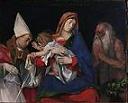

1507 On Apr. 27-Aug. the 4-mo. Siege of Cannanore by 40K Indian nayar and 20K Indian samorin forces from Calicut aided by Arabs results in another Portuguese V after their massive artillery firepower staves off infantry attacks, only to be slowly starved until a tidal wave washes a load of lobsters ashore on Aug. 15, and 11 ships under Tristao da Cunha arrives on Aug. 27 from Socotra, landing 300 soldiers to relieve the siege. In Apr. Vasili III of Russia invades Lithuania with two armies, starting the Third Russian-Lithuanian War (ends 1508); the Crimean khan defects to the Polish-Lithuanian side; marshal Michael (Mikhail) Lvovich Glinski (1470-1534) of Lithuania revolts and attempts to turn Vilnius to Russia, but is defeated. On Aug. 13 Dawit II (Wanag Segad = "to whom lions bow") (Lebna Dengel) (1501-40) becomes Solomonic emperor of Ethiopia (until Sept. 2, 1540), with Empress Mother Eleni as regent (until 1516), sending Armenian emissary Mateus (Matthew) the Armenian (-1520) to Portugal in 1514 to seek aid in fighting off the neighboring Muslim countries. On Oct. 10 Alfonso de Albuquerque and Tristan de Cunha capture Hormuz Island at the mouth of the Red Sea. In Dec. 11-y.-o. Mary Rose Tudor (1496-1533), younger sister of Henry VIII is betrothed to 7-y.-o. archduke Charles of Burgundy (b. 1500) (later HRE Charles V), but it is later dropped after political alliances shift; meanwhile Margaret of Austria is made regent of the Netherlands and guardian of her nephew Charles. The Genovese revolt is crushed by Louis XII of France. The Diet of Constance recognizes the unity of the Holy Roman Empire, and founds the Imperial Chamber. The Portuguese under Dom Francisco de Almeida ravage the Muslim port of Goa and other seaports on the Indian coast. After discovering Socotra Island in 1503, Portuguese navigator Diogo Fernandes Pereira discovers volcanic mountainous reefed Mauritius Island 500 mi. E of Madagascar, naming it Ilha do Dirne, but doesn't settle it; he also discovers the rest of the Mascarenhas Archipelago incl. Mauritius, Reunion, and Rodrigues, becoming the first Euro to sail E of Madagascar. After Safavid Shiite propaganda makes inroads among the Turcomans of E Anatolia and Iraq, causing the Turkish sultan to deport large numbers of them to the Peloponnesus, the Safavids under Shah Ismail I invade Kurdistan and take Diyarbakr, Baghdad and all of Iraq (1507-8); meanwhile the wild-card Uzbeks under Muhammad Shaybani occupy the Timurid S capital of Herat, then begin raiding the Kazakhs to the N. Future world shaker Martin Luther is ordained - watch them barkers and colored balloons, brothers? English Roman Catholic priest Thomas Wolsey (b. 1475) becomes Henry VII's royal chaplain, and after showing his caginess as a diplomat he becomes dean of Lincoln in 1509. Danish king Christian II begins hooking up with commoner Norwegian girl (of Dutch heritage) Dyveke (Dutch "little pigeon") Sigbritsdatter (-1517), who becomes his mistress; when he later marries a royal babe, she dies of a broken heart in 1517, helped by eating poisoned cherries. Italian humanist Polydore Vergil (1457-1555), who came to England in 1501 as deputy collector of Peter's Pence and became bishop of Bath and Wells in Oct. 1504 is appointed historiographer to Henry VII, who commissions him to write the history of England (finished 1533). Albrecht Durer returns to Nuremberg from Venice (until 1520). Vicente Yanez Pinzon and Diaz de Solis sail along the E coast of Central Am. Secular Hebrew studies are introduced in French and German univs. Architecture: Palazzo Strozzi in Florence (begun 1489) is finished. German sculptor Peter Vischer the Elder (1455-1529) designs the Renaissance-style Shrine of St. Sebaldus in St. Sebaldus Church (Sebalduskirche) in Nuremberg, with a Gothic canopy and a statuette of himself, becoming his masterpiece (finished 1519). The Church of Santa Maria di Loreto in Rome, designed by Antonio da Sangallo the Younger (1484-1546) is begun; they are still adding to it 75 years later. Science: Italian-born John Damian attempts to fly by strapping on chicken-feather wings and jumping from the walls of Stirling Castle in Scotland; too late he remembers that chickens don't fly. Orlando Galla of Venice improves the manufacture of glass mirrors. Nonfiction: Alvise Cadamosto, La Prima Navigazione per l'Oceano alle Terre de' Negri della Bassa Ethopia; the exploration of Gambia. The name "America" is first used by German cleric-cartographer Martin Waldseemueller (Waldseemüller) (1470-1520) of the Monastery of Saint-Die-des-Vosges in Lorraine, France in his Cosmographiae Introductio in honor of Amerigo Vespucci; it contains a world map titled Universalis Cosmographia incl. the first depiction of the Western Hemisphere, showing America as an island surrounded by water, and saying "It is fitting that this fourth part of the world, inasmuch as Americus discovered it, be called Amerige, or let us say, land of Americi, that is, America"; the depiction of a body of water to the W of America before the discovery of the Pacific Ocean remains a modern mystery; on Apr. 30, 2007 (500th anniv.) it is officially given to the U.S. by German chancellor Angela Merkel. Art: Il Giorgione (1477-1511) and Titian (1477-1576), Fondaco dei Tedeschi (Venice). Lorenzo Lotto (1480-1556), Madonna with Child and Four Saints (incl. St. Onuphrius). Il Perugino (1445-1523), Virgin Between St. Jerome and St. Francis. Raphael (1483-1520), Madonna di Casa Colonna. Births: Italian condottiero Ferrante I Gonzaga (Ferdinand de Gonzague) (d. 1557) on Jan. 28 in Mantua; 3rd son of Francesco II Gonzaga (1466-1519) and Isabella d'Este (1474-1539); brother of Federico II Gonzaga (1500-40); father of Cesar Gonzaga (-1575); uncle of Louis de Nevers (Gonzaga) (1539-95); pupil of Bernardino Baldi (1533-1617). Chinese Ming emperor #11 (1521-67) Jiajing ("admirable tranquility") (Zhu Houcong) (d. 1567) on Sept. 16; cousin of Zhengde; son of Zhu Youyuan, prince of Xing (1476-1519), 4th son of Changhua, and Lady Shao. French anatomist (prof. of anatomy at Montpellier) Guillaume Rondelet (Rondeletius) (d. 1566) on Sept. 27. German humanist educator (founder of the Gymnasium system) Johannes (Jean) Sturm (Ioannes Sturmius) (d. 1589) on Oct. 1 in Schleiden (near Cologne); does great things in Strasbourg beginning in 1537. Spanish gen. (under HRE Charles V and HRE Philip II) Fernando Alvarez de Toledo y Pimentel, "Iron Duke" of Alba (Alva) (d. 1582) on Oct. 27 - whose portrait bears a striking resemblance to British Prince Charles wearing a clown suit? English queen ("Anne of a thousand days") Anne Boleyn (Bullen) (d. 1536) (pr. BOO-len or buh-LIN); daughter of Sir Thomas Boleyn and Elizabeth Howard (daughter of the duke of Norfolk); 2nd wife of Henry VIII; mother of Elizabeth I. Russian metropolitan (one of the five Russian hierarchs) (St.) Philip II of Moscow (Feodor Stepanovich Kolychev) (d. 1569) in Galich (modern-day Kostroma Oblast); born into a noble boyar family; feast days: Jan. 9, July 3, and Oct. 5. French chancellor (1560-68) Michel de l'Hopital (d. 1573) near Aigueperse, Auvergne (Puy-de-Dome). Deaths: Italian St. Francis of Paola (b. 1416) on Apr. 2. Venetian painter Gentile Bellini (b. 1429). Florentine painter Cosmo di Lorenzo Filippi Rosselli (b. 1439). German geographer-navigator Martin Behaim of Nuremberg (b. 1459) on July 29 in Lisbon. Italian "The Prince" Renaissance condottiere Cesare Borgia (b. 1475) on Mar. 12 in Viana, Spain; his portrait ends up being used for Jesus Christ?




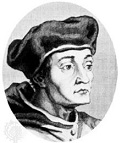





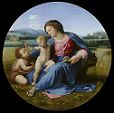



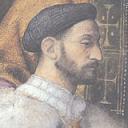
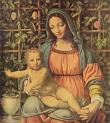
1508 On Mar. 18 Bavarian duke (since 1465) Albert IV (b. 1447) dies after winning the War of the Landshut Succession (begun 1503) and introducing primogeniture via edict in 1506, and his, er, eldest son William IV (1493-1550) becomes duke of Bavaria in Ingoldstadt (until Mar. 7, 1550), going on to become a leader of the Counter-Reformation; too bad, younger brother Louis X isn't happy with getting none, finagling his way into a share by 1516. In the spring Michelangelo yields to Pope Julius II's pleas and returns to Rome (by force?), giving up the Medici tomb he wanted to sculpt, then late in the year after learning how to paint frescoes begins painting the vaulted Ceiling of the Sistine Chapel (named after Pope Sixtus IV) for the Medicis (at the suggestion of Donato Bramante, who is jealous of him, and thinks he will refuse, break with the pope, or mess it up, either way causing him to leave Rome and let his relative Raphael become Rome's #1 painter?); it takes four years (until Nov. 1512), unassisted and grumbling all the way to paint 300 Biblical (all Jewish) figures and "ignudi" (nude youths) on 1K sq. yds. of plastered surface while lying curled up under the ceiling, writing a poem to a friend: "My stomach is thrust towards my chin,/ My beard curls up towards the sky,/ My head leans right over onto my back,/ My chest is like that of an old shrew./ The brush endlessly dripping onto my face/ Has coated it with a multi-colored paving./... I am as bent as a Syrian bow"; also, "I am neither working in a pleasant environment, nor am I a painter" (how degrading for a famous sculptor to have to do frescoes?); he refuses to camouflage the size and shape of the huge vaults, and instead uses painted tromp l'oeil (Fr. "trick of the eye") architecture to frame them; the paintings have Qabbalah messages, and there are two instances of ignudi flipping the fig at the pope? In Mar. the Battle of Chaul Harbor in India is a decisive Mamluk and Indian V over the Portugese under Lourenco de Almeida, becoming their first D in the Indian Ocean; Almeida dies during the sinking of his ship at the harbor entrance. On Apr. 10 Guidobaldo I da Montefeltro (b. 1472) dies without an heir, and after Pope Julius II (his other uncle) pulls strings, his nephew Francesco Maria I della Rovere (1490-1538) becomes duke of Urbino (until 1538), going on to work to recover Senigallia from the Borgias. On Oct. 8 after Michael Glinski is defeated at Minsk and Orsha, and the Polish-Lithuanian army forces the Russians to retreat, Tsar Vasili III signs an Eternal Peace Treaty with Lithuania, rolling the territorial boundaries back to 1503. On Dec. 22 Rene II (b. 1451) dies, and his son Antoine the Good (1489-1544) becomes duke of Lorraine (until 1544), going on to back the Counter-Reformation and quelch several popular revolts. Russia and Sweden sign a 60-Year Peace Treaty. The League of Cambrai is formed by Margaret of Austria, the Cardinal of Rouen (France), and Ferdinand II of Aragon (Spain) to divide the Italian possessions of long overripe Venice - you believe in Santa Claus don't you? German king (since 1493) Maximilian I (1459-1519) assumes the title of elected HRE without being crowned by Pope Julius II (between choir boys) after he confirms the fact that from now on the German king automatically becomes HRE without needing the papal formality. The Portuguese under Francisco da Alameda defeat the kingdom of Calicut in a sea battle. The Portuguese occupy Muscat, Oman (until 1648), building it up and fortifying it to protect their sea lanes to/from India. The Uzbeks under Muhammad Shaybani take Khurasan from the timid Timurids under Babar, and raid the Kazakhs. Sebastian (Sebastián) de Ocampo travels clear around Cuba, proving that it's an island. Castilian Conuistador Juan Ponce de Leon (1460-1521) begins the conquest of Puerto Rico (until 1512), founding the first settlement of Caparra next year, getting named gov. in 1509 (until 1512), and going on to discover gold and force the Taino Indians to work the mines, where they die like flies while he grows rich. Juan de Esquivel Barahona (1480-1519) settles Jamaica. The first sugar mills are established on Santo Domingo, which organizes enslavement expeditions to nearby islands. Jakob Fugger is created a hereditary knight of the Holy Roman Empire - Sir Fugger? His mother's called what? Pope Julius assigns Michelangelo-wannabe Raphael to paint a series of frescoes in the new exclusive Papal Apts. in the 3rd (top) floor of the Apostolic (Vatican) Palace in Rome (used for admin. purposes only until 1870, the papal residence being the Quirinal Palace); he works on them until 1517, while Michelangelo works in the bigger Sistine Chapel. Il Sodoma goes to Rome (until 1515) and paints frescoes in the Camera della Segnatura in the Vatican (where the pope signs acts of grace); too bad, most of them are later repainted by Raphael (1483-1520), who throws him a bone by painting his portrait beside his own in his "School of Athens" on one of the walls - it's not amica, it's how you're treated? The Latin term "encyclopedia" is coined from the Greek "enkyklios paideia", meaning "in a circle" plus "education". Desiderius Erasmus of Rotterdam confuses the vase or jar of Pandora with a box, creating a confusion that lasts till modern times - clean freak? Italian Venetian humanist (later cardinal) Girolamo (Hieronymous) (Jerome) Aleandro (Aleander) (1480-1542) begins teaching Greek at the U. of Paris, then becomes Vatican librarian in 1519, later heading the opposition to Martin Luther at the Diet of Worms. Martin Luther becomes a student at the U. of Wittenberg - no spring break at Ft. Lauderdale for you, brother? Walter Chapman and Andrew Myllar establish the first press in Scotland in Edinburgh; their first pub. is Bishop William Elphinstone's Aberdeen Breviary (1509-10), Scotland's first liturgy. Architecture: Althorp Manor in Northamptonshire, England is acquired by Sir John Spencer (1455-1522), going on to remain in possession of the Spencer family until modern times. Siena-born Italian architect-painter Baldassare Peruzzi (1481-1536) begins building the Renaissance-style Villa Farnesina in Rome (finished in 1511). Nonfiction: Guillaume Bude (1467-1540), Notes on the 24 Books of Pandects (Annotationes in XXIV. libros Pandectarum) (posth.); uses philology and history to throw light on the study of Roman law. Johannes Trithemius (1462-1516), The Seven Secondary Intelligences (De Septem Secundeis id est Intelligentiis); history of the world based on astrology. Art: Albrecht Durer (1471-1528), Praying Hands; Madonna with the Iris; at least a lot of German babes are really blonde? Giorgione (1477-1510), Sleeping Venus. Lorenzo Lotto (1480-1556), Sacra Conversazione; Madonna and Child with St. Dominic, St. Gregory and St. Urban; Portrait of a Young Man in Black in Front of a White Cloth. Bernardino Luini (1475-1532), Madonna del Roseto (Madonna with a Rose Garden); paints her with slightly squinted eyes, which Vladimir Nabokov later calls "Luinesque". Raphael (1483-1520), The Alba Madonna. Leonardo da Vinci (1452-1519), Anatomical Drawing of a Female; an unflattering drawing attempting to illustrate the circulatory and other systems, but only displaying his ignorance of women's private parts and his own homosexual proclivities? Plays: Ludovico Ariosto (1474-1533), Cassaria (comedy). Poetry: Robert Henryson (Henrysoun) (-1507), The Moral Fables of Aesop the Phrygian; "Although the nut's shell is hard and tough, it holds the delightful kernel. So there lies a wise and fruitful teaching underneath an imaginary fable. And learned men say it is very profitable to mingle merry sport with earnest matters, to lighten the spirit and speed the time." Novels: Conradus Celtis (-1459), The Maying or Disport of Chaucer (posth.); first book printed in Scotland? Garcia Ordonez de Montalvo, Amadis de Gaula (Gaul); rev. of a 14th cent. romance about a knight who loves Princess Oriana, becoming the #1 novel of chivalry, spawning many imitators incl. Miguel Cervantes. Births: Indian Mughal (Mogul) emperor #2 (1530-40) Humayun (Nasir ud-din Muhammad Humayun) (d. 1556) on Mar. 7 (Old Style) in Kabul; son of Babur (1483-1531); father of Akbar the Great (1542-1605). French Pleiade poet and classical scholar ("the Modern Pindar") Jean Dorat (Daurat) (Joan Dinemandy) (d. 1588) on Apr. 3 in Limoges; teacher of Jean-Antoine de Baif (1532-89). Italian #1 architect (founder of the Palladian style) Andrea Palladio (Andrea di Pietro della Gondola) (d. 1580) on Nov. 30 in Padua, Venice; moves to Vicenza at age 13. Flemish cartographer Regnier (Reiner) Gemma Frisius (d. 1555) on Dec. 9 in Dokkum, Friesland; educated at the U. of Leuven. English queen (1536-7) Jane Seymour (d. 1537); daughter of Sir John Seymour (1474-1536) and Margery Wentworth (1478-1550); brother of Edward Seymour (1506-52) and Thomas Seymour (1508-49). English lord high adm. Thomas Seymour, 1st Baron Seymour of Sudeley (d. 1549); son of Sir John Seymour (1474-1536) and Margery Wentworth (1478-1550); brother of Edward Seymour (1506-52) and Jane Seymour (1509-37); husband (1547-8) of Catherine Parr (1512-48). Spanish explorer Juan de Salazar de Espinoza (Emiliano Gomez Suarez) (d. 1560) in Espinosa de los Monteros. Croatian ban (1542-56) Nikola Subic Zrinski (d. 1566) in Zrin. Deaths: Jewish statesman-theologian Isaac Abravanel (b. 1437). Bavarian duke (1465-1508) Albert IV (b. 1447) on Mar. 18 in Munich. French duke of Lorraine (1483-1508) Rene II (b. 1451) on Dec. 10 in Fains. Italian duke Ludovico Sforza ("Il Moro") of Milan (b. 1452) on May 27 in Loches Castle, France (POW). German humanist scholar-poet Conradus Celtis (b. 1459) on Feb. 4 in Vienna. German sculptor Adam Kraft (b. 1460); designed the Gothic tabernacle of Nuremberg's Church of St. Lawrence. Italian duke of Urbino (1482-1508) Guidobaldo I da Montefeltro (b. 1472) on Apr. 10 in Fossombrone (pellagra).






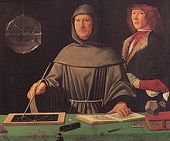

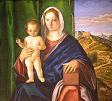
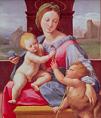


1509 On Feb. 2 after an Indian king who had paid tribute to Vasco de Gama in 1506 refuses to pay tribute to Dom Francisco de Almeida (1450-1510) (father of Lourenco de Almeida) the Portuguese win the Battle of Diu (Second Battle of Chaul Harbor) in the Arabian Sea off Diu, India against Indian forces allied with Egyptian Mamluks, wiping out their fleet and establishing Portuguese control over the spice trade; too bad, Ferdinand Magellan, who participates in the battle takes leave without permission, and falls out of favor with Almeida for trading illegally with the Moors, causing him to become unemployed until 1515. The second Cannae, or, Darling you gotta let me know, should I stay or should I go? HRE Maximilian I joins the League of Cambrai and sieges but fails to capture Padua from Venice, even though his troops hold it for a few weeks; Jakob Fugger lends him 170K ducats to finance his (fuggin'?) war against Venice; Pope Julius II della Rovere, "Papa de Terribile" joins the League of Cambrai and excommunicates Venice on Apr. 27; France declares war on Venice, and on May 14 the French defeat the Venetians at the Battle of Agnadello, making the Venetian Empire kaput; the Jewish-controlled Venetians now begin subverting England? In the spring Bogdan III of Moldavia invades Poland, and is severely defeated on Oct. 4 at the Battle of the Dniester River. On Apr. 21 (night) English king (since Aug. 22, 1485) Henry VII (b. 1457) dies rich in bed in Richmond Palace, and his athletic 6'2" 2nd son Henry VIII (1491-1547) becomes the 40th monarch of England and the 2nd Tudor king (until Jan. 28, 1547); favorite horse: Canicida; since he has no son, his brother-in-law James IV of Scotland is named his heir, which doesn't set well with the English; on June 11, claiming it was his dead father's wish, and ignoring politicians on both sides who dispute her claim to being a virgin, he marries Catherine of Aragon (1485-1536), daughter of Ferdinand II after Pope Julius II okays it and issues a dispensation for the marriage; the lovely torture instrument called the rack is first commonly used in his reign? - it's all done with hidden ketchup and mayo packages? On Aug. 22 an earthquake in the Sea of Marmara followed by several weeks of aftershocks destroys Constantinople, followed by 66 more shocks between 1711-1894 - just when they begin copying Christian architecture? The Spanish under Francisco Jimenez de Cisneros capture Oran in North Africa. Portuguese-speaking aborigine Nzinga Mbemba (Mvemba a Nzinga) (1456-1543) becomes king Alfonso I of the Kingdom of Kongo in Congo, Cabinda, and N Angola, with capital at M'banza-Kongo, and sets about trying to Christianize the kingdom; too bad, in the long run his efforts fail - other than to sweeten the pot? Concerned about their growing power, the Safavids under Shah Ismail I invade Transoxiana to take on Muhammad Shaybani (ends 1610). Alfonso de Albuquerque becomes gov. of Portuguese India (until 1515). Nicolas de Ovando is replaced as gov. of Hispaniola (since 1502) by King Ferdinand with Diego Columbus after he makes a promise to Queen Isabella on her deathbead; Ovando is allowed to keep his property. Diego de Nicuesa founds the colony of Castilla de Oro on the Gulf of Uraba (Panama), extending to the Belen River. A Jewish persecution begins in Germany; converted Jew Johannes Pfefferkorn (1469-1524) receives authority from Maximilian I to confiscate and destroy all Jewish books in Germany, despite the opposition of humanist Johann Reuchlin (1455-1522). After Henry VII's death, Thomas Moore reenters public life, and is appointed under-sheriff of London next year. Vicente Yanez Pinzon and Diaz de Solis sail along the SE coast of South Am. Brasenose College (Ger. "Brassenhuss" = brewhouse) at Oxford U. is founded by lawyer Sir Richard Sutton (-1524) and Lincoln bishop (1496-) William Smyth (Smith) (1460-1514) on the site of a brewery, becoming the last of the pre-Reformation colleges; future students incl. author Richard Burton, antiquarian Elias Ashmole, and John Foxe. The first attempt to license medical doctors is made in Europe. Inventions: Wallpaper is invented as a substitute for tapestry. Nonfiction: Anon., Fortunate and His Sons (Augsburg); German book of Schwank stories. John Fisher (1469-1535), The Seven Penitential Psalms (London). Luca di Pacioli (1445-1517), De Divina Proportione (On the Divine Proportion); composed in 1498 in Milan; study of the golden ratio; illustrations by his math student Leonardo da Vinci, becoming the first skeletonic solids permitting an easily distinction between front and back, incl. the first printed illustration of a rhombicuboctahedron; the Metropolitan Museum of Modern Art in New York City later takes their M logo from it. Art: Fra Bartolommeo (1472-1517), The Rest on the Flight Into Egypt with St. John the Baptist; the J. Paul Getty Museum in Los Angeles, Calif. pays $22M for it. Giovanni Bellini (1430-1516), Madonna and Child. Albrecht Durer (1471-1528), Small Passion (1509-10) (37 woodcuts); incl. Christ Appearing to the Magdalen, showing him wearing a brimmed pirate-style hat and carrying a shovel with her kneeling before him. Ridolfo Ghirlandaio (1449-94), Portrait of a Lady. Il Giorgione (1477-1510), Knight of Malta. Raphael (1483-1520), The Aldobrandini (Garvagh) Madonna (1509-10). Andrea del Sarto (1486-1531), Miracles of St. Philip. Leonardo da Vinci (1452-1519), The Virgin and Child with St. Anne (1509-10) (1503?). Births: Spanish Dominican theologian-bishop Melchior Cano (d. 1560) on Jan. 1 in Tarancon, Cuenca. Italian cardinal (1538-) Ippolito II d'Este (d. 1572) on Aug. 25 in Ferrara; son of Duke Alonso I d'Este and Lucrezia Borgia; brother of Duke Ercole II d'Este; named after his uncle. French "if you're happy don't clap your hands" Protestant predestinarian religious reformer (founder of the Presbyterian Church) John Calvin (Jean Chauvin) (Cauvin) (Caulvin) (d. 1564) in Noyon, Picardy; lives in Switzerland - the original chauvinist? Dutch Anabaptist leader John of Leiden (Leyden) (d. 1536) in Leiden; illegitimate son of a Dutch mayor; starts out as a tailor's apprentice. Spanish (Basque) conquistador Domingo Martinez de Irala (d. 1556) in Bergara, Guipuzcoa. Italian Mannerist painter-sculptor Daniele Ricciarelli da Volterra (d. 1566) in Volterra, Tuscany; known for his portrait of his boss Michelango, and being hired in 1565 to paint fig leaves on the genitals of Michelangelo's "The Last Judgment" (1541), gaining him the nickname "Il Braghettone" (the Breeches Maker). Italian humanist physician-scholar-mathematician Federico Commandino (d. 1575) in Urbino; tr. of Euclid, Archimedes, Aristarchus of Samos, and Pappus of Alexandria; teacher of Guidobaldo del Monte (1545-1607). French marshal (1570-) (Roman Catholic) Gaspard de Saulx, Sieur de Tavannes (d. 1509) in Dijon. Spanish conquistador Gonzalo Jimenez de Quesada (d. 1579) (b. 1496?) (b. 1506?) in Cordoba. Italian goldsmith-sculptor Leone Leoni (d. 1590). Italian Renaissance anti-Aristotelian philosopher-scientist ("First of the Moderns") Bernardino Telesio (d. 1588) in Cosenza, Calabria; teacher of Franciscus Patricius (1529-97). Deaths: French writer Philippe de Commines (b. 1445). Italian architect Simone de Cronaca (b. 1454). English king (1485-1509) Henry VII (b. 1457) on Apr. 21 in Richmond Palace. Nuremberg sculptor Adam Krafft (b. 1460).

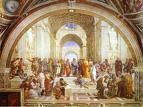
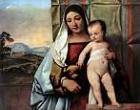









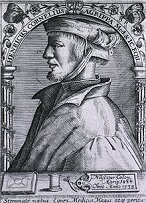



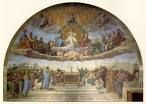
1510 On Jan. 17 the Polish-Moldavian Peace Treaty is signed, and prince (since 1504) Bogdan III the One-Eyed (1470-1517) of Moldavia renounces all claims to Poland; too bad, the Tartars invade Moldavia twice, and carry away up to 74K slaves by next year, causing the Poles to send troops to his aid. On Jan. 22 the Jews are expelled from Colmar, Germany. On Jan. 29 Pskov, Russia's last free repub. loses its charter. In Jan. Gen. Alfonso de Albuquerque (1453-1515), Portuguese gov. of India loses a battle to the Muslim kingdom of Cochin, then captures the Muslim island of Goa off the coast of Malabar on Nov. 25, and razes its Muslim mosques and Buddhist shrines, establishing W Europe's first toehold in India, used to spread Roman Catholicism into Asia (AKA Nova Roma); Portugal retains it until 1961. On Feb. 10 Pope (since 1503) Julius II (1443-1513) makes peace with Venice and lifts his excommunication of it, and turns on Louis XII of France and his League of Cambrai; cagey swinger (3rd husband of Lucrezia Borgia) Duke Alfonso I d'Este of Ferrara (1476-1534) refuses to give up his allegiance to Louis XII, and rubs it in by taking the shards of Michelangelo's bronze statue of him toppled by the pop. of Bologna and making it into a cannon called "La Giulia", then mounting it on his castle ramparts, causing the pissed-off pope to excommunicate him and forfeit his fiefs, making Ferrara part of the Papal States; Alfonso tells the pope to stuff it and goes on to fight against the armies of both Venice and the pope; meanwhile the Swiss join the League of Cambrai. On Mar. 1 after getting caught stealing cattle, a Portuguese exploration party led by Portuguese viceroy Dom Francisco de Almeida (b. 1450) (first Portuguese viceroy of India) is massacred at Table Bay by the native Khoikhoi (Hottentots), who kill 64 soldiers and 11 captains along with Almeida, causing the Portuguese to decide to stick to the E coast of Africa. In the summer the world's first known influenza pandemic starts in Asia and rapidly spreads to Africa and Europe by ship; the death rate is low and the pandemic ends quickly. Holy Dildoes, Batman? On July 2 Pope Julius II issues a bull authorizing the creation of a bordello in the Prostitute's Quarter, a special section of Rome considered not too close to the papal palace (but close enough to work off dinner); his successors Leo X and Clement VII require the hos to deed over one-fourth of their possessions to the convent of Santa Maria Magdalena. After what's left of his party (100 of 600) flees to yet another harbor, Spanish conquistador Diego de Nicuesa (1464-1511) utters the soundbyte "Let's stop here in the name of God", and they found Nombre de Dios (Sp. "Name of God") on the Atlantic coast of Panama, which becomes a major port of call for the Spanish treasure fleet, and the first Euro town in Panama and the Am. mainland; too bad, it is situated near an unhealthy swamp, and is hard to fortify, and by 1580 Veracruz, Mexico becomes more popular; meanwhile the party of Alonso de Ojeda (1465-1515) founds the colony of San Sebastian, then is forced out by the Indians, after which he sets out for Hispaniola, leaving Francisco Pizarro in charge, then gets shipwrecked before reaching Santo Domingo, croaking in 1515; meanwhile on Sept. 1 Ojeda's rich atty. friend (financial backer) Martin Fernandez de Enciso (1470-1528) heads out from Espanola, with poor ignorant pig farmer Vasco Nunez (Núñez) de Balboa (1474-1519) of Hispaniola stowing away on his ship to avoid creditors, after which he is discovered then talks him into going to the Gulf of Uraba, where they find San Sebastian deserted, then talks him into going to the W side of the gulf, where they found Santa Maria de la Antigua; too bad, yellow fever and malaria reduce the 800 original Spanish pop. to 60, causing them to revolt and elect Balboa as chief, after which in mid-Nov. a relief force for Nicuesa led by Rodrigo Enriquez de Colmenares arrives, finding Nicuesa in Nombre de Dios with far less than 100 men; too bad, Nicuesa throws a feast, gets drunk, and boasts of all the hell he will put his enemies through when he gets to Antigua, causing everybody to consider him a lunatic, after which Nicuesa makes a mistake and allows ambassadors to be sent ahead of him who spread the word. On Dec. 2 after Safavid Shiite Persian shah (since 1502) Ismail I (1487-1524) sends a force of Qizilbash to Transoxiana to aid Timurid ruler Babar in his war against the upstart Genghis Khan descendant Uzbeks, and they conquer former Timurid possessions Herat, Khurasan, and Samarkand from them, they defeat the griffinless Uzbeks at the Battle of Merv, and kill their leader Muhammad Shaybani (Sheibak Khan) (b. 1451), ending his dynasty; Ismail sends his head to the Ottoman sultan as a warning that Sunnis shouldn't mess with badass Shiites, and sends various body parts around his empire for display, making a golden drinking cup from his skull; Shaybani is succeeded by an uncle, a cousin and a brother, whose descendants rule Bukhara until 1598, then Khwarezm (Khiva) along the Amu Darya (Oxus) River until 1687; meanwhile a pro-Safavid insurrection led by Shah Kulu Baba captures most of E and SE Anatolia and causes Ottoman troops to switch sides, until a force commanded by the grand vizier defeats them and kills him. The Medicis reach Rome, and get Pope Julius II (who is also from a powerful and wealthy family) to support the raising of an army to recapture pesky republican Florence. John Zapolya is made gov. of Transylvania to get him away from the Hungarian king's daughter Anna, whom he is trying to marry. Sweden declares war on the Teutonic Order (ends 1511), and invades and conquers Ingermanland, while a Teutonic army sneaks through and captures Kexholm in Karelia, giving the pesky duchy of Courland ideas. Syphilis reaches the Shetland Islands. Hamburg becomes a free city of the Holy Roman Empire. Henry VII's ministers Sir Richard Empson and Edmund Dudley are beheaded by Henry VIII for misadmin. of crown revenues. Tripoli in N Africa is taken by the Spanish under Don Pedro Navarro, Count of Oliveto; in 1523 it is assigned to the Knights of St. John. The E coast of America is explored by the Spanish as far as Charleston, S.C. Spanish slave owner Bartolome de las Casas (1484-1566) of Hispaniola becomes the first Roman Catholic priest (Dominican) to be ordained in the New World; in Sept. a group of Dominican friars led by Pedro de Cordoba arrives in Santo Domingo and get pissed-off by Indian slavery, denying slave owners the right to confession, incl. las Casas; next Dec. Antonio de Montesinos preaches against Indian slavery, calling it genocide, pissing-off the slave owners led by Diego Columbus, who get the king to recall the Dominicans from Hispaniola. Roman Catholic monk Martin Luther is sent to Rome as a delegate of his order (until 1511). Johann Eck (1486-1543) becomes a prof. of theology at the U. of Ingolstadt (until 1540), and a friend of Martin Luther until the latter's break with the Roman Catholic Church, receiving a copy of the 95 Theses in 1517 and going on the attack - you have to break a few Ecks to make an omelet? Bolognese line engraver (known for pirating Albrecht Durer's work) Marcantonio Raimondi (1475-1534) moves to Rome, working as Raphael's asst. to engrave his paintings from preliminary paintings which Raphael often finished differently; when Raphael dies in 1520, he goes on to engrave the works of his followers incl. Giulio Romano. After inheriting the wealth of his father Sir Henry Colet (lord mayor of London), St. Paul's dean (since 1505) John Colet (1467-1519) refounds St. Paul's School in London (1510-12) with an annual income, and dedicates it to the Child Jesus to give young boys a Christian education, with the Co. of Mercers appointed as trustees, becoming the first non-clerical education mgrs.; he starts out with 153 boys to go with John 21:11; after Erasmus turns it down, grammarian William Lilye (1468-1522) (first teacher of Greek in London) becomes its first headmaster. Abbot Philotheos (Philotheus) (Filofei) of Pskov (1465-1542) utters his Third Rome Prophecy: "The Church of Old Rome fell for its heresy; the gates of the second Rome, Constantinople were hewn down by the axes of the infidel Turks; but the Church of Moscow, the Church of the New Rome shines brighter than the Sun in the whole Universe... Two Romes are fallen, but the third stands fast; a fourth there cannot be"; he also pub. the Legend of the White Cowl, about a white cowl given by Emperor Constantine to Pope Sylvester I, which was eventually sent to Constantinople Patriarch Philotheos, who sent it to archbishop of Novgorod, causing the Russian Orthodox patriarch and metropolitans to wear white cowls; in 1564 a church council confirms their right to wear white cowls and use red wax seals on correspondence. Leonardo da Vinci (1452-1519) succeeds Sandro Botticelli as grandmaster of the Priory of Sion (until 1519) :), and finishes compiling his Notebooks. Inventions: Leonardo da Vinci designs the Horizontal Water Wheel, basis of the water turbine. In this decade the Sunflower is introduced from the Americas to Europe by the Spanish; at first it is only used for ornament. Nonfiction: Anon., Probierbergbüchlein (assaying); Bergbüchlein (mining); the first European handbooks on metallurgy. Heinrich Cornelius Agrippa von Nettesheim (1486-1535), Declamation On the Nobility and Excellence of the Feminine Sex; uses occult cabalistic ideas to try to prove the superiority of women, esp. his patron Margaret of Austria; "So let me begin my subject at the beginning. Woman was created as much superior to man as the name she has received is superior to his. For Adam means earth, but Eve is translated as life. And as far as life is to be ranked above earth, so far is woman to be ranked above man"; De Occulta Philosophia. Thomas More (1478-1535) (tr.), The Lyfe of Johan Picus Erle of Mirandula. Art: Albrecht Durer (1471-1528), Charles the Great; Emperor Sigismund. Giorgione (1477-1510), Sleeping Venus; starts a trend of featuring the female figure as the principal subject of the picture - like the way they put Ahnuld out of the action movie biz? Sebastiano del Piombo, Salome. Raphael (1483-1520), Disputation of the Blessed Sacrament; incl. paintings of several theologians; The School of Athens; shows Plato with Leonardo da Vinci's face in a red robe waving a copy of "Timaeus", alongside Aristotle in a blue robe carrying his "Ethics"; portrays Greek artist (Alexander the Great's personal painter) Apelles (2nd from the left) with his own face; Heraclitus is shown with Michelangelo's face wearing a dark pink robe resting his head on his arm while writing; Socrates, Pythagoras, Diogenes, Epicurus, Euclid, Zoroaster, and Ptolemy are also depicted - where is the Dan Brown book on it? Il Sodoma (1477-1549), The Flagellation of Christ; Ecce Homo; Descent from the Cross; The Road to Cavalry. Titian (1488-1576), The Gypsy Madonna; Sacred and Profane Love (1510-12) (Villa Borghese, Rome) (clothed and nude figure in a sunny landscape). Music: Henry VIII (1491-1547), If Love Now Reigned. Plays: Anon., Everyman; morality play based on the 1495 Dutch morality play Elckerlijk by Peter Dorland van Diest. Novels: Garcia Ordonez de Montalvo, Las Sergas de Esplandian; first use of the name "California". Births: Italian duke of Florence (1532-7) Alessandro de' Medici "Il Moro" (The Moor) (d. 1537) on June 22 in Florence; illegitimate son of Giulio de' Medici (Pope Clement VII) and North African maid Simonetta da Collavecchio. Russian grand princess consort (1526-38) Elena Vasilyevna Glinskaya (d. 1538); niece of Mikhail Glinsky; wife (1526-) of Vasili III; mother of Ivan IV the Terrible (1530-84) and Prince Yuri (1532-63). English royal physician (to Edward VI, Mary I, and Elizabeth I) John Caius (Kays) (d. 1573) (pr. like keys) on Oct. 6 in Norwich, Norfolk; educated at Gonville Hall, Cambridge U.; founder of Gonville and Caius College, Cambridge U. (1557). Dutch Flemish Northern Renaissance Mannerist painter Henri Met de Bles (Herry de Patenir) (d. 1550) in Bouvignes (Dinant?); AKA Il Civetta (It. "the Owl") from his signature. Spanish explorer, gangbanger and Mexico City councilman Francisco Vasquez de Coronado y Lujan (Francisco Vázquez de Coronado y Luján) (d. 1554) in Salamanca, Castile. Finnish Lutheran theologian-bishop ("Man of the Dawn") ("Father of Written Finnish") Michael Agricola (d. 1557) in Torsby. English (Welsh) mathematician Robert Recorde (d. 1558) in Tenby, Wales. Spanish conquistador Lope "El Loco" (the Madman) de Aguirre (d. 1561) in Onate (Oñate); of Basque (car door ears) descent. French Old 100th Calvinist musician Loys "Louis" Bourgeois (d. 1561). English printer-engraver (Flemish refugee) Thomas Geminus (Lambrit) (d. 1562) in Lille. Italian composer-keyboardist Antonio de Cabezon (d. 1566). Portuguese financier (Jewish) Dona Gracia (Hannah) Mendes Nasi (Beatrice de Luna Miques) (d. 1569) in Lisbon; aunt of Don Joseph Nasi (1524-79); one of the wealthiest Jewish women of Renaissance Europe. English botanist William Turner (d. 1568). Flemish painter Frans Verbeeck the Elder (d. 1570) in Mechelen; one of 15 Frans Verbeecks from Mechelen. French portrait painter Francois Clouet (d. 1572); son of Jean Clouet (1480-1541); last of the French primitifs; likes solid pale delicate colors and doesn't use chiaroscuro. English soldier William Howard, 1st Baron of Effingham (d. 1573); father of Charles Howard, 2nd baron of Effingham and 1st earl of Nottingham (1536-1624); brother of Henry Howard, earl of Surrey (1517-47). Italian astronomer Aloysius Lilius (Luigi Lilio or Giglio) (d. 1576) in Ciro, Naples. Spanish Mannerist painter Luis de Morales (d. 1586) in Badajoz, Estremadura. Spanish viceroy #3 of New Spain (1566-8) Gaston Carrillo de Pealta y Bosquete, 3rd Marquis of Falces (d. 1587) in Pau, Navarre. English surveyor-gen. of Ireland (1559-89) Sir Valentine Browne (d. 1589). French Huguenot faience potter and writer Bernard (de) Palissy (d. 1589) near Agen. French barber surgeon Ambroise Pare (Paré) (d. 1590) in Bourg-Hersent (near Laval). Deaths: Italian painter Sandro Botticelli (b. 1445) on May 17. German preacher and theologian Johann Geiler von Kaiserberg (b. 1445). Italian nun St. Catherine of Genoa (b. 1447). Portuguese soldier Dom Francisco de Almeida (b. 1450) in Table Bay, Cape of Good Hope; KIA in a battle with Khoikhoi Hotentots. Spanish navigator-cartographer Juan de la Cosa (b. 1450) on Feb. 28 in Turbaco, Colombia (KIA). Chinese minister Liu Jin (b. 1451) on Aug. 25 in Beijing; executed via death by a thousand cuts; 450K kg of gold and 9.7M kg of silver are found in his residence, making him one of the top 50 wealthiest persons of the past millennium. Uzbek ruler Muhamma Shaybani Khan (b. 1451) in Merv. Italian queen of Cyprus (1474-89) Caterina Cornaro (b. 1454) on July 10 in Venice. English soldier Edmund Dudley (b. 1462). Saxon duke Frederick von Wettin (b. 1474) on Dec. 14 in Rochliz; dies heirless because Teutonic grandmasters can have sex and sex and sex and sex, but not get married and shattered. Polish cardinal Frederick Casimir (b. ?) in Cracow; his Renaissance-style grave slab is designed by Peter Vischer the Elder.

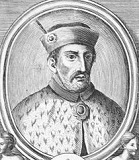
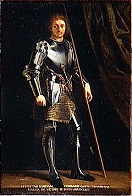





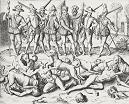
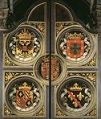
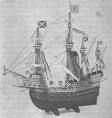

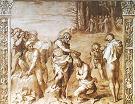


1511 In Jan. after Pope Julius II forms the Holy League with HRE Maximilian I and Venice to drive the French out of Italy, with duke Francesco Maria I della Rovere (1490-1538) of Urbino as CIC of papal troops, and Sicilian viceroy (1507-9) and viceroy of Naples (since 1509) Ramon de Cardona (1467-1522) (who introduced the Inquisition in Naples, causing a popular revolt that gets the decree canceled by the Spanish king) as CIC of the League of Cambrai army; they capture Modena and Mirandola from the French, who strike back and take Bologna on May 13 after the arrival of new cmdr. Gaston de Foix, Duke of Nemours (1489-1512), causing the pope in Oct. to enlist Henry VIII of England and Ferdinand II and Isabella I of Spain in the Holy League, while James IV of Scotland renews his Auld Alliance with France and seeks to build up a rival league of France, Scotland, Ireland, and Denmark; too bad, on Jan. 20 after failing to take Bologna, Rovere has diplomat-cardinal Oliviero Carafa (b. 1430) (relative of Giovanni Pietro Carafa, who becomes Pope Paul IV) killed, causing him to be compared to mean Cesare Borgia. What's that noise? In Mar. insane tyrant Diego de Nicuesa is voted out of power in Antigua and deported on a dilapidated ship that wrecks en route to Espanola, killing all aboard; meanwhile after sending Enciso back to Spain, Balboa has fun enslaving and looting the local pop. the Catholic Spanish way, incl. setting wild dogs on same-sex married females (lesbians), gays, and other Indians he thinks are too un-Christian to fool with; after cents. of suppression of same-sex marriage and homosexuality, followed by a coverup for the winning side, in 2004 U.S. Pres. George W. Bush utters the immortal soundbyte: "The union of a man and woman is the most eduring human institution, honored and encouraged in all cultures and by every religious faith." On Apr. 9 St. John's College at Cambridge U. is chartered; Desiderius Erasmus (1466-1536) of Rotterdam, having "done" Oxford begins lecturing at Cambridge (until 1514), home of Thomas More, staying at Queen's College. On May 11 the Duchy of Courland declares war on the Teutonic Order (ends 1515), and gains the support of Poland-Lithuania, while the order gains the support of the Hanseatic League and distant England, which can't do much to help; after the 11K-man Courland army invades Memel, the Polish army under Michael Glinski invades Livonia and takes Dorpat, then conquers E Pomerania, while the Hansa army captures W Prussia; too bad, Sweden declares peace with the order in return for cash, and pumps up its army and invades Courland, causing Courland to make peace with the Hansa after agreeing to pay them 63 ducats, and Poland to make peace with the Order for 108 ducats, leaving Courland to fight on alone. On July 25 after Portuguese navigator Antonio de Abreu (1480-1514) leads a Chinese junk up the Malacca River at high tide, allowing them to land, the Portuguese under Gen. Afonso de Albuquerque conquer Malacca (Melaka)near the Strait of Malacca in the S Malay Peninsula, enter of the spice trade (until 1641); not seeking to colonize but only trade, they send envoys to open trade relations with neighboring states while building fortified trading posts; meanwhile the southernmost Malaysian state of Johore, home of 4,180 ft. Mt. Ophir (Gunung Ledang) is founded as a Muslim state, with capital at Johore Bahru (Baru) (Baharu) ("new") on the S coast, 15 mi. N of Singapore. On Aug. 2 Scottish high adm. and privateer (carrying a letter of marque from the Scottish crown) Sir Andrew Barton (b. 1466) is mortally wounded in a sea battle with English adm. Sir Edward Howard (1746-1513), beating a drum to encourage his sailors before bleeding to death, pissing-off his friend James IV, who claims an English violation of the 1502 Treaty of Perpetual Peace; the English counter with "who do ya think you're kidding, he's just a pirate"; Barton passes into an English folk song: "I am not hurt but I am not slain./ I'll lay me down and bleed awhile,/ Then I'll rise and fight again." Tits of the morning to ya, captain? On Aug. 14 the Ceiling of the Sistine Chapel (begun in 1508), painted by Michelangelo di Lodovico Buonarroti Simoni (1475-1564) is officially unveiled, with Pope Julius celebrating Mass, although he takes until next All Saint's Day (Halloween) (Nov. 1) to put in the finishing touches (the lunettes) and invite the public to view it; his many Ignudi (nude youths with flaccid weenies at the corners of the main pictures, and nude women with big tits and shaved bushes) stir accusations of paganism, which Michelangelo answers by calling them symbols of truth and purity, and which the Church officials solve by painting over the lewd parts: he gets away with eight rams heads representing the female reproductive system at the bottom of giant Vs representing male organs; Eve holds her arms out in a V-shape representing you know what; "My eyes which are in love with beauty and my soul which is in love with salvation can only ascend to heaven by the contemplation of all the beauty surrounding me"; the Church is still debating whether women have souls; as a Neoplatonist he believes that the soul can attain grace and remember God only by breaking the chains binding it to Earth, i.e., by asceticism, and that beauty equates with goodness? On Aug. 15 after Christopher Columbus' son Diego sends an expedition commanded by Spanish conquistador Diego Velazquez de Cuellar (Velázquez de Cuéllar) (1465-1524) to conquer Cuba, he founds the city of Baracoa on the E tip (modern-day pop. 82K), becoming the oldest Spanish settlement in Cuba and its first capital, giving it the nickname "Ciudad Primada" (First City). In Nov. the English leave Navarre in S France after promised Spanish forces don't arrive; Henry VIII gets tired of faking it and begins to reform the English royal navy, building double-deck 1K-ton 70-gun ships - it's not the size of the package it's the motion of the ocean is a total lie? After Diego Columbus goes to Madrid to stake his claims, Juan Ponce de Leon is removed as Spanish gov. of Puerto Rico, causing him to begin exploring new areas to the N of Cuba to stake his own claims. Scottish sea capt. (a privateer known for preying on English and Continental shipping with his brothers John and Robert) Albert (Albrecht) I of Hohenzollern (1490-1568), maternal nephew of Polish king Sigismund I and member of the Hohenzollern family is elected grandmaster #37 of the Teutonic Knights in Prussia (until 1525), hoping to peacifully settle the long dispute over East Prussia, which has been held by the Order under Polish suzerainty since the 1466 Second Peace of Torun; meanwhile he refuses to submit to the Polish crown and negotiates with HRE Maximilian I to go to war if necesary - gotta pay your dues if you want to sing the blues, and you know it don't come easy? On Oct. 11 Giovanni de' Medici (later Pope Leo X) is appointed papal legate of Bologna and the Romagna, working to end the Pisan Schism, which is backed by the Florentine Repub. (ends 1517). The first Spanish audiencia (royal tribunal and govt.) in America is founded in Santo Domingo (Española). The city of Parma is ceded to the Holy See. The longtime feud between the Colonna and Orisini families in Rome is ended by a papal bull; in 1571 the heads of both families marry the nieces of Pope Sixtus V and kiss and make up. Thomas Wolsey begins his rise to power with appointment as privy councilor in charge of foreign and domestic affairs in England. Deominian friar Antonio de Montesinos (1480-1545) gives a sermon decrying the mistreatment of the Am. aborigines. Dutch scholar Desiderius Erasmus (1466-1536) becomes prof. of Greek at Cambridge, going on to trans. the New Testament and shake up the Bible-ignorant Roman Catholic world. The Cosentian Academy (Accademia Cosentina) (originally Accademia Parassiana) in Cosenza, Italy is founded by Aulo Giano Parassio (1470-1522), known for his large library; after his death Bernardino Telesio (1509-88) reorganizes and renames it Accademia Telesiana. Architecture: Leonaro da Vinci begins studies for the Trivulzio Monument for Gian Giacomo Trivulzio (1440-1518) of Milan. Margaret of Austria is begun of the late Gothic-style Church of Brou in Bourg-en-Bresse, on the Reysouze River 38 mi. NE of Lyons in memory of her hubby Philip IV the Fair of Savoy (finished 1536), later becoming the subject of a famous poem by Matthew Arnold, beginning "Down the Savoy valleys sounding,/ Echoing round this castle old,/ 'Mid the distant mountain chalets/ Hark! what bell for church is toll'd?" Architecture: The dome of newly-completed (1506) Seville Cathedral in Spain collapses; ditto in 1888. The Villa Farnesina (begun 1508) is finished. Inventions: The 4-mast 300-gun Great Michael is built at Newhaven dockyard in Scotland, becoming one of the largest wooden-walled ships ever built, using so much wood that it depletes the oak forests of Fife and causes Norwegian wood to have to be imported, skyrocketing the total cost to £30K after outfitting - shouldn't that be Great John Lennon? Science: Italian-born Peter Martyr d'Anghiera (1457-1526) is appointed by HRE Charles V as the chronicler for the Council of the Indies, going on to pub. eight "Decades", descriptions of all the exciting voyages and discoveries in the New World, and become the first writer to realize the significance of the Gulf Stream, which is first discovered in 1513 by Juan Ponce de Leon's expedition. Nonfiction: Peter Martyr d'Anghiera (1457-1526), Opera, Legatio, Babylonica, Oceanidecas, Paemata, Epigrammata; first of his eight Decades (1511-25); first account of the Spanish New World discoveries, incl. the first mention of "La Bermuda" among Atlantic islands. Desiderius Erasmus (1466-1536), In Praise of Folly (The Praise of Folly) (Stultitiae Laus) (Morias Enkomion); written in 1509; inspired by Faustino Ferisauli's "De Triumpho"; big hit mocking superstition, helping launch the Protestant Reformation, which he never joins; makes a fan of Pope Leo X; dedicated to his friend Thomas More, on whose estate in Bucklersbury he composed it in one week; full of double and triple entendres, incl. the Dutch title, launching the field of Adoxography, "fine writing on a trivial or base subject"; the 1515 Basel ed. is illustrated by Hans Holbein the Younger. Peter Martyr d'Anghiera (1457-1526), Opera, Legatio, Babylonica, Oceanidecas, Paemata, Epigrammata; first historical account of the Spanish New World discoveries. Johann Reuchlin (1455-1522), Augenspiegel (Mirror of the Eye); argues against the destruction of Hebrew books unless they contain anti-Christian polemic - I'm a believer, I'd never leave her if I tried? Arnolt Schlick, Spiegel der Orgelmacher und Organisten. Martin Waldseemuller, Map of Alsace, Lorraine, and the Rhine Valley; accurate. Art: Vittore Carpaccio (1460-1526), Life of St. Stephen (1511-20). Albrecht Durer (1471-1528), Adoration of the Trinity. Il Giorgione (1477-1510), Pastoral Symphony; attributed to Titian because of the similarity of styles. Matthias Grunewald (1465-1528), Art for the Isenheim Altar (1511-15). Lorenzo Lotto (1480-1556), Self-Portrait. Raphael (1483-1520), Private Papal Library (first of three rooms in the papal apts.); on each of its four upper walls is a female muse (Theology, Philosophy, Poetry, and Justice); two frescoes adorn the lower wall; he also paints The Triumph of Galatea. Andrea del Sarto (1486-1531), Frescoes in the Chiostro dello Scalzo, Florence (1511-26); grisaille (monochrome) frescoes, incl. The Baptism of Christ Titian (1488-1576), Life of St. Anthony (frescoes in the Scuola di San Antonio, Padua). Plays: Gil Vicente (1470-1536), Auto de los Cuatro Tiempos. Births: Scottish king (1513-42) James V (d. 1542) on Apr. 10 in Linlithgow, West Lothian; son of James IV (1473-1513) and Margaret Tudor (1489-1541) (daughter of Henry VII of England). Italian painter-architect-biographer and art historian Giorgio Vasari (d. 1574) on July 30 in Arezzo, Tuscany; coins the term "Renaissance" (Rinascita) in 1550; works for the Medicis restoring the broken hand of Michelangelo's statue of David and filling Florence with frescoes? Spanish (Catalan) scholar-scientist-physician-philosopher (Unitarian) ("Father of Comparative Geography and Ethnography") Michael (Miguel) Servetus (Serveto) (Servet) (d. 1553) on Sept. 29 in Villanueva de Sijena, Huesca, Aragon; mother's line is converted Jews; pioneer in the theory of the pulmonary circulation; at age 16 goes to the U. of Toulouse to study law, where he reads a Bible for the first time, shaking his faith in Roman Catholicism? German astronomer Erasmus Reinhold (d. 1553) on Oct. 22 in Saalfeld, Thuringia; educated at the U. of Wittenberg. Dutch Renaissance Latin poet Johannes (Janus) Secundus (Jan Everaerts) (d. 1536) on Nov. 15 in The Hague; son of Nicolaes Everaerts (friend of Erasmus). Burmese Hanthawaddy king #18 (1526-39) Thushin Takayutpi (d. 1539) in Pegu; eldest son of Binnya Rhan II (1469-1526). Portuguese physician-botanist (Jewish) Amatus Lusitanus (Amato Lusitano) (Joao Rodrigues de Castelo-Branco) (Haviv) (d. 1568) in Castelo-Branco; educated at the U. of Salamanca; discoverer of the circulation of the blood? Italian architect Giovanni Sallustio Peruzzi (d. 1573) in Siena; son of Baldassare Peruzzi (1481-1536). Deaths: Italian diplomat-cardinal Oliviero Carafa (b. 1430) on Jan. 20 (executed). Flemish composer Johannes Tinctoris (b. 1436). Turkish adm. Kemal Reis (b. 1451) in the Mediterrean Sea (storm). Spanish conquistador Diego de Nicuesa (b. 1464) near Hispanola (shipwreck). English poet Stephen Hawes (b. 1475). Venetian painter Il Giorgione (b. 1477) in Venice (plague).


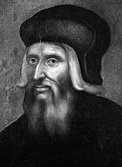


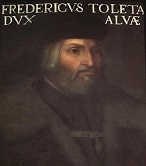
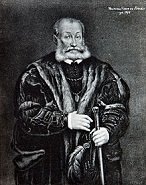



1512 On Jan. 2 Swedish regent (since 1504) Svante Nillson (b. 1460) dies, and on Jan. 15 Eric Trolle (Erik Arvidsson) (1460-1530) is elected regent of Sweden, then desposed on July in favor of Sten Sture the Younger. On Feb. 6 John Colet (d. 1519), dean of St. Paul's in London since 1505 gives a Convocation Sermon to the clergy of Canterbury in London Cathedral, in which he calls himself "a man sorrowing for the ruin of the Church", and says that he came "to admonish you with all your minds to deliberate... concerning the reformation of the Church", saying that the four great evils it has fallen into are devilish pride, carnal concupiscence, worldly covetousness, and worldly occupations, which later causes him to be labeled a pseudo-Protestant although he stays loyal to the Roman Catholic Church and dies before the Reformation reaches England (and the Protestants later fall into the same evils themselves?); next year on Good Friday he gives another sermon before the royal court arguing against England's war with France on the grounds that all war is wrong and Christians should fight only for Christ. On Feb. 18 after 23K French forces in Italy (incl. 8.5K landsknechts and Gascon infantry) under new cmdr. (since 1511) Gaston de Foix, Duke of Nemours (1489-1512) begin capturing cities in the Romagna and Veneto to deny them to the Holy League, and Brescia revolts against the French and is garrisoned with Venetian troops, the Sack of Brescia sees the French attack in a rainstorm through a field of mud after removing their shoes, taking the city after the defenders suffer 8K-15K casualties, going on to sack the city and massacre thousands of civilians over the next five days, after which Bergamo plays a 60K ducat ransom to avoid the same fate; Gaston de Foix gains the nickname "the Thunderbolt of Italy", marching in late Mar. E from Bologna toward Ravenna accompanied by an Italian army under Alfonso I d'Este, Duke of Ferrara, causing Pope Julius II to sent a Spanish army under Ramon de Cardona, which passes Foril on Apr. 9, marches N along the Ronco River, and reaches Molinaccio on Apr. 10, find themselves only 1 mi. S of the French, separated by the river; on Apr. 11 (Easter) French forces aided by excommunicated (since 1510) duke Alfonso I d'Este of Ferrara defeat the 16K papal forces of the Holy League at the Battle of Ravenna (garrisoned by 5K men), with the Spanish army losing 9K KIA and the French army losing 4.5K KIA and 4.5K wounded despite the brilliant defenses of Spanish military engineer Pedro Navarro, Count of Oliveto (1460-1528) (obstacles and entrenchments, plu artillery mounted on light carts), with Pierre du Terrail, Chevalier de Bayard (1473-1524) ("le chavlier sans peur et sans reproche") declared hero of the battle; Gaston de Foix is KIA, and Spanish cmdr. Pedro Navarro is captured; the Italian Wars begin to go bad for the French; the Swiss force the French to evacuate Milan in May; French rule ends in Genoa, and the Genoese regain control of Corsica, introducing their lovely practice of the vendetta (blood feud); Niccolo Machiavelli reorganizes the defense of the Repub. of Florence as the Medicis lead a large army towards it, and the Medicis win after a bloodbath, and Soderini is overthrown, along with the First Florentine Repub. (founded 1501); Machiavelli tries to transfer his services (Machiavellian-style?) to the victors, but is tortured on the rack and expelled (Machiavellian-style?), taking up new residence in a villa in Sant'Andrea in Percussina (near San Casciano in Val di Pesa) 12 mi. from Florence, where he takes up the writing of books (Machiavellian-style?); the Grisons (Graubunden) of E Switzerland seize the Valtellina in N Italy (E of Lake Como), causing Roman Catholic-Protestant strife there for the next cent.; the Swiss receive Locarno, Lugano, and Ossola (all later combined into Ticino) as their reward for helping against the French. On Apr. 25 sultan (since 1481) Bayezid II (b. 1447) is forced to abdicate by his Janissaries backed by his tall strong scheming son Selim I (Arab. "peace") (the Grim) (Yavuz) (1470-1520), who on May 26 becomes Ottoman sultan #9 (until Sept. 22, 1520) after quashing a rebellion of his brothers and nephews in Anatalia and having them strangled and shipped to Rancho de Cielo in Nov.; on May 26 Bayezid II dies en route to his hometown of double-walled Dimetoka; Selim I writes poetry under the alias Mahlas Selimi, while his arch-rival Ismail I writes it under the alias Khata'i. On May 3 the Fifth Council of the Lateran convenes in the Archbasilica of St. John Lateran (until Mar. 16, 1517), attended by 15 cardinals, 10 archbishops, 56 bishops, and the Latin patriarchs of Alexandria and Antioch, becoming the last before the Protestant Reformation, publishing decrees requiring local bishops to give permission before the printing of new books, rejecting the 1511 Conciliabulum of Pisa, and promoting a holy war against the infidel Turks to reclaim the Holy Land; the immortality of the soul becomes Church dogma (what about Ecclesiastes Ch. 9?); Martin Luther pub. his "95 Theses" 7 mo. after the council closes. In May Bogdan III, aided by Polish troops kicks the Tar, er, Tartars out of Moldavia, which becomes a vassal of the Turkish Empire on the same conditions as Wallachia, allowed to remain Eastern Orthodox but accepting a voivode selected by the Turks, who will not be allowed to build mosques, own land, settle, or be buried there; in 1514 Bogdan III sends his chancellor Tautu to negotiate with sultan Selim I, who demands 4K gold coins for jizya (tribute) a year, along with a 1-time gift of 40 horses and 40 falcons and other expenses, plus personal assistance leading a 4K-man army in time of war. In summer after receiving support from a papal bull, Castillian regent Ferdinand II of Aragon sends Don Fadrique Alvarez de Toledo y Enriquez, 2nd Duke of Alba (1460-1531) to complete the conquest of Iberian Navarre, who does it in two weeks. In July James IV and Louis XII renew the 1295 Auld Alliance; all citizens of France become Scottish citizens and vice-versa, keeping Scotland as the Cuba of Europe? On Aug. 10 after invading France, the 25-ship English navy under Sir Edward Howard defeats the 22-ship French and Breton fleet under Rene de Clermont at the naval Battle of Saint-Matthieu, with both sides using ships firing cannon through ports for the first time, and both losing their principal ships Regent and Marie la Cordeliere. On Oct. 21 Martin Luther is granted a doctorate in theology, and on Oct. 21 he joins the theological faculty of the U. of Wittenberg. On Nov. 1 Michelangelo's newly-finished Sistine Chapel ceiling is first exhibited to the public. On Dec. 27 the Spanish Laws of Burgos are passed, forbidding enslavement of Native Ams. and advocating Christian (Roman Catholic) conversion; conveniently, prior enslavement has killed most of them, and the Spanish colonists in Hispaniola begin to import African slaves from Guinea, who last longer under slavery conditions than aborigines, and allegedly can do 4x as much work - as Jimmy the Greek says? The Danish-Swedish War (begun 1501) ends - who won, Beowulf or Brigitte Nielsen? The Fourth Russian-Lithuanian War (ends 1522) begins after Russia invades Lithuania again and unsuccessfully sieges Smolensk, after which the Lithuanians under grand hetman (since 1497) Konstanty Iowanowicz Ostrogski (1460-1530) ravage Severia, and defeat the Crimean Tartars on Apr. 28 in the Battle of Wisniowiec, causing them to ally with Lithuania and begin devastating Russian territories. Ferdinand V of Spain annexes the kingdom of Navarre. The Diet of Cologne (Koln) futher reorganizes the fractured half-medieval German empire by renaming it to the Holy Roman Empire of the German Nation, establishing 10 circles of states (Landfriedenskreise): Austria, Bavaria, Swabia, Franconia, Upper Rhine, Lower Rhine, Burgundy (until 1556), Westphalia, Lower Saxony, and Upper Saxony, consisting of 240 states (excluding the imperial knights), with Bohemia and the neighboring states of Moravia, Silesia, and, Lusatia not incl.; the Aulic Council is founded as a court under the control of the emperor rather than the imperial chamber, to which the latter's business is gradually diverted. Shia becomes the state religion of Safavid Persia. Golconda gains independence from India. After setting sail from Malacca last Nov. with three ships led by the Santa Catarina, along with 120 Portuguese and 60 slaves guided by Malay pilots, Portuguese navigator Antonio de Abreu (1480-1514) sails through Java, the Lesser Sunda Islands, and Ambon Island, discovering Timor (Malay "timur" = east) at the E end of the Lesser Sunda Islands (modern-day pop. 3.1M), and the 10 volcanic Banda Islands 2K km E of Java (modern-day pop. 18.5K), world's only source of nutmeg and mace. Juan Ponce de Leon discovers the Turks and Caicos Islands, going on to capture and enslave the Taino and Lucyan natives for work in Hispaniola, depopulating them by 1513 and not recovering until the 17th cent. Portuguese explorer Pedro Mascarenhas (1470-1555) discovers Diego Garcia in the Indian Ocean, and reaches Mauritius in the Mascarene Islands. Portuguese explorer Francisco Serrao (-1521) (cousin of Ferdinand Magellan) becomes the first Euro to sail E from Malacca through Indonesia and the East Indies and becoming a personal advisor to Sultan Bayan Sirrullah of Ternate. Ascanian prince Wolfgang of Anhalt-Kothen (Anhalt-Köthen) (1492-1566) grants brewing rights to the citizens of Ballenstedt in Saxony-Anhalt. A mutiny by Turcoman Qizilbash causes an entire Qizilbash army to be annihilated by the Uzbeks, ending Persian Safavid expansion in Transoxiana and leaving the NE Persian border open to nomad incursions. Albrecht Durer becomes court painter to HRE Maximilian I (until 1519). Paracelsus moves to Ferrara. Titan returns from a visit to Padua and gives up the Il Giorgione style, developing his own - welcome to the future? Augsburg issues a ban on quack doctors. The term "masque" is first used to denote a poetic drama. HRE Maximilian I's indebtedness to Jakob Fugger causes public resistance to trading monopolies in Germany to tank. The Portuguese discover nutmeg on Banda Island in the Moluccas. The word "masque" is first used to denote a poetic drama. Wolverhampton Grammar School in England is founded by Sir Stephen Jenyns (1450-1523). Inventions: A Dutch trader invents brandy (brandewijn) - I'm a dry and thirsty man? Nonfiction: Aleandro Aleander (1480-1542), Lexicon Graeco-Latinum. Nicolaus Copernicus (1473-1543), The Commentariolus; states that the Earth and the planets turn around the Naughty Naughty Sun. Desiderius Erasmus (1466-1536), Copia: Foundations of the Abundant Style (De Ultraque Verborum ac Rerum Copa) (Paris); compiled while teaching at Cambridge U.; a bestselling textbook on rhetoric, dissing the "false copia" of blind followers of Cicero and promoting variety of expression and subject matter; "[Variety] is so powerful in every sphere that there is absolutely nothing, however brilliant, which is not dimmed if not commended by variety"; goes through 85 ed. in his lifetime, growing from 153 to 206 chapters. Thome Pires, An Account of the East from the Red Sea to Japan, Written in Malacca and India in 1512-15. Music: Erhart Deglin (of Augsburg), Liderbuch zu Vier Stimmen. Josquin des Pres (1450-1521), Second Book of Masses (Missa de Beata Virgine). Art: Hans Baldung Grien (1484-1545), The Trinity and Mystic Pieta - starring Julia Roberts? Michelangelo (1475-1564) finishes painting the Ceiling of the Sistine Chapel (begun in 1508), with the theme of "ante legem" (before Moses receives the Ten Commandments) to fit in with the lateral wall themes of "sub lege" (under the Law of Moses) and "sub gratia" (during the life of Christ), adding the ancestors of Jesus starting with Abraham, plus the soothsayers; the 300 Biblical figures are in chronological order, beginning with God Dividing the Light from the Darkness above the altar, Creation of the Sun, Moon and the Planets, God Dividing the Waters, The Creation of Adam (1510), The Creation of Eve, The Fall of Adam and Eve, The Sacrifice of Noah, The Deluge, and ending with The Drunkeness of Noah at the far end of the Chapel; Neoplatonists note that in reverse order they show the progression from the soul enslaved by earthly passions to a final state of grace - in a world sans women? Il Perugino (1445-1523), Altarpiece of the Church of Sant' Agostino in Perugia (1512-7). Raphael (1483-1520), Portrait of Pope Julius II; The Meeting between Leo I the Great and Attila the Hun (1512-4). Andrea del Sarto (1486-1531), The Annunciation. Titian (1477-1576), Three Ages; Noli Me Tangere; Salome with the Head of John the Baptist; Self-Portrait; thought to be of Ariosto until modern times. Leonardo da Vinci (1452-1519), Self-Portrait as an Old Man. Poetry: Thomas Murner (1475-1537, Die Narrenbeschworung (satire). Births: German duchess Sybille of Cleves (d. 1554) on Jan. 17 in Dusseldorf; eldest daughter of Duke John III of Cleves (Cleve) (Kleve) (1490-1538) (leader of German Protestantism) and Duchess Maria of Julich-Berg (1491-1543); sister of Anne of Cleves (1515-57); wife (1526-) of elector John Frederick I the Magnanimous of Saxony (1503-54); mother of John Frederick II (1529-95), Johann Wilhelm (1530-73), Johann Ernst (1535), and Johann Frederick III (1538-65). Portuguese Avis king #17 (last) (1578-80) cardinal Henry (Henrique) I (d. 1580) on Jan. 31 in Lisbon; son of Manuel I (1469-1521) and Maria of Aragon (1482-1517); younger brother of John III the Pious (1502-57); great-uncle of Sebastian I (1554-78). Flemish cartographer-globemaker Gerhardus (Gerardus) Mercator (Gheert Cremer) (d. 1594) (Lat. "merchant") on Mar. 5 in Rupelmonde, East Flanders; student of Macropedius; educated at the U. of Leuven. Italian travel writer Ortensio Landi (d. 1553). English queen (1543-7) (6th and last wife of Henry VIII) Catherine (Katherine) Parr (Parre) (d. 1548); daughter of Sir Thomas Parr. Italian architect Galeazzo Alessi (d. 1572) in Perugia. Italian Venetian humanist printer Paulus Manutius (Paolo Mannucci or Manuzio) (d. 1574); 3rd son son of Aldus Manutius (1449-1515). Spanish historian Jeronimo (Geronimo) de Zurita y Castro (d. 1580) in Zaragoza; student of Hernan Nufiez. Italian architect-artist Pirro Ligorio (d. 1583) in Naples. Italian Venetian Rialto Bridge architect Antonio da Ponte (d. 1595). Italian painter Prospero Fontana (d. 1597). Scottish reformer churchman John Craig (Gael. "rock") (d. 1600) Deaths: French sculptor Michel Colombe (b. 1430) in Tours. Ottoman sultan #8 (1481-1512) Bayezid II (b. 1447) on May 26. Italian "America is named after me" explorer Amerigo Vespucci (b. 1454) on Feb. 22 in Seville, Castille, Spain. Italian anatomist Alexander Achillini (b. 1463). French gen. Gaston de Foix, duke of Nemours (b. 1489) on Apr. 11 in Ravenna, Italy (KIA).






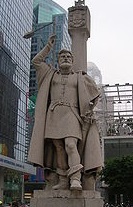
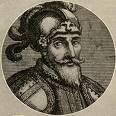


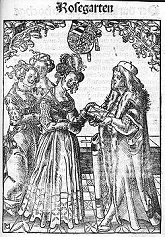
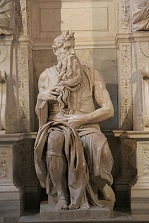

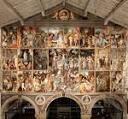

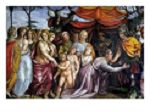
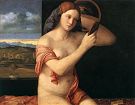
1513 On Jan. 20 Vasco Nunez de Balboa writes a letter to the Spanish king containing the first known reference to El Dorado, a one-stop-shopping center for gold smelting, mentioning the Panamanian cacique Dabaibe (Dabeiba), whose people like to live in trees. On Feb. 20 King Hans (b. 1455) dies after falling from a horse in Skjern Creen, and on July 22 his harsh-ruling common-people-loving son Christian II (1481-1559) becomes king of Denmark and Norway (until 1523); the Swedes refuse to accept him until 1520; until 1972 only men named Christian or Frederick rule Denmark. You're very well-read, it's well known, but but but but a sword swallower comes up to you and he kneels, he crosses himself and clicks his high heels, hands you his throat and says thank you for the loan? On Feb. 21 Pope (since 1503) "Il Pontiface Terribilis" Julius II (b. 1443) dies, and on Mar. 11 Giovanni de' Medici is elected Pope (#217) Leo X (1475-1521), the "elegant pagan Pope" (Thomas Carlyle); the merchant-moneylender Medici family reaches new heights of power; Leo is only 38-y.-o., short, fat, with an effeminate countenance and weak eyes, and sweats a lot, and is a promiscuous homosexual who suffers from ulcerations of the anus so severe he has to be carried to the conclave on a stretcher; he sees the papacy as a big candy store, a way to live the life of Croesus and get women, er, men and boys, causing him to soon bankrupt the papal treasury and resort to selling indulgences on an unprecedented scale, turning the papacy into a virtual Mafia by stacking all the avenues of promotion with his relatives, for a price; the profligate pope bankrupts the treasury within a year of taking office; the Holy League begins to fall apart; cardinal-elector Albert of Brandenburg (1490-1545) gives him 10K (30K?) ducats in return for the archbishopric of Mainz and the privilege of selling indulgences for eight years, half to go to repay him for the loan and the other half straight into the pope's pockets; Albert uses Dominican friar Johann Tetzel (Diezel) (1465-1519) to do the sales job, and the latter uses the sales pitch: "As soon as the coin in the coffer rings, the soul from purgatory springs"; meanwhile duke Francesco Maria I della Rovere of Urbino, who was just created lord of Pesaro only to see his supporter Pope Julius II croak, loses it to Leo X's nephew Lorenzo II de' Medici. On Mar. 4 Puerto Rico gov. Juan Ponce de Leon (León) (1460-1521) sets out from Puerto Rico with 200 men, sighting Florida (Fla.) (Sp. "flowery") on Mar. 27 (Pascua Florida) (Easter Sunday), naming it, and planting orange and lemon trees there; the Fountain of Youth, allegedly to be found at a mysterious place called Bimini he looks for but doesn't find, and the Spanish end up launching six unsuccessful expeditions by 1563 to colonize Fla. In Mar. the Portuguese under Alfonso de Albuquerque unsuccessfuly try to capture Aden on the Red Sea coast from the Mamluks; he returns to India and defeats the kingdom of Calicut. On Apr. 30 leading Yorkist claimant and Tower of London inmate Edmund de la Pole, 3rd Duke of Suffolk, 6th Earl of of Suffolk (b. 1471) is executed. In May the French agree to equip the Scottish fleet, grant 50K francs, and provide seven war galleys commanded by #1 French adm. Gaston Pregent (Prégent) de Bidoux (1468-1528). HRE Maximilian I, Henry VIII, Ferdinand II of Aragon, and Pope Leo X sign the Treaty of Mechlin, agreeing to invade France, although England ends up footing most of the bill; Catherine of Aragon rules England as regent while her hubby Henry VIII goes to France; on June 30 after English ambassador Nicholas West (1461-1533) fails in efforts to keep Scotland neutral, then Cardinal Christopher Bainbridge, archbishop of York delivers a papal sentence of excommunication to James IV, the English land near Calais and take Therouanne (Thérouanne) and Tournai. On June 6 13K Swiss mercenaries coming to relieve the siege ambush and defeat 10K French, Venetians, and German Landsknecht mercenaries led by Louis II de La Tremoille (1460-1525) in one hour at the "no faira" Battle of Novara in N Italy 25 mi. W of Milan; the French take 5K-10K casualties vs. 1K for the Swiss, and the Swiss execute hundreds of German mercenaries, then pursue the French to Dijon, where the French pay them off to leave France; Louis XII gives up Milan and ends his Italian invasion; Lodovico's son Massimiliano is restored as ruler of Milan by the Swiss. In the summer the 13-ship Scottish fleet, led by the Great Michael and carrying 4K men under Earl James Hamilton of Arran sails N through the Pentland Firth and past the Hebrides, attacking the English stronghold of Carrickfergus in Ulster; too bad, Great Michael runs aground - more speed, Scotty? On Aug. 16 the English army (sans Henry VIII, who hasn't arrived yet) defeat the French at the Battle of the Spurs at Guinegate in N France. In Aug. James IV of Scotland (b. 1474) invades England with an army of 30K-40K (largest ever) (incl. 17 artillery pieces) to help his ally France, and on Aug. 28-29 captures Norham Castle, home of the hated Bishop of Durham, then moves S up the Till Valley in Northumberland, taking Etal Castle and Ford Castle (home of Bastard John Heron); meanwhile Henry VIII's diverts some forces from France under Earl Thomas of Surrey, and Sir Thomas Howard, 2nd duke of Norfolk, under the direction of English Queen Catherine of Aragon, and on Sept. 9 the Battle of Flodden (Branxton) Hill (Field) in N Northumberland on the edge of the Cheviot Hills sees stupid James IV leave his strategic position on Flodden Hill to attack the English on the marshy slopes of Branxton Hill, and use poor military tactics, getting his butt kicked and losing half his men, becoming the last medieval battle in Europe using knights and armor; "The flowers of the forest are withered away"; never again will Scotland defeat England in war?; James IV is KIA along with his son Alexander (b. 1493), Archbishop Alexander of St. Andrews, one bishop, two abbots, nine earls, and 14 lords of parliament; the clunky Scottish navy is sold to France; James IV's 17-mo.-old son James V (1511-42) succeeds him, with James IV's wife (Henry VII's sister) Mary Tudor as regent, which doesn't sit well with the Scottish people; does Catherine's military V stir up a wee bit of jealousy in her hubby Henry? Big year for surfers? On Sept. 25 (27?) after receiving reinforcements from Spain along with the title of capt.-gen. of Antigua, and hearing that his enemy Martin Fernandez de Enciso has been bringing charges of usurpation against him, making it necessary to do something big (turn some profit) to stay in power, then leaving on Sept. 1 with 190 Spaniards and 1K Indians to search for a great body of water described by an Indian friend, and fighting off pesky natives in dense jungles and swamps, Vasco Nunez (Núñez) de Balboa (1474-1519) climbs solo to a mountain peak and becomes the first Euro to see the Pacific (Peaceful) Ocean (Great South Sea); four days later he and his men reach the ocean and claim it and all shores washed by its waters as a possession of the Spanish (Castilian) crown, with Balboa wading into the sea in full armor to jazz it up, returning next Jan. with a treasure of loot incl. 40K pesos in gold, plus pearls and slaves; meanwhile on July 27 the king appoints 72-y.-o. Pedro Arias de Avila (Pedrarias) (1442-1531) as gov., and next year he sets out in 20 ships with 2K men and women, incl. Francisco de Coronado, Hernando de Soto, Diego de Almagro, and Pascual de Andagoya; meanwhile Balboa founds Castilla del Oro (Darien) on the base of the Isthmus of Panama on the South Am. mainland, with Spanish 1.5K colonists; the currency of Panama is later named after him (Costa Rica goes for Cristobal Colon, er, Christopher Columbus); the (rocky?) Balboa Monument is inagurated in Panama City on Sept. 29, 1924; Ferdinand Magellan names the Pacific Ocean in Nov. 1519; the Pacific is actually anything but peaceful during the hurricane season, but people get less seasick on it than they do on the Atlantic Ocean when rounding the Horn? Peasant revolts rock Wurttemberg and the Black Forest. The Polish-Lithuanian army drives the Russians from Vitebsk and Polotsk. Sultan Selim I accepts the submission of Moldavia, but forces it to pay an annual tribute of 4K gold coins, 40 horses, and 40 falcons in exchange for a high degree of autonomy. The guilds of Duisburg stage an unsuccessful revolt against the nobles. Appenzell E of Schwyz (S of Lake Constance) joins the Swiss Confederation, and each canton sends two delegates to a federal assembly. Portuguese navigator Pedro de Mascarenhas (1470-1555) discovers uninhabited Reunion (Réunion) Island 400 mi. SE of Madagascar and 130 mi. SW of Mauritius, naming it Santa Apollonia, using the name Mascarene for the whole region; Arab sailors earlier called it Dina Morgabin (Western Island) - don't go away, I want you to stay? In 1513 the first European ship to land in China is a Portuguese caravel commanded by Jorge Alvares (Álvares) (-1521) that reaches Canton (Guangzhou); later in the year Rafael Perestrello, a cousin of Christopher Columbus is sent by viceroy Alfonso deo Albuquerque in a ship from Malacca, landing on the S shores of Guangdong. The Spanish found Bayamo in the West Indies. Sultan Selim I issues a firman regarding the Dionysiou Monastery. Titian is appointed supt. of govt. works at Venice. Pope Leo X gives Leonardo da Vinci rooms for his use at the Vatican Palace. Architecture: Pope Leo X begins the Vatican Sculpture Gallery. Chartres Cathedral 60 mi. SW of Paris is completed after 400 years. Tilman Riemenschneider (1460-1531) finishes the Tomb of HRE Henry II. Holyrood Palace at the foot of Canongate in Edinburgh, Scotland (begun 1473) is completed; it burns down in 1650, and is rebuilt by Charles II, becoming the official residence of the British sovereign in early summer. Nonfiction: Euchaius Rosslin (1470-1526), Der Schwangern Frauwen und Hebammen Rosengarten (Der Rosengarten) (The Rose Garden); Latin tr. pub. by his son Eucharius Rosslin the Younger in 1532 as "De Partu Hominis"; first English tr. by Richard Jonas pub. in 1540 as "The Birth of Mankind"; 2nd English tr. by Thomas Raynalde pub. in 1545 by Thomas Geminus as "The Woman's Booke"; becomes the #1 English ref. work on midwifery for the next cent. Niccolo Machiavelli (1469-1547), The Prince (Il Principe); written in vernacular Italian, first circulated this year, and pub. in 1532, becoming the first work of modern political philosophy, taking effective truth as more important than abstract ideals, in conflict with the Scholastic views of the time; teaches generations of Europeans the art of unscrupulousness; dedicates it to Lorenzo Medici, hoping for a job, but get snubbed, and instead sees his name become associated with their modus operandi, with the term Machiavellian becoming a perjorative, as well as Old Nick for the Devil; a favorite of Napoleon, Mussolini, and Lindsay Lohan; forever after everybody wants to be a Machiavellian prince?; "On Taking Power", "On Allies and Subordinates", "Qualities for Praise or Blame", "Liberality or Miserliness?", "Cruelty or Compassion?", "Be Feared or Loved?", "Keeping One's Word or Not?", "Importance of Appearances", "Avoid Being Despised and Hated", "The Value of Enemies", "On Gaining Renown", "Choosing Subordinates", "Avoiding Flatterers", "Living with Chance"; "He who neglects what is done for what ought to be done, sooner effects his ruin than his preservation"; "It is far safer to be feared than loved if you cannot be both" (ch. 17). "God is not willing to do everything, and thus take away our free will and that share of glory which belongs to us"; "Men are more apt to be mistaken in their generalizations than in their particular observations"; "There is no surer sign of decay in a country than to see the rites of religion held in contempt." Ottoman adm. Piri Reis (Haji Ahmed Muhiddin Piri) (1465-1554) pub. a Map of the Known World in two parts on long-lasting gazelle skin; only the Western portion survives, becoming the oldest surviving map of the Americas, discovered in Constantinople in 1929; it depicts Queen Maud's Land in Antarctica as it looked millions of years ago, and shows Antarctica as ice-free? Art: Fra Bartolommeo (1472-1517), St. Peter and St. Paul. Giovanni Bellini (1428-1516), Portrait of a Nude Woman; waits to age 85 to paint his first female nude? Albrecht Durer (1471-1528), Knight, Death and the Devil (copper engraving); first of the three Meisterstiche (master engravings) (1513-4). Gaudenzio Ferrari (1471-1546), The Life of Christ (21 frescoes) (Santa Maria delle Grazie, Milan); incl. The Crucifixion - busy, busy, going places? Michelangelo (1475-1564), Statue of Moses (1513-15); part of the tomb of Pope Julius II in the della Rovere family tomb in San Pietro in Vincoli (St. Peter in Chains) Basilica in Rome; he portrays him with horns protruding from his head because of a Bible mistranslation of "rays of light"? (or because it's easier to make?). Il Sodoma (1477-1549), The Death of Lucretia (Cleopatra); presented to Leo XIII, who creates him a cavaliere; Deposition from the Cross; The Marriage of Alexander the Great and Roxane with the Family of Darius III (his masterpiece?) (Bamberg Cathedral). Plays: Bibbiena (Cardina Bernardo Dovizi), La Calandria (comedy). Niccolo Machiavelli (1469-1527), La Mandragola (comedy). Poetry: Judah Abrarbanel (AKA Leo Hebraeus) (-1535), Dialogues of Love (Dialoghi di Amore); basis for Baldassare Castiglione's 1514 "Il Cortegiano" (pub. 1527). Gavin Douglas (1474-1522), The Eneados (13 vols.); a fouthy tr. of Virgil's "Aeneid", finished just before the Battle of Flodden. Births: Italian singer-composer Domenico Maria (Dominicus) Ferrabosco (d. 1574) on Feb. 14 in Bologna. English scholar-diplomat Sir Thomas Smith (d. 1577) on Dec. 23 in Saffron Walden, Essex; educated at Queen's College, Cambridge U., and the U. of Padua; knighted in 1548; not to be confused with Thomas Smith (1522-91). Irish rebel Thomas FitzGerald, 10th Earl of Kildare (d. 1537) (AKA Silken Thomas) in London, England; son of Gerald FitzGerald, 9th earl of Kildare and Elizabeth Zouche, distant cousin of Henry VII. Scottish Calvinist martyr George Wishart (d. 1546). Scottish Presbyterian church founder John Knox (d. 1572) in Giffordgate, Haddington; educated at St. Andrews U. Deaths: German Meistersinger Hans Folz (b. 1437) in Jan. in Nuremberg. Italian painter Pinturicchio (b. 1454). Danish-Norwegian-Swedish king Hans (b. 1455) on Feb. 20 in Aalborg; dies after falling from his horse in Skjern Creek. Irish lord deputy of Ireland (1477-94, 1496-1513) Gerald FitzGerald, 8th earl of Kildare (b. 1456) on Sept. 3 in County Kildare. Scottish king (1488-1513) James IV (b. 1474) on Sept. 9 in N England (KIA at the Battle of Flodden). Scottish archbishop (of St. Andrews) Alexander Stewart (b. 1494) on Sept. 9 in N England (KIA at the Battle of Flodden).
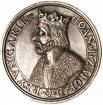
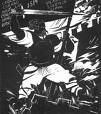






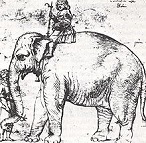



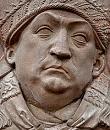


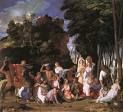
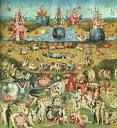

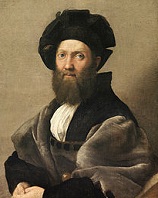
1514 On Mar. 12 Portuguese explorer Tristao da Cunha (1460-1540) marches down the streets of Rome in an elaborate procession to present the new conquests of Portugal to Pope Leo X, who receives them at Castel Sant'Angelo; the procession features pet white Indian elephant Hanno the Elephant (1510-16), (given to him by the king of Cochin), whom popey adopts, becoming his favorite pet, dying two years later from complications of treatment for constipation with a gold-enriched laxative. On May 18 Claude of Brittany (1499-1524) (daughter of Anne of Brittany by Louis XII) marries Duke Francis of Angouleme (later Francis I of France) in Saint-Germain-en-Laye, which leads to the permanent incorporation of Brittany into France after Claude's death despite everything her mommy could do. On June 30 new gov. Pedro Arias de Avila arrives in Darien, finding Balboa and his men living in mud huts surrounded by a wooden palisade and on the verge of starvation, after which Avila decides to starve Balboa's men until enough die that he can justify moving the colony to the Pacific side of the isthmus, which they do later this year, founding the settlement of Panama, which goes on to become the center for exploration to the S incl. the conquest of the Incas; Balboa becomes engaged to Avila's daughter in 1516, which doesn't stop Avila from plotting his demise. On Aug. 23 after war begins between the Suni Muslim Ottomans under Selim I and the Persian Shiites under Ismail I, they meet at the Battle of Chaldiran (Chaldoran), which is a V for the Ottomans over the Savadis; Shah Ismail is wounded but escapes to Dagestan; Selim enters Tabriz on Sept. 15 and massacres the pop.; the Persian silk trade is closed; the last battle between Turkey and Iran until ?. In Aug. Erasmus visits Basel and is given a go-ahead by publisher Johann Froben to prepare a trans. of the Greek New Testament for printing, racing to scoop the Complutensian Polygot Bible (1514). In Sept. Thomas Wolsey becomes archbishop of York. On Oct. 9 after Thomas Wolsey of England arranges a peace with France, and France makes a truce with all of its enemies except Maximilian I, Henry VII's bodacious 18-y.-o. sister Mary Rose Tudor, Duchess of Suffolk (1496-1533) marries 52-y.-o. Louis XII in Abbeville, the twice-married er, heirless old man seeking to produce an heir, and dying next Jan. 1 after 3 mo. of shagging her, which conks him out, and leaving her unpregnant, after which Mary is called the "French queen"; the custom of slashing (scissoring) of clothing originates in France and spreads to England; Catherine of Aragon's influence at court starts to wane, although she remains popular and is a favorite of Mary Rose Tudor. No wonder the Commies sold the Hungarians on Communism? An army of 100K Hungarian peasants under Gyorgy (Juraj) Dozsa (1470-1514) are gathered to crusade against the Turks; when the crusade is suspended, the peasants turn on the nobles for past injustices; the nobles, led by John Zapolya (1487-1540) (gov. of Transylvania and future John I of Hungary) defeat them at the Battle of Temesvar, execute Dozsa by roasting him alive on a red-hot iron throne with a red-hot iron crown placed on his head and a red-hot iron scepter forced into his hand, his only exclamation being "These dogs!"; after cooking him, his half-starved followers are forced to eat him, after which they are sentenced to perpetual servitude - well, they do call them hungarians? On Sept. 8 after the Russians take Smolensk, the Battle of Orsha is a V for 35K Lithuanians under Hetman Konstanty Iwanowicz Ostrogski (1460-1530) over 80K Russians under Vasily III, which is used for anti-Russian propaganda in Europe. Diego de Velazquez conquers Cuba and wipes out most of its pop., declaring himself gov. - let's get this party started? The original Miranda Warning? Pope Leo X issues a bull denouncing slavery and the slave trade; too bad, there's a catch?; Spain sends a force of 2K men to the New World to conquer lands and men for the glory of Christendom armed with the Requerimiento, a manifesto to be read to the aborigines informing them that they must convert or else be enslaved; since they can't understand Spanish, they are routinely enslaved and made to look like it is their own decision? To pacify the whisperers, Mary Tudor, regent of Scotland marries Archibald Douglas, 6th Earl of Angus (1489-1557), who takes control of the boy king James V (1511-42) and the realm of Scotland; too bad, his pro-English policies piss the Scots off, causing a power struggle with the Hamilton family (earls of Arran). For his Scottish butt-kicking services at Flodden Field in 1513 the attainder on his family name is reversed, and Sir Thomas Howard (d. 1524) regains the dukedom of Norfolk (2nd duke); his son Thomas Howard, 3rd Duke of Norfolk (1473-1554), who commanded the English vanguard at Flodden is made 2nd earl of Surrey. Franciscan Francis Suriano obtains the S part of Calvary from the sultan of Cairo. Green peas come into use in England. Pineapples first arrive in Europe - all they need now is Spam? King Manuel I of Portugal imports an Indian elephant, causing a stir. The Spanish found Trinidad and Puerto Principe in the West Indies. On Aug. 25 the city of Havana (San Cristobal de la Habana) (modern-day pop. 2.1M) in Cuba on the Almendares River near the Straits of Floida is founded by Spanish conquistador Diego Velazquez de Cuellar (Diego Velázquez de Cuéllar) (1465-1524), and named by Panfilo de Narvaez (Pánfilo de Narváez) (1470-1528); on Dec. 20, 1592 Philip II of Spain grants it city status; it is later officially designated "Key to the New World and Rampart of the West Indies". The House of Fugger secures the right to sell papal indulgences in Germany - the love of money is the root of all what? The Corporation of Trinity House is founded in London to provide navigational help on the Thames River. Architecture: Diego Columbus lays the cornerstone for the Cathedral of Our Holy Lady Mary of the Incarnation in the Dominican Repub., becoming the first Roman Catholic cathedral in the New World; it was originally made of royal palms. Salamanca Cathedral is begun (finished 1733). The Rani Sipari Mosque is built in Ahmadabad, India. Raphael finishes the 2nd room of the papal apts., and begins work on the 3rd and final room. Science: Dutch writer Giel Vander Hoecke becomes the first to use the + and - signs in a book on arithmetic? - were they ad hoc signs? Nonfiction: Anon., The Complutensian Polygot Bible (Greek, Hebrew, Aramaic, Latin) (6 vols.); sponsored by Spanish Cardinal Francisco (Gonzalo) Jimenez (Ximenes) de Cisneros (1436-1517) and ed. by Alfonso de Zamora; sponsored by Complutense U. in Madrid; this year the New Testament is printed in Alcala de Henares, Spain, followed by the Old Testament in 1517, but pub. is delayed until Pope Leo X sanctions it in 1520; Cisneros dies 5 mo. after the project's completion; too bad, the bulk of the copies are destroyed when a ship en route from Spain to Italy sinks in a storm; Philip II of Spain later finances a new ed. edited by Bible scholar Benito Arias Montano (1527-98), which is printed in Amsterdam by Christophe Plantin (1520-89) in 1568-72. Anon., Septem Horae Canonicae (Kitab Salat al-Sawai); first book printed in Arabic type; pub. in Italy. Pietro Aretino (1492-1556), The Last Will and Testament of the Elephant Hanno; on the occasion of the death of Pope Leo X's pet elephant Hanno (1510-16); mocks the leading figures of Rome, incl. Leo X, and launches his career as "the Scourge of Princes". Guillaume Bude (1467-1540), De Asset et Partibus; treatise on ancient coins and measures; his masterpiece? Johannes Trithemius (1462-1516), pub. Annales Hirsaugienses... Complectens Historiam Franciae et Germaniae (The Annals of Hirsau... including the History of France and Germany) (2 vols.); shows great mastery of the Latin language and eloquent phrasing, but is soon discovered to be filled with fictional passages; printed in 1609, becoming one of the first humanist history books. Art: Giovanni Bellini (1428-1516), The Feast of the Gods; his last almost-finished painting (finished by his pupil Titian); commissioned by Duke Alfonso I d'Este of Ferrara. Hieronymus Bosch (1450-1516), The Garden of Worldly Desires (Earthly Delights); humanity without a fall, living in paradise without knowledge of right and wrong. Antonio da Correggio (1489-1534, Four Saints (Altarpiece of St. Martha); his masterpiece? Lucas Cranach the Elder (1472-1553), Portrait of Henry of Saxony. Dosso Dossi (1483-1542), Circe and Her Lovers in a Landscape. Albrecht Durer (1471-1528), Melancholia (copper engraving); St. Jerome in His Study (copper engraving). Raphael (1483-1520), The Fire in the Borgo (fresco) (Vatican); Portrait of Baldassare Castiglione (1514-15); Raphael's diplomat humanist friend Baldassare Castiglione (1478-1529) in front of a blank background instead of the usual landscape, with the deepest face ever painted, topping Leonardo da Vinci's La Jaconda?; too bad, a few years later Castiglione's wife dies of an unexpected illnness, and he becomes a monk, then seven years later is appointed bishop of Avila by HRE Charles V; the painting ends up 20 paces from Leonardo's painting in the Louvre, except Mona Lisa, which is an adjacent room. way ahead of its time?; Raphael's mastrpiece? Il Sodoma (1477-1549), Marriage of Alexander and Roxana; Alexander in the Tent of Darius (two frescoes in the Villa Farnesina, Rome). Plays: Lucas Fernandez, Farsys y Eglogas. Births: Italian humanist architect cardinal Daniele Matteo Alvise Barbaro (Barbarus) (d. 1570) on Feb. 8 in Venice; educated at the U. of Padua; friend of Torquato Tasso and Andrea Palladio; student of Pietro Bembo. Austrian mystic mathematician-cartographer (only pupil of Nicolaus Copernicus) Rheticus (Rhaeticus) (Georg Joachim von Lauchen) (d. 1574) on Feb. 16 in Feldkirch; father George Iserin got rich by stealing from his patients, causing him to be executed in 1528, stripping his family name, causing him to adopt the name Rheticus, meaning the Roman province incl. parts of Austria, Switzerland and Germany. Italian duke of Urbino (1539-74) Guidobaldo II della Rovere (d. 1572) on Apr. 2; son of Francesco Maria I della Rovere (1490-1538) and Eleonora Gonzaga. French architect ("Father of French Neoclassical Architecture") Philibert Delorme (de l'Orme) (d. 1570) on June 3-9 in Lyon. English Greek scholar Sir John Cheke (Cheek) (d. 1557) on June 16; educated at St. John's College, Cambridge U.; student of George Day (1501-56); cheeky reviver of Greek learning in England. Dutch Flemish anatomist ("Founder of Modern Human Anatomy") Andreas Vesalius (Andre Vesale) (Andreas Vesal) (Andreas van Wesel) (d. 1564) on Dec. 31 in Brussels. English adventurer Sir Peter Carew (d. 1575); brother of Sir George Carew (1504-45). Dutch Flemish Renaissance architect-sculptor Cornelis Floris de Vriendt (d. 1575) in Antwerp; son of Cornelis I de Vriendt (-1538); brother of Frans Floris (1517-70). Deaths: Scottish bishop William Elphinstone (b. 1431). Flemish composer Gaspar van Weerbecke (d. 1440). Italian architect Donato Bramante (b. 1444) on Mar. 11 in Rome; dies after erecting the E gallery of the Vatican Palace, which was supposed to go with a W gallery, and connect with St. Peter's 1500 ft. to the N; the E gallery contains the Nicchione (apse) on the N, and the Cortile di San Damaso on the S. French queen Anne of Brittany (b. 1477) on Jan. 9 in Blois.








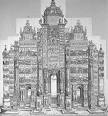



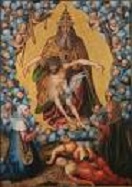
1515 On Jan. 1 king (since Apr. 7, 1498) Louis XII (b. 1462) dies, and Francis (Francois) I (1494-1547), son of his first cousin Charles d'Angouleme (1459-96) becomes French Valois king #9 (until Mar. 31, 1547), the first French Renaissance monarch, and "the father of France's devotion to culture", reigning at the same time as Henry VIII of England, and having to cope with the 1517 Protestant Revolution of Martin Luther too, but not copping out his religion over pretty petticoats like horny I'm Henry the Eighth I Am, staying loyal to the security cams of the Roman Catholic cause; too bad, he fell out with Holy Roman Emperor Charles V, getting in ? wars with him for 38 years (1521-59); his favorite residence is the Palace of Fontainebleau 35 mi. SE of Paris on 200 acres in the 42K-acre Fontainebleau Forest, where he assembles the Fontainebleau School in the 1530s to decorate it; his well-educated brain babe sister Marguerite d'Angouleme (1492-1549) sets up a salon that becomes known as the "New Parnassus", fostering Francois Rabelais (1494-1553), Clement Marot (1496-1544), Pierre de Ronsard (1524-85) et al; Francis I signs an alliance with 15-y.-o. Archduke Charles of Hapsburg (Austria) (1500-58) (future HRE Charles V), who becomes gov. of the 17 provinces of the Netherlands; on Mar. 24 Francis I makes his friend and cousin Count Charles III de Montpensier and de Bourbon, Duke of Chatellerault (1490-1527) the (youngest ever?) constable of France (until 1523); Francis I hires German Landsknecht mercenaries,and makes a brilliant crossing of the supposedly impassable Alps, followed by a brilliant military V on Sept. 13-14 over the Swiss and Venetians at the Battle of Marignano, where the superiority of artillery and cavalry over the supposedly superior Swiss infantry tactics is proven, then a few days later defeats Swiss mercenaries and seizes the Italian duchy of Milan, becoming its gov. (until 1519); after conquering Lombardy, the French make peace with the Swiss on Nov. 12 and with Pope Leo X on Dec. 14; the Swiss retain most of the Alpine passes plus a French subsidy in return for the right of the French to enlist mercenaries; Francis I becomes the first French king to appoint port-chaise-d'affaires (royal porta-potty attendants). On Mar. 3 the Lateran Council issues the decree De Impressione Librorum, requiring the imprimatur (pr. im-pri-MAT-ur) (Lat. "let it be printed") on all books pub. in Roman Catholic lands under penalty of excommunication of the offenders, along with confiscation and destruction of the books. On Mar. 3 after Mary Rose Tudor "the French Queen" returns to England after doing her warming-up-the-old-man thing for her big brother, she secretly marries (his 3rd marriage) her real beau, Henry VIII's master of the, er, horse Charles Brandon, 1st Duke of Suffolk (1484-1545), son of Henry VII's standard-bearer Sir William Brandon (1456-85) (who was slain personally by Richard III on Bosworth Field), and whom had been one of Henry VIII's favorites, called a "second king"; too bad, this act pisses-off Henry VIII, who was still trying to get the promised gold and jewels for his sister's marriage from the French, and the privy council urges the dork's execution for treason until his friend Cardinal Wolsey intervenes, and reminds Henry of his affection for his sister, after which they are heavily fined (£200K, the amount of Mary's dowry from Louis XIII, plus another £24K for the bother), and allowed to officially marry on May 13 in Greenwich Palace; luckily the Anne Boleyn thingie is in the future, for she detests that bitch and sides with Catherine of Aragon, while Brandon is on the king's side? In Mar. Russia forms an alliance with the Livonian Knights, but fails to take Vitebsk. On July 22 the First Congress of Vienna between HRE Maximilian I, Sigismund of Poland, and Vladislav II of Hungary regarding the mutual succesion of the Hapsburgs and Jagellons (Jagiellos) allies the two dynasties, and makes Maximilian I's brother Ferdinand potential heir to the Hungarian throne. On July 25 Spanish navigator Juan de Bermudez returns to Bermuda (first time 1505), leaving a dozen pigs and sows for future stranded mariners. On Sept. 10 archibishop of York Thomas Wolsey (1475-1530) becomes a cardinal; William Warham resigns, and on Dec. 24 Wolsey becomes lord chancellor of England, getting so powerful that the Venetian ambassador calls him "ipse rex" (the king himself). On Dec. 24 after arriving in Seville in Nov., slave-owning Spanish Dominican friar Bartolome de las Casas (1484-1566), who witnessed the extermination of the Arawaks (Tainos) of Cuba in 1513, causing him to flop on the issue of Indian slavery, complaining that "everything done to the Indians thus far was unjust" pleads to Charles V of Spain to replace Indian slaves with more "hearty" African slaves, and a license is given to Lorens de Gominot to import 4K African slaves (four for each Spanish emigrant) to Spanish Am. sugar plantations in the West Indies, causing de las Casas to later be blamed for launching African slavery in the Americas; in 1518 an 8-year monopoly is given by Charles V to La Bresa, who sells it to the Genoese, who buy their W African slaves from the Portuguese. The Scottish parliament names John Stewart, 2nd Duke of Albany (1484-1536) (French son of James III's bad brother Alexander) as protector (gov.) of Scotland (until 1524), who goes on to work with the young king's tutor Gavin Dunbar (1495-1547), archbishop of Glasgow (1524-) to turn him into a Francophile; see-you-tomorrow Queen Regent Margaret Tudor escapes to England. Ottoman Sultan Selim I conquers and annexes E Anatolia and Kurdistan; the Dulkadir principality (founded 1337) is annexed. The Teutonic Order offers Memel to the duchy of Courland in exchange for a peace, ending their war (begun 1511), and causing Courland to double its territory after spending years fighting minor rebellions; too bad, the Martin Luther thingie becomes popular in Courland, causing it to worry how to keep its alliance with Catholic Poland going. A rebellion against Hapsburg rule begins in Frisia in Germany, led by giant super-strong 7' warrior Piers Gerlofs Donia, who keeps his outnumbered army until he lays down his arms in 1520 after never being defeated in battle, and dies the same year in his house in Sneek of natural causes. After they fail to learn their lesson of 1468, the Portuguese again destroy the Morrocan town of Anfa (Casablanca). Florentine prof. of law Francesco Guicciardini (1483-1540), who entered the service of Pope Leo X in 1515 is made gov. of the papal states of Reggio and Modena, followed by Parma in 1521, then vice-regent of Romagna in 1523, lt.-gen. of the papal states in 1526, and gov. of Bologna in 1531. Sugar cane is introduced to Puerto Rico - sugar is expensive, slaves are cheap, ola? The first nationalized factories (for weapons and tapestries) open in France. The city of Santiago de Cuba (modern-day pop. 431K) is founded by Diego Valazquez de Cuellar as the capital of Cuba; next year it burns down, and is rebuilt. Raphael is appointed chief architect of St. Peter's to replace the late Donato Bramante, and is commissioned to replace the 4th cent. church, to create the pope's tomb, and to decorate the ceiling of the Sistine Chapel. Leonardo da Vinci becomes a military engineer attached to the army of Charles III de Montpensier and de Bourbon, constable of France (until 1517). A free grammar school is founded in Wolverhampton, England (13 mi. NW of Birmingham). Architecture: The Elizabethan-style Hampton Court Palace in Richmond upon Thames, London is begun by Cardinal Thomas Wolsey (finished in 1530); after Henry VIII seizes it in 1529, it becomes one of only two palaces owned by the king to survive to modern times along with St. James's Palace. Nonfiction: Gerard of Cremona (tr.), Ptolemy's "Almagest" (Venice); Latin trans.; used by Nicolaus Copernicus in formulating his heliocentric theory. Desiderius Erasmus (1466-1536), Education of a Christian Prince (Institutio Principis Christiani). Fiction: Mutianus Rufus, Ulric von Hutten et al., Epistolae Obscurorum Virorum; a satire of scholarship in dog Latin in support of Reuchlin. Plays: John Skelton (1460-1529), Magnificence. Johann Grieninger of Strasbourg, Till Eulenspiegel. Gian Giorgio Trissino (1478-1550), Sofonisba; first play in blank verse, and first modern tragedy, becoming a model. Art: Fra Bartolommeo (1472-1517), St. Mark the Evangelist (Palazzo Pitti, Florence); his masterpiece?; Undraped St. Sebastian; both painted to prove that he doesn't need to always do small draped figures. Antonio da Correggio (1489-1534), Madonna of St. Francis. Lucas Cranach the Elder (1472-1553), The Holy Trinity in a Glory of Angels (1515-18); shows Christ's pubic hair. Albrecht Durer (1471-1528), Triumphal Arch (24 woodcuts); he had planned on 90, but circumstances?; Marginal Drawings in the Prayer Book of HRE Maximilian I (pen and ink). Gerard David (1460-1523), The Rest on the Flight Into Egypt. Raphael (1483-1520), The Raphael Cartoons (1515-6); seven large cartoons of Gospel scenes for tapestries for Pope Leo X, who commissioned 10 for the Sistine Chapel to hang below Michelangelo's famous celing. Titian (1488-1576), Flora. Leonardo da Vinci (1452-1519), The Deluge; a series of drawings portraying the destruction of the world in a flood. Births: German physician-botanist Valerius Cordus (d. 1544) on Feb. 18 in Hesse (Erfurt?); educated at the U. of Marburg, and U. of Leipzig. Spanish Discalced Carmelite nun and mystical poet ("seraphic virgin") (St.) Teresa de Jesus of Avila (Jesus) (Teresa Sanchez de Cepeda y Ahumada) (d. 1582) on Mar. 28 in Gotarrendura (Avila), Castile; founds 13 monasteries; feast day: Oct. 15; originates the Roman Catholic belief that Mary's hubby Joseph aids home sellers after she buries a medal of him, prays to him, and gets land for convents. Italian Counter-Reformation scholar and cardinal (1592-) ("the Third Apostle of Rome") (St.) Philip (Filippo) Romolo Neri (d. 1595) on July 21 in Florence; founder of the Congregation of the Oratory; feast day: May 26; patron saint of laughter, humor, and joy. English queen (1540) (Henry VIII's wife #4) Anne of Cleves (d. 1557) on Sept. 22 in Dusseldorf; 2nd daughter of Duke John III of Cleves (Cleve) (Kleve) (1490-1538) (leader of German Protestantism) and Duchess Maria of Julich-Berg (1491-1543); sister of Sybille of Cleves (1512-54). Scottish queen consort (1538-42) Mary of Guise (d. 1560) on Nov. 22 in Bar-lde-Duc, Lorraine, France; 2nd wife of James V; mother of Mary, Queen of Scots (1542-87). English politician Sir Nicholas Bacon (d. 1579) on Dec. 28 in Chislehurst, Kent; educated at Corpus Christi College, Cambridge U.; brother-in-law of William Cecil (1520-98); knighted in 1559; foster parent of Sir Francis Bacon. English (Welsh?) "Beware the Cat" novelist-poet-writer William Baldwin (d. 1563) in West Country; educated at Oxford U. French humanist theologian Sebastian Castellion (Catellio) (Chateillon) (Chataillon) (Castello) (d. 1563) in Saint-Martin-du-Frene, Duphine, Savoy; more learned than John Calvin? English humanist scholar Roger Ascham (d. 1568) in Kirby Wiske, Yorkshire; educated at St. John's College, Cambridge U.; first prof. of Greek at Cambridge U. (1540); tutor to Princess (later Queen) Elizabeth (1546-8); secy. to Queen Mary and Queen Elizabeth. Spanish Escorial architect Juan Bautista de Toledo (d. 1567) in Toledo (Madrid?). French #1 Renaissance Mannerist sculptor-architect Jean Goujon (d. 1568) in Normandy. English diplomat Sir Nicholas Throckmorton (Throgmorton) (d. 1571); father of Bess Throckmorton (1564-1647). French Protestant mathematician-philosopher Petrus Ramus (Peter Ramus) (Pierre la Ramee) (Ramée) (d. 1572) in Cuth, Vermandois district of Picardy; of impoverished noble parentage; educated at the U. of Paris; raised a Roman Catholic, he thinks himself out of it in middle age? - I was an ignoramus? English breed mare countess Margaret Stewart Lennox, Countess of Lennox (d. 1578); daughter of Archibald Douglas, 6th earl of Angus and Margaret Tudor (1489-1541) (sister of Henry VIII); wife of Matthew Stewart, 4th earl of Lennox (1516-91). French Louvre architect Pierre Lescot (d. 1578) in Paris. Croatian Ottoman adm. Piyale (Piali) Piasha (d. 1578). Italian anatomist Giambattista Canano (Canani) (d. 1579) in Ferrara. French architect Jacques I Androuet du Cerceau (d. 1584) in Paris; known as Du Cerceau (Fr. "hoop") from a circle sign over his workshop; one of the first to introduce the Italian Renaissance style to France, passing it on to his Parisian-based sons Baptiste du Cerceau (1560-1602), Jacques II du Cerceau (1556-1614), and Jean Androuet du Cerceau (1585-1650), who work on the Tuileries, Louvre, Pont-Neuf, and Chapel of St. Denis. Dutch Mannerist painter Lambert Sustris (d. 1584) in Amsterdam; father of Friedrich Sustris (1540-99); collaborator of Titian (1488-1576); teacher of Girolamo Muziano (1532-92). Dutch "De Praestigiis Daemonium" occultist physician Johann Weyer (Wier) (d. 1588) in Grave; disciple of Heinrich Cornelius Agrippa von Nettesheim (1486-1535). Deaths: Venetian humanist printer-typographer Aldus Manutius (b. 1449) on Feb. 6. Portuguese navigator Alfonso de Albuquerque (b. 1453) on Dec. 16 off the shores of Goa, India. Spanish gen. Gonzalo Fernandez de Cordoba (b. 1453) on Dec. 2 in Cordoba. Spanish explorer Vicente Yanez Pinzon (b. 1461) in Triana, Seville. French king (1498-1515) Louis XII (b. 1462) on Jan. 1 in Paris. Spanish conquistador Alonso de Ojeda (b. 1465) in Santo Domingo.










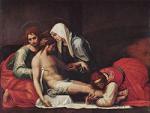


1516 On Jan. 23 Castilian king (since 1474) Ferdinand II of Aragon (Ferdinand V of Castile and Leon) (b. 1452) dies, and his 16-.y.-o. grandson Charles of Burgundy (future HRE Charles V) is crowned Charles (Carlos) I of Spain (1500-58) (until Aug. 27, 1556), founding the Spanish Hapsburg (Habsburg) Dynasty (ends 1700); his mother Joanna (Juana) the Mad (1479-1555) becomes nominal joint ruler of Castile, even though she spends the rest of her life in the castle of Tordesillas doing who knows what with her hubby's remains; Charles I grants licenses to the Flemings to transport African blacks to the Am. colonies - the original Psycho? In Feb. Catherine of Aragon, after a stillborn daughter, a short-lived son, another miscarriage, and another short-lived son Henry (less than 2 mo.) (he jousted before her in a surcoat and horse trappings embroidered with her initials) to celebrate his birth) gives birth to Mary Tudor (1516-58), Henry VIII's first child, who grows up to carry on her grandmother's Catholic blood sports - like the new Dirt Devil, with more power and suction? On Mar. 13 Ladislas II Jagiello (b. 1456) dies, and his 10-y.-o. son Louis II Jagiello (1506-26) becomes king of Bohemia and Hungary, and the last of the Jagiello line. On Apr. 23 to stop widespread adulteration, Bavarian duke (1508-50) William IV (1493-1550) issues his Reinheitsgebot (Beer Purity Regulations) before a committee in Ingolstadt, declaring that only barley, hops and water can be used, later allowing yeast and wheat; in 1987 the law is ruled not to apply to imported beer; in 1993 the Vorlaufiges Biergesetz (Provisional Beer Law) is passed, expanding the Reinheitsgebot to pemit more ingredients; later, due to microbial infections in summertime, William IV's successor (1550-79) Albert (Albrecht) V (1528-79) prohibits all brewing between Apr. 23 and Sept. 21, causing only lagers to be brewed; meanwhile William IV makes his younger brother Louis X (1495-1545) co-duke of Bavaria, spliiting Bavaria until 1545. On Aug. 13 Charles I of Spain signs the Peace of Noyon, giving Milan to France, ending the War of the Holy League (League of Cambrai) (begun 1508); Massimiliano is expelled from Milan by the French and Venetians; meanwhile, broken by the defeat at Marignano, the Swiss make peace with France and negotiate the Treaty of Freiburg and Perpetual Alliance, and neutrality becomes the official policy; Duke Charles III of Bourbon fails to be paid by Francis I for his war expenses, and gradually turns against him, while Francis I and Charles I become mortal enemies for the next 27 years, while Spain enters its Golden Age (ends 1659) - never mix bourbon and burgundy? Jerusalem changes hands for the ???th time, this time for four centuries? On Aug. 24 the Ottomans under Selim I defeat the Mamluks at the Battle of Marj Dabiq (Marjdabik) (Marg Dayek) 26 mi. N of Halab (N of Aleppo) in Syria; the Morons, er, Mormons, er, Mamluks refuse to use gunpowder and artillery, calling it a "dishonorable weapon", relegating it to inferior units while taking on the Ottomans with valor and elan instead; Selim I then takes Aleppo, followed on Sept. 26 by Damascus, then Palestine, incl. Jerusalem (3rd most holy city in Islam) on Dec. 28; the Mamluk empire in Syria (founded 1250) ends, and the gunpowder-toting Automatic Ottomans rule the roost; on Dec. 30 Sultan Selim I secretly visits Jerusalem for devotions, then annexes all of Syria and moves on to Cairo. In Aug. Henry VIII has the 1290 Round Table of Arthur in the Church of Winchester repainted by an artist from Southampton, with his own face for Arthur, believing that the Welsh Tudors are a fulfillment of the prophecy that Arthur will rule England again; he also has visions of becoming HRE until his split with the pope; too bad, when he later begins destroying the old Medieval Catholic culture of England he has the bones of Arthur and Guinevere in Glastonbury destroyed - which makes Arthur un-PC among the Tudors, becoming the reason that S hakespeare never writes a play about him? The Poles take Velikiye Luki and Toropets from the Russians. The Concordat of Bologna between Francis I and Pope Leo X rescinds the Pragmatic Sanction of 1438, and strengthens French royal power over the Church, securing their internal independence in ecclesiastical appointments - does this concordat of baloney later strengthen the Protestant cause in France, or defuse it? After the Spanish establish themselves on a small island in front of Algiers, an force local ruler Salim al-Tumi to sign a peace treaty, pay tribute, and take an oath of obedience to Ferdinand II of Aragon, Algiers is captured and al-Tumi assassinated by Ottoman brothers Oruc Barbarossa and Haydreddin Barbarossa, who are sent by Sultan Selim I. Pope Leo X avoids an assassination attempt by his own cardinals. Ponhea Chan (d. 1566) becomes king of Khmer (Cambodia) (until 1566). The last secular prince of Montenegro resigns and transfers the civil govt. to the Greek Orthodox Catholic bishop (vladika) of Montenegro. Venice reacquires its Italian dominions lost to the League of Cambrai by diplomacy, although it is kaput as a political power, which doesn't stop it from requiring Jews to move from Ghetto Vecchio (old ghetto) near a copper foundry to the Ghetto Nuovo (new ghetto) on the island of Carregio, becoming the first use of the term "ghetto. Leonardo da Vinci's patron Giuliano de' Medici dies, and in 1518 he moves to the Chateau of Cloux connected to the Palace of Cloux near Amboise (near Tours) after Francis I hires him as "first painter and engineer and architect of the king"; his former boss Charles III de Montpensier lives in Amboise; too bad, he begins suffering paralysis in his right hand. Francesco Maria I della Rovere is excommunicated and ousted from Urbino by Pope Leo X in favor his nephew Lorenzo II de' Medici, causing Rovere to plot a comeback. Franz von Taxis is made postmaster gen. of the Netherlands, and imperial mail service is extended to Naples and Rome. After serving as chaplain with mercenaries from his Swiss parish of Glarus, Ulrich Zwingli denounces the mercenary system and is forced out by the town officials to Einsiedeln 20 mi. SE of Zurich, where he reads Erasmus' Latin trans. of the New Testament and is so turned on that he memorizes it, becoming a Bible-thumping Protestant. Martin Luther gives a sermon in which utters the soundbyte: "To assert that the pope can deliver souls from purgatory is audacious. If he can do so, then he is cruel not to release them all." Spanish explorer Juan Diaz de Solis (1470-1516) reaches the mouth of the Rio de la Plata (Sp. "silver river") (confluence of the Uruguay and Parana Rivers) region of South Am., and discovers "Purple Land" Uruguay (filled with small purple flowers); he later is killed with his landing party on the banks of the river by fierce dark heavy-set semi-nomadic Charrua aborigines while searching for a passage to the Pacific Ocean; the Charruas get their hackles up and prevent colonization until 1624, adopting horses and bolas until they are finally exterminated by the first pres. of Uruguay in 1831. The first loaves of sugar are presented to Carlos I of Spain by Hispaniola's inspector of gold mines. Franciscan missionary Fra Tomas de Berlanga introduces wheat, oats, and bananas into Hispaniola. The Portuguese introduce maize into China. Dyestuff indigo arrives in Europe. Giovanni Bellini (b. 1430) dies, and Titian becomes official painter of Venice with a pension, spending two years to produce his gorgeous Assunta (Assumption of the Virgin), which makes him #1 in N Italy. The Mamluk/Late Arab Period in archaeology ends, and the Ottoman Period begins (ends 1917). Tekkiyeh Mosque on the bank of the Barada River W of Damascus is begun as a refuge for poor pilgrims. Inventions: Engraving of music on plates is used for the first time in Italy. Italian wood engraver Ugo da Carpi (1455-1523) writes a Letter to the Venetian Senate claiming to have invented chiaroscuro engraving, although it was practiced earlier in Germany. The first recorded use of the Iron Maiden for torture is on Aug. 14 on "a forger of coins... placed inside, and the doors shut slowly, so that the very sharp points penetrated his arms and legs in several places, and his belly and chest, and his bladder and the root of his member, and his eyes, and his shoulders, and his buttocks, but not enough to kill him; and so, he remained making great cry and lament for two days, after which he died"; actually German philosopher Johann Philipp Siebenkees (1759-96) makes up the story in 1793, and they're not actually used until the 19th-20th cents.? Nonfiction: The infallible Word of God of Protestant Bible-thumpers gets off to a fallible start? In Oct. Desiderius Erasmus pub. ("rushes out rather than edits") ("praecipitatum verius quam editum") the Textus Receptus (Lat. "received text") of the New Testament (Novum Instrumentum Omne), with side-by-side Greek and Latin text, becoming the first Bible divided into verses; the first ed. uses the Latin Vulgate, which the Church considers as "their" Bible, but in later eds. he pisses-off Roman Catholics by using his own Latin trans. of the Greek in its place; he uses a small set of late medieval (12th cent.) mss. found in Basel, plus a ms. of St. John's Revelation borrowed from friend Johannes Reuchlin, which is hard to read and is missing the final six verses, causing him to fill in from the Latin Vulgate, creating a bastard Greek ms., which is later used to prepare the King James version; he pisses-off the Trinitarians by not incl. the Johannine Comma (Comma Johanneum) (Heavenly Witnesses) in 1 John 5:7-8: "There are three that bear witness in heaven: the Father, the Word, and the Spirit, and these three are one; and there are three that bear witness on Earth, the Spirit, the water, and the blood, and these three are one", because it is not found in Greek mss., only "There are three that bear witness: the Spirit, the water, and the blood, and these three are one", but later tickles the Trinitarians pink by incl. it in later eds. after they give him a fake Greek ms. in which they insert it themselves?; he goes on to pub. four more eds. by 1535, which become the "editio princeps" used by W European printers for the next three cents.; English royal physician Linacer (a Roman Catholic) gets and reads a copy, then exclaims "Either this book is not true, or we are not Christians" (a true Protestant in the making?). Sir Anthony Fitzherbert, La Grande Abridgement (Old French legal cases). Peter Martyr d'Anghiera (1457-1526), Decades; New World discoveries. The original I Have a Dream? Sir Thomas More (1478-1535), Utopia (Gr. "no place" - pun on "good place"); Amerigo Vespucci crewmember Ralph Hythlodaye tells about his visit to an island where land is owned in common by the snobs (with plenty of slaves for the menial work), everybody has a job, and there is universal education and religious toleration, contrasting this perfect society with the hellhole of England; it recommends penal slavery instead of death as a punishment for crimes, eventually spawning the English Poor Laws, and becomes the father of Communism?; influences Nostradamus?; since More wears an itchy-scratchy goat hair shirt for most of his life, judge it by the source? Pietro Pomponazzi (1462-1525), De Immortalitate Animae. Music: Josquin des Pres (1450-1521), Third Book of Masses (Missa sine Nomine). Novels: Ludovico Ariosto (1474-1533), Orlando Furioso; boastful Saracen leader Rodomonte inspires the word "rodomontade" to be coined. Poetry: Garcia de Resende, Cancioneiro Geral, an anthology of Portuguese and Spanish poems. Art: Fra Bartolommeo, Pieta; in Palazzo Pitti, Florence. Raphael (1483-1520), The Sistine Madonna. Titian (1488-1576), The Assumption of the Virgin (Assunta) (1516-18) (San Nicolo dei Frari, Venice); some of the figures reach almost 9 ft. tall; famous for her vivid red robe; the work that gives Titian an internat. rep. Births: English Roman Catholic Tudor queen (last) (1553-8) (first reigning queen of England) "Bloody" Mary I (d. 1558) on Feb. 18 in Placentia Palace, Greenwich; daughter and only child of Henry VIII (1491-1547) (who names her after his sister Mary Tudor) and Catherine of Aragon (1485-1536); first child to survive infancy, incl. a stillborn sister and three brothers; half-sister of Edward VI (1537-53); granddaughter of Ferdinand II and Isabella I of Spain; wife (1556-) of Philip II of Spain (1527-98). Portuguese politicial advisor (to Philip II) Ruy Gomez de Silva (Rui Gomes da Silva) (d. 1573) on Oct. 27 in Chamusca; husband (1553-73) of Ana de Mendoza, princess of Eboli (1540-92); starts out as Philip II's page boy. Italian anatomist Renaldus Columbus (Realdo Colombo) (d. 1559) in Cremona, Lombardy; educated at the U. of Padua; pupil of Vesalius, and pioneer in the theory of pulmonary circulation; discoverer of the clitoris? German-Swiss naturalist-zoologist Konrad von Gesner (d. 1565). Flemish (Dutch) composer Cyprien de Rore (d. 1565). Scottish regent (of James VI) James Douglas, 4th Earl of Morton (d. 1581). English "Foxe's Book of Martyrs" Protestant clergyman-historian John Foxe (d. 1587) in Boston, Lincolnshire; educated at Brasenose College, Oxford U. Deaths: Italian artist Giovanni Bellini (b. 1430). Italian sculptor-architect Giuliano da Sangallo (b. 1443). Dutch painter Hieronymus Bosch (b. 1450). Spanish king Ferdinand II/V the Catholic (b. 1452) on Jan. 23 in Spain. Bohemian-Hungarian king (1490-1516) Vladislav II Jagiello (b. 1456) on Mar. 13 in Buda, Hungary. German polymath Johannes Trithemius (b. 1562) on Dec. 13 in Wurzburg. Italian painter Giovanni Antonio Beltraffio (b. 1467).







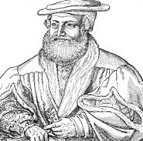

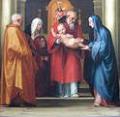
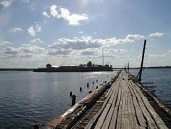
1517 On Jan. 20 the Ottomans under sultan (since May 26, 1512) Selim I Khan "the Grim" (1465-1520) conquer and sack Cairo, and finish conquering Egypt from the Mamluks, occupying Cairo on Apr. 13, after which they conquer Mecca and the other holy places of Arabia, even (gasp) Nazareth; the Mamluk Empire (founded 1250) is kaput, but the Mamluks are retained as an Egyptian ruling class as vassals; Yemen is annexed to the Ottoman Empire; Grim I becomes the first caliph of the entire grim Islamic world. On Jan. 23 after hiring away 6K Venetian troops sieging Verona, Francesco Maria I della Rovere recaptures Urbino from papal condotierro Francesco del Monte, causing Pope Leo X to hire a 10K-man army under Lorenzo II de' Medici to get it back; on Apr. 4 Lorenzo is wounded by an arquebus while sieging Mondolfo Castle, and is replaced by Cardinal Bibbiena, who is defeated at the Battle of Monte Imperiale and retreats to Pesaro; too bad, Rovere runs out of money to pay his troops, and in Sept. he signs a treaty with the pope allowing him to retreat to Mantua with his artillery along with the famed Urbino library - I have an amazing fund of useless information which serves me very well at dinner parties? The original Meet the Fuggers II? On Mar. 16 Pope Leo X's Fifth Lateran (18th Ecumenical) Council closes after ending the Pisan Schism (begun 1511) along with the Jewish and Italian monopoly on moneylending, overturning the Church's prohibition on usury. On May 1 the Evil May Day Riots riots see London apprentices fall on French residents, causing the English govt. to intervene and suppress them; Cardinal Wolsey orders 16 rioters hung, but hundreds more are pardoned by "Bluff Harry the King". On May 17 archbishop-elector Albrecht of Mainz gives force to Pope Leo X's 1515 bull requiring imprimaturs for pub. books - too late to stop the Reformation? On June 11 Sebastian Cabot and Sir Thomas Pert discover Hudson Bay. On July 1 the first burning of Protestants at the stake goes to the eternal honor of the Netherlands; the same day inquisitor Adrian Boeyens (later Pope Adrianus VI) becomes a cardinal. On Aug. 26 the Treaty of Rouen is signed by France and Scotland; Scottish bishop Gavin Douglas goes to France to arrange the marriage of 5-y.-o. James V to Princess Madeleine, daughter of Francis I. On Sept. 18 Flanders-educated Archduke Charles, having assumed the title of king Charles I of Castile arrives in Spain from the Netherlands with a large Flemish retinue, makes a triumphal entry into Valladolid, then proceeds to alienate most of the pop. with his haughty disdain, starting with making his former tutor Guillaume (William) de Croy, Lord of Chievres (Chièvres) (1458-1521) his chief minister of Spain on the death of Cardinal Jimenez, and granting a monopoly on the African Negro slave trade to Flemish merchants. On Sept. 20-Oct. 18 a Lithuanian-Polish expedition to Pskov under Konstanty Ostrogski and Jerzy Radziwill ends in defeat to the Russians at the Siege of Opochka; meanwhile the Crimean Tartars devastate Russian territories again; Russia annexes the town of Ryazan on the Oka River. With Catholic indulgences, crime does pay? The papal quest for filthy lucre finally reaps public reaction, creating the Protestant schism? On Oct. 31 (Wed.) (Halloween or All Hallows' Eve) German Roman Catholic Augustinian friar Martin Luther (1483-1546), after becoming sick of the indulgences peddled by Dominican friar Johann Teufel, er, Johann Tetzel (1465-1519) et al., and convinced that 1517 marks the end of the Babylonian Captivity of the Congregation, nails his Ninety-Five (95) Theses (Disputation on the Power of Indulgences) (written in in Latin) to the door of the Wittenberg Palast (Palace) (Castle) Church in Saxony on the Elbe River (known for housing 5K+ holy relics, which he detests), arguing against indulgences and other Roman Catholic Church abuses, starting out pulling his punches then within a few years claiming that the pope is the Antichrist, "and his seat is that of Satan himself", and that "The treasures of indulgences are nets with which they now fish for the wealth of men", igniting the already-smoldering Protestant Reformation (he could have picked a more PC date than Halloween?); he really just sent them to Mainz archbishop Albert of Brandenburg that day, then posted them on the church door sometime in mid-Nov.?; his offer of a public debate is declined, but his theses are soon translated from Latin to German and pub., causing the German middle and merchant classes, who are already chafing at Italian efforts at domination to rise to his support in reaction to the fugging Fuggers (successor to the Medicis) and other papal bankers who are draining Germany of gold for Rome with this holy racket (the Fuggers are behind the loans made by Albert of Brandenburg to the pope); the big revelation to Luther that gave him strength was from the Bible, incl. the Seven Trumpets in Rev. Ch. 8, and Rev. 13:5, where it says that the Antichrist will rule the world for 42 mo., which he turns into 1260 years instead of days, setting year 1 in 539 C.E., and claiming that Christ will therefore return in the year 1799, thus it's time to get started whipping things up? - the wildlife experience, more than a museum? In Oct. after Manuel I of Portugal rejects him, Portuguese navigator Ferdinand Magellan (1480-1521) gets Charles I of Spain (later HRE Charles V) to sponsor a voyage to Asia by way of South Am., financing it with 8,751,125 gold maravedis and naming him captain next Mar. 22 with a 10-year monopoly and a 20% cut, leaving in search of the Spice Islands in July; little did he know how large little old Asia is? Pope Leo X issues a bull calling for a 5-year peace in Christendom. On Feb. 8 Spanish conquistador Francisco Hernandez de Cordoba (Francisco Hernández de Córdoba) (-1517) leaves Havana in three ships with 100 men, and lands on the Yucatan Peninsula while on a slave-hunting expedition from Cuba, discovering traces of the once-great Mayan civilization;he gets the name Yucatan straight from the local Mayans, who reply "Yukatan" ("I don't understand you") when he asks them their name?; an attempt by Hernan Cortes to defame his rival Diego de Velazquez in a letter to the king of Spain, the Nahuatl word "Yokatlan" meaning "place of richness" all along? After claiming to see a "column of fire", St. Cyril of Novozeno founds a Russian Orthodox monastery on Ongenny Ostrov Island (Russ. "Fiery Island") on beautiful White Lake in the Vologda region of C Russia; after the Oct. 1917 Russian Rev. it is converted into a prison by the Bolsheviks, with small inhuman 2-man cells that prisoners must stay in for 22.5 hours/day. The Portuguese found a factory in Colombo, Ceylon - any orange pekoe and pekoe? The Portuguese reach Canton, China by sea. Coffee arrives in Europe for the first time - that first cup? Spanish courtier and skirt-chaser Ignatius Loyola (1491-1556) begins military duty under Antonio Manrique de Lara, viceroy of Navarre. Ludwig Senfl replaces Isaak as court composer to Maximilian I. Hans Sachs (1494-1576) settles in Nuremberg, becoming leader of the Nuremberg Meistersingers - there's a party tonight? HRE Maximilian I crowns Ulrich von Hutten (1488-1523) the "King of Poets". Corpus Christi College in Oxford U. is founded by English prelate-statesman Richard Foxe (1448-1528) for the advancement of classical education; next year its chapel is built, complete with an altar designed by Rubens; it goes on to produce theologians Reginald Pole, John Jewel and Richard Hooker, and educator Thomas Arnold. The College des Trois Langues (Collegium Trilingue) (College of Three Languages) in Louvain (Leuven), Belgium is founded by the will of humanist Joeroen van Busleyden (Hieronymus Buslidius) (1470-1517), friend of Erasmus. Science: Polish Renaissance mathematician-astronomer Nicolaus Copernicus (1473-1543) turns economist and pub. the first known argument for the Quantity Theory of Money; in 1519 he pub. the first known version of Gresham's Law, that bad money drives out good, which is 1858 is named after English financier Sir Thomas Gresham (1519-79) by Scottish economist Henry Dunning Macleod (1821-1902). Girolamo Fracastoro explains fossils as the remains of living organisms, but questions that they all came from Noah's flood - he goes too far up the family tree in his search of genealogy? Nonfiction: Anon., The Rabbinic Bible; contains a special "anti-Christian polemic" page by David Kimhi. Hans von Gersdoff, Feldtbuch der Wundtartzney; first depiction of an amputation, recommending use of a tourniquet - we'll have to take your hands and gersd off? Johann Reuchlin (1455-1522), De Arte Cabbalistica. Art: Fra Bartolommeo (1472-1517), Christ in the Temple. Matthias Grunewald (1465-1528), Maria Schnee Chapel Altarpiece (Aschaffenburg). Quentin Massys, Portrait of Erasmus. Sebastiano del Piombo, Raising of Lazarus. Raphael (1483-1520), Lo Spasimo. Andrea del Sarto (1486-1531), Madonna of the Harpies. Plays: Bartolome de Torres Naharro, Propalladia; seven Spanish comedies. Poetry: Teofilo Folengo (1496-1544), Opus Maccaronicum; satirical Latin poems on contemporary romantic epics. Henry Watson, The Grete Shyppe of Fooles of the Worlde (2 vols.); tr. of Sebastian Brant's 1494 work. Births: English Protestant courtier Henry Grey, 1st Duke of Suffolk, 3rd Marquess of Dorset (d. 1554) (AKA Marquess of Dorset) on Jan. 17; son of Thomas Grey (1477-1530); great-grandson of Elizabeth Woodville (queen of Edward IV); husband of Frances Brandon (1517-59), daughter of Henry VIII's sister Mary Tudor (1495-1533) and Charles Brandon, duke of Suffolk (1484-1545); father of Lady Jane Grey (1537-54), Katherine Grey (1540-68) and Mary Grey (1545-78); makes Leicestershire solidly Protestant. Japanese emperor #106 (1557-86) Ogimachi (d. 1593) on June 18; eldest son of Go-Nara (1497-1557). Belgian botanist Rembert Dodoens (Rembertus Dodonaeus) (d. 1585) on June 29. French cardinal (1561-) and statesman ("dominating imperial statesman of the whole century") Antoine Perrenot de Granvelle (d. 1586) on Aug. 20 in Besancon; son of Nicolas Perrenot de Granvelle (1484-1550), chancellor under HRE Charles V. English soldier-poet Henry Howard, 4th Duke of Norfolk and 3nd Earl of Surrey (d. 1547); son of Lord Thomas Howard, 3rd duke of Norfolk (1443-1524). French naturalist (founder of marine biology) Pierre Belon (Petrus Bellonius Cenomanus) (d. 1564) near Le Mans (Sarthe). English lord Henry Clifford, 2nd Earl of Cumberland (d. 1570) in Skipton, Yorkshire; husband of Eleanor Brandon (1519-47), daughter of Henry VIII's sister Mary Tudor (1495-1533) and Charles Brandon, duke of Suffolk (1484-1545); father of Margaret Clifford (-1596). Dutch Flemish painter Frans Floris (Frans de Vriendt) (d. 1570) in Antwerp; son of Cornelis I de Vriendt (-1538); brother of Cornelis Floris de Vriendt (1514-75). Italian musical theorist Gioseffo Zarlino (d. 1590) in Chioggia, Venetia. English bishop-theologian-lexicographer Thomas Cooper (Couper) (d. 1594) in Oxford; educated at Magdalen College, Oxford U. Irish archbishop (of Dublin) James Beaton (d. 1603). Deaths: Spanish cardinal Francisco Jimenez de Cisneros (b. 1436) on Nov. 8. German-Dutch composer Heinrich Isaac (b. 1450) on Mar. 26. Moldavian prince (1504-17) Bogdan III the One-Eyed (b. 1504). Dutch humanist Joeroen van Busleyden (b. 1517) on Aug. 27 in Bordeaux. Italian painter Fra Bartolommeo (b. 1472) on Oct. 6 in Florence.

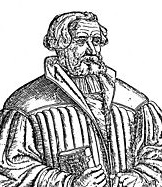
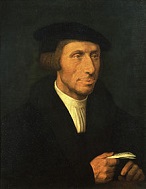








1518 Pop. of Aztec Mexico: 30M; by 1568 this is down to 3M. On Apr. 8 Spanish conquistador Juan de Grijalva (1489-1527) sails with 170-300 people on four ships from Matanzas, Cuba to Yucatan, discovering Cozumel and arriving on May 1 in Tobasco, where he first observes cigarette smoking, renaming the Tobasco River Rio Grijalva, then discovers Mexico and names it New Spain to thank them for not smoking; on Dec. 18 the Spanish start a smallpox epidemic among the aborigines in Santo Domingo, which soon spreads to Yucatan, Mexico, and Peru, ultimately killing 20M (50%-90% of the indigenous pop.), and clearing the way for smoke-free Euros. In mid-July the Dancing Plague of 1518 hits Strasbourg, France, starting with Frau Troffea and growing to three dozen in a week and 400 by Aug. ,until it fades in Sept. In July after he has been raiding E Abyssinia for 25 years, always choosing Lent so that the Christian Ethiopians will be weak from fasting, the Ethiopians under emperor (since Aug. 13, 1507) Dawit II skip the observance of Lent and ambush and kill Emir Mahfuz of Adal, causing Dawit II to adopt the style "Wanag Segad", meaning "to whom lions bow"; meanwhile a Portuguese fleet burns the former Adal capital of Zeila in Somalia. On Oct. 2 the Battle of Brannkyrka sees Gustavus Wasa and several Swedish nobles captured by the Danes and held hostage. In Oct. the Peace (Treaty) of London, a non-aggression pact between England, France, the HRE, Spain, and Pope Leo X is devised by Cardinal Wolsey, who wants to get all 20 leading states of Europe to end warfare; too bad, the peace is broken in a few years with wars between Denmark and Sweden, and England and Spain against France, but a pan-European peace movement gets started and picks up steam, culminating in the 1815 Congress of Vienna. Martin Luther is summoned by Cardinal (since 1517) Thomas Cajetan (Gaetanus) (Thomas or Tommaso de Vio) (Jacopo Vio) (1469-1534) to the Diet of Augsburg, where he refuses to recant and appeals to Pope Leo X, causing papal nuncio Karl von Miltitz (1490-1529) to mediate; meanwhile Johann Eck pub. Obelesci (Obelisks), attacking Luther, which are answered by Andreas Rudolph Bodenstein von Karlstadt (Carlstadt) (Karolostadt) (AKA Brother Andrew) (1486-1541), who challenges him to a debate, which is held next June. Tommaso de Vio of Gaeta (AKA Cajetan or Gaetanus) (1469-1534) (not to be confused with Theatines founder St. Cajetan). The Siege of Polotsk by the Russians is broken after Lithuanian forces allegedly have a sighting of their patron saint St. Casimir Jagiellon (1458-84). Catherine of Aragon's last recorded miscarriage happens this year. After capturing Tenes, Ottoman adm. Oruc Barbarossa captures Tlemcen in NW Algeria, whose sultan flees to Morocco, giving Oruc control of the country behind the Spanish base of Oran 70 mi. away, threatening their supply routes; too bad, the Spanish counterattack, killing Oruc and regaining the Tlemcen region, only to see the red-bearded king Arouj of Morocco lead an army that expels them; too bad, Arouj is KIA in a battle with the Spanish, causing his brother Khair-ed-Din to appeal to the Turkish sultan for help, and after they drive the Spanish out of N Africa, he is appointed rep. of the Barbary States of Algiers and Tunis (modern Algiers and Tunisia), with HQ in Algiers, which with Tripoli (Libya) and Tangier (Morocco) (AKA the Barbary or Berber Coast) send pirate corsairs into the Mediterranean until the 19th cent., intercepting ships and holding hostages for ransom (Muslim jizya) - ending up as a Las Vegas casino? Thomas More, having worked his way up with Henry VIII becomes a member of the privy council; Thomas Wolsey is appointed Pope Leo X's legate a latere (confidential rep.) in England, which gives Henry VIII ideas about using him to rid himself of his menopausal Portuguese wife? Diego de Velazquez is appointed gov. of Cuba by the king of Spain; he and Hernán (Hernan) Cortes (1485-1547) organize a military expedition to Mexico, with Cortes countermanding Velazquez's orders and following the coast of Yucatan, clashing with Indians in Tabasco and reaching San Juan de Ulua (Ulúa) on the Gulf of Mexico near modern-day Veracruz; the Tabasco natives give Cortes several hot women, incl. Malitzin (Doña Marina) (Malinche), a Mexican slave who speaks Mayan and Nahuatl and becomes his common-law wife and official interpreter. The Muslim Bahmani Kingdom of the Deccan in India divides into the five sultanates of Ahmadnagar, Barar, Bidar, Dijapur, and Golkonda, and begin a push against the Hindu Vijayanagara Kingdom to the S. Mahmud of Bidar, India dies, and minister Kasim Barid continues in power, plotting for his dynasty to mount the throne (1527). The Franciscans come to Goa - the Indians wish they'd come and goa? Henry VIII of England presents 400 battle mastiffs to Charles I of Spain (HRE Charles V). The Mayan town of Tulum ("wall") on the E side of the Yucatan Peninsula is first mentioned by Juan Diaz, a member of Juan de Grijalva's expedition; cliff ruins survive to modern times, becoming a popular destination for tourists, esp. Yoga lovers. Porcelain is imported to Europe from E Asia; by modern times Limoges, France becomes a great place for porcelain hunters. The Royal College of Physicians in London is founded by charter from Henry VIII by physician Thomas Linacre (1460-1524), becoming the oldest medical inst. in England. Melanchthon becomes prof. of Greek at the U. of Wittenberg. Ariosto arranges regular performances at the court theater of Ariosto. Kronen (Ger. "crown") Brewery in Dortmund, Germany is first mentioned; in 1845 it converts to lager brewing; in 1871 it introduces Dortmund Export. Inventions: Spectacles for the shortsighted are developed by ?. Nonfiction: Anon., The Secret Grimoire of Turiel; the 18th watcher of the 20 leaders of the 200 fallen angels mentioned in the Book of Enoch. Martin Fernandez de Enciso (1470-1528), Suma de Geografia que Trata de Todas Las Partidas del Mundo; first pub. description of the avocado, which he says is grown near Santa Marta, Colombia. Desiderius Erasmus (1466-1536), Colloquies; ironic examination of religious practices with hidden meanings for the learned; 13 eds. are pub. by 1533, expanding to 50 colloquies. Henry of Ghent (1217-93), Quodlibeta (posth.) (Paris). Adam Riese (1492-1559), Practical Arithmetic. Johannes Trithemius, Cryptography; first book on the subject? Art: Albrecht Altdorfer (1480-1538), St. Florian (altarpiece). Antonio da Correggio (1489-1534), Diana Returning from the Chase (Abbess' Salon, Convent of San Paolo, Parma). Dosso Dossi (1483-1542), Jupiter, Mercury and the Virtue. Albrecht Durer (1471-1528), Portrait of Jakob Fugger. Raphael (1483-1520), Portrait of Pope Leo X with Cardinals; La Fornarina (1518-9); The Transfiguration (1518-) (last masterpiece). Il Sodoma (1477-1549), St. George and the Dragon. Veit Stoss (1438-1533), Annunciation and Seven Joys of the Virgin (wood sculpture in the Lorenzkirche in Nuremberg). Titian (1488-1576), The Tribute Money. Births: German Lutheran theologian Johann Funck (Funk) (Funccius) (d. 1566) on Feb. 7 in Wohrd (Nuremberg); educated at the U. of Wittenberg. French caged (1526-9) dauphin Francis III, Duke of Brittany (d. 1536) on Feb. 28; eldest son of Francis I (1494-1547) and Claude (1499-1524) (daughter of Louis XII). Dutch Flemish composer Ihan Gero (d. 1583). Venetian painter Jacopo Robusti, "Il Tintoretto" (Ital. "The Little Dyer") (d. 1594). Deaths: Hindu poet and religious reformer Kabir (b. 1440). Italian celeb mistress Vannozza dei Cattanei (b. 1442) on Nov. 24. Spanish gov. (of Hispaniola) Nicolas de Ovando (b. 1460) on May 29 in Madrid - RIP?




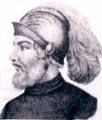








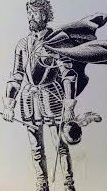
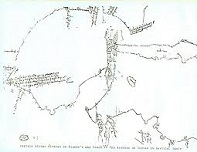




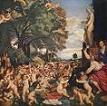
1519 Wherever we go that's where the party's at? On Jan. 1 Ulrich (Huldrych) (Huldreich) Zwingli (1484-1531) is appointed priest of the Great Cathedral (Grossemunster) in Zurich, Switzerland, starting the Protestant Reformation in Switzerland (basis for the later Puritans, Pilgrims, and Huguenots) with popular lectures based on Erasmus' new and improved translations of the Bible, causing an admirer to place his printing press at his disposal; meanwhile Zwingli encounters the writings of Martin Luther, forming a cross-country connection, making the Protestants really dangerous? On Jan. 12 after clashing with Panama gov. Pedro Arias de Avila, Vasco Nunez de Balboa (b. 1474) is framed then beheaded for treason - tresor chocolat? On Jan. 12 HRE Maximilian I (b. 1459) dies, and on June 28 his 19-y.-o. grandson Charles of Hapsburg (Charles I of Spain) is elected over Francis I of France as HRE Charles V (1500-58) (until Aug. 27, 1556); this ultimate lucky dude speaks German, Spanish, Italian, French and Flemish, but despite this he promotes the Inquisition in the Netherlands, which becomes "much more pitiless than that of Spain" (Philip II); the Spanish pop. is opposed to his leaving the country with Spanish men and money, fomenting the Comunero Revolt next year. In Feb. Spanish conquistador Hernan Cortes (Hernán Cortés) (1485-1547) renounces the authority of Diego de Velazquez, relocates the city of Havana (from the Indian name Guanabacoa meaning "site of the waters") in Cuba to the N coast as a Spanish naval base (modern-day pop. 2M), then takes off with on 11 ships with 400-600 men (70 musketeers, 40 crossbowmen, and several hundred Indian and Cuban servants), incl. 2nd-in-command Pedro de Alvarado y Contreras (1495-1541) and chronicler Bernal Diaz del Castillo (1496-1584) for New Spain (Mexico), and on Apr. 21 he lands in Veracruz with his well-armed men, 16 horses, 14 pieces of artillery, and a big pair of balls, and founds the city of Villa Rica de la Veracruz (Vera Cruz) (Sp. "true cross") (modern-day pop. 520K/702K) in Mexico after burning his own ships to keep his men from returning to Cuba; after his soldiers elect him as chief magistrate and send reps to the crown for confirmation, Cortes leaves a small garrison then begins travelling through Aztec villages, finding altars piled with skulls and smelling of rotten blood mixed with flowers while sending envoys to Emperor Montezuma (Moctezuma) II (1480-1520, who is zapped out by the belief that these white dudes are gods and Cortes is pale-faced feathered-serpent man-god Quetzalcoatl (whose arrival is predicted by the Mayan priests this year after some lost Viking stumbled ashore long ago?), and avoids confrontation; Cortes gains support from the Totonacs, then ends up in 11K-ft. mountains where their clothing is inadequate, and several servants die, then crosses desert salt lakes without food and water, until he comes to the independent city of Tlaxcala, and faces 149K fierce warriors with obsidian clubs and spears, holding out for two weeks on a little hill until they suddenly give up, welcome him as a friend, and offer him their daughters, then offer to help him fight their worst enemies the Aztecs (Mexica); on Mar. 12 Cortes and his men arrive in Potonchan (Potonchán) on the left bank of the Grijalva (Tabasco River), finding them hostile, after which on Mar. 25 they win a V over the Aztecs at the Battle of Centla, where Diego de Ordaz (1480-1532) distinguishes himself, going on to climb 17,802 ft. (5,426m) Popocatepetl (Popocatépetl) in C Mexico 40 mi. SE of Mexico City with two comrades, becoming the first white Euros, impressing Cortes native allies, after which HRE Charles V authorizes Ordaz to pus the volcano on his coat of arms; after passing through the narrow streets of Cholula (known for its Great Pyramid) Cortes and his men meet fierce resistance, incl. rooftop ambushes, and kill 3K and sack it, the news reaching Montezuma, who says his heart is "washed in chilies" with grief; Cortes brings horses to the Am. mainland for the first time? On Mar. 29 Francesco II Gonzaga (b. 1466) dies of syphilis contracted from hos, and his son Federico II Gonzaga (1500-40) becomes marquis of Mantua (until mar. 25, 1530), with his wife Isabella d'Este acting as regent; on Apr. 7, 1521 he is invested by HRE Charles V, a first for his family, which is now legit and PC; too bad, he suffers from congenital syphilis, which messes with his mind and causes an early death. In Mar. with backing from gov. Francisco de Garay, Spanish explorer Alonso Alvarez (Álvarez) de Pineda (1494-1520) leaves Santiago, Jamaica with three ships and 270 soldiers, exploring and mapping the Gulf of Mexico coastline, establishing that Florida is a peninsula instead of an island; on June 2 he reaches Mobile Bay (Alabama River), then discovers the mouth of the Mississippi River, and reaches Corpus Christi Bay in Tex. on June 24 (Feast of Corpus Christi), making the first known map of the Gulf Coast region of the U.S. incl. Texas, anchoring off Villa Rica de la Veracruz shortly after Hernan Cortes leaves, causing the latter to turn around to meet him, after which Pineda attempts in vain to negotiate a boundary between the lands they claim, then sails N to the "Las Palmas" (Panuco) River, landing near modern-day Tampico and spending 40+ days repairing his ships; too bad, next Jan. the Huastecs attack and kill him, although 60 colonists are evacuated by Diego de Camargo. On Apr. 5 Francois Rabelais (1495-1553) enters the Franciscan monastery at Fontenay-le-Comte in Poitou, where he studies Greek, pissing-off the authorities. On May 2 Leonardo da Vinci (b. 1452) dies without fulfilling two major dreams, to fly, and to complete his famous horse sculpture; he produces a total of 17 paintings, some unfinished, and all suffering devolution from the many untested experimental materials and paints he used - did he hear about the Reformation? In June-July Martin Luther's man Andreas Rudolf Bodenstein von Karlstadt (Carlstadt) (Karolostadt) (AKA Brother Andrew) (1486-1541) and Pope Leo X's man (former friend of Luther) Johann Maier von Eck (1486-1543) engage in the Leipzig Debate (Leipziger Disputation) in Pleissenburg Castle, debating about grace, free will, the primacy of the pope and infallibility of papal decisions, and purgatory; after getting pissed-off bigtime, Eck charges Luther with being a Hussite heretic; the judges fail to reach a verdict, but the public allegedly goes with Eck; papal chamberlain Karl von Militz advises Luther to write a letter of submission to Pope Leo X, and Luther acquiesces (better soft paper than cold steel and hot lead?); too bad, when Protestants and Roman Catholics debated, they often use their common but more distant enemy Islam as an escape valve, pretending to praise it for being better than the other in such and such a category, with Luther actually claiming that to make a war on the infidel Ottomans is to rebel against God, who has been sending them to punish the sins of Roman Catholicism, beginning a 500-year appeasement jag that softens the West up for 9/11?; "The Reformation generated more vehement and coherent arguments between Christians, the ultimate effect of which was to favour the Muslims. It became customary amongst Catholics and Protestants for each to censure the 'vices' of the other's religion and to emphasize that the infidel [Muslims] exemplified the corresponding 'virtue,', which naturally would have been much better suited to the Christians... In fact the arguments between Catholics and Protestants frequently led to a competition as to which of the two could hurt the adversary more by heaping praise upon the infidel"; "The Reformation produced one logical if unexpected result: a definite boost to the positive evaluation of Islam, and therefore to the birth and development of an often conventional and mannered pro-Islamic stance." (Bernard Lewis) On Aug. 15 Pascual de Andagoya (1495-1548) founds the city of Panama City (modern-day pop. 880K) as the seat of govt. for Pedro Arias de Avila, bringing in 400 (later 1.5K) settlers, incl. Hernando de Soto; Avila refounds Nombre de Dios on the Alantic side, and clears a route across the isthmus; Panama City becomes the base for Spanish exploitation of the W coast of South Am., incl. the unfortunate Incas, whose treasure later flows in from the coast, is loaded onto mules, and transported over the jungle trail to Porto Bello on the Caribbean for loading onto Spanish galleons. On Sept. 20 Ferdinand Magellan (1480-1521) leads an expedition of 237 men sailing from Spain in five small ships incl. flagship Trinidad, Concepcion, San Antonio, Victoria, Santiago in search of a westerly route to the Spice Islands in Indonesia (the Indies), which ends up circumnavigating the globe, starting by sighting the equator on Nov. 27, sighting South Am. on Dec. 6, and anchoring near modern-day Rio de Janeiro on Dec. 13, reaching Rio de la Plata next Feb., then sailing S to Puerto San Julian, Argentina next Mar. 30, where they overwinter, surviving a mutiny on Easter (Apr. 1-2); on Oct. 21, 1520 they reach Cape Virgenes and and discover the Magellan Strait the NE coast of Brazil, then sail S to Puerto San Julian, Argentina, overwintering sailing S to Puerto Santa Cruz, Argentina in the winter; on Oct. 18 they begin navigating the Magellan Strait between South Am. and Tierra del Fuego (later site of the city of Punta Arenas, Chile, southernmost city on Earth); after mistakenly believing that native Tehuelches are giants, he names Patagonia from the Spanish word pata or feet, "Land of the Bigfeet"; actually they avg. 5'11", compared to 5'1" for the Spaniards, but it takes until the end of the 18th cent. to debunk the myths; on Nov. 28 after one is wrecked in a storm and the other returns to Spain, three of the five ships sail into a "beautiful peaceful ocean", which Magellan names the Pacific Ocean because of how calm and peaceful it is compared to the Atlantic Ocean (how could he know about them hurricanes?); 98 days later they reach the Philippine Islands; Megellan's brother-in-law Duarte Barbosa (1480-1521) accompanies him, leaving The Book of Duarte Barbosa, one of the first examples of Portuguese travel lit. On Nov. 8 (the Aztec day of 1 Wind, known for robbery, violation and deceit) Cortes enters the Aztec capital (island city with three main bridges) of Tenochtitlan in the Valley of Mexico, calling the city "the most beautiful thing in the world", then lucks out with his white skin wowing them, with the Aztecs feeling like they "ate stupefying mushrooms", and is mistaken for the god Quetzalcoatl (it is the 4-Movement year in the Aztec calendar, when the 5th and last sun or creation of the world is slated to end, if sacrifices are not made), and uses it to gain access to Montezuma II, who greets him in the palace courtyard (which later becomes the Hospital of Jesus), telling him, "They said you would return"; Montezuma then takes Cortes "by the hand, and pointed out to him the different parts of the city" from the summit of the temple (Diaz), then gives Cortes a tour of the temple of the war god Hutsilopochtli, which grosses Cortes out with its bloody walls and human hearts, causing him to ask Monty if he will give up Devil worship and permit a cross and a picture of the Virgin Mary to be placed there, which pisses-off Montezuma, who tells him not to bring the subject up again; after one week Cortes, learning of an Aztec attack at Veracruz makes a bold power play and arrests Montezuma after a 4-hour argument, after which Montezuma caves in and becomes his puppet, acknowledging the sovereignty of HRE Charles V; Cortez finds that the avocado is a diet staple; this might be where the Am. aborigines first get their hands on horses, incl. some Arabian horses brought from Spain; chocolate is first encountered by Euros at Montezuma's court (they mix it with chilies instead of sugar, and use water instead of milk). In Dec. the Teutonic Order goes to war with Poland over East Prussia (ends 1521). The Russians ravage Kreva in Belarus; meanwhile the Crimean Tartars attack Lviv in Ukraine and Lublin in Poland. The Revolt of the Brotherhoods (Rebellion de las Germanias) of the artisan guilds (Germanies) in Valencia, Spain against the govt. of Charles I (HRE Charles V) begins (ends 1523), inspiring a similar revolt in Majorca in 1521-3. Francis I attempts to test the loyalty of Charles of Bourbon by offering his widowed mother to him for marriage, which he rejects. Swedish leader Gustavus Wasa escapes to Lubeck, Germany. The Jews are expelled from Regensburg, Germany. Young English deb Anne Boleyn (b. 1507) goes to the French court (until 1521). A silver mine near the Czech (Bohemian) town of Joachimsthal (Ger. "James Valley") begins minting the Joachimsthaler, which eventually becomes known as the taler (thaler) (dollar). Charles III de Montpensier and de Bourbon (1490-1527) succeeds Leonardo da Vinci as grandmaster of the Priory of Sion (until 1527); his entourage incl. Jean de Joyeuse, Lord of Rennes-le-Chateau :). A family of moles are tried in absentia in Stelvio Pass in N Italy for damaging crops "by burrowing, so that neither grass nor green thing could grow"; they are sentenced to exile with safe conduct and given 14 extra days if they have infants to raise. Architecture: St. George's Chapel in Windsor, England (begun 1473) is finished. Nonfiction: Johann Eck (1486-1543), De Primatu Petri (On the Primacy of the Pope). Desiderius Erasmus (1466-1536), Colloquia. Ulrich von Hutten (1488-1523), On the French Disease (De Morbo Gallico); about his treatment for syphilis, which he contracted in 1508, becoming one of the first patient narratives. Art: Albrecht Durer (1471-1528), Portrait of HRE Maximilian I; holds a globe in his hand; Virgin Mary and Christ Child with St. Anne; painted after he goes Lutheran. Titian (1477-1576), Worship of Venus. Plays: Sebastian Brant (1457-1521), Narrenschiff; introduces Hans Wurst (Hanswurst), a vulgar clown AKA Pickelhering; spreads over Germany and Austria, and ends up banned in Leipzig in 1737. Novels: Gonzalo Fernandez de Oviedo y Valdes (1478-1557), Book of the Very Striving and Invincible Knight Don Claribalte (Valencia); chivalric romance. Births: French prince of Orange (1530-44) Rene (Renatus) of Chalon (Nassau-Breda) (d. 1544) on Feb. 5 in Breda. Spanish gov. #1 of Fla. (1565-74) adm. Pedro Menendez de Aviles (Menéndez de Avilés) (d. 1574) on Feb. 15 in Aviles (Asturias); founder of St. Augustine, Fla. (1565). French Huguenot leader adm. Gaspard II de Coligny, Seigneur de Chatillon (d. 1572) on Feb. 16 in Burgundy; son of Gaspard I de Cologny, marshal of Chatillon-sur-Long. French Roman Catholic gen.-statesman ("Le Grande Guise") Francis (Francois) of Lorraine, 2nd Duke of Guise (d. 1563) on Feb. 17 in Bar-le-Duc, Lorraine; son of Claude of Lorraine (1496-1550) and Antoinette de Bourbon; father of Henri de Lorraine Guise, 3rd duc de Guise (1550-88). French king (1547-59) Henry (Henri) II, Duke of Orleans (b. 1559) on Mar. 31 in Saint-Germain-en-Laye; 2nd son of Francis I and Claude; grandson of Louis XII. French queen consort/regent (1547-89) Catherine de' Medici (de Medici) (de Medicis) (de Médicis) (d. 1589) on Apr. 13 in Florence; wife of Henry II; daughter of Lorenzo II de' Medici, duke of Urbino (to whom Machiavelli dedicated "The Prince"); niece of Pope Clement VII; born into the richest non-royal family in France; mother of four sons, three of whom become French kings, all weak; mother-in-law of Mary, Queen of Scots; has a "face resembling a plank of wood", is fond of broccoli, truffles and melons, and insists on table manners and the table fork, introducing the French to Italian tastes and founding modern French cuisine; her subjects despise her as a foreign interloper, calling her "the maggot from Italy's tomb" and "Madame La Serpente"; Mary Stuart, Queen of Scots calls her a "Florentine shopkeeper's daughter" whom she couldn't forgive for being a commoner? Italian physiologist-botanist Andrea Cesalpino (Andreas Caesalpinus) (d. 1603) on June 6 in Arezzo, Tuscano; educated at the U. of Pisa. Tuscan grand duke (1537-74) Cosimo I de' Medici (the Great) (d. 1574) on June 12 in Florence; son of condottiere Giovanni dalle Bande Nere (1498-1526) and Maria Salviati. French Protestant theologian-poet (in Switzerland) (disciple of John Calvin) Theodore Beza (de Besze) (d. 1605) on June 24 in Vezelay, Burgundy, France. English merchant-financier (founder of the Royal Exchange in London) Sir Thomas Gresham (the Elder) (d. 1579); namesake of Gresham's Law ("bad money drives out good"); educated at Gonville and Caius College, Cambridge U.; apprentices to his merchant uncle Sir John Gresham (1495-1556), becoming one of the wealthiest men in England; knighted in 1559. English archbishop of Canterbury (1576-83) Edmund Grindal (d. 1583) in Hensingham (near St. Bees), Cumberland; educated at Magdalene and Christ's Colleges and Pembroke Hall, Cambridge U. Ottoman grand adm. (Muslim convert) Uluj Ali (Uluc Ali Reis) (Giovanni Diongini Galeni) (d. 1587) (AKA Uchali, Occhiali) in Le Castella, Calabria. Italian "History of the New World" historian Girolamo Benzoni (d. ?) in Milan. Deaths: Japanese hero Hojo Soun (b. 1432). German painter Michael Wolgemut of Durer (b. 1434). Italian Triple X Ultimate Extreme Renaissance Man Leonardo da Vinci (d. 1452) on May 2 in Cloux (near Amboise), France; in 1737 three fingers, a tooth, and a vertebra are removed from his body by admirers: leaves Treatise on Painting, compiled by his student Francesco Melzi; "The movement which is depicted must be appropriate to the mental state of the figure, otherwise the figure will be considered twice dead: dead because it is a depiction, and dead yet again in not exhibiting motion either of the mind or of the body"; "I have been impressed with the urgency of doing. Knowing is not enough; we must apply. Being willing is not enough; we must do"; "Many have made a trade of delusions and false miracles, deceiving the stupid multitude"; "Anyone who conducts an argument by appealing to authority is not using his intelligence, he is just using his memory"; "Art is never finished, only abandoned"; "The greatest deception men suffer is from their own opinions"; "There are three classes of people: those who see, those who see when they are shown, those who do not see"; "Men of lofty genius when they are doing the least work are most active"; "I have discovered that it is of some use that when you lie in bed at night, and gaze into the darkness, to repeat in your mind the things you have been studying. Not only does it help the understanding, but also the memory"; "If you do not rest on the good foundation of Nature, you will labor with little honor and less profit"; "Nature never breaks her own laws"; "There is no result in Nature without a cause; understand the cause and you will have no need of the experiment"; "Necessity is the mistress and guide of nature. Necessity is the theme and the inventress, the eternal curb and law of nature"; "Although Nature commences with reason and ends in experience it is necessary for us to do the opposite, that is to commence as I said before with experience and from this to proceed to investigate the reason"; "Experiment is the interpreter of Nature. Experiments never deceive. I t is our judgment which sometimes deceives itself because it expects results which experiment refuses. We must consult experiment, varying the circumstances, until we have deduced general rules, for experiment alone can furnish reliable rules"; "Why does the eye see a thing more clearly in dreams than the imagination when awake?"; "He who loves practice without theory is like the sailor who boards ship without a rudder and compass and never knows where he may cast"; "Wisdom is the daughter of experience"; "The truth of things is the chief nutriment of superior intellects"; "Learning never exhausts the mind"; "Water is the driving force of all nature"; "Life well spent is long"; "While I thought that I was learning how to live, I have been learning how to die"; "Marriage is like putting your hand into a bag of snakes in the hope of pulling out an eel"; "In rivers, the water that you touch is the last of what has passed and the first of that which comes; so with present time"; "Blinding ignorance does mislead us. O wretched mortals, open your eyes!"; "The Medici created and destroyed me." Austrian HRE (1508-19) Maximilian I of Hapsburg (b. 1459) on Jan. 12 in Wels, Upper Austria; the Tomb of HRE Maximilian I features a cool Renaissance statue of King Arthur, and Gothic-style statue of King Theodoric by Peter Vischer the Elder. Italian marquis of Mantua (1484-1519) Francesco II Gonzaga (b. 1466) on Mar. 29 (syphilis contracted from hos). English dean of St. Paul's (1505-19) John Colet (b. 1467) on Sept. 10 in London (sweating sickness). Italian sculptor Domenico Fancelli (b. 1469) in Zaragoza, Spain. Spanish explorer Vasco Nunez de Balboa (b. 1474) on Jan. 12 in Panama (beheaded in Acla Square) - goes pacifically? Italian thrice-married femme fatale Lucrezia Borgia, duchess of Ferrara (b. 1480) on June 24 (night); dies from complications of giving birth to a daughter on June 14 - a little old for that?
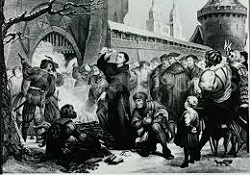














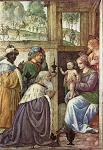
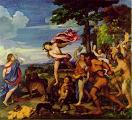
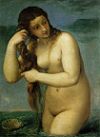
1520 An infected African slave spreads smallpox to Mexico on a Spanish ship, decimating the pop., spreading to Central Am. and the Incan Empire in time to soften them all up for Spanish conquest. Roman Catholic Europe has a sugar situation it can't handle? This year Europe is introduced to Protestantism; Martin Luther (1483-1546) pub. 24 bestselling works all in one year, incl. the "big three" pamphlets Address to the Christian Nobility of the German Nation, Of the Liberty of the Christian, and On the Babylonian Captivity of the Christian Church (Oct. 6), which contains the soundbytes: "Whether I will it or not, I become wiser every day, urged on as I am by so many illustrious masters. Two years ago, I attacked indulgences, but with so much indecision and fear, that I am now ashamed of it. It is not, however, to be wondered at, for I was alone when I set this stone rolling"; "I denied that the papacy was of Divine origin, but I granted that it was of human right. Now, after reading all the subtleties on which these gentry have set up their idol, I know that the papacy is none other than the kingdom of Babylon, and the violence of Nimrod the mighty hunter. I therefore beseech all my friends and all the booksellers to burn the books that I have written on this subject, and to substitute this one proposition in their place: The papacy is a general chase led by the Roman bishop, to catch and destroy souls"; they get quickly distributed all over Europe - and the caca soon hits the fan among his loving Catholic brethren down at the Sunset Grill? On Jan. 18 the Battle of Lake Asunden (near Borgesund) sees Christian II along with a large army of French, German, and Scottish mercenaries defeat a peasant army; on Jan. 19 the Battle of Bogesund on icy Lake Asunder near Bogsund sees Christian II's army led by Otte Krumpen (1473-1569) intercepted by a force led by Swedish regent Sten Sture the Younger (b. 1492), who is hit in the leg by a cannonball, killing his horse, causing his men to scatter, after which he dies on icy Lake Malaren on Feb. 5 of his wounds while retreating to Stockholm near Lake Malar, and on Nov. 4 after conquering Stockholm, Christian (Kristian) II (1481-1559) of Denmark and Norway is crowned king of Sweden, forcing it back into the Kalmar Union, knighting Krumpen; too bad, on Nov. 7-9 Christian II stages the Stockholm Bloodbath (Massacre) of 80-90 people (mostly nobility and clergy supporting Sten Sture the Younger incl. Eric Vasa) after reneging on a promise of gen. amnesty, causing them to rally behind Gustav Vasa (Gustavus Wasa) to oust the bloody Indian giver. On Mar. 10 Thomas Howard, 3rd Duke of Norfolk, Earl of Surrey (1473-1554) (uncle of Anne Boleyn) is appointed lord deputy of Ireland, with orders from Henry VIII to use persuasion rather than violence, facing the thankless task of pacifying the rival factions of the Earl of Kildare and Earl of Ormonde, sending letters demanding money and troops; he is recalled at the end of 1521 to take command of the English fleet for naval operations against France. Fun in the sun of Mexico NOT, or How 500 white men conquered 7M-30M red men suffering from auto-reverse racism, and reduced their pop. to 3M in 50 years? In Mar. displeased at the resistance of Spanish conquistador Hernan Cortes (Hernán Cortés) (1485-1547) to his authority as gov. of Cuba, Diego Velazquez sends an expedition under Panfilo de Narvaez (Pánfilo de Narváez) (1470-1528) from Havana, which lands at San Juan de Ulua on Apr. 23 and captures Cempoala; in May Cortes leaves Tenochtitlan under the protection of Pedro de Alvarado and 200 men, then defeats Narvaez on May 26 and takes him prisoner at Vera Cruz, persuading his men to join him. On Apr. 9 a Portuguese embassy led by Dom Rodrigo de Lima arrives in Massawa, Ethiopia, meeting with emperor Dawit II on Oct. 19, who tells him that the Muslim threat to Ethiopia is kaput, and he finally leaves in 1526. On May 20 20-y.-o. Netherlands-raised HRE Charles V leaves Spain to visit his new empire in Germany after squeezing his alienated Spanish subjects for money (he first goes to Aix-la-Chapelle to be crowned HRE); the War of the Communidad (Comunero Rebellion) breaks out in Castile against Charles the absentee king's rule (the largest urban rebellion in early modern Europe) when Juan de Padilla (1490-1521) starts an uprising in Toledo, and attempts to gain the support of Charles V's mother Mad Joanna, claiming that she isn't really insane but that Charles is keeping her incommunicado, then organizing a Holy League (Santa Junta) at Avily in July; too bad, the radicals take over, causing the nobles to quit. On June 7-24 Francis I and Henry VIII meet at the Field of the Cloth of Gold on Balinghem Plain between Guines and Ardres near Calais to sign a commercial treaty and discuss uniting against Charles V; despite splendid banquets and tournaments and gorgeous trappings, Henry declines, and later allies with Charles, who visits him at Dover and Canterbury. Holy bullshit? On June 15 Leo X's 41-point papal bull Exsurge Domine condemns pesky freethinker Martin Luther as a heretic, comparing him to a fox and a boar, and orders him to recant his views on that reformation thang within 60 days while calling for the burning of all his writings; after it backfires as a way to pull Luther's support from under his feet, on Dec. 10 Luther defiantly burns the bull, er, papal B.S., er, bull, along with the canon law near the Luther Oak in Wittenberg; the Catholics now begin calling Luther the Antichrist (forgetting the pagan Roman emperors and Muhammad), while the Protestants begin calling the pope the Antichrist; Leo X's main man Johann Maier von Eck (1486-1543) goes to Rome then returns to Germany as papal legate to enforce the bull. Like a cheating husband who won't go away? In June Cortes returns to Tenochtitlan, where Montezuma II always gets a kick out of watching Spanish soldiers play cards, and observes Aztecs (Mexica) writing with lead crayons (pencils?), but this time the cocoa bean-bartering Aztecs have had it up to there with Cortes and his cruel lt. Alvarado, who attacked warriors during religious celebrations, and believing their king has lost his aura, on June 30 they stone Montezuma II while trying to persuade them to kiss white Spanish butt from the palace roof (he dies on July 3), then trap and cut off Alvarado and his men, destroy the three bridges leading out of the island city, and siege them, but Alvarado makes a portable bridge out of ceiling beams and sneaks out at midnight; too bad, he is spotted halfway across, saves his life by jumping over Alvarado's Leap in the causeway, and loses three-fourths (800) of his men killed or captured (later used for sacrifices to the war god) before escaping and regrouping with Cortes under a huge ceiba (silk-cotton) (kapok) tree in what becomes known as La Noche Triste (the Sad Night), in which Cortes sits under the tree and weeps; after making sure his shipbuilder Martin Lopez is still with him, he says, "Okay, let's go, for we lack nothing", and they head back to their race-traitor allies in Tlaxcala; meanwhile Montezuma II (b. 1479) is succeeded as Aztec king by his younger brother Cuitlahuac (Cuitláhuac) (1476-120), who prepares to finish Cortes off, but on July 7 Cortes kicks their butts in the Battle of Otumba, with 100K-200K Aztecs getting their butts kicked by 500 Spaniards and a few hundred Tlaxcalans, losing only 73 Spanish KIA; in late Sept. after a reign of 80 days Cuitlahuac dies of the smallpox, and is succeeded by Montezuma II's nephew Cuauhtemoc (Cuautehmóc) (Cuitlahuac) (d. 1521), the last Aztec ruler; Cortes returns to Tlaxcala, receives reinforcements, and ends up making Texcoco his base on Dec. 31 while he prepares to return with 600 men and tens of thousands of native allies, having a stroke of genius and building a fleet of 13 40-ft. brigantines on land, which he has disassembled to be hauled overland by 8K native porters back to Tenochitlan for a final siege. Nothing beats jellin' like Magellan? On Sept. 20 after spending more money on sherry than weapons, Ferdinand Magellan (1480-1521) leads an expedition of 237 men sailing from Spain in five small ships incl. flagship Trinidad, Concepcion, San Antonio, Victoria, Santiago in search of a westerly route to the Spice Islands in Indonesia (the Indies), which ends up circumnavigating the globe, starting by crossing the equator on Nov. 27 and sighting South Am. on Dec. 6, reaching modern-day Rio de Janeiro on Dec. 3, then sailing S to Rio de la Plata in Feb. 1520, and overwintering in Puerto San Julian in Argentina, surviving a mutiny on Easter (Apr. 1-2); on Oct. 21, 1520 they reach Cape Virgenes and begin navigating the Magellan Strait between South Am. and Tierra del Fuego (later site of the city of Punta Arenas, Chile, southernmost city on Earth); after mistakenly believing that native Tehuelches are giants, he names Patagonia from the Spanish word pata or feet, "Land of the Bigfeet"; actually they avg. 5'11", compared to 5'1" for the Spaniards, but it takes until the end of the 18th cent. to debunk the myths; on Nov. 28 after one is wrecked in a storm and the other returns to Spain, three of the five ships sail into the Pacific Ocean, which Magellan names because of how calm and peaceful it is compared to the Atlantic (how could he know about them hurricanes?); 98 days later they reach the Philippine Islands. With the Roman Catholic Church splintering, the Ottomans see their chance? On Sept. 22 sultan (since 1512) Selim I the Grim (b. 1465) dies while preparing an expedition against pesky Hospitaler-held Rhodes after expanding the Ottoman Empire from 2.5M sq. km to 6.5M sq. km, leaving a bunch of Turkish and Persian poetry, and a royal treasury filled to the brim and locked with his own seal and the soundbyte: "He who fills the treasury more than this may use his seal to lock it" (no one takes him up until the empire collapses four cents. later?), and on Sept. 30 his son Suleiman (Suleyman) I (the Magnificent) (the Law Giver) (1494-1566) (known for wearing a giant turban) becomes Ottoman sultan #10 (until Sept. 7, 1566). Ulrich Zwingli (1484-1531) keeps Zurich from sending mercenaries to the wars, and gets permission from the city's gov. council to preach the "true divine Scriptures", which he claims are against the practice of celibacy; he gets the church council to forbid all religious teachings not based on the Bible, incl. the stricture against eating meat during Lent - now he's done it? The Anabaptist ("Re-Baptizer") Movement begins in Germany under pastor Thomas Muntzer (Müntzer) (1489-1525), who preaches that it's the "end of all ages", stirring up the unsuccessful Peasant Revolt in 1524; in this decade Austrian South Tirol reformer Jacob Hutter (1500-36) founds the pacifist communistic Hutterites, a group of Anabaptists in Moravia, who after his execution end up moving to the U.S., settling in the Dakotas, Montana, and Alberta, Canada, and living communally. 300 African slaves arrive in Cuba. The Portuguese send trader Thome (Thomé) Pires to Peking (returns 1521). English scholar Robert Whittington (Wittinton) (1480-1553) writes the soundbyte about future Roman Catholic saint Sir Thomas More: "More is a man of an angel's wit and singular learning. I know not his fellow. For where is the man of that gentleness, lowliness and affability? And, as time requireth, a man of marvelous mirth and pastimes, and sometime of as sad gravity. A man for all seasons." Henry VIII orders the building of bowling lanes in Whitehall Palace. The Wailing (Western) Wall, all that's left of the Jewish Temple of Jerusalem is uncovered under a dung heap and becomes a place of permanent prayer for Jews that they really love to kiss? The word "con" in the sense of directing the steering of a ship is first used; it "undoubtedly had an affinity to cunning". Albrecht Durer travels in the Netherlands this year and next, where he studies Flemish masters incl. the van Eycks, causing him to make his colors more rich and subtle in the last stage of his career. Antonio da Sangallo the Younger (1484-1546), nephew of Giuliano da Sangallo becomes chief architect of St. Peter's Basilica. The Mannerism movement in art, a reaction to the classical straight jacket of Leonardo da Vinci's and Raphael's harmony and proportion, featuring contorted poses and harsh lighting and coloring begins in Italy, and spreads to the Netherlands (ends 1600) - all that stuff that was cute when he was little ain't cute no more? Architecture: Michelangelo finishes the Medici Chapel in Florence. Inventions: German gunsmith August Kotter invents the spirally-grooved rifle barrel for straighter shooting - welcome back, Kotter? About this time the Violin emerges in its modern form in the region of Milan, Italy. The Wheel Lock is invented in Italy, leading to the creation of single-handed pistols. About this time the lager method of brewing is invented in Bavaria, Germany after Saccharomyces eubayanus yeast is brought back from the beech trees in Patagonia in South Am. and brewers fuse it with their yeast. Science: Scipione del Ferro (1465-1526) finds the complete solution to the cubic equation. Swiss walking wonder medical student Philippus Paracelsus (Lat. "Greater than Celsus") (Aureolus Theophrastus Philippus Bombastus von Hohenheim) (1493-1541) wanders through Europe, and introduces Laudanum (spiced wine and opium) as a painkiller and cure-all, blissfully unaware of its addictive properties - the original Timothy Leary? Nonfiction: Henry of Ghent (1217-93), Summa Theologica (posth.) (Ghent). Niccolo Machiavelli (1469-1527), The Life of Castruccio Castracani of Lucca; about one of his heroes (1281-1328); Summary of the Affairs of Lucca; Discourse on the Reform of the Florentine Repub.. Art: Hans Baldung Grien (1484-1545), Nativity. Antonio da Correggio (1489-1534), The Ascension of Christ (San Giovanni Evangelista, Parma) (1520-24); power tour of chiaroscuro fresco. Lucas Cranach the Elder (1472-1553), Portrait of Luther. Matthias Grunewald (1465-1528), St. Erasmus and St. Maurice. Veit Stoss (1445-1533), Crucifix (sculpture in the Sebalduskirche in Nuremberg). Titian (1477-1576), Bacchus and Ariadne (1520-3); painted for Duke Alfonso d'Este of Ferrara after Raphael is given an advance but dies; Venus Anadyomene (Venus Rising from the Sea) (1520-5); eventually owned by Queen Christina of Sweden. Births: Croatian Lutheran scholar Matthias Flacius Illyricus (d. 1575) on Mar. 3 in Labin. Polish king and grand duke of Lithuania (1548-72) Sigismund (Zygmunt) II Augustus (d. 1572) on Aug. 1 in Cracow (Krakow); only son of Sigismund I the Old (1467-1548); member of the Hapsburg Order of the Golden Fleece. German dramatist-poet and brewer Heinrich Knaust (d. 1580) on Aug. 31 in Hamburg; educated at the U. of Wittenberg. English statesman (chief adviser to Elizabeth I) William Cecil, 1st Baron Burghley (Burleigh) (d. 1598) on Sept. 13 in Bourne, Lincolnshire; son of Richard Cecil (-1552) and Jane Heckington; educated at St. John's College, Cambridge U.; known for his knowledge of Greek. Spanish conquistador-chronicler Pedro Cieza de Leon (León) (d. 1554) in Llerena. English mathematician-surveyor (inventor of the theodolite) Leonard Digges (d. 1559); father of Thomas Digges (1546-95). Ethiopian Solomonic emperor (1540-59) (Christian) Gelawdewos (Claudius) (Asnaf Sagad I) (d. 1559); younger son of Dawit II and Sabla Wengel. Portuguese writer Jorge de Montemayor (d. 1561) in Montemor, Coimbra. French explorer-colonizer Jean Ribault (Ribaut) (d. 1565) in Dieppe, Normandy. French Renaissance humanist-feminist poet ("La Belle Cordiere") Louise Labe (Labé) (d. 1566) in Lyon; after learning foreign languages in a convent school, she dresses in male clothing and fights as a mounted knight for the dauphin (Henry) at the Siege of Perpignan, and participates in tournament jousts in Lyon in honor of Henry II's visit, becoming known as "la belle Amazone". Roman Catholic theologian (Jewish convert) Sixtus of Siena (d. 1569). Dutch Flemish painter (in England) Hans Eworth (Ewouts) (Jan Euworts) (d. 1574). Dutch portraitist Sir Antonis (Antoon) Mor (Moro) (d. 1576) in Utrecht; discovered by Cardinal Granvelle, going on to make portraits of Granvele, the Duke of Alva, Mary I of England, William I the Silent of Orange et al. Italian Venetian School composer Andrea Gabrieli (d. 1586); father of Giovanni Gabrieli (1557-1612). French printer Christophe Plantin (d. 1589) in Saint-Avertin. Italian composer-lutenist Vincenzo Galilei (d. 1591) in Santa Maria a Monte, Tuscany; father of Galileo Galilei (1564-1642); experimentally discovers that the ratio of tension of two equal-length strings tuned an octave apart is 4:1. Fleming ambassador to Turkey (1555-62) Ogier Ghiselin de Busbecq (Augerius Busbequius) (d. 1592) in Comines. Deaths: Spanish courtier-ambassador Don Diego de Guevara (b. 1450) in Brussels. Scottish poet William Dunbar (b. 1460). Ottoman sultan (1512-20) Selim I the Grim (b. 1465) on Sept. 22 (sirpence or skin cancer): "A carpet is large enough to hold two sufis, but the world is not large enough for two kings." Portuguese explorer Pedro Alvares Cabral (b. 1467) in Santarem. Italian poet Cardinal Bibbiena (Bernardo Dovizi) (b. 1470). German cartographer Martin Waldseemuller (b. 1470) on Mar. 16. Mexican Aztec emperor Montezuma II (b. 1479) on July 3. Italian "Prince of Painters", "the New Apelles" Raphael (b. 1483) on Apr. 6 (Good Friday) in Rome; dies suddenly and unexpectedly on his birthday at age 37; "He was laid out in the room where he last worked, and at his head hung his painting of the transfigured Christ, which he had just completed for Cardinal de' Medici. The contrast between the picture, which was so full of life, and the dead body filled everyone who saw it with bitter pain." (a friend) Swedish regent (1513-20) Sten Sture the Younger (b. 1492) on Feb. 3 in Lake Malar. Spanish explorer Alonso Alvarez de Pineda (b. 1494) near Tampico, Mexico (KIA).



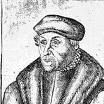
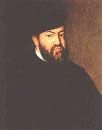
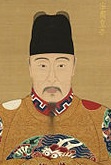


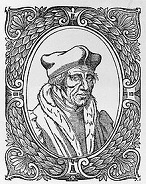

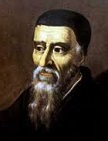
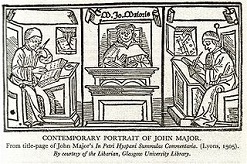


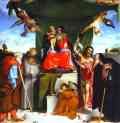
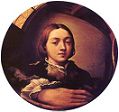
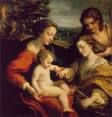

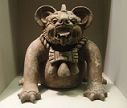
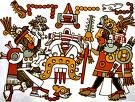
1521 Count to ten then lose your temper like a lion? On Jan. 3 after Martin Luther refuses to retract 41 of his 95 theses, Pope (since 1513) Leo X (1475-1521) issues the bull Decet Romanum Pontificem, excommunicating him; given safe passage by HRE Charles V, Luther travels to the Imperial Diet of Worms (sounds yummy?) (electors, princes and nobles, and town delegates) to argue his case, arriving on Apr. 16, triumphantly having his say, with the soundbyte: "Since Your Majesty and your lordships desire a simple reply, I will answer without horns and without teeth. Unless I am convicted by Scripture and plain reason, I do not accept the authority of popes and councils, for they have contradicted each other"; after being cross-examined by papal nuncio Cardinal Alexander, he leaves in one piece on Apr. 25, his safe conduct pass good for 21 days; on Apr. 26 after papal rep. (appointed cardinal in 1536) Girolamo (Hieronymous) (Jerome) Aleandro (Aleander) (1480-1542) leads the opposition to him, the Edict of Worms bans Luther and his writings from the Holy Roman Empire, prohibits all new doctrines, and declares Luther an outlaw that anybody can kill after May 14; a bull issued by Pope Leo X follows on June 16, amounting to a death warrant; in an edict to Netherlanders, the pope's man HRE Charles V states: "As it appears that the aforesaid Martin [Luther] is not a man, but a devil under the form of a man, and clothed in the dress of a priest, the better to bring the human race to hell and damnation, therefore all his disciples and converts are to be punished with death and forfeiture of all their goods"; on his way back to Germany Luther is "kidnapped" on May 4 under orders of his protector Elector Friedrich (Frederick) III the Wise (1463-1525) of Ernestine Saxony (whose brother John of Saxony is a Lutheran), and hidden in his castle at Wartburg for a year for safekeeping, pretending to be neutral but consenting to end worship of his 19K+ saints and relics in 1523, along with the Catholic mass; meanwhile Luther's more radical associate Andreas Rudolph Bodenstein von Karlstadt (Carlstadt) (Karolostadt) (AKA Brother Andrew) (1486-1541) continues the Reformation in Wittenberg in Luther's absence, pushing for complete separation from the Church, and showing just what unfettered Bible reading can do to a person brought up Catholic?; Luther's books are burned in Rome, and in retaliation the faculty and students at the U. of Wittenberg burn the papal constitutions, the canon law, and works of scholastic theology outside the Elster Gate; Luther adds the pope's excommunication bull to the burning heap; while in hiding Martin Luther translates the New Testament into his most unwormly German. On Feb. 28 after discovering the Northern Mariana Islands (Guam, Rota, Saipan, Tinian, Asuncion), and naming them "Ladrones" (Sp. "thieves") for the thievish practices of the native Chamorros, Magellan and his men reaching Guam ("land of sails", named for their lateen sails) and find supplies, then take off and sight the Philippine Islands; on Apr. 27 (dawn) Magellan is KIA in the Battle of Mactan with the islanders led by chief Lapu-Lapu before he can circumnavigate the globe; one of the three remaining ships is abandoned, and the last two set sail, with the Victoria commanded by Magellan's 2nd-in-command Juan Sebastian de Elcano (del Cano) (1476-1526), who changes Magellan's plan and sails W into the Indian Ocean, reaching the Spice Islands on Nov. 6 with 115 crew, sailing around the Cape of Good Hope on May 6, 1522 and limping home on Sept. 6, 1522 with 18 aboard, making a small net profit from their cargo of 26 tons of cloves and cinnamon. On Apr. 15 the College of Sorbonne in Paris formally condemns the teachings of Martin Luther. On Apr. 20 after a 16-year reign in which he overtaxed his people and let bandits flourish while he decimated his court officials for questioning his weird ways and got off on travelling around the country incognito, allowing court eunuchs to entrench themselves inextricably, emperor (since 1505) Ming Zhengde (b. 1491) dies after his pleasure boat capsizes, and on May 27 his 15-y.-o. cousin Zhu Houcong becomes Jiajing ("admirable tranquility") (1507-67), Ming emperor #11 (until Jan. 23, 1567), continuing the same. On Apr. 23 the uprising of the comuneros (municipalities) under Juan de Padilla is defeated in the Battle of Villalar, and Padilla and the other leaders are executed; royal absolutism settles into Spain for cents. in reaction. On May 17 Henry VIII's rival (leader of the disaffected nobles pissed-off at the way the court is run by low-born bums like Thomas Wolsey) Edward Stafford, 3rd Duke of Buckingham (b. 1478) is executed as a traitor, ending the line (until 1617) - putting a stevie nicks in it? On May 26 Hernan Cortes sieges Tenochtitlan, and on Aug. 13 he defeats the Aztecs after 80 days of starving the 250K pop. (a tactic unknown in their history?), reducing them to eating lizards and grass, capturing 800 women and children foraging at night for food, then taking the city street by street until the Aztecs, reeling from starvation, white man's measles and smallpox make their last stand at the stacked pyramid of Tlatelolco, sister city of Tenochtitlan to the N; the Aztec Empire (founded 1428) ends (7M-30M people torpedoed by a few hundred Satanists, er, Saints, er, Spaniards?), and the Spanish Empire in Am. begins with the forceful seizure of Mexico, which becomes known as New Spain (until 1821), with Cortes as viceroy #1 (until Dec. 24), followed by Cristobal (Cristóbal) de Tapia (until Dec. 30), followed by Cortes again (until Oct. 12, 1524) after Tapia clears him of misconduct; Cortez sees bison in Montezuma's menagerie; in 1524 Mexico City is founded on the razed ruins of Tenochititlan after the lake is filled-in by Aztec slaves; king #4 (since 1487) Cosijoeza (Cocijoeza) (-1529) of the nearby Zapotecs in SE Mexico hears of the Spanish V and decides to lay low to avoid the same fate, allying with the Mixtecs (Mixteca) in modern-day Oaxaca, Guerrero, and Puebla, but that doesn't stop the Spanish from attacking them next year, and subduing them by 1527, the Zapotec bat god and Mixtec jaguar god proving impotent against Spanish cannon, firesticks, and biological warfare. In May Spanish knight Ignatius Loyola (1491-1556) is badly wounded in the legs by a cannonball in a battle against the French at Pamplona (Pampeluna), and undergoes a religious conversion at home in the castle of Loyola in N Spain (after receiving the last sacraments and claiming to see the Blessed Virgin Mary carrying the Infant Christ in her arms?), then vowing to lead a life of absolute chastity and devotion to her (perhaps the cannonball smashed more than two legs?); in 1522-4 he writes Exercitiae (Spiritual Exercises), getting him in trouble with the Inquisition for mysticism - the Roman Catholics produce their answer to Luther? In July Juan Ponce de Leon (b. 1460) dies in Havana, Cuba, having failed to capitalize on his royal patent to colonize Fla., although he introduces cattle and swine, which run wild in the swamps; after his death rumors circulate that he was searching in Fla. for the Fountain of Youth - there weren't enough wealthy swine-chomping Jewish senior citizens yet? On Aug. 28 after King Hieronymus of Hungary pleads in vain for Western aid against the advancing Ottoman hordes, and Charles V is too busy with the pesky Lutherans, the French and other imperial matters, Belgrade, "the key to Hungary" is conquered by the Ottoman Empire under Sultan Suleiman I, who makes big plans for further penetration of the degenerate West, beginning with Hapsburg lands along the Danube River. In Sept. the French, who had been supporting the communeros with designs on Navarre invade it along with the Low Countries, beginning the Italian (Four Years') War (ends 1526), the first of ? wars between HRE Charles V and Francis I of France until 1559; the French take Pampeluna and Fontarabia, after which uncrowned HRE Charles V's imperial forces reverse them and attack N France, then are stopped in turn on Nov. 19 by Pierre Terrail, Chevalier (Signeur) de Bayard (1473-1524) in C France at the Siege of Mezieres (Mézières); Charles V allies with England and the pope (who needs him to fight Martin Luther and his German princes), while Francis I allies with Venice; meanwhile Francis I's lavish livestyle of several thousand civil and personal servants, retinue, entertainments, construction and military adventures causes France to incur its first nat. debt and borrow money. On Oct. 11 Pope Leo X declares English king Henry VIII the Defender of the Faith (Fidei Defensor) for his June pub. Assertio Septem Sacramentorum (Defense of the Seven Sacraments) refuting Martin Luther, becoming the #1 anti-Lutheran polemic of the cent., going through 20 eds.; meanwhile on Dec. 1 Leo X (b. 1475) dies of a winter chill (after writing sometime in his career "It has served us well, this myth of Christ"?), allowing Francesco Maria I della Rovere to recover his duchy of Urbino; Martin Luther replies to Henry VIII in 1522 with the book Against Henry, King of the English (Contra Henricum Regem Anglie), causing Thomas More to reply to him in 1523 with the book Responsio ad Lutherum; meanwhile Martin Luther takes advantage of this plus Charles V's military diversion to initiate public worship in Germany, with liturgy in vernacular German, and to preach along with Ulrich von Hutten against Jakob Fugger for lobbying the papacy to drop the age-old medieval prohibition against charging interest on loans - a rare natural death for a Medici? On Oct. 25 HRE Charles V bans wooden bldgs. in Amsterdam. On Nov. 20 the Arabs blame a lack of water in Jerusalem on the Jews making wine. Greeeen-acres is the place for me? On Dec. 13 king (since Oct. 25, 1495) Manuel I the Fortunate (b. 1469) dies, and his son Joao (John) III (the Pious) (the Grocer) (1502-57) becomes king #15 of Portugal (until June 11, 1557) at the height of its grate powah, piously establishing the Inquisition in 1536 and riding it over the hump to the start of its downward slope, going on to preside over the colonization of Brazil, abandoning Muslim territories in North Africa in favor of trade with India and investment in Eurpe, improving trade relations with England, Flanders, and the Baltic and Rhineland regions, while securing a monopoly over the spice trade (cloves and nutmeg) from the Maluku Islands, gaining then nickname "the Grocer King"; during his reign the Portuguese become the first Euros to make with China (Ming Dynasty) and Japan (Muromachi Period); despite unleashing the Inquisition, he supports humanists incl. poet-playwright Gil Vicente (1465-1536), mathematician Pedro Nunes (1502-78), and physician Garcia de Orta (d'Orta) (1501-68); when he dies the Portuguese empire has reached 4M sq. km. (1B acres). Scottish bishop Gavin Douglas is exiled to England. Gustavus I Vasa resists Danish rule, and captures Stockholm from the Danes. Poland grants Duke Albrecht I of Prussia a 4-year truce in its war with his Teutonic Order, and the dispute is referred to HRE Charles V, while Albrecht continues war preparations. HRE Charles V grants his Roman Catholic brother Ferdinand Hapsburg (later HRE Ferdinand I) possessions and rights in Austria, making him gov. of the duchy of Wurttemberg to check the spread of the pesky Reformation; Ferdinand marries Anne of Hungary, sister of Louis II of Bohemia and Hungary, and daughter of Ladislas II of Hungary and Bohemia, while Ladislas II of Hungary marries Mary of Austria. Thomas More is knighted. Ascanian prince Wolfgang of Anhalt-Kothen (Anhalt-Köthen) (1492-1566) meets Martin Luther at the Diet of Augsburg, claims that "He gained my heart", and goes Lutheran, introducing the Reformation in Anhalt-Kothen in 152, and Anhalt-Bernburg in 1526, becoming the 2nd and 3rd countries after the electorate of Saxony to officially adopt Protestantism. Bartolome de las Casas tries unsuccessfully to found a peaceful settlement for natives at Cumana (Cumaná) on the Venezuelan coast, becoming the first Spanish city in South Am. The Portuguese allied with Hormuz invade and seize Bahrain from Jabrid ruler Migrin ibn Zamil (-1521), who is KIA; the Portuguese rule Bahrian until 1602. French lawyer Bartholomew Chassene defends some rats that had destroyed a barley crop, arguing that "evilly disposed cats" owned by the prosecutors had intimidated them from appearing in court, and demanding a cash guarantee; when the prosecution refuses, the case is dismissed. Spanish slaver Francisco de Gordillo and his buddy Pedro de Quejo explore the E coast of Ga. as far N as S.C. in search of fresh meat. Silk manufacture is introduced to France. The College of Sarbonne in Paris condemns a book by reformer (humanist) Roman Catholic theologian Jacques Lefevre d'Etaples (Jacques Lefèvre d'Étaples) (1455-1536) rejecting the view of the Three Marys of the Gospels being the same person; in 1523 he pub. a French trans. of the New Testament, followed by the whole Bible in 1530, helping launch Protestantism and making a fan of William (Guillaume) (Guilhem) Farel (1489-1565), who becomes an evangelist and founds the Reformed Church in Switzerland; in 1525 the theology faculty of the U. of Paris forbids further translations of the Bible. Architecture: Chateau de Chenonceaux in the Loire Valley (begun 1513) is completed for royal tax collector Thomas Bohier; Francis I latches onto it in 1535. Science: Bologna surgery prof. Jacopo Berengario da Carpi pub. a Commentary on Mondino containing a number of anatomical discoveries, incl. the action of the cardiac valves, and the fact that the kidney is not simply a sieve; he coins the term "vas deferens". Nonfiction: Niccolo Machiavelli (1469-1527), Dell' Arte Della Guerra. John Major (1467-1550), Historia Majoris Britanniae, tam Angliae quam Scotiae (Paris); De Gestis Scotorum (Paris); first major history of Scotland since Andrew of Wyntoun (1350-1425); written in Latin. Philip Melanchthon (1497-1560), Loci Communes; pro-Lutheran. Piri Reis (1465-1554), Book of the Sea (Kitab-i Bahriye). Art: Lorenzo Lotto (1480-1556), Madonna and Child with Saints; Christ Leaving His Mother in the Temple; San Bernardino Altarpiece. Il Parmigianino (1503-40), The Mystic Marriage of St. Catherine and Christ; the work of an 18-y.-o. kid? Palma Vecchio (1480-1528), Adoration. Births: German Lutheran Albertine Wettin duke of Saxony (1541-7) and elector of Saxony (1547-53) Maurice (Moritz) I (d. 1553) on Mar. 21 in Freiberg; eldest son of Henry IV the Pious (1473-1541) and Katharina of Mecklenburg; elder brother of Augustus I (1526-86); cousin of Elector John Frederick I (1503-54). German Counter-Reformation Jesuit theologian ("the Second Apostle of Germany") (St.) Peter Canisius (Pieter de Hondt) (d. 1597) on May 8 in Nimwegen, Netherlands; first German to join the Jesuits (1543); canonized in 1925; feast day: Apr. 25. Italian duke of Parma and Piacenza #2 (1556-86) Ottavio Farnese (d. 1586) on Oct. 9 in Valentano; 2nd son of Pier-Luigi Farnese; grandson of Pope Paul III; brother of Cardinal Ranuccio Farnese (1530-65). Japanese warlord (daimyo) Takeda Shingen (d. 1573) on Dec. 1 in Kai Province. English queen consort (1540-1) Catherine Howard (d. 1542) (b. 1523?) in Lambeth, London; granddaughter of Thomas Howard, 2nd duke of Norfolk, who is poor, causing her to be raised by her grandmother the duchess of Norfolk. English rebel Sir Thomas Wyatt the Younger (d. 1554) in Chatham, Kent; son of Sir Thomas Wyatt (1503-42) father of the English sonnet. French La Pleiade poet-priest (bishop of Chalon-sur-Saone in 1578-94) Pontus de Tyard (Thyard) (Thiard) (d. 1605) in Bissy-sur-Fley, Burgundy; supporter of Henry III against the House of Guise. Deaths: Dutch composer Josquin des Pres (b. 1445) on Aug. 27 in Conde; composed 20+ masses. French-Flemish composer Josquin de Prez (b. 1450) on Aug. 27 in Conde-sur-l'Escaut (near Lille). German "Ship of Fools" author Sebastian Brant (b. 1457). English viceroy Sir Edward Poynings (b. 1459). Spanish explorer Ponce de Leon (b. 1460) in July in Havana. Florentine painter Piero di Cosimo (b. 1462). Portuguese king (1495-1521) Manuel I the Fortunate (b. 1469) on Dec. 13 in Lisbon. Italian pope (1513-21) Leo X Medici (b. 1475) on Dec. 1 in Rome. English traitor Edward Stafford, 3rd duke of Buckingham (b. 1478) (executed). Portuguese explorer-writer Duarte Barbosa (b. 1480) on May 1 in Cebu, Philippines; dies at the feast of Rajah Humabon; leaves The Book of Duarte Barbosa (1516?), an early example of Portuguese travel lit. Portuguese explorer Ferdinand Magellan (b. 1480) on Apr. 27 in the Philippines; KIA with natives. Chinese Ming emperor #10 (1505-21) Zheng De (b. 1491) on Apr. 20.





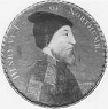




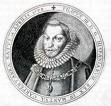
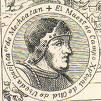
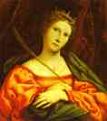
1522 On Jan. 9 Adrian Florensz Boeyens Dedel of Utrecht, inquisitor (regent) of Spain and HRE Charles V's Catholic tutor is elected Pope (#218) Adrian (Hadrian) VI (1459-1523), becoming the last "barbarian pontiff" (retaining his baptismal name); all popes will be Italian after this until Polish-as-a-pickle John Paul II (1978); he proceeds to try to reform the unreformable, and is hampered by a bout of plague hitting Rome, getting it himself. On Feb. 7 the Treaty of Brussels is signed by HRE Charles V, splitting the Hapsburgs into Spanish and Austrian branches, and granting his brother Ferdinand yet more possessions in SW Germany and the Tirol. On Mar. 22 Henry VIII makes "Red" Piers Butler, 8th Earl of Ormonde (1467-1539) (cousin of Thomas Butler, 7th earl of Ormonde, who died childless in 1515, after which he seized the estates) his lord lt. of Ireland (until May 13, 1524); after up-and-coming Thomas Boleyn pulls strings, the king makes him give him his earldom in Feb. 1528 in return for being made earl of Ossory, and when the Boleyns fall he gets it back in Feb. 1538. On Apr. 2 Swiss ex-Catholic priest Ulrich Zwingli, past of the Great Church of Zurich celebrates his new freedom by reaching for the sky and marrying widow Anna Reinhard (1487-1538), with whom he had been living openly; too bad, his followers get arrested for taking his advice and eating meat during Lent, but he vigorously defends them, getting them off with a slap on the salami, which pisses off Pope Adrian VI, who bans him from the pulpit and asks the Zurich council to repudiate him as a heretic, esp. for calling on the bishop of Constance to allow allow priests to marry. On Apr. 24 Sir Thomas Boleyn (1477-1539), husband of Elizabeth Howard (1486-1539), daughter of Thomas Howard, 2nd duke of Norfolk becomes treasurer of the king's household; about the same time his raven-haired daughter Anne Boleyn (1507-36) (who returned from the French court in 1521 to become Catherine of Aragon's lady-in-waiting) has a short fling with Henry Algernon Percy (1502-37), heir to the earldom of Northumblerland, but after her secret admirer Henry VIII sends him an offer he can't refuse, Percy gets the message and marries somebody else; meanwhile her sister Mary Boleyn (1499-1543) vies for Henry's affections, but by next year he falls head over heels for Anne, beginning the "King's Affair", enjoying kissing her pretty duckies, meanwhile discovering in a fractured reading of the Bible book of Leviticus (Ch. 18) that "If a man shall take his brother's wife... he hath uncovered his brother's nakedness; they shall be childless", which he uses to justify the "great matter" of dumping his 40-y.-o. wife Catherine of Aragon, who never gave him a male heir, although she did give him a female child, Henry VIII's bloody Bible-damned Roman Catholic daughter Mary Tudor (1516-58), who is sent to live in Wales, the traditional home of the heir to the English throne (don't say prince of Wales). On May 6 uncrowned HRE Charles V visits Henry VIII, and on June 19 they sign the Treaty of Windsor, both agreeing to invade France; Charles returns on July 6, and on Aug. 27 with the help of Florence, Mantua and the papacy defeats the forces of Francis I at the Battle of the Biacocca, expelling the French from Milan and Lombardy; imperial troops then restore the Sforza and capture Genoa, causing pissed-off Genoese soldier of fortune Andrea Doria (1468-1560) to enter the service of Francis I to help restore French rule, fighting the fleet of Charles V (until 1528); HRE Charles IV makes Massimiliano's brother Francesco Maria Sforza (Francesco II Sforza) (1495-1535) ruler of Milan. In the summer 200K Ottomans with 400 ships under Suleiman I the Magnificent take the Dodecanese, and siege the Hospitaler stronghold of Rhodes, held by the Knights of Rhodes (St. John) (Hospitalers) since 1309, tunneling under the walls and setting off explosions until they could take the city with hand-to-hand fighting, but only after Venetian engineer Tadini (Tadino) holds them off for months with clever subterranean alarms; the Knights of Rhodes surrender on Christmas Eve (Dec. 21?), and are granted safe passage to look for a new home, ending up in Malta in 1530, whose walls are built on stone that can't be undermined, with the remaining citizens given exemption from conscription and taxation for five years, and Tadini (who was shot in the eye, keeping him from scaling the walls to see the best way to bombard the enemy, helping them win) allowed to leave;, going to Genoa to fight the invading Turks a 2nd time, losing again; the Turks control the Dodecanese until 1912. On Sept. 6 the first circumnavigation of the Earth (not circumcision?) is completed by the remnant of Magellan's crew under Juan Sebastian de Elcano (del Cano) (1476-1526) in the Vittorio; only 18 of the original 237 Europeans who set out in 1519 return (along with 3-4 Indonesians), bringing plumes from the Bird of Paradise of bird-shaped New Guinea; the spice cargo barely pays the expenses; Charles I presents de Elcano with a coat of arms containing a globe and the legend "You Went Around Me First"; later 17 more men arrive in Spain, incl. 12 captured by the Portuguese in Cape Verde, and five survivors of the Trinidad between 1525-7. On Oct. 15 HRE Charles V names Hernando Cortes as gov. and capt-gen. of New Spain (Mexico), and he gets right to work enslaving the garbage people, er, natives and distributing them to encomiendas (slave plantations) run by his men. The Fourth Russian-Lithuanian War (begun 1512) ends with Lithuania ceding about a quarter of its Ruthenian possessions to Russia, incl. Smolensk, with the Dnieper River established as their new border. Duke William IV of Bavaria-Munich, who had started out sympathetic to the Reformation then flip-flopped issues Bavaria's first religious edict, banning promulgation of Luther's works. The Knights' War (Revolt) (Poor Barons' Rebellion) (ends May 7, 1523) begins in SW Germany when the Protestant imperial princes, led by "the Last Knight" Franz von Sickingen (1481-1523) and "Humanist Knight" Ulrich von Hutten (1488-1523) form a fraternal assoc. in Franconia and the Rhineland against the bishops of Bamberg and Wurzburg and papal influence in Germany in favor of unification of all German-speaking lands, secularization of all church principalities and estates, and establishment of a "nobleman's democracy headed by a monarch", then attack the lands of the archbishop of Trier; they try to use Martin Luther's name but he declines, then in the fall unsuccessfully siege the archiepiscopal city of Trier, run by archbishop Richard Greiffenklau for seven days before running out of gunpowder, and retreat to Ebernberg, and Sickingen has a ban placed on him on Oct. 22 by the imperial regency council - they can't be a Toys R' Us kid anymore? HRE Charles V doesn't take any chances and introduces the Spanish Inquisition to the Netherlands - I like to chill? The First Diet of Nuremberg is visited by Duke Albrecht I of Prussia, who uses the photo opp to lobby for allies in his war against the Poles; too bad for the whole Holy Roman Empire, he meets Lutheran rock-me-through-the-night theologian Andreas Osiander (1498-1552), who gets converted to Protestantism and then converts him, causing Albrecht to travel to Wittenberg to meet Martin Luther, who advises him to junk the Teutonic Order, get married (to a woman instead of his hand?), and convert Prussia into a hereditary Protestant duchy; he goes for it, getting the Teutonic Knights to secularize, repudiate allegiance to Rome, and throw their support behind Luther, but he has to play cagey with Pope Adrian VI at first, pretending he's actually trying to punish knights himself who convert to Protestantism, while having Luther send carpetbagging missionaries all over Prussia to prepare the way by doing the converting? After the O'Neill clan led by Conn O'Neill ally with Munster and Connacht along with the MacDonnells of Antrim and English and devastate Tyrconnell, taking the castle of Ballyshannon, the Battle of Knockavoe (Cnoc-Buidhbh) near Knockavoe (near Strabane), County Tyrone, Ireland sees the O'Donnell clan led by Hugh Dubh O'Donnell (-1618) and his older brother Manus O'Donnell (sons of Sir Hugh Dubh O'Donnell) stage a surprise night attack on the camp of the O'Neills, killing 900 and taking an immense booty. Cortes strikes N from Mexico City and subdues the Panuco (Pánuco) River region; meanwhile Cortes' Zaragoza-born lt. Cristobal de Olid (1492-1524) strikes S from Mexico City and subdues Colima (Nahuatl "colli" + "maitl" = "ancestors or gods" + "domain of") and part of Jalisco (Nahuatl "sandy plain"); meanwhile Spaniards settle in Michoacan (Nahuatal "place of the fishermen") after the Tarascan (Purepecha) pop. allies with Cortes (1522-4); the Tarascans are later rewarded with craft-oriented villages (wood, copper, cloth, clay). Cortes' lt. Pedro de Alvarado subdues Tehuantepec. The first of many large scale slave revolts (11 in the next 31 years) is crushed in Hispaniola. Gil Gonzalez Davila (Dávila) (de Avila) (-1543) and Andres Nino (Niño) (-1532) begin a combined land-sea expedition W from the Isthmus of Panama; Davila conquers the area around the Gulf of Nicoya and Lake Nicaragua, while Nino discovers the Gulf of Fonseca (Ampala), AKA the Bay of Conchagua (fronting El Salvador, Honduras, and Nicaragua), in which the island of Ampala, the Pacific port of Honduras is later located. Pascual de Andagoya (1495-1548) leads a land expedition from Panama, and becomes the first Spaniard to set foot in Biru (Peru), where he learns of the fabled rich and powerful Inca Empire, but ill health forces him to return. Francisco Montana ascends Mt. Popocatepetl (Aztec "smoking mountain") in Mexico. The Portuguese arrive in Madras, India, and built the port of Sao Tome, named after St. Thomas, whom they believe preached in the area in 52-70 C.E. Gustavus I Vasa becomes admin. (regent) of Sweden, and pledges to free it from Danish control. The town of Ruzhinoy (Ruzhany) on the Ruzhanka River in Belarus (27 mi. NE of Pruzhany) is first mentioned, becoming the home of Israeli PM Yitzhak Shamir and other famous Jews. Michele de Nostredame (Nostradamus) begins studying medicine in Montpellier, France, obtaining a bachelor's degree in 1525, getting a medical license and going out into the countryside to help plague victims. Timurid miniature painter Bihzad (Behzad) of Herat, is brought by Shah Isma'il from Herat to Tabriz, and appointed dir. of the royal library, where he founds an artistic school known for fine Persian ms. illustrations - all them pinks and blues and gold backgrounds? Two Christian brothers in Ottoman Egypt, Kyrmidoles and Gabriel are taken to the emir by an angry Muslim mob, ordered to convert to Islam, and then killed after they refuse. Inventions: German painter Albrecht Durer (1471-1528) designs a flying machine for use in war - you drive? Nonfiction: Alessandro Alessandri (1461-1523), Dies Geniales; a nonsequential encyclopedia. Hector Boece (1465-1536), Lives of the Bishops of Murtlack and Aberdeen. Jacopo Berengario da Carpi (1460-1530), Isagogae Breves; replaces the work of his teacher Mondino de Liuzzi. Cardinal Francisco Jimenez de Cisneros (1436-1517) (ed.), The Complutensian Polyglot Bible; first printed polyglot of the entire Bible, with parallel columns in Hebrew, Greek, Latin, and Aramaic; a whopping 600 copies are printed, 123 of which survive to modern times. Martin Luther (1483-1546), German Trans. of the New Testament; "a Bible for the masses"; he returns to Wittenberg, where printer Hans Lufft (1495-1584) prints 100K copies in the next 40 years; the complete Bible with the Old Testament is pub. in 1534; he also pub. Ennarationes Epistolarum et Evangeliorum quas Postillas Vocant Postils (Christmas Postils). Johannes Trithemius (1462-1516), De Septem Secundeis (On the Seven Secondary Spirits Moving the Orbs); German Benedictine ' monk predicts the future to the year 1789. Art: Lorenzo Lotto (1480-1556), St. Catherine - no Parmigianino - but it's not bad for the kids' room? Francesco Parmigianino (1503-40), Frescoes in the Palma Cathedral. Tilman Riemenschneider (1460-1531), Tomb of Archbishop Lorenz (Warzburg Cathedral). Titian (1477-1576), Duke Alfonso I d'Este; The Resurrection Altar. Poetry: Henry VIII (1491-1547), Green Groweth the Holly; Mexicans hearing Anglos singing it in the 1800s began calling them "gringos"? John Skelton (1460-1529), Colin Clout; Why Come Yet Not to Courte?; clerical satires against Cardinal Wolsey. Births: French duke Charles d'Angouleme, Duke of Orleans (d. 1545) on Jan. 22; 3rd (favorite) son of Francis I and Claude de France (daughter of Louis XII). German Franconian Hohenzollern margrave of Brandenburg-Kulmbach (1527-53) Albert II Alcibiades (the Warlike) (d. 1557)K on Mar. 28 in Ansbach. Italian naturalist ("Father of Natural History Studies") Ulisse (Ulissi) (Ulysses) Aldrovandi (d. 1605) (AKA Aldrovandus) on Sept. 11 in Bologna; prof. of natural history at the U. of Bologna; writes the first book on fishes that doesn't lump them with other aquatic forms; founder of the first botanical garden in Europe (Bologna). Dutch (Flemish) statesman-gen. Lamoral, Count of Egmont, Prince of Gavre (d. 1568) on Nov. 18 in Hainault. French gov. of the Netherlands (1559-67) duchess Margaret of Parma (d. 1586) on Dec. 28; illegitimate daughter of HRE Charles V and a Fleming mother; wife of Duke Ottavio Farnese of Parma; mother of Alexander Farnese (1545-92). Spanish duchess of Florence (1539-62) and breed mare Eleanor of Toledo (Leonor Alvarez de Toledy y Osorio) (d. 1562) in Alba de Tormes, Salamanca; wife of Cosimo I de'Medici; the first modern lady-consort; mother of Maria de'Medici, Grand Duke Francesco I of Tuscany, Duchess Isabella of Bracciano, Cardinal Giovanni de'Medici, Duchess Lucrezia of Modena, Pietro de'Medici, Garzia de'Medici, Grand Duke Ferdinando I of Tuscany, Anna de'Medici, and Pietro de'Medici. Italian mathematician Ferrari (d. 1565). Dutch (Walloon) "Belgic Confession" Calvinist theologian Guido de Bres (Bray) (d. 1567) in Mons (modern-day Belgium); starts out as a glass painter. Flemish (Dutch) painter Pieter "Peasant" Brueghel the Elder (d. 1569); father of Pieter "Hell" Brueghel the Younger (1564-1638) and Jan "Velvet" Brueghel the Elder (1568-1625). Italian painter Bernardino Campi (d. 1590) in Cremona; studies with Giulio Campi and imitates Titian's style. Dutch poet-dramatist-writer Dirck (Dirk) Volkertszoon Coornhert (d. 1590) in Amsterdam. French humanist jurist Jacques (de) Cujas (Cujacius) (d. 1590) in Toulouse. French painter Jean Cousin (d. 1594). English humanist mathematician-writer Thomas Blundeville (d. 1606) in Newton Flotman, Norfolk; educated at Gresham College. Bolognese painter Lavinia Fontana (d. 1614). Deaths: Spanish scholar Antonio de Nebrija (b. 1444). Italian sculptor-architect Giovanni Antonio Amadeo (b. 1447) on Aug. 27/28 in Milan. German humanist scholar Johann Reuchlin (b. 1455) on June 30; excommunicated by Pope Leo X in 1520. English patriarch Sir John Spencer (b. 1455) on Apr. 14. French regent Anne of Beaujeu (b. 1461) - Angelina Jolie 500 years ahead? English playwright Henry Medwall (b. 1462). Spanish gen. Ramon de Cardona (b. 1467) on Mar. 10 in Naples, Italy; a Renaissance cenotaph is built for him in his hometown of Bellpuig. English grammarian William Lilye (b. 1468) on Feb. 25 in London (plague). Italian scholar Cosentius (b. 1470). Scottish poet and bishop of Dunkeld Gavin Douglas (b. 1476) of the plague while in exile in England.

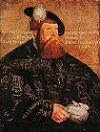




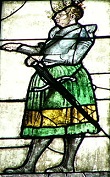
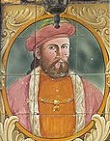
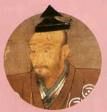

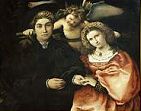
1523 On Jan. 1 the Hospitalers are allowed by the Ottomans to leave Rhodes. In Jan. Ulrich Zwingli (1484-1531) appears before the Great Council of Zurich to defend himself against charges of heresy, and he soapboxes bigtime and slams Church dogmas, image, relic, and saint worship, clerical celibacy, and the Mass; the Great Council is impressed, and withdraws the canton of Zurich from the jurisdiction of the bishop of Constance, and confirms its previous ban against preaching not founded on the Bible, which amounts to an official adoption of the Protestant Reformation; Zwingli goes on to turn Zurich into a theocracy ruled by him and a Christian magistrate, converting monasteries into hospitals, and eliminating Catholic Mass and confession, teaching that true Christians don't need some turkey and some mistletoe, er, the pope and the Roman Catholic Church? In the spring Franz von Sickingen (b. 1481) plunders Kaiserslauten, causing the rulers of Trier, Hesse, and the Palatinate, with help from the Swabian League to march on Landstuhl, sieging him in his castle, which he had thought impregnable until artillery are used (one of the first times in Euro history); on May 6 he is mortally wounded, and croaks on May 7, after which his castle is razed, ending the Knights' War (begun 1522), along with the power of German knighthood, after which most of the rebellion's supporters have their castles confiscated, causing the bankrupt knights to overtax their peasants, and all to quit paying church tithes, fomenting the Peasants' Revolt next year; meanwhile Ulrich von Hutten goes to Zurich to meet with Zwingli, then to Basel to try to talk Erasmus of Rotterdam to side with the Reformation, but he refuses to see him, and he dies of his 15-y.-o. syphilis on Ufenau Isle on Lake Zurich on Aug. 29. On June 6 after the Danes surrender, Gustav (Gustavus) I Eriksson Vasa (Wasa) (1496-1560) is elected king of Sweden (until Sept. 29, 1560), establishing the Vasa Dynasty (ends 1672), which takes Sweden and Finland (a province of Sweden) Lutheran; Christian II of Denmark is deposed and exiled by his nobles, and his uncle the duke of Schleswig-Holstein becomes Frederick I (1471-1533) of Denmark and Norway (until Apr 10, 1533); he never visits Denmark or learns to speak Danish, and is never actually crowned king of Norway although elected? The pope who excommunicates Henry VIII very clemently is VII instead of VIII? On Sept. 14 Pope (since 1522) Adrian VI (b. 1459) dies, and on Nov. 19 Giulio de' Medici, nephew of Lorenzo II de' Medici is elected Pope (#219) Clement VII (1478-1534), known for wearing a beard - now that the Roman Church is under attack, the Man better be a good ole billy-bob-boy from back home? Russia annexes Novgorod-Seversk (Novhorod-Siverskyi). Thomas More becomes speaker of the English House of Commons; low-born Thomas Cromwell (1485-1540), former soldier in the French army who returned to England around 1510 to become a moneylender and ended up as the confidential business mgr. of Cardinal Wolsey gets the latter's help to become an MP, beginning his rise. Duke Charles of Bourbon, tired of Francis I's attempt to claim Bourbon from him, and incurring the enmity of Francis' mother Louise of Savoy, flees the country, and next year renounces France and joins up with HRE Charles V, making a private alliance with him and Henry VIII of England to conquer and partition France; either before or after that, he is deprived of his estates and perquisites as constable of France; the province of Bourbonnais is annexed to the crown (until 1661). Wurtenburg goes Lutheran, as does Strasbourg, France, known for its pate de foie gras; Martin Luther returns to Wittenberg and introduces public worship with liturgy and communion in German in Electoral Saxony and Hesse; meanwhile the diversion of the HRE by his war with France allows the Protestant movement to spread fast. Mori Motonari (1497-1571) becomes head of the Mori clan in Japan. Jewish mystery man (a swarthy dwarf in Oriental costume with Messianic claims) David Reubeni (Reuveni) (1490-1541) visits Jerusalem, claiming to be the Messiah, a prince of a remote Jewish kingdom that is the home of the 10 lost tribes of Israel, claiming he came to remove a stone from a pagan temple placed into the Western Wall of the Temple Mount by rebel Jeroboam during the reign of King Solomon, not realizing that the wall was built by Herod the Great, causing Jews to jeer him until he leaves, after which he turns up in Italy claiming to be King David; in Nov. 1525 after presenting a letter of recommendation from Pope Clement VI, he meets with King John III the Pious of Portugal in Almeirim, claiming that he is the son of dead King Suleiman of Habor, which has 300K Israelite subjects, seeking an alliance between Christians and Jews against the Muslims, which he finds hard to stomach since he is busy persecuting suspected Marranos (fake Jewish converts to Roman Catholicism), but agrees to grant him eight ships with 4K cannon; too bad, 5 mo. later after some conversos stage a revolt near Badajoz, the king asks him to leave his kingdom, and he heads for the papal court in Avignon, followed by Bologna then Ratisbon (Regensburg), where he is put in chains and taken to HRE Charles V in Mantua, who hands him over to the Inquisition for extra crispy. HRE Charles V makes Ferdinand II of Aragon's widow Germaine de Foix and her new hubby (since 1519) margrave Johann of Brandenburg-Ansbach (1493-1525) joint viceroys of Valencia, who bring Castilian Spanish with them, downgrading the local Catalan dialect; she goes on to end the Revolt of the Brotherhoods (begun 1519), signing 100 death warrants, with 700 more executions performed; in Dec. 1524 she signs a gen. pardon but imposes big fines; on July 5, 1525 Johann dies, and Germaine marries Neapolitan prince Ferdinand, Duke of Calabria (1488-1550). Portuguese settlers are expelled from China. Pedro de Alvarado conquers the Mayan Quiche (Quiché) tribe, based in the fortified city of Utatlan, along with the Cakchiquel (Kaqchikel) tribe in Guatemala. The Indians in the Panuco River region in N Mexico revolt, and are suppressed by Cortes' lt.; Cortes' men begin the subjugation of Chiapas (ends 1528). Gil Gonzalez Davila obtains a license to continue his exploration, and returns to Central Am. by way of Honduras. Portuguese sailor Simao de Abreu discovers Celebes (Sulawesi) in the Greater Sunda Islands in Indonesia E of Borneo, followed in 1525 by Gomes de Sequira; a base is established in Makassar, which is taken by the Dutch in 1665 after arriving in 1605. Ignatius Loyola vists the holy sites of Jerusalem, but finds them too dangerous to stay long, so he returns to Barcelona to pursue a univ. education. Sugar is first grown in Cuba. By this year four out of every five books pub. in Germany are pro-Reformation. Inventions: The first marine insurance policies are issued in Florence. Nonfiction: Jean Froissart (1337-1410), Chronicles, Part One; trans. by John Bourchier, Lord Berners; covers the years 1322-1400 (first half of the Hundred Years' War). Anthony Fitzherbert, Book of Husbandry; first English manual of agriculture. Hans Judenkunig of Vienna (1450-1526), Manual of Lute Playing (first ever). Art: Albrecht Durer (1471-1528), An Unknown Man; Hans Imhof. Lorenzo Lotto (1480-1556), Master Marsilio and His Wife; Miracles of St. Clare of Assisi. Il Perugino (1446-1523), The Adoration of the Shepherds. Veit Stoss (1445-1533), Altar of Maria (Bamberg Cathedral). Titian (1477-1576), St. Christopher Carrying the Infant Christ (Doge's Palace, Venice); Entombment of Christ. Poetry: Hans Sachs (1494-1576), Die Wittenbergische Nachtigall; pro-Luther verse allegory. John Skelton (1460-1529), A Goodly Garland, or Chapelet of Laurell. Births: French king (1589-90) cardinal (1548-) Charles X of Bourbon (d. 1590) on Sept. 22 in La-Ferte-sous-Jouarre, Seine-et-Marne; 8th child of Charles IV de Bourbon and Francoise d'Alencon. Italian anatomist Gabriello Fallopio (Fallopius) (d. 1562) in Modena; pupil of Vesalius; discoverer of the Fallopian tubes and the semicircular canals of the ear, and namer of choice body parts incl. the vagina, placenta, and clitoris; leaves the study for the priesthood at Modena to study medicine. English statesman Sir Walter Mildmay (d. 1589) in Moulsham, Essex; son of Thomas Mildmay of Chelmsford (1515-66); educated at Christ's College, Cambridge U.; chancellor of the exchequer (1566-89). Deaths: Italian painter Luca Signorelli (b. 1441). German artist Thomas Burgkmair (b. 1444). Italian painter Il Perugino (Pietro Vannucci) (b. 1446). Italian wood engraver Ugo da Carpi (b. 1455). French artist Gerard David (b. 1460). German sculptor Adolf Daucher (b. 1460). Italian scholar Alessandro Alessandri (b. 1461). Chinese artist Tang Yin (b. 1470). German knight Franz von Sickingen (b. 1481) on May 7 in Landstuhl (KIA). German humanist Ulrich von Hutten (b. 1488) on Aug. 29 in Ulfenau Island, Lake Zurich (syphilis).


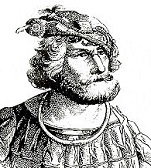



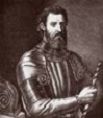


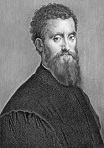

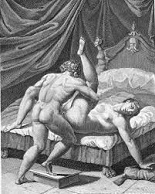

1524 On Jan. 1 20K abandon their homes in London after Bible Millennium Fever prophets use a 1499 pub. of a Tubingen, Germany mathematician about a planetary alignment to predict a flood which never happens; another prophet predicts Feb. 20 based on another planetary alignment in the constellation Pisces, but it's a no-show also. The Great German Peasants' Revolt (War) (ends May 15, 1525) against their lords in Thuringia (Swabia and Franconia in S Germany), led by Thomas Muntzer (Müntzer) (Munzer) (1489-1525), Florian Geyer of Giebelstadt (1490-1525), and Michael Gaismair (1490-1532) begins, fueled by the writings of Martin Luther (1483-1546), who thinks that if he can take on the pope and Church he can also challenge the socioeconomic inequalities of German feudalism, and pub. the Twelve Articles; too bad, he soon turns against them, and pub. the virulent pamphlet Against the Murdering and Thieving Hordes of Peasants, calling for their extermination, and looses on them landgrave Philip I the Magnanimous of Hesse (1504-67), who met Luther at the 1521 Diet of Worms then went Lutheran this year after a personal meeting with Philipp Melanchthon (no wonder that the Communists later decide to junk all of Christianity?); meanwhile (well-named?) German bookbinder Hans Nut (-1527) predicts the Second Coming of Christ exactly 3.5 years after the start of the Peasant's Revolt, which will be the start of 1K years of free food, love, and sex, then claims that he is the Messiah and gathers a following; too bad, he is killed during a prison escape in 1527. On Mar. 10 Henry VIII has a jousting accident which causes him to start leading a sedentary life without giving up his hearty eating habits - it's that lower belly fat that's a killer? On Mar. 1 Italian Florentine explorer (sailing under the French flag) Giovanni da Verrazano (Verrazzano) (1485-1527), sent by Francis I of France to explore the North Am. coast between Fla. and Newfoundland in hopes of finding a passage to the Pacific Ocean lands near Cape Fear, N.C.; on Apr. 17 after sailing S along the S.C. coast, turning N, discovering the Outer Banks of N.C. (thinking that it splits North Am. in two with the "Sea of Verrazano"), then missing Chesapeake Bay and the Delaware River, he discovers the mouth of the Hudson River and New York Bay, and anchors in the Narrows of New York Harbor between Staten Island and Long Island (home of the Manhasset, Shinnecock, Patchogue, and Montauk Indians), where a party of Lenape arrive in a canoe "clad with fowl feathers of diverse feathers. They came towards us very cheerfully, making great shouts of admiration, showing us where we might come to land most safely with our boat"; thinking that the Hudson River is a freshwater lake, he follows the S coast of Long Island past Block Island Sound, then records an island about the size of Rhodes (Rhode Island in Narragansett Bay near modern-day Newport?), where he meets "two kings more beautiful in form and stature than can possibly be described" (Massasoit's great-grandfather?); he then heads to the coast of Maine, then Nova Scotia and Newfoundland, then back to France - the first wop-dago in New York Harbor, and in a stolen vehicle? On Apr. 9 Vasco da Gama begins his Third Voyage to India, and dies in Cochin, India on Dec. 24. On May 13-14 Gov. Hernan Cortes of New Spain receives the Twelve Apostles of Mexico, Franciscan missionaries who begin mass Christianization of their captive audience - bam, and the dirt is gone? On May 23 Shah Ismail I (b. 1487) dies in Tabriz, and his 10-y.-o. son Tahmasp I (1514-76) becomes Safavid shah of Persia (until 1576), letting the pesky Qizilbash Turkoman tribeman run riot until he can attain the age of majority and put them in their place. On Sept. 1 the Treaty of Malmo (Malmö) is signed by Denmark, confirming the independence of Sweden under Gustavus I. In Aug. after the French under Protestant soldier Gideon Bonnivert invade Italy, and turncoat Frenchman Duke Charles of Bourbon helps HRE Charles V drive them out of Italy, leading the imperial army into Provence, they unsuccessfully siege Marseille; meanwhile Chevalier de Bayard (b. 1473) is mortally wounded, and dies on Apr. 30 in Romagnano Sesia, Italy. The Protestant princes of Germany get together at Ulm and take on HRE Charles V, causing his younger brother Ferdinand of Austria (to whom he entrusted the govt. of Germany in 1522) to form an alliance with the two dukes of Bavaria (William IV and Louis X) and the bishops of S Germany to stop the Satanic Protestant Reformation, which the Bavarian dukes have been suppressing since 1522; older duke William IV becomes a main leader of the Counter-Reformation, but since his younger brother Louis X claims the throne of Bohemia, he opposes the Hapsburgs (until 1534). The Second Diet of Nuremberg convenes to contine the work of the First Diet of 1522; the League of Catholic Princes is formed in Ratisbon. Sir Thomas Howard, 2nd duke of Norfolk dies, and his son Sir Thomas Howard becomes the 3rd duke of Norfolk, going on to become the #1 peer in England, picking the winning side in the Henry VIII divorce fight; his 7-y.-o. son Henry Howard (1516-47) (1st cousin of Anne Boleyn and Catherine Howard) becomes earl of Surrey, going on to receive a classical ed. in the English and French courts and becoming a poet and sonnet lover. Pedro de Alvarado founds the city of Guatemala City (modern-day pop. 2.9M) at the base of the Volcan del Agua ("Volcano of Water") (a volcano with a water-filled crater) in Valle de la Ermita (Hermitage Valley) as the capital of the Spanish capt.-generalcy of Guatemala, which incl. most of Central Am.; it becomes the capital of Guatemala in 1776. Panama gov. Pedro Arias de Avila sends Francisco Hernandez de Cordoba (Córdoba) (1475-1526) to conquer Nicaragua, with help from Hernan Cortes and Hernan Ponce de Leon, and he founds Granada in Nicaragua (first Euro city in Central Am.), followed by Leon. Cortes sends Cristobal de Olid to conquer and settle Honduras, but he goes rebel and is killed by one of Cortes' lts.; Cortes then personally leads an expedition and founds Trujillo,_Honduras on Trujillo Bay in NE Honduras before returning to Mexico City. Would-be conquistador stud of all time, middle-aged, illiterate but cagey Francisco Pizarro (1471-1541) under Avila's authority leads the first of two expeditions, along with Panama resident (since 1514) Diego de Almagro the Elder (1475-1538) to explore the Pacific coast S of Panama, which is rumored to contain gold (ends 1525). At the direction of HRE Charles V, Spanish scholar-diplomat count palatine Peter Martyr d'Anghiera (1457-1526) is made abbot of Jamaica by Pope Clement VII, and orders the construction of the first stone church there, although he never visits it. South Am. turkey is served for the first time at the English court - too much dark meat? Architecture: Square 28m-long 3-story Chateau d'If on If Island 1 mi. offshore in the Bay of Marseille is begun by Francis I (finished 1531) after a 1516 visit, pissing-off Marseille, whose 1481 annexation deal gave them the right to provide for their own defense. Nonfiction: Petrus Apianus (1495-1552), Cosmographicus Liber; work on astronomy and navigation that becomes popular throughout Europe until the end of the cent., and makes him a favorite of HRE Charles V, who showers him with titles and gold. Pope Clement VII (1478-1534), Poison Trials on Condemned Criminals; poison trials conducted on three condemned criminals, touting the antidote oil of Gregorio Caravita. Piston-pumping porno is born in Romo? I Sedici Modi (The 16 Sexual Positions) is pub. by Raphael's chief pupil Giuliano Romano (1492-1546), with engravings by Marcantonio Raimondi (1475-1534); Pietro Aretino (1492-1556) writes 16 Sonnets to accompany them; becomes one of the most notorious works of erotic art after it pisses-off Pope Clement VII, who has Raimondi clapped in the Vatican prison, causing Romano to flee, after which the Medicis intervene, and Aretino and Raimondi are expelled from Rome; the drawings of copulating couples in acrobatic "Aretinian postures" were originally drawn on the walls of the Vatican by Romano to get even with the pope for being late in paying him for other work, and Raimondi makes copper plates of them, prints them and circulates them among the upper class in Rome; the sonnets aren't written until Aretino is expelled from Rome, creating modern porno with its depiction of women as greedy for sex, and using bald words like cazzo (prick), potta (cunt), culo (ass), and fottere (fuck) to shock and excite, while trying to justify it as okay by blaming the clergy for centuries of sexual repression of the people, and portraying them as totally corrupt anyway (IOW let's all do it like the clergy); late in the year Romano accepts an invitation from Duke Federigo Gonzaga of Mantua to help drain the marshes, build flood fortifications along the Po and Mincio Rivers, and restore and adorn the Palazzo del Te, ducal palace and other bldgs.; Raimondi is allowed to return after several months of sniveling. London printer Jan Wynkyn de Worde pub. a trans. of Saxo Grammaticus' Gesta Romanorum (Historia Danica) (containing the source of the story of Amleth or Hamlet), as well as Robert Wakefield's Oratio, in which italic type is used for the first time in England. Music: Johann Walther (1496-1570) and Martin Luther (1483-1546), Geystlick Gesangk-Buchleyn (hymnal). Art: Lucas Cranach the Elder (1472-1553), Judgment of Paris. Albrecht Durer (1471-1528), Willibald Pirckheimer; Hieronymus Holzschuher - he's giving you that look you pretend isn't bothering you? Lorenzo Lotto (1480-1556), The Legend of St. Barbara (Trescore). Il Parmigianino (1503-40), Self-Portrait. Births: Ottoman sultan #11 (1566-74) (blonde) Selim II (the Yellow) (the Sot) (d. 1574) on May 28; son of Suleiman I the Magnificent (1520-66) and Roxelana (Hurrem). German-Swiss theologian and physician Thomas Erastus (Liber) (Lieber) (Liebler) (Lieber) (d. 1583) on Sept. 7 in Baden, Aargau; Erastus is Latin for beloved or lovely; argues that the sins of Christians should be punished by the state not the church, causing enthusiasts to go too far and conclude that the state should be supreme in all church matters? French humanist Pleiade poet (deaf) (cat hater?) ("Prince of Poets") Pierre de Ronsard (d. 1585) on Sept. 11 in Couture-sur-Loir, Loir-et-Cher; court poet of Charles IX. Spanish diplomat-administrator (Jewish) Don Joseph Nasi (Nassi) (Joao Miquez) (d. 1579); nephew of Dona Gracia Mendes Nasi (1510-69); escapes to Portugal, then Antwerp, France, Venice, and Constantinople in 1554, one step ahead of the Inquisition, and gets in good with the sultans; educated at the U. of Louvain. English Bible scholar (Protestant) William Whittingham (d. 1579); educated at Brasenose College, Oxford U. Portuguese #1 epic-lyric poet Luis Vaz de Camoes (Camões) (Camoens) (Camoëns) (d. 1580) (b. 1525?) in Lisbon; has an unhappy love affair at the royal court, loses an eye in N Africa (1547-9), and holds a civil service job in India (1553-69). English horticulturist Thomas Tusser (d. 1580). English "The Arte of Rhetorique", "Logique" rhetorician-diplomat-judge secy. of state (of Elizabeth I) (1577-81) Sir Thomas Wilson (d. 1581). Italian painter-architect Antonio Campi (d. 1587) in Cremona; imitator of the style of Correggio. Spanish gov. of Puerto Rico (1579) Juan Ponce de Leon II (d. 1591) in San Juan, Puerto Rico; son of Juan Ponce de Leon (1460-1521). French marshal (1577-) Armand de Gontaut, Baron de Biron (d. 1592); father of Charles de Gontaut (1562-1602). Swiss Roman Catholic Counter-Reformation leader Ludwig Pfyffer (d. 1594) in Lucerne. English MP Peter Wentworth (d. 1596); son of Sir Nicholas Wentworth (-1557); brother of Paul Wentworth (1533-93); father of Thomas Wentworth (1568-1628). English "A Survey of London" historian-antiquarian John Stow (Stowe) (d. 1605) in St. Michael, Cornhill, London. Flemish Renaissance sculptor Giovanni da Bologna (Jean Bologne) (Jean Boullongne) (d. 1608) in Douai; pupil of Michelangelo. French celeb Martin Guerre (Daguerre) (d. ?) in Hendaye; grows up in Artigat; husband (1538) of Bertrande de Rois. Deaths: English soldier Thomas Howard, 2nd duke of Norfolk (b. 1443). Croatian humanist poet Marko Marulic (b. 1450) on Jan. 5 in Split. Portuguese navigator Vasco da Gama (b. 1460) on Dec. 24 in Cochin, India (malaria); his male line goes extinct in 1747. English physician Thomas Linacre (b. 1460). German painter Hans Holbein the Elder (b. 1465). Spanish conquistdor Diego Velazquez de Cuellar (b. 1465) on June 12 in Santiago de Cuba. Papal mistress Giulia Farnese (b. 1474). French military hero (the last medieval knight) Pierre Terrail, Signeur de Bayard (b. 1473) on Apr. 30 in Romagnano Sesia, Italy. Italian painter Gian Giacomo Caprotti (b. 1480) on Jan. 19 in Milan; inherited Leonardo da Vinci's "Mona Lisa" and "The Infant St. John the Baptist". Persian Safavid shah #1 (1502-24) Ismail I (b. 1487) on May 23 in Tabriz. French queen Claude (b. 1499) on Oct. 20; her death frees Francis I to go hog wild and end up dying of syphilis in 1547?; the walnut-sized Claude (greengage) plum is named after her. Spanish Renaissance sculptor Vasco de la Zarza (b. ?).

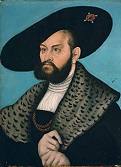
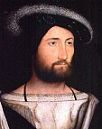




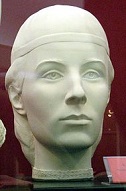

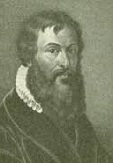






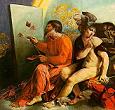
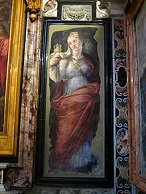

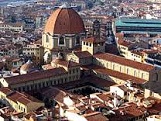
1525 On Jan. 2 after the radical Anabaptists challenge Zwingli's rule in Zurich, they are defeated in a disputation before the Great Council, and its leaders banished, gathering a peasant army which overruns Lorraine, until Claude of Lorraine, 1st Duke of Guise (1496-1550) destroys them in Lupstein (near Saverne), for which he is created the 1st duke of Guise in 1528 by Francis I when he returns from captivity, becoming the first non-prince of the royal house to hold the title, after which the Guises, who are descendants of the House of Anjou claim precedence over the Bourbon princes of Conde and Conti. On Jan. 21 after forcing his childless wife Solomoniya Saburova to become a nun, Russian tsar Vasili III marries bodaceous babe Elena Vasilyevna Glinskaya (1510-38), who bears sons Ivan IV the Terrble (1530-84) and Prince Yuri (1532-63) - time to trade-in a forty for two twenties? On Apr. 8 after two years of secret negotiations, the Treaty of Cracow (Krakow) between Albrecht I Hohenzollern of Brandenburg (1490-1568) of Prussia and Sigismund I the Old (Zygmunt I Stary) of Poland makes Prussia a hereditary duchy and Polish fiefdom for Albrecht and his brothers (AKA the Prussian Tribute); on July 6 Duke Albrecht (grandmaster of the Teutonic Order since 1511) announces his conversion to you-should-have-heard-what-I-seen Lutheranism, disavows the supremacy of the pope, declares Lutheranism the state religion of Prussia, making it the first Euro Lutheran state, dissolves the Teutonic Order and converts its land into a secular duchy (fief of the Hohenzollerns under the Polish crown) in East Prussia with himself as duke #1, and of course confiscates Church property to help with his finances and pay off any uppity nobles; he marries Dorothea (-1547), daughter of Frederick I of Denmark, and makes Konigsberg the capital of East Prussia, turning it into a Lutheran cultural center; later the district passes by inheritance to the elder branch of the House of Hohenzollern, which has ruled Brandenburg since 1415; the Teutonic Knights don't all go with the program, and on Dec. 16, 1526 Walter von Cronberg (1477-1545) is elected as grandmaster #38 (until 1543), receiving Prussia as his fief at the imperial diet in Augsburg after Albrecht refuses a summons; too bad, with all the wars going on (with the Protestants, peasants and Turks) the imperial ban never gets enforced, and Albrecht slides by; in modern times the HQ of the Teutonic Knights is listed as Singerstrasse in Vienna. The greatest French defeat since Agincourt, and it comes down to power tools? On Feb. 24 (a.m.) after imperial troops under Francesco Maria I della Rovere invade S France, and Francis I crosses Mt. Cenis pass and recaptures Milan, 23.5K French and Swiss troops (incl. 6.5K cavalry) are decisively defeated by the 23K-man German-Spanish army (incl. 4K cavalry) of HRE Charles V, led by Constable Charles III, Duke of Bourbon (1490-1527) and Naples-born Fernando Francesco de Avalos (Davalos), Marquis of Pescara (1489-1525) at the 4-hour Battle of Pavia outside the city walls at the Mirabello hunting preserve, with 15K French vs. 500 imperial casualties, becoming the first modern battle, with handheld firearms (muskets) (arquebuses) (harquebuses) (harquebi?) defeating traditional men-at-arms; after this the arquebus becomes the standard infantryman's weapon; 1.5K Spanish arquebusiers close in on the king, and a group of French nobles interpose to protect him, during which Louis II de La Tremoille (b. 1460) is shot through the heart and killed (the first Secret Service man to take a bullet for his president?); Francis I is captured in Pavia and held POW in Madrid, while Hapsburg Power Tools Charley the Fifth becomes master of Italy, magnanimously abdicating in Nov. in favor of his son dauphin Francis (b. 1518), which is magnanimously rejected; Charles of Bourbon is rewarded with the duchy of Milan; Bramante's use of candelabrum shafts as exterior decorations to pilasters in Milan is seen by the French and Spanish, and widely imitated in their home countries after they get back; cagey Marguerite d'Angouleme works overtime to get her brother Francis I back, riding horseback 12 hours a day in the winter to meet a safe-conduct deadline while writing letters at night and making use of the fact that Charles V once wanted to join her posse and marry her. On May 15 the Battle of Frankenhausen sees a combined army of Duke George of Saxony, Philip I of Hesse, and Elector Frederick III of Saxony defeat the peasant army of Thomas Munzer (b. 1489), losing six KIA and two wounded while killing 3K-10K badly-equipped untrained fleeing peasants; on May 27 Munzer is beheaded, along with 60K of his peasants, ending the Peasants' Revolt (begun 1524); meanwhile the dukes of Bavaria ally with the archbishop of Salzburg to suppress a farmer uprising in S Germany; meanwhile the Mennonite Church is founded in Zurich by ex-Anabaptist (former Catholic priest) Menno Simons (1496-1561), who wisely drops their Antinomian licentiousness in favor of proper biblical prudery to keep his head? Speaking of head? On June 27 Martin Luther marries former nun Katherina von Bora (1499-1552), who bears him six children, becoming known as "die Lutherin" - finally a nun gets some? In July the Scottish parliament approves a plan for four groups of magnates to share custody of 13-y.-o. James V in 3-mo. rotations, starting with Archibald Douglas, 6th earl of Angus, but when his time is up he reneges, not wanting his rival James Hamilton, 1st earl of Arran to get his hands on the kid, which later backfires as James turns on Angus and hates his guts for life; meanwhile English diplomat-churchman Thomas Magnus (1463-1550) is sent by Cardinal Wolsey of England to talk Margaret Tudor into living with her hubby Archibald Douglas, 6th Earl of Angus again, and she responds by divorcing him and marrying her 3rd (last) hubby Henry Stewart, 1st Lord Methven (1495-1552), master of the Scottish artillery (only Jewish member of the Scottish aristocracy) on Mar. 3, 1528, embarrassing her brother Henry VIII. The Hapsburgs obtain Cremona, Italy (until 1859). The Lutheran Reformation reaches Tartu, Estonia; the furnishings of the diocesan cathedral on Toome Hill are destroyed, and the bishop flees the mobs. A peace is signed between England and France. Pedro de Alvarado conquers El Salvador E of Guatemala, and becomes gov. of the Guatamala-Salvador district. Muslim Turkish Mongol chief (5th-gen. descendant of Tamerlane) Babar (Babur) (Baber) ("Tiger") (Xahir-ud-Din Muhammad) (1483-1530), prince of Ferghana in Afghanistan marches through Afghanistan and Persia, headed for the Punjab. Inca chief #11 Huayna Capac dies, and his sons Huascar (1491-1533) and Atahualpa (Atahualpa) (Atabalipa) (Atawallpa) (1501-33) begin a war of succession (ends 1532); meanwhile Pizarro's expedition reaches the San Juan River before turning back, discovering the existence and wealth of the Incan Empire - we'll be baack? Italian Franciscan friar Matteo Bassi (da Bascio) (Matteo Sarafini) (1495-1552) founds the Capuchin Order (Order of Friars Minor Capuchin) in an effort to return to the "true" way of solitude and penance of St. Francis; on July 3, 1528 Pope Clement VII issues the bull "Religionis Zelus", approving ' the order under the nominal jurisdiction of the Conventuals. Rodrigo de Bastidas (1467-1527) founds Santa Marta on the NW coast of South Am. N of Darien, the first permanent settlement in Nueva (New) Granada in N South Am. which eventually extends S to the Amazon. Prolific Venice-born painter Lorenzo Lotto (1480-1557), who spent time in Treviso (1503-6), the Marches (1506-8), Rome (1508-10), and Bergamo (1513-25) moves to Venice to wrap up his career for the next 25 years (until 1549). Hops is introduced to England and Germany from Artois, causing the term "ale" to become restricted to hopped brews. English scholar William Tyndale (1495-1536), fulfilling his vow "If God preserves my life, I will cause a boy that driveth a plow to know more of the Scriptures than the pope" (given to a Roman Catholic bishop who told him that he respects the word of the Pope more than the Bible) finishes his trans. of the New Testament into English from the original Greek (instead of the Latin vers. used by John Wycliffe in 1381), then has it printed in "safe" Worms, Germany by Peter Schoeffer (Schöffer) (1425-1503) (apprentice of Johannes Gutenberg) before being smuggled into England; he then begins work on the Old Testament. Architecture: Cardinal Thomas Wolsey presents Hampton Court to Henry VIII, and endows Cardinal (Christ Church) Cathedral in Oxford, with John Taverner (1490-1545) as the first organist and master of choristers; in 1522 the priory is surrendered to Wolsey to be used as the site for a college; meanwhile the fact that the Church is England's largest landowner, owning over a one-third of the country (more than the king), and that the clerics live it up and dress in fine clothes causes popular indignation, all focused on him? Tuscan-born Florentine super artist-architect Michelangelo di Lodovico Buonarroti Simoni (1475-1564) begins the Laurentian Library (Biblioteca Medicea Laurenziana) in Florence, Italy under commission from Medici pope Clement VII to house the Medici family library, ending up containing 11K mss. and 4.5K books, introducing the Mannerist Style of Architecture, a reaction to his own harmonious ideals, getting into asymmetrical compositions; too bad, when he leaves Florence in 1534, only the walls of the reading room are complete, and it doesn't open until 1571 after others carry out his plans. Inventions: Fernando Francesco de Avalos, Marquis of Pescara (1489-1525) invents the Harquebus (Arquebus) (first portable shotgun) just in time for the Battle of Pavia on Feb. 24. German mathematician Christoff Rudolff (1499-1545) introduces the radical sign for square roots in mathematics in Coss, the first German textbook on algebra. Amaretto (It. "a little bitter"), made of apricot kernels and brandy is invented by a young widowed innkeeper, who presents it to Leonardo da Vinci's pupil Bernardino Luini (1475-1532), who is painting frescoes for the church at Saronno. Nonfiction: Pietro Bembo (1470-1547), Prose della Volgar Lingua; earliest example of popular Italian writing. Albrecht Durer (1471-1528), Manual on Geometry; first one pub. in Germany. Jean Froissart (1337-1410), Chronicles, Part Two (posth); tr. John Bourchier. Gonzalo Fernandez de Oviedo y Valdes (1478-1557), La General y Natural Historia de las Indias (Toledo); first description for Euros of tobacco, pineapple, and the hammock; mentions how tasty the meat of the peacocks in the West Indies is, i.e. turkeys. Polydore Vergil (1470-1557), Life of St. Gildas. Juan Luis Vives, De Subventione Pauperum; demands state help for the poor. Art: Polidoro da Caravaggio (1495-1543) and Maturino da Firenze (1490-1528), Mary Magdalene (San Silvestro al Quirinale, Rome); St. Catherine of Siena (San Silvestro al Quirinale, Rome); Landscape (San Silvestro al Quirinale, Rome). Dosso Dossi (1483-1542), Jupiter and Mercury. Albrecht Durer (1471-1528), Madonna and Child with St. Anne; Virgin and Chld. Lorenzo Lotto (1480-1556), An Architect. Bernardino Luini (1475-1532), St. Agnes and St. Catherine (Convento Maggiore, Milan) (1525-30). Lorenzo Lotto (1480-1556), Portrait of a Young Man; Man with a Golden Animal Paw. Il Sodoma (1478-1549), St. Sebastian; Rape of the Sabine Women; Three Fates. Palma Vecchio (1480-1528), Three Sisters. Titian (1477-1576), Vanitas. Plays: Niccolo Machiavelli (1469-1527), Clizia; the char. Nicomaco is himself. John Skelton (1460-1529), Colyn Cloute; satire of Cardinal Wolsey, which gets him driven into sanctuary for life. Births: Italian Renaissance polyphonic Roman School composer Giovanni Pierluigi da Palestrina (d. 1594) on Feb. 3 in Palestrina (SE of Rome). French author-poet Joachim du Bellay (d. 1560). Italian theologian (Socinianism founder) Laelius Socinus (Lelio Sozzini) (d. 1562) in Siena. Dutch stadtholder (1549-68) Jean de Ligne, Duke of Arenberg (d. 1568); son of Louis de Ligne, baron of Barbancon and Maria of Bergen (1503-66). Polish religious leader Peter Gonesius (Piotr of Goniadz) (Giezek) (d. 1573) in Goniadz; educated at the U. of Padua. Scottish secy. of state (1558-73) Sir William Maitland of Lethington (d. 1573); educated at St. Andrews U. Ottoman Valide sultan (1574-83) Nur-Banu ("Princess of Light") (Cecilia Vernier Baffo) (d. 1583) in Venice, Italy; niece of Venetian doge Sebastiano Venier. Irish Kildare Geraldine heir Gerald FitzGerald, 11th Earl of Kilare (d. 1585); son of the 9th earl of Kildare and Countess Elizabeth of Kildare; half-brother of Silken Thomas, 10th earl of Kildare. Deaths: Itlian sculptor Andrea della Robbia (b. 1435) on Aug. 4. Italian painter Fiorenzo di Lorenzo (b. 1445). German financier Jakob Fugger (b. 1459). French gen. Louis II de La Tremoille (b. 1460) on Feb. 24 (KIA in the Battle of Pavia). Italian physician-philosopher Pietro Pomponazzi (b. 1462) on May 18 in Bologna. German Saxon elector Frederick III the Wise (b. 1463) on May 5. French duke Charles IV, duc d'Alencon (b. 1489). Italian condottiero Fernando Francesco d'Avalos (b. 1489) on Nov. 4 in Milan. German Anabaptist founder Thomas Muntzer (b. 1489) on May 27 in Muhlhausen (executed). German Protestant rebel leader Florian Geyer (b. 1490) on June 10 near Wurzburg; stabbed in the Gramschatzer Wald by two servants of his traitor brother-in-law Wilhelm von Grumbach. German-born Spanish viceroy of Valencia (1523-5) Johann of Brandenburg (b. 1493) on July 5 in Valencia. Spanish Conquistador Javier Alonso Luis Fernandez de Lugo (b. ?); born in Sanlucar de Barrameda; of Galician descent; father of Pedro Fernandez de Lugo (1475-1536).







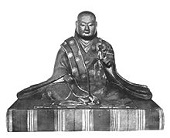


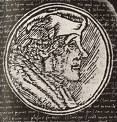


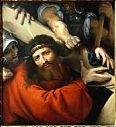
1526 On Jan. 14 the Four Years' (Italian) War (begun 1521) is ended by the Treaty of Madrid, renouncing all French claims to Italy, Burgundy, Flanders et al., promising to restore Bourbon to Charles of Bourbon, and proposing a crusade against Muslims and Lutherans; on Mar. 15 imprisoned Francis I is forced to exchange himself for his two sons Francis III, duke of Brittany (b. 1518) and Henri II (b. 1519), who end up spending three years in captivity, changing them into TB-infected ghouls who like to dress in black; after signing the treaty on Mar. 23, Francis I promptly reneges on his promise to Charles of Bourbon (causing the latter to turn against him), then joins the anti-Spanish Holy League of Cognac on May 22, which incl. the pope, Florence, Venice, and the Sforza, with the goal of restoring the 1522 status quo; Charles of Bourbon is given an army to invade N Italy with, but no funds or military supplies, pissing his troops off, causing them to get out of control and pillage and loot, forcing the Sforza out of Milan on July 24 and attacking Rome on Sept. 20; on Sept. 21 the Vatican is looted by a mob organized by Cardinal Pompeo Colonna (1479-1532) and supported by members of the hungry army of the Constable de Bourbon; meanwhile HRE Charles V sieges Arles in Burgundy (SE France), site of an archiepiscopal see. Babar conquers North India and turns it into a Tower of Babel? On Apr. 20-21 the First Battle of Panipat sees the Delhi Sultanate under Ibraham Lodi defeated by Turkic Muslim Babar (Babur) (Baber) ("Tiger") (Xahir-ud-Din Muhammad) (1483-1530), who occupies Delhi and Aghra and becomes emperor #1 of the Mughal (Mogul) Empire in N India (until Dec. 26, 1530), which peaks at 4M sq. km, making it the 2nd largest after the Maurya Empire (5M sq. km), founding a line that "builds like giants and finishes like jewelers", adopting Hindustani (derived from an obscure dialect of Western Hindi, which, along with Eastern Hindi is derived from Prakrit) as its official language; religious toleration is allowed, and the Muslims introduce Arabic and Persian words and form the subdialect of Urdu, written in a Persian script, pissing-off "patriotic" Hindus, causing them to create the artificial subdialect of Hindi (different than the Western Hindi language, parent of Hindustani), purging the Muslim words and substituting Sanskrit, and writing it with the Devanagari script, causing a Hindustani subdialect war in India. Henry VIII of England begins to petition Pope Clement VII for an annulment of his marriage to sterile wife (since June 1509) Catherine (Katherine) of Aragon (1485-1536) whose nephew HRE Charles V controls the pope, petitions back; Henry VII offers Reginald Pole (1500-58), dean of Exter (a Plantagenet) the archbishopric of York if he will support the divorce, but he refuses and flees to the Continent, then pub. the treatise "Pro Ecclesiasticae Unitatis Defensione", dissing the idea, causing the king to begin persecuting his family, executing his mother Margaret Pole, 8th Countess of Salisbury (1473-1541) (last surviving member of the House of Plantagenet) on May 27, 1541 in a bloody botched beheading (beatified in 1886 by Pope Leo XII); Sir Thomas More (1478-1535) turns against the king on religious principles; Henry revamps the royal library to use it to prove his right to do what he intends to do anyway. On May 19 emperor (since 1500) Go-Kashiwabara (b. 1464) dies, and on June 9 his 2nd son Go-Nara (1495-1557) (personal name Tomohito) becomes Japanese Yamato emperor #105 (until Sept. 27, 1557). In June the First Diet of Speyer, led by Charles V's regent Ferdinand meets to deal with the Lutherans, receiving a protest petition from the Protestants, but ends up leaving it to each prince in the empire what if anything to do by the time it recesses on Aug. 27 to deal with the Ottomans. On Aug. 29 the most tragic battle in Hungarian history takes place as all 25K members of the Hungarian army of Louis II suffer a crushing defeat at the First Battle of Mohacs (Mohács) ( Plain) (second in 1687) in S Hungary on the the right bank of the Danube River (115 mi. S of Budapest) by the Janissaries and artillery of Sultan Suleiman I the Magnificent, with the Hungarians losing 10K infantry and 4K cavalry plus two archbishops, 11 bishops, 16 bannerets, and 12 magnates, causing the Ottoman Empire to become #1 in C Europe; Louis II (b. 1506) is KIA trying to escape, causing Suleiman I to utter the soundbyte: "I came indeed in arms against him; but it was not my wish that he should be thus cut off before he scarcely tasted the sweets of life and royalty"; a week later the city of Pest (across the Danube River from Buda) (home to a large Jewish pop.) is captured, opening the way to the Danube Basin and leading to the partitioning of Hungary between the Ottoman Empire, the Hapsburg Monarchy of Austria, and the Principality of Transylvania; childless Louis (Ladislas) II Jagiello (b. 1506) of Hungary and Bohemia is KIA, and HRE Charles V's brother Ferdinand I of Austria (later HRE Ferdinand I) of the cadet line of Hapsburgs is elected his successor by virtue of his marriage to Louis' II's sister Anna; the Jagellon line in Bohemia dies out, and the Hapsburgs (Habsburgs) of Austria succeed to the throne in Bohemia, merging Bohemia (incl. Wroclaw/Breslau) into Austria, reintroducing the Roman Catholic religion, and making the thrones of Bohemia and Hungary hereditary possessions of the Hapsburg archduchy of Austria, which later becomes the Austrian-Hungarian Empire - HRE Frederick III would be proud? On Sept. 29 after landing in Winyah Bay near modern-day Georgetown, S.C. Spanish explorer Lucas Vazquez de Ayllon (Vázquez de Ayllón) (1475-1526) founds the colony of San Miguel de Guadalupe in the Carolinas, becoming the first white Euro colony in the modern-day U.S., and the first to use African slave labor; too bad, of 600 colonists, 450 die within 3 mo., and after Ayllon dies on Oct. 18 the rest head back to Hispaniola in the winter. One potato, two potato, thirteen? In late Nov. Francisco Pizarro lands his 2nd expedition in Ecuador in the Gulf of Guayaquil, sees his men grumble thinking he's nuts, then draws a line in the sand, promising unimaginable riches if they cross it, and the "Glorious 13" do so, even though no Euro knows for sure of the existence of any undiscovered civilization on the W side of the South Am. continent; in order to justify the filthy lucre they're going to steal for their personal enrichment, they have a coverstory that it's in the name of the Catholic Spanish crown, to convert the poor unenlightened savages to Christ under their loving stewardship, bringing along Catholic priest Hernando de Luque, dean of the Panama cathedral. An Anglo-Scottish peace is signed. The Hanseatic League and Thuringia go Lutheran. Poland-Lithuania wars with the Teutonic Knights, and the Poles invade S Livonia and capture Dorpoat, after which a peace is agreed to in return for a 90 ducat reparation payment; the Lutheran duchy of Courland officially backs its old Roman Catholic ally Poland but luckily doesn't need to send troops. HRE Charles V marries Isabella of Portugal. Released by Cortes, Panfilo de Narvaez returns to Spain and is appointed Spanish gov. of Florida ("Land of Flowers"), launching the Narvaez (Narváez) Expedition next year, with 300 men assigned to explore Florida (Fla.) (Sp. "land of flowers"); now all he has to do is conquer it from a bunch of hostile aborigines and nasty wild beasties - without the Crocodile Hunter? Francisco Hernandez de Cordoba rebels against Panama Gov. Pedro Arias de Avila and is captured and beheaded. Pedro de Alvarado becomes gov. of Honduras, while the Spanish settlers begin infighting; Alvarado founds San Pedro Sula in NW Honduras, and dispatches an expedition to found Gracias a Dios in NE Honduras. King (since 1492) Binnya Ran II (b. 1469) dies, and his 15-y.-o. eldest son Thushin Takayutpi (1511-39) becomes Hanthawaddy king #18 of Burma (until 1539), proving witless, frittering away his daddy's kingdom and allowing rival kingdoms to gobble it up. Sebastian Cabot is financed by a group of merchants in Sevilla to begin an expedition to reach the Moluccas, but he gets diverted into the Rio de la Plata while searching for a passage to the east. The Moravian Brothers (Anabaptists) settle in Moravia (until 1622). The Jews in Hungary are persecuted. Anabaptists in St. Gallen, Switzerland begin running through the streets shouting that the Last Day will arrive in exactly one week, causing the town to shut down as the pop. gets right with Gawd, only to see the Big Day come and go, after which humanist scholar Joachim Vadian (1484-1551) is elected mayor, leading the conversion of the city to Lutheranism, causing iconoclastic riots; meanwhile the Roman Catholic abbey holds out until 1803 - two balls and a strike, two on, two out, tie game, fifth inning? Swabian furrier Melchior Hoffman (1498-1544), who converted to Lutheranism in 1522 pub. On the Twelfth Chapter of Daniel, a pamphlet predicting the End of Days in Easter, 1533, when Elijah and Enoch will appear and overthrow the pope, then get martyred, beginning a 42-mo. tribulation period, after which Christ will return; of course, he thinks he's Elijah, and ends up in prison in Strasburg. The Portuguese visit New Guinea. Hans Holbein the Younger visits England for the first time. Ignatius Loyola is jailed for six weeks at Alcala for his suspect new brand of spirituality. English scholar Myles (Miles) Coverdale (1488-1569), who entered the Augustinian monastery of Cambridge in 1514 after Roman Catholic ordination as a priest leaves after being influenced by prior Robert Barnes (1495-1540) (who went Lutheran), and hooks up with William Tyndale (1494-1536), starting to trans. the Bible and Apocrypha into English. Francisco de Sa de Miranda (1485-1558) founds the Italianate School of Lit. in Portugal. After training in Hamburg, Hannover, Germany-born brewer Cord Broyan (-1570) invents light brown barley-wheat top-fermented Broyhan Beer, which becomes a hit, gaining wide distribution, causing Hannover in 1609 to limit the number of brewers to 317 and force the burghers to join a shareholders co. and guild, which becomes Gilde Brauerei; it ends up being owned by Anheuser-Busch InBev. Inventions: The card game Piquet is first played - don't piquet your nose? Nonfiction: A Swedish Trans. of the New Testament is pub., and Michael Agricola (1510-57) sets out to trans. it into Finnish, although virtually nothing had ever been pub. in that language and he has to wing it. Anon., Deliberations on the Reality and Heresy of Witchcraft; "What remedy will destroy the plague of those witches". Hector Boece, Historia Gentis Scotorum. Jean Francois Fernel (1497-1558), Monalosphaerium. Martin Luther (1483-1546), The German Mass and Order of Divine Service (Jan.); splits with the Roman Catholic Mass; The Sacrament of the Body and Blood of Christ—Against the Fanatics (Sept.); argues for the literal presence of Christ's body and blood in the Lord's Supper against the Sacramentarians incl. Ulrich Zwingli, Andreas Karlstadt, Johannes Oecolampadius, Caspar Schwenckfeld et al., but splits with the pope in his claim that the sacraments are good works that can be used to merit salvation, which is obtained through faith. Polydore Vergil (1470-1557), Liber de Prodigiis; a Latin dialogue between Polydore and his friend Robert Ridley of Cambridge. Art: Antonio da Correggio (1489-1534), The Assumption of the Virgin (1526-30) (Parma Cathedral). Albrecht Durer (1471-1528), The Four Apostles (his masterpiece?); Erasmus and Melanchthon (copper engraving). Lorenzo Lotto (1480-1556), Christ Carrying His Cross; Young Man with a Book. Births: Flemish physician-botanist-horticulturist Charles de l'Ecluse (l'Écluse) (L'Escluse) (Carolus Clusius) (d. 1609) on Feb. 19 in Arras; introducer of the potato to Germany, and the tulip bulb culture to the Netherlands. Engish lord chamberlain (1585-96) Henry Carey, 1st Baron Hunsdon (d. 1596) on Mar. 4; son of Anne Boleyn's sister Mary Boleyn (1499-1543) (Henry VIII's mistress); 1st cousin of Elizabeth I; father of George Carey, 2nd baron Hunsdon (1547-1603). German humanist writer-statesman and astrologer Heinrich Rantzau (Ranzow) (Ranzovius) (d. 1598) on Mar. 11; son of Johan Rantzau (1492-1565); great-uncle of Josias von Rantzau (1609-50); friend of Tycho Brahe. German Lutheran Albertine Wettin elector of Saxony (1553-86) Augustus I (d. 1586) on July 31 in Freiberg; 2nd son of Henry IV the Pious (1473-1541) and Katharina of Mecklenburg; younger brother of Maurice I (1521-53). German Count Palatine (1543-69) Wolfgang of Zweibrucken (d. 1569) on Sept. 26 in Zweibrucken; only son of Count Louis II (-1532) and Elizabeth of Hesse; husband (1545-) of Anna of Hesse, daughter of Landgrave Philip I of Hesse; father of Charles I, count Palatine of Zweibrucken-Birkenfield (1560-1600). Spanish adm. (Roman Catholic) Alvaro de Bazan (Álvaro de Bazán), 1st Marquis of Santa Cruz de Mudela (d. 1588) on Dec. 12 in Granada; never loses a battle; his personal galley is called La Loba (The Seawolf), named after its golden figurehead. Italian agronomist Giovan Vettorio Soderini (d. 1596) in Florence; educated at the U. of Bologna. Ottoman royal poet ("Sultan of Poets") Baki (Mahmud Abdulbaki) (d. 1600) in Constantinople; friend of Suleiman I. Deaths: Austrian lutenist-composer Hans Judenkunig (b. 1450). Italian-born Spanish historian Peter Martyr d'Anghiera (b. 1457) in Oct. in Granada. Italian painter Vittore Carpaccio (b. 1460). French poet Jean Marot (b. 1463) in Paris. Japanese Yamato emperor #104 (1500-26) Go-Kashiwabara (b. 1464) on May 19. Italian mathematician Scipione del Ferro (b. 1465) on Nov. 5. Burmese king (1492-1526) Binnya Ran II (b. 1469) in Pegu. German physician Eucharius Rosslin (b. 1470) in Frankfurt on Main. Spanish explorer Diego Colon (b. 1474) on Feb. 23/26 in La Puebla de Montalban, Spain. Spanish explorer Lucas Vazquez de Ayllon (b. 1475) on Oct. 18 in San Miguel de Gualdape. Spanish round-the-world explorer Juan Sebastian de Elcano (b. 1476) on Aug. 4 in the Pacific Ocean; dies of malnutrition on an expedition to claim the East Indies for Charles I.



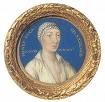




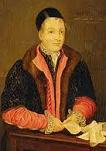

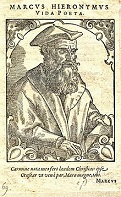
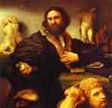

1527 Early in the year Ferdinand is crowned king of Bohemia in Prague, followed by king of Hungary, and reorganizes the the Hapsburg admin. in Austria; last Nov. 11 a strong Hungarian nationalist party of nobles supported by the Turks crowned John (Janos) Zapolya as king John I (1487-1540) (until July 22, 1540) and started a civil war, with John's son John Sigismund later getting into the act (ends 1562). On Mar. 16 Mughal emperor Babar wins the Battle of Kanwaha near Agra, extending his domain. In Apr. Francisco Pizarro, leading his four Mafia-like brothers and a small party of armed horsemen lands at Tumbez (Tumbes), confirming the existence of the Inca Empire; he then goes to Spain to tell of his discovery and get backing for a Mafia-style takeover of innocent peoples in the name of Christ, Mother Church, and Spain, not necessarily in that order? If we make it through December everything's gonna be all right I know? After HRE Charles V, Habsburg ruler of Germany, Spain, and the Netherlands doesn't provide for their pay, the German-Spanish army of Duke Charles III of Bourbon (1490-1527), to whom he promises booty ravages N Italy looking for loot, arriving at the gates of Rome on May 5; after Pope Clement VII (Giulio de' Medici) refuses to pay a big enough ransom they sack Rome, starting on the fog-smothered morning of May 6, killing 4K; entire hospitals and orphanages are emptied, and their raped bodies drowned in the bloody Tiber River; the pope retreats to Castel Sant'Angelo just E of the Vatican on the Tiber, where he holes-up for 8 mo.; on May 6 (early in the action) Charles III of Bourbon is KIA by an arrow (bullet?) shot by Benvenuto Cellini (1500-71); papal army CIC Duke Francesco Maria I della Rovere of Urbino, who sits idly by during the imperial invasion is blamed for the sack of Rome, lowering his capital yet further with Clement VII; this whole affair symbolizes the downfall of Renaissance Italy to imperial Spanish rule, and the end of the High Renaissance?; Charles V later apologizes, claiming that Bourbon and his army were out of control, and the pope forgives him; Francis I seizes the remainder of Bourbon's estates and labels him a traitor, painting the doorways of the Bourbon Palace in Paris yellow; the 9th cent. line of Bourbon in France ends, but never fear, another line breaks through to royalty via Antoine de Bourbon, duc de Vendome, who marries Jeanne d'Albret of Navarre and has son Henry of Navarre, who becomes Henry IV in 1589; meanwhile Italian engraver Marcantonio Raimondi is held for ransom by the Spanish troops of Charles V, and after paying the ransom ruins him financially, he drags back to his hometown of Bologna, staying for life. In May after Henry VIII puts him up to it, Cardinal Wolsey, papal legate to England sets up a secret tribunal in his London home of York Place, which calls Henry VIII to answer to the charge of having lived for 18 years unlawfully with the wife of his deceased brother Arthur, planning to hustle an annulment through and get the pope to agree before Catherine of Aragon finds out and tells her nephew HRE Charles V; too bad, on June 1 the news of the sacking of Rome and the taking of the pope prisoner by Charles' troops throws a wet tampon on the plot; speaking of wet tampon, Anne Boleyn is busy working to throw one on Henry FitzRoy, 1st Duke of Richmond and Somerset (1519-36), son of mistress Elizabeth "Bessie" Blount (1502-1540), whom Henry VIII is considering making his heir; Catherine describes Anne as "a woman who is the scandal of Christendom". On June 22 ater conquering the 4th cent. C.E. city of Sunda Kelapa from the Portuguese, Javanese Demak Sultanate gen. Fatahillah founds the city of Jakarta (originally Jayakarta) (modern-day pop. 9.6M/30.2M), which on Mar. 4, 1621 is taken over by the Dutch, who rename it Batavia; on Aug. 8, 1942 it is renamed Jakarta, becoming the 2nd largest urban agglomeration after Tokyo. In the summer Ignatius Loyola is questioned by the Inquisition (Dominicans) in Salamanca, and made to do 21 days in jail for his suspect new brand of spirituality. In Nov. Giovanni da Verrazano (b. 1485) is captured off the coast of Cadiz and hanged for piracy by order of HRE Charles V; either that or he is eaten by cannibals in the Carribean - cocky New Yorker? The Second Florentine Repub. (ends 1532) is founded after another revolt against the Medici. Kurpfalz (Electoral Palatinate) and Hesse go Lutheran, with landgrave Philip I the Magnanimous of Hesse (1504-67) closing down the monasteries in his principality and founding U. of Marburg on July 1, becoming the first Protestant univ. After the New Testament is pub. in Swedish in 1526, the Reformation begins in Sweden under king (1523-60) Gustav I Vasa (1496-1560), who obtains the right to confiscate Church property and suppress monasteries from the Council of Vasteras, and in 1536 founds the Lutheran Swedish Church, breaking with Rome completely and abolishing canon law, ending the Swedish Middle Ages; the Bible is trans. into Swedish in 1541, and Finnish in 1543. Marguerite d'Angouleme, whose first hubby Duke Charles of Alencon died in 1525 marries Henri d'Albret, the future Henry II, titular king of Navarre, making her Margaret of Navarre (1492-1549); she bears Jeannne d'Albret (1528-72), who becomes the mother of French king Henry IV in 1453. Former royal bodyguard Mac Dang Dung (-1541) deposes the last Le king, seizes the throne of Vietnam, and founds the Mac Dynasty (ends 1692), with the Le (based in Hanoi), Nguyen (based in Hue), and Trinh (based in Hanoi) families vying for power, the latter two pretending to be supporting the Le Dynasty, which nominally continues to rule until 1787. Flemish composer Adrian Willaert (1490-1562) becomes maestro di cappella at St. Mark's in Venice. Sebastian Cabot visits Paraguay (Guarani "pararaguay" = great river, meaning the Piranha River), long settled by the Tupian-speaking Guarani Indians, travels up the Parana and Paraguay Rivers, and builds the fortification of Santa Espiritu, which is sieged by pissed-off natives. Nuno (Nuño) Beltran de Guzman (Guzmán) (1490-1544) becomes the royal gov. of Panuco district. Juan Martinez de Ampies (Ampúes) (Ampues) is sent by the govt. of Santo Domingo to found the invasion base of Santa Ana de Coro (Sp. "wind") in Venezuela, which in 1529 HRE Charles V grants to the Welser Family of merchants of Augsburg, Germany, to which he is heavily in debt. Paracelsus lectures on medicine at the U. of Basel. Ferdinand de Gonzaque (Ferrante I de Gonzaga) (1507-57) succeeds Charles III de Montpensier and de Bourbon as grandmaster of the Priory of Sion (until 1557) (1575?) :). Nonfiction: Petrus Apianus (1495-1552), Ein Newe und Wolgegrundete Underweisung aller Kauffmanns Rechnung in Dreyen Buchern, mit Schonen Regeln und Fragstucken Begriffen; handbook of commercial arithmetic, incl. a variant of Pascal's Triangle. Hector Boece (1465-1536), Historia Gentis Scotorum (History of the Scottish People); Scottish history to 1438; written for the accession of James III; big hit; too bad, it's full of inaccuracies, and kisses kingly butt too much, esp. in the treatment of Macbeth; pub. in 1536 from Latin into Scots by John Bellenden, becoming the oldest book of Scots prose to survive to modern times. Lionardo Giachini (Leonardus Jacchinus), Treatise on the Medicinal Virtues of the Melon (Popone). Marco Girolamo Vida (1490-1560), De Arte Poetica. Art: Antonio da Correggio (1489-1534), Madonna of St. Jerome. Hans Holbein the Younger (1497-1543), Sir Thomas More and His Family. Lorenzo Lotto (1480-1556), The Annunciation; Portrait of Andrea Odoni. Parmigianino (1503-40), Vision of St. Jerome. Poetry: Marcus Hieronymus Vida (1485-1566), Scacchia Ludis; 658-line poem about a chess game between Apollo and Mercury, with rooks called towers, leading to the modern names castle and castling, and the name Caïssa (a Thracian dryad) for the goddess of chess. Novels: Niccolo Machiavelli (1469-1527), Novella; archdemon Belphegor (Baal Peor) is sent by Pluto to Florence, marries, then returns to Hell to get away from the nagging bitch? Births: Dutch geographer-cartographer Abraham Oretelius (d. 1598) on Apr. 14 in Antwerp. Spanish king (1556-98), HRE (1558-98), king of the Two Sicilies (1554-98), king consort of England (1554-8), king of Chile (1554-6), Portuguese king (as Philip I) (1580-98) ("the Terror of the Protestants") Philip II (the Prudent) (d. 1598) on May 21 in Valladolid; only legitimate son of HRE Charles V (1500-58) and Isabella of Portugal (1503-39) (daughter of Manuel I); the 1588 Spanish Armada king. English (Queen Elizabeth I's) astrologer and mathematician-astrologer John Dee (d. 1609) on July 13 in Tower Ward, London; student of Marsilio Ficino (1433-99). Austrian HRE (1564-76) (Roman Catholic) Maximilian II (d. 1576) on July 31 in Vienna; son of Ferdinand I and Anne of Bohemia-Hungary. English MP and lord warden of the Cinque Ports Sir William Brooke, 10th Baron Cobham (d. 1597) on Nov. 1; son of George Brooke, 9th Baron Cobham (-1558) and Anne Braye (-1558); educated at the King's School, Canterbury, and Queens' College, Cambridge U. Welsh cartographer and MP Humphrey Llwyd (Lhuyd) (d. 1568) in Foxhall, Denbigh, Denbighshire; educated at Brasenose College, Oxford U.; coiner of the term "British Empire". French La Pleiade Renaissance poet Remy (Rémy) (Rémi) Belleau (d. 1577) in Nogent-le-Rotrou; student of Marc Antoine Muret and George Buchanan. English statesman-soldier Sir William Drury (d. 1579) on Oct. 2 in Hawstead, Suffolk; grandson of House speaker Sir Robert Drury (-1536); educated at Gonville College, Cambridge U. Spanish mystic poet Luis de Leon (d. 1591). Italian Renaissance painter Giuseppe Arcimboldo (Arcimboldi) (d. 1593) in Milan; known for kinky portraits of heads made out of fruits, veggies, flowers, roots, fish and books. Italian Mannerist painter-sculptor-architect Pellegrino Tibaldi (Pellegrino di Tibaldo de Pellegrini) (d. 1596) in Puria di Valsolda, Milan; grows up in Bologna; father of Domenico Tibaldi (1541-83); student of Perin del Vaga. Austrian mistress (of HRE Charles V) Barbara Blomberg (d. 1597); mother of Don John of Austria (1547-78). Spanish Roman Catholic priest and Orientalist (ed. of "The Antwerp Polyglot") Benito Arias Montano (d. 1598) in Fregenal de la Sierra, Extremadura. Flemish geographer Abraham Ortelius (Oertel) (Ortell) (d. 1598) in Antwerp; pupil of Gerhardus Mercator. Deaths Italian writer Francesco Colonna (b. 1433); leaves the Latin epic poem "Dream of Delfilo" (Delfili Somnium) (pub. in 1959). Portuguese explorer Pero da Covilha (b. 1460) in Ethiopia. Spanish conquistador Rodrigo de Bastidas (b. 1467). Italian duck-plucker Niccolo Machiavelli (b. 1469) on June 21 in Florence; dies after receiving last rites; bured in the Church of Santa Croce in Florence, complete with a monument with the epitaph "Tanto Nomini Nullum Par Elogium" (No eulogy would be appropriate to such a great name): "God is not willing to do everything, and thus take away our free will and that share of glory which belongs to us"; "Men are more apt to be mistaken in their generalizations than in their particular observations." Italian navigator Giovanni da Verrazano (b. 1485) in Nov. in Cadiz (executed). Spanish conquistador Juan de Grijalva (b. 1490) on Jan. 21 in Honduras (killed by natives). French traitor gen. Charles III de Bourbon (b. 1490) on May 6 in Rome (KIA while sacking the City of God for the Priory of Sion?).







1528 Plague breaks out again in England. On Jan. 1 a planned attack on Erfurt by Anabaptist leader Hans Romer, who thinks Christ is coming this year is stopped in advance after he is betrayed. On Feb. 2 Ignatius Loyola arrives in Paris on foot, spending the next six years in loyal destitution. On Feb. 18 after returning from captivity in Madrid in 1526 and finding the Louvre uncomfortable, Francis I begins demolition of the great central tower of the Louvre to make it into a palatial residence; on Mar. 15 HE announces plans to make Paris his principal residence and begins the large hunting lodge Chateau de Madrid in Neuilly on the edge of the Bois de Boulogne. Welcome to Hurricane Country? In Apr. 1528 the Narvaez (Narváez) Expedition, led by 1-eyed Spanish explorer Panfilo de Narvaez (Pánfilo de Narváez) (1470-1528) sails from Cuba with 300 soldiers and colonists in an attempt to colonize Florida (Fla.) (Sp. "land of flowers"), and lands on Apr. 14 near Cape Corrientes after discovering Pensacola Bay in the Fla. Panhandle; after exploring a dismal swampland filled with people who don't want them they end up in Tallahassee, and on Sept. 22 they set sail in five crude barges and try to reach the Panuco River, but get shipwrecked in Nov. on the Texas coast, where he tells his men "every man to himself - Spain ends here"; too bad, the Apalachee Indians kick his butt, and he barely escapes to the Mississippi River before being killed in Nov.; on Nov. 6 after surviving a storm at the mouth of the Mississippi River, his treasurer Alvar Nunez (Álvar Núñez) Cabeza de Vaca (1490-1557) (Sp. "cow head") and three others, incl. African (Moroccan) slave Esteban Dorantes (Estevanico) (1500-39) (first African to set foot in the future U.S.?) land on Galveston Island in Texas, and run into the Karankawa (Carancahua) coastal Indians, who take pity and feed them, showing them giant oyster beds and how to eat cattail "nuts"; Cow Head ends up separated from the other survivors, enslaved and taken to the mainland next spring, and spends eight years walking to the Spanish colony in Mexico while getting kicked around and meeting the indigenous pop. incl. the peyote-smoking Coahuiltecans (pr. cal-TEK-ans), becoming the first Euro to view Am. bison (buffaloes); he also later reports seeing "a devilish thing, and it is that I saw one man married to another"; when Estevanico returns to New Spain, he tells about hearing of the Seven Golden Cities of Cibola. In June 16-y.-o. king (since Sept. 9, 1513) James V (1512-42) escapes from Edinburgh Castle when his foster daddy and chancellor Archibald Douglas, 6th earl of Angus and the latter's uncle (whom he admires) Sir Archibald Douglas of Kilspindie ("Greysteil") (1490-1535) are absent (the latter visiting his mistress in Dundee), and reaches Stirling, where he declares himself of the age of majority and begins his personal rule, kicking Angus and his clique out of the govt., then unsuccessfully sieging the cool Douglas stronghold of Tantallon Castle (built in the late 1300s on a cliff face opposite the Bass looking onto the Firth of Forth 3 mi. SE of North Berwick) in the fall; he snubs the Reformation of Henry VIII and appoints cardinal (last before the Scottish Reformation) David Beaton (1494-1546) as archbishop of Saint Andrews, who gets into a jurisdiction war with Glasgow archbishop Gavin Dunbar (1490-1547); meanwhile he raises church taxes, taking in £72K in the next four years, undermining church power. The Weavers' Riot in Kent begins in protest against Cardinal Wolsey's plan to move the English staple town for wool from Antwerp to Calais. After failing to win concessions for Genoa from Francis I, Andrea Doria (1468-1560) switches sides to HRE Charles V, establishes a repub. with his backing, and finally ends internal strife and gets Genoa turned into a banking and shipbuilding center; he refuses the title of doge, but accepts that of imperial adm., with palaces, privileges, and the style of "liberator and father of his country". In a meeting in Bridewell Palace (Bridwell Prison in 1556), Henry VIII explains to the nobles and citizens of London his reasons for seeking a divorce from his wife Catherine of Aragon (his official, not real reasons, viz., the need to continue the line of a Welsh brewer with a male heir?); the pope sends Cardinal (since 1534) Lorenzo Campeggio (1474-1539) (last cardinal protector of England since Jan. 22, 1523) to England as his legate to hear the case, with secret orders to delay as long as possible, since the pope dares not mess with HRE Charles V's aunt? Francis I of France declares war on HRE Charles V, abrogating a treaty between the two countries, causing Charles V to accuse him of ungentlemanly conduct and challenge him to a duel; although it is never arranged, the incident becomes famous and causes European gentlemen to think they have the right to avenge all slights on their honor by similar challenges, although honor duels are never legalized and in some countries are outlawed; judicial duels are still okey-dokey artichokey? Chiapas in Mexico is subdued. Salamanca-born Spanish adelantado Francisco de Montejo (1479-1553) begins the conquest of Yucatan from the Mayans (until 1535); he fails, but his son El Mozo finally gets it done in 1546. Philip Melanchthon pub. Unterricht der Visitatorn an die Pfarherrn im Kurfürstentum zu Sachssen, proposing educational reforms in Germany along with an explanation of his evangelical doctrine of salvation sans popes. The Khmer royal court moves to Lovaek. The city of Oaxaca (pr. hwah-SAH-kah) (from the Nahuatal word "Huaxyacac", the native guaje tree) In SE Mexico (modern-day pop. 3.9M) (which started as an Aztec fort in 1486) is settled by the Dominicans, who form a bishopric in 1535; in 1535 HRE Charles V gives it a charter. Dutch glass painter David Joris (Jan Jorisz) (Jan Joriszoon) (1501-56), who settled in Delft in 1524 is arrested for trying to stop a Roman Catholic procession carrying the Eurcharist, and is pilloried and banished for three years, causing him to begin wandering in N Europe for the next eight years, officially joining the Anabaptists in 1533 then returning to Delft in 1536 as a consecrated bishop; in 1538 he declares himself the Messiah, causing him to become wealthy, and in 1544 he moves to Basel and lives under an assumed name until death. Architecture: A mosque is built in the N Indian town of Ayodhya in the state of Uttar Pradesh on a site believed by Hindus to be the birthplace of Lord Rama, becoming India's perennial religious flashpoint. Diego de Siloe becomes architect of Granada Cathedral. Inventions: After conquering the Aztecs in 1519-21 and being heaped with honors, Spanish conquistador Hernan Cortes (Hernán Cortés) (1485-1547) returns to Spain, bringing chocolate from Montezuma's court back to the court of HRE Charles V in Spain in ships which use gold for ballast, where it is given to monks who hide it away for a cent. - the original Willy Wonka and the Chocolate Factory? Nonfiction: Johann Agricola (1494-1566), Book of German Proverbs. Martin Agricola (1486-1556), Eyn Kurtz Deutsch Musica. Baldassare Castiglione (1478-1529), Il Libro del Cortegiano (The Courtier) (Venice); written in 1514; "It is very rare for an evil soul to inhabit a beautiful body. For outer beauty is the true sign of inner goodness... Beauty and goodness are more or less the same thing. This particularly applies to the beauty of the human body, whose main function, it seems to me, is to reflect the beauty of the soul"; "The beauty of the book is such that it deserves to be read in all ages; and as long as courts endure, as long as princes reign and knights and ladies meet, as long valor and courtesy hold a place in our hearts, the name of Castiglione will be held in honor" (Torquato Tasso) - no fun for Ugly Betty? Erasmus (1466-1536), Ciceronianus; protests against slavish imitation of Roman orator Marcus Tullius Cicero, causing Julius Caesar Scaliger to pub. two orations dissing him - in whose style and vocabulary, guess? Jean Francois Fernel (1497-1558), Cosmotheoria; determines the degree of the meridian based on the revolutions of carriage wheels between Paris and Amiens; De Proportionibus. Sebastian Franck (1499-1543), The Vice of Drinking. Ulrich von Hutten (1488-1523), Arminius (posth.). Paracelsus (1493-1541), Die Kleine Chirurgia; the first Euro surgery manual, which crusades for the use of chemicals in the treatment of disease, pioneering the use of minerals incl. lead and mercury as drugs, and coining the name "zink" (zinc) (Ger. "pointed"). Fiction: Alfonso de Valdes, Dialogo de Mercurio y Caron. Art: Antonio da Correggio (1489-1534), Holy Night (La Notte) (Nativity) (Adoration of the Shepherds) (1528-30) (Church of San Prospero, Reggio Emilia); la chandell (of the candle) chiaroscuro. Hans Holbein the Younger (1497-1543), The Artist's Family. Titian (1477-1576), Portrait of Girolamo Fracastro. Births: Bavarian duke (1550-79) (Roman Catholic) (leader of the German Counter-Reformation) Albert (Albrecht) V (d. 1579) on Feb. 29. German Welf prince of Brunswick-Wolfenbuttel (1568-89) and duke of Brunswick-Luneburg Julius of Brunswick-Luneburg (Brunswick-Lüneburg) (d. 1589) on June 29 in Wolfenbuttel; youngest son of Duke Henry V (1489-1568) and Maria (1496-1541), daughter of Henry of Wurttemberg; educated at the U. of Cologne, and U. of Leuven; father of Henry Julius (1564-1613). Italian duke of Savoy (1553-80) Emmanuel (Iron Head) (Testa de Fer) Philibert (d. 1580) on July 8 in Chambery; only child of Duke Charles III of Savoy (1486-1553) and Beatrice of Portugal (1504-38) (sister-in-law to HRE Charles V). Portuguese poet Antonio Ferreira (d. 1569) in Lisbon. Spanish conquistador Jeronimo (Jerónimo) Luis de Cabrera (d. 1574) in Seville; father of Jeronima de Contreras, wife of Rio de la Plata gov. Hernando Arias de Saavedra (1561-1634). Spanish conquistador Juan de Garay (d. 1583) in Orduna, Navarre (Junta de Vilalba de Losa, Castile?). Italian painter Paolo Veronese (Cagliari) (d. 1588) in Verona. Belgian engraver (Protestant) Theodor (Theodorus) de Bry (d. 1598) in Liege; flees to Strasbourg in the 1560s, then Frankfurt-am-Main in 1588. Italian painter Federico Barocci (d. 1612) in Urbino. Deaths: English prelate-statesman Richard Foxe (b. 1448). Spanish military engineer Pedro Navarro (b. 1460) on Aug. 28 Naples; in the prison of Castel Nuovo at Naples (smothered by a pillow?). German painter Matthias Grunewald (b. 1465). Spanish adventurer Panfilo de Narvaez (b. 1470) in Nov. on the Mississippi River. German artist Albrecht Durer (b. 1471) on Apr. 6. Italian painter Palma Vecchio (b. 1480) on July 30. Austrian Anabaptist Balthasar Hubmair (b. 1485) in Vienna (burned at the stake). Italian artist Giovanni Francesco Penni (b. 1488). Italian painter Maturino da Firenze (b. 1490) (d. 1527?) in Rome.
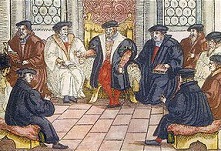





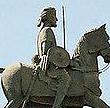
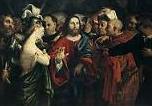
1529 100K+ die of the sweating sickness in London, Lubeck, and Hamburg; France is spared. On Feb. 21-Apr. 22 the Second Diet of Speyer (Spires) attempts to set aside the judgment of the first Diet and outlaw the Reformation in the Holy Roman Empire; on Apr. 19 the term "Protestant" emerges when the Minority Decision of Protest is signed by six Lutheran princes and 14 free cities of the empire, it declares that decisions of conscience in religious matters are between an individual and God - sounds like they're talking about abortion? On Mar. 7-9 imam Ahmad ibn Ibraham al-Ghazi Gragn ("left-handed") (the Conqueror) (1507-43) of Adal in N Somalia launches the bloody Ethiopian-Adal War (Futuh al Habash) (Conquest of Abyssinia) (ends 1543) for the Muslim sultanate of Adal in the N Horn of Africa, using Ottoman-supplied cannons and a largely Somali army equipped with matchlocks to win the Battle of Shimbra Kure against emperor (since Aug. 13, 1507) Dawit II (Lebna Dengel), suffering such heavy losses that he withdraws for two years before returning and occupying two-thirds (three-fourths?) of Ethiopia before dying on Feb. 21, 1543, after which his forces withdraw; in 1577 Muhammad Jasa transfers the Ada capital from Harar to Aussa, after which the sultanate (founded 1415) ends in 1559 amid infighting with Afar tribes; after the Ethiopians are supplied with cannons by the Portuguese, the war becomes easier to fight. On Apr. 21 Spanish diplomat Gonzalo Fernandez comes to Ireland to visit the Earl of Desmond in Dingle, who requests the Spanish king to supply him with a small fleet of four large 200-ton ships and six smaller ones with cannons along with 500 Fleming soldiers to fight the pesky English Protestants, which he reduces to just the artillery after being asked what signal service he had done to justify it. On May 6 Mughal emperor Babar scores another V at the Battle of Gogra (Ghaghra). On May 29 the Penon (Peñón) of Algiers Fortress is taken from the Spaniards and their Kabyles allies by Hayreddin Barbarossa; the Ottomans expel Spain from Algeria. On June 29 Pope Clement VII and HRE Charles V conclude a treaty by which the HRE agrees to reinstate the Medicis in Florence, and on Oct. 24 an imperial and Spanish army under Philibert of Chalon, Prince of Orange (1502-30) and Pier Maria III de' Rossi sieges Florence (ends Aug. 10); Michelangelo Buanarroti is put in charge of the defense of the bell tower of San Miniato al Monte, hanging mattresses from it to protect against cannon fire, giving rise to the saying go to the mattresses? On July 26 after wowing HRE Charles V with trinkets brought from Peru, the queen's Capitulations of Toledo authorize Francisco Pizarro to proceed with the conquest of Peru, renamed New Castile, with the right of discovery and conquest for a distance of 200 leagues S of the Gulf of Guyaquil, along wth the office of adelantado (gov.) and capt.-gen.; Diego de Almagro is given command of the fort of Tumbes, and Hernando de Luque is named its bishop. In July papal legate Cardinal Campeggio announces that the whole matter of the royal divorce case must be referred to Rome for the pope's personal adjudication; two days after he departs for Rome in Aug., useless fall-guy Cardinal Wolsey is tried and convicted of exceeding his authority as a papal legate and deprived of his seals as lord chancellor by none other than Charles Brandon, 1st duke of Suffolk, whose neck he had saved back in 1515 over his treasonable marrige to Henry VIII's sister, to whom Wolsey utters the soundbyte "If I, simple Cardinal, had not been, you should have had at this present no head upon your shoulders wherein you should have had a tongue to make any such report in despite of us"; as well as all official posts and honors except for the archbishopric of York, to which he retires after his right-hand man Thomas Cromwell leads the opposition to an attempt in Parliament to pass a bill of attainder against him; on Oct. 25 Sir Thomas More is made lord chancellor (until 1532), becoming the first layman to hold the post; in Oct. Henry VIII summons the English Reformation Parliament, which sits for seven year (until 1536); Thomas Cromwell survives his dismissal in spades, becoming Henry VIII's right-hand man and showing his stuff by gathering all the grievances of the English people against the privileged Catholic Church into a list, and going on to manage the dissolution of the monasteries; Sir Thomas Howard, 3rd duke of Norfolk becomes pres. of the king's council; the pope adjourns the commission to consider Henry's annulment to Rome, which is a V for Catherine; Cambridge U. divine Thomas Cranmer suggests to Henry VIII that he need not wait for Rome to annul his marriage, but might refer the question of his marriage to the divines of the univs.; the happy king appoints him archdeacon of Taunton, a royal chaplain, and gets him a post in the household of Anne Boleyn's father Sir Thomas Boleyn, now the earl of Wiltshire. On Aug. 5 the Treaty (Peace) of Cambrai (Ladies' Peace) (Ladies' Charter) (Paix des Dames), negotiated by HRE Charles V's aunt Margaret of Austria and Francis I's mother Louise of Savoy, duchess of Angouleme is signed in Cambrai in N France; Francis I pays 2M crowns and renounces his claims on Italy (Naples), Flanders and Artois; Charles V promises not to press his claims on Burgundy for the time being, and releases the French prince POWs; Venice, Florence, and the pope are left along against Charles V; Francis I marries Charles' sister Eleanor. On Oct. 1-4 Roman Catholic Church dropouts Martin Luther and Ulrich Zwingli meet at the Marburg Colloquy in Marburg, Hesse, but don't quite see eye to eye over the thorny issue of consubstantiation vs. transubstantiation, i.e., whether the sacramental bread and wine are totally substantively converted into the body and blood of Christ, or whether the body and blood of Christ are substantively present with the unchanged eucharistic bread and wine; and let's not forget impanation, where the union is only mystical - this Christ he's quite a fellow? On Oct. 23 Nostradamus re-enrolls at Montpellier to obtain his doctorate in medicine. Swinging Ulrich Zwingli converts six of 11 Swiss cantons to the Reformation, the remaining five Forest (Rural) Cantons form an alliance with Austria to move against them, causing them to form their army and civil war to loom, later known as the Milk Soup War (First War of Kappel) because they end up basically agreeing that fighting over religion isn't worth it? The Ottomans invade Hungary, and John Zapolya (John I) emerges from hiding in the Carpathians and defeats Ferdinand's army, then surrenders to Sultan Suleiman I, who confirms his crown; the Ottomans begin a siege of Vienna in the fall, but are unsuccessful and retreat - the first time they show that they can be beaten? Hamburg goes Lutheran, receiving refugees from the Netherlands and France. After HRE Charles V repeays a loan by giting them the colony of Venezuela (Klein-Venedig), colonists sent by the Welsers of Augsburg establish a govt. in Venezuela, with Ambrosio Alfinger (1500-33) (of the wonderful German Welser banking family, which strong-fingered its way in via banking debts) as gov., which treats natives like manure while sending expeditions along the Orinoco and into the Andes searching for the fabled El Dorado and gold, gold, gold. Nuno de Guzman becomes first pres. of the audiencia of New Spain, and conquers the Chichimeca region N and W of Mexico City, incl. Jalisco and Sinaloa. Francisco de Montejo begins the conquest of Tabasco (until 1540). James V ousts pro-English Archibald Douglas, 6th earl of Angus as Scottish chancellor, and replaces him as warden of the East March by George, 4th Lord Home (-1549), then ousts Archibald Douglas of Kilspindie, giving his position of keeper of the privy seal to George Crichton (-1543), bishop of Dunkeld ("He is said to have thanked God that he knew neither New or Old Testaments") (to whom Pope Alexander VI presented the 300-lb. brass eagle Dunkeld Lectern in 1530), and his position as provost of Edinburgh to Robert Maxwell, 5th Lord Maxwell (1493-1546); both Douglases are exiled to England; already a big squirt, the 17-y.-o. king (whose daddy died in 1513 flodden his bishop?) goes on to father seven bastards by six mistresses, making use of fear of Scottish conversion to Protestantism to blackmail the pope and Scottish church hierarchy into giving him £72K up front and then appoint his royal bastard infants to head positions at the abbeys of Kelso, Melrose, and Holyrood, and the priories of Piteenweem, St. Andrews, and Coldingham in order to get his hands on their great wealth, making his daddy James IV's ghost proud of his little boy? Bernardino de Sahagun founds a Franciscan mission in Mexico - bakes great chocolate chip cookies? Jean Clouet (1480-1541) becomes court painter to Francis I. Michelangelo designs fortifications in Florence. Cambridge preacher Hugh Latimer gives two Sermons on the Card, tolerating the use of playing cards by Christians; by modern times they have it all figured out: Ace=God, Deuce=New and Old Testaments, Trey=Trinity, Four=Four Gospels, Five=The Five Wise Virgins (out of 10), Six=#Days God Created the Earth In, Seven=Day God Rested, Eight=#Worthy People Saved in the Flood, Nine=#Lepers (out of 10) Who Didn't Thank Jesus for Being Cured, Ten=Ten Commandments, King=Father, Queen=Mary, Jack=Devil or Son; #spots on all cards = 365 (#days in year); #cards in deck = 52 (#weeks in year); #suits = 4 (#seasons); #face cards = 12 (#months), #tricks = 13 (a quarter year). Women go on stage for the first time in Christian Italy. Architecture: Duke Alfonso I d'Este of Ferrara builds the Chamber of Alabaster to house his top collection of magnificent paintings in white marble walls with a gilded ceiling. Science: Italian humanist physician Giovanni Battista da Monte (Johannes Baptista Montanus) (1498-1551) introduces clinical sickbed examination of patients at the U. of Padua - is there a doctor in the padded house? Nonfiction: Anon., Kunst und Recht Alchemei-Buchlein (Worms); alchemy manual. Henricus Cornelius Agrippa von Nettesheim (1486-1535), Declamation on the Nobility and Preeminence of the Female Sex; attempts to prove the superiority of women. Guillaume Bude (1467-1540), Commentaries on the Greek Language (Commentarii Linguae Graecae); revives the study of ancient Greek lit. in France - keeps you glued to your seat? Baldasare Castiglione (1478-1529), How to Achieve True Greatness. Ludwig Hetzer and Hans Denck, The Worms Bible; introduction dated Apr. 13, 1527; the first complete Bible translation of the Reformation, by two Anabaptists, beating Luther by five years; goes through 17 eds. Martin Luther (1483-1546), Large Catechism (Apr.) (short sermons on articles of faith); Short Catechism (Q&A form for children). Gian Giorgio Trissino (1478-1550), Castellano; proposes the Italian letters I/J and U/V. Art: Albrecht Altdorfer (1480-1538), Battle of Alexander. Lorenzo Lotto (1480-1556), Christ and the Woman Taken in Adultery. Bernardino Luini (1475-1532), The Passion and the Last Supper (Santa Maria degli Angeli, Lugano). Music: Martin Luther (1483-1546), A Mighty Fortress Is Our God (1527-9); based on Psalm 46. Plays: Antonio Telesio, Imber Aureus; mythological tragedy. Novels: Antonio de Guevara (1481-1545), Reloj de Principes (Valladolid) (first work); a didactic novel about the life of Roman emperor Marcus Aurelius; becomes an internat. hit. Births: German duke of Saxony (1554-95) John (Johann) Frederick II (d. 1595) on Jan. 8 in Torgau; eldest son of John Frederick I (1503-54) and Sybille of Cleves (1512-54). Italian Platonic philosopher-scientist Franciscus Patricius (Francesco Patrizi or Patrizzi) of Cherso (d. 1597) on Apr. 25 in Cherso (Cres), Repub. of Venice (modern-day Croatia); his family allegedly were nobles who were forced to flee Bosnia after the Ottoman takeover; educated at the U. of Padova; student of Bernardino Telesio (1509-88); master of Giordano Bruno; inventor of the 13-syllable versi martelliani verse form. Indian ruler of Vilcabamba Titu Cusi Yupanqui (Don Diego de Castro) (d. 1571); son of Manco Inca Yupanqui. French Huguenot explorer Rene Goulaine de Laudonniere (René Goulaine de Laudonnière) (d. 1574) in Poitou (Sables d'Olonne?). English historian Raphael Holinshed (Hollingshead) (d. 1580) in Cheshire. Italian madrigal composer Bartolommeo Spontone (d. 1586). English politician-courtier Sir Henry Sidney (d. 1586); father of Mary Sidney Herbert (1561-1621); childhood court companion of Edward VI. Spanish physician-psychologist Juan Huarte de San Juan (y Navarro) (d. 1588) in Saint-Jean-Pied-de-Port. English The Bard's father John Shakespeare (d. 1601); son of Richard Shakespeare of Snitterfield (d. 1561); marries Mary Arden (d. 1608), and has sons William (1564-1616), Gilbert (1566-1612), Richard (1574-1613), Edmund (1580-1607), and daughters Joan (1558-58), Margaret (1562-62), Anne (1571-9). Flemish Mannerist sculptor (in Italy) Giambologna (Jean Boulogne) (Giovanni Bologna) (d. 1608) in Douai (modern-day France); student of Jacques du Broeucq; moves to Italy in 1550, and florence in 1553. Deaths: German sculptor Peter Vischer the Elder (b. 1460). English poet-dramatist John Skelton (b. 1460). Italian sculptor Andrea Sansovino (b. 1467). Spanish dramatist Juan del Encina (b. 1469). Chinese philosopher Wang Yang-ming (b. 1472). Italian writer-diplomat Baldasare Castiglione (b. 1478) on Feb. 2 in Toledo, Spain. German papal nuncio Karl von Miltitz (b. 1490) on Nov. 20 near Gross-Steinheim (accidentally drowns). African king Askia Mohammed Toure (b. ?) of Songhay (W Sudan).



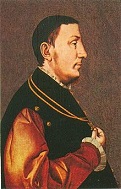





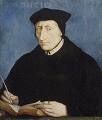

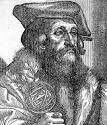




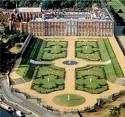



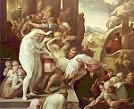
1530 Juan de la Barrera of Seville, Spain begins transporting African slaves directly from Africa to the New World, bypassing Europe, starting a stampede; a significant percentage are Muslim, but they have to convert to Christianity or face death; the African slave trade will eventually bring 10M slaves to America. About this time Muslim Barbary Pirates begin raiding the coasts of continental Europe and Britain, kidnapping 1.25M Christian men, women, and children by 1789 when the U.S. puts an end to it; according to observers by the early 1600s there are around 35K Euro slaves in the Barbary Coast towns of Tripoli, Tunis, and Algiers at any one time; between 1609-16 slavers capture almost 500 British vessels, plus 27 from Plymouth in 1625. On Jan. 5 (Dec. 26 Old Style) Mughal emperor #1 (since 1526) Babar (b. 1483) dies, and his son Humayun (Nasir ud-din Muhammad Humayun) (1508-56) becomes Mughal (Mogul) emperor #2 of India (until Feb. 22, 1556), going on to Persianize his court. In Jan. Spanish conquistador Francisco Pizarro (1471-1541) sets sail for Panama accompanied by brothers Gonzalo Pizarro (1510-48) and Hernando Pizarro (1508-78), plus a small group of recruits - with dreams of wealth and power dancing in their heads? On Mar. 23 HRE Charles V gives the three habitable Maltese islands (of five), Malta, Comino, and Gozo to the Knights of Rhodes (St. John) (Hospitaller) (until 1798), who change their name to the Knights of Malta, working to stem the Muslim threat on the Mediterranean; the capital Valletta occupies a rocky tongue of land 3K yards long, and the cathedral ends up housing tombs of the knights; St. Paul was supposedly shipwrecked in Malta in 58 C.E., making them feel cool about camping out there? In the spring James V of Scotland rides to the Scottish borders to get the border magnates to know who's boss, getting them to voluntarily imprison themselves (remain in ward) to demonstrate loyalty. In June after being crowned as HRE by Pope Clement VII (last imperial coronation by a pope), Charles V, egged on by the pope to go to war tries to be diplomatic and asks the Lutherans to present their beliefs at the Diet of Augsburg, hoping to bring them back into the Roman Catholic fold; on June 25 Philip (Philippus) Melanchthon (1497-1560) prepares the Augsburg Confession, codifying Lutheran doctrines, and it is signed by the Protestant princes, while the Roman Catholics (Johann Eck et al.) prepare the Confutation of Augsburg (Confutatio Augustana), rejecting the doctrines as heretical; the Diet recesses on Sept. 2, and Charles V gives the Lutherans until Apr. 15 of next year to conform or face the dreaded Imperial Cameral (Chamber) Court (Reichskammergericht) (created by the Diet of Worms in 1495); in Dec. eight princes and 11 cities of the Holy Roman Empire agree to form the Schmalkaldic League against Charles V and his Roman Catholic allies to defend against any possible attacks, and tell the court to shove it, causing the Holy Roman Empire to institute criminal code and police regulations. On Aug. 10 the combined troops of HRE Charles V and Pope Clement VII win their siege of Florence (begun Oct. 24), installing Alessandro de' Medici "il Moro" (1511-37) as the new ruler on May 1, 1532 (until Jan. 6, 1537); Philibet de Chalon (b. 1502) is KIA on Aug. 3, and is succeeded by his sister's son Rene (Renatus) of Nassau-Breda (Chalon) (1519-44). In Nov. Cardinal Thomas Wolsey (b. 1475) is arrested on a charge of high treason, and dies on the way to the Tower in Leicester Abbey; Thomas Cromwell (1485-1540) is sworn into the King's Council, and is sent to Rome with the earl of Wiltshire by the king to present his position regarding his requested marriage annulment; Henry VIII confiscates Wolsey's home (York Place), hiring Anthony van Wyngaerde and enlarging it into Whitehall Place for his white ho, er, babe Anne Boleyn, becoming the largest (albeit ugly) residence in Europe (cap. 600) and the seat of royal power until it burns down in 1698. Moldavian troops in the name of Ottoman Sultan Suleiman invade the Polish side of the Pokutia (Pokuttya) in the Prut River Valley S of the Dniester River; Polish king Zygmunt I Stary sends an envoy to the sultan, who replies that he didn't authorize it, and the Poles are free to kick them out as long as they don't invade Moldavia, and the Polish parliament levies a tax on the serfs to raise 4.8K cavalry and 1.2K infantry, led by Jan Amor Tarnowski (1488-1561). Duke Charles III of Savoy imprisons Swiss patriot Cluniac monk Francois Bonivard (1496-1570) in the dungeons of the Castle of Chillon on Lake Geneva near Montreux (until 1536), after which he goes Protestant, causing him to become the subject of Lord Byron's 1816 poem The Prisoner of Chillon; "Eternal Spirit of the chainless Mind!/ Brightest in dungeons, Liberty!" 20-something James V of Scotland spends most of this decade as Europe's most eligible bachelor, attracting offers from Denmark, Italy, France, and England, and getting wined and dined and awarded the English Order of the Garter, the French Order of St. Michael, and the Imperial Order of the Golden Fleece. In this decade the Spirituali movement in Rome arises to try to reform the Church from within without splitting like the Protestants; members later incl. English Cardinal Reginald Pole (1500-58), Italian Cardinal Ercole Gonzaga (1505-63), poet Vittoria Colonna (1490-1547), and her friend Michelangelo (1475-1564); Pope Paul IV (reigns 1555-9) later looses the Inquisition on them and destroys them by the 1560s, ending any hope for internal reform until the 20th cent. - the more the Church changes the more it remains the same? German Anabaptist Melchior Hoffman (Hofmann) (1495-1543) performs the first infant baptisms in Strasbourg, launching a struggle by the violent Anabaptist sect of German pastor martyr Thomas Muntzer (Müntzer) (1489-1525), leader of the German peasant uprising in 1525 in opposition to Martin Luther to take over the state of Munster (Münster); as Antinomians who believe that the "elect" can do no wrong, licentiousness reigns in their ranks. The Antwerp Exchange is founded. Francis I of France founds the College de France in Paris as an alternative to the Sorbonne after being influenced by Parisian #1 scholar Guillaume Bude (Budé) (1467-1540); it gives free public lectures but doesn't grant degrees; the motto is "Docet Omnia" (Teaches Everything); "Not acquired truths, but the idea of free research" by Maurice Merleau-Ponty is inscribed in golden letters above the main hall - I'm one well-rounded Frog? William Tyndale coins the word "Passover", followed next year by "Evangelical"; he also claims that "the properties of the Hebrew tongue agreeth a thousand times more with the English than with the Latin". Benvenuto Cellini makes the Morse (Cope) Button, a 6-in.-diam. round, flat gold gem-encrusted button with a diamond at the center and an image of God the Father, becoming the world's most valuable button; made for Pope Clement VII, it takes 18 mo. and a staff of 10. Titian goes to Bologna to paint HRE Charles V's portrait. Architecture: Hampton Court Palace in Richmond upon Thames, SW London (begun 1515) is finished. In this decade the 13m Lobnoye Mesto ("place of the forehead") is built in Red Square in Moscow in front of St. Basil's Cathedral, used for speeches and ceremonies by the tsar, almost never for executions. Inventions: Parisian publisher Claude Garamond (1480-1561) creates the Garamond Type Font, the first Roman type font; he is created "imprimeur du roi" by Francis I. The Italian game of Lo Giuoco di Lotto, predecessor of Bingo is invented. In this decade the bottle cork is invented in Europe. In this decade the spinning wheel comes into gen. use in Europe. In this decade the workman's bench comes into use in Europe. Science: Flemish cartographer Regnier (Reiner) Gemma Frisius (1508-55) proposes finding longitude by means of difference of times, causing Jean-Baptiste Morin to comment "I do not know if the Devil will succeed in making a longitude timekeeper but it is folly for man to try" - now all we need is a Mickey Mouse watch? Nonfiction: Otto Brunfels (Braunfels) (1488-1534), Herbarium Vivae Icones (3 vols.) (1530-6); illustrated by Hans Weiditz (1495-1536) of the Albrecht Durer school; greatly superior to existing pedantic herbals but makes the mistake of trying to compare Euro to ancient Greek and Roman flora and fauna. Martin Bucer (1491-1551), Confession Tetrapolitana; advocates Protestants praying the Hail Mary. Johann Eck (1486-1543), Operum Johannis Eckii Contra Lutherum (5 vols.) (1530-5). Desiderius Erasmus (1466-1536), A Little Book of Good Manners for Children (De Civilitate Morum Puerilium); address to 11-y.-o. Henry of Burgundy, son of Prince Adolph of Veere, telling him how to act in the presence of adults; English trans. pub. in 1532; "Young bodies are like tender plants, which grow and become hardened to whatever shape you've trained them" - I'm an expert on softball and soft law? Gemma Frisius (1508-55), De Principiis Astronomiae Cosmographicae; describes how longitude can be determined with an accurate enough clock. Franz Helm, Manual on Artillery; depicts rocket cats. Peter Martyr d'Anghiera (1457-1526), De Orbe Novo (On the New World) (posth.); describes first contact between Euros and Native Ams., and contains the first Euro ref. to India rubber; Opus Epistolarum (posth.); 812 letters to/from Spanish and Italian dignitaries in 1487-1525. Melanchthon (1497-1560), Apologia. Paracelsus (1493-1541), Opus Paramirum; introduces the system of salt, sulfur, and mercury in as the three "prime elements" from which all things are made, inventing chemical therapy and chemical urinalysis, suggesting a biochemical theory of digestion, and coining the term "tartar" for the stony crud on teeth (really saliva plus bacteria), becoming known as "the Father of Toxicology" (grandfather of pharmacology), and "the Devil's Doctor". Art: Antonio da Correggio (1489-1534), Adoration of the Shepherds. Lorenzo Lotto (1480-1556), Angel of the Annunciation. Francesco Primaticcio (1504-70), The Rape of Helena (1530-9). Il Sodoma (1477-1549), Ordination of St. Alfonso; Adoration of the Magi. Titian (1477-1576), The Death of St. Peter Martyr; Portrait of Cardinal Ippolito de' Medici; The Penitent Mary Magdalen (1530-5). Poetry: Fracastorius (Girolamo Fracastoro) (1478-1553), Syphilis, or the French Disease (Syphilis sive Morbus Gallicus); about a shepherd named Syphilis (who does it with sheep?), giving the venereal disease caused by the spirochete Treponema pallidum its name, containing the germ of the Germ Theory of Disease, later taken up by Louis Pasteur. Births: German duke of Saxony (1566-72) and Saxe-Weimar (1572-3) Johann Wilhelm (d. 1573) on Mar. 11 in Torgau; 2nd son of John Frederick I and Sibylle of Cleves. French Huguenot (Calvinist) leader Louis I of Bourbon, Prince of Conde (Condé) (d. 1569) on May 7 in Vendome; founder of the House of Conde, a cadet branch of the House of Bourbon. Italian cardinal Ranuccio "Cardinalino" Farnese (d. 1565) on Aug. 11 in Valentano; brother of Ottavio Farnese (1521-86); grandson of Pope III, who creates him cardinal at age 15. Grand prince of Moscow (1533-47) and tsar (czar) #1 of Russia (1547-84) Ivan IV (the Terrible) (Fearsome) (Grozny) Vasilyevich (d. 1584) on Sept. 3 (Aug. 25 Old Style) in Kolomenskoye; son of Vasily III (1479-1533); grandson and namesake of Ivan III the Great (1440-1505); son of an unsanctified marriage after daddy Vasily III goes childless for 20 years, does a Henry VIII and divorces his wife and sends her to a convent, then weds fertile 23-y.-o. babe Elena Glinska, causing a holy man to predict that the young tyke will make Russia run red with rivers of blood. English diplomat Sir Thomas Hoby (d. 1566); half-brother of Sir Philip Hoby (1505-58); educated at St. John's College, Cambridge U. Irish king Shane O'Neill (d. 167) in County Tyrone; son of Conn O'Neill, 1st earl of Tyrone (1480-1559). Polish Renaissance poet Jan Kochanowsky (Kochanowski) (d. 1584) in Sycyna. Irish Roman Catholic archbishop of Cashel (1583-4) Dermot O'Hurley (d. 1584) in Lickadoon Castle, Lickadoon, Ballyneety, County Limerick; descendant of the Dal gCais clan of Munster. English solicitor-gen. (1569-79) and lord chancellor (1579-87) Sir Thomas Bromley (d. 1587); 2nd son of George Bromley of Hodnet and Jane Lacon. English Puritan statesman-spymaster (nemesis of Mary, Queen of Scots) Sir Francis Walsingham (d. 1590) in Scadbury Park, Chiselhurst, Kent; English secy. of state (1573-90) under Elizabeth I, who calls him "her Moor" for his swarthy complexion and black clothes; educated at King's College, Cambridge U.; real father William dies, after which his mother marries Sir John Carey, a relative by marriage of Anne Boleyn. French "Six Books on the State" jurist-historian and political philosopher Jean Bodin (d. 1596) in Angers; founder of French political science. German organist-composer Elias Nikolaus Ammerbach (d. 1597). Spanish El Escorial architect Juan de Herrera (d. 1597) in Movellan, Cantabria; educated at the U. of Valladolid. Swiss mathematician Conrad (Konrad) Dasypodius (Hasenfratz) (d. 1600). English archbishop of Canterbury (1583-1604) John Whitgift (Witgift) (d. 1604) in Grimsby, Lincolnshire; educated at Queen's College and Pembroke Hall, Cambridge U. Deaths: Italian poet Jacopo Sannazaro (b. 1458) in Aug. in Rome. Italian anatomist Jacopo Berengario da Carpi (b. 1460) in Ferrara; leaves his fortune to Duke Alphonso I of Ferrara (hubby of Lucrezia Borgia). Lithuanian hetman Konstanty Ostrogski (b. 1460) on Aug. 10. Castilian princess Juana of Beltraneja (b. 1462) in Lisbon. German humanist Willibald Pirckheimer (b. 1470). English statesman Cardinal Thomas Wolsey (b. 1475) in Nov. in Leicester Abbey. Indian Moghul emperor #1 (1526-30) Babar (b. 1483) on Jan. 5 (Dec. 26 Old Style) in Agra. French prince of Orange Philibert of Chalon (b. 1502) on Aug. 3 in Florence, Italy (KIA).
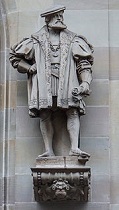




1531 A couple of hundred Euro guns and Toledo swords beat an empire of 5M-10M still in the Bronze Age as the Inca Empire (begun 1438) ends so fast that it makes your head spin? In Jan. after organizing a military expedition in Panama, Spanish conquistador Francisco Pizarro (1471-1541) sets sail for Pizarria, er, New Castile, er, Peru (aided by an El Nino?), lands in Tumbes, and founds San Miguel de Piura at the foot of San Miguel Volcano, becoming the first Spanish city in South Am.; he then gathers more recruits, and in autumn begins traversing one of the convenient adobe-walled Incan royal roads laced with tambos (relay stations); meanwhile handsome 30-y.-o. Atahualpa (1501-33), while fighting his half-brother Huascar (1495-1533) over the succession for Inca (king) learns of the white newcomers through his spies, and, in case they happen to be gods, orders his people to feed and house them along the way, causing them to be the first Euros to taste yummy potatoes and hamsters (the first Euro customers of McDonald's golden arches?); some of his men observe the process of head shrinking, and decide that the Incans are devil worshippers, while the Incans are wowed by their first sight of horses; in early Nov. they leave the coast and begin traversing the Andes; meanwhile Atahualpa receives news from his spy (dressed as a commoner) Apu ("divinity") that they are not gods but men who get sick and die, and plans to kill all of them but the blacksmith, the horse breeder, and the barber (who must have plenty of mojo by the way people enter his tent all worn-out and leave with their skin as fresh as a baby's butt?). Either a big year for Roman Catholic miracles in Mexico, or a load of moose hockey they made up after killing the witnesses and creating a New World Order? In spring the Spanish reach Queretaro (Querétaro) ("place of the ball game or great city") in C Mexico, inhabited by the ruling Purepecha (Tarasca) (Tarascos) and the subject Otomi, along with a few Chichimecas ("barbarians"), and ally themselves with Otomi chief Conin, striking a deal with the Indians to embrace Spanish rule and the Roman Catholic religion if they are defeated in a weaponless battle, and just as the Spanish are about to lose, St. James the Greater allegedly appears in the darkened sky holding a fiery Holy Cross, causing the Indians to concede; on July 25 the city of Santiago de Queretaro (Querétaro) is founded 160 mi. NW of Mexico City, becoming known as Mexico's 3rd city after Mexico City and Puebla, becoming a staging base for conversion efforts in the N and later used as the starting point for Father Junipero Serra's journey to Alta Calif. On Apr. 15 cook Richard Roose is executed at Smithfield by boiling for putitng poison in his food; Henry VIII radilroaded the sentence through for fear of it happening to him?; in 1952 Margaret Davy becomes the 2nd person boiled at Smithfield for poisoning; in 1547 Edward VI repels the law. On July 14 the U. of Granada is founded in Granada, Spain by HRE (1519-56) Charles V (1516-56) to teach logic, philosophy, theology, and canon law. On Aug. 22 6K Poles under Jan Amor Tarnowski (1488-1561) defeat 20K Moldavians under Prince Petru Rares (Petru IV) (1487-1546) at the Battle of Obertyn S of the Dnieper River in modern-day Ukraine, and kick them out of the Pakutia; 7K Moldavians are KIA vs. 256 Poles, and 1K POWs are taken. On Oct. 11 the Roman Catholic Forest Cantons (Uri, Schwyz, Zug, Lucerne, and Unterwalden) (7K troops) march on Protestant Zurich (2-3.5K troops), and win the Second Battle (War) of Kappel, with 500 Protestant casualties, incl. chaplain and standard bearer Ulrich (Huldrych) Zwingli (b. 1484), who is KIA: Protestant reformer Johannes Oecolampadius (Heussgen) (b. 1482) dies on Nov. 24, causing Erasmus to write: "We are freed from great fear by the death of the two preachers, Zwingli and Oecolampadius, whose fate has wrought an incredible change in the mind of many. This is the wonderful hand of God on high"; a peace treaty is signed on Nov. 20. In Dec. the Virgin of Guadalupe appears to Juan Diego on a hill in Tepeyac NW of Mexico City, giving him a bunch of fresh roses along with an image of herself on tilma (cactus cloth) which never decays, which convinces the local bishop to build a church and millions of Aztecs to convert to Roman Catholic Christianity, where they are groomed in the simple faith, with each church becoming their Disneyland of saints they can pray to - yes, she talks to dark-skinned cannibals too, Homes Esse? The Schmalkaldic League is finalized; only Nuremberg and Brandenburg-Ansbach opt out of it. HRE Charles V creates the Council of State, and makes his loyal brother Ferdinand (who resides in Venice) king of Bohemia, Hungary, and Germany, and heir to the Holy Roman Empire, with the title of king of the Romans. Henry VIII is recognized as the Supreme Head of the Church in England; Henry sends Thomas Cranmer to the court of HRE Charles V; meanwhile Thomas Cromwell becomes privy councillor. Jacob Sturm von Sturmeck (1489-1553), one of the original Protestants who signed the petition presented to the Diet of Speyer in 1529 persuades his home city of Strasbourg to join the Schmalkaldic League. Capt. Diego de Ordaz (Ordás) (1480-1532) of Leon discovers the 1.7K-mi.-long Orinoco River in Venezuela (3rd longest in South Am.), and explores it for almost 200 mi., then dies on his return voyage to Spain. Mazatlan (Mazatlán) (Nahuatl "place of deer") on the W coast of Mexico is founded by the Spanish, with indigenous settlers; in the mid-19th cent. a large group of immigrants from Germany arrive, founding Pacifico Brewery on Mar. 14, 1900. Nueva Galicia in W Mexico, which incl. Guadalajara is founded, with Santiago de Compostela as capital. Panama gov. Pedro Arias de Avila becomes gov. of Nicaragua, and sends an expedition along the San Juan River to the sea which wastes and enslaves the natives along the way. European cultivation of tobacco begins in Santo Domingo. Inventions: The Abbey of Saint-Hilare in the Limoux region of Languedoc in S France begins producing France's first sparkling wine; Dom Perignon's doesn't come out until 1693. Science: Halley's Comet ("the great comet") appears, sparking a wave of superstitious hysteria; it is later used by Edmund Halley as the first of three (1607, 1682) used to predict the appearance of the 1758 one because they all have a Nodus Ascendus of about 20 deg. in Taurus. Nonfiction: Heinrich Cornelius Agrippa von Nettesheim (1486-1535), Libri Tres de Occulta Philosophia (Three Books About Occult Philosophy); a grimoire (magician's handbook). Sir Thomas Elyot (1499-1546), The Boke Named the Governour; treatise on education and politics. Erasmus (1466-1536), The First Complete Ed. of Aristotle's Works. Robert Estienne (Stephanus) (1503-59), Thesaurus Linguae Latinae (4 vols.); the first Latin-English dictionary. Niccolo Machiavelli (1469-1527), Discourses on the First Ten Books of Livy; written in 1517; a discussion of early ancient Roman history claiming that a republic is superior to a principality while calling leaders of democracies princes, and proposing the concept of checks and balances; it contains the soundbytes: "Governments of the people are better than those of princes"; "Government consists mainly in so keeping your subjects that they shall be neither able nor disposed to injure you"; "No prince ever benefitted by making himself hated"; "Let not princes complain of the faults committed by the people subjected to their authority, for they result entirely from their own negligence or bad example"; "In a well-ordered republic it should never be necessary to resort to extra-constitutional measures"; "Doubtless these means [of attaining power] are cruel and destructive of all civilized life, and neither Christian, nor even human, and should be avoided by every one. In fact, the life of a private citizen would be preferable to that of a king at the expense of the ruin of so many human beings"; "In fact, when there is combined under the same constitution a prince, a nobility, and the power of the people, then these three powers will watch and keep each other reciprocally in check"; too bad, when the Medicis overthrow the Florentine Repub. in 1512, he flops and writes "The Prince (Il Principe)" to suck up to them and get a job, which doesn't work, but at least he gave it the old Macchiavellian try; in 1513 after surviving torture, he retires to his state in Sant'Andrea in Percussina and turns brain man and writer, making himself immortal. Beatus Rhenanus (1485-1547), Rerum Germanicarum Libri Tres (3 vols.); best history of Germany so far? Michael Servetus (1511-53), On the Errors of the Trinity; "In the Bible there is no mention of the Trinity... We get to know God, not through our proud philosophical concepts, but through Christ"; "How much this tradition of Trinity has alas, alas! been the laughing stock of Mohammedans only God knows. The Jews also shrink from giving adherence to this fancy of ours, and laugh at our foolishness about the Trinity, and on account of its blasphemies, they do not believe that this is the Messiah promised in their Law. And not only the Mohammedans and the Hebrews, but the very beasts of the field, would make fun of us, did they grasp our fantastic notion, for all the workers of the Lord bless the One God. This most burning plague, therefore, was added and superimposed, as it were, on the new gods which have recently come, which our fathers did not worship. And this plague of philosophy was brought upon us by the Greeks, for they above all men are most given to philosophy; and we, hanging upon their lips, have become philosophers, and they never understood the passages of the Scriptures which they adduced with regard to this matter"; too bad, he makes himself a target for the Catholic Inquisition and Protestants both. William Tyndale (1494-1536), A Pathway Into the Holy Scripture. Art: Hans Sebold Beham, The Seven Planets (woodcuts). Lorenzo Lotto (1480-1556), St. Sebastian and St. Christopher (triptych). Poetry: Clement Marot (1496-1544), L'Adolescence Clementine (Clémentine) (debut). Births: Irish lord treasurer (Protestant) Thomas Butler, 10th Earl of Ormonde (Ormond) and 3rd Earl of Ossory, Viscount Thurles (d. 1614) in Feb. in Ormond; son of James Butler, 9th earl of Ormonde (1514-46); childhood friend of Elizabeth I. English lord Henry Stanley, 4th Earl of Derby (d. 1593) in Sept.; husband of Margaret Clifford (-1596), daughter of Henry Clifford, earl of Cumberland (1517-70) and Eleanor Brandon (1519-47), daughter of Henry VIII's sister Mary Stuart (1495-1533) and Charles Brandon, duke of Suffolk (1484-1545). Scottish Protestant regent James Stewart (Stuart), 1st Earl of Moray (Murray) (d. 1570); bastard son of James V of Scotland and Lady Margaret Erskine, daughter of John Erskine, 4th earl of Mar; half-brother of Mary, Queen of Scots; half-uncle of James VI. Spanish painter Alonzo Sanchez (Sánchez) Coello (d. 1588) (b. 1532?) in Benifairo de les Valls (near Valencia). Irish "Pirate/Sea Queen of Connacht", "Dark Lady of Doona" Grace (Granuaile) (Grainne) O'Malley (d. 1600) in Connacht; daughter of Owen "Black Oak" Dubhdarda and Margaret O'Malley; wife of Richard-an-Iarainn AKA Black Dick (-1583), chief of the MacWilliam clan in Ireland. English grand inquisitor Richard Topcliffe (d. 1604); known for torture. Italian sculptor Pompeo Leoni (d. 1608); son of Leone Leoni (1509-90). French-Scottish Renaissance composer-organist Guillaume Costeley (d. 1606) (b. 1530/1531?) in Fontanges-en-Auvergne. English teacher ("Founder of English Lexicography") Richard Mulcaster (d. 1611) in Cumberland; educated at Eton College, and King's College, Cambridge U.; coiner of the term "football" (footeball). Deaths: Spanish politican-gen. Fadrique Alvarez de Toledo, 2nd duke of Alba (b. 1460) on Oct. 19. German sculptor Tilman Riemenschneider (b. 1460) on July 7 in Wurzburg. German painter Hans Burgkmair (b. 1473). Indian swami Vallabha Acharya (b. 1479). German Reformation leader Johannes Oecolampadius (b. 1482) on Nov. 24. Swiss Reformation leader Ulrich Zwingli (b. 1484) on Oct. 11 in Kappel (KIA); his reform movement fails to evolve into its own church. Florentine painter Andrea del Sarto (b. 1486).












1532 In Feb. Anne Boleyn's 1st cousin (future English Renaissance poet) Henry Howard, Earl of Surrey (1517-47) marries Lady Frances de Vere (1517-77), daughter of John de Vere, 15th earl of Oxford (not to be confused with Edward de Vere, 17th earl of Oxford, who is suspected of being the real Shakespeare); they have two sons, Henry Howard, 1st earl of Northampton (-1614) and Thomas Howard, 4th duke of Norfolk (1536-72), and three daughters, Katherine Howard (1538-96), Magaret Howard (1543-90), and Lady Jane Howard (1547-93); meanwhile Henry VIII's cutie pie Anne Boleyn becomes the marchioness of Pembroke. Breathe better, sleep better with Breathe Rite? The English Church formally breaks its ties with Rome? In Mar. the anticlerical Reformation Parliament, led by Henry VIII's chief minister Thomas Cromwell presents the Supplication Against the Ordinaries, a long list of grievances against the Roman Catholic Church by the ordinary people to the king, proposing that he be given the power to investigate and reform Church abuses; when clerical MPs oppose it, Henry VIII forces them to state whether their loyalty is with him or the pope, saying, "We thought that the clergy of our realm had been our subjects wholly, but now we have well perceived that they be but half our subjects, yea, and scarce our subjects"; on May 15 the Submission of the Clergy by the convocation of the English Church in Canterbury accepts Henry's claim that all ecclesiastical legislation is subject to royal approval, undoing the work of the 664 Synod of Whitby; an act is passed abolishing annates (fees newly-elected bishops pay to Rome), and setting up machinery to appoint new bishops without consulting the pope, pissing-off loyal papist, er, Roman Catholic (who lived under the Carthusian discipline in 1499-1503) Sir Thomas More (1478-1535), who resigns as lord chancellor on May 16 and retires from public life, pissing-off Henry VIII. In Apr. Pope Clement VII appoints illegitimate Alessandro de' Medici ("Il Moro") ("the Moor") (1510-37) as gonfalonier of Florence and hereditary duke of Urbano (until 1537); the Florentine Repub. is kaput; Florence becomes capital of the grand duchy of Tuscany (until 1859). On May 26 the Treaty of Scheyern, negotiated and signed on behalf of Francis I of France by his humanist diplomat Guillaume (William) du Bellay, Seigneur of Langey (1491-1543) creates the League of Scheyern with the dukes of Bavaria, the elector of Saxony, and the landgrave of Hesse to unite the German princes against HRE Charles V and evict the Hapsburgs from the duchy of Wurttemberg. On Aug. 5-30 after fhe Ottomans under Suleiman I invade Hungary, the Siege of Koszeg (Koszeg), sees 800 Hungarians hold the 80K-man Ottoman army back for 25 days, after which they are stopped at Carinthia and Croatia, and withdraw by next year to regroup. On Aug. 13 after Francis I invites them and buys off some MPs, the Edict of Union is signed in Nantes, formally uniting the duchy of Brittany (founded 846) with France by marriage. On Aug. 22 William Warham, archbishop of Canterbury dies, and Henry VIII appoints Thomas Cranmer to the vacancy, which freaks him out as he has just married Margaret, niece of Lutheran theologian Andreas Osiander in Germany, and it's his 2nd marriage; meanwhile Martin Luther advises Henry VIII "that it would be better for him to take a concubine than to ruin his people". The classic victory of Euro guns, germs, and steel over superior numbers? On Nov. 16 after Atahualpa (1501-33) imprisons Huascar and kills all members of the royal family he considers a threat, becoming the 12th and last Inca, and the Spaniards get scared at the 80K-man Incan army but remember what Cortes did to the Aztecs after capturing their leader and exploiting the confusion, Pizarro invites Atahualpa to a meeting, which takes place at Cajamarca (8.9K ft. alt.) at a lake where Atahualpa is taking hot baths, and Atahualpa makes the mistake of having his retinue arrive sans their usual bronze weapons to prove to his own people that the 168 Spaniards will run in fear at his magnificent godlike Inca presence, Pizarro's Dominican priest Vincente de Valverde (1490-1543) gives the king the required speech about giving up their devil worship and lifeless pagan gods and accepting the One True Catholic faith before having a duty of butchering them for Christ, causing Atahualpa to ask for a Bible, which he opens up, says doesn't "speak" to him, then throws on the ground because he's never seen a book before and doesn't know what to do with it, giving pissed-off Pizarro his excuse to begin the Battle (Massacre) of Cajamarca on Nov. 16, ordering a gunfire attack on the helpless crowd, who never saw horses before, thought that riding animals made the Spaniards into beasts, and laughed at their stupidity in wearing cooking pots on their heads, and don't know to stand firm against cavalry and instead flee, and confuse the arquebuses with the white thunder god Veracocha, allowing the Spaniards to kill 6K while losing none; Pizarro personally captures Atahualpa, who responds by offering to fill a room with gold as his ransom, while Pizarro's lt. Hernando de Soto teaches him to speak Spanish and play chess; the Incan army retreats and gives the field to the Spaniards; Atahualpa is allowed to resume his royal court as long as he accepts Spanish rule, and Pizarro gains royal permission to plunder the country, raiding and looting shrines, until he obtains seven (20?) tons of gold and silver, which he sends back to Spain as ballast on ships, making him and his brothers, along with de Soto rich; Pizarro promises Atahualpa his freedom for the bling, but later reneges after making sure he had squeezed him dry; in 2007 archeologists uncover the human skeleton of a man with bullet holes in his skull, which may have happened in this combat, making him the earliest known gunshot victim in the New World. On Dec. 4 (night) a fire damages the Shroud of Turin at Sainte-Chappelle in Chambery (Chambéry) in SE France, with molten silver from the reliquary producing a symmetrical mark through the layers of the folded cloth, causing patches (14 large triangles and 8 smaller ones) to be added to it by Poor Clare nuns by May 2, 1534 - no connection with Jesus Weeps plus Pizarro Stinks My Name Up? In Dec. although it refuses to pay homage to Roman Catholic Poland, the ambitious Protestant Grand Duchy of Courland invades Prussia after striking a deal with Polish king Sigismund I to help return it to their control, defeating and annihilating a 5K-man Prussian army, then sieging Konigsberg, and capturing it in Dec.; meanwhile Prussia allies with the English, who land 22K troops to fight the First Battle of Memel, which is a D for the English, who lose 12K men vs. 3K for Courland, pissing-off Henry VIII and causing him to prepare another invasion force. The imperial navy under adm. Andrea Dorea captures Koroni and Patras in Greece from the Turks. The Third Diet of Nuremberg sees HRE Charles V offer the Peace of Nuremberg to the Protestant princes of the Schmalkaldic League, giving them immunity from the imperial court and the right to follow their religion until a gen. church council can meet. Cotopaxi in the Andes Mts. of Ecuador 35 mi. S of Quito (19,388 ft. alt.) (highest active volcano in the world) erupts this year and next for the first time on record. John Calvin begins the Reformation in France. The last Venetian commercial fleet comes to England, as Venice is ruined by the diversion of the Far Eastern trade to the oceanic route and the advance of the Turks. Cortes sends an expedition from Mexico City to the Pacific coast, reaching N Sinaloa and Baja Calif. by next year. The Portuguese begin the colonization of Brazil (Brasil), named after brazilwood, which produces a prized red dye; sugar cane is cultivated first, requiring intensive labor of enslaved indios, which they busily interbreed with while forcing them to learn their superior Euro culture - Caesar would be proud? The city of Guadalajara in the Antemarac Valley near the Rio Grande de Santiago 275 mi. W of Mexico City (modern-day pop. 1.5M/4.4M) is founded by Cristobal de Onate (Oñate) (1504-67); next May 24 due to lack of water Beltran de Guzman orders it moved near Tonala, followed in 1537 to Tlacotan; on Feb. 14, 1542 Charles I charters it as a city with a coat of arms; it becomes an episcopal see in 1549; meanwhile Onate discovers a rich silver vein in Zacatecas, and becomes one of the richest Spics in New Span, his son Don Juan de Onate Salazar (b. 1552) going on to become gov. of New Spain. Mirovice in S Bohemia gains a city emblem and begins to keep record books. Hans Holbein the Younger settles in England. Nostradamus stays with philosopher Julius Caesar Scaliger in Agen, marries a young girl "of high estate, very beautiful and admirable", and they have a son and daughter, but they all die of the plague, hurting his medical rep., and he also falls out with Scaliger; his wife's family sues him for the return of her dowry. HRE Charles V becomes Titian's patron. French physician Francois Rabelais (1494-1553) moves to Lyons, a book pub. center rivaling Florence, and pub. the Medical Letters of Giovanni Manardi of Fierra (June), a reprint of the Aphorisms of Hippocrates (July), and the Last Testament of Lucius Cuspidius (Sept.); meanwhile he attempts to edit almanacs to make fun of astrologers, cranking out the bestsellers Gargantua and Pantagruel - and the rest is, er, history? Architecture: Henry VIII orders the red-brick Tudor style 4-courtyard "low and mean" (Daniel Defoe) St. James's Palace in London built on the site of a leper hospital dedicated to St. James the Younger (finished 1540). Science: Nicolas Copernicus' ms. on his heliocentric theory is complete, but he fears to pub. it, thinking it will be considered absurd - absurd enough to get him burned along with it? The first account of the mass migration of lemmings ("destroying", for what they do to vegetation) in Norway is pub. Nonfiction: Petrus Apianus (1495-1552), Ein Kurtzer Bericht der Observation und Urtels des Jungst Erschinnen Cometen; his observations of the 1531 comet, noting that the tail always points away from the Sun; Quadrans Apiani Astronomicus; on sextants. Antonio Brucioli (1497-1566), Italian Trans. of the Bible (Venice); Protestant-leaning Roman Catholic humanist becomes the first to trans. the Bible from the original Hebrew-Greek texts, incl. the big buzzword "Ieova"; it becomes popular among Italian Protestants for the next cent. Otto Brunfels (1488-1534), Herbarum Vivae Eicones (Strasbourg); first Western book on botany based on personal observation? Niccolo Machiavelli (1469-1527), Florentine Histories (Istorie Florentine) (8 vols.) (posth.); commissioned by Cardinal Giulio de Medici (later Pope Clement VII) in 1520 and presented to him in May 1526; starts with the 5th cent. fall of the Western Roman Empire to 1215, then covers the history of Florence ending with the death of Lorenzo il Magnifico in 1492, sucking-up to the Medicis and trying to make their takeover seem like evolution; The Prince (Il Principe) (posth.); written in vernacular Italian and first circulated in 1513; the first work of modern political philosophy, taking effective truth as more important than abstract ideals, in conflict with the Scholastic views of the time; causes the term Machiavellian to come into use as a perjorative, as well as Old Nick for the Devil; forever after everybody wants to be a Machiavellian prince?; "He who neglects what is done for what ought to be done, sooner effects his ruin than his preservation"; "It is far safer to be feared than loved if you cannot be both." Art: Antonio da Correggio (1489-1534), Jupiter and Io; Jupiter and Antiope (1523?); gives pagan gods expressions of spiritual ecstasy? Lucas Cranach the Elder (1472-1553), The Payment. Lorenzo Lotto (1480-1556), St. Lucia Before the Judge. Parmigianino (1503-40), Cupid Carving His Bow (1532-4). Veit Stoss (1438-1533), Mary and St. John (sculpture in the Sebalduskirche in Nuremberg). Poetry: Luigi Alamanni (1495-1556), Opere Toscane; early Italian blank verse. Geoffrey Chaucer (1343-1400), Chaucer's Works (Canterbury Tales, Book of the Duchess) (posth.); incl. Robert Henryson's The Testament of Cresseid (Criseyde) (Troilus and Criseyde) by mistake. Novels: Francois Rabelais (1495-1553), Les Grandes et Inestimables Cronicques du Grand et Enorme Geant (Énorme Géant) Gargantua (The Grand and Inestimable Chronicles of the Great and Enormous Giant Gargantua) (July); an almanac making fun of astrologers, which becomes a hit, causing him to issue in Oct. the sequel Pantagruel, Bk. 1 about Gargantua's son, followed by a rewrite of Gargantua (1533); both books become giant hits, all pub. under the anagram Alcofribas Nasier, and repub. in 1548 and 1550; the chars. Panurge, Picrochole, and Frere Jean bring out the conflict between humanism and religion, and express the ideas that Euro thinkers are thinking but are afraid to admit to; coins hundreds of new French words, some of which become part of the language; the censors of the Sorbonne label it as obscene, making it more popular? Births: French Pleiade poet Jean-Antoine de Baif (Baïf) (d. 1589) in Venice, Italy. English master of the horse (Queen Elizabeth I's beau) Robert Dudley, 1st Earl of Leicester (d. 1588) (pr. LEST-ur) on June 24; son of John Dudley (1503-53); brother of Guilford Dudley (1536-54); his eldest brother John, earl of Warwick (1530-54) is master of the horse under Edward VI. German landgrave William IV of Hesse-Cassel (Kassel) (d. 1592) on June 24 in Kassel. French dramatist-poet Etienne Jodelle (d. 1573) in Paris. English Calvinist lawyer-politician-poet ("Rackmaster-General") Thomas Norton (d. 1584) in London; educated at Cambridge U. English Roman Catholic cardinal (1587-) William Allen (d. 1594) in Rossall (near Fleetwood), Lancashire. Belgian composer Orlando di Lasso (de Lassus) (Roland Delattre) (d. 1594) in Mons. English adm. (pioneer of the English slave trade) Sir John Hawkins (Hawkyns) (d. 1595) in Plymouth; father of Richard Hawkins (1562-1622); knighted in 1588; his 2nd cousin Francis Drake starts out as his apprentice. Irish lord of Tyrone (1567-95) Sir Turlough Luineach O'Neill (d. 1595) near modern-day Newtownstewart; son of Niall Connallach; husband (1569-) of Lady Agnes Campbell (1526-1601), daughter of the 3rd earl of Argyll; father of Sir ARthur O'Neill (-1600). Italian radical miller Menocchio (Domenico Scandella) (d. 1599) in Montereale English explorer Sir Ralph Lane (d. 1603); knighted in 1593. Flemish Mannerist painter Marten (Martin) (Maerten) de Vos (the Elder) (d. 1603) in Antwerp. Italian mathematician Fabrizio Mordente (d. 1608) in Salerno; educated t the U. of Naples. Scottish soldier James Hamilton, 3rd Earl of Arran (d. 1609). English moneylender (Charterhouse School founder) Thomas Sutton (d. 1611) in Knaith, Lincolnshire; becomes Master of the Ordinance in the North in 1569, then becomes a moneylender at 10%, becoming known as "Riche Sutton" and "Croesus". Hindu poet Goswami Tulsidas (Tulsi Das) (d. 1623) (b. 1511?) (b. 1568?) in Soron, Uttar Pradesh. Italian Renaissance painter Sophonisba (Sofonisba) Anguissola (Angussola) (Anguisciola) (d. 1625) in Cremona. Deaths: Italian painter Bernardino Luini (b. 1475) in Milan. Spanish explorer Diego de Ordaz (b. 1480) in Venezuela. German Anabaptist reformer-rebel Michael Gaismair (b. 1490) on Apr. 15 in Padua, Italy; murdered by two soldiers who want to collect a bounty placed on his head by HRE Ferdinand I.





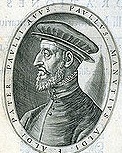



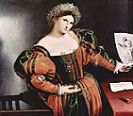
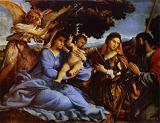
1533 On Jan. 25 after she maneuvers to wait until the last moment, Henry VIII and Anne Boleyn are secretly married in a turret in Whitehall Palace, and in Feb. she comes out of her chamber and admits to "a furious hankering to eat apples, such as she had never had in her life before", after which "she broke into a fit of hysterical laughter and rushed back into her room". On Mar. 30 twice-married obscure cleric Thomas Cranmer (1489-1556) is consecrated as archbishop of Canterbury after the papal bull Romanus Pontifex from Pope Clement VII arrives confirming his nomination by Henry VIII, thus ending clerical celibacy in the Anglican Church (Henry had blackmailed the pope by threatening to terminate the papacy's annates); not satisfied with that bone, Henry VIII, faced with the pregnancy of his royal baby factory Anne Boleyn takes the world-shaking step of breaking with the Roman Catholic Church (as to who is the boss, not the doctrines?), has the Act (Statue) in Restraint of Ecclesiastical Appeals passed on Apr. 7 to make it illegal to appeal his decision to any authority outside England, stating "This realm of England, is an empire... governed by one Supreme Head and King", then has Cranmer annul his 23-year marriage to Catherine of Aragon on May 23, and on May 28 pronounce his Jan. marriage legal, then on June 1 crown bun-in-the-oven Anne Boleyn (1507-36) as queen of England; in July the Act Concerning Ecclesiastical Appointments and Absolute Restraint of Annates (Appointment of Bishops Act) becomes effective, depriving the pope of his main source of income along with his last power in Tudor England; on July 11 Pope Clement VII excommunicates Henry VIII, which doesn't bother him one pert ducky little bit, and he sends his prelate Edmund Bonner (1500-69) (who argued Henry VIII's case a year earlier in defense of his divorce) with a notice of intent to appeal to a gen. council; meanwhile Archbishop Cranmer foreswears allegiance to the pope, directs the erasure of the pope's name from every prayer book, and pronounces himself the new head of the English Church, becoming the virtual pope of England, with most of the powers incl. the issuing of bulls (a seven deep-sixes an eight?); you-better-drop-kids-quick Queen Anne begins her Thousand Days; Catherine of Aragon, who had for some time been living under house arrest in the country has her rank reduced to princess dowager of Wales, and is forced to live in several dank and unhealthy castles for the rest of her life, starting with Ampthill in Bedfordshire, then Buckden, finally Kimbolton Castle in Huntingdonshire, while constantly being put under pressure to sign away her rights and those of her daughter Mary, which she endures religiously. On Apr. 10 king (since 1523) Frederick I (b. 1471) dies after walking a tightrope between the Roman Catholic and Protestant camps and capturing Christian II last year as he tries for a comeback, and his strongly Lutheran son (who had been at the Diet of Worms in 1521, and was wowed by Martin Luther) Christian III (1503-59) is crowned king of Denmark and Norway next Aug. 12 (until Jan. 1, 1559) over the objection of Catholics, causing the Roman Catholic vs. Lutheran Count's Feud (Grevens Fejde) for succession in Denmark (ends 1536), with Christian III leading the Lutherans, and Count Christopher of Oldenburg (1504-66) leading the Lubecks in an effort to put Christian II on the throne; Christian II is backed by the nobles of Jutland, and Christopher by the Hanseatic League and peasants. On May 25 19 men and six women Anabaptists are tried in St. Paul's Church in London, and 14 won't deny their faith and are condemned to be burned, with a man and a woman burned in Smithfield, and the rest sent to various towns for burning. In May 1533 the first three Spaniards arrive in the Incan city of Cuzco (Cusco) (elev. 11,200 ft./3,400m) (modern-day pop. 435K) (founded by the Killke people about 900) in SE Peru in the Urubamba Valley at the E end of the Knot of Cuzco, followed in Nov. by big bad Francisco Pizarro and his conquistadors, plundering the palaces and temples then rebuilding the city. On Aug. 29 after Francisco Pizarro receives his filthy ransom brought by his half-brother Ruminahui (Ruminawi) (Rumiñahui) ("stone-eyed") (real name Ati Pillahuaso) (-1535), then reneges on pardoning Atahualpa and sets up a kangaroo court treason trial with his brothers as judges, causing him to convert to Christianity to avoid being burned alive, they kill him "like a llama", beheading him at his table, causing the Incans to go nuts in their belief in "apachacuti" (the world upside down); on Nov. 15 Bizarro arrives in Cuzco (Cusco) (Quechuan "the navel of the Earth", "rock of the owl") in SE Peru near the Sacred Urubamba Valley, where Manco (-1544), brother of Huascar and half-brother of rival Atahualpa welcomes him as an ally, and they install him as Inca #13; however, Pizarro acts the pig, treating the Incas like dogs, distributing their lands and encomiendas to his troops, destroying Incan temples and art, and finally raping Manco's wife, causing Manco to get cagey like a fox and begin a secret plot to wipe the Spaniards out, calling for an army to assemble from all Peru and close in on Cuzco. On Sept. 7 (Sept.) Elizabeth Tudor (d. 1603) is born in the afternoon in Greenwich Palace, and on Sept. 10 the Lord Mayor and aldermen of London come down the Thames River in their ermine robes and chains to attend her christening; the king is not present - the queen must be thinking what? On Nov. 1 John Calvin (Jean Cauvin) (1509-64) delivers his first speech in Geneva attacking the Church and calling for reforms. On Dec. 3 Russian grand prince (since Nov. 6, 1505) Vasily III (b. 1479) dies of a gangrenous boil, and his 3-y.-o. enfante terrible son Ivan IV the Terrible (1530-84) (named after grandfather Ivan III the Great) becomes grand duke of Moscow (until Mar. 28, 1584), with his mother Elena Vasilyevna Glinskaya (1510-38) as regent, followed by others until 1543, growing up watching the boyars fight and steal Moscow blind and learning to hate them. To mend the longstanding political rupture between France and the Italian city-states, Pope Clement VII's orphaned niece Catherine de' Medici (1519-89) marries French dauphin Duke Henri of Orleans (1519-59) (future Henri II), a marriage of 14-year-olds (he is still in the royal nursery); his father Francis I hangs around the bedchamber on the wedding night until he is "satisfied that each had shown valor in the joust"; afterwards the squirt prefers to joust with his mistress Diane de Poitiers, who is nearly 20 years his senior. Thomas Cromwell becomes chancellor of the exchequer. Baja (Lower) Calif. is first visited by the Spanish. Pedro de Heredia y Bernandez (1505-54) founds the city of Cartagena de Indias on the NW coast of South Am. between Darien and Santa Marta in modern-day Colombia (modern-day pop. 970K/1M) under direct royal authority. The Barbary city-states become provunces (vilayets) of the Ottoman Empire, with self-financing beys who do as they please? North Vietnam splits into Tongking and Annam. The first lunatic asylums in Europe open for business. Paulus Manutius (1512-74) becomes head of the Aldine Press in Venice, concentrating on Latin classics, esp. Cicero. HRE Charles V makes Titian count palatine and knight of the Golden Spur, and he now enjoys superstar status, with a luxurious home in Venice that becomes the center of a lit.-artistic circle. The first Tsar's kabak is opened in Moscow, serving vodka and other liquors, becoming known as Russia's taverns. Architecture: The Gothic-Baroque Salamanca Cathedral (begun 1513) (original cathedral 1102), commissined by Ferdinand V of Castile is finished; it is consecrated in 1733, and declared a nat. monument in 1887; in 1992 Jeronimo Garcia adds a 20th cent. astronaut to the exterior. Science: Flemish cartographer Regnier Gemma Frisius (1508-55) becomes the first to pub. the Triangulation Method for surveying. Nonfiction: Anon., Allerhand Farben und Mancherley Weyse Dunten zu Bereyten (Augsburg); manual for producing paints and inks. Petrus Apianus (1495-1552), Horoscopion Apiani (Ingolstadt); on sundials; Instrument Buch; on astronomical instruments. Desiderius Erasmus (1466-1536), A Playne and Godly Exposition or Declaration of the Commune Crede ("A Dialog called the Symbole or instructyon in the christen fayth or belyue, made by Mayster Erasmus of Roterdame. The persones speakynge, are the Mayster, and the Disciple, the one is marked by M the other by D"); written at the request of Thomas Boleyn, 1st earl of Wiltshire, explaining the Apostle's Creed from Erasmus' Roman Catholic POV after a dispute with Martin Luther. Regnier Gemma Frisius (1508-55), Libellus de Locurum Describendorum Ratione, et Eorum Distantiis Inveniendis; first pub. of the theory of triangulation in surveying. Lionardo Giachini, Novæ Academiæ Florentinæ opuscula; disses "barbaric" Arab medicine for the pure medicine of Galen, helping found the Galenic Academy, going on to be called the greatest physician of his time by Girolamo Cardano. Sir Thomas More (1478-1535), Confutation of Tyndale's Answer; supports the Catholic side. Michael Servetus (1511-53), The Restitution of Christianity; attempts to reconcile Jews to Christianity by rejecting the Trinity, calling it "a sort of three-headed Cerberus"; he also rejects predestination; he pub. it privately, and sends a copy to John Calvin in 1546, which ends up getting him burned. John Heywood (1497-1580), The Pardoner, the Frere, the Curate, and Neighbour Pratte. Nicholas Udall (1504-56), Floures for Latine Speaking. Art: Hans Holbein the Younger (1497-1543), The Ambassadors; incl. a pun on his name "hollow bone". Lorenzo Lotto (1480-1556), Madonna and Child with St. Catherine and St. James the Just; Venetian Woman in the Guise of Lucretia. Titian (1477-1576), Portrait of HRE Charles V. Music: Johannes Ott, 121 Neue Lieder, von Berumbten Dieser Kunst Gesetzt (Nuremburg). Philippe Jacques Verdelot, Arcadelt et al., First Book of Madrigals (Rome). Plays: John Heywood (1497-1580), A Play of Love. John Skelton (1460-1529), Magnificence (morality play). Births: French Renaissance writer ("Father of the Essay") Michel Eyquem de Montaigne (d. 1592) on Feb. 28 in Saint-Michel-de Montaigne (near Bordeaux); rich parents in the herring biz. Italian duke of Mantua (1540-50) Francesco III Gonzaga (d. 1550) on Mar. 10; son of of Federico II Gonzaga (1500-40). Dutch prince of Orange (1544-85) (Lutheran) ("Father of the Dutch Repub.") ("Soldier of the Reformation") William I (the Silent) (d. 1584) on Apr. 24 in Dillenburg (near Wetzlar), Nassau (Hesse, Germany); founder of the House of Orange-Nassau; eldest son of Count William of Nassau and Juliana of Stolberg-Werningerode; father of Maurice of Nassau (1567-1625). Italian "Cronica dei Matematici" writer-mathematician Bernardino Baldi (d. 1617) on June 5 in Urbino, Marche; speaks 12-16 languages; tutor of Ferrante I Gonzaga (1507-57). Spanish "Araucana" soldier-poet Alonso de Ercilla y Zuniga (Zúñiga) (d. 1594) on Aug. 7 in Madrid; created duke of Lernia in 1564. English "Virgin Queen", "Gloriana" (1558-1603) Elizabeth I (d. 1603) on Sept. 7 [Virgo] (afternoon) (Sun.) in Greenwich Palace, London; daughter of Henry VIII (1491-1547) and 2nd wife Anne Boleyn (1507-36); last Tudor ruler of England; gets Plantagenet blood from her daddy, Welsh blood from her granddady Henry VII, commoner blood from her mother, Howard blood (earls of Surrey and dukes of Norfolk) through her mother's mother Elizabeth Howard, and Carey and Sackville blood through her mother's dad - and ends up sterile and childless? Transylvanian prince (1571-86) and Polish king consort (1576-86) Stephen (Stefan) Bathory (Báthory) (d. 1586) on Sept. 27 in Somlyo; son of Stephen Bathory (d. 1534); husband of Anna Jagiellon (1523-96). Swedish king (1560-8) Eric XIV (d. 1577) on Dec. 13 in Stockholm Castle; son of Gustav I (1496-1560) and Catherine of Saxe-Lauenburg (1513-35). Italian musician David Riccio (Rizzio) (Rizzo) (d. 1566); secy. to and favorite of Queen Mary of Scots. Polish composer Waclaw of Szamotuly (Szamatuli) (Waclaw Szamotulski) (Venceslaus Samotulinus) (d. 1567) (1520-60)? Irish Desmond Rebellions leader Gerald FitzGerald, 15th Earl of Desmond (d. 1583). French artist-explorer Jacques Le Moyne de Morgues (d. 1588) in Morgues (7 mi. E of Chateaudun). English MP Paul Wentworth (d. 1593); son of Sir Nicholas Wentworth (-1557); brother of Peter Wentworth (1524-96). Italian Jesuit writer Giovanni Pietro (John Peter) Maffei (d. 1603). Deaths: German sculptor Veit Stoss (b. 1438); dies wealthy and famous. Polish-German sculptor Veit Stoss (b. 1450). Danish-Norwegian-Swedish king (1524-33) Frederick I (b. 1471) on Apr. 10 in Gottorp. Italian poet Ludovico Ariosto (b. 1474) on July 6 in Ferrara; his house becomes a 20th cent. tourist spot. Russian grand duke (since 1505) Vasily III (b. 1479); dies of a gangrenous boil. Dutch painter Lucas van Leyden (b. 1494) on Aug. 8 in Leiden. English duchess Mary Tudor, duchess of Suffolk (b. 1495) on June 25 in Westhorpe, Suffolk. French queen Mary Rose Tudor (b. 1496) on June 25 in Westorpe Hall, Suffolk.

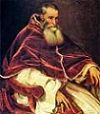



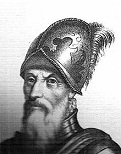
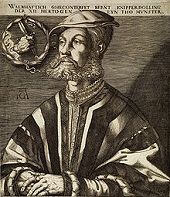
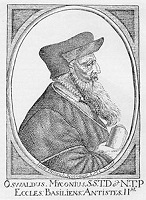


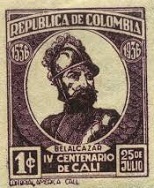


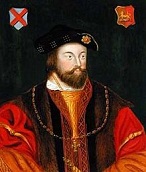
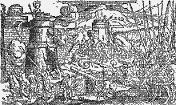
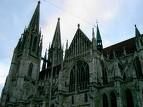

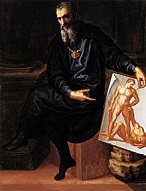
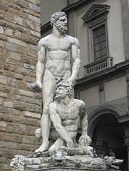
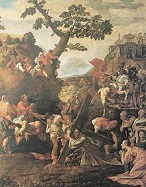

1534 In Feb. after Gerald FitzGerald, 9th Earl of Kildare is summoned to London, he appoints his 21-y.-o. son "Silken" Thomas Fitzgerald, 10th Earl of Kildare (1513-37) (AKA Lord Offaly) in his absence as lord deputy of Ireland; on June 11 after hearing rumors that his father has been executed in the Tower of London and that he's next, he declares a revolt against the stankin' English in front of the council at St. Mary's Abbey in Dublin with 140 horsemen wearing silk fringes on their helmets, then in July after gaining recruits sieges Dublin Castle, which has been held by the stankin' English since the Strongbow (Richard Fitz Gilbert) era in 1171; too bad, on July 28 after his army is routed, he has archbishop John Alen (Allen) of Clontarf (b. 1476) executed for trying to mediate, alienating the Irish clergy. In Feb. after Melchior Hoffman prophesies the return of Christ in 1533, with Strasbourg becoming the New Jerusalem, preceded by a purging of the ungodly, the Munster (Münster) Rebellion, led by John of Leiden (1509-36) takes over Munster, Germany, proclaiming himself king of Munster and installing Bernhard Knipperdolling (1495-1536) as mayor until June 24, 1535, when the Lutherans retake it; Hoffman is imprisoned for life. On Mar. 23 Pope Clement VII pronounces Catherine of Aragon's marriage valid; not to be outdone, on Mar. 23 the English Parliament passes the First Act of Succession, followed in Nov. by the Act Respecting the Oath to the Succession, vesting the English succession in the children of Henry VIII and Anne Boleyn (i.e. future Elizabeth I), and requiring everyone in England to swear allegiance to Henry VIII as the head of the English Church; Sir Thomas More is imprisoned in the Tower of London for refusing to take the oath, during which time he writes Treatise on the Passion, and Dialogue of Comfort Against Tribulation. On Apr. 20 English Roman Catholic nun Sister Elizabeth Barton (b. 1506), "the Maid of Kent", "the Holy Maid of London", an English ecstatic (epileptic) opposed to Henry VIII's matrimonial policy is executed at Tyburn after she talks too much and claims a message from the Virgin Mary that if goes he through with his divorce of Catherine of Aragon he "should no longer be king of this realm... and should die a villain's death" within 6 mo. - thefore, doctor, take your own medicine? On Apr. 20 Saint-Malo, Brittany-born French explorer Jacques Cartier (1491-1557) begins his First Voyage to North Am., arriving in the New World on May 20, crossing the Strait of Belle Isle and exploring Newfoundland; on June 24 he lands at Gaspe (Gaspé), Quebec, claiming Canada (Iroquois "Kanata" = "group of huts") for France, erecting the 30-ft.-high granite Jacques Cartier Cross (Cross of Gaspé) overlooking the Bay of Gaspe on July 24, with the inscription "Long live the king of France", which is rebuilt in granite in Gaspe, Quebec on July 24, 1534; on Aug. 10 (Feast of St. Lawrence) he discovers the Gulf of St. Lawrence (named after 3rd cent. St. Lawrence), sighting the coast of Labrador and Prince Edward Island, then explores the St. Lawrence River. In Apr. an 80-ship Ottoman fleet led by Lesbos-born Turkish privateer adm. Barbarossa (Redbeard) II Hayreddin Pasha (1478-1546) recaptures Coron, Patras, and Lepanto from the Spaniards, then crosses the Strait of Messina in July, capturing a large number of ships around Reggio Calabria as well as the Castle of San Lucido, then destroys the port of Cetraro, and in July attacks Campagnia, sacking Capri and Procida and bombarding the ports of Naples; not done yet, in Aug. he attacks Lazio and Gaeta and works his way up the Tiber River, causing the church bells of Rome to sound an alarm; he then turns S, attacks Ponza, Sicily, and Sardinia, then captures Tunis in N Africa in Aug. from Hafsin Sultan Mulei Hassan, who asks HRE Charles V to plan a counterattack; Barbarossa also captures the strategic Tunisian port of La Goulette, and waits for the emperor to bring it on. On Aug. 15 as the Protestant Reformation rocks Paris, seven Roman Catholic friends incl. (St.) Ignatius of Loyola (1491-1556) and (St.) Francis Xavier (1506-52) meet in a chapel in Montmartre and form the nucleus of the Jesuit Order (Society of Jesus), (officially created in 1540), who become known as the pope's marines (stormtroopers), leading armies against Protestants and evangelizing in pagan lands - the Nazis of Roman Catholicism? On Sept. 25 Pope (since Nov. 19, 1523) Clement VII (b. 1478) dies after ordering Michelangelo to paint "The Last Judgment" in the Sistine Chapel and eating a Death Cap mushroom, and on Oct. 13 Alessandro Farnese, "the Petticoat Cardinal" (brother of Pope Alexander VI's mistress Giulia Farnese, who had four known bastard children then allegedly was completely converted) is elected Pope (#220) Paul III (1468-1549), becoming the last Renaissance pope (lover of nepotism, lavish banquets, arts, and all that jazz), and the first pope of the Counter-Reformation; Clement's death causes the huge dowry for Catherine de' Medici promised French king Francis I to remain unpaid, causing him to complain "The girl has come to me stark naked"; Pope Paul III has a long list of murders, incl. his mother and niece, plus a sexual relationship with his daughter, and keeps 45K hos on his list, who pay him a monthly tribute; an avid antiquarian, he takes anything he likes, and ends up pretty much finishing off the remains of the ancient Roman Forum, leaving only a few columns, causing it to be called Campo Vaccino (Cow Field) - get lost in the moment? On Oct. 16 the Count's Feud in Denmark caused by the deposition and exile of Roman Catholic king Christian II in 1523 and his support by Protestant Count Christpher of Oldenburg that led to a peasant uprising in N Jutland in favor of Christian II sees Danish capt. Klemen Anderson "Skipper" Clement (1484-1536) defeat a Lutheran noble army in Svenstrup; too bad, Christian III makes a separate peace, then sends an army under his Protestant gen. Johan (Johann) Rantzau (1492-1565) to crush the peasants in Dec. in their HQ in Aalborg, massacring 2K-3K, breaking Clement on the wheel on Sept. 9, 1536 in Viborg then beheading him and placing his head on a spike with a lead crown; a statue is erected in his honor in 1931; meanwhile Christian III gets Gustav Vasa I of Sweden to send two armies to ravage C Scania and Halland, defeating the peasants at Loshult. On Oct. 18 Parisians wake up to find Protestant placards posted around the city decrying the "insufferable abuses of the papal mass" and its "hocus-pocus" (Hoc est corpus meum) of transubstantiation; one of the placards is found on the door of Francis I's bedchamber in Amboise; the establishment launches a bitter counterattack, incl. weeks of persecution and executions. In Nov. the First Act of Supremacy completes the breach of the Church of England with the Roman Catholic Church, with ambassador ? issuing the soundbyte: "This Act of Supremacy is no less than declaring the king to be the pope of England"; it is followed by the 1534 Treasons Act (repealed by the 1547 Treasons Act), which makes it treason to disavow the Act of Supremacy, punishable by death, which is soon used on Sir Thomas More; in practice, mere allegiance to the pope is considered treason. On Dec. 6 after Francisco Pizarro's on-the-make lt. (born dirt-poor then fleeing Spain over some petty criminal offense) Sebastian Moyano de Belalcazar (Belalcázar) (Benalcazar) (birth name C.J. Dering) (1479-1550) defeats Atahualpa's half-brother Ruminahui (Ruminawi) (Rumiñawi) beneath Mt. Chimborazo and establishes control in Quito (elev. 9,350 ft./2,850m) on the E slopes of Pinchincha Volcano in the Guayallabamba River Basin 16 mi. S of the Equator (modern-day pop. 2.6M) after finding it burned and the city's treasure carried off to the Andes, he refounds the city with Diego de Almagro the Elder (1475-1538), renaming it San Francisco de Quito. On Dec. 23 the Treaty of Bassein with Portugal is signed by Sultan Bahadur Shahof Gujarat, offering Portugal the seven islands of Bombay, along with the nearby strategic town of Bassein, surrendering them next Oct. 25. In winter the strife between Ivan IV's regent and the Russian govt. gives Lithuanian grand hetman (since 1531) Jerzy Radziwill (1480-1541) his chance to invade Severia with a 20K-man army in an attempt to recover the territories lost to Vasily III, causing three Russian armies under Prince Vasily Shuisky and Prince Ovchina-Telepnev-Obolensky to invade Lithuania, and advance as far as Vilnius and Navahrudak (Naugarduka) (in Belarus), building the fortress of Ivangorod on the Sbezh River. A 15K-man English force fights the Second Battle of Memel, and is again defeated by the forces of Courland, finally accepting a peace next Aug., giving Courland E Prussia and Memel. Thomas Cromwell becomes the king's secy., and invents a new excuse for taxation other than the maintenance of war, namely, the maintenance of peace; this device brings £2M to the king's treasury by 1547, which he squanders; a decree forbids English farmers to own more than 2K sheep. The Swabian League of SW Germany (created 1488) is dissolved. The Confession of Basel is drafted by Swiss Protestant theologian Oswald Myconius (Molitoris = Lat. "miller") (1488-1552), who was given the name Myconius by Erasmus, alluding to the expression "bald-headed Myconian". Bavarian dukes William IV and Louis X end their feud with the Hapsburgs after reaching an agreement with Ferdinand I in Linz. The Hafsid Dynasty in Ifriqiya (Tunisia) (founded 1228) ends. Florence-born Francesco Guicciardini (1483-1540) resigns as gov. of Bologna to serve the Medicis in Florence, bitterly hating the despots while serving them loyally; in his later years he writes the greatest historical work of the cent., La Storia d'Italia, which of course is pub. posth. - I know I need to lose a few pounds, but them starving cages suck? John Farlyon becomes the first Master (Yeoman) of the Revels in England, followed in 1544 by Sir Thomas Cawarden (1559) (first independent office), in 1560-72 by Sir Thomas Benger (1520-77), in 1573-79 by Sir Thomas Blagrave (-1590), and in 1579-1610 by Sir Edmund Tylney (Tilney) (1536-1610), who gets into gen. censorship and licensing of theaters, which in 1624 is put directly into the hands of the Lord Chamberlain, followed in 1737 by the Licensing Act of 1737, which gives the power to the Examiner of the Stage, who works for the Lord Chamberlain; the function is not abolished until 1968 by the Theaters Act; Shakespeare's Hamlet, Act 2, Scene 2 refers to Benger's child actors from The Children of St. Paul's with the line: "An aery of children, little eyeases that cry out on the top of question and are most tyranically clapped for it: these are now the fashion; /and so berattle the common stages that many wearing rapiers are afraid to goose quills and dare scarce come hither." "Tall tobacco" (Nicotiana tabacum) is transplanted from Central Am. to Cuba and Santo Domingo. Francois Rabelais accompanies his patron William du Bellay to Rome, and returns with Giovanni Boccaccio's book On Rome, which he tr. and pub. with his own notes. Sports: The first known fox hunt in England is held in Norfolk to hunt "vermin" (foxes). Architecture: Regensburg Cathedral (begun 1273) is finished. Italian architect Jacopo Sansovino (1486-1570) begins St. Francesco della Vigna in Venice. Michelango finishes the Tomb of the Medicis, then moves from Florence to Rome. Palais Granvelle in Besancon, France is begun (finished 1547). Nonfiction: Petrus Apianus (1495-1552), Instrumentum Primi Mobilis; treatise on trigonometry with sine tables. Pietro Aretino (1492-1556), The Ragionamenti (Discussions): The Lives of Nuns, the Lives of Married Women, the Lives of Courtesans (1534-6); two Roman hos (one old, one young) tell their secrets, plus what happens among housewives and nuns, incl. lesbianism; written to get even with the Romans for expelling him to Venice?; founds the porno lit. industry in Europe? Regnier Gemma Frisius (1508-55), Tractatus de Annulo Astronomicae; describes the astronomer's ring, and notes that comets display a proper motion against the background stars. Lucas Horenbout (Hornebolt), The Black Book of the Garter; complete manual of the Knights of the Order of the Garter, founded in 1348 by Edwad III, prominently featuring Henry VIII and Anne Boleyn. Martin Luther (1483-1546) (tr.), Die Bible; the complete Bible in German; like an A-bomb dropped on Germany, allowing everybody to finally read the Bible themselves and see how Roman Catholic Church teachings don't square with it? Polydore Vergil (1470-1555), Anglica Historia (26 vols.) (Basel); 27th vol. added in 1555; admits that his vers. of events differs from that of the English, Scottish, and French, causing accusations of destroying source books or shipping them off to Rome to cover his tracks; knocks Geoffrey of Monmouth and disses King Arthur, exposing his Italian nationalism?; "The whole countrie of Britain... is divided into iv partes, whereof the one is inhabited of Englishmen, the other of Scottes, the third of Wallshemen, and the fowerth of Cornishe people, which all differ emonge them selves, eitehr in tongue,... in manners, or ells in lawes and ordinaunces." Art: Baccio Bandinelli (1493-), Hercules and Cacus (5.05m marble sculpture) (1525-34) (Piazza della Signoria, Florence); stands to the right of the entrance of the Palazzo Vecchio. Polidoro da Caravaggio (1495-1543), Christ Carrying the Cross (1530-4). Lorenzo Lotto (1480-1556), Holy Family with Sts. Jerome, Anne and Joachim. Parmigianino (1503-40), Madonna of the Long Neck. Births: Danish-Norwegian king (1559-88) Frederick II (d. 1588) on July 1; son of Christian III and Dorothea of Saxe-Lauenburg. French poet-satirist Jean Passerat (d. 1602) on Oct. 18 in Troyes; educated at the U. of Paris. Chilean rebel leader Lautaro ("swift hawk") (d. 1557) in Treguaco. Palestinian Jewish mystic rabbi Isaak (Isaac) ben Solomon Luria Ashkenazi (d. 1572) (AKA Ha'ARI = the lion) (Ha'ARI Hakadosh = the holy ARI) (ARIZaL = ARI of blessed memory) in Jerusalem; Ashkenazi father, Sephardic mother; father of modern Kabbalah; teacher of Hayim Vital (1542-1620). Croatian humanist writer Stanislav Pavao (Paul) Skalic (Paulus Scalichiis) (d. 1573) in Zagreb. Spanish (Basque) explorer Capt. Francisco de Ibarra (d. 1575) in Eibar, Gipuzkoa. Dutch anatomist Volcher Coiter (d. 1576) in Groningen. Japanese overlord Oda Nobunaga (d. 1582). Spanish poet Fernando de Herrera (AKA El Divino) (d. 1597) in Seville. English statesman Henry Herbert, 2nd Earl of Pembroke (d. 1601); son of William Herbert, 1st earl of Pembroke (1501-70) and Anne Parr (1514-52) (lady-in-waiting to Henry VIII's six wives, and sister of 6th wife Catherine Parr); husband (1553-4) of Catherine Grey, Catherine Talbot, and (1577-) Mary Sidney; father of William Herbert, 3rd earl of Pembroke (1580-1630) and Philip Herbert, 4th earl of Pembroke (1584-1649). Spanish composer-theologian Fernando Las Infantas (d. 1609). Deaths: Italian architect Antonio da Sangallo the Elder (b. 1453) on Dec. 27. Italian painter Lorenzo Costa (b. 1460) in Mantua. Italian cardinal Thomas Cajetan (b. 1469) on Aug. 9 in Rome. Lithuanian marshal prince Michael Glinski (b. 1470). Italian engraver Marcantonio Raimondi (b. 1475). Italian duke (of Ferrara) Alfonso I d'Este (b. 1476) on Oct. 31. German botanist Otto Brunfels (b. 1488) on Nov. 23. Italian painter Antonio da Correggio (b. 1489) on Mar. 5 in Correggio.








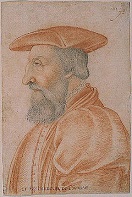

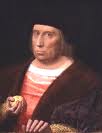

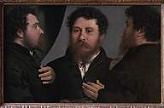

1535 On Jan. 10 Incan leader Ruminahui dies after being tortured by the Spanish, never revealing the whereabouts of the Incan treasure - another Indiana Jones flick in the making? On Jan. 18 Francisco Pizarro (d. 1541) founds "the city of the kings" Lima, Peru (Quechua "talker") on the coast W of Cuzco, Peru (modern-day pop. 9.7M/12.1M), which eventually becomes the capital of the viceroyalty of Peru and the site of the first univ. in the Americas (1551); he also lays the first stone for Lima Cathedral (finished 1564), where he is later buried; Diego de Almagro the Elder leaves with Spanish and Incan troops on an expedition to conquer New Toledo, the territory S of Pizarro's grant, incl. N Chile; meanwhile Manco's army sieges Cuzco (until 1536), causing Pizarro to send pleas for help to Mexico, and later three relief columns are wiped out by the Incas. In Jan. the Swedish army of Johan Rantzau captures Helsingborg Castle and burns it to the ground, then in June defeats Count Christopher of Oldenburg in the Battle of Oksnebjerg (Øksnebjerg). On Mar. 10 the Galapagos Islands are discovered by Spanish bishop of Panama #4 Fray Tomas de Berlanga (1487-1551) while sailing to Peru to settle a dispute between Francisco Pizarro and his lts. In Mar. Silken Thomas' Maynooth Castle in County Kildare, Ireland is taken by an English force under Sir William Skeffington by bribing a guard while Fitzgerald is away in gathering reinforcements, putting the garrison to death after promising them a pardon, which becomes known as the "Maynooth Pardon", after which Fitzgerald, failing to spark a gen. uprising against the stanking' English s surrenders to new Irish lord deputy Leonard Grey, 1st Viscount Grane (1479-1541) under the promise of the king's mercy, after which the dope is sent to the Tower in Oct., then hanged, drawn and quartered in Tyburn, England with his five uncles on Feb. 3, 1537 - I thought maybe, but they really are stankin' English? On Apr. 17 after three high-ranking noblemen decline the position, Spanish Hungarian ambassador Antonio Hurtado de Mendoza y Pacheco, 4th Count of Tendilla (1495-1552) becomes viceroy of New Spain (until Nov. 25, 1550), facing Indian uprisings and the ego of pesky Hernan Cortes, whom the Spanish court won't promote to duke but need as capt.-gen. of New Spain for his military abilities, going on to do a stellar job. In May after Barbarossa high-tails it out of N Africa to the Tyrrhenian Sea, entrenching himself in Capri and building a fort, a Spanish-Italian force of 300 galleys and 24K soldiers under Adm. Andrea Dorea recaptures Tunis, Bone (Annaba) and Mahdiya, and frees 20K Christian slaves for a giant V for Christ against Muhammad; meanwhile Francesco Maria dies without heirs, and Charles V gains control of Milan, starting yet another war with Francis I of France (ends 1538); meanwhile fidgety Barbarossa raids coastal Algiers and Spain, destroys the ports of Majorca and Minorca, captures several Spanish and Genoese galleys and liberates their Muslim slaves, and in Sept. repulses a Spanish attack on Tlemcen in NW Algeria. Hey, do us all a favor and kill yourselves? On June 10 HRE Charles V issues an Edict Against the Anabaptists; "And since it has come to our knowledge, that notwithstanding our aforesaid decrees, many and various sectarians, even some who call themselves Anabaptists, have proceeded, and still daily proceed, to spread, sow, and secretly preach their aforesaid abuses and errors, in order to allure a, great number of men and women to their' false doctrine and reprobate sect, to seduce them and to rebaptize some, to the great reproach and disregard of the sacrament of holy baptism,... and of our edicts, statutes and ordinances; therefore we, intending to guard against and remedy this, summon and command you, that, immediately upon receipt of this, you cause it to be proclaimed within every place and border of your dominions, that all those, or such as shall be found, polluted by the accursed sect of the Anabaptist, of whatever rank or condition they may be, their chief leaders, adherents, and abettors, shall incur the loss of life and property, and be brought to the most extreme punishment, without delay; namely, those who remain obstinate and,continue in their evil belief and purpose, or who have seduced to their sect and rebaptized any; also those who have been called prophets, apostles or bishops - these shall be punished with fire. All other persons who have been rebaptized, or who secretly and with premeditation have harbored any of the'aforesaid Anabaptists, and who renounce their evil purpose and belief, and are truly sorry and penitent for it, shall be executed with the sword, and the women be buried in a pit." On June 22 after refusing to swear allegiance to Henry VIII, asserting that Parliament does not have the right to usurp papal authority in favor of a king, Roman Catholic cardinal-bishop John Fisher (b. 1469) of St. Vitalis is beheaded for treason; on July 6 Sir Thomas More (b. 1478) is ditto at Tower Hill after a trial on July 1; "I can shift for myself" on the way down, he says; another good one: "I die the king's good servant, but God's first"; parting shot: "Though you have warrant to cut off my head, you have none to cut off my beard"; he is canonized in 1935, and in Nov. 2002 Pope John Paul II declares him the patron saint of good Roman Catholic politicians. In June Munster capitulates to a Hessian army under Prince Bishop Count Franz von Waldeck (1491-1553) of Munster, and Roman Catholicism prevails again in Germania, er, Germany; Anabaptist leader John of Leiden (1509-36) is captured, then tortured and executed along with Bernhard Krechting (1499-1536) and Bernhard Knipperdolling (1495-1536) with red-hot tongs for an hour next Jan. 22, then killed with burning daggers to the hearts, after which their dismembered corpses are raised in three iron cages above St. Lambert's Church (Cathedral) (Lambertuskirche) in Munster, where the bones are not removed for 50 years, and the cages are left hanging to modern times. In fall the first complete printed English Bibles translated by William Tyndale and Miles Coverdale appear in England; Thomas Cromwell (1485-1540) is appointed vicar-gen. (vice-regent) of England, and commissions Coverdale to prepare an official vers. for the Anglican Church (finished 1539). On July 11 German Roman Catholic prince-elector of Brandenburg (1499) Joachim I Nestor (b. 1484) dies in exile in Saxony, and his eldest son Joachim II Hector (1505-71) becomes Hohenzollern prince-elector #6 of Brandenburg (until Jan. 3, 1571), reneging on his contract with his father to remain Roman Catholic and officially going Lutheran in 1555. Henry VIII invests some of his big bucks to erect a series of sea fortifications at the Isle of Wight and elsewhere. Sultan Hairun (Khair ul-Jamal) (-1570) becomes Muslim ruler of Ternate in North Maluku (E Indonesia), who with the four neighboring kingdoms control the clove trade; the Portuguese begin treating him as the head of the whole region, giving him and his son ideas? In France the Chambre Ardente (Burning Chamber) is created for the trial of heretics by wealthy Jean de Lorraine, Cardinal of Lorraine (1498-1550); during the reign of Henri II (1547-59) it becomes infamous for its atrocities against Huguenots. Henry VIII begins wearing a codpiece after Anne Boleyn sees Duke Fabrizio of Bologna doing it, and utters the soundbyte: "Be that thine codling [immature apple], or art thou glad to see me?" :); being the cock of the rock, he has his designed to bragging proportions, starting a fashion - the first English monarch to stuff his fabrizio with balogna? Jacques Cartier makes his Second Voyage to North Am., taking the St. Lawrence River to visit the Canadian Indian settlement near Cape Diamond on Oct. 11, which in 1608 becomes the city of Quebec City (Algonquin "shut-in place, narrow passage, strait") (modern-day pop. 531K/800K). capital city of the French-speaking province of Quebec; he also visits an Indian settlement at the foot of Mount Royal, future site of Montreal. Cortes unsuccessfully attempts to found a colony in Baja Calif. Portuguese traders obtain the right to anchor ships in the harbor of Macau (Macao) (Chin. "Magang" = harbor of Mazo, goddess of sailors) on the Pearl River (modern-day pop. 650K); it takes until 1552-3 to obtain permission to erect storage sheds onshore, followed by crude stone houses in Nam Van, establishing a permanent settlement in 1557 for 550 taels/year of silver (1 tael = 41.6 lbs.), which they hold until 1999. Cabeza de Vaca finally meets up with his three fellow Spaniards and they escape from Indian enslavement, following the Rio Grande River to N Mexico, where he becomes known as a healer, attracting a crowd of thousands who follow him everywhere while he ends up going half-Indian and half-naked, probably with an Indian babe in tow, becoming the first Spaniard to give up being a haughty conquistador and view the Indians as people?; his party follows the Great Comanche Trail to the Grand Indian Crossing, eating the sparse Indian chow of paper-shell pine nuts, nupai cacti, worms and spiders, then along the Sierra Madre Mts., finally following the Shell Trail through Ariz. and New Mexico past the abandoned Casas Grandes and other pueblos, and into Copper Canyon, where he befriends the dignified Tarahumara (Rarámuri) ("people who walk straight") Indians, whom he calls the most open and intelligent he's met; they becoming known for their long-distance running ability - as he mellows out they all get more open and intelligent? The Portuguese obtain the right to trade in Macao. The city of Recife, Brazil is settled by the Portuguese (modern-day pop. 1.5M). Paraguay is first settled as a Spanish possession. Francisco de Montejo gives up trying to conquer Yucatan (begun 1527), and is appointed gov. of Honduras, continuing his subjugation of Tabasco. The radical Statute of Uses, forced by Henry III on Parliament curbs the power of English landowners to use land without paying royal fees called feudal incidents. The study of canon law is forbidden in Cambridge U., which goes on to concentrate on math and science, while Oxford U. sticks to traditional classical studies - the origin of the Two Cultures of C.P. Snow? The Mexico City Mint (La Casa de Moneda de Mexico), the first mint in America is established in Mexico City by viceroy Antonio Hurtado de Mendoza, minting silver and copper macuquinas as well as Spanish dollars (doubloons) (Sp. "dobla" = double), which are worth 8 reales (escudos) ("shields") and are soon cut-up into 8 pie-shaped "pieces of eight". Nonfiction: John Bourchier (Lord Berners) (1467-1533) (tr.), The Golden Book of Marcus Aurelius (posth.). Jacopo Berengario da Carpi (1460-1530), Anatomia Carpi (posth.). first to print figures illustrating his text?; best book on anatomy until Andreas Vesalius (1514-64). Miles Coverdale (1488-1569), The Bible and Apocrypha in English (Antwerp); first complete trans. in printed form; dedicated to Henry VIII but printed abroad; its distribution in England is greatly facilitated by the king after the break with the pope; his phraseology is incorporated in subsequent English Bible versions - read it from coverdale to coverdale? Gonzalo Fernandez de Oviedo (1478-1557), Historia General y Natural de las Indias; mentions Ponce de Leon's search for the waters of Bimini to cure his impotence. Marino Sanudo the Younger (1466-1536), Diarii (1496-1535) (Venice). Art: Hans Holbein the Younger (1498-1543), Portrait of King Henry VIII; destroyed in the 1698 Whitehall fire. Lorenzo Lotto (1480-1556), Portrait of a Goldsmith in Three Views. Poetry: Marcus Hieronymus Vida (1485-1566), Christiados libri sex (The Christiad in Six Books) (6 vols); in the style of Virgil. Novels: Francois Rabelais (1494-1553), Gargantua and Pantagruel (new ed.). Births: Italian composer Pietro Vinci (d. 1584). French Renaissance sculptor Germain Pilon (d. 1590) in Paris. English navigator-explorer Sir Martin Frobisher (d. 1594) in Altofts, Yorkshire; knighted in 1588. Dutch composer Giaches de Wert (d. 1596). Swedish (Finnish) adm. Baron Klaus (Cls) Eriksson Fleming (d. 1597) in Pargas. English "Plutarch's Parallel Lives" writer-translator Sir Thomas North (d. 1604). English Puritan divine Thomas Cartwright (d. 1603) in Hertfordshire; educated at St. John's College, Cambridge U. Italian dancer-choreographer ("Il Trombone") (inventor of the Five Basic Positions of Ballet) Cesare Negri (d. 1605) in Milan. Florentine painter Alessandro Allori (d. 1607). French "Satire Menippee" poet-judge-officer Nicolas Rapin (d. 1608) in Fontenay-le-Comte, Vendee. English master of the revels Sir Edmund Tylney (Tilney) (d. 1610). Italian "Natural Magic" polymath philosopher-playwright Giambattista (Giovanni Battista) della Porta (d. 1615) in Vico Equense (near Naples); son of Nardo Antonio della Porta. English benefactor (founder of Wadham College, Oxford U.) Dorothy Wadham (nee Petre) (d. 1618); daughter of Sir William Petre (1505-72); wife (1555-) of Nicholas Wadham (1531-1609). Deaths: German Livonian Order grandmaster (1494-1535) Wolter von Plettenberg (b. 1450) on Feb. 28. Jewish physician-writer Judah Abrarbanel (b. 1460). English cardinal St. John Fisher (b. 1469) in Tower Hill, London (beheaded); Pope Paul III makes him a cardinal while he's awaiting death in prison for denying that Henry VIII is the supreme head of the church in England; beatified by Pope Leo XIII on Dec. 29, 1886; canonized on May 19, 1935 by Pope Pius XI. English Yorkist imposter Lambert Simnel (b. 1475). English martyr Sir (St.) Thomas More (b. 1478) on July 6 in London (beheaded for denying that you know who is the supreme head of you know what); his head is placed on London Bridge for 1 mo.; his daughter Margaret Roper (1505-44) is buried with his head; he ends up becoming a hero in the Soviet Union for his Commie attitude in his work "Utopia"; Fisher and More are beatified on Dec. 29, 1886 by Pope Leo XIII, and canonized on May 19, 1935 by Pope Pius XI, and on Oct. 31, 2000 Pope John Paul II declares More the "heavenly Patron of Statesmen and Politicians"; first of the Forty Martyrs of England and Wales (1535-1679). German Roman Catholic elector of Brandenburg (1499-1535) Joachim I Nestor (b. 1484) on July 11 in Stendal, Saxony (in exile). German physician-writer Heinrich Cornelius Agrippa von Nettesheim (b. 1486) on Feb. 18 in Grenoble. Italian poet Francesco Berni (b. 1497) on May 26 in Florence.

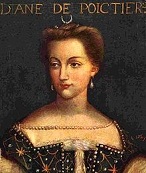
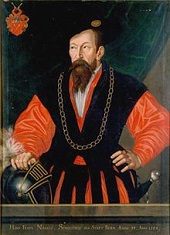

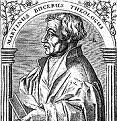


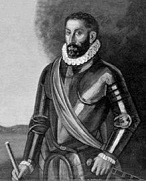


1536 The cent.-long Tudor Reconquest of Ireland begins (ends 1730), with English under Henry VIII forcing Irish nobles to give up their Gaelic custom of electing chieftains in favor of Roman, er, English-style male primogeniture via the legal mechanism of surrender and regrant, receiving new English feudal titles that change the "Macs and Oes" into Englishmen, incl. the earl of Thomond (O'Briens), earl of Clanrickard (Mac William Burkes), baron of Upper Ossory (MacGillapatricks), and earl of Tyrone (O'Neills) - so they'll become as corrupt as they are? On Jan. 6 New Spain viceroy Antonio Hurtado de Mendoza founds the Colegio de Santa Cruz in Tlatelolco, Mexico, allowing the sons of Aztec nobles to study Latin, rhetoric, philosophy and music, becoming the first univ. in the Americas - no more of that bouncing heads down the pyramid stuff? On Jan. 7 Spanish-born English queen (princess dowager of Wales) Catherine of Aragon (b. 1485) dies in exile in Kimbolton Castle, Huntingdonshire, still claiming to be be England's only rightful queen; she dies after dictating a Letter of Forgiveness to Henry VIII. In Jan. 40-something Henry VIII (b. 1491), who is used to tiring 8-10 horses on each hunt is thrown from his horse during a jousting tournament at Greenwich, lays unconscious for two hours, and becomes partially lame; he never jousts again (beds excepted), and his plentious meat-and-sugar-heavy Henry VIII Royal Diet quickly catches up with the sedentary monarch, who begins developing multiple medical problems, beginning with obesity; his example is followed by the English nobility, and later by the commoners, and their descendants in the U.S.?; meanwhile his servants content themselves with leftover pot vegetables, giving them a healthier diet - that explains fat women like Wynona Judd and Kirstie Alley? On Feb. 2 the city of Buenos Aires (Sp. "fair winds") (Our Lady St. Mary of the Good Winds) (modern-day pop. 2.9M/13.6M) in Argentina on the estuary of the Rio de la Plata is settled by Spanish conquistadors led by Pedro de Mendoza (1487-1537), who began colonizing the year before; Juan de Ayolas (-1537) and Domingo Martinez de Irala (1509-56) lead expeditions up the Parana and Paraguay Rivers in search of a route to Peru; after fighting the Guarani, crossing the Chaco to the Andes, and seizing some booty, Ayola is killed along with his whole co. by the Payagua; meanwhile de Irala escapes, and next year is elected capt. gen. of the Rio de la Plata by his men, going on to relocate the pop. of Buenos Aires to Asuncion in 1841 before the city is abandoned; in 1552 he is confirmed by Charles V as gov., building encomiendas and forcing the native pop. into them. On Feb. 17 the Dynasty of Phantoms ruling the Bandari Jungle in Africa begins as the first Phantom, "the Ghost Who Walks", son of Sir Christopher Standish swears his oath - The Phantom comic strip by Lee Falk and Ray Moore (debuts Feb. 17, 1936). On Feb. 25 Tyrolean Anabapist Hutterites leader Jacob Hutter (b. 1500) is burned at the stake in Innsbruck for heresy. On Mar. 31 after Protestant Geneva revolts against the authority of the duchy of Savoy and repudiates the authority of its Roman Catholic bishop, Swiss forces from Bern under Hans Franz Nageli (Nägeli) (1497-1579) take Lausanne, followed by Vaud (N of Lake Geneva) and other territories from Savoy, who all join the Swiss Confederation; HRE Charles V triumphantly enters Rome and delivers a speech before Vatican officials publicly challenging Francis I of France to a duel; the Bernese who conquer Vaud release writer Francois Bonivard (Bonnivard) (1493-1570), "the Prisoner of Chillon", who goes Protestant after four years of captivity. On Apr. 18 Incan emperor Manco escapes from prison in Cuzco and launches the 10-mo. Siege of Cuzco held by Hernando Pizarro (ends Mar. 1537). On May 2 Queen Anne Boleyn is imprisoned in the Tower of London on charges of adultery with her brother, three gentlemen of the privy chamber, and a court musician, and of conspiring with them against the king's life; on May 14 Thomas Cranmer declares her marriage to Henry VIII null and void - luckily the other eight got away with it? On May 3 Jacques Cartier (1491-1557) orders his men to abduct Iroquois Chief Donnacona (-1539) from the village of Stadacona on modern-day Quebec City to take him back to France with them so he can tell the king his stories of the splendors of the New World; he dies in France in 1539; Cartier first uses the name Canada in his writings - Donna, Donna, my Donnacona? On May 12 the four commoner conspirators are tried, followed by Queen Anne Boleyn and her brother on May 15, and all are convicted of high treason after the court musician confessed under torture to adultery, although the others maintain their innocence; Anne's father Thomas Boleyn and her uncle the duke of Norfolk are instrumental in her kangaroo trial, with Norfolk presiding over the 26 peer judges, then pronouncing her sentence; the trumped-up proceedings of adultery and witchcraft (based on her having a 6th finger and an extra nipple, a goiter on the neck, et al.) get lost; on May 17 the musician is hanged and the four commoners beheaded incl. her brother George Boleyn, and on May 19 Henry VIII has the head of Anne Boleyn (b. 1507) severed from her pretty duckies by expert swordsman (one of the king's inner council) Sir William Kingston (1476-1540) (compliments of his wily advisor Thomas Cromwell) after he last words, "I have a little neck"; on May 20 after Parliament invalidates the marriage to enable it, Henry betrothes Anne's plug-ugly but fertile maid of honor Jane Seymour (1508-37), then marries her on May 30 after a 11-day party; Hans Holbein the Younger becomes court painter to Henry VIII, and makes a Drawing of Plug-Ugly Queen Jane Seymour; Anne's daughter (future queen) Elizabeth is declared a bastard, even though later both Parliament and the king name Henry's children Edward, Mary, and Elizabeth, in that order, as heirs to Henry's throne. On May 23 after Manuel I's request in 1515 is stalled until after his death, Joao (John) III the Pious establishes the Portuguese Inquisition (until 1821), and places the U. of Coimbra under Jesuit control; now those who got too much loot from America can get it redistributed legally after they are rocketed to Hell? - that's smokin' pious of ya, kingey? On May 29 after a meeting between Martin Luther and Protestant leaders from S Germany led by Martin Bucer (1491-1551), the Wittenberg Concord is signed; too bad, Bucer later disavows it on petty technicalities. On June 26 Spanish navigator Andres de Urdanet arrive in Lisbon from the Maluku Islands, completing their circumnatigation of the Earth which began with the Loaisa Expedition of 1525. On June 27 Spanish gov. of Guatemala Pedro de Alvarado y Contreras (1495-1541) founds the city of San Pedro Sula in NW coastal Honduras (modern-day pop. 661K/1.45M), which goes on to become Honduras' 2nd largest city after Tegucigalpa. On July 25 Pizarro's lt. Sebastian de Belalczar founds the city of Santiago de Cali (modern-day pop. 2M/5M), followed by Pasto (1537) (modern-day pop. 480K), and Popayan (Jan. 13, 1537) (modern-day pop. 439K) in the Cauca River Valley of SW Colombia (1536-7); Pizarro's men bring back the potato to Europe. In July after sieging Malmo and Copenhagen, Christian III defeats Count Christopher of Oldenburg, then on Aug. 12 stages a coup on his Roman Catholic-dominated council of state, arresting three bishops, ending the Counts' Feud (begun 1634), officially establishing the Lutheran Church in Denmark and Norway on Oct. 30, and earning him a congratulatory letter from Martin Luther; he pays for the cost of the war by confiscating the property of the Roman Catholic bishops, who are imprisoned until they agree to marry and give up their privileges, although some die in prison in protest; too bad, he uses German mercenaries, who go on to spoil Roman Catholic churches, making the king and his nobles rich, but stinking up Lutheranism, and drawing condemnation from Luther himself; for the next six years German counselors dominate the king, causing a war over control of the kingdom (ends 1542); Iceland also goes Lutheran - it's hard to resist, very hard? In July Turkish adm. Hayreddin Barbarossa, who was called back to Istanbul last year to form a naval fleet to attack the Hapsburg kingdom of Naples captures Otranto, followed by the Castro Fortress and the city of Ugento in Puglia. On Oct. 6 after being condemned in Brussels at the behest of Henry VIII, Lutheran sympathizer William Tyndale (b. 1494) is strangled and then burned at the stake by the Old Skool, who consider the Bible dangerous in the hands of the unlearned for making an "illegal" English trans. of the Bible. Spain invades Provence over the Milan succession; meanwhile Francis I of France goes to war against the Habsburgs again (until 1538), attacking Charles V for the 3rd time by invading Italy and seizing the dominions of the house of Savoy (until 1559), causing Duke Charles III to flee to exile for the rest of his life (until 1553). Parliament passes the First Laws in Wales Act, legally annexing Wales to England as a single state; 2nd act in 1542. The English Parliament declares the authority of the pope void in England; meanwhile on Oct. 1 after Henry VIII orders the Dissolution (Suppression) of the Monasteries (ends 1541), causing 376 religious houses in England to be dissolved by royal decree, the Pilgrimage of Grace in Yorkshire sees 40K men led by lawyer Robert Aske (1500-37) of Doncaster march through N England protesting the looting of the churches and monasteries by Henry's iconoclastic govt., also seeking relief from tax collectors; pro-Roman Catholic Thomas Howard, 3rd duke of Norfolk negotiates their surrender; Don't Aske is executed for treason next July 12; meanwhile Thomas Cromwell rises to Baron Cromwell of Oakham and Lord Privy Seal, setting up a bureaucratic machine to administer all the income generated by selling Church land and closing monasteries; too bad his big schmuck arrogance and venality causes him to make a lot of enemies; Thomas Mildmay (1515-66) gets a lucrative job as royal admin. of the ecclesiastical revenues annexed to the crown, allowing him to later set up his son Walter Mildmay as privy chancellor and chancellor of the exchequer under Elizabeth I; next year Henry VIII introduces legislation in the Irish Parliament to close the monasteries, which faces considerable opposition, causing only 16 of 400 to be closed, but after regrouping he gets about half closed by the time of his death in 1547 - magic green, cleans like magic? Francisco Pizarro breaks Manco's siege of Lima and corners them at the Temple of Sacsayhuaman, where the brave warriors hold out in a last-ditch stand, the last ones filling their mouths with dirt, scourging their faces, then jumping off the cliff to commit suicide rather than be captured alive; Pizarro then stages savage reprisals, while Manco and his remaining people and refugees retreat over the 12.4K-ft. Colpa Pass (highest in Andes) down into the headwaters of the Amazon in Amazonia to set up a last outpost for their way of life in in Vilcabamba (Willkapampa), the Lost Valley of the Incas (rediscovered in the 20th cent.), with the Chaullay River as boundary; Manco tells his people that if they are forced to accept the white man's gods they are to play along but keep worshiping the ancestral gods under cover. 17-y.-o. dauphin Henri (Henry), Duke of Bourbon (future King Henri II of France) (still in the royal nursery) meets 36-y.-o. lusty widow Diane de Poitiers (1499-1566), wife of the Grand Senechal of Normandy, and she becomes his mistress just in time to enjoy his sexual peak, while his plug-ugly wife Catherine de' Medici (a commoner and despised foreigner) is forced to endure the humiliation; fortunately, she befriends Catherine, who dutifully evicts young Henri from her bed to make him perform his conjugal duties. Cabeza de Vaca and his party of half-starved former conquistadors who started out way back in 1528 in Florida meet up with fellow Spanish conquistadors (slave traders) on the Sinaloa River in NW Mexico on the Gulf of Calif., and after fighting to keep his Indian pals from being turned into slaves, he returns to Spain next year, where he argues for humane treatment for them, bringing his Journal of his fantastic trip, which many think is fiction - but can't put down? Spanish conquistador Diego de Almagro the Elder (1475-1538) founds the city of Valparaiso (Valparaíso) in C Chile (modern-day pop. 284K/930K), named by his lt. Juan de Saavedra after his hometown Valparaiso de Arriba in Cuenca Province, Spain. After receiving orders from Prophet Muhammad in a dream, Ottoman sultan Suleiman the Magnificent orders the rebuilding of the city walls of Jerusalem, building them 2 mi. long and 40 ft. high by 1541; Ottoman court architect Sinan designs the Damascus Gate in the N wall; the water system is overhauled and improved; Suleiman invites Jews to settle there; by 1553 the pop. of Jerusalem is 13,384 incl. 1,650 Jews and Christians. French Protestant William (Guillaume) (Guilhem) Farel (1489-1565) persuades John Calvin to remain in Geneva; after their expulsion in 1538, he talks him into returning in 1541, turning Geneva into the Protestant Rome. About this time the Black Rood of Scotland in Durham Cathedral disappears during all the looting of English Roman Catholic churches. Finnish Catholic Bishop Skytte sends Michael Agricola to Wittenberg, Germany to study theology and language, and he begins translating the Bible into Finnish with the approval of Swedish King Gustavus I. The only surviving copy of Beowulf from Anglo-Saxon times (originally written in the 8th cent. C.E.) narrowly escapes destruction when Henry VIII empties the monasteries. Architecture: Henry VIII establishes the 350-acre Hyde Park in C London after taking land from Westminster Abbey for a hunting ground; it opens to the public in 1637, becoming popular for May Day parades, becoming the largest of the four royal parks forming a chain from the entrance of Kensington Palace through Kensington Gardens and Green Park past the main entrance to Buckingham Palace. Rosso Fiorentino (1494-1540) completes the stucco Gallery of Fontainebleau. Jacopo Sansovino (1486-1570) designs St. Mark's Library in Venice. Science: India Rubber is first mentioned. Cardinal Nicolaus von Schonberg asks Nicolaus Copernicus to make his heliocentric theory known to the learned world, but he is still too chicken - doesn't want to risk becoming extra crispy? Nonfiction: John Calvin (1509-64), Institutes of the Christian Religion (Christianae Religionis Institutio); definitive ed. 1559; founding document of his Reformed Church, pub. in Geneva, making converts in Paris, Lyons, Grenoble, et al.; becomes a roadmap of Protestant thought. Martin Luther (1483-1546), Table Talk (Colloquia Mensalia, or Divine Discourses at His Table); full of golden nuggets of wisdom, e.g., "If a Jew, not converted at heart, were to ask baptism at my hands, I would take him to the bridge, tie a stone round his neck, and hurl him into the river; for those wretches are wont to make a jest of our religion." Nicholas Massa, Manual of Anatomy; fairly knowledgeable? Paracelsus (1493-1541), Grosse Wundartzney (Wundarznei). Cardinal Reginald Pole (1500-58), Pro Ecclesiasticae Unitatis Defensione. Art: Michelangelo (1475-1564), The Last Judgment; on the altar wall of the Sistine Chapel (1536-41). Music: Heinrich Finck (1445-1527), Schone Auserlesene Lieder (posth.); songbook. Philippe Verdelot (1485-1550), The Madrigal Book (Spain); first songbook with lute accompaniment. Births: English soldier (Roman Catholic martyr) Thomas Howard, 4th Duke of Norfolk (d. 1572) on Mar. 10; son of Henry Howard (1516-47); grandson of Thomas Howard, 3rd duke of Norfolk (1473-1554); older brother of Henry, 1st earl of Northampton (1540-1614); father of Philip Howard (1557-95). Italian Dominican priest-astronomer Egnatio (Egnazio) (Ignazio) Danti (Pellegrino Rainaldi Danti) (d. 1586) in Apr. in Perugia. English almost-king Guildford (Guildord) Dudley (d. 1554); son of John Dudley (1502-53) and Jane Dudley; brother of Robert Dudley, earl of Leicester (1533-88); husband of Lady Jane Grey (1537-54). Scottish nobleman James Hepburn, 4th Earl of Bothwell (d. 1578); husband of Mary Stuart, Queen of Scots (1567-70). Italian painter Vincenzo Campi (d. 1591); brother of Giulio Campi (1502-72) and Antonio Campi (-1591). English military leader Arthur Grey, 14th Baron Grey de Wilton (d. 1593); eldest son of the 13th baron Grey de Wilton and Mary, daughter of the 1st earl of Worcester. Ottoman Muslim religious scholar Saduddin Efendi (d. 1599). Spanish explorer Juan Fernandez (d. 1602). Dutch nobleman Count John (Johann) VI the Elder of Nassau-Dillenburg (d. 1606) in Dillenburg; 2nd son of Count William I and his 2nd wife Juliane of Stolberg-Wernigrode (brother of William I of Orange); husband (1559-) of Elisabeth of Leuchtenberg (1537-79); father of 13 children incl. Count John VII (1561-1623). English "Gorboduc" statesman-poet (lord high treasurer) Thomas Sackville, 1st Earl of Dorset and Baron Buckhurst (d. 1608) in Buckhurst, Sussex; son of Richard Sackville (1507-6) (maternal cousin of Anne Boleyn); created baron of Buckhurst in 1567, and earl of Dorset in 1604; the real Shakespeare? Polish poet Jan Kochanowski (d. 1612) in Sycyna. Swiss physician Felix Platter (Plater) (d. 1614) on Oct. 28 in Basel; son of Thomas Platter the Elder (1499-1582); brother of Thomas Platter the Younger (1574-1628); first proponent of the Germ Theory of Disease? English architect Robert Smythson (d. 1614). English statesman and lord high adm. (cmdr. of the English fleet against the 1588 Spanish Armada) Charles Howard, 2nd Baron Howard of Effingham, 1st Earl of Nottingham (d. 1624) (AKA Howard of Effingham); son of William Howard, 1st Baron of Effingham (1510-73); nephew of Thomas Howard, 3rd duke of Norfolk (1473-1554); created knight of the garter in 1574. Spanish "De Reg" Jesuit historian Juan (John) de Mariana (d. 1624) in Talavera (near Toledo); educated at the U. of Alcala. Deaths: French theologian Jacques Lefevre d'Etaples (b. 1455) (d. 1537?) in Nerac. Scottish philosopher Hector Boece (b. 1465). Dutch humanist scholar Desiderius Erasmus of Rotterdam (b. 1466) in Freiburg; calls Sir Thomas More "Omnium Horarum Homo" (Man for All Seasons). Italian diarist Marino Sanuto the Younger (b. 1466) in Venice. Portuguese actor-poet Gil Vicente (b. 1470). Italian painter Galeazzo Campi (b. 1477). Italian painter-architect Baldassare Peruzzi (b. 1481) on Jan. 6 in Rome. Danish peasant rebellion leader Skipper Clement (b. 1484) on Sept. 9 in Viborg (executed by breaking on the wheel). Spanish-born English queen (princess dowager of Wales) Catherine of Aragon (b. 1485) on Jan. 7 in Kimbolton Castle, Huntingdonshire; dies after dictating a Letter of Forgiveness to Henry VIII. English reformer William Tyndale (b. 1494) on Oct. 6 in Brussels, Belgium (burned at the stake); last words: "Lord, open the king of England's eyes"; "I defy the Pope and all his laws; if God spare my life ere many years, I will cause a boy that driveth the plough, shall know more of the Scripture than thou dost" (reply a a Roman Catholic bishop who told him that he respects the word of the Pope more than that of the Bible". Austrian Anabaptist Hutterites leader Jacob Hutter (b. 1500) on Feb. 25 in Innsbruck (tortured and burned alive for heresy). English queen Anne Boleyn (b. 1507) on May 18 in London (beheaded); they forget to make her a coffin, and her body is buried in an old arrow chest in front of the altar at St. Peter's ad Vincula inside the Tower of London, which is dug up in 1875 during Tower repairs along with the remains of three other women (Margaret Pole, Countess of Salisbury, Lady Jane Grey, Lady Rochford), after which Queen Victoria has each given a proper reburial beneath the altar in new coffins with nametags; the body of Catherine Howard disappears (quicklime)? Dutch Anabaptist leader John of Leiden (b. 1509) on Jan. 22 (executed along with Bernhard Krechting and Bernhard Knipperdolling); their bodies are tortured first, then kept in raised cages above St. Lambert's Church for 50 years. Dutch poet Johannes Secundus (Jan Everaerts) (b. 1511) on Sept. 25 in Saint-Amand; leaves Book of Kisses (Liber Basiorum) (pub. 1541) - the good die young? French dauphin Francis III, duke of Britanny (b. 1518) on Aug. 10 in Touron; his Italian secy. Sebastiano de Montecuccoli confesses under torture to poisoning him, and he is executed on Oct. 7; Francis III's younger brother Duke Henry of Orleans succeeds him as heir to France.
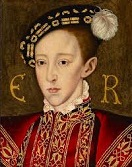






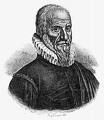
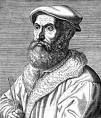



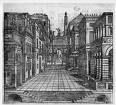

1537 The winter of 1536-7 sees a great frost in England, allowing Henry VIII to travel from C London to Greenwich along the Thames River by sleigh. On Jan. 1 James V of Scotland marries Madeleine de Valois (1520-37), 5th child and 3rd daughter of French king Francis I and Claude of France (daughter of Louis XII) in the Cathedral of Notre Dame in Paris after first visiting France to check out Mary of Bourbon, daughter of the Duke of Vendome (who offers a 100K crown dowry), and dumping her for being a "misshapen hunchback"; too bad, Madeline is little better, and the babe dies of TB on July 7 at Holyrood Abbey in Edinburgh right after they arrive in Scotland. On Jan. 6 Duke Alessandro de' Medici (b. 1510) of Florence is assassinated by his distant cousin Lorenzino de' Medici (1514-48) (AKA Lorenzaccio or Bad Lorenzino) after luring him with his sister widow Laudomia, and Cosimo I the Great de' Medici (1519-74) succeeds him; in 1548 Cosimo pays an assassin to kill Lorenzino in front of his lover's house in Campo San Polo, Venice. In Jan. Henry VIII and Jane Seymour spend a lot of time in bed? On Feb. 3 Silken Thomas FitzGerald, 10th Earl of Kildare (b. 1513) and his five uncles are executed in Tyburn, London for rebellion, and the English Crown tries to capture his 12-y.-o. half-brother Gerald FitzGerald, 11th Earl of Kildare (1525-85), new head of the FitzGerald Dynasty, who is hidden by his aunt Lady Eleanor McCarthy, and seeks to protect him by accepting a marriage offer from Manus O'Donnell (-1564), who in July after the death of his father Sir Hugh Dubh O'Donnell succeeds as king of Tyrconnell in Ulster, Ireland (until 1555); Kildare relative Conn O'Neill (1480-1559) (later 1st Earl of Tyrone) forms the short-lived Roman Catholic Geraldine League incl. the O'Donnells, O'Neills, O'Briens of Thormond et al., allying to restore Lord Kildare to his rightful position and later to overthrow English rule in Ireland. In Feb. Martin Luther writes the Smalcald Articles questioning the primacy of the pope/pontiff/pontifex maximus, which are presented to a meeting of the Schmalkaldic League. On Mar. 25 Charles of Bourbon-La Manche (b. 1489) dies, and Ferrante I Gonzaga (1507-57), HRE Charles V's viceroy of Sicily (1535-46) becomes CIC of the imperial army in Italy. On Apr. 17 after returning from his unprofitable journey to Chile, Diego de Almagro the Elder defeats Francisco Pizarro's troops at Cuzco, claims that it lies within his claim, and occupies it, taking Pizarro's brother Hernando prisoner and declaring himself gov. beginning a 19-year civil war; in Nov. Pizarro gives up attempts at a peace settlement and prepares to invade; meanwhile the native Mapuche (Araucanian) Indians in Chile revolt, beginning the Arauco War, which ends in a push with the Bio Bio River as a permanent frontier until 1883. The big prick finally does it? On May 27 there is a Te Deum sung in St. Paul's Cathedral in London for joy at the quickening of the queen's child; on Oct. 12 sickly Prince Edward VI (d. 1553), son of Henry VIII and Jane Seymour is born, and she dies 12 days later on Oct. 24; Henry wears mourning for the only time for one of his queens. On May 29 Pope Paul III issues the bull Sublimus Dei, declaring that the American native "savages", "being truly men, are apt to receive Christian faith", and "are not to be reduced to slavery", with automatic excommunication for violators; too bad, the Catholic Conquistadors are also under orders to convert them, so they get around the letter of the law by having a priest ask them in Spanish if they accept Christ, and when they don't understand Spanish, that makes them enemies of Christ, allowing them to be enslaved anyway - typical official cover story to allow the systematic extermination of Indios to go on unperturbed? On July 12 the Battle of Abancay in Peru is a decisive V for Spanish troops of Nueva Toledo under Diego de Almagro and Rodrigo Orgonez over troops of Neva Castilla under Alonso de Alvarado, who is captured and escapes, hooking up with the Pizarro brothrs, who raise another army to take him on. On July 17 James V has Lady Janet Douglas, Lady Glamis (b. 1498), sister of his enemy Archibald Douglas, 6th earl of Angus convicted witchcraft andf burned at the stake on Castle Hill in Edinburgh, adding to his image of ruthlessness; after being forced to watch his mother burn, her teenie son John Lyon, 7th Lord Glamis (1521-58) confesses and is imprisoned, then is later released, and his estates confiscated on Dec. 3, 1540, but he gets them restored on Mar. 13, 1543; James V's image probably needs no help after his persecution of the Armstrongs, Humes, Johnstons, Maxwells, Scotts, and other border families with Douglas ties, not to mention his forcing of the earls of Morton and Crawford to give their earldoms to the crown?; Lady Janet's ghost begins haunting Glamis Castle, making a knocking sound mimicking the hammering of the workmen building her scaffold. On Aug. 12 Lutheran Danish-Norwegian king (1534-59) Christian III is finally crowned in Copenhagen Cathedral - pope not invited? On Aug. 15 after hostile Guarani attacks cause Buenos Aires to be abandoned, and Juan de Salazar de Espinoza (Emiliano Gomez Suarez) (1508-60) to lead colonists up the Parana and Paraguay Rivers, they found the seaport of Asuncion (Asunción) on the Paraguay River (modern-day pop. 525K/2.2M); the site becomes the launching point for the Jesuits until they are expelled in 1767. In Aug. a huge Ottoman fleet led by adm. Barbarossa and adm. Lutfi Pasha (1488-1564) captures the Aegean and Ionian islands of the Repub. of Venice, incl. Syros, Aegina, Ios, Paros, Tinos, Karpathos, Kasos, and Naxos, then captures Corfu and raids Calabria, all of which pisses-off Pope Paul III, who calls for a Holy League against the *?!*? infidels; Venetian-born Cecilia Venier Baffo (1525-83), niece of Venetian Doge Sebastiano Venier is captured on Paros and taken to Istanbul, where in 1574 she becomes Valide sultan (co-regent) Nur-Banu ("Princess of Light"), #1 wife of Sultan Selim II and mother of Murad III. French statesman Michel de l'Hopital (1507-73) becomes counselor to the French parliament (until 1547), then becomes chancellor to the king's sister Margaret of France, duchess of Berry. The Lithuanians allied with the Crimean Tartars ravage the Ryazan region, while a 7K-man Polish force under Jan Tarnowski defeats the Russians at the Battle of Starodub on the Babinets River after the voevoda is captured and 13K inhabitants are massacred, then overrun Severia and Gomel (Homel) in Belarus; the Russians counterattack, defeating a 40K-man Lithuanian army at the Battle of Sebezh, then build the fortress of Velizh and devastate the suburbs of Vitebsk, causing a 5-year ceasfire to be signed, granting Gomel to Lithuania, and Sebezh and Velizh to Russia. The fortress of Klis in Croatia is captured by the Ottomans; it is not recaptured until 1648. Hugh Dubh O'Donnell dies, and his son Manus O'Donnell (-1564) succeeds as king of Tyrconnell in Ulster, Ireland (until 1555). Henry VIII reneges on the surrender terms and has the leaders of the Pilgrimage of Grace and similar risings put down and executed for treason, along with leader Robert Aske. Francis I of France appoints William du Bellay gov. of Turin, followed by gov. of the Piedmont in 1540, and he goes on to foster humanist scholars and writers, keeping a large library in Turin. Unniram Koyikal II dies, and Veera Kerala Varma (d. 1565) becomes ruler of Cochin, India. Henry VIII introduces the Protestant Reformation into Ireland, and begins the dissolution of Roman Catholic monasteries, giving a share of the spoils to native chieftains along with English titles to pacify them under the "surrender and re-grant" system, forcing them to surrender their lands then regranting them under English tenure, destroying traditional clan successions; an English commission holds courts throughout Ireland, but respects the Irish right to their own brehon system of laws to keep the peace; too bad, the Irish Celts balk at being Anglicized, and begin fomenting revolt (when not fighting each other). The Spanish found a settlement in Chachapoyas ("warriors of the clouds") on the NE frontier of Peru (elev. 7.6K ft.). Honduras gov. Francisco de Montejo begins crushing a revolt in Higueras (until 1544), and founds Comayagua in Chile; Ines de Suarez (Inés de Suárez) (1507-80) of Extremadura, Spain, whose first husband left her to go to the New World follows him, becoming the first Euro woman in Chile, only to find that he died, then settles in Cuzco, Peru, where she hooks up with new lover Pedro de Valdivia, becoming a female conquistadora. The Mandinka Kaabu (Gabu) (N'Gabu) (Ngabou) Empire of Senegambia in modern NE Guinea-Bissau and Senegal splinters from the Mali Empire (ends 1867). After being ruled by the Western Gangas, Cholas, and Hoysalas since the 4th cent., the modern city of Bangalore in the S Indian state of Karnataka (modern-day pop. 8.7M/12.3M) is founded by Kempe Gowda I (1510-69), vassal of the Vijayanagara Empire, which falls in 1565, after which it changes hands several times until the British capture it in 1799 in the Fourth Anglo-Mysore War; in 2006 it is renamed Bengaluru, becoming known as "the Silicon Valley of India". John Travers, chancellor of St. Patrick's Cathedral in Dublin becomes the first of the Irish Catholic Martyrs who die for their faith (until 1714); on Sept. 22, 1992 Pope John Paul II beatifies 17 of them. The first Roman Catholic hymnal is pub. in Vete. The first conservatories of music are founded, one in Naples for boys, and one in Venice for girls. (St.) Angela Merici (1474-1540) founds the Order of the Ursulines in Brescia in N Italy to educate young girls. Roman Catholic priest Menno Simons (1496-1561) of the village of Witmarsum in Friesland in N Netherlands becomes an Anabaptist (rebaptizer, rejecting infant baptism), severing all ties with the Church, becoming a hunted man. Martin Luther gives a sermon in which he becomes the first to attribute the authorship of the Epistle to the Hebrews in the New Testament not to Apostle Paul but to Apollos of Alexandria, who is mentioned in Acts 18:24-28. Francois Rabelais moves to Montpellier to teach (until 1539). Architecture: Duke Louis X of Bavaria begins Landshut Palace, the first Renaissance palace N of the Alps (finished 1543), modeled after the Palacco del Te in Mantua. Italian architect Andrea Palladio (1508-80) designs Villa Godi in Ludo di Vicenza, Veneto, Italy, becoming his first commission (finished in 1542). Science: French barber surgeon Ambroise Pare (Paré) (1510-90), in the service of Francis I during the attack on Turin discovers that soldiers with gunshot wounds that have not been scalded with the usual boiling oil of elders fare better than those who do, causing him to discard the accepted practice and prepare poultices with more humane cold ingredients incl. egg yolks, turpentine, and rose oil, used by the ancient Romans - it's a triple mess-kit cozy? Andreas Vesalius (1514-64) becomes prof. of anatomy at Padua (until 1544), founding a school that turns up the heat on the subject no matter whom it shocks. Nonfiction: Anon., The Complete Works (Opera Omnia) of Cicero; (4 vols.) (Venice). Anon., Matthew's Bible. Johann Eck (1486-1543), German Trans. of the Bible; commissioned by Roman Catholic duke William IV of Bavaria in Ingolstadt to counter the influence of Martin Luther's German Bible; first German Bible to contain the name "Jehovah" (marginal comment on Ex. 6:3). Gerhard Mercator (1512-94), Map of Flanders (his first). Pedro Nunes (1502-78), Treaty about the Sphere with Theory of the Sun and the Moon (Tratado da sphera com a Theorica do Sol e da Lua); tr. of "Tractatus de Sphaera" by Johannes de Sacrobosco, "Theoricae Novae Planetarum" by George Purbach, and Ptolemy's "Geography"; Treatise in Defense of the Maritime Chart; first discussion of the Rhumb line, a path with constant bearing relative to true north (loxodrome); Treatise About Some Navigational Doubts. Robert Recorde (1510-58), Introductions for to Lerne to Recken with the Pen. Sebastiano Serlio (1475-1554), Trattato di Architettura (6 vols.); spawns "more hack architects than he had hairs on his beard." (Giovanni Lomazzo) Niccolo Tartaglia (1500-57), Nova Scientia; discusses projectile trajectory and the motion of heavy bodies, proposing which discusses projectile trajectory and the motion of heavy bodies, proposing Tartaglia's Theorem, Tartaglia's Theorem, that the trajectory of a projectile is a curved line, and that a projectile fired at an elevation of 45 deg. will travel the farthest, founding the science of Ballistics - heavy balls as a cure for stammering? Art: Jacopo Sansovino (1486-1570), Facade of the Doge's Palazzo Loggietta (Venice). Titian (1477-1576), Portrait of King Francis I. Births: Chinese Ming emperor #12 (1567-72) Longqin ("great celebration) (Zhu Zaihou) (d. 1572) (AKA Prince of Yu) on Mar. 4; son of Jiajing (1507-67); father of Wanli (1563-1620). Japanese overlord (2nd great unifier of Japan) Toyotomi Hideyoshi (d. 1598)on Mar. 17 in Nakamura-ku, Nagoya; husband of Yodo-dono, niece of Oda Nounaga; father of Toyotomi Hideyori (1953-). Italian surgeon-anatomist ("the Father of Embryology") Hieronymus Fabricius (Hieronymo Fabrizio) (Girolamo Fabrici) (d. 1619) on May 20 in Acquapendente, Latium; educated at the U. of Padua; Galileo's personal physician and William Harvey's teacher. English king (1547-53) Edward VI (d. 1553) on Oct. 12 in Hampton Court Palace, Middlesex; son of Henry VIII (1491-1547) and his 3rd wife Jane Seymour (1508-37); firt English monarch raised as a Protestant. English 9-day queen Lady Jane Grey (Dudley) (d. 1554) in Oct.; great-granddaughter of Henry VII and great-niece of Henry VIII; daughter of Henry Grey, 1st duke of Suffolk (1515-54) and Frances Brandon (1517-59), daughter of Henry VII's sister Mary Tudor (1495-1533) and Charles Brandon, duke of Suffolk (1484-1545); husband of Guilford Dudley (1536-54). Swedish king (1568-92) Johan (John) III Vasa (d. 1592) on Dec. 20 in Stegeborg Castle; 2nd son of Gustav I Vasa (1496-1560) and Margarete Leijonhufvud (1516-51). Spanish Jesuit scholar Francisco Ribera (d. 1591) in Vallacastin; confessor of Teresa of Avila. Scottish lord chancellor of Scotland (1568-93) John Maitland, 1st Lord Maitland of Thirlestane (d. 1595); 2nd son of Sir Richard Maitland; knighted in 1581. Korean field marshal Gwon (Kwon) Yul (d. 1599). Italian architect-sculptor Giacomo della Porta (d. 1602) (b. 1533)? in Porlezza, Lombardy. Deaths: Italian Florentine painter Lorenzo di Credi (b. 1459) in Florence. Austrian organist-composer Paul Hofhaimer (b. 1459). German satirist Thomas Murner (b. 1475) in Oberehnheim, Alsace. French noble Charles of Bourbon-La Manche (b. 1489) on Mar. 25 in Amiens. English Pilgrimage of Grace leader Robert Aske (b. 1500) on July 12 in York (hanged). English queen (1536-7) Jane Seymour (b. 1508) on Oct. 24 in Hampton Court Palace (postnatal complications from the birth of Edward VI). Florentine duke (1532-7) Alessandro de' Medici (b. 1510) on Jan. 6 (assassinated). Irish rebel Silken Thomas, 10th earl of Kildare (b. 1513) on Feb. 3 in Tyburn, London (executed for treason).
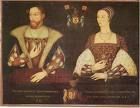



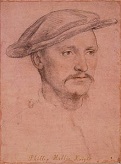

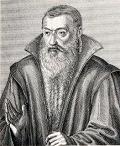

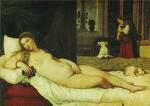
1538 In Feb. Pope Paul III assembles the Holy League consisting of the papacy, Spain, the HRE, the Repub. of Venice, and the Maltese Knights to fight the infidel Muslim Ottoman fleet. On Mar. 10 English ambassador to the Holy Roman Empire Sir Philip Hoby (Hobby) (Hobbye) (1505-58) arrives in Brussels with painter Hans Holbein the Younger on a mission from Thomas Cromwell to paint a portrait of Christina of Denmark (1521-90) (daughter of Christian II) for Henry VIII, who sends them to France in Aug. to paint more eligible babes incl. Princess Margaret of France, Antoinette, duchess of Guise, Anna of Lorraine et al. On Apr. 4 (Apr. 13 Old Style) Ivan IV the Terrible's mother Elena Glinskaya (b. 1510) is poisoned, and her favorite young boyar Ivan Ovchina-Telepnev-Obolensky (-1539) takes control as regent for the young tsar. On Apr. 26 Diego de Almagro the Elder (b. 1475) is defeated by Pizarro at Salinas (near Cuzco), and executed, leaving son Diego de Almagro the Younger to carry on his name in Peru; meanwhile the Spanish gain control of 12.5K-ft. alt. Lake Titicaca in the Andes SE of Cuzco. On May 17 Afghan rebel Sher Shah ("Tiger King") Suri (Farid Khan)(1486-1545) drives out Mogul emperor Humayun and becomes emperor of Delhi (until May 22, 1545), founding the Suri Dynasty (ends 1556), going on to coin the term "Rupiya" (Rupee) (Sansk. "rupyakam" = silver coins) for a silver coin weighing 178 grains; he also mints copper Dam coins and gold Mohur coins, which the Mughal emperors later standardize. On June 18 Francis I and HRE Charles V sign the nice 10-year Treaty of Nice through the mediation of Pope Paul III, ending their 1535 war over Milan inconclusively, giving Francis most of the Piedmont. On July 25 Spanish conquistador Francisco de Orellana founds the city of (Santiago de) Guyaquil, Ecuador (modern-day pop. 3.5M/5M), then heads N, entering the Cauca River Valley in Colombia in search of the Big Score, AKA El Dorado - by the 20th cent. it turns out be, not golden powder, but white? On Aug. 4 after sending future archbishop (of St. Andrews) David Beaton to scout out a new French wife, James V of Scotland marries Mary of Guise-Lorraine (1515-60), daughter of Claude de Lorraine, duke of Guise, and sister of Duke Francois of Guise and Cardinal Charles of Lorraine, a babe made more desirable by being approached by Henry VIII, who scares her into his arms; the Auld Alliance is reaffirmed, French influence in Scotland jumps, and Henry VIII is royally pissed-off; the dowries for James' two French marriages total £168,750, 5x what his daddy James IV got from stingy Henry VII in 1503 - now if they will just stay Roman Catholic, the Auld Alliance will keep them from being absorbed by Protestant England? On Aug. 6 the city of Bogota (Bogotá) (Santa Fe de Bogota on the Bogota Plateau i (modern-day pop. 8M/10M) s founded on the site of the Chibcha town of Bacata by Spanish conquistador Gonzalo Jimenez de Quesada (1495-1576), who began moving up the Magdalena River in 1536 on a commission from the govt. of Santa Marta on the coast, defeating and sacking Chibcha chiefdoms along the way; he names the new city after his native town of Santa Fe. On Sept. 28 the Battle of Preveza in NW Greece between the Ottomans under Adm. Hayreddin Barbarossa and the Holy League under Adm. Andrea Doria is a V for the Ottomans, securing Turkish dominance of the Mediterranean for 33 years (until 1571); one tiny bright spot for Christ, the Venetians capture Castelnuovo (Herceg Novi) in the Bay of Kotor in Montenegro (until 1539). In Sept. the Siege of Diu begins when Mamluk sultan (since 1525) Hadim Suleiman Pasha sends a fleet of 72 ships from Aden (largest Ottoman fleet in the Indian Ocean) to support the sultan of Gujarat, and they give up after a Portuguese relief fleet arives and the Gujarat sultan fails to back them up; the Portuguese maintain control of Diu until 1961. On Nov. 30 the city of La Plata (Ciudad de la Plata de la Nueva Toledo) (modern-day Sucre) in SC Bolivia (modern-day pop. 30K) is founded by Pedro Anzures, Marques de Campo Redondo, becoming the home of the Roman Catholic metropolitan see of Bolivia. In Dec. James V's widely hated Lutheran-persecuting chief counselor David Beaton (1494-1546) is appointed a cardinal. Ferdinand I of the Hapsburgs becomes king of a split Hungary, with John I Zapolya claiming the other half, but since he is childless he magnanimously agrees to let the crown pass to Ferdinand upon his death. Henry VIII ensures the popularity of the Anglican Church by abolishing the Roman Catholic monasteries, relics, and shrines in S England and sharing the loot with his non-Catholic pop.; Thomas Cranmer carries out his orders for the desecration of the profitable shrine of St. Thomas Becket in Canterbury Cathedral (incl. burning his bones after he is summoned to face charges of treason and fails to appear in court and is found guilty in absentia, his shrine's treasures carried away in two coffers and 26 carts), and the abolition of many Roman Catholic church festivals; on Jan. 23, 1888 a skeleton is found in Becket's crypt of a 6'2" 50-y.-o. man with a fractured skull, but since it doesn't fit the eyewitness descriptions that the crown of his head was knocked off, the jury is still out; in Sept. informed that he needs his own non-Catholic Bible to prove his independence from the papacy, Henry is handed a copy of dead Tyndale's "illegal" Bible (printed in Paris) without knowing it, and approves it, and the English govt. directs every parish in England to purchase a Tyndale Bible of the largest size possible, to be set up in each church for easy reading by parishoners; Cranmer goes on to work to unite the new Church of England with the German Lutheran Church, and invites Protestant refugees to England, incl. Peter Martyr (Pietro Martire Vermigli), and Bernardino Ochino. The Moldavians invade the Pakutia again, and are repulsed, pissing-off the Ottoman sultan, who removes the Moldavian hospodar and utter the soundbyte: "He has disturbed the Porte's best friend, the king of Poland." Havana is burned by slaves and French pirates - send some more of them ships with ballasts of gold? The Abyssinian city of Axum is captured by Mohammed, Prince of Leila. Pozzuoli on the Bay of Naples is ruined by another earthquake. The S Burmese kingdom of Toungoo (on the Sittoung River) conquers the Mons kingdom of Pegu. Ivan Ovchina is thrown in prison by the boyars. John Calvin is expelled from Geneva and settles in Strasbourg, Germany; meanwhile the Lutheran U. of Strasbourg in Alsace, France is founded by Johannes (Jean) Sturm (1507-89) as the first humanistic Protestant Gymnasium, becoming a univ. in 1621 and a royal univ. in 1631, becoming the 2nd largest univ. in France in modern times after Aix-Marseille U.; students incl. Angelus Silesius and Johann Wolfgang von Goethe. Two engineers trusted with the restoration of the walls of the Old City of Jerusalem mistakenly leave Mt. Zion and King David's Tomb outside the walls, pissing-off the sultan, who has them executed. Mimar Sinan (1489-1588) becomes chief architect to the Ottoman sultan (until 1588), going on to build a bunch of magnificent mosques. Nostradamus is accused of heresy after he remarks to a workman casting a bronze statue of the Virgin that he is making devils; the Inquisitors order him to go to Toulouse, but he flees from the Church authorities for the next six years. The names "America" and "North America" are used by Gerardus Mercator for the first time in his maps. Architecture: Michelangelo begins planning a square (trapezoid) for the Civic Center of Rome and the buildings facing it, symbolizing Rome as the center of the world. Inventions: The Diving Bell is invented by Guglielmo de Lorena of Italy. Nonfiction: Sir Thomas Elyot (1499-1546), Bibliotheca; English-Latin dictionary. Melanchthon (1497-1560), Ethica Doctrinae Elementa. Art: Titian (1477-1576), Presentation of the Virgin in the Temple; Adonis with His Dog; Venus of Urbino (The Urbino Venus); commissioned by Guidobaldo II della Rovere, Duke of Urbino (1514-72). Plays: John Bale (1495-1563), A Comedy Concerning the Three Laws of Nature, Moses and Christ, Corrupted by the Sodomytes, Pharisees and Papystes Most Wicked; stage directions incl. "Let Idolatry be decked like an old witch, Sodomy like a monk of all sects, Ambition like a bishop, Covetousness like a Pharisee or spiritual lawyers, False Doctrine like a popish doctor, and Hypocrisy like a gray friar"; A Tragedy; or Enterlude Many Jesting the Chief Promyses of God Unto Man; The Temptacyon of Our Lorde; A Brefe Comedy or Enterlude of Johan Baptystes Preachynge in the Wilderness; Kynge Johan (King John); first English historical drama, which rails against the Roman Catholic Church, claims that King John was a Lollard, and was poisoned for it by a monk of Swinestead; "This noble Kynge Johan, as a faythfull Moses/ Withstode proude Pharao for his poore Israel". Paul Rebhun (1506-40), Hochzeitsspiel auf die Hochzeit zu Kana (verse drama). Poetry: Clement Marot (1496-1544), Thirty Psalms of David. Births: German Jesuit astronomer-mathematician Christopher Clavius (d. 1612) on Mar. 25 in Bamberg, Bavaria Italian duke of Mantua and Montferrat (1550-87) Guglielmo (William) I Gonzaga (d. 1587) on Apr. 24 in Mantua; 2nd son of Federico II Gonzaga (1500-40) and Margaret Palaeologina of Montferrat. Itlian Mannerist painter-architect-writer Gian (Giovanni) Paolo Lomazzo (d. 1600) on Apr. 26 in Milan; goes blind in 1571. Italian Roman Catholic Church historian and cardinal (1596-) Caesar Baronius (Cesare Baronio) (d. 1607) on Aug. 30 in Sora, Naples; pupil of St. Philip de Neri; prevented from becoming pope by Spain because of his support of papal claims on Sicily; coins the term "Dark Ages" for the period from 500-1100 C.E. Italian archbishop-cardinal of Milan (St.) Carlo (Charles) Borromeo (d. 1584) on Oct. 2 in Milan; born in his father's Arona Castle on Lake Maggiore; canonized in 1610. Italian poet-dramatist-diplomat Giovanni Battista Guarini (d. 1612) on Dec. 10 in Ferrara; father of singer Anna Guarini, contessa Trotti (1563--98). English MP and writer Reginald Scott (Reynold Scot) (d. 1599) in Smeeth, Kent; educated at Hart Hall, Oxford U. Scottish poet-jurist Sir Thomas Craig (d. 1608); educated at the U. of St. Andrews. Flemish botanist-physician Matthias de Lobel (l'Obel) (Matthaeus Loelius) (d. 1616) in Lille; namesake of the Lobeliacae family of latex-producing New World plants incl. Indian tobacco. Deaths: Spanish conquistador Diego de Almagro the Elder (b. 1475) in Cuzco, Peru (executed). Spanish novelist Fernando de Rojas (b. 1475). German artist-architect Albrecht Altdorfer (b. 1480) on Feb. 12 in Regensburg. French-born queen consort of Aragon, Naples, Sardinia, and Sicily (1505-16) on Oct. 18 in Lliria (N of Valencia), Spain. German duke of Cleves (1521-38) John III the Peaceful (b. 1490) on Feb. 6. Italian duke of Urbino (1508-38) Francesco Maria I della Rovere (b. 1490) on Oct. 20 in Pesaro (poisoned); his death is portrayed in Elizabethan theaters, becoming the play "The Murder of Gonzago", referenced in William Shakespeare's "Hamlet", and reworked into "The Mousetrap". Russian grand princess consort (1526-38) Elena Glinskaya (b. 1510) on Apr. 4 (poisoned). Moorish ex-king of Granada Boabdil (Abu Abdullah) (b. ?) in Morocco; KIA in a war for the king of Fez against the king of Morocco.




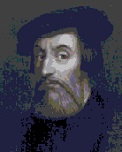

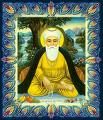


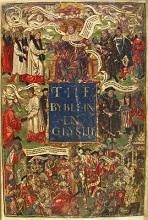
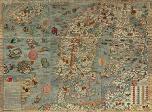
1539 On Jan. 12 the Treaty of Toledo ends the conflict between Charles V and Francis I; Roman Catholic Spain and France are now allies against England, worrying Protestant English king Henry VIII. On Apr. 17 Roman Catholic Saxon duke (since 1500) George the Bearded (b. 1471) dies, and his Protestant brother Henry IV the Pious (1473-1541) becomes duke of Saxony (until Aug. 18, 1541), making Lutheranism the state religion. In Apr. the Statute of Six Articles (against Lutheranism), engineered by Thomas Cromwell is passed; Hugh Latimer resigns as bishop of Worcester in July; Edmund Bonner is made bishop of London, supporting Henry VIII's doctrine of the supremacy of the king in both spiritual and temporal matters; Cromwell rises to Lord Great Chamberlain - meaning, one mistake and he loses his head? On May 18 Pizarro's lt. Hernando de Soto (1496-1542), having returned to Spain as a hero and married Isabel (Ines) del Bobadilla (1505-43) (daughter of a relative of Queen Isabella) in 1537, and obtained the governorship of Cuba and a royal patent to colonize the Am. Gulf coast and search for a passage to the Orient, sets sail from Spain on seven ships with 620 volunteers, 200+ horses and 500 livestock, reaching Port Charlotte (Tampa Bay?), Fla. on May 30, while his wife Isabel becomes the first woman gov. of Cuba, watching every day for his return; on Dec. 25 he celebrates the first Christmas in Tallahassee; too bad, he ends up stumbling around the Am. SE and killing tens of thousands of aborigines, incl. by burning their cities, but never sees the ocean again, getting killed on the Mississippi River in 1543. On July 8 after being sent by Hernan Cortes, Francisco de Ulloa (d. 1540) leaves Acalpulco in three small ships to seek the mythical Strait of Anian leading to the Gulf of St. Lawrence, reaching the Gulf of California, which he calls the Sea of Cortes; on Sept. 12 after one ship is lost in a storm, he resumes his voyage, saling S along the E coast of the Baja California Peninsula, landing at the Bay of La Paz to take on supplies, then rounding the tip and sailing N along the W shore in the Pacific Oean, reaching 28 deg. N near Isla de Cedros before bad weather forces him to turn back, until his ship is swept inland by a tsunami, causing it to become known as the Lost Ship of the Desert; too bad, his reports are used to depict Calif. as an island. In Aug. Hans Holbein delivers a deceptively attractive portrait of Anne of Cleves to Henry VIII, who is smitten; the marriage contract is finalized at Hampton Court on Oct. 6; Anne arrives on Dec. 11 at Calais, waiting for a favorable wind to carry her to Dover while Henry waits at Greenwich; she lands at Deal on Dec. 27 and heads for Rochester. In Sept. the Ottomans under Adm. Hayreddin Barbarossa capture the islands of Skiathos, Skyros, Andros, and Serifos from the Repub. of Venice, and recapture Castelnuovo. On Dec. 8 German Duke Philip the Contentious (1503-48) of Palatinate-Neuburg (based in Heidelberg) visits the court of Henry VIII of England to woo his daughter Bloody Mary, meeting with her on Dec. 17 in Hertford Castle, presenting her a gift and kissing her; too bad, since he is related to Henry VIII's 4th wife Anne of Cleves he sends him packing, and despite visiting England again 3x, he only gets to see her once - if they had married and she had become a Protestant, how many would have been saved from burning? Francisco's brother Gonzalo, gov. of Quito leads an expedition into the Andes to find and capture Inca king Manco, and it reaches the upper Amazon, but is ambushed with giant boulders rolled onto his men, killing 36, causing him to wait for reinforcements; Manco taunts him by telling him that he's killed 2K Spaniards and they're next?; meanwhile Manco harbors Spanish and other refugees, incl. enemies of the Pizarros, which turns out to be his big mistake? China attacks Vietnam. After an invasion by rival king Tabinshwehti of the smaller kingdom of Toungoo, witless king (since 1526) Takayutpi (b. 1511) loses the Battle of Naungyo and flees to Prome, begging for help, then falls ill and dies near Maubin while trying to collect war elephants, ending the Hanthawaddy Kingdom in S Burma (founded 1287), allowing the Taungoo Dynasty to be founded in Burma, becoming the largest empire in SE Asia until it collapses in 1599, gobbling up Siam, Manipur, the Chinese Shan states, and Lan Xang. The first criminal court in England is established at Old Bailey on the W wall of London (destroyed in 1666). Ivan Ovchina dies in prison, and the boyars take control of the infant tsar. Sebastian de Belalcazar meets German adventurer Nikolaus Federmann (1505-42), an agent of the Welser banking family of Augsburg (rivals of the Fuggers) as he heads towards the Bogota plateau, and they get into a fight with each other and Gonzalo Jimenez de Quesada over jurisdiction, which the Spanish crown resolves, confirming Belalcazar as gov. of Popayan; Belalcazar, accompanied by Gonzalo Jimenez de Quesada and Federmann explores the Magdalene River Valley in C Colombia. New Spain viceroy Antonio de Mendoza sends Franciscan friar Sancho Panza, er, Fray Marcos de Niza (1495-1558) N from Mexico City to investigate reports by Cabeza de Vaca of the legendary Seven Cities of Cibola; he reaches the Zuni (Zuñi) pueblos of New Mexico and returns with glowing reports that impress Coronado - the women go around showing what? The Spanish under Gomez de Alvarado found the settlement of Leon de Huanuco (Huánuco) in the Inca town of Yarowilca on the NE frontier of Spanish Peru, moving in 1541 to the Pilco Valley. Chudovo in W Russia is first mentioned. A royal edict commands the French to confine shitting to private bathrooms in their own homes - except in New Orleans? James V of Scotland issues the gold Bonnet Piece, a coin with his portrait on one side wearing a bonnet instead of a crown, and an imperial crown on the other. Juan Pablos (Giovanni Paoli) establishes the first printing press in the New World in Mexico, its first pub. being La Escala Espiritual de San Juan Climaco. Westminster Abbey in London becomes a cathedral after becoming the seat of a 1-time bishop; in the reign of Elizabeth I it becomes headed by a dean. The Maltese Falcon is sent by the Knights Templar to HRE Charles V of Spain :) France holds a public lottery. Wittenberg prof. Georg Joachim (Rheticus) journeys to Frauenberg to study Nicolaus Copernicus' ms. on the heliocentric theory. Inventions: The first Christmas Tree is displayed in Strasbourg Cathedral; meant to represent the Garden of Eden, it is hung with apples. Nonfiction: Martin Bucer (1491-1551), Strasburg Liturgy; for public confession of sins; "This is a faithful saying, and worthy of all acceptance: that Christ Jesus came into the world to save sinners." (1 Tim. 1:15) John Calvin (1509-64), Commentary on the Epistle to the Romans. Miles Coverdale (1488-1569), The Great Bible (fall); the first English Bible, commissioned by Thomas Cromwell and pub. by the English govt., becoming the official English version for the Anglican Church; the cover shows Henry VIII at the top, with Christ whispering into his ear as he passes on the word of God to Archbishop Cranmer and Cromwell, who passes it to the clery and laymen, who cry "Vivat Rex" (God save the king); Cromwell orders one to be housed in every church in England; "Go to now (most dear reader) and sit thee down at the Lord's feet and read his words, and, as Moses teacheth the Jews, take them into thine heart, and let thy talking and communication be of them when thou sittest in thine house, or goest by the way, when thou lyest down, and when thou riseth up. And above all things fashion thy life and conversation according to the doctrine of the holy ghost therein." (preface) Sir J. Elliott, Cookbook - or, why heart-unhealthy English cooking sucks? Antonio de Guevara (1481-1545), Lives of the Ten Emperors; Libro de los Inventores del Arte de Marear (Valladolid); Aviso de Privados y Doctrina de Cortesanos; the concept of the courtier and the court society; "As far as religion is concerned, if one wakes up in the middle of night, it is to laud the Lord in the Divine worship. But at the court, one stays awake all night infinite times, for no other reason than to keep up with people (el mundo)"; The Golden Letters (Epistolas Familiares) (1539-45) (Valladolid); an internat. hit. Olaus Magnus (1490-1557), Map of Scandinavia; first accurate large-scale map of a large Euro region. Melanchthon (1497-1560), De Officio Principum. Richard Taverner (1505-75), The Taverner Bible; a revision of the Matthew Bible; doesn't make much of a splash because of tardy timing. Richard Taverner (1505-75) (tr.), Proverbs or Adages by Desiderius Erasmus Gathered Out of the Chiliades and Englished. Art: Hans Holbein the Younger (1497-1543), Portrait of Anne of Cleves. Il Sodoma (1477-1549), The Mystical Marriage of St. Catherine. Music: Georg Forster (1514-68), Frische Teutsche Liedlein (secular songs) (1539-56). Plays: The Gentse Spelen, a collection of allegorical plays is performed at Ghent. Births: French lawyer-scholar (Calvinist-turned-Roman Catholic) Pierre Pithou (Petur Pithoeus) (d. 1596) on Nov. 1 in Troyes. English playwright George Gascoigne (d. 1578). English soldier-navigator Sir Humphrey Gilbert (d. 1583) in Compton, Devonshire; half-brother (mother's side) of Sir Walter Raleigh; educated at Eton School, and Oxford U.; knighted in 1570. Swiss engraver Jost Amman (d. 1591). Italian Socinianism founder Faustus Socinus (Faust Socyn) (Fausto Paolo Sozzini) (d. 1604) in Siena; nephew of Laelius Socinus (1525-62). Spanish statesman (secy. of Philip II) Antonio Perez (d. 1611) in Valdeconcha, Guadalajara. Spanish soldier-historian ("El Inca") Garcilaso de la Vega (d. 1616) in Cuzco, Peru; son of conquistador Sebastian de la Vega y Vargas. English lord Edward Seymour, 1st Earl of Hertford (d. 1621); husband of Catherine Grey (1540-68), sister of Lady Jane Grey (1537-54); father of Edward, Lord Beauchamp (1561-1612) and Thomas Seymour (1563-1619). Deaths: Indian Sikhism founder Shri Guru Nanak Dev Ji (b. 1469) - sounds like computer system programming jargon? German duke of Saxony (1500-39) George the Bearded (b. 1471) on Apr. 17 in Dresden. Scottish archbishop James Beaton (b. 1473). Italian diplomat-cardinal Lorenzo Campeggio (b. 1474) on July 25. Italian marquesa of Mantua (1490-1539) Isabella d'Este (b. 1474) on Feb. 13. English politician-diplomat Thomas Boleyn (b. 1477) on Mar. 12. Italian metallurgist Vannoccio Biringuccio (b. 1480). Spanish explorer-scholar Ferdinand Columbus (b. 1488). Burmese Hanthawaddy king #18 (last) (1511-39) Thushin Takayutpi (b. 1511) in Ingabin (near Maubin).






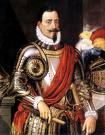


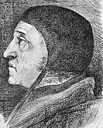
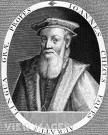








1540 I can't see me loving nobody but you, for all of, er, some of my life? Grand Canyon jokes here? On Jan. 1 Henry VIII has a comical meeting with Anne of Cleves (1515-57) in disguise in Rochester, and finds her portrait quite exaggerated and her person loathsome, then tries to back out of his marriage, but power politics prevents him, and on Jan. 6 he reluctantly marries his 4th wife to bring about an alliance with a German principality and counter the Treaty of Toledo; in Apr. Henry creates his chief minister Thomas Cromwell (b. 1485) the earl of Essex, then turns on him after having many impotent nights with his new wife (who has big floppy duckies instead of pert little ones like he likes?, blaming him for hooking him up with an ogre, letting Cromwell's enemies loose on him; on June 10 Cromwell's archenemy, lord treasurer Thomas Howard, 3rd Duke of Norfolk (1473-1554) arrests him for treason, and Parliament turns on him too; meanwhile on July 9 Henry divorces Anne at the convocation of Canterbury and York, giving her the title of "My Lady the Queen's Sister", then on July 30 secretly marries his real lover, the very tight and right Catherine Howard (1521-42) (his 5th wife), Anne Boleyn's cousin, and niece of Thomas Howard, 3rd duke of Norfolk; the same day Thomas Cromwell is executed after reconverting to Roman Catholicism, and Norfolk becomes his successor; the same day English Lutheran Robert Barnes (b. 1495) is burned at the stake; Bible translator Miles Coverdale flees to the Continent for the next eight years (until 1548); too bad, Catherine begins secretly hooking up with handsome young stud Thomas Culpeper (1514-41) with the aid of her lady-in-waiting Jane Boleyn, Viscountess Rochford (1505-42), widowed sister-in-law of Anne Boleyn - moral: please the head of your nation or you could lose yours? Don't just take your family on a vacation, take them on an adventure? Whitey finally reaches the far side, and it's gone in a flash? On Feb. 23 Francisco Vazquez (Vázquez) de Coronado (1510-54), gov. of Nueva Galicia leads an expedition of 400 men plus 1.3K-2K Indios, four Franciscan monks, and several slaves from Compostela, Mexico, exploring N Texas and invading New Mexico and conquering the Zunis (Zuñis); on Sept. 8 they establish winter HQ at the Indian pueblos of Kuau and Puaray, using it as a base for vain searches for the riches of Quivira; in 1934 archaeologists unearth ancient paintings of Indian god-demons behind 85 layers of adobe plaster; on May 9 Spanish navigator Hernando de Alarcon (Alarcón) leaves Coronado's party, goes by sea to the Gulf of Calif., then completes the explorations of Francisco de Ulloa the preceding year, satisfying himself that there is no open water passage between the gulf and the South Sea (Pacific Ocean); he then travels up the Colorado River (which he names the Buena Guia), becoming the first Euro to navigate it, viewing Am. bison (buffalo) ("tatanka"); Garcia Lopez de Cardenas (García López de Cárdenas) leaves Coronado's party and discovers the Grand Canyon and the Colorado River in modern-day Ariz.; another lt. of Coronado reaches the pueblos of the Hopi (Moqui); Capt. Hernando de Alvarado leaves Coronado's party and explores the Rio Grande River, stopping halfway at Isleta Pueblo (S of modern-day Albuquerque), which becomes a stopping place for every future Spanish explorer in New Mexico. On Feb. 28-Sept. 19 the European Super Drought of 1540 causes Milan, Italy to be completely dry for 5 mo., while in Zurich it only rains 4x, causing the water table in Switzerland to drop over 1.5M and thousands along the Ruhr River to die of poisoning from dirty water; Lindau Island becomes connected to the mainland after the water level in the Bodensee sinks; the water flow in the Elbe River is reduced to one-tenth normal, allowing people to walk across them, along with the Rhine and Seine Rivers; by Aug. trees begin shedding their leaves early, after which fires destroy more communities than in the preceding millennium, causing a blanket of smoke to shroud Europe, turning the Sun and Moon into flaming red balls; prices for flour and bread zoom sky high. In Mar. Pedro de Valdivia (Valdavia) (1497-1553), who began working for Francisco Pizarro in 1535 and helped him fight Diego de Almagro (the N part of Peru had been under Almagro's jurisdiction) leads an expedition of 150 Spanish soldiers plus some Peruvian Indians across the Atacama Desert into the C valley of Chile, accompanied by his babe Ines Suarez. In the spring James V of Scotland launches a naval expedition to the Scottish N and W Isles, and returns to Edinburgh in early July with a number of hostages, which are secreted in the castles of Dunbar, Tantallon, and Bass Rock to keep their unruly chieftains in line. In the spring the simmering hatreds caused by the abuses of Nuno de Guzman in La Gran Chichimecha in NC Mexico cause the natives of Nueva Galicia to revolt in the Mixton (Mixtón) Rebellion (War), which New Spain viceroy Antonio Hurtado de Mendoza ruthlessly quashes by next Dec. In Apr. Hungarian king (since 1526) John I Zapolya (b. 1487) finally finds out he has a son in the oven, John II Sigismund Zapolya (1540-71)), causing him to rescind his agreement to let his rival Ferdinand I claim the Hungarian throne upon his death; he dies on July 22, nine days after John is born, and Zapolya's royal counselor, Dalmation-born monk (later cardinal) George Martinuzzi (AKA Frater Georgius) (1482-1551) becomes regent for John II, along with secret Protestant Peter Petrovich, claiming the throne for the young tyke, backed by the Turkish sultan and other enemies of the Hapsburgs, but Ferdinand I continues to claim Hungary and sends an army which sieges Ofen, giving the sultan his excuse to invade Hungary in support of the tyke - pour me another cup of coffee? In May Sebastian de Belalcar is granted governorship of Popayan by HRE Charles V, soon getting into a border dispute with new neighboring province gov. (until 1542) Pascual de Andagoya (1495-1548). On Aug. 28 Federico II Gonzaga (b. 1500) dies of syphilis, and his son Francesco III Gonzaga (1533-50) becomes duke of Mantua and marquis of Monteferrat (until 1550), going on to marry a daughter of Ferdinand I in 1549 to cement his position. In Aug. Scottish master of works Sir James Hamilton of Finnart (-1540) AKA "the Bastard of Arran" (bastard son of James Hamilton, 1st Earl of Arran and Mary Boyd of Bonshaw, legitimated in 1512), who had tried to get Archibald Douglas of Kilspindie rehabilitated in 1529 is executed for plotting to kill his 2nd cousin James V, who confiscates his considerable wealth - thanks, suckah? On Sept. 3 Gelawdewos (Claudius) (1521-59) is crowned Solomonic emperor Asnaf Sagad I of Ethiopia (until Mar. 23, 1559). On Sept. 27 Pope Paul III issues the bull Regimini Militantis Ecclesiae, confirming the Jesuit Order (Society of Jesus) of (St.) Ignatius of Loyola (1491-1556), but limiting its membership to 60 (until 1543); Loyola is appointed superior-gen. #1 of the Jesuits, becoming known for opposing discrimination against converted Jews, calling the Spanish insistence on "purity of blood" (discrimination against Catholics of Jewish ancestry) "the Spanish whim". In Oct. after the Ottomans take their remaining outposts in the Ionian and Aegean Seas, Venice signs a peace treaty with Ottoman Sultan Suleiman I the Magnificent in Constantinople, agreeing to recognize the Turkish territorial gains and pay 300K gold ducats. Gonzalo Pizarro receives reinforcements then continues chasing Manco and his Incas through steamy jungles, finding his jungle city abandoned, then searches for 2 mo. more before giving up and returning. Ottoman adm. Barbarossa II sacks Spanish-held Gibraltar, causing Charles I of Spain (HRE Charles V) to order stronger defenses built; in Sept. he tries to induce Ottoman adm. Barbarossa II Heyruddin to switch sides, offering him a job as adm.-in-chief plus control of Spain's territories in N Africa, but he tells the infidel dog to stuff it. The property of the Hospitallers (Knights of Rhodes) in England is confiscated. Scottish Queen Mary of Guise is crowned at Holyrood with a newly-remodelled crown. A religious conference is held in Worms (ends 1541), where Johann Eck et al. defend Your Father's Roman Catholicism against uppity horned Lutherans. Spanish conquistador Pedro Cieza de Leon (1520-54) discovers the ruins of Tiahuanaco in the Peruvian-Bolivian altiplano 12 mi. S of Lake Titicaca. Speaking of horned monarchs, Henry VIII arbitrarily decides that no horse stallion in his realm should be shorter than 15 hands, 13 for mares, causing breeds like the Cornish to be extinguished, and others like the Exmoor and Dartmoor to get taller; he orders every archbishop and duke to keep seven trotting stallions of min. height 14 hands at age 3, and every person having benefices of 100 pounds a year along with "every layman, whose wife shall wear any French hood or bonnet of velvet" to keep one trotting stallion. After the Portuguese bring sugar cane to Brazil, Santa Catalina Island boasts 800 cane sugar mills; the N coast of Brazil, Demerara, and Suriname have 2K more. In this decade the Protestant Reformation is introduced to Brandenburg, Germany, and its electors become leading champions of the Protestant cause. The Antinomian Controversy in Germany (how faith in Christ frees believers from all obligation to observe the moral laws of the Old Testament, therefore let's do it here now and not worry about it) ends when its backer Johann Agricola (Schnitter) (1494-1566) pub. a retraction (of course being no longer obligated doesn't mean that one shouldn't do it voluntarily, since Christ is in the heart now, therefore to go against his will would be a sin against the Holy Spirit and therefore unforgivable?) - crying out, Merry Christmas, my friend? A large Spanish force led by Francisco de Montejo El Mozo (The Son) (1502-65), son of Francisco de Montejo y Alverez (1479-1553), along with brothers Gaspar Pacheco and Melchor Pacheco leave Tabasco, Mexico to begin the their 2nd and final attempt at the conquest of Yucatan (ends 1546). The seaport of Campeche in Mexico, named after the local logwood (palo de campeche) is founded on the site of a native village at the mouth of the San Francisco River, becoming one of three open ports on the coast of the Gulf of Campeche in the Gulf of Mexico. Valladolid la Nueva (later Comayagua) on the Humuya River (70 mi. NW of Tegucigalpa) is founded in Honduras as the admin. center of the Spanish colonial govt. midway between the Atlantic and Pacific Ocean by New Spain viceroy Antonio Hurtado de Mendoza. Icelander John Greenlander finds a Skraeling corpse at the site of the extinct Greenland west coast settlement, made unable to fish or raise crops by glaciers moving into the fjords; "By him lay his iron knife, bent and almost worn away." By this time the Romani and Sinti from India arrive in Germany, splitting into the Eftavagarja (Seven Caravans), which migrate to France, Portugal and Brazil (becoming the Manouches), and the Estraxarja (From Austria), who migrate to Italy and C Europe. James V of Scotland orders the crown remodelled. The English Parliament legalizes the growing of hops. The Worshipful Co. of Barbers and the Guild of Surgeons merge to form the Co. of Barbers and Surgeons, led by Henry VIII's royal surgeon Thomas Vicary (1490-1561), with both professions allowed to extract teeth; in 1546 Vicary becomes suptd. #1 of St. Bartholomew's Hospital; the barber pole begins displaying red stripes for surgery and white ones for haircutting and teeth extraction; barbers are paid higher wages until surgeons begin working on British ships during naval wars; the co. is licensed to perform dissections of the cadavers of executed criminals, with four held each year in Barber-Surgeon's Hall, with Vicary establishing the first formal teaching of anatomy in England; in 1745 the surgeons break away to form the Co. of Surgeons. Henry VIII founds regius professorships of Greek, Hebrew, divinity, civil law, and physics at Oxford U. and Cambridge U.; Sir John Cheke (Cheek) (1514-57) becomes the first regius prof. of Greek at Oxford, and Roger Ascham (1515-68) at Cambridge. Jean Clouet's son Francois Clouet (1510-72) becomes court painter to Francis I. Francois Rabelais moves to Paris and reads his hit books "Gargantua" and "Pantagruel" to Francis I, which pleases him so much that he grants a license to pub. Bk. 3; meanwhile Rabelais is invited to Turin to be the physician of gout-stricken William du Bellay (d. 1543), staying until 1542 writing Bk. 3, which is pub. in 1546. In this decade the univ. town of Padua, Italy begins keeping a botanical garden; the first one in Europe? In this decade Antwerp in Belgium becomes an important commercial city. In this decade stage comedians in N Italy create improv. Inventions: Blue ribbon for best complementary inventions in the same year? French surgeon Ambroise Pare (Paré) (1510-90) invents the first Artificial Limbs. Italian munitions manufacturer Camillo Vettelli begins producing the first Pistols (for horse soldiers) at (guess where?) Pistoia in Tuscany (21 mi. NW of Florence), all made possible by the invention of the wheel lock; Henry VIII ends up owning a 4-chamber arquebus with a 2'9" barrel, 7.5" chamber, and 0.5" bore; others begin combining the pistol with a battle-axe or dagger - I'll pare off those lame legs after you come to be ventilated by a pistol? Science: Ether is first produced from alcohol and sulfuric acid by ?. After being forced to flee to Paris and change his name to Villanovus, Freethinking Spanish physician Michael Servetus (1511-53) discovers the Pulmonary Circulation of the Blood. Nonfiction: Petrus Apianus (1495-1552), Astronomicum Caesareum; dedicated to HRE Charles V; notes that the tail of a comet observed in 1531 pointed away from the Sun, and incl. the first scientific drawing of a comet. Vannoccio Biringuccio (1480-1539), De la Pirotechnica (posth.); first prof. handbook of metallurgy, smelting, ore reduction, and cannon-molding, and first modern book on how to operate a foundry. Thomas Cranmer (1489-1556), Cranmer's (Great) Bible; revised ed. of Miles Coverdale's Great Bible of 1539. Georg Joachim Rheticus (1514-74), Narratio Prima de Libris Revolutionum; announces Nicolas Copernicus' heliocentric theory in advance; states that medicine could achieve the perfection to which Copernicus had brought astronomy - there are 206 what and over 700 what in the human body? Julius Caesar Scaliger (1484-1558), Commentarii in Hippocratis Librum de Insomniis; De Causis Linguae Latinae Libri XVIII; first modern work on the syntax of Latin. Augustinus Steuchus, De Perenni Philosophia. Art: Jacopo Bassano, Flight into Egypt. Agnolo Bronzino (1503-72), An Allegory (Venus, Cupid, Folly and Time). Il Sodoma (1477-1549), Pieta. Titian (1477-1576), A Young Englishman; Cain Killing Abel; Sacrifice of Abraham; David and Goliath (Church of the Salute, Venice); shows the influence of Michelangelo in emphasizing muscular form. Plays: Sir David Lindsay (1490-1555), Ane Pleasant Satyre of the Thrie Estaitis (morality play). Births: English Roman Catholic Jesuit priest-martyr (St.) Edmund Campion (d. 1581) on Jan. 24 in London; educated at St. John's College, Oxford U.; starts out Protestant, rises to being put in line for archbishop of Canterbury, then goes Roman Catholic in 1571 so he can get some of them tasty wafers, and ends up hanged, drawn, and quartered when he tries to upend Queen Liz. English statesman (crypto-Roman Catholic) Henry Howard, 1st Earl of Northampton (d. 1614) on Feb. 24 in Shottesham, Norfolk; younger brother of Thomas Howard, 4th duke of Norfolk (1536-72); "The leadernedest councillor in the kingdom to present to the king his Advancement of Learning" (Francis Bacon). Dutch (Flemish) "The Wilhelmus", "The Roman Beehive" writer-statesman (first Dutch cryptographer?) Philip (Philips) van Marnix, Lord of Sainte-Aldegonde (Marnix van St. Aldegonde) (d. 1598) on Mar. 7 (July 2?) in Brussels; son of Jacob van Marnix, baron of Pottes; pupil of John Calvin and Theodore Beza. Indian maharana of Mewar (1572-97) Pratap Singh I (d. 1597) on May 9 in Kumbhalgarh (Rajsamand). Spanish aristocrat (blind in the right eye) Ana de Mendoza de la Cerda y de Silva Cifuentes, Princess of Eboli, Duchess of Pastrana (d. 1592) on June 29 in Cifuentes, Guadalajara; wife (1553-73) of Ruy Gomez de Silva, 1st prince of Eboli (1516-73). Hungarian king (1540-70) John II Sigismund Zapolya (Zápolya) (d. 1571) on July 7 in Buda; son of John Zapolya (1487-1540) and Isabella Jagiello (1519-59). French Protestant #1 Renaissance classical scholar ("Father of Chronological Science") Joseph Justus Scaliger (d. 1609) on Aug. 4 in Agen; 10th child and 3rd son of Julius Caesar Scaliger (1484-1558); inventor of the Julian Day system; educated at the U. of Paris; reads the works of Homer in 21 days and all the other Greek poets in 4 mo.? English countess Lady Catherine (Katherine) Grey, Countess of Hertford (d. 1568) in Aug.; younger sister of Lady Jane Grey. French poet Pierre de Boscosel de Chastelard (d. 1564) in Dauphine; grandson of Chevalier de Bayard (1476-1524); crazy in love with Mary, Queen of Scots. Spanish world chess champion #1 and Roman Catholic priest-bishop Rodrigo "Ruy" Lopez de Segura (d. 1580) (b. 1530?) in Zafra (near Badajoz); of Marrano Jewish descent; moves to Salamanca. Spanish adm. Don Juan Martinez de Recalde (d. 1588) in Bilbao, Biscay. English lord chancellor (1587-91) Sir Christopher Hatton (d. 1591); educated at St. Mary Hall, Oxford U.; knighted in 1578. English painter and Am. colonist John White (d. 1593) in London; half-brother of Sir Walter Raleigh; grandfather of Virginia Dare (1587-). English painter, er, writer-translator William Painter (Paynter) (d. 1595) in Kent; educated at St. John's College, Cambridge U. English noblewoman Margaret Stanley, Countess of Derby (d. 1596); 3rd daughter of Henry VII and Elizabeth of York; heir to Elizabeth I under the Third Succession Act; mother of William Stanley, 6th earl of Derby (1561-1642). Italian-Dutch painter-architect Friedrich Sustris (d. 1599 in Padua; son of Lambert Sustris (1515-84); son-in-law of Jan Kraeck (1540-1607); pupil of Giorgio Vasari. French mathematician (Roman Catholic) Francois Viete (Viète) (Franciscus Vieta), Seigneur de la Bigotiere (Bigotière) (d. 1603) in Fontenay-le-Comte, modern-day Vendee; educated at the U. of Poitiers; starts out as an atty. Italian composer Orfeo Vecchi (d. 1604). French biographer Pierre de Bourdeilles, Seigneur de Brantome (d. 1614) in Perigord. English Roman Catholic polyphonic church music organist-composer ("Father of Musick") William Byrd (Birde) (d. 1623) in Lincolnshire; pupil of Thomas Tallis (-1585); foremost composer of the Elizabethan age. English free man Thomas Francklyne (Franklyne) (Franklin) ("freeman") (d. ?) in Ecton, Northamptonshire; great-great-grandfather of Benjamin Franklin. Deaths: Portuguese explorer Tristao da Cuha (b. 1460). French scholar Guillaume Bude (b. 1467) on Aug. 23 in Paris; his wife moves to Geneva and becomes a Calvinist, and coupled with his request to be buried at night it leaves the suspicion that he is one too, causing his family to flee to Switzerland during the St. Bartholomew's Day Massacre of 1572; leaves Notes on the 24 Books of Pandects (pub. 1508), using philology and history to throw light on the study of Roman law. Italian Ursulines founder St. Angela Merici (b. 1474) on Jan. 27 in Brescia. English knight Sir William Kingston (b. 1476) on Sept. 14 in Painswick. Italian statesman-historian Francesco Guicciardini (b. 1483) on May 22 in Arcetri; leaves The History of Italy (Storia d'Italia) (20 vols.), covering 1494 to 1534, "the one work he wrote not for himself, but for the public" (Felix Gilbert); pioneers the use of govt. documents to support arguments, and a realistic analysis of people and events, which is first pub. in 1561, followed by an English trans. in 1579. "Francesco Guicciardini might be called a psychological historian - for him the motive power of the huge clockwork of events may be traced down the mainspring of individual behavior. Not any individual, be it noted, but those in positions of command: emperors, princes and popes who may be counted on to act always in terms of their self-interest - the famous Guicciardinian particolare." (Sidney Alexander) "The young historian was already doubtlessly aware of the meaning of historical perspective; the same facts acquiring different weight in different contexts, a sense of proportion was called for." (Nicolai Rubinstein) "Machiavelli and Guicciardini are important transitional figures in the development of historical writing. The historical consciousness that becomes visible in their work is a significant rupture in our thinking about the past... Human agency was a central element in the historical thought of Machiavelli and Guicciardini, but they did not have a modern notion of individuality... They started to disentangle historiography from its rhetorical framework, and in Guicciardini's work we can observe the first traces of a critical historical method." (Sidney Alexander) "If we consider intellectual power [the Storia d'Italia] is the most important work that has issued from an Italian mind." (Francesco de Sanctis) English statesman Thomas Cromwell, earl of Essex (b. 1485) on July 28 (beheaded). Hungarian king (1526-40) John Zapolya (b. 1487) on July 22. Spanish humanist scholar Juan Louis Vives (b. 1492) on May 6 in Bruges; leaves De Causis Corruptarum Artium. Italian painter (at Fontainebleau) Rosso Fiorentino (b. 1494) in Paris. English Lutheran reformer Robert Barnes (b. 1495) on July 30 (burned at the stake). Italian duke of Mantua (1519-40) Federico II Gonzaga (b. 1500) on Aug. 28 in Marmirolo (congenital syphilis). Italian painter Parmigianino (Francesco Mazzola) (b. 1503) on Aug. 24 in Casalmaggiore - make my veal parmigiana kosher? French mistress (of Francis I) Ferronier (b. ?); wife of the lawyer Le Ferron, who allegedly contracted syphilis in the hopes of passing it to the king through the beautiful one I love?











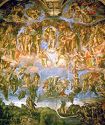
1541 On Feb. 12 after penetrating Chile's central valley, Pedro de Valdivia founds the city of Santiago (Del Nuevo Extremo) (modern-day pop. 7.3M); hostile Indians siege the settlement until reinforcements from Peru arrive in Dec. 1543; once the city is established, he dumps his babe Ines Suarez? In late Feb. Gonzalo Pizarro leads an expedition from Quito into Amazonia with 220 conquistadors, 4K highland natives, and 200 horses in search of the fabled rich El Dorado; the jungle can't support the natives and they all die of starvation, while the Spanish are reduced to eating their horses; they find a waterfall allegedly containing the gold of Atahualpa, but don't find any; on Nov. 9 they reach the Coca River, and by Christmas are on the verge of starvation; after a boat is built using melted-down horsehoes for nails, Francisco de Orellana (1511-46) leads 57 men, incl. Dominican missionary (chronicler and mapmaker) Father Gaspar de Carvajal (1500-84) on a food-gathering expedition, promising to return in a few days, but the current is too strong and they can't return, so they begin descending the network of rivers leading into the Amazon, getting into an epic lock-up-your-daughter adventure (ends 1542), which Carvajal records in his cool Journal of Gaspar de Carvajal. On Apr. 7 Spanish Jesuit missionary ("Apostle of the Indies") (St.) Francis Xavier (Francisco de Jasso y Azpilicueta) (1506-52) leaves Lisbon aboard the Santiago carrying a letter from the pope appointing his apostlic nuncio to the East, reaching Portuguese Mozambique in Aug., then leaving next Mar. for Goa, arriving on May 6 and becoming head of Saint Paul's College, which becomes the first Jesuit HQ in Asia; in Oct. 1542 he sails for the Pearl Fishery Coast at Cape Comorin, converting the Paravas, while failing to reach the high-caste Brahmins but building almost 40 churches; in spring 1545 he sails for Portuguese Malaca, leaving in Jan. 1546 for the Maluku Islands, starting with Ambon Island and returning to Malacca in summer 1547. On May 8 after failing to find the fabled Mayan city of Yupaha (discovered in 2011 near Brasstown Bald Mt. in Ga.?), and reaching Mobile Bay in Ala., then fighting fierce Choctaw chief Tuscaloosa ("black warrior") (-1540), Spanish conquistador Hernando de Soto (1496-1542) and his 400 men discover the Mississippi River (2nd longest river in the U.S. after the Missouri River), and cross it near Randolph, Tenn., then explore Ark., becoming the first Euros to see Hot Springs, then Okla. and Tex. On May 23 Jacques Cartier begins his Third Voyage; in summer he and the Sieur de Roberval attempt to found the Charlesbourg-Royal settlement on the St. Lawrence River near the mouth of the Cap-Rouge River with 400 colonists; in Sept. 1543 after Indian raids, scurvy, and bad weather, it is abandoned. On June 26 Francisco Pizarro (b. 1470) is stabbed by the son of his first business partner in cahoots with Almagro partisans, who set up Almagro's mestizo son Diego de Almagro the Younger (-1542) as gov. of Peru, however royal judge Cristobal Vaca de Castro deposes him next Sept. 16 in a bloody battle in Chupas, and he is executed in Cuzco a few days later, ending the great Almagro name in Peru; Pizarro dies after conquering 480K sq. mi. of Inca territory from Ecuador S through the Andes to Bolivia. On Aug. 18 Duke Henry IV the Pious of Saxony (b. 1473) dies, and he wills that his lands be equally divided between his two sons Maurice I (1521-53) and Augustus I (1526-86), but after this is found contrary to Albertine law the elder son Maurice gets it all (until 1553). On Sept. 28 HRE Charles V personally leads an expedition of 500 ships incl. 80 galleys, 24K Spanish, Italian, and Spanish soldiers, and 12K sailors against Algiers, defended by 5K Ottoman troops and 800 Moors, arriving on Oct. 19, and disembarking troops on Oct. 23, surrounding the city except the N part; too bad, on Oct. 24 a storm disrupts his landing operations, and Adm. Andrea Dorea and old fart Hernan Cortes save some of the fleet from running aground, while Charles V is surrounded and saved only by the stiff resistance of 150 Knights of Malta, after which an indecisive land fight the fleet holes-up in Cape Matifu 5 mi. to the E, and departs for Spain on Nov. 23 after Charles V throws his horses overboard, reaching Cartagena on Dec. 3 with a loss of 130 carracks and 17 galleys plus hundreds of troops, leaving 12K men behind, who are massacred or taken captive, causing a glut on the A lgiers slave market, with Christian slaves going for the price of an onion; the disaster causes Charles V to give up trying to open Christian shipping in the W Mediterranean and lick his wounds. On Oct. 18 Margaret Tudor (b. 1489) dies in Methven Castle in Scotland. On Nov. 12 Queen Catherine Howard is sent to the Tower on suspicion of immoral conduct with Thomas Culpeper, whose chambers are searched, revealing a love letter from Catherine mentioning Lady Rochford, and they, along with Catherine's alleged paramour (when living with her grandmother the Duchess of Norfolk) Francis Dereham are tortured and executed on Dec. 10, Dereham getting the full treatment of hanging-drawing-quartering, and lucky Culpepper only beheading because of his Howard family connections; Catherine Howard is imprisoned in Syon House in Isleworth, NW London. After invading Tir Eogain, new (since July 7, 1540) lord deputy of Ireland Sir Anthony St. Leger (Sellenger) (1496-1559) defeats the Geraldine League and its leader Conn O'Neill, king of Tir Eogain, who is captured and sent to a parliament in Trim, then goes to England to convert to Protestantism and submit to Henry VIII, who creates him the 1st Earl of Tyrone and presents him with a nice gold chain and money, receiving land grants in the Pale in Balgriffin and being made a privy councillor in Ireland, pissing-off his Gaelic Roman Catholic clansmen and causing his son Shane O'Neill (1530-67) to begin a campaign to be recognized as The O'Neill despite the English and branches of his own family backing other claimants; meanwhile Henry VIII convenes the Irish Parliament to pass the 1542 Crown of Ireland Act on June 18, abolishing the high kingship of Ireland and changing his old title of lord of Ireland (conferred by the pope) to king of Ireland, making make him head of the Irish Church, discarding the old fiction that Ireland is a feudal province of the Church and that England was still a Roman Catholic country and establishing the new Kingdom of Ireland (ends Jan. 1, 1801); meanwhile in actual fact the Irish fight for every chance to break free from the stankin' English, who to them are nothing but plunderers - which only makes the Irish pop. more determined to never become Protestant? The Scottish Parliament passes laws to protect the honor of the Mass, prayer to the Virgin Mary, images of the saints, and the authority of the pope. Suleiman I the Magnificent invades and annexes Hungary, and occupies Ofen and the Hungarian capital of Buda on the pretext of protecting infant king John II, setting it up as capital of a Turkish province along the Danube River, which remains in Ottoman hands for 147 years (until 1688), splitting Hungary into three parts, ruled by the Ottomans, the Hapsburg monarchy of Austria, and the principality of Transylvania; Suleiman I allegedly tricks Hungarian gen. Count Balint Torok (Bálint Török) de Enying (1502-51) by inviting him to a sumptuous dinner in his tent and giving him the first coffee tasted by a Euro, while sending his best soldiers to take Buda Castle; meanwhile John II's mommy Isabella continues to rule the principality of Siebenurgen, while the stern rule of George Martinuzzi (1482-1551) causes a cabal against him, which he responds to by switching over to Ferdinand I's side and entering secret negotiations with him. Francisco Vazquez de Coronado sets out from New Mexico on a 2K-mi. expedition across N Tex., the Okla. Panhandle, and E Kan. in search of the fabled rich Seven Cities of Cibola, esp. the city of Quivira (ends 1542); he carves his name and the date on a rock while searching for gold near the Cimarron River 20 mi. from modern-day Kenton, Okla. where the Santa Fe Trail later crosses the river, returning to Mexico City next spring with empty saddlebags after failing to find the fabled Seven Cities of Cibola; meanwhile Hernando de Soto explores the E border of Okla. The Mayans are finally subdued by the Spanish - that's 1521 for the Aztecs, 1531 for the Incas, and 1541 for the Mayans, aim and fire, bada bing, bada boom? An earthquake cracks the water-filled crater of the Agua Volcano (Volcan del Agua), flooding Guatemala City, causing a new capital to be built at Antigua Guatemala (27 mi. from modern-day Guatemala City). The Ottomans seal the Golden Gate on the walls of the Old City of Jerusalem to prevent a possible entrance by the Jewish and/or Christian Messiah, putting a cemetery in front because it's taboo for a Jewish priest to walk through one. A religious conference is held in Ratisbon in Germany, where Johann Eck continues defending Roman Catholicism; meanwhile John Calvin (1509-64) returns to Geneva, which until his death in 1564 becomes his stronghold, and founds the Presbyterian Church, which spreads to Scotland in 1560 via his disciple John Knox, and becomes the state church of Scotland in 1592 - they were smart enough to abandon the corrupt Mother Church, but not smart enough to avoid becoming established churches that persecute enemies like it does? Henry Howard, Earl of Surrey (1517-47), son of Thomas Howard, 3rd duke of Norfolk is made knight of the garter, and in 1543 joins the English army in France, where his prowess gains him the title of field marshal, becoming the man in England needing to wear shades, his future is so bright? Alvar Nunez Cabeza de Vaca leads an expedition through the Rio de la Plata (ends 1542), discovering Iguazu ("big water") Falls on the border of modern-day Brazil and Argentina, largest waterfall on Earth. Architecture: The elaborate Renaissance Lonja (Exchange) de Zaragoza in Saragossa, Spain is begun (finished 1551). Nonfiction: Domingo del Castillo, a pilot for Hernando de Alarcon draws a Map of the Baja Calif., the Gulf of Calif., and the Lower Colorado River. Science: Italian anatomist Giambattista Canano (Canani) (1515-79) pub. an anatomical tract that shows each muscle separately in its relations with the bones. Nonfiction: Johann Eck (1486-1543), Against the Defenses of the Jews; virulent anti-Semitic pamphlet claiming that any attempt by "Jew protector" Andreas Osiander to claim that the "blasphemous race" doesn't kill Christian kids and desecrate the eucharistic host is full of scheisse; "Could they but drown all Christians in one spoon, they would eagerly do it"; a Roman Catholic equals or bests Martin Luther in anti-Semitic rhetoric? Georg Joachim Rheticus (1514-74), Tabula Chorographica auf Preussen und Etliche Umbliegende Lender (Map of Prussia and Neighboring Lands); presented to Duke Albrecht of Prussia. Art: At least it won't drip in my face anymore? Michelangelo (1475-1564), The Last Judgment (1536-41); fresco on the wall of the Sistine Chapel behind the altar of St. Peter's; unveiled on Dec. 25 (Christmas Day); depicts the horrors of ending up in hopeless, faithless, loveless, naked Hell as a result of one's sins, causing Pope Paul III to fall to his knees in fear, mumbling "Lord, save me from my sins on the Day of Judgment"; Michelangelo rejects classical proportions in favor of movement and dramatic effect, and portrays himself as St. Bartholomew, holding his skin after being flayed, showing his contempt for having to do the job; he puts the pope's master of ceremonies Biagio da Cesena in the lower right corner as Minos, judge of the underworld (complete with ass ears) after he criticizes the ignudi (nude figures) on the ceiling; the fresco is painted on the spot where a portrait of Pope Sixtus IV had been erased by Medici Pope Clement VII to get even for the 1478 Pazzi Plot; the abundance of ignudi sparks a "Fig Leaf Campaign", organized by rich, high-living but religiously ultra-orthodox statesman (later archbishop of Naples and cardinal) Oliviero Carafa (1430-1511) and Monsignor Sernini (ambassador of Mantua), who get Daniele Ricciarelli da Volterra (1509-66) hired in 1565 (after the Council of Trent condemns nudity in religious art) to paint over the genitalia, earning him the nickname Il Braghettone (the breeches painter); since St. Blaise (holding his iron combs) is shown behind St. Catherine (holding her breaking wheel) looking at her naked ass, he chisels them both off and repaints them; luckily, Pope Pius IV dies at the end of 1565, and his scaffolding is taken away for the new papal elections, stopping him from messing up the lower half of the fresco; "It was mostly disgraceful that in so sacred a place there should have been depicted all those nude figures, exposing themselves so shamefully, and that it was no work for a papal chapel but rather for the public baths and taverns" (Biagio da Cesena); meanwhile in Dec. Daniele gets a commission to do a series of frescoes in the Orsini Chapel in the Trinita dei Monti, and Michelangelo gives him some sketches to use. Plays: Giovanni Cinzio Giraldi (1504-73), Orbeche (tragedy). Poetry: Clement Marot (1496-1544) and Theodore Beza (1519-1605), Trente Psaumes; a trans. of the Psalms, which becomes wildly popular and advances the cause of the Reformation after being adopted by John Calvin; condemned by the Sorbonne, making it more popular? Births: French "Satire Menippee" poet (in Latin) (Calvinist-turned-Roman Catholic) Florent Chrestien (d. 1596) on Jan. 26 in Orleans; student of Henri Estienne; tutor of Henry IV. Italian grand duke of Tuscany (1574-87) Francesco I de' Medici (d. 1587) on Mar. 25 in Florence; son of Cosimo I de' Medici (1519-74). English earl marshal Walter Devereux, 1st Earl of Essex (d. 1576) on Sept. 16; eldest son of Sir Richard Devereux (-1547) and Dorothy Hastings, daughter of Henry VIII's mistress Anne Stafford; Ottoman historian Mustafa Ali (d. 1600). Polish patriot Jan Zamoyski (d. 1605). English secy. of state William Davison (d. 1608); of Scottish descent. French (Gascon) Huguenot writer-historian Lancelot Voisin de La Popeliniere (Popelinière) (d. 1608). Spanish-Greek Mannerist painter El Greco (Domenikos Theotokopoulos) (d. 1614) in Heraklion, Crete (Repub. of Venice); settles in the old Jewish quarter of Toledo. Greek Catholic Church founder Ipaci Pocei (b. ?). Deaths: Spanish conquistador Francisco Pizarro (d. 1470) on June 26 in Lima (stabbed); dies after conquering 480K sq. mi. of Inca territory from Ecuador S through the Andes to Bolivia. English countess Margaret Pole of Salisbury (b. 1473) on May 27 in the Tower of London (executed); last member of the House of Plantagenet other than her son Cardinal Reginald Pole (1500-58), who says he will "never fear to call himself the son of a martyr"; the beheading is bloodily botched, requiring 11 axe strokes; beatified on Dec. 29, 1886 by Pope Leo XII. German Protestant Saxon duke (1539-41) Henry IV the Pious (b. 1473) on Aug. 18 in Dresden. Italian astronomer-diplomat Celio Calcagnini (b. 1479) in Ferrara. French portrait painter Jean Clouet (b. 1480). Spanish sculptor Damia Forment (b. 1480) in Santo Domingo de la Calzada; dies after completing the Renaissance altar of the Cathedral of Santo Domingo de la Calzada (begun 1537). Lithuanian grand hetman Jerzy Radziwill (b. 1480) in Apr. German magician Johann Georg Faust (b. 1480) in Staufen im Breisgau; dies after an alchemical explosion in Hotel zum Lowen, his "greviously mutilated" body whose face kept turning to the ground despite the body being turned on its back being taken as proof that the Devil hd personally come to collect. Spanish conquistador Pedro de Alvarado (b. 1486) in Mexico; killed in an Indian revolt. German Protestant leader Andreas Bodenstein von Karlstadt (AKA Brother Andrew) (b. 1486) on Dec. 24. Scottish queen (1502-13) Margaret Tudor (b. 1489) on Oct. 18 in Methven Castle, Perthshire. Jewish mystery man David Reubeni (b. 1490) (d. 1535?) in Spain (Portugal?). German-Swiss physician-alchemist-philosopher Paracelsus (b. 1493) on Sept. 24 in Salzburg; dies having failed to find the "alkahest" (universal solvent) (a term he coined): "Medicine is not only a science, it is also an art"; "So I have traveled throughout the land and was a pilgrim all my life, alone and a stranger feeling alien. Then Thou has made grow in me Thine art under the breath of the terrible storm in me." Flemish composer Wulfard Hellinck (b. 1496). English courtier Thomas Culpeper (b. ?) on Dec. 10 in Tyburn (beheaded). Am. courtier Francis Dereham (b. ?) on Dec. 10 in Tyburn (executed).


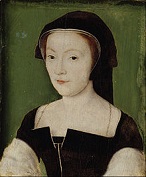





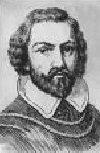
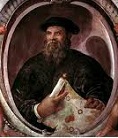

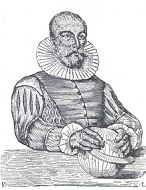
1542 In the last 50 years 300K Spaniards have emigrated to the New World, while the cruel mistreatment of the Caribbean aborigines has almost exterminated them; the Spanish monarchs finally ban the enslaving of Caribbean natives this year (what's left of them). On Jan. 6 after horribly kicking a bunch of Mayan butt, the Spanish under Francisco de Montejo El Mozo set up their capital in the Mayan city of T'ho, which they rename Merida (Mérida); the lord of Mani converts to Roman Catholicism, aiding the conquest of the rest of the peninsula; meanwhile on Nov. 20 the Spanish audiencia of Confines de Guatemala y Nicaragua is established, with jurisdiction over Chiapas and Guatemala, adding Yucatan in 1549 (until 1560). On Jan. 8 Francisco de Orellana's expedition reaches the Napo River ("River of Cinnamon"), and they become the first Europeans to enter Amazonia, visiting the Lumara and other Indian tribes along the way, and building a dictionary of their languages while infecting them with white man's diseases incl. smallpox; meanwhile, Gonzalo Pizarro and his starving men finally give up on them and turn back, fighting hostile Indians and the elements in an epic hellish struggle before a pitiful few straggle back half-naked with only their swords, Pizarro swearing that Orellana is "the worst traitor that ever was" and vowing to have him executed; by this time Orellana's party finds lodging with the Apurina (Apurinã) people on the Purus River, and rests for 2 mo. while building a 30-ft. boat, leaving in late Apr. to finish the remaining 2K mi. down the river to the Atlantic, passing the Lost Empire of the Amazon (the Amajua Confederation), crossing the border into Brazil, passing the Rio Negro (Negro River) (with inky black water that flows for 430 mi. before mixing with the silty water of the Amazon River), and finally reaching the mouth of the Amazon River in Aug. after 8 mo. and 2.5K mi. on the river with 47 survivors; after beating the treason charges with his cool Journal, he returns to Spain, gets appointed gov. of Amazonia, spends 11 mo. trying to find the mouth again, and dies in parts unknown. On Feb. 13 after more evidence is dug up and a bill of attainder passed by Parliament, Henry VIII's 5th wife Catherine Howard (b. 1520) is executed in the Tower of London on charges of adultery, becoming the last wife he executes; her lady-in-waiting Jane Boleyn, viscountess Rochford (b. 1505) (who had gone insane, causing the king get a law passed allowing the execution of the insane) is executed next after giving a long speech showing she wasn't really?; not that all the Howards are in equal trouble, as her uncle Thomas Howard, 3rd duke of Norfolk is sent to lead an English expedition into Scotland with his son Henry Howard, although he loses his influence at court. In the spring Francisco Vazquez de Coronado returns to Mexico City with empty saddlebags after failing to find the fabled Seven Cities of Cibola - you-u-u-u made me leave my happy home? On May 21 Spanish explorer Hernando De Soto (b. 1496) dies of fever in the Indian village of Guachoya on the banks of the Mississippi River near modern-day McArthur, Ark.; his men, who had been trying to palm him off as a god try to disguise his death and sink him in the river in the night, but the natives see through it, and the expedition decides to return home, building ships and sailing in July down the Mississippi River, continuing to the Panuco River, where they find refuge in the Spanish frontier town of Panuco, then return to Mexico City a mo. later, with 311 of the original 620; the expedition was a dud, but it did leave horses and swine with the Indians, along with Euro diseases, causing permanent hostility. In May Jesuit missionary (St.) Francis Xavier (Francisco Javier) (1506-52) arrives in Goa after a 13-mo. sea voyage from Lisbon. In summer after pissed-off Roman Catholic peasants in Smaland in S Sweden under the leadership of Nils Dacke (-1543) start the Dacke War, a revolt against Lutheran king Gustavus I Vasa; next Aug. Dacke is killed, and the revolt is quashed. In July taking advantage of Spain's weakened navy, the Moors under Hassan Agha attack Mers El Kebir (Kébir) ("the Great Harbor"), harbor of Spanish-held Oran in NW Algeria. On Aug. 28 the Battle of Wofla near Lake Ashenge in Tigray, Ethiopia sees an army of 600-900 Ottoman musketeers and 20 Ottoman cavalry along with several thousand soldiers led by imam Ahmad ibn Ibrihim al-Ghazi (b. 1507), of the Muslim Sultanate of Adal crush a Portuguese expeditionary force of 290 musketeers and 23 Ethiopians, killing leader Cristovao da Gama (b. 1516) along with 160 Portuguese and eight Ethiopians, and capturing most of their muskets. In Aug. after Henry VIII renews his claim to be overlord of Scotland, the Scots under the earl of Huntly defeat the English under Lord Thomas Howard, 3rd duke of Norfolk at the Battle of Haddon Rig near Berwick, causing Norfolk to abandon his invasion of Scotland in Oct., and the Scots to plan an invasion of England. On Sept. 28 Portuguese navigator Juan Rodriguez Cabrillo (-1543), sent by New Spain viceroy Antonio de Mendoza in search of a northern strait discovers California (Calif.), landing at modern-day San Diego, and continuing N, discovering Monterey Bay on Nov. 16, and naming it Bahia de los Pinos because of the forest of pine trees; too bad, colonization is slow, and the first Spanish mission isn't founded until 1769 - why not call it Cabrillofornia? On Nov. 1 New Spain vicery Antonio de Mendoza sends an expedition of six galleons and 370-400 men led by Spanish explorer Ruy Lopez de Villalobos (1500-44) from New Spain to the "Islas del Poniente" (Islands of the West), taking Ferdinand Magellan's route, and after discovering Eniwetok (Enewetak) Atoll they enter Baganga Bay next Feb. 29, discovering Mindanao, which Lopez names Caesarea Karoll after Charles V, receiving a friendly reception, staying 32 days and suffering famine before leaving on Mar. 31, being intercepted by Portuguese ships wanting to know why there are trespassing on Portuguese territory; after hostile reception by the natives and more Portuguese, Villalobos is imprisoned by the Portuguese on Amboyna Island, where he dies next Apr. 4 after giving the name "Islas Felipinas" (Philippines) (after Charles V's son Philip II) to the Leyte region, which is later extended to the whole archipelago; 85 remaining crew members are shipped back to Lisbon on a Portuguese ship, and the rush to make the Philippines Philip's begins. On Nov. 2 HRE Charles V issues the New Laws of the Indies for the Good Treatment and Preservation of the Indians, inspired by Bartolome de las Casas, easing the plight of Indian slave labor; on Mar. 25 1544 New Spain viceroy Antonio Hurtado de Mendoza proclaims them; too bad, when the Spanish encomienda grant-holders balk, he takes a clue from what happened in Peru and revokes them. On Nov. 24 after a 15K-18K-man Scottish army under Robert Maxwell, 4th Lord Maxwell (1493-1546) (one of the ambassadors sent to France in 1537 to negotiate the marriage of James V to Mary of Guise) attempts to invade England, it is routed at the Battle of Solway Moss by a 3K-man English force led by Sir Thomas Wharton, 1st Baron Wharton (1495-1568) after James V unexpectedly places his favorite Sir Oliver Sinclair de Pitcairnis (St. Clair) (-1576) of Roslin (grandson of the Oliver Sinclair who completed Rosslyn Chapel in the 1480s) in charge of the Scottish army, who don't respect him and abandon the field, after which he is caught between a bog and a river, giving up after only a few are killed, Sinclair being captured along with 1.2K POWs, incl. Lord Maxwell and his eldest son Robert, who are kept as insurance for many years, the English rumoring that he preferred to be captured rather than face mean 30-y.-o. James V (b. 1511), who remains behind in Lochmaben, then hides in Falkland Palace in Fife, where he contracts a fever, then "turns his face to the wall and dies" (another untimely Stewart death) on Dec. 14 (same place where David Stewart was starved to death in 1402, then remodeled in the French style by James V), six days after the disappointing Dec. 8 birth in Linlithgow Palace (overlooking Loch Lothian) of Mary Stuart (Stewart), Queen of Scots (1542-87) to his French-born wife Mary of Guise (1515-60), who had borne sons James in 1540 and Arthur in 1541 only to see them both die in 1541, exactly like James IV's first two sons of the same names; on Dec. 14 Mary Stuart is declared queen, with James Hamilton, 2nd earl of Arran appointed gov. (regent); John Knox later claims that on his deathbed James V hears of the birth, then says, "It cam wi' a lass and it'l gang wi' a lass"; Sir Walter Scott later claims he used to visit his subjects incognito as "the guidman of Ballengreich". The 6-year struggle of the Danish party to throw out German counselors results in a Herredag in Copenhagen, with the charter amended requiring native-born Danes to fill high state offices, and the Danish nobles voting Christian III a 5% tax on their property to pay off the war debt owed the Germans and Holsatians. Pope Paul III establishes the Holy Office (Congregation for the Doctrine of the Faith) (Supreme Sacred Congregation of the Roman and Universal Inquisition) in Rome to intercept appeals from defendants of the Inquisition and forward them directly to the Holy See, ending up being used to speed up the persecution of scientists promoting Copernicus' heliocentric system - I'm feeling really nonjudgmental today? The Second Laws in Wales Act (first in 1535) completes the annexation of the legal system of Wales to England. HRE Charles V offers a 100 guilders reward for the arrest of Mennonite founder Menno Simons; by the year 2000 there are 1.3M Mennonites (why not Simonites?) in 65 countries, opposing the taking of oaths, military and govt. service, and favoring plain dress and living - the original Jehovah's Witnesses without the door-knocking? The real Shogun, not starring Richard Chamberlain? Antonio da Moto and other Portuguese sailors become the first Europeans to reach Japan when they land at small Tanegashima Island in Kagoshima (off the S coast of Kyushu) aboard a shipwrecked Chinese ship; the muskets they are carrying are quickly copied, and spread all over Japan; too bad, they also bring Jesuits - changing the way they clean their houses? Lord high adm. (since 1540) John Russell, 1st Earl of Bedford (1485-1555), ancestor of philosopher Bertrand Russell is made lord privy seal of England (not created earl until 1550). French king Francis I goes to war against the Habsburgs and HRE Charles V for the 4th time, allied with the Ottomans; Charles V allies with Henry VIII. HRE Charles V gives Milan to his son Philip II of Spain. The Spanish viceroyalty and audiencia of Peru is created, with Blasco Nunez (Núñez) de Vela (1490-1546) as viceroy #1 of Peru (until Jan. 18, 1546); too bad, Charles I charges him with enforcement of the dangblasted none-too-popular New Laws of the Indies, providing for more humane treatment of aboriginal indios and the eventual abolition of the encomiendas, causing the Spanish conquistadors, led by Gonzalo Pizarro to calculate the odds of an independent Peru - the Ten What? After traveling 1K mi. through S Brazil, Alvar Nunez Cabeza de Vaca arrives in Asuncion, Paraguay with colonists and a Spanish royal commission to become gov., but Domingo de Irala challenges him and gains royal confirmation instead in 1544. Cochabamba Valley (Quecha "cocha" + "pampa" = lake + plain) in C Bolivia is first settled by Garcia Ruiz de Orellana. Francisco Vazquez de Coronado crosses W Okla. in search of the golden city of Quivira, claiming it for Spain; meanwhile Hernando de Soto explores the E border of Okla., and Don Diego del Castillo explores the Wichita Mts. for 6 mo. looking for gold and silver; in spring 1542 Coronado returns to Mexico City with empty saddlebags after failing to find the fabled Seven Cities of Cibola - you-u-u-u made me leave my happy home? San Miguel El Grande on the altiplano in Mexico between Sierra Madre Occidental and Sierra Madre Oriental in modern-day E Guanajuato, Oaxaca is founded by Franciscan monk Frey Juan de San Miguel, becoming an important stop on the Old Camino Real silver route from Zacatecas; renamed San Miguel de Allende in 1826 after Spanish gen. Ignacio Allende (1769-1821). The English Parliament makes witchcraft a capital crime; the law carries over to English colonies - gotta fight that Devil Inside wherever we go? Bavaria places heavy taxes on drinks. Buckingham College in Cambridge, England (founded 1428) is refounded as Magdalene College (pr. MOD-lin) by chancellor Sir Thomas Audley; not to be confused with Magdalen College in Oxford, founded in 1448. Henry VIII's gardener brings the apricot from Italy to England. Inventions: In 1537 Portuguese mathematician Pedro (Petrus Nonius) (1502-78) invents the Nonius, predecessor of the Vernier scale. Science: French physician Jean Fernel (1497-1558) becomes the first to observe that when the ventricles contract (systole), the arteries increase in size due to the blood entering them; an accurate understanding of heart circulation is still far off. Nonfiction: Alvar Nunez Cabeza de Vaca (1490-1557), Naufragios (original title: "La Relacion y Comentarios"); an account of his journeys in the U.S. Southwest in 1528-36, containing detailed accounts of the tribes he encountered while acting as a trader and faith healer, making him a proto-anthropologist. Valerius Cordus (1515-44), Dispensatorium; a pharmacopeia, presented to the city council of Nuremberg; becomes central to the war between physicians, apothecaries, and midwives. Jean Fernel (1497-1558), De Naturali Parte Medicinae; establishes his rep as a top French physician, and becomes part 1 of his 3-part Universa Medicina. Leonhard Fuchs (1501-66), Glossary of Botanical Terms; shows no attempt at comparative morphology. Edward Halle (1497-1547), The Union of the Two Noble and Illustre Famelies of Lancastre and York (Hall's Chronicle) from Henry IV (1367-1413) to Henry VII (1399-1547); 2nd ed. by Richard Grafton in 1548; a main source used by Shakespeare for his historical plays. David Joris (1501-56), 'T Wonder Boeck (The Wonder Book); pub. anon. Pedro Nunes (1502-78), About the Twilight (De Crepusculis). Georg Joachim Rheticus (1514-74), De Lateribus et Angulis Triangulorum (On the Sides and Angles of Triangles). John Rotz, Map of South Am.; shows Indians carrying brazilwood logs to trade with Euros. Poetry: Antoine Heroet (-1568), La Parfaicte Amye (Lyons); develops the idea of purely spiritual love based on the Italian Neo-Platonists, causing a firestorm of controversy. Music: Benedictus Appenzeller (1480-1589), Des Chansons a Quattre Parties (Antwerp). Births: English naval cmdr. Sir Richard Grenville (Greynville) (d. 1591) on June 15 in Bideford, Devon; of Cornish descent; son of Sir Roger Grenville (-1545), son of Sir Richard Grenville (1495-1550); grandfather of Sir Richard Grenville (1600-58); cousin of Sir Walter Raleigh and Humphrey Gilbert. Spanish supermystic Roman Catholic Carmelite monk poet (St.) John of the Cross (San Juan de la Cruz) (Juan de Yepes y Alvarez) (d. 1591) on June 24 in Fontiveros (near Avila); feast day: Nov. 24. English nobleman (Roman Catholic) Charles Neville, 6th Earl of Westmorland (d. 1601) on Aug. 18; son of Henry Neville, 5th earl of Westmorland (1525-65) and Lady Anne Manners, 2nd daughter of Thomas Manners, 1st earl of Rutland; grandson of Ralph Neville, 4th Baron of Neville and 1st Earl of Westmoreland (1364-1425); husband (1563-) of Jane Howard (1533-93). husband (1560-76) of Lettice Knollys (1543-1634); created earl on May 4, 1572. Spanish navigator-explorer Alvaro de Mendana (Mendaña) de Neyra (Neira) (d. 1595) on Oct. 1 in Congosto, Leon. Italian Roman Catholic Jesuit bishop and cardinal (1599-) (St.) Robert Bellarmine Bellarmino) (d. 1621) on Oct. 4 in Montepulciano, Tuscany; nephew of Pope Marcellus II; teacher of St. Aloysius Gonzaga (1568-91); canonized on June 29, 1930 by Pope Pius XI; declared a doctor of the Church in 1931; feast day: Sept. 17 (May 13); "The Church of God had not his equal in learning." (Pope Clement VIII) Indian Mughal (Mogul) emperor #3 (1556-1605) (Sunni Muslim) Akbar the Great (Jalaluddin Muhammad Akbar) (d. 1605) on Oct. 15 in Umerkot, Sind; son of Humayun (1508-56); father of Jahangir (1569-1627). Scottish Stewart queen (1542-67) and queen consort of France (1559-60) Mary Stuart (Stewart), Queen of Scots (Mary I) (d. 1587) on Dec. 8 in Linlithgow, West Lothian; daughter of James V (1512-42) and Mary de Guise (1515-60); first bride to wear white to a wedding; first golfer to use a caddy; her doctor invents marmalade. German "St. Matthew Passion" composer Jakob Meiland (d. 1577) in Hechingen. Scottish leader (Roman Catholic-turned-Protestant) Esme (Esmé) Stewart (Stuart), 1st Duke of Lennox, 1st Earl of Lennox (d. 1583); cousin of Lord Darnley, father of James VI/I (his lover?). Japanese samurai Hattori Hanzo (Masanari) (d. 1596) in Mikawa Province. Korean PM (1592-) Yu Seong-ryong (d. 1607) in Uiseong, Gyeongsang Province; learns the teachings of Confucius by age 8? Italian Mannerist painter Federico (Federigo) Zuccari (d. 1609) in Sant'Angelo, Vado (near Urbino). English poet-novelist Nicholas Breton (Britton) (Brittaine) (d. 1626) in Layer Breton, Essex. Deaths: Russian abbot Philotheos of Pskov (b. 1465). Italian "Mona Lisa" model Lisa del Giocondo (b. 1479) on July 15 in Florence; bured in Sant'Orsola Convent; her remains are disinterred in 1985 to build an underground garage and end up in a Florence garbage dump? Italian Luther-opposing cardinal Hieronymus Aleander (b. 1480) on Feb. 1. Italian painter Dosso Dossi (b. 1483). Belgian Flemish painter Barend van Orley (b. 1490) on Jan. 6 in Brussels. Swiss-German composer Ludwig Senfl (b. 1492). Spanish explorer Hernando De Soto (b. 1496) on May 21 in the Indian village of Guachoya on the banks of the Mississippi River near McArthur, Ark. (fever). Spanish poet Diego Hurtado de Mendoza (b. 1503). English poet Sir Thomas Wyatt (b. 1503) on Oct. 11. German adventurer Nikolaus Federmann (b. 1505) in Feb. in Valladolid, Spain. English noblewoman Jane Boleyn, Viscountess Rochford (b. 1505) on Feb. 13 in the Tower London (beheaded). Scottish king (1513-42) James V (b. 1512) on Dec. 14 in Falkland Palace, Fife. English queen (royal wife #5) Catherine Howard (b. 1520) on Feb. 13 in the Tower of London (beheaded); last words: "I die a Queen, but I would rather have died the wife of a Culpepper"; the Ghost of Catherine Howard allegedly haunts Hampton Court and the Tower of London.


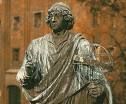






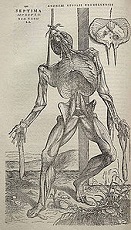



1543 Earl in the year Gustavus I Vasa of Sweden double-crosses the Dacke rebels, and defeats them; Dacke's followers then double-cross and kill him. On Feb. 21 the Battle of Wayna Daga (Amharic for "grape-cultivating altitude") E of Lake Tana in Ethiopia sees 8.5K Ethiopian Christians led by Solomonic emperor (since 1540) Gelawdewos and aided by 70 Portuguese musketeers and 60 cavalry fight 14K infantry and 1.2K cavalry from the Muslim Sultanate of Adal led by imam Ahmad ibn Ibrihim al-Ghazi (b. 1507), who is KIA by a Portuguese musketeer, ending the Ethiopian-Adal War (begun 1529). On Mar. 14 Pope Paul III issues the bull Injunctum Nobis, removing the 1540 membership limitation on the Jesuits. The original Coppertone Baby kept his ass out of the Sun on purpose? On May 24 (May 14 Old Style) (Mon.) Nicolaus Copernicus (Lat. "copper worker") (b. 1473) dies in Frombork, Poland after allegedly awakening from a stroke-induced coma long enough to view the first printed copy of his magnum opus Six Books on the Revolutions of the Celestial Orbits (De Revolutionibus Orbium Coelestium), advancing the Heliocentric Theory (which he had shelved, claiming it to be incomplete or even erroneous, but more likely afraid of Catholic reprisals?), which was pushed through the press by his one and only pupil Georg Joachim Rheticus (Rhaeticus) (von Lauchen) (1514-74) (a Lutheran math prof. whose father had been executed for heresy), and is pub. posth. in safe Protestant Nuremberg; it is (fawningly?) dedicated to Pope Paul III, and incl. a cautious (mendacious?) Preface by Andreas Osiander (1498-1552) of Konigsberg, stating that the revolution of the Earth is a mere mathematical convenience and not necessarily a physical fact (although Coppertone Baby had considered it otherwise?); "There have already been widespread reports about the novel hypotheses of this work, which declares that the Earth moves whereas the Sun is at rest in the center of the Universe. Hence certain scholars, I have no doubt, are deeply offended and believe that the liberal arts, which were established long ago on a sound basis, should not be thrown into confusion. But if these men are willing to examine the matter closely, they will find that the author of this work has done nothing blameworthy. For it is the duty of an astronomer to compose the history of the celestial motions through careful and expert study. Then he must conceive and devise the causes of these motions or hypotheses about them. Since he cannot in any way attain to the true causes, he will adopt whatever suppositions enable the motions to be computed correctly from the principles of geometry for the future as well as for the past. The present author has performed both these duties excellently. For these hypotheses need not be true nor even probable. On the contrary, if they provide a calculus consistent with the observations, that alone is enough. Perhaps there is someone who is so ignorant of geometry and optics that he regards the epicyclc of Venus as probable, or thinks that it is the reason why Venus sometimes precedes and sometimes follows the Sun by forty degrees and even more. Is there anyone who is not aware that from this assumption it necessarily follows that the diameter of the planet at perigee should appear more than four times, and the body of the planet more than sixteen times, as great as at apogee?"; "The massive bulk of the Earth does indeed shrink to insignificance in comparison with the size of the heavens" (Copernicus); the kind of reception awaiting Copernicus' followers is shown right away, when the first Auto da Fe, AKA Act of Faith, or burning alive of heretics (Protestants) by the Spanish Inquisition dressed in weird sinister hoods takes place in the island of Goa in SW India (goa to Hell, you heretics?), and Pope Paul III issues his first Index Librorum Prohibitorum (Index of Prohibited Books); each lucky heretic gets to wear a black sanbenito painted with flames and devils to his own BBQ - toast them marshmallows on a stick, hooray for Christ? On July 1 the Treaty of Greenwich is signed in an attempt to provide peace between Scotland and England for the lifetimes of Henry VIII and 1-y.-o. Mary, Queen of Scots, calling for her marriage to Henry's sickly son Prince Edward (VI). In July the Third Succession to the Crown Act names Henry VIII's heirs as Edward, Mary, and Elizabeth, then the heirs of his younger sister Mary Rose Tudor, Duchess of Suffolk (1496-1533), which incl. Lady Jane Grey; Elizabeth's bastard status is left unchanged. The English game is now parr six? In July Henry VIII (more in need of a nurse than a wife?) marries previously broken-in Catherine Parr (1512-48), his 6th and last wife and the only one other than Anne of Cleves to not get her head parted or cleaved from her body and survive him; the list now incl. Catherine of Aragon, Anne Boleyn, Jane Seymour, Anne of Cleves, Catherine Howard, and Catherine Parr (CAJACC) (3 Catherines, 2 Annes, and 1 Jane); Parr's first hubby was Lord Borough. Turkish adm. Barbarossa II cruises toward Marseille with 210 ships and 30K troops to assist his ally Francis I of France, captures Reggio Calabria, lands on the coasts of Campania and Lazio, threatens Rome from the mouth of Tiber until Francis I intervenes to tell him to cool lit, then satisfies himself with raiding several Italian and Spanish settlements, then sieges Nice, which holds them off a long time but gives up on Aug. 5, after which Barbarossa takes 2.5K captives and pillages the city; he then lands at Antibes and Ile Sainte-Marguerite near Cannes, sacks San Remo, Monaco, and La Turbie, then winters in Toulon while sending occasional ships to bombard Spanish costal cities. On Sept. 9, 1543 Mary Stuart (1542-87) is crowned queen of Scotland in Stirling (until July 24, 1567), becoming known as Mary, Queen of Scots; too bad, within months her betrothal is cancelled by the Scottish Parliament under urging of her pro-Roman Catholic guardians; Henry VIII responds with plans to occupy S and E Scotland in the Rough Wooing, causing Mary to be kept in Stirling for safety, driving Scotland back into the arms of the French; the Scottish Parliament removes the prohibition against vernacular Bibles. On Nov. 1 the U. of Pisa (founded 1343) is officially refounded by Cosimo I de' Medici, who next year founds the Orto Botanico di Pisa, becoming te first univ. botanical garden in Europe. On Dec. 29 the reign of Ivan IV the Terrible (1530-84) in Russia begins when he tells his regents to stuff it and calls his boyars together, then orders boyar leader Prince Shishkabobsky, er, Andrei Shuisky thrown into a pit of starving dogs; the Russian term Grozny actually means Awesome (a term of respect) not Terrible, although he amply lives up to the latter name through his violent unpredictable behavior? - how about Gross? Future Philip II of Spain marries Maria of Portugal. An English army led by Henry Howard fights on the side of HRE Charles V in an effort to acquire the Netherlands. King Sigismund of Poland grants the right of coining money to his vassal the Duke of Prussia, causing the Estates of Poland to pass a decree that that privilege is inseparable from the crown. After getting the Sorbonne pissed-off, Clement Marot flees France for Geneva, followed by Piedmont. Portugal passes a law ordering a search for descendants of Jews so they can be expelled. The first Portuguese land in Japan on Tanegashima Island, introducing firearms to Japan. Juan Rodriguez de Cabrillo (b. 1499) dies of gangrene on Santa Catalina Island, and his pilot Bartolome (Bartolomé) Ferrelo (1499-1550) continues the expedition, exploring the Pacific coast as far as Oregon. Nimjegen, Netherlands-born (St.) Peter Canisius (1521-97) becomes the first German to join the Jesuits, going on to become a leader of the Counter-Reformation. Speaking of Prohibited Books? The Spirituali Movement in Rome, which hopes to reform the Church without splitting like the Protestants pub. the anon. The Benefit of Christ's Death (Beneficio di Cristo), their masterpiece proving that salvation comes through faith in Christ alone, not through works or the Church; after they pub. 40K copies, the Church declares it heretical and places it on the Prohibied Index and starts to come down on them, but Pope Julius III purposely slows down the Inquisition until his death, after which Pope Julius IV lets the dogs loose and exterminates them by the 1560s. Architecture: Clover-leaf-shaped Hurst Castle on Pebble Split in Hampshire (old Wessex) is built by Henry VIII to guard the coast. Inventions: Spanish navigator Blasco da Garay designs a steamboat for HRE Charles V. Nonfiction: Girolamo Cardano (1501-76) (tr.), Euclid's Elements; first trans. into a modern Euro language, correcting errors in the Latin trans obtained from an Arabic source, esp. in Book V, becoming a favorite of Galileo. Petrus Ramus (1515-72), Animadversiones in Dialecticam Aristotetlis (Criticisms of the Aristotelian Dialectic); pisses off the learned doctors of the Sorbonne, who get Francis I to issue an edict to suppress it; Ramus counters by getting a job as pres. of the College de Presles in 1545 - the original Little Richard and Elvis Presley put together? Niccolo Tartaglia (1500-57) (tr.), Euclid's Elements; the first into a modern language (Italian) - collective groan from zillions of schoolboys? Andreas Vesalius (Andre Vesale) of Brussels (1514-64), The Fabric of the Human Body (De Humani Corporis Fabrica) (7 vols.), and the companion vol. Epitome (both in Basel); illustrations by Titian's studio; the first illustrated anatomy of the human body, and the most detailed and extensive to date - is it Science or is it Porno? Martin Luther (1483-1546), On the Jews and Their Lies; calls for their Nazi-like persecution incl. pogroms 400 years before the little-miss-sunshine Nazis, causing their persecution and expulsion from Prague, Worms, Vienna, Genoa, and the papal states over the next 130 years; "A base, whoring people, that is, no people of God, and their boast of lineage, circumcision, and law must be counted as filth"; "Full of the Devil's feces... which they wallow in like swine" (synagogues); "Incorrigible whore and an evil slut". Art: Benvenuto Cellini (1500-71) designs a gold-ivory-enamel Saliera (Saltcellar) for Francis I of France, featuring nude figures of Earth (female) and Sea (male), which becomes his only gold sculpture to survive to modern times; on May 1, 2003 it is stolen from the Kunsthistorisches Museum in Vienna in a smash-and-grab robbery in which the guards miss the event and have no clue as to who did it; 3 years later it is found in a forest N of the city. Lorenzo Lotto (1480-1556), Christ Giving His Blood; Husband and Wife. Il Sodoma (1477-1549), Sacred Conversation (Sacra Conversazione); St. Sebastian with Madonna and Angels. Titian (1477-1576), Ecce Homo. Births: Japanese Tokugawa shogun #1 (1603-16) Tokugawa Ieyasu (Iyeyasu) (Matsudaira Takechiyo) (d. 1616) on Jan. 31 in Mikawa. German Wittelsbach prince (Calvinist) John Casimir, Count Palatinate of Simmern (d. 1592) on Mar. 7 in Simmern; 3rd and youngest son of Elector Palatine Frederick III and Marie of Brandenburg-Kulmbach. English "My Mynde to Me a Kingdome Is" poet-courtier (Rosicrucian?) Sir Edward Dyer (d. 1607) in Oct. in Sharpham Park, Somerset; educated at Balliol College or Pembroke College, Oxford U. English noblewoman Lettice (Laetitia) Knollys (d. 1634) (pr. like knolls) on Nov. 8 in Rotherfield Greys, Oxfordshire; wife (1560-76) of Walter Devereux, 1st earl of Essex (1541-76), (1578-88) Robert Dudley, 1st earl of Leicester (1532-88), and (1589-1601) Sir Christopher Blount (1555-1601); mother of Robert Devereux, 2nd earl of Essex (1565-1601) and Lady Penelope Rich (1563-1607). Italian anatomist and papal physician (to Gregory XIII). Constanzo Varolio (d. 1575) in Bologna. English navigator and buccaneer ("the Queen's Pirate") ("Il Gran Luterano") Sir Francis Drake (d. 1596) in Tavistock, Devon (b. 1549)?; first Englishman to go around and come around the Earth; knighted in 1581 - I don't sweat the small stuff? English novelist-balladist Thomas Deloney (d. 1600). Italian Roman Catholic missionary (to China) Michaele Ruggieri (d. 1607). Swiss architect Domenico Fontana (d. 1607) in Melide (modern-day Ticino), Switzerland (near Lake Lugano); protege of Pope Sixtus V. Scottish judge Sir John Skene, Lord Curriehill (d. 1617). Jewish Qabbala mystic Hayim (Chaim) ben Yosef Vital (d. 1620) in Safed, Palestine; successor of Rabbi Isaac Luria (1534-72). Deaths: Da Man Wid Da Plan Himself? Polish astronomer Nicolaus Copernicus (b. 1473) on May 24 in Frombork (Frauenburg), Warmia (180 mi. N of Warsaw) (stroke); on Nov. 3, 2008 Polish archeologists based in Pultusk in C Poland announce the discovery of his grave under the floor of Frombork Cathedral; on May 22, 2010 Roman Catholic clerics bless his remains with holy water and he is reburied as a hero. German margrave George the Pious (b. 1484) on Dec. 27. German anti-Reformation Catholic theologian Johann Eck (b. 1486). French humanist diplomat Guillaume (William) du Bellay, lord of Langey (b. 1491); dies en route from Turin, Italy to France, with his physician Francois Rabelais present, who eulogizes him in "Garantua and Pantagruel", Bk. III, Ch. 21 and Bk. IV, Ch. 27. Swiss-German composer Ludwig Senfl (b. 1492). Italian poet Agnolo Firenzuolo (b. 1493). Italian painter Polidoro da Caravaggio (b. 1495) (strangled in bed by a workman with a cloth, who is tortured, hung, drawn, and quartered). German Anabaptist leader Melchior Hoffman (b. 1495); dies in prison; leaves writings that influence Menno Simons and David Joris; his followers are called Hoffmanites or Melchiorites. German painter Hans Holbein the Younger (b. 1497). Spanish explorer Juan Rodriguez Cabrillo (b. 1499) on Jan. 3 in Santa Catalina Island (gangrene). German humanist writer Sebastian Franck (b. 1499): "To substitute Scripture for the self-revealing Spirit is to put the dead letter in the place of the living Word."






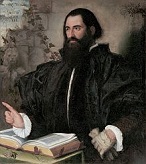

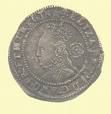
1544 In the spring the Ottomans under adm. Barbarossa II siege San Remo, Italy for a 2nd time, then land at Borghetto Santo Spirito and Ceriale, defeat a Spanish-italian fleet and raid the kingdom of Naples, after which they reach Genoa with 210 ships and demand the release of Ottoman adm. Turgut Reis (Capt. Dragut) (Capt. Darhouth) (1485-1565); after Adm. Andrea Dorea parleys with Barbarossa, he agrees to release him in exchange for 3.5K gold ducats; in May after repulsing Spanish attacks on S France, Barbarossa assaults San Remo a 3rd time, sails to Vado Ligure in N Italy, and takes a bribe to stop further attacks on Genoese cities, then in June arrives in Elba, threatening to bombard Piombini unless the son of Sinan Reis is released, then captures Castiglione della Pescaia, Talamone, and Orbetello in Grossetto, Tuscany, followed by Montiano, Porto Ercole, and Giglio Isle, and sieges Citavecchia until French envoy Leone Strozzi (1515-54) of Florence calls him off; he then assaults Sardinia, lands in Ischia in July, captures Forio and the Isle of Procidia, meets 30 galleys under Giannettino Doria in front of Pozzuoli and chases them away to Messina, then tries to attack Salerno but has to call it off because of strong winds, landing at nearby Cape Palinuro, after which he enters the Strait of Messina and lands at Catona, Fiumara, and Calanna near Reggio Calabria, followed by Cariati and Lipari, bombarding it for 15 days until he captures it; he is then recalled to Istanbul after Sultan Suleiman and HRE Charles V agree to a truce, retiring next year in Istanbul, and dying in 1546 after writing 5-vols. of Memoirs of Hayreddin Pasha ("The Mediterranean Was Ours"). In the summer the Siege of St. Dizier sees the imperial army of HRE Charles V siege St. Dizier on its advance into Champagne, and on July 13 Cahrles V arrives with an army of 14.1K men incl. 1.6K sappers; on July 15 Rene of Chalon (b. 1519) dies in the siege, with Charles V at his bedside, and his 11-y.-o. Lutheran 1st cousin William of Nassau-Dillenburg AKA William I the Silent (Taciturn) (1533-84) becomes prince of Orange (until July 10, 1584), with HRE Charles V as regent, who requires the Lutheran boy to get a Roman Catholic education, which doesn't take; William I founds the House of Orange-Nassau, later leading the Dutch revolt against the Spanish Hapsburgs, becoming "the Father of the Fatherland". On July 19 the Siege of Boulogne in Pas-de-Calais by the English under Henry Howard, earl of Surrey begins, and is joined a few weeks later by Henry VIII, taking the castle on Sept. 18 by digging tunnels under it; Surrey is made cmdr. of its garrison (until 1546); Edward Seymour is promoted from lt.-gen. to capt.-gen.; meanwhile on Sept. 14 the dauphin's army attacks Montreuil, causing the duke of Norfolk to want raise the siege, which is countermanded by Henry VIII on Sept. 18, who leaves for England at the end of Sept., causing 4K English troops to be left to defend the city, while the rest withdraw to Calais, where they are trapped, allowing the dauphin to concentrate on Boulogne, nearly capturing it on Oct. 9; the siege ends in Mar. 1550; meanwhile after invading Picardy, France and running out of ale, the English are forced to drink hopped beer for 10 days; Francis I loses again, and signs the Treaty of Crespy, cementing relations with HRE Charles V by marriage, specifying that Francis I's son the Duke of Orleans (d. 1545) is to marry either Charles V's daughter, with Burgundy (incl. Holland, Belgium and Franche-Comte) as her dowry, or Charles' niece, with Milan as her dowry; in return Francis is to return Savoy and Piedmont to the Duke of Savoy; too bad, the duke of Orleans suddenly dies next year, voiding the treaty; Henry Howard is made field marshal under his father's command, and is wounded at the Siege of Montreuil in the Pas de Calais. The English under Edward Seymour, Duke of Somerset (1506-52) (brother of Jane Seymour) invade Scotland and burn Edinburgh as part of the rough wooing. Newly-appointed royal viceroy Blasco Nunez Vela arrives in Peru (New Castile), only to be expelled to Panama in chains by Gonzalo Pizarro, who claims rulership of Peru, causing him to gather an army for a comeback in 1546. French cardinal David Beaton (1494-1546) becomes co-regent of Mary, Queen of Scots along with her mother Mary. The Succession Parliament meets in Vasteras, Sweden, and the estates agree on several Reformation principles, eliminating Masses, many holy days, holy water, incense, and adoration of the saints. Bishop George Martinuzzi of Grosswardein gets legislation passed in Siebenburgen, Hungary preventing the spread of Protestantism, but co-regent Peter Petrovich gets its enforcement stopped. Duke Albrecht of Hohenzollern decrees that the Polish people of his lands should receive a Polish trans. of the Bible, but takes until 1550 to find a translator. Chungjong dies, and his son Injong II (1515-45) becomes Yi king of Korea (Joseon) (until Aug. 8, 1545). After assisting their brother Gonzalo Jimenez de Quesada in conquering Colombia and founding Bogota, Spanish conquistador Hernan Perez de Quesada (1500-44) and his brother Francisco flee for political reasons, and are killed by lightning while sailing to Cuba; the Colombian natives call it divine retribution for killing the last of the Chibcha kings. The silver mines of Potosi, Bolivia (highest city in the world, alt. 13,420 ft. or 4,090m) are discovered by Diego Huallpa, becoming the most important Peruvian mining center until 1585; the city of Potosi is founded at the foot of the Cerro Rich (rich hill) on Apr. 10, 1545 as Carlos V City; the port of Nombre de Dios in Panama becomes the major port of call for the Spanish treasure fleet, reaching 200K pop. until the rise of Veracruz, Mexico in 1580. The first complete Riksdag since 1530 is assembled in Sweden; the Act of Hereditary Settlement fixes the Swedish succession in the male line; the first truly nat. army in Sweden is established. Inca chief Manco is assassinated in Vilcabamba by seven exiled Almagro partisans who trick him into playing a game of quoits on the plaza then stab him to death for the price on his head; his 9-y.-o. son Titu Cusi is wounded but escapes; Sayri Tupac (-1561) becomes Inca (chief) of what's left of the exiled Incan civilization. Andreas Vesalius becomes physician to HRE Charles V. After 11 years of marriage Catherine de' Medici produces the first of 10 children for King Henri II; all but two of them predecease her; she has four sons, three of whom become kings of France. Pope Paul III calls for a gen. council in Trent in 1545. Diego Garcia, a strategic atoll 1K mi. S of India halfway between Sri Lanka and Mauritius is discovered by Portuguese explorer Diego Garcia de Moguer (1484-1544). Bartolome de las Casas becomes Roman Catholic bishop of Chiapas in S Mexico (until 1547), later returning to Spain, where he writes about his experiences and preaches the Indians' case. Giovanni Pierluigi da Palestrina (1525-94) becomes organist and choirmaster at the main church in Palestrina, SE of Rome (until 1551), where he becomes a favorite of Giovanni del Monte, who becomes Pope Julius III in 1550, and gets him a better gig in Rome. A silver shilling is issued by England which is so debased with copper (two-thirds) that it causes Henry VIII to be given the nickname "Old Coppernose". The U. of Konigsberg is founded by Duke Albrecht I of Prussia, with Copernicus-pushing Lutheran theologian Andreas Osiander as its first prof. in 1549. Architecture: St. Bartholomew's Hospital in London is refounded. Padova, Venice-born architect Andrea Palladio (Andrea di Pietro della Gondola) (1508-80) begins the Palazzo Thiene in Vicenza (finished 1550), introducing the Palladian Architectural Style, which adheres to classical Roman principles that he rediscovered. Science: Georg Hartmann of Germany discovers the Magnetic Dip (Inclination) of the compass. Bolognese physician-botanist Luca Ghini (1490-1556) creates the first known Herbarium (Hortus Siccus) in Pisa, gluing dried plants to cardboard. The cultivation and consumption of the tomato (golden apple) is first described in European lit. in a herbal by Siena, Italy-born physician-botanist Pietro Andrea Gregorio Mattioli (Matthiolus) (1501-77). Nonfiction: Sebastian Munster (1489-1552), Cosmographia Generalis. Michael Stifel (1487-1567), Aritmetica Integra. Matteo Bandello (1485-1562), Il Canzoniere (lyric poetry). Births: French Valois king #11 (1559-60) (hemophiliac?) Francis (Francois) II (d. 1560) on Jan. 19 in Fontainebleau; son of Henri II (1519-59) and Catherine de' Medici (1519-89); husband (1558-60) of Mary Stuart, Queen of Scots (1542-87). Italian "Jerusalem Delivered" poet Torquato Tasso (d. 1595) on Mar. 11 in Sorrento. English electromagnetism scientist (court physician to Elizabeth I and James I) William Gilbert (d. 1603) on May 24 in Colchester; educated at St. John's College, Cambridge U.; first proponent of the Copernican theory in England. German duchess and Dutch princess of Orange (1561-) Anna of Saxony (d. 1577); eldest child of elector Moritz of Saxony and Agnes of Hesse; wife (1561-) of William I the Silent of Orange (1533-84); starts out ugly and hunchbacked, lucks out by inheriting the duchy and marrying a prince, then messes it up by going mad. French Pont Neuf architect Baptiste Androuet du Cerceau (b. 1590); son of Jacques Androuet du Cerceau (1515-84); brother of Jacques II Androuet du Cerceau (-1614). French "Creation du monde" Huguenot divine poet-courtier (Gason Huguenot) Guillaume de Salluste, Sieur Du Bartas (d. 1590) in Monfort. English archbishop of Canterbury (1604-10) Richard Bancroft (d. 1610) in Farnsworth, Lancashire; educated at Christ's College and Jesus College, Cambridge U. Italian "The Reason of State" political philosopher-diplomat-priest Giovanni Botero (d. 1617) in Bene Vagienna. Deaths: Portuguese explorer Diego Garcia de Moguer (b. 1484). French duke of Lorraine (1508-44) Antoine the Good (b. 1489) on June 14. Italian poet Teofilo Folengo (b. 1491) on Dec. 9 in Santa Croce de Campesio (near Bassano). German composer and Protestant cleric Benedictus Ducis (b. 1492). French poet Clement Marot (b. 1496) on Sept. 12 in Turin (exile). Spanish conquistador Hernan Perez de Quesada (b. 1500) in the Caribbean Sea. German physician-botanist Valerius Cordus (b. 1515) on Sept. 25 in Rome, Italy. French prince of Orange (1530-44) Rene of Chalon (b. 1519) on July 15 in Saint-Dizier.






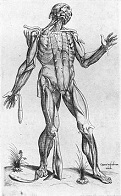

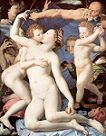
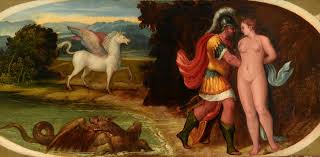

1545 An epidemic begins in Mexico (ends 1550), wiping out 80% of the 15M pop. in five years; salmonella enterica bacterium of the Paratyphi C variety? Francis I vows to invade England to force it to give up its lands in France, and authorizes the first official persecution of the Protestant Huguenots, ordering the Provence Parliament's Arret de Merindol of Nov. 18, 1541 executed in the Massacre of Merindol (Massacre of Mérindol) in Apr. to punish the pesky Waldensians for their religion, with Provencal and Papal soldiers killing hundreds (thousands?). On July 19 Henry VIII travels to Portsmouth and watches from shore as his fleet fights a French fleet of 230 ships; too bad, Henry's favorite ship, the carrack-style Mary Rose (launched July 1511) is sunk in the Solent Straits N of the Isle of Wright, along with vice-adm. Sir George Carew (b. 1504); it is rediscovered in 1971 in the Solent Channel near Portsmouth, and salvaged on Oct. 11, 1982 using airbags, then put in a museum; it sunk because the numerous gun ports were too low and took on water when it tried to turn; the lessons learned cause English ships to be equipped with massive cannonpower, giving them the advantage against the 1588 battle against the Spanish Armada? In Aug. the Treaty (Peace) of Adrianople is agreed to by HRE Charles V, Ferdinand I of Austria, and Sultan Suleiman I the Magnificent, recognizing total Ottoman control of Hungary, plus a yearly tribute of 30K gold florins for their Hapsburg possessions in N and W Hungary; signed in 1547. On Dec. 13 the Council of Trent (19th Ecumenical Council), called by Pope Pius III convenes in Trent in N Italy (until Dec. 4, 1563) to discuss the pesky Reformation started by almost-gone Martin Luther (d. 1546), launching the bloody Counter-Reformation (ends 1648), with Monktown Munich as one of the main bases; three papal legates are sent by Pope Paul III to preside, incl. Cardinal Reginald Pole (1500-58) of England, who is considered next in line for the papacy although he is a secret member of the Spirituali; one good thing, it authorizes Pope Paul III to take up the 1475 work of Pope Sixtus IV and reform the pokey Julian Calendar, and it only takes 37 more years to figure out and implement (1582) - these changes in attitude, changes in attitude, nothing remains the same? On Dec. 24 Henry VIII, who had been seeking to return the English church to a doctrinally Roman Catholic position gives his last speech to Parliament, in which he says that Papist, Anabaptist, and Lutheran are names devised by the Devil to sunder one man's heart from another; meanwhile outspoken Protestant Anne Askew (1521-46) becomes the target of govt. persecution. The Ottomans return, conquer Massawa and occupy the rest of Ethiopia. Moroccan Wattassid sultan (1526-49) Ahmad el Outassi (Abu al-Abbas Ahmad ibn Muhammad) (-1549) is taken POW by the Sharifian Saadians, and Ali Abu Hassun, regent for Ahmad's young son Nasir al-Qasiri pleges allegiance to the Ottomans to obtain their support. Pope Paul III detaches Parma and Piacenza in N Italy (Emilia-Romagna) from the papal states and gives them as a duchy to his illegitimate son (pederast?) Pier-Luigi Farnese (1503-47), whose family rules until 1731, although the duchy lasts until 1860 - and to toss it off, opera conductor Arturo Toscanini is born there in 1867? Pissed-off Mogul emperor Humayun conquers Kabul in Afghanistan. Portuguese naval cmdr. Joao de Castro (1500-48) overthrows Mahmud Shah III, king of Gujarat (Gujerat) in WC India (SW side of the upper lobe, below Punjab and Sind), then relieves the town of Diu and defeats the army of Adil Khan. Nostradamus begins practicing medicine in Marseille. Pope Paul III (who can stop him?), wanting nepotism ("nephew-ism") to get more fame creates 15-y.-o. Ranuccio Farnese (1530-65), son of his illegitimate son Pier-Luigi Farnese as cardinal, causing him to get the nickname cardinalino ("small cardinal)"; not that he turns out that bad, since he backs Italian humanist Federico Commandino (1509-75) in his translation of ancient Greek mathematical works. Ottoman sultan Suleiman the Magnificent appoints Sunni Hanafi legal scholar Mehmed Ebussuud Efendi (1490-1574) as grand mufti (until 1574), who goes on to reorganize the Ottoman legal system to put it more under Sharia, but with the sultan's orders given higher standing; he issues several fatwas, incl. ones permitting consumption of coffee and allowing the performance of Karagoz (Karagöz) (Turk. "black eye") AKA Hacivat (Turk. "Haci Ivaz" = Ivaz the Pilgrim) (shadow) plays, featuring educated refined Turk Hacivat and vulgar illiterate Greek peasant Karagoz, who always gets the better of him with his "native wit". 40-y.-o. U. of Glasgow grad John Knox (1505-72) comes under the influence of religious reformer George Wishart, who is preaching the Lutheran Reformation in Scotland, and becomes a Protestant minister preaching in the castle and parish church of St. Andrews. Pope Paul III invites superstar Titian to visit Rome and gives him a royal welcome, and he begins changing to a free impressionistic style, giving up the red and green predominance in favor of deep yellow and blue. Architecture: Ulm Minster (begun 1377) in Germany is finished, with the highest steeple in the world (161.53m), and a 141m-high viewing platform with 768 steps. Inventions: Claude Garamond (1480-1561) of Paris designs an antique typography. Nonfiction: Roger Ascham (1515-68), Toxophilus or the Schole or Partitions of Shooting; a scholarly defense of archery dedicated to Henry VIII, who grants him a £10 pension. Girolamo Cardano (1501-76), Artis Magnae (The Great Art); treatise on mathematics, containing the solution to the cubic and quintic equations, explaining negative numbers; he had been told the solution to the cubic equation by Niccola Tartaglia in 1535, and had promised not to tell, causing a lifelong war - the origin of "publish or perish" in academia? Benvenuto Cellini (1500-71), Autobiography. Charles Estienne, Anatomy; the first illustrations of venous, arterial, nervous and other physiological systems; describes the valves in the veins, but doesn't explain their function. Jean Fernel (1497-1558), De Vacuandi Ratione. Thomas Geminus (Lambrit) (1510-62), Compendiosa Totius Anatomie Delineatio, Aere Exarata (A Complete Delineation of the Entire Anatomy, Engraved on Copper); shows how cheaper is better, replacing hand-painted illuminations and woodcuts, hastening the spread of know know knowledge. Konrad von Gesner, Biblioteca Universalis (1545-9). Ambroise Pare (1510-90), On Surgery; suggests that wounds be treated with soothing ointments rather than boiling oil. Art: Il Bronzino (1503-72), Venus, Cupid, Folly and Time; given by Cosimo de' Medici to Francis I of France - a conspiracy theorist favorite? Benvenuto Cellini (1500-71), Perseus and Medusa (sculpture) (1545-54) - his magnum opus? Lorenzo Lotto (1480-1556), Apollo Sleeping. Lambert Sustris (1515-84), Perseus and Andromeda. Titian (1477-1576), Portrait of Daughter Lavinia; Portrait of Pietro Aretino; Portrait of Doge Andrea Gritti. Daniele da Voltera (1509-66), Descent from the Cross. Fiction: John Heywood, The Four P's. Births: Italian philosopher-astronomer-mathematician Guidobaldo del Monte, Marquis del Monte (d. 1607) on Jan. 11 in Pesaro; student of Federico Commandino (1509-75); friend of Torquato Tasso and Galileo Galilei: educated at the U. of Padua. English diplomat-scholar Sir Thomas Bodley (d. 1613) on Mar. 2 in Exeter; founder of the Bodleian Library at Oxford U. (1602). Korean #1 adm. Ri Sun Shin (Yi Sun-sin) (d. 1598) on Apr. 28 in Hanyang; friend of Yu Seong-ryong (1542-1607); wins all 22 of his naval battles. English Roman Catholic Jesuit leader Father Robert Persons (Parsons) (d. 1610) on June 24 in Nether Stowey, Somerset; educated at St. Mary's Hall, Oxford U. Spanish prince Don Carlos, Prince of Asturias (d. 1568) on July 8 in Valladolid; eldest son of Philip II and Maria Manuela of Porgugal (daughter of John III); his mental instability causes his father to imprison him in 1568, becoming part of the Black Legend. Scottish theologian-reformer Andrew Melville (d. 1622) on Aug. 1 in Baldovy (near Montrose), Angus; educated at the U. of St. Andrews. Italian duke of Parma and Piacenza #3 (1586-92) Alessandro Farnese (d. 1592) on Aug. 27; gov. of Spanish Netherlands (1578-92); son of Ottavio Farnese (1521-86) and Margaret (illegitimate daughter of HRE Charles V); nephew of Philip II of Spain and Don John of Austria. English king dad Henry Stuart (Stewart), Duke of Albany, Lord Darnley (d. 1567) on Dec. 7 in Temple Newsam, Leeds, Yorkshire; son of Matthew Stewart, 4th Earl of Lennox (1516-71) and Margaret Douglas; 1st cousin and 2nd husband of Mary Stuart, Queen of Scots, by whom he fathers Scottish/English king James VI/I (1566-1625); brother of Charles Stewart, 6th earl of Lennox (-1576). French "Les Juives" playwright Robert Ganier (d. 1590). English herbalist John Gerard (d. 1612) in Nantwich; namesake of the genus Gerardia of figwort plants with showy pink or yellow flowers. French mercantilist economist Barthelemy (Barthélemy) de Laffemas (d. 1612) in Beausemblant (Drome). Spanish novelist-poet Gines Perez de Hita (d. 1619) in Mula (Murcia). Deaths: Spanish historian Antonio de Guevara (b. 1481) on Apr. 3. English soldier Charles Brandon, duke of Suffolk (b. 1484) on Aug. 22 in Guildford. German painter Hans Baldung Grien (b. 1484) in Strasbourg. German Protestant leader George Spalatin (b. 1484) on Jan. 16 in Altenburg. Italian composer Constanzo Festa (b. 1485) on Apr. 10 in Rome; his Te Deum Indian Suri emperor #1 (1538-45) Sher Shah Suri (b. 1486) on May 22 in Kalinjar. is pub. in 1596 and sung in the Vatican on the election of a new pope - te deum or tedium? English composer-organist John Taverner (b. 1490) on Oct. 18 in Boston. German Bavarian duke Louis X (b. 1495) on Apr. 22 in Landshut. English adm. Sir George Carew (b. 1504) on July 19; sunk in the Mary Rose off the Isle of Wight. French noble Charles d'Angouleme, duke of Orleans (b. 1522) on Sept. 9.
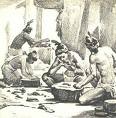









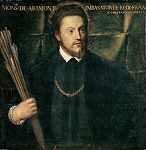
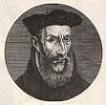


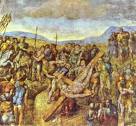
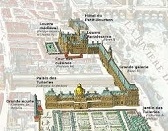


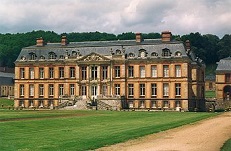
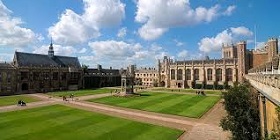
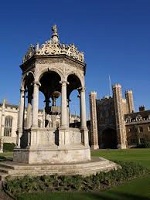
1546 On Jan. 18 the Battle of Anaquito (Añaquito) near Quito sees 700 Spanish conquistador rebels in Peru led by Gonzalo Pizarro defeat 200-300 soldiers loyal to Spanish viceroy of Peru #1 (since May 15, 1544) Blasco Nunez de Vela (b. 1490) at Anaquito, kill him, then parade his head around on a pike, and declare their man Gonzalo Pizarro as gov., causing the Spanish govt., fearing loss of the colony to back down and water down their New Laws protecting indios and restore the encomiendas. On Feb. 18 Martin Luther (b. 1483) dies in his birthplace of Eisleben; Pomeranian Protestant leader Johannes Bugenhagen (1485-1558), whom Luther calls "Doktor Pomeranus" takes care of his widow and children. On Mar. 1 Scottish Calvinist George Wishart (b. 1513) is burned at the stake for heresy in front of St. Andrews; on May 29 St. Andrews is attacked by Wishart's supporters, and Cardinal David Beaton (b. 1494) is killed in revenge. On May 1 after Provence suffers a bad flood which whips up the plague, the city of Aix sends for Nostradamus in Marseille to doctor them, and he achieves spectacular success. Break out those Spanish-English lexicons? On July 16 Protestant martyr Anne Askew (b. 1521), after becoming the first woman tortured (racked) in the Tower is burned at the stake in the last days of Henry VIII at Smithfield. On Sept. 8 Juan de Tolosa discovers silver in El Cerro de la Bufa, founding the town of Zacatecas in La Gran Chichimeca in C Mexico (#2 Spanish silver mine in the New World after Potosi in Bolivia), causing Spanish settlers to flock in from the S and set up mines, with the Spanish crown claiming the quinto (one-fifth of all production); too bad, the proud Chichimecas don't take a shine to them moving in, and aren't pushovers like the Aztecs, beginning the Chichimeca War (ends 1590), the first Spanish frontier war, which proves that Indians can be tough, and takes to the end of the cent. to end - if I were English I'd become a pirate? The Schmalkaldic War (civil war) (ends 1547) begins in Germany between HRE Charles V and the Schmalkaldic League, headed by elector Frederick III the Pious, Johann Frederick the Magnanimous, and Philip of Hesse over the territories of Ernestine Saxony, and Albertine Saxony, which although Lutheran sides with Charles V, who rewards them by forcing the Ernestines to sign their rights to the electorship to them. The Turks occupy Moldavia. After reverses at Saint-Etienne, Henry Howard, earl of Surrey is recalled to England, and in the absence of his old friend the duke of Richmond, along with the loss of influence at court by his daddy Thomas Howard, 3rd duke of Norfolk after the behading of Catherine Howard, his enemies at court frame them both on treasonable ambition charges and get them arrested. Joao de Castro subjugates Malacca for the Portuguese, then next year is made viceroy of the Portuguese Indies. Injong II dies, and Myonjong (d. 1567) becomes Yi king of Korea. The Songhai people destroy the Mali empire in W Africa. The English Navy Board is founded. Roger Ascham becomes language tutor to princess (later queen) Elizabeth (until 1548). Gabriel de Luetz, Baron et Seigneur d'Aramon et de Vallabregues (-1553) is sent by French king Francis I to Constantinople as French ambassador, and is later re-sent by Henry II accompanied by a vast array of scientists incl. Jean de Monluc, Pierre Belon, Pierre Gilles d'Albi, Andrew Thevet, Guillaume Postel, and Nicolas de Nicolay, who later return to France with valuable Ottoman scientific knowledge. Roman bishops at the Council of Trent decide that the Church "venerates equally" the Bible and written and unwritten traditions, thus beginning the Tridentine Church, the modern Roman Catholic Church; the Apocrypha are decreed to be of "equal veneration" with the other books of the Bible, and an anathema is pronounced against all who do not receive them as sacred and canonical; failing to agree whether vernacular translations of the Bible are "the mother and origin of all heresies" or that prohibition would give Protestants ammunition in claiming that the Church is attempting to hide "fraud and deceit", the Latin Vulgate trans. is sanctioned as the standard text for the Church, stifling vernacular translations by default - if it makes you happy then why the hell are you so sad? Spain's "New Laws" (1542) barring enslavement of Indians are repealed at the insistence of New World colonists; meanwhile the brutality of the German Welsers in Venezuela, combined with protests in Spain against granting land to "foreigners" causes the crown to revoke their concession and send Spanish troops to conquer Venezuela (finished 1556), which an Indian confederation resists for 10 years until smallpox softens them up for the kill. Pedro de Valdivia penetrates into S Chile, fighting the hostile Mapuches. After Mayan slaves, led by native priests revolt against their encomiendas in E Yucatan, the Spanish and their Catholic traitor Mayan allies finish conquering Yucatan, founding Valladolid (in modern-day Morelia) and Salamanca de Bacalar, and enslaving Mayans and distributing them to encomiendas, where they are treated like, er, shit, while Yucatan's first Roman Catholic bishop, Franciscan monk Diego de Landa Calderon (Calderón) (1524-79) burns all of the Mayan books he can find, uttering the soundbyte: "They contain nothing but the lies of the Devil", finally being recalled to Spain for overzealousness; only the area of Peten (Petén) in modern-day N Guatemala and Campeche, SE Mexico remains unconquered (until 1700). Pedro de Alvarado arrives with 500 men to seize land from Sebastian de Belalcazar, claiming that it had not been part of the grant made to Pizarro, but Pizarro's men cause him to abandon his claims and turn back in exchange for a large indemnity; too bad, Belalcazar orders the execution of neighboring province gov. Jorge Robledo, and gets convicted and condemned to death in absentia in Spain for murder in 1550, then dies in 1551 on his voyage to Spain to appeal the verdict. The fortune of the Fuggers of Augsburg is valued at 4M guldens (golden florins) (guilders). Henry VIII founds Trinity College at Cambridge U., which goes onto become the largest Oxbridge college; grads later incl. Isaac Newton, Thomas Babington Macaulay, Adam Sedgwick, Lord Byron, Alfred Lord Tennyson, Bertand Russell, James Clerk Maxwell, Ernest Rutherford, Niels Bohr, and Ludwig Wittgenstein; in 1599-1608 a fountain is built in the Great Court. Cardinal College at Oxford U. (founded 1525) is refounded as Christ Church, becoming one of the two most aristocratic colleges in Oxbridge along with Trinity College, Cambridge U.; its college chapel is Christ Church Cathedral; it goes on to produce a record 13 British PMs. Corpus Christi College is founded at Oxford U. Michelangelo is appointed by Pope Paul III as unsalaried supervising architect of St. Peter's Basilica,, which was left unfinished by Pope Julius II; he designs the dome and undertakes to complete the whole thing, producing his first model in 1547. French architect Pierre Lescot (1510-78) begins the construction of the SW wing of the Louvre Palace on the right bank of the Seine River in Paris on the site of a 13th cent. (Philip II) castle, introducing the 4-sided gambrel-style Mansard (French) (Curb) Roof, which is later popularized by French architect François Mansart (1598-1666); it eventually forms a square of 576 ft. by 538 ft. between the Tuileries Gardens and the Church of Saint-Germain l'Auxerrois; in 1793 part of is turned into a public museum. Science: Flemish cartographer Gerardus (Gerhardus) Mercator (1512-94) (Lat. "merchant") states that the Earth has a magnetic pole. Nonfiction: Anon., Yny Lhyvyr Mwnn; the first Welsh book. The original polymath with feet in two worlds? Leo Africanus (Al-Hasan al-Wazzan) (Yuhanna al-Asa), AKA John/Johannes/Giovanni and/or Leo/Leone the Lion (1488-1554), History and Description (Cosmography and Geography) of Africa; Granada-born Fez-raised traveler-diplomat meets Sultan Selim, is seized by Christian pirates in the Mediterranean, held as a prisoner in Rome with access to the papal library, meets with Pope Leo X, is baptized a Christian to get freed, and is given the surname "de Medici" by the pope, becoming a big dude in Rome, writing five books and meeting with Francois Rabelais before returning to Tunis and reverting to Islam; he describes Timbuktu as a city of gold where the emperor eats off half-ton golden platters, causing Euro explorers to become obsessed with finding it, although it had been lost after the Niger River was swallowed up by the Sahara Desert? Georgius Agricola (1494-1555), De Natura Fossilium; first attempt to categorize rocks, minerals, and sediments since Pliny's "Natural History; in their 1912 English tr., Herbert and Lou Hoover wrongly claim that he coined and first used the term "petroleum" (Lat. "rock oil") here. Etienne de la Boetie, Le Discours de la Servitude Volontaire. Valerius Cordus, Pharmacopoeia; first ever by a Euro? Girolamo Fracastoro (1478-1553), On Contagion (De Contagione et Contagiosis Morbis et Eorum Curatione) (3 vols.); the first discussion of contagious infections, suggesting that diseases like syphilis, rabies, and phthisis are like seeds, which he calls (Fomes (Lat. "tinder") that can be transferred from person to person as they "propagate their like" through air, water, etc. via direct contact, indirect contact, or at a distance; "By fomes I mean clothes, wooden objects, and things of that sort, which though not themselves corrupted can, nevertheless, preserve the original germs of the contagion and infect by means of these"; he becomes the first to recognize the disease typhus. John Heywood (1497-1580), The Proverbs of John Heywood; incl. the line "The Moon is made of a greene cheese". Art: Il Bronzino (1503-72), Eleanor of Toledo; wears the cursed Medici pearls; her tomb is opened in 1982, and she is found to be buried in the same dress, sans the pearls? Giulio Clovio 1498-1578, The Farnese Hours; illuminated ms. containing 28 miniatures of Old and New Testament scenes, created for Cardinal Alessandro Farnese; his masterpiece; incl. The Corpus Christi Procession in Rome, Adam and Eve. Lucas Cranach the Elder (1472-1553), Portrait of Martin Luther. Michelangelo (1475-1564), The Crucifixion of St. Peter (1546-60); fresco in the Pauline Chapel in the Vatican. Titian (1477-1576), Pope Paul III and His Nephews; shows him as sharp and hawk-eyed. Novels: Francois Rabelais (1494-1553), Pantagruel, Pt. 3. Plays: Pietro Aretino (1492-1556), Orazia. Hans Sachs (1494-1576), Lisabetha. Poetry: Luigi Alamanni (1495-1556), La Coltivazione; long Vergil-style Georgics clone. Births: Ottoman sultan #12 (1574-95) Murad (Murat) III (d. 1595) on July 4 in Manisa; eldest son of Selim II the Sot (1566-74) and Nur-Banu (Cecilia Venier Baffo) (1525-83); father of Mehmed III (1566-1603). Danish astronomer Tyge Ottesen "Tycho" Brahe (d. 1601) (pr. TOO-koh BRA-huh) on Dec. 14 in Knudstrup Castle, Skane, S Sweden; collaborator of Johannes Kepler (1571-1630). English astronomer Thomas Digges (d. 1595) in Wotton, Kent; son of Leonard Digges (1520-59). Dutch Mannerist sculptor Adriaen de Vries (d. 1626) in The Hague. Deaths: Italian painter Gaudenzio Ferrari (b. 1471) on Jan. 11. Turkish #1 adm. Barbarossa II Hayreddin Pasha (b. 1478) on July 4 in Istanbul; his mausoleum in Barbarossa Park features the immortal lines by poet Yahyah Kemal Beyatli: "Whence on the sea's horizon comes that roar?/ Can it be Barbarossa now returning/ From Tunis or Algiers or from the Isles?/ Two hundred vessels ride upon the waves,/ Coming from lands the rising Crescent lights;/ O blessed ships, from what seas are ye come?"; Turkish seamen begin saluting his mausoleum with a cannon shot before leaving for naval ops. German Protestant Reformation firestarter Martin Luther (b. 1483) on Feb. 18 in Eisleben, Saxony: "Whoever drinks beer, he is quick to sleep; whoever sleeps long, does not sin; whoever does not sin, enters Heaven! Thus, let us drink beer!" Italian architect Antonio da Sangallo the Younger (b. 1484) on Aug. 3. German Lutheran theologian Friedrich Myconius (b. 1490) on Apr. 7. Spanish viceroy of Peru #1 (1544-6) Blasco Nunez de Vela (b. 1490) on Jan. 18 in Anaquito (KIA). Italian painter-architect Giulio Romano (b. 1492). Scottish cardinal David Beaton (b. 1494) on May 29 in St. Andrews Castle, (murdered). English writer Sir Thomas Elyot (b. 1499). English Protestant martyr Anne Askew (b. 1521) on July 16 in London (burned at the stake).



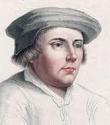




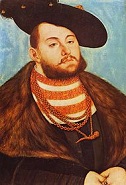
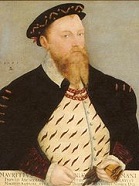




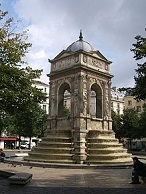
1547 Moscow is destroyed by fire. On Jan. 2 the unsuccessful conspiracy of Gianluigi (Giovanni Luigi) Fiesco (Fieschi) (1522-47) against easy-to-hate 80-y.-o. (but still strong) imperial adm. Andrea Doria rocks Genoa. On Jan. 16 17-y.-o. Ivan IV Vasilyevich the Terrible (1530-84) is crowned the first official "tsar (czar) [Caesar] of all the Russias" (until Mar. 28, 1584), going on to centralize, reform, and expand the Russian state until he goes off the deep end in 1560. The Seymours see more ups and downs than a roller coaster, but how 'bout them Howards? On Jan. 28 bloated bloody tyrant (since Apr. 22, 1509) Henry VIII (b. 1491) of England (who saw it all, Columbus, Copernicus, Luther, etc.) dies in London (of syphilis?), with archbishop Thomas Cranmer at his side, after 72K are executed during his reign, incl. by burning at the stake, boiling alive, hanging and decapitation, leaving some memorable poetry (although no legitimate grandchildren, not that he didn't try?), and is succeeded by his sickly 9-y.-o. son (by Jane Seymour) (was it aged spermatozoa?) Edward VI (1537-53) (Britain's 41st monarch) (until July 6, 1553), with his uncle Edward Seymour, 1st Duke of Somerset (1506-52) appointed lord protector of the realm (until 1549) by the royal council and created 1st duke of Somerset on Feb. 15; Henry's will names Thomas Cranmer as one of the regents; Catherine Parr survives him by less than two years, and Anne of Cleves by 10; "King Henry VII, to six wives he was wedded, one died, one survived, two divorced, two beheaded" (CAJACC); Henry Howard, 1st earl of Surrey is executed for treason, and his father Thomas Howard, duke of Norfolk signs a confession of complicity and is scheduled for execution in Norfolk, but his neck is saved by the death of the king, causing him to be imprisoned in the Tower of London; Sir Richard Rich (1496-1560) becomes executor of Henry VIII's will, and next Feb. 26 is created baron Rich of Leez, then in Mar. becomes lord chancellor; Greek geek Sir John Cheke (Cheek) (1514-57) becomes Edward's tutor, although after his daddy's personal example nobody can stop him from believing that the king has a divine right to rule and to control the nat. church, writing at age 12 (1549) that the pope is the "true son of the devil, a bad man, and the Antichrist", and seeking to establish Protestantism. In Feb. Strasbourg surrenders to the troops of HRE Charles V, after which Jacob Sturm von Sturmeck obtains favorable terms. It's no time for a moondance, my love? On Mar. 31 king (since 1515) Francis I (b. 1494) dies of syphilis, and his son the duke of Orleans is crowned Henri (Henry) II (1519-59), Roman Catholic Valois king #10 of France (until 1559); Catherine de' Medici (1519-89) becomes queen consort (until 1559), going on to have three weak sons that she dominates - yah, it's good to be in control? On Apr. 10 the Spanish govt. appoints bishop Pedro de la Gasca (1485-1567) as its 2nd viceroy of Peru (until Jan. 27, 1550), with unlimited powers to kick rebel conquistador butt, but when he arrives he first tries to win them over with a conciliatory policy. On Apr. 22 the Battle of Bungo in Japan sees the Mori clan eliminate the bungling Shimazu clan as a rival for the shogunate. On Apr. 24 after Protestant elector John Frederick I the Magnanimous (1503-54) of Saxony marches his army S to fight the pesky Roman Catholics, and is invaded by his Catholic cousin Duke Maurice I (1521-53) (Catholic father and Protestant mother), then returns quickly to repel him, HRE Charles V's armies, commanded by up-and-coming Spanish noble gen. Fernando Alvarez de Toledo, Duke of Alva (Alba) (1508-82) rush N, surprise and brilliantly defeat him at the Battle of Muhlberg (Mühlberg), taking Magnum P.I. POW, becoming the final battle in Charles V's campaign to rid the HRE of pesky Lutheranism, ending the Schmalkaldic War (begun 1546); he then sieges Magnanimous' pretty and fecund wife Sybille of Cleves (1512-54) and her three sons in the town where it all started Wittenberg, forcing him to protect them (it?) (himself?) by signing the Capitulation of Wittenberg, resigning the town and his electorship as head of the Ernestine line of the house of Wettin to Maurice, head of the rival Albertine line (which lost it in 1485); after his death sentence is reduced to life in priz, Magnanimous earns his nickname by refusing to give up the Protestant faith or acknowledge the Augsburg Interim for a quick release, uttering the soundbyte that it would be "a sin against the Holy Ghost, because in many articles it was against the Word of God"; meanwhile the Albertine court in Dresden replaces Wittenberg as the capital of Saxony, causing it to decline; the big D causes many Lutheran princes and key reformers incl. Martin Bucer to flee to England, where they influence the English Reformation - the Saxons always did like to do things strong or not at all? In Apr. brand-new Protestant John Knox (1513-72) has his first public debate with papists in St. Andrews; on July 30 St. Andrews is retaken by a French fleet, and Knox spends 19 mo. in French galleys (until 1549). On Sept. 10 Pier-Luigi Farnese (b. 1503) is murdered in Piacenza by Parmesan nobles, causing imperial troops to be sent to occupy Piacenza, and his 2nd son Ottavio Farnese (1521-86) to not succeed as duke #2 of Parma and Piacenza until 1556 because his grandpa Pope Paul III claims them for himself, giving him boring old Camerino instead, which pisses him off, causing him to go to Ferrante Gonzaga for aid, hastening the pope's death in 1549. On Sept. 10 ("Black Saturday") Edward Seymour, 1st Duke of Somerset (1500-52) continues with the "rough wooing" by leading 17K English troops (incl. German and Spanish mercenaries) on 30 warships into Scotland and winning the Battle of Pinkie Cleugh near Musselburgh (double entendre?), becoming the first modern battle fought in the British Isles and the last to be fought between the Scottish and the English royal armies (also first time the English use naval artillery in a land battle in Britain), killing 5K of 23K-36K Scottish troops and taking 1.5K POWs, vs. only 500 English KIA; the day before stupid Scot leader the Earl of Home took his 1.5K horsemen into battle at Fawside (Fa'side) (Faside) Castle, losing most of his cavalry, after which it is burned down, killing all inside; Edward Seymour's men then lay waste to SE Scotland, causing crowds of fugitives to flee to Dalkeith, while being cut down by the stankin' English on the way, making Edward a bigger man than ever; Mary Stewart is secretly moved to remote Inchmahome Priory; a large timber-earthwork fort is built on the site of ruined Roxburgh Castle on the Scottish border; meanwhile Edward's brother lord high adm. Thomas Seymour, 1st Baron Seymour of Sudeley (1508-49) wastes no time movin' on up, marrying dowager queen Catherine Parr; the French offer to help too late, causing grumbling, and then Francis, 2nd duke of Guise, Mary Stuart's uncle, who dominates the king makes him demand her marriage to the infant dauphin Francis as a condition; meanwhile Thomas Seymour romps in the garden with their guest (Catherine's stepdaughter) princess (future queen) Elizabeth, cutting her gown into 100 pieces in the garden while Parr holds her, and later visiting her bedroom. Edward VI repeals De Heretico Comburendo, the 1401 act of Parliament providing for the burning of heretics; too bad, his successor Bloody Mary I restores it. The crown of Bohemia is proclaimed hereditary in the house of Hapsburg. A poor rate is levied in London; Bedlam Hospital is acquired by the City of London, operating until 1948. New Spain viceroy Antonio Hurtado de Mendoza convenes an ecclesiastical conference attended by Bartolome de las Casas, and passes regulations requiring Indian slave laborers to be paid, fixing the max number of hours they can work, and protecting Indians lands from exploitation - Curb Cereal's new crunch is different? After Francis I dies, a reaction against free thought begins in France, causing Francois Rabelais to flee to Metz then Rome, but Cardinal de Lorraine works his return, and gets him the living of Meudon, where he spends the rest of his life; French supersedes Latin as the official language of French authorities; meanwhile PC-challenged Nostradamus moves to Salon, likes it and decides to live there for the rest of his life, but first he is called to Lyons to cure another pestilence (whooping cough?), returning by Nov., and marrying rich widow Anne Ponsart Gemelle, then settling down on the Place de la Poisonniere, where he goes into regular trances, and in 1554 begins writing his Centuries (1st ed. 1555), consisting of 100 prophetic quatrains in several languages (French, Provencal, Italian, Greek, Latin) in each of 10 vols. (vol. 7 is never completed, and vols. 11-12 are planned but left unfinished at his death); Beaune mayor Jean Aymes de Chavigny quits his job to study under Nostradamus (1503-66), later editing the first complete ed. of the Centuries. In 1547-9 after being hired to redesign the future Lescot wing of the Palais du Louvre, the French Renaissance (recycled Italian Modernism) Fontaine des Innocents (Nymphes) is built in Paris by architect Pierre Lescot (1515-78) and sculptor Jean Goujon (1510-68) to celebrate the royal entry of Henry II, becoming the earliest monumental fountain in Paris; they go on to collaborate on the Louvre and the Church of St. Germain l'Auxerrois in Paris (until 1562). The first written mention of the Guinea pig in Santo Domingo, Hispaniola. A free-roaming sow and her six piglets are tried for eating a child, and the sow is executed, but her piglets are spared because of their youth and the bad example of their mother? Architecture: Palais Granvelle in Besancon, France (begun 1534) is finished. Nonfiction: Thomas Cranmer et al., Homilies. De Mysteriis Egyptorum (Lyons); later used by Nostradamus (1503-66), who quotes from it in his prophecies, which begin this year. William Baldwin (1515-63), A Treatise of Morall Phylosophie. Louis Bourgeois (1510-65), Psalter. Henricus Glareanus (1488-1563), Dodekachordon (Basel); on the 12 church modes; source of duos. Christopher Langton, A Very Brefe Treatise, Ordrely Declaring the Principal Partes of Phisick (London); contains a sonnet by William Baldwin, becoming the first pub. English sonnet? William Salesbury (1520-1600), Dictionary in Englyshe and Welshe. Poetry: Giangiorgio Trissino, L'Italia Liberata dai Goti (epic poem). Births: Spanish gen. (hero of the 1571 Battle of Lepanto) Don John (Juan) of Austria (d. 1578) on Feb. 24 in Regensburg, Bavaria; illegitimate son of HRE Charles V by Barbara Blomberg (1527-97); half-brother of HRE Philip II of Spain; taken to Valladolid, Spain at age 3 and brought up under the name Geronimo - which came first, the Spic or the Apache? German scholastic philosopher (coiner of the term "psychology") Rudolph (Rudolf) Goclenius (Gockel) (Göckel) the Elder (d. 1628) on Mar. 1 in Korbach, Waldeck (Waldeck-Frankenburg, Hesse). German landgrave George I of Hesse-Darmstadt (d. 1596) on Sept. 10 in Cassel. Spanish "Don Quixote" novelist ("the Cripple of Lepanto") Miguel de Cervantes Saavedra (d. 1616) on Sept. 29 in Alcala de Henares. German writer Johann Fischart (d. 1590). Dutch navigator-explorer Willem Barents (Barentsz) (d. 1597) in Terschelling, West Frisian Islands. Italian printer Aldus Manutius the Younger (d. 1597). Spanish novelist Mateo Aleman (d. 1615) in Seville. English Anglican bishop of Winchester (1597-) Thomas Bilson (d. 1616) in Winchester. American Pawmunkey (Chesapeake Bay area) Indian chief Powhatan (Wahunsonacock) (d. 1618); father of Pocahontas (1595-1617); brother of Opechancanough (-1644); "Such a grave and Majesticall countenance, as drave me into admiration to see such a state in a naked Salvage" (Capt. John Smith). English portraitist (miniaturist) Nicholas Hilliard (d. 1619). Polish gen. Stanislaw Zolkiewski (d. 1620) in Turynka (near Lwow). Deaths: Italian bembist poet-cardinal Pietro Bembo (b. 1470) on Jan. 18 in Rome. Spanish conquistador Hernando Cortes (b. 1485); conquered 315K sq. mi. from the Aztecs in C and S Mexico, as well as Guatemala and Honduras. Italian painter Sebastiano del Piombo (b. 1485). Italian poet Vittoria Colonna (b. 1490) on Feb. 25. English king (1509-47) Henry VIII (b. 1491) on Jan. 28 in Whitehall Palace, London (diabetes?) (syphilis?); he suffered from McLeod Syndrome and/or Kell Antigens in his blood? French king (1515-47) Francis I (b. 1494) on Mar. 31 in Chateau de Rambouillet (syphilis). English historian Edward Halle (b. 1497). Italian duke #1 of Parma (1545-7) Pier Luigi Farnese (b. 1503) on Sept. 10 in Piacenza; stabbed to death by Count Francesco Anguissola et al. and hung from a window of his palace. English poet-soldier Henry Howard, earl of Surrey (b. 1517) (beheaded for high treason); his trans. of two books of Vergil's "Aeneid" gives the English language blank verse and the sonnet (three quatrains and a couplet).

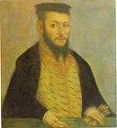



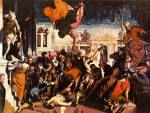
1548 The number of Caribbean (from the word cannibal) aborigines has fallen from 1M in 1492 to less than 1K (about 500); African slaves are now brought in to work the mines and fields. On Apr. 1 Sigismund (Zygmunt) I Stary (b. 1467) dies, and his only son Sigismund II Augustus (1520-72) becomes king of Poland and grand duke of Lithuania (until July 7, 1572), the last of the Jagiellonian Dynasty (founded 1386), facing the spread of the Protestant Reformation. On Apr. 9 after Pedro de Valdivia returns from Chile to Peru to support viceroy Pedro de la Gasca, Francisco Pizarro's son Gonzalo Pizarro is defeated at the Battle of Xaquixaguana (Jaquijahuana), then executed; even though La Gasca redistributes some encomiendas, some conquistadors remain discontented. Since I got in the loop I can see the future? On May 15 HRE Charles V decrees the Interim of Augsburg, an attempt to define a brand of Roman Catholicism acceptable to Lutherans without offending er, real Catholics too much, and the Augsburg Diet adopts it on June 30; Maurice of Saxony modifies it into the Interim of Leipzig. On Aug. 7 after Parliament accepts the terms of marriage between 5-y.-o. Mary Stuart, Queen of Scots and 1-mo.-younger dauphin Francis (Francois), she is sent to France by the west route for her safety with the "Four Marys" (Scottish noblewomen Mary Beaton, Mary Fleming, Mary Livingston, Mary Seton) (mother Mary of Guise remains in Scotland), and arrives in Roscoff, France on Aug. 13, living in France with the royal family for 13 years (until 1561), with governess Madame de Parois, and becoming friends with Francis' sister Princess Elisabeth; she soon forgets her native Scottish tongue and learns French, which she sticks with for life, is brought up as a good Catholic, and grows to 6 ft. tall; too bad, while Elisabeth is given a first class education incl. Machiavelli's "The Prince", Mary is regarded as just a dauphiness and not taught govt. admin. or politics, which messes her up later, although she becomes a good musician and poet - and never, never wears mens' clothes in public? On Sept. 5 Henry VIII's 6th and last wife Catherine Parr (b. 1512) dies six days after giving birth to her only child, Mary Seymour (1548-51) on Aug. 30; Thomas Seymour is beheaded next Mar. 20 for treason, after which Mary is disinherited and soon dies; in 1782 John Locust discovers Catherine's coffin in Sudeley Castle and opens it, finding the body in good condition and the flesh on an arm still white and moist?; when it is reopened in 1817 only a skeleton remains. On Oct. 20 the city of La Paz (La Ciudad de Nuestra Senora de La Paz) (The City of Our Lady of Peace) in W Bolivia (modern-day pop. 877K/2.3M) is founded by Spanish conquistadors on the site of an earlier settlement. The Turks occupy Tabriz, Persia. A revolt by the Zapotecs in the Oaxaca Valley in SE Mexico is suppressed, and Father Juan Lopen Zarate introduces sheep's wool to supplant their cotton weaving. A Spanish audiencia is established for El Nuevo Reino de Galicia (Nueva Galicia), with Guadalajara as the capital. The coastal town of Borburata in Venezuela is founded, becoming the scene of numerous pirate raids through the 17th cent. The town of Helsinki (Helsingfors) (originally Helsinge fors or Helsinge Rapids) in S Finland on the shore of the Gulf of Finland (modern-day pop. 642K/1.47M) is founded in Finland is founded in Forsby Village, and chartered by Gustav I of Sweden as a trading town to rival the Hanseatic city of Reval (Tallinn), which turns out to be a dud; in 1710 a plague almost wipes out the pop.; in 1809 after Russia annexes it as the autonomous Grand Duchy of Finland it begins a resurgence, becoming known as "the Daughter of the Baltic"; in 1812 Russian Tsar Alexander I moves the capital of Finland there to reduce Swedish influence and bring it closer to St. Petersburg. Rich merchant Thomas Gresham founds seven professorships in London; the U. of London is not founded until 1828. The U. of Messina is founded in Messina, Italy by St. Ignatius of Loyola, becoming the first Jesuit college. The U. of Jena is founded in Jena, Thuringia, Germany as an academy by the three sons of Elector John Frederick of Saxony, gainting a charter from HRE Ferdinand I on Feb. 2, 1558. Miles Coverdale returns to England, is appointed chaplain to Edward VI, then begins a career as a popular preacher. Dutch portraitist Sir Antonis Mor (1520-76) is discovered by Bishop Grenville, who presents him to HRE Charles V, after which he goes on to do portraits of all the Euro Catholics of the day, starting with Philip II next year. Titan is called to Augsburg to paint more portraits of HRE Charles V and other nobles. The guinea pepper plant is first grown in England. Architecture: The Hotel de Bourgogne in Paris is built by the Confrerie de la Passion to stage religious dramas, becoming the first roofed theater in Paris; too bad, in 1551 a royal edict forbids the performance of "mysteres" in Paris, but the Confrerie is granted a monopoly over the public performance of other types of drama, causing any troupe wishing to perform in the city to have to rent their hotel (until 1634). The Renaissance Chateau de Vallery in Yonne, Burgundy, designed by Pierre Lescot (1510-78) is built for Marechal Jacques d'Albon de Saint-Andre (Saint-André), court favorite of Henri II. Nonfiction: Anon., The Order of the Communion; first communion service in English. Michael Agricola (1510-57), Se Wsi Testamenti (Stockholm); the New Testament in Turku Finnish. John Bale (1495-1563), Illustrium Majoris Britanniae Scriptorum, hoc est, Angliae, Cambriae, ac Scotiae Summarium (Summary of the Famous Writers of Great Britain, that is, of England, Wales, and Scotland); 2nd ed. pub. in 1557-9; chronological catalog of British authors and their works. Desiderius Erasmus (1466-1536), The First Tome or Volume of the Paraphrase of Erasmus Upon the New Testament (Jan.) (posth.); ed. by Nicholas Udall; pub. by Edward Whitchurch; Erasmus' trans. of the New Testament interleaved with an English trans.; vol. 2 pub. in 1549; a royal injunction orders copies to be kept in every parish church in England. Jean Fernel (1497-1558), De Abditis Rerum Causis. St. Ignatius of Loyola (1491-1556), Spiritual Exercises (written in 1522-4) (pub. after being papally sanctioned); becomes a Roman Catholic hit - takes several weeks but when you're through you're clear like Tom Cruise? Cavalier Cipriano Piccolpasso, Li Tre Dell' Arte Del Vasi (3 vols.); first Euro work on the art of pottery. Art: Tintoretto (1518-94), St. Mark Rescuing a Slave (Miracle of the Slave); his first masterpiece; uses foreshortening, and makes small wax models on a stage with spotlights, with the motto "The drawing of Michelangelo and the color of Titian". Titian (1477-1576), HRE Charles V on Horseback at the Battle of Muhlberg (Mühlberg). Poetry: Theodore Beza (1519-1605), Juvenialia; makes him a celeb.; incl. "De Sua in Candidam et Audebertum Benevolentia", saying that although he has kissed both Audebert and Candida, he loves Candida most, causing later allegations of pederasty by Catholics; after pub. the book he gets sick, converts to Protestantism and moves to Geneva on Oct. 23, 1548. Births: Italian architect Vincenzo Scamozzi (d. 1616) on Sept. 2 in Vicenza; teacher of Baldassarre Longhena (1598-1682). Italian superstar Neoplatonist philosopher Giordano Bruno (d. 1600) in Nola, Campania (kingdom of Naples); starts out as a priest in 1572, is caught defending Arianism and Erasmus in 1576, and takes a long hike. Spanish Roman school church composer Tomas Luis de Victoria (Tommaso Ludovica da Vittoria) (d. 1611) in Avila, Castile; lives in Madrid from 1589-1611. Spanish Jesuit anti-divine-right-of-kings scholastic philosopher Francisco Suarez (d. 1617); writes in Latin; argues that kings derive their authority from the people and not directly from God, and may thus be deposed - he wants to bite the hand that feeds him? Dutch mathematician-engineer Simon Stevin (Stevinus) (d. 1620) in Bruges? Spanish soldier Sebastian Vizcaino (Sebastián Vizcaíno) (d. 1624) in Extremadura, Castile. Italian painter Jacopo Negreti (Palma Giovane) (Palma the Younger) (d. 1628) (b. 1550?); grandnephew of Palma Vecchio (1480-1528); pupil of Titian (1477-1576), and heir to the Venetian School after he and Veronese die, presiding over its slide toward decadence. English soldier Sir William Stanley (d. 1630) in Hooton. English poet Isabella Whitney (d. ?); first English woman to pub. a book of poetry. Deaths: Polish king (1506-48) Sigismund I the Old (b. 1467) on Apr. 1 in Cracow. Spanish explorer Pascual de Andagoya (b. 1495) on July 18 in Cuzco. Italian scholar Agostino Steuco (b. 1497) in Venice; leaves De Perenni Philosophia, dedicated to Pope Paul III, coining the term "Perenni Philosophia" (Perennial Philosophy) for the single universal truth shared by all world religions. Portuguese naval officer Joao de Castro (b. 1500). German duke Philip the Contentious of Palatinate-Neuburg (b. 1503) on July 4 in Heidelberg. English queen Catherine Parr (b. 1512) on Sept. 5 in Sudeley Castle, Gloucestershire. Mexican Roman Catholic saint Juan Diego on May 30.
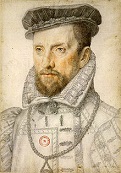




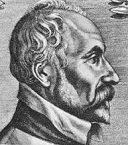


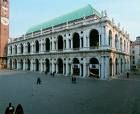
1549 On Mar. 20 Jane Seymour's elder brother Thomas Seymour, 1st baron Seymour of Sudeley (b. 1508), lord high adm. of the British fleet is executed for treason for messing with princess Elizabeth then attempting a coup, breaking into Edward VI's apts. at Hampton Court Palace on the night of Jan. 16 armed with a sword, and being given away by a pet spaniel, which he kills; his brother Edward Seymour is imprisoned in the Tower, and replaced as lord protector by John Dudley, Viscount Lisle, Earl of Warwick, Duke of Northumberland (1502-53); the scandal almost takes Elizabeth down until they can't prove enough hanky-panky in court to execute a royal heir, giving her a quick education in power politics and helping her become a tough survivor who trusts nobody. In Mar. John Knox is released from the French galleys after 19 mo. at the intercession of Edward VI, and goes to England, where he is appointed to the reformed Church of England at Berwick; with his help, the first Book of Common Prayer is introduced by Archbishop of Canterbury Thomas Cranmer (1489-1556) on the Day of Pentecost, along with the First Act of Uniformity (2nd 1552) (backed by Edward Seymour, passed by a close 10-8 vote of the bishops), banning all Latin-language Roman Catholic missals and liturgical books, and requiring the use of the Book of Common Prayer starting on May 20, emphasizing the peoples' participation in the Eucharist, and requiring the Bible to be read in English from cover to cover, sparking the Prayer Book Rebellion in Cornwall and Devon by 7K, causing 8.6K English troops incl. German and Italian mercenaries to be brought in by Edward VI, massacring 2K+; the Prayer Book prints special holy days in red ink, causing the term "red letter day" to become popular, although the Roman Catholic Church was already doing it (they call it rubrics) - you better not mess with Major Tom? In May a major night attack on English-held Boulogne by the French under Gaspard II de Coligny, Seigneur de Chatillon (1519-72) is repulsed, with 200 French KIA. On Aug. 15 after being barred from every port he visited since reaching Japan on July 27, Spanish Jesuit (St.) Francis Xavier (1506-52) lands on Kagoshima on Kyushu Island in W Japan to preach the Roman Catholic religion, where he is welcomed, founding the first Christian mission in Japan, causing other missionaries from Portugal and Spain to follow; at first he is successful because the feudal lords encourage conversion in hopes of attracting Portuguese trade, but by next year when the attached strings (Catholic intolerance) bump up against the Buddhist clergy, he ends up getting banned and makes little headway after conversion to Christianity is given the death penalty - trust me, I'm just an actor and I made this DVD? On Oct. 5 Edward Seymour, Protector Somerset issues a proclamation calling for a gen. callup of troops to gather at Hampton Court Palace for the defense of the realm incl. his nephew Edward VI; on Oct. 6 Seymour takes the king to Windsor Castle, pissing-off the Lords of the Council, who get him ordered from the king's presence on Oct. 10, and arrested on Oct. 11 for "ambition, vainglory, entering into rash wars in mine yough, negligent looking on Newhaven, enriching himself of my treasure, following his own opinion, and doing all hby his own authority, etc."; on Oct. 13 his protectorate is dissolve, and on Oct. 14 he is taken to the Tower of London, where he confesses to the charges against him; on Feb. 6, 1550 he is released from the Tower, and pardoned on Feb. 8, and restored as a gentleman of Edward VI's privy chamber. On Nov. 10 Pope (since 1534) Paul III (b. 1468) dies, having failed to burn all the heretics and heretical books like he wanted, with the bother caused by his nephew trying to take back Parma and Piacenza by force hastening his death? John Calvin and the Zwinglians reach the Consensus Tigurinus on Holy Communion in Zurich. After partially repudiating the doctrine of the spiritual and temporal supremacy of the English king when Edward VI comes to power, Bishop Edmund Bonner of London is imprisoned (until 1553). Askia David becomes king of Songhai (until 1582). The Kingdom of Cayor in NC Senegal splits off from the Jolof Empire, ruled by kings (damels) from the capital at Mboul; it is conquered by the French in 1868, regains its independence in 1871, and is defeated again in 1879, becoming kaput on Oct. 6, 1886. Concubines for the clergy are finally condemned by the Roman Catholic Church - a thousand-plus years of cocky clergy are suddenly wrong because of syphilis? The city of Bahia (modern-day Cidade do Sao Salvador da Bahia de Todos os Santos) (City of Holy Savior of All Saints Bay) (modern-day pop. 15M) in Brazil is founded by Thome de Souza (-1560); Brazil is made a royal colony by Portugal; a Roman Catholic see is founded there by Pope Julius III in 1551. The Audiencia of Nueva (New) Granada is created in N South Am., incl. Santa Marta, Cartagena, and Popayan, with capital at rhombus-shaped Santa Fe de Bogota in the Bogota Plateau, which becomes known as "the Athens of South America". Beecker Fair in Duisburg, Germany is first held. Joachim du Bellay (1525-60), leader of La Pleiade (Pléiade) (a group of seven French poets favoring the classical forms) states the program of French classicism: "Defense et illustration de la langue francaise" - the Frogs begin their program of eating their own vomit? Edward VI begins issuing the first English Half-Crown Coins (two shillings and sixpence, or, 2/6) (one-eighth of a pound); discontinued in 1967. The first of Henry VI's two prayer books, compiled by Thomas Cranmer is sanctioned (2nd in 1552). Architecture: Andrea Palladio (1508-80) designs the 2-story white Istrian stone arcade around the Vicenza Basilica (finished 1614), using ancient Roman architectural principles, and introduces the "Palladian motif", an opening with an arched top flanked by two flat-topped openings, which is widely imitated, making him the most influential architect in Western history? Science: German Protestant brain man Philipp Melanchthon (1497-1560) objects to the helicentric theories of Nicolaus Copernicus - the Bible tells me so? Nonfiction: William Baldwin (1515-63) (tr.), The Canticles or Ballads of Solomon. Sigismund von Herberstein (1486-1566), Rerum Moscoviticarum Commentarii (Notes on Musovite Affairs); becomes the std. reference for Western Euros on Russia; introduces the spelling "czar" for tsar. Music: Adrian Willaert (1490-1562), Fantasie e Ricercari; combines Dutch and Italian musical styles. Plays: Friedrich Dedekind (1525-98), Grobianus (satire). Poetry: Pontus de Tyard (1521-1605), Erreurs amoureuses (debut); the first sonnets in the French language, introducing the Provencal sestina. Births: Italian duke of Urbino (last) (1574-1625) Francesco Maria II della Rovere (d. 1631) on Feb. 20 in Pesaro; son of Gidobaldo II della Rovere (1514-74) and Vittoria Farnese of Parma. French diplomat and Huguenot leader ("the Huguenot pope") Philippe de Mornay, Seigneur du Plessis-Mornay (Duplessis-Mornay) (d. 1623) on Nov. 5 in Buhy (modern-day Val-d'Oise), Normandy; educated at the College de Lisieux, U. of Heidelberg, and U. of Padua. English Roman Catholic priest-martyr Thomas Cottam (b. 1582); Protestant parents; educated at Brasenose College, Oxford U. English diplomat Edward Manners, 3rd Earl of Rutland, 14th Baron de Ros of Helmsley (d. 1587) on July 12; eldest son of Henry Manners, 2nd earl of Rutland and Margaret, 4th daughter of Ralph Neville, 4th earl of Westmoreland; educated at Oxford U., and St. John's College, Cambridge U. Morrocan sultan (1578-1603) (Sunni Muslim) Ahmad I al-Mansur the Victorious (El-Mansour Eddahbi) (d. 1603) in Fez; brother of Abd al-Malik (-1578). Italian grand duke of Tuscany (1587-1609) and cardinal (1562-) Ferdinando I de' Medici (d. 1609); 5th son of Cosimo I de' Medici (1519-74) and Eleanora di Toledo (1519-62); brother of Francesco I (1541-87); father of Cosimo II (1590-1621) and Cardinal Carlo de' Medici. Italian late Renaissance painter Giovanni Contarini (d. 1605) in Venice; known for exactly imitating Titian. English academic (pres. of Corpus Christi College. Cambridge U.) ("the Most Educated Man in England") (Puritan) John Rainolds (d. 1607) on Sept. 29 in Pinhoe (near Exeter); educated at Corpus Christi College, Oxford U. English poet-diplomat Giles Fletcher the Elder (d. 1611); father of Phineas Fletcher (1582-1650) and Gles Fletcher the Younger (1586-1623); claims that the Tartars are the lost tribes of Israel. English Jesuit missionary-writer-linguist Thomas Stephens (d. 1619) in Bushton, Wiltshire; educated at Oxford U., then converts to Catholicism and becomes a Jesuit in 1575. Venetian sculptor-architect Girolamo Campagna (d. 1626) in Verona; student of Jacopo Sansovino and Danese Cattaneo. Deaths: Italian pope (1534-49) Paul III (b. 1468) on Nov. 10. Italian High Renaissance painter Sodoma (b. 1477) on Feb. 14 in Siena; dies in a pauper's hospital. French queen Margaret of Navarre (b. 1492) on Dec. 21 in Odos. English poet Thomas Sternhold (b. 1500) on Aug. 23. English adm. Thomas Seymour, 1st baron Seymour of Sudeley (b. 1508) in the Tower of London on Mar. 20 (executed).












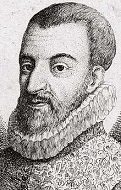
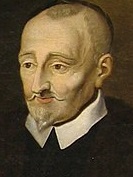

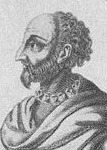

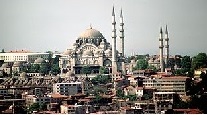
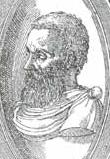



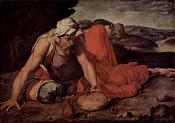
1550 In this decade after five decades of war the Muzo Indians of Columbia, who occupy the emerald-rich area of the E ridge of the Andes Mts. in Columbia are conquered by the Spanish, who force them into slave labor in the mines, causing Colombia to become the world's #1 producer of emeralds. In this half-cent. the European study of classical learning enters a golden age. On Feb. 6 (night) the Battle of Andalien near the Andalien River in Chile is a V for 200 Spanish soldiers under Pedro de Valdivia and 300 Mapochoes auxiliaries under former enemy Michimalonco ("michima" + "lonco" = foreigner + chief) over 20K Mapuche under their chief (toqui) Ainavillo (Aynabillo) (Aillavilu) ("aila" + "filu" = nine snake), who try a surprise night attack on their camp, after which Ainavillo gathers a new 6K-to-60K-man army to attack the new Spanish fort at the Battle of Penco on Mar. 12, losing 4K KIA and 200 taken POW. On Feb. 7 after Cardinal Reginald Pole comes within one vote until he is exposed by his archenemy Cardinal Giovanni Carafa (future Pope Paul IV) as a Spirituali, Gianmaria (Giovanni) Ciocchi del Monte is elected Pope (#221) Julius III (1487-1555) (until Mar. 23, 1555), who likes to sodomize young boys, appointing some of his favorite teenie bonks as cardinals, and going on to bonk his own illegitimate son Bertuccino, causing Cardinal Giovanni della Casa to dedicate his poem In Praise of Sodomy to him - sign me a copy with your brown holy finger? On Feb. 22 Francesco II Gonzaga (b. 1533) dies, and his 2nd son Guglielo (William) I Gonzaga (1538-87) succeeds as duke of Mantua and Montferrat (as Guglielmo X) (until 1587), going on to become a big patron of sacred vocal music, correspond with Palestrina, build the Santa Barbara Church in Mantua, and get the pope to let him create his own rite for Mantua, a first. On Mar. 7 Bavarian duke William IV (b. 1493) dies, and his son Albert (Albrecht) V (1528-79) becomes duke of Bavaria (until Oct. 24, 1579), going on to become a leader of the German Counter-Reformation. So much for the Renaissance, let's start this half-century with blood and fire? Talk about mentally unstable sadists? In Apr. HRE Charles V issues the Eternal Edict Against Heresy of 1550, to be "published forever, once in every six months, in every city and village of the Netherlands", forbidding all meetings in homes for the purpose of religious worship, all reading of the Bible, and all discussion of controversial religious matters; punishment is burning alive, unless one repents, in which case if they are male they are to be beheaded, and if female to be buried alive; death can be escaped only by feeding others to the flames by betraying them; officials showing leniency or mercy are to be removed from office and punished likewise; during Charles V's 40-year rule 50K-100K Netherlanders perish in his cheery little Inquisition. On May 16 after the Treaty of Boulogne (Mar. 24) causes the English to evacuate in Mar., ending the Rough Wooing, Henri II of France formally enters Boulogne, staying three days to admire the fortifications built by the English. On July 7 Chocolate is introduced to Europe? On Aug. 23 Luis de Velasco (1511-64) arrives in New Spain to become its 2nd viceroy, and takes office in Mexico City on Nov. 25 (until 1564). On Oct. 5 the seaport-river city of Concepcion (Concepción) Concepción de la Madre Santísima de la Luz (Conception of the Blessed Mother of Light) (modern-day pop. 292K/1.3M) is founded in the Bio-Bio region of SC Chile by Pedro de la Gasca and Pedro de Valdivia. On Nov. 7 bishop of Holar, Iceland (since 1522) Jon Arason (b. 1484) is killed by Lutherans, becoming the last Roman Catholic bishop of Iceland, uttering the immortal Icelandic soundbyte: "That I know, little Sveinn" before being beheaded after being told "There is a life after this one, sir"; Denmark forces Iceland to disown Roman Catholicism and adopt Lutheranism - welcome back to dancing with the stars? Edward Seymour is released from the Tower. Sir William Cecil, 1st Baron Burghley (Burleigh) (1520-98) becomes English secy. of state (until 1553, then 1558-72). Tsar Ivan IV convokes the Zemski Sobor (Russ. "estates general"), Russia's first Duma (nat. representative assembly), and begins a comprehensive modernization and revision of the Russian law code - what's that stamped on you Cossacks' foreheads, the word Dumas? The epic Valladolid Debate in Spain between pro-slavery Dominican Juan Gines (Ginés) de Sepulveda (Sepúlveda) (1494-1573) and anti-slavery Dominican Bartoleme (Bartolomé) de las Casas (1484-1566), bishop of Chiapas over the plight of the Am. aborigines begins, and after a 5-day speech backed up with armloads of his 40-year research, Casas persuades the king to forbid new expeditions against the Indians and to order that they be treated as humans, although nobody really heeds him and the ban on expeditions expires in 10 years?; meanwhile there is little interest in the New World in Europe, and only in this decade when Spain and England form closer ties does it begin to develop, and until now stupid readers are handed illustrations of Turkish life and don't know the difference, but the development of copper-plate engraving in this half-cent. finally allows accurate reproduction of original drawings, wising them up? The Formula of the Institute, the founding manifesto of the Jesuits changes "propagation of the faith" to "defense and propagation of the faith" as one of its goals, and the battle is on with those *!?*! Protestant heretics - too bad, the cat is out of the bag: only 440 years to the porno-saturated worldwide Internet? Spanish viceroy (since 1546) Father Pedro de la Gasca returns to Spain after pacifying the region and ameliorating the condition of slaves, which pisses-off the Spanish, and New Spain viceroy (since Apr. 17, 1535) Antonio Hurtado de Mendoza quits on Nov. 25, becoming Spanish viceroy #3 of Peru next Sept. 23 (until July 21, 1552), after a long overland trip from Mexico, followed by a boat trip from Panama, soon facing a Spanish revolt led by Francisco Giron (Girón) (-1554) (ends 1554); when Mendoza takes sick and dies on July 21, 1552, the audiencia exercises interim authority to fight the revolt. Don Francisco de Urdinola (Urdiñola) the Elder (1498-), who later strikes it rich with the Bonanza Mine founds San Luis Potosi (Potosí) in C Mexico (modern-day pop. 2.7M) (see 1583); in 1592 gold and silver are discovered, and the town is named in honor of silver-rich Potosi, Bolivia. The first Jesuits reach Brazil. Duke Albrecht of Hohenzollern commissions printer Jan Seklucjan (1510-78), who fled Leipzig for Konigsberg because of his Protestant pubs. to trans. the Bible into Polish, and he goes on to hire Stanislaw Murzynowkski (1528-53) and pub. a Polish Trans. of the New Testament from the Greek in 1553. The Great Vowel Shift in England (begun in 1350) results in Modern English. Scottish queen Mary de Guise visits her daughter Mary Stuart in France, and approves of how she's being brought up a lady. Many of the estates of St. Peter's in Westminster, England are appropriated to pay for repairs to St. Paul's Cathedral, giving an object lesson to the old expression, "Robbing Peter to pay Paul". During this half-cent. Red Bay, across the Strait of Belle Isle from Newfoundland in Canada becomes the largest whaling port in the world (right whales and bowhead whales); Basque whalers from France and Spain work it in 1530-1600. Church records of baptisms, circumcisions, marriages, and burials begin to be kept in the Netherlands. About this time La Pleiade (Pléiade) (named after the 3rd cent. B.C.E. Alexandrian Pleiad) (AKA the Brigade), a group of French Renaissance poets flourishes at the College de Coqueret, led by "Prince of Poets" Pierre de Ronsard (1524-85) (court poet of Charles IX), Joachim du (Du) Bellay (1522-60), and Jean-Antoine de Baif (Baïf) (1532-89), attempting to break with Clement Marot and the grands rhetoriquers and ennoble French by imitating the ancients to make it a worthy language for lit. expression; they are all students of Hellenist Latinist scholar-poet Jean Dorat (Daurat) (Joan Dinemandy) (1508-88). In this decade the Elizabethan Statue of Artificers exempts men over 60 and women over 40 from compulsory military service. In this decade Witches' marks begin to be carved on churches, barns, homes et al. to ward off witches (ends 1750). In this half-cent. court jesters (dwarfs, cripples, etc.) begin to appear in Europe; they often have noble rank? - survivors from all the religious torture looking for sanctuary in clown suits? In this half-cent. codpieces go out of fashion in Europe after flourishing for a cent. - too easy to get caught in all the fires? In this decade Wallpaper is brought from China to Europe. About this time the English call the French arquebus the "caliver" (caliber). In this decade Ivan IV the Terrible begins minting coins showing a knight with a spear (kopje), which become known as Kopeks. Just as it is ending, the word "Renaissance" (Rinascita) is coined in an Italian work by Italian art historian Giorgio Vasari (1511-74). In this half-cent. Spanish writers begin developing the picaresque novel, the Moorish novel (chivalric tales of fighting the Moors), and the pastoral novel (idealized shepherds, stolen from Italy and Portugal); the first Moorish novel is the anon. El Abencerraje. Japanese Ukiyoe (Jap. "pictures of the floating world") Painting begins in this decade. Tales of La Llorona (The Weeping Woman) begin to be told in Mexico City, about Maria, who drowns her children in the river after learning that her hubby left her for a younger woman, then drowns herself, and is refused entry to Heaven until she finds them, causing her to wander Earth forever. Sports: The first written reference to the game of Cricket (Creag) occurs in Edward VI's wardrobe accounts as played by pupils of Royal Grammar School in Guildford. Architecture: Andrea Palladio's Palazzo Thiene in Vicenza (begun 1545) is completed. The Suleymaniye Mosque, the most beautiful mosque in Constantinople is begun, designed by #1 Ottoman architect Mimar Sinan (1489-1588) (finished 1558). About this time a Great Wall is built on the Big Island of Hawaii to create a place of refuge for those breaking kapus, later becoming the site of Pu'uhonua o Honaunau Nat. Historic Park. Inventions: In this decade the Screwdriver and Wrench are invented by Euro gunsmiths and armorers? In this decade Sealing Wax is first used in Europe. Science: Girolamo Cardano (1501-76) of Italy describes the Biconvex Lens in use in a camera obscura. French surgeon Ambroise Pare (Paré) (1510-90) develops the first Ligature to stop bleeding during surgery, and traces phantom pains to the brain. Nonfiction: Thomas Cranmer (1489-1556), A Defence of the True and Catholic Doctrine of the Sacrament of the Body and Blood of Christ. Sigismund von Herberstein (1486-1566), De Natura Fossilium. Robert Estienne (1503-59), Greek New Testament, 3rd Ed.; first to incl. notes documenting differences among the Greek mss. Rabbi Joseph Karo (1488-1575), Shulhan Arukh (1550-9); authoritative handbook on Jewish law. John Knox (1505-72), Doctrine That the Sacrifice of the Mass Is Idolatry; A Summary of the Sacrament of the Lord's Supper. Pedro de Cieza de Leon (1520-54), Journal of Travels; first to give the avocado the Spanish name aguacate, from the Aztec word "ahuacatl" for testicle - no wonder the English prudes changed it to alligator pears? Andreas Osiander (1498-1552), De Lege et Evangelio; De Justificatione; splits with Luther and Calvin with the view that justification by faith is instilled in rather than ascribed to humanity by Christ's divinity, causing a big quarrel in Konigsberg with Philip Melanchton, which spreads to Osiander's backer Duke Albrecht I of Prussia, causing a strain on his reign until Osiander kicks off in 1552, after which the duke is forced to consent to a condemnation of Osiander's teaching. Rhaeticus (1514-74), Trigonometric Tables. Aegidius Tschudi (1505-72), Chronicon Helviticum; the early history of the Swiss Confederation; not pub. until 1734. Giorgio Vasari (1511-74), Lives of the Most Excellent Italian Painters, Sculptors, and Architects, from Cimabue to Our Times; 2nd ed. 1568; written after Cardinal Farnese asks him to assemble a "catalog of artists and their works listed in chronological order" in Rome in 1546; initiates the study of art history in the West, and coins the term "Renaissance" (Rinascita) - the masters are themselves the subject? Otto Wermueller, A Spiritual and Most Precious Pearl; trans. into English by Miles Coverdale. Art: Hans Eworth (1520-74), Sir John Luttrell. Lorenzo Lotto (1480-1556), A Nobleman in His Study. Michelangelo (1475-1564), Deposition from the Cross; designed for his own tomb; The Crucifixion of St. Peter (Pauline Chapel, Vatican) (his last fresco). Frans Verbeeck (1510-70), Portrait of the Jester. Daniele da Volterra (1509-66), The Prophet Elias (1550-60); lounges on the ground with bread. Music: John Marbeck (1510-85), The Booke of Common Praier Noted; the first musical setting of the English liturgy? Plays: Olaus Petrie (1493-1552), Tobia Commedia; first Swedish stage play. Hans Sachs (1494-1576), The Wandering Scholar from Paradise. Poetry: Pierre de Ronsard (1524-85), Odes. Novels: Giovanni Francesco Straparola (1480-1557), Thirteen Facetious Nights (Tredici Piacevoli Notti) (2 vols.) (1550-3); first European collection of fairy tales, containing 75 stories incl. "Beauty and the Beast", and "Puss in Boots", later used by Charles Perrault, William Shakespeare, and Moliere; modelled on Giovanni Boccaccio's "The Decameron", about guests at a 13-night party on Murano Island near Venice, who tell each other stories; Spanish trans. pub. in 1583; placed on the Prohibited Index in 1624. Births: The ultimate My Name is Earl? English noble brain man (the real Shakespeare?) Edward de Vere, 17th Earl of Oxford (d. 1604) on Apr. 12. French Valois king (1560-74) Charles IX (d. 1574) on May 30 in Saint-Germain-en-Laye; son of Henry III and Catherine de' Medici; husband of Elisabeth of Austria. German astronomer Michael Mastlin (Maestlin) (Mästlin) (Möstlin) (Moestlin) (d. 1631) on Sept. 30 in Goppingen; Kepler's first teacher. Swedish king (1604-11) Charles (Karl) IX (d. 1611) on Oct. 4 in Stockholm Castle; youngest son of Gustav I and 2nd wife Margaret Leijonhufvud. Dutch (Flemish) landscape painter Mathys Bril (the Younger) (d. 1584) in Antwerp; brother of Paul Bril (1554-1626). French gen.-statesman Henri de Lorraine, 3rd Duc de Guise (d. 1588); son of Francois de Lorraine, 2nd Duc de Guise (1519-63). English Separatist leader Henry Barrow (Barrowe) (d. 1593) in Norfolk. Ottoman valide sultan (1583-94) Sophia (Sofia) (Sofiyeh) (Safiyeh) ("the Light or Pure One") Baffo (d. 1605) in Corfu; daughter of the Venetian gov. of Corfu; a gorgeous blonde captured in the 1560s by the Turks who becomes the sultan's top harem girl (wife) and rules the Ottoman empire behind the scenes with P-power. Italian "L'Amfiparnasso" madrigal composer (Benedictine monk) Orazio Vecchi (d. 1605) in Modena; studies with Salvatore Essenga. Spanish "The Poetic Exemplar" dramatist-poet Juan de la Cueva de Garoza (d. 1612) (b. 1543?) in Seville. English impresario Philip Henslowe (d. 1616) in Lindfield, Sussex. Irish rebel leader Hugh O'Neill, 2nd Earl of Tyrone (d. 1616) (b. 1540?) in Tyrone; 2nd son of Matthew O'Neill, illegitimate son of Conn O'Neill, 1st earl of Tyrone. Chinese dramatist Tang Xianzu (Hsien-tsu) (d. 1616); author of Peony Pavilion (The Return of the Soul). Scottish mathematician (Protestant) ("Marvellous Merchiston") John Napier (Neper), Laird of Merchiston (d. 1617) in Merchiston (near Edinburgh); educated at St. Andrews U.; inventor of logarithms - stick that slide rule up your what? English Anglican clergyman and Congregationalism (Brownists) founder ("Father of the Pilgrims") Robert Browne (d. 1633) in Tolethorpe Hall, Rutland; educated at Corpus Christi College, Cambrdige U. Deaths: English diplomat Thomas Magnus (b. 1463) on Aug. 18 in Sessay, North Riding of York. Scottish philosopher-historian John Major (b. 1467) on May 1 in St. Andrews. Italian poet Gian Giorgio Trissino (b. 1478) on Dec. 8 in Rome. English noblewoman (mother of Queen Jane Seymour) Margery Wentworth (b. 1478) in Oct. Turkish Shiite composer Pir Sultan Abdal (b. 1480) (executed for pro-Safavid activities) - the Muslim Bob Dylan? Icelandic Roman Catholic bishop (last) Jon Arason (b. 1484) on Nov. 7 in Skalholt (murdered); last words: "That I know, little Sveinn". French madrigal composer Philippe Verdelot (b. 1485). Italian duke Ferdinand of Calabria (b. 1488) on Oct. 20. German Bavarian duke William IV (b. 1493) on Mar. 7. French duke of Guise #1 (1520-58) Claude of Lorraine (b. 1496) on Apr. 12 in Chateau de Joinville, Champagne; the pop. of Joinvile greets him with the cry "Hosannah to the son of David". French cardinal Jean de Lorraine (b. 1498) on May 18 in Neuvy-sur-Lore. Italian artist Niccolo Tribolo (b. 1500). Flemish painter Henri Met de Bles (Civetta) (b. 1510). Italian duke of Mantua (1540-50) Francesco III Gonzaga (b. 1533) on Feb. 22.




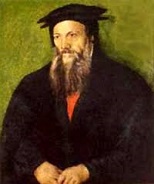

1551 On Feb. 23 Society of Jesus (Jesuits) founder St. Ignatius of Loyola founds the Collegio Romano in Rome as a papal univ., moving it in 1582-4 to Rome's Pigna district under patronage by Pope Gregory XIII; in 1584 it is renamed Gregorian U. On Apr. 1 (Easter Sun.) the English Book of Common Prayer is used for the first time in Ireland at Christ Church Cathedral in Dublin. On May 2 the U. of Lima (Nat. U. of San Marcos) in Lima, Peru is chartered by HRE Charles V, becoming the oldest univ. in the Americas to survive to modern times. After getting pissed-off at Hospitaller attacks on Turkish ships, 12K Ottoman Janissaries on 112 galleys and two galleasses under adm. Dragut (Turgut) Reis (1485-1565) (successor of Khaireddin) and fleet adm. (Kapudan Pasha) Sinan (Sinanuddin Yusuf) Pasha (-1553) attack Venice, followed by Augusta, Sicily, followed by Port Marsa Muscietto, Malta, sieging the citadels of Birgu, Senglea, and Medina, but fail to capture it, instead capturing the sister island of Gozo and taking 5K POWs as slaves; in Aug. they capture Tripoli from the Knights of St. John under cmdr. Gaspare de Villers, who is taken POW along with several knights, who are later released after intervention by French ambassador Gabriel d'Aramon (-1553); after the entire Ottoman fleet abandons Sinan Pasha on the shore and follow Turgut Reis into the Tyrrhenian Sea, causing Sinan to accuse them of mutiny and treason until Sultan Suleiman I orders him to "do whatever Turgut says", Dragut becomes Ottoman gov. of Tripoli (ends 1711) - the idea of a Masonic-run empire in America with its own Marines who can storm the shores of Tripoli takes shape now? On Sept. 22 the Royal and Pontifical U. of Mexico, founded by Luis de Velasco to train young men for the Church (modeled after the U. of Salamanca) is chartered by crown prince Philip on behalf of HRE Charles V; in 1865 anti-clerical Maximilian I of Mexico closes it; it is reopened in 1910, becoming the second oldest Am. univ. to survive to modern times after the U. of Lima, and the most important in the Spanish-speaking world. On Dec. 16 (night) after he develops dreams of glory for Transylvania, deposes John II and his mother Isabella, and recognizes Ferdinand I of Germany as king of a united Hungary, getting a cardinal's hat in return for his services, side-switcher George Martinuzzi (b. 1482) is assassinated by order of his new old pal Ferdinand after being suspected of treason for secret negotiations with his old new pal the Ottoman sultan to cool him down and stop another invasion when he finds about about the deposition; meanwhile Martinuzzi's actions in getting the Hapsburgs to occupy the Ottoman vassal principality of Transylvania renew the war over it (ends 1562); Isabella is given Opelln in Silesia in exchange for Siebenburgen, and Ferdinand I promises to marry John II to his daughter; Pope Julius III excommunicates the assassins, but changes his mind in 1555 - I just wanted to know if you are Tommy the Tourist? The second session of the Council of Trent opens; interrupted 18x, it doesn't finish its work of counter-reformation for 18 years. John Dudley imprisons ex-protector Edward Seymour again in the Tower on trumped-up charges - everything's gonna be okay? John Knox is appointed royal chaplain, going on to work to make the English church more strongly Protestant. The Jews are persecuted in Bavaria. The Ottomans attack Shahrizor Province in the Kurdish mts. of N Iraq (ends 1552). Edward VI appoints merchant Sir Thomas Gresham (1519-79) as his royal factor charged with managing the royal debt abroad, and he goes on to virtually elminate it by stock manipulations on the Antwerp bourse. New pope Julius III relents and grants the duchy of Parma and Piacenza to Ottavio Farnese, but fair-weather friend Ferrante Gonzaga now claims Piacenza and threatens to take Parma too, driving Ottavio into the arms of France, which sends an army and starts a war with Gonzaga, causing the pope to take Parma back and hurl censures at the pesky kid; luckily, it works out okay in the end, and in 1556 Ottavio gets what he wants, becoming duke #2 until his death in 1586. Miles Coverdale becomes bishop of Exter (until 1553). Francis Xavier exits Japan, leaving behind two Jesuits and some Japanese converts; during the remainder of the cent. about 300K Japanese are converted to Roman Catholicism; Xavier then attempts to enter China, but is forbidden; meanwhile missionaries in South Am. do quite nicely. Pope Julius III appoints Giovanni Pierluigi da Palestrina as dir. of music at Cappella Giulia in Rome, followed by the church of St. John Lateran in 1555-61 and the church of Santa Maria Maggiore from 1561-94. Alvar Nunez Cabeza de Vaca is recalled from Paraguay to Spain under arrest and sentenced to banishment in Africa until 1556, when he gets a pardon along with a high judicial office in Seville. The first alehouses and taverns are licensed in England and Wales. French scholar Petrus Ramus (1515-72), who had already pissed-off the Catholic theologians with his criticism of Aristotle in 1543 gets the Cardinal of Lorraine to get him a chair of rhetoric and philosophy at the College de France; he then pisses-off the cardinal by adjuring Roman Catholicism and embracing Protestantism, ending up fleeing to Germany then Switzerland (until 1571). Italian Commedia dell'Arte is first performed in Rome; comic hero Harlequin whacks rumps with two pieces of wood joined together to make a slapping sound (slapstick); the word "pantaloons" is derived from Pantalone, a stock char. Paris printer Robert Estienne (Robertus Stephanus) (1503-59) (Roman Catholic-turned-Protestant) introduces the modern verse division of the Bible in his 4th ed. of the Greek New Testament; to give God his due the divisions are sometimes caused by his horse hitting a bump in the road as he works on horseback? - pesky Protestants can now cite chapter and verse in their arguments against Church authorities, who don't accept their paradigm that the Bible is all there is to God's Word? Architecture: The elaborate Renaissance Lonja (Exchange) de Zaragoza in Saragossa, Spain (begun 1541) is finished. Nonfiction: Michael Agricola (1510-57), Daavidin Psalttari; the Psalms in Finnish, incl. lists of ancient Finnish gods. Pierre Belon (1517-64), Histoire Naturelle des Estranges Poissons Marins. Pietro Bembo (1470-1547), Rerum Veneticarum Libri XII. Robert Estienne (1503-59), Greek New Testament, 4th Ed.; first to divide the Bible into verses. Erasmus Reinhold (1511-53), Prussian (Planetary) Tables; spreads Copernican thought using Copernicus' 1543 work De Revolutionibus Orbium Coelestium for its data (unfortunately inaccurate?). Conrad Gesn3er (Konrad von Gesner) (1516-65), Conrad Gessner (1516-65), Historiae Animalium (5 vols.) (4.5K pages) (1551-8); an alphabetical encyclopedia of all known animals, founding modern Zoology (Animal Biology); Ralph Robinson (tr.), Thomas More's "Utopia". Thomas Wilson, The Rule of Reason, Containing the Art of Logic; first book pub. in England on logic; "Logic is an art to reason probably on both parts of all matters that be put forth so far as the nature of everything can bear". Art: Titian (1477-1576), Portrait of Philip II of Spain. Births: English "Britannia", "Annales" historian William Camden (d. 1623) on May 2 in London; educated at Magdalen College, Broadgates Hall, and Christ Church, Oxford U.; friend of Sir Philip Sidney; appointed Clarenceux King of Arms in 1597. Italian "Ave Maria", "Amarilli Mia Bella" composer (co-founder of Baroque opera) Giulio Caccini (Romano) (d. 1618) on Oct. 8 in Rome; father of Francesca Caccini (1587-1640). French (last) Valois king (1574-89) Henry (Henri) III (d. 1589), duke of Anjou; son of Henry II and Catherine de' Medici; brother of Charles IX. German Calvinist chancellor (of Saxony) Nikolaus (Nicholas) Krell (Crell) (d. 1601) in Leipzig; educated at the U. of Leipzig. English Capt. Thomas Lee (d. 1601). Russian non-Rurikid tsar (1598-1605) Boris Fyodorovich Godunov (d. 1605); starts out as a boyar descended from an ancient Tartar family, becomes a favorite of Ivan IV the Terrible, and marries his sister to his feeble-minded son Fyodor - isn't she godunov for you? French marshal Jean de Beaumanoir, Marquis de Lavardin (d. 1614); starts out as a Protestant then switches to Roman Catholic after his daddy is killed in the 1572 St. Bartholomew's Day Massacre. Croatian humanist scholar-diplomat Faust Vrancic (Fausto Veranzio) (Faust Verantius) (d. 1617) in Sebenico. Deaths: Hungarian cardinal-statesman George Martinuzzi (b. 1482) on Dec. 16 (assassinated). Swiss humanist reformer Joachim Vadian (b. 1484) on Apr. 6 in St. Gallen. German Protestant reformer Martin Bucer (b. 1491) on Feb. 28 in Cambridge, England. Italian physician Giovanni Battista Monte (b. 1498) on May 6 in Padua.




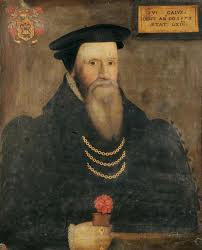





1552 On Jan. 22 Edward Seymour, 1st duke of Somerset (b. 1506) is beheaded on Tower Hill for treason and his properties confiscated, leaving his son Edward Seymour, 1st earl of Hertford (b. 1539) up the creek until he regains his title and lands in 1559, only to get in his own trouble by marrying bad vibes Lady Catherine Grey; John Dudley abolishes his old office (1547-9) of lord protector. On June 17 King Edward VI College in Stourbridge, Worcestershire, England is founded by King Edward VI; in Sept. 1976 it becomes a selective six form college for students age 16-19 with enrollment of 1.6K. Give us Count Chocula? In July 80K Ottomans take Temesvar (Timosoara) in W Romania, along with most of Transylvania, and organize S Transylvania as a province of Temesvar, but the war over it continues for a decade with desultory sieges on the frontier and naval battles in the Mediterranean; on Sept. 4 they take Szolnok in C Hungary; the Siege of Eger in N Hungary E of the Matra Mts. sees 2K Christian forces under Capt. Baron Istvan Dobo de Ruszka (1502-72) successfully fend them off, checking Ottoman expansion into C and E Europe; too bad, they return and take it in 1596 (until 1687); meanwhile the Turks allow large numbers of Spanish Jews to settle in Temesavar until 1716, when Prince Eugene of Savoy captures it, then orders their expulsion in 1718. On Aug. 31 the Collegium Germanicum et Hungaricum seminary for German-speaking priests is established in Rome by Pope Julius III via the bull Dum solicita; the official Jesuit doctrine is laid down as follows: "To search out the hidden venom of heretical doctrine and to refute it, and then to replant the uprooted trunk of the tree of faith" - hand me some holy fire and axes? In Aug. Ferdinand I arranges the Peace (Treaty) of Passau to end the quarrel between his Roman Catholic brother HRE Charles V and elector Maurice I of Saxony, leader of the Protestants, guaranteeing free exercise of the Lutheran faith pending the full settlement of ecclesiastical differences by the 1555 Diet of Augsburg; in later years it is used as an excuse for Protestants to secularize Roman Catholic Church property - pass it out piece by piece? On Sept. 1 after Maurice's cousin John Frederick I the Magnanimous is released, and after a triumphal march he moves his court to Weimar. The Persians attack the Ottomans, who respond by invading the Kurdish region of Shahrizor in N Iraq until they reach an agreement with local chieftains confirming their allegiance - with nine inch nails? The Ottomans capture Jerusalem, and expel all Christians, turning the Cenacle on Mt. Zion into a mosque; no Christian prays there again until 1948 after the establishment of the Jewish state of Israel. The Ottomans occupy the region of Al-Hasa (Al Ahsa) in E Arabia, turning it into a province, with Muhammad Pasha as gov. 84-y.-o. imperial adm. Andrea Doria fights the Barbary pirates. Ivan IV the Terrible conquers the Muslim Tartar khanate of Kazan, key to the Lower Volga River, Siberia, and Persia, destroying the Kul Sharif (Qolsarif) Mosque, largest in Europe outside of Constantinople (rebuilt in 1996-2005), then begins conquering the Astrakhan Khanate (finished 1556), going on to avg. 50 sq. mi. a day, highest rate of land grabbing until the U.S. rush to the Pacific Coast. Henri II of France, allied with the Protestant Elector of Saxony declares war on HRE Charles V, and the French capture Metz, Toul, and Verdun; the Duke of Alva (Alba) attempts to recapture Metz, but Francois de Lorraine II, 2nd Duc de Guise (1519-63) (known as "the Scarred" from his 1545 Siege of Boulogne wounds) defends it, beginning half a cent. of Guise influence in French affairs; Gaspard de Coligny is made adm. (grand pilot) of the French fleet by Henri II (until 1559). The Book of Common Prayer of Edward VI is revised by Canterbury Archbishop Thomas Cranmer to suit Protestants, complete with no real presence of the Eucharist, although the Black Rubric permits kneeling; no vestments, no signing of the cross at confirmation, no holy oil, no reserved sacraments, no prayers for the departed; Cranmer also writes the Forty-Two Articles of Faith (later reduced to 39) for the Church of England, representing the zenith of Calvinist thought; too bad, after Edward VI dies next year, Mary I makes sure they are never put into action - take out the stuff about adultery? Valdivia ("La Perla del Sur") ("City of Rivers") in S Chile is founded by Pedro de Valdivia. Christ's Hospital (AKA the Bluecoat School, Housey, and CH) is founded in London by Edward VI as a coed boarding school. Flemish cartographer Gerhard Mercator (1512-94) settles in Duisburg, Germany; meanwhile the Reformation takes over the town, and in 1555 the miraculous Salvator Church statue is removed - who cares, Mercator will put the burg on the map? Sports: St. Andrew's Golf Club (Royal and Ancient Golf Club of St. Andrews) is founded in cool beautiful green Scotland; Mary Stuart, Queen of Scots becomes (probably) the first woman golfer, and the first to use a caddy. Architecture: Padua Cathedral in Italy is begun (until 1754). Andrea Palladio (1508-80) designs the symmetrical domed-room-centered pedimented temple porch Villa Capra La Rotonda (Villa Almerico Capra Valmarana) in Vicenza; also the Palazzo Chiericati in Vicenza (finished 1580). Science: English physician John Caius (Kays) (1510-73) (pr. like keys) (of Gonville and Caius College, Cambridge fame) pub. the first clear description of English Sweating Sickness, which first struck England in 1485 and spread to the Continent before vanishing in 1551. Roman anatomist Bartolommeo Eustachio (Lat. "giving fruit") (1500-74) discovers the Eustachian Tubes, the adrenal glands, and the detailed structure of the teeth, but his discoveries are not pub. until 1611 (1714) in Tabulae Anatomicae and Libellus de Dentibus. Nonfiction: William Baldwin (1515-63), Wonderful News of the Death of Paul the Third. Bartolome de las Casas (1474-1566), Brevisima Relacion de la Destruccion de las Indias. Francesco Lopez de Gomara, Historia General de las Indias (1552-3); Cortes' private secy. Nostradamus (1503-66), Moult Utile Opuscule (Very Useful Little Treatise); a book of gastronomic, medical, and cosmetic recipes written at the request of his sole Protestant friend Jeanne d'Albret, mother of future Henry of Navarre; enlarged ed. pub. 1555. Georg Joachim Rheticus (1514-74), Canon of the Science of Triangles; first Euro pub. of 6-function trig tables. Pontus de Tyard (1521-1605), Solitaire Premier, ou Prose des Muses, et de la fureur poetique (poétique); his theory of divine fury based on Marsilio Ficino's translations of Plato's "Ion" and "Phaedrus". Art: Titian (1477-1576), Self-Portrait. Plays: Etienne Jodelle (1532-73), Cleopatre Captive; first classical tragedy in French? Poetry: Pierre de Ronsard (1524-85), Amours (vol. 1). Births: English jurist-statesman Sir Edward Coke (d. 1634) (pr. like cook) on Feb. 1 in Mileham, Norfolk; educated at Trinity College, Cambridge U. French "Les Tragiques" Huguenot chronicler-poet-gen. Theodore Agrippa d'Aubigne (d'Aubigné) (d. 1630) on Feb. 8 near Pons, modern-day Charente-Maritime; flees to Geneva in 1620. Austrian HRE (1576-1612) (Roman Catholic) Rudolf II (d. 1612) on July 18 in Vienna; son of Maximillian II (1527-76) and Maria of Austria (1528-1603). Italian painter Lavinia Fontana (d. 1614) on Aug. 24 in Bologna; daughter and pupil of Prospero Fontana (1512-97); first prof. woman artist in Europe? English "The Faerie Queene" poet Edmund Spenser (d. 1599) (b. 1553?) in London; coins the word "prothalamion" ("before the bridal chamber"), meaning a song celebrating marriage, complementing the word "epithalamion", a nuptial song. Italian jurist-philosopher Alberico Gentili (d. 1608) on Jan. 14 in San Ginesio, Marche; educated at the U. of Perugia. Italian Catholic missionary (to China) Matteo Ricci (d. 1610). German painter Hans von Aachen (d. 1615) in Cologne; his father comes from Aachen; pupil of E. Jerrigh and Kaspar Rems; teacher of Peter Isaak and Joseph Heinz. English geographer-chronicler Richard Hakluyt (d. 1616); educated at Westminster School, and Christ Church, Oxford U. English soldier-explorer-courtier-historian and tobacco-head ("the Fox") ("Knight of the Cloak") Sir Walter Raleigh (d. 1618) on Jan. 22 in Hayes Barton, East Budleigh, Devonshire; attends Oxford U. for 1 year (1568-9); knighted in 1584. English poet-historian Samuel Daniel (d. 1619) nar Taunton, Somerset; brother of John Daniel; educated at Hertford College, Oxford U. Italian priest-scholar Paolo Sarpi (d. 1623). Spanish explorer and gov. of New Spain Don Juan de Onate (Oñate) Salazar (d. 1626) in Zacatecas, Mexico; son of Cristobal de Onate (1504-67). Deaths: Swiss Protestant theologian Oswald Myconius (b. 1488) on Oct. 14 in Basel. German humanist writer Johannes Cochlaeus (b. 1489). Swedish reformer Olaus Petri (b. 1493). Chinese artist Qiu Ying (b. 1494); leaves Spring Morning in the Han Palace. Spanish viceroy #1 of New Spain (1535-50) and viceroy #3 of Peru (1551-2) Antonio de Mendoza (b. 1495) on July 21 in Lima, Peru. Italian Franciscian priest Matteo Sarafini (b. 1495) in Venice. German Lutheran theologian Andreas Osiander (b. 1498) on Oct. 17 in Konigsberg, Prussia. German Martin Luther's wife Katharina von Bora (b. 1499) on Dec. 20 in Torgau, Saxony. English lord protector Edward Seymour, 1st duke of Somerset (b. 1506) on Jan. 22 in London (beheaded). Jesuit missionary ("the apostle of the Indies") (first Jesuit saint) St. Francis Xavier (b. 1506) on Dec. 3 on Sancion Island off the Chinese mainland 90 mi. W of Macao.
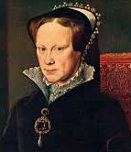

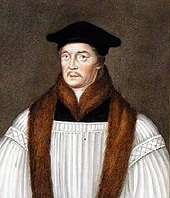







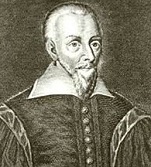
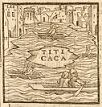




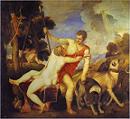

1553 On Apr. 29 Flemish woman Dinghen Vauden Plasse (Mrs. Dingheim) , introduces the practice of starching of linen into England. Nausea, heartburn, indigestion, upset stomach, diarrhea, Bloody Mary is maximum pink? Or, hit it, Mrs. Church? On May 25 as part of a Protestant plot by John Dudley, duke of Northumberland, 15-y.-o. Lady Jane Grey (1537-54) (cousin of Edward VI, great-niece of Henry VIII, and great-granddaughter of Henry VII) (who knows Latin, Greek, and Hebrew) marries his son Guilford (Guildford) Dudley (1536-54), brother of horsemaster Robert Dudley, earl of Leicester; on July 6 after the king's council signs the handwritten King's Device, English king (since 1547) Edward VI (b. 1537) dies of TB; in it he passes over his half-sisters Mary Tudor and Elizabeth for Protestant Lady Jane Grey (1537-54) ("the 9-day queen") (sometimes called the 13-day queen when July 6 is counted), and after Thomas Cranmer forgives his pledge to carry out Henry VIII's will giving it to Mary Tudor, she is proclaimed queen on July 10 in the Tower, and struts her royal stuff until July 19 (never leaving the Tower), with Edward's Greek tutor Sir John Cheke as secy. of state; John Dudley tries to capture Mary in Norfolk and is instead captured in July; meanwhile Mary gathers her forces in East Anglia, and on July 19 after being accompanied by a large force to London along with future Elizabeth I, militant Roman Catholic Mary I Tudor (1516-58), duchess of Suffolk (granddaughter of Ferdinand II and Isabella I the Catholics), later known as Bloody Mary is proclaimed queen (the 42nd British monarch) (until Nov. 17, 1558); the military show of support causes Lady Jane Grey's supporters to fold, and she and her husband are arrested on July 20; Mary I is crowned on Oct. 30 in Winchester Cathedral, immediately signaling a return to Roman Catholicism, and signing a marriage treaty with her cousin Philip II of Spain, promising him the title of King of England without the powers or the succession, triggering Wyatt's Rebellion, with a Protestant army headed by Sir Thomas Wyatt the Younger (1521-54) (son of poet Sir Thomas Wyatt, father of the English sonnet), which heads for London, where they are defeated and the leaders executed by next year, with Elizabeth locked up for almost a year, escaping being implicated in the plot by a hair; too bad, Lady Jane Grey (who has been spared so far and kept in the Tower) is implicated, so her head is on the chopping block with theirs; meanwhile Stephen Gardiner (1483-1555), bishop of Winchester becomes lord chancellor, and soon heads begin to roll; John Knox flees to Geneva to be with John Calvin; St. Paul's chaplain Edmund Grindal flees to Germany (until 1559); Sir John Cheke is imprisoned; Miles Coverdale is removed as bishop of Exeter and imprisoned for two years, then goes into exile for eight years in the Continent (Wesel, Bergzabern, Geneva) (until 1559); after returning to England from exile after the death of Henry VIII in 1547 and being received by Edward VI, who restores his lands, Gerald FitzGerald (1525-85) is restored as 11th Earl of Kildare for his help in suppressing the rebellion, and returns to Ireland, becoming known as "the Wizard Earl" for his interest in alchemy and magic; Thomas Cranmer is reprimanded and confined to his palace at Lambeth, and arrested on Sept. 14 then imprisoned in the Tower of London; Edmund Bonner is released, and goes completely Catholic, becoming known as "Bloody Bonner" for his zealous persecution of Protestants; Thomas Howard, 3rd duke of Norfolk is released from the Tower, and his lands and titles restored, keeping the resilient Howard name going, with his grandson Thomas Howard, 4th Duke of Norfolk (1536-72), son of his dead son Henry Howard inheriting the dukedom on his death next year; on Aug. 23 John Dudley is beheaded after feigning conversion to Roman Catholicism; his son Robert Dudley (b. 1533) (who became an MP this year) supports his father, and ends up in the Tower under sentence of death at the same time that Elizabeth is imprisoned there, sparking rumors that they begin a romance, despite him being married? On July 9 the Battle of Sievershausen between Sievershausen and Arpke in modern-day Lehrte, Germany sees 18K troops under elector Maurice I of Saxony and duke Henry V of Brunswick-Luneburg defeat 15K troops under Franconian Hohenzollern margrave Albert II Alcibiades "the Warlike" of Brandenburg-Kulmbach (1522-57) after 4K are killed on both sides, incl. Maurice (friendly father) and two of Henry's sons; Maurice's younger brother Augustus I (1526-86) becomes elector of Saxony (until Feb. 11, 1586); in 1967 the local parish church becomes the site for German peace groups to meet; in 1979 they build an anti-war museum there. In July the Spanish capture and sack Hesdin in Pas de Calais in N France on the Canche River. On Aug. 17 Charles III (b. 1486) dies, and his only son Emmanuel "Iron Head" Philibert (1528-80), who had helped capture Hesdin in July becomes duke of Savoy (until Aug. 30,, 1580), going into the dirty-deeds-done-dirt-cheap biz to try and get his hereditary lands back from the French, who had been administering them since 1536. On Oct. 5 the First Parliament of Bloody Mary I meets, repealing Edward VI's Treason Act along with his religious legislation, passing an act declaring the legitimacy of Mary I, and reinstating the Latin Mass, celibacy of the clergy, and ritual worship, wiping out Edward VI's entire work. On Oct. 27 Swiss Protestant leader John Calvin (1509-64) burns his theological enemy, Unitarian (non-Trinitarian) Catalan scholar Michael Servetus (b. 1511) (who was captured while fleeing to his protection after escaping a prison of the Spanish Inquisition) in Geneva, executioner Guillaume Farel warning the audience: "(Servetus) is a wise man who doubtless thought he was teaching the truth, but he fell into the hands of the Devil... Be careful the same thing doesn't happen to you"; liberals lose their illusions about Bible-thumpers ever lightening up anything but a faggot, and a corner is turned in the fight for freedom of conscience?"; at his trial Servetus is ridiculed for describing Palestine as a sparse, sterile land when the Bible says it's the land of milk and honey; noted noble Paris-educated French Protestant ex-humanist poet Theodore Beza (1519-1605) backs Calvin up - I look bad, feel bad, which is most important? On Dec. 25 Chilean gov. #1 (1540-7, 1549-) Pedro de Valdivia (b. 1497) is KIA in the Battle (Disaster) of Tucapel near Ft. Tucapel in a revolt of the Mapuche (Araucanian) Indians (captured then executed?), led by Lautaro ("swift hawk") (1534-7) (his former servant, who escaped and taught the Mapuches how to ride horses), stopping the Spanish advance; too bad, Mapuches have to have a lengthy V celebration, which allows the Spaniards to regroup in Concepcion. The Ottomans ravage part of Persia, but the shah's army withdraws into the mountains of Luristan. Sultan Suleyman has his (most able?) son Mustafa, gov. of Amasya strangled for planning an uprising. Queen Mary I proves herself English first and Roman Catholic second by ordering the Irish pop. of Kings and Queens County driven out and their lands given to English colonists, becoming the first English monarch to try colonizing butt-of-the-joke Ireland with stankin' English settlers. Sebastian Cabot (1476-1557), son of John Cabot (d. 1498) convinces merchants to back him in an expedition sailing NE from England, above Scandinavia, in a fruitless search for a northeast passage; Sir Hugh Willoughby (-1554) of the Bona Esperanza, Cabot of the Bona Confidentia, and Richard Chancellor (-1556) of the Edward Bonaventure, backed by the Mystery Co. and Fellowship of Merchant Adventurers for the Discovery of Unknown Lands of London sail to the Arctic; after being separated by "terrible whirlwinds", on Sept. 14 Willoughby sails into a bay between Russia and Finland, and discovers Novaya Zemlya, while Cabot returns to England, and Chancellor anchors in the White Sea and trudges overland to Moscow to the court of Ivan IV the Terrible, where he is warmly welcomed, wined, and dined, opening English trade with Russia; Willoughby dies during the winter on the Kola Peninsula on the Lapland coast early next year, and the frozen bodies of him and his crew, along with his journals are found by fisherman a year later. Tonbridge School in Kent, England is founded by London lord mayor Sir Andrew Judde (Judd) (1492-1558), who leaves it in his will to the Worshipful Co. of Skinners in London. Bridewell Prison in London, England is founded (until 1700) in a brick palace around three courtyards built for Henry VIII near St. Bride's (St. Bridget's) Well on the banks of the Fleet River in London (scene of the 1533 Hans Holbein painting "The Ambassadors"), pioneering hard labor instead of corporal or capital punishment and creating the first "penitentiary", hoping to make criminals penitent; after it develops shocking conditions, the term "bridewell" is used in Britain to differentiate hell-holes from mere prisons until 1865. Architecture: The Renaissance Old Palace (Altes Schloss) in Stuttgart, Germany is built. The 5 mi. x 2 mi. oblong Chinese City (Nan Cheng) S of Tartar City in Peking begins contruction (finished 1564), surrounded by a 30-ft.-high wall. Palladio designs the Villa Pisana in Montagnana. Paolo Veronese does the Ceiling of the Doge's Palace in Venice. Inventions: The first modern violin is developed. Giovan Batista Belaso invents the Vignere Cipher, containing the idea of the password in cryptography. Science: French naturalist Peter Baleen, er, Pierre Belon (1517-64) pub. De Aquatilibus, the first scientific study of marine animals, revealing that cetaceans (whales, dolphins, porpoises) breathe air with lungs, and other shocking discoveries. Before being burned, Catalan scholar Miguel Serveto (1511-53) pub. Christianismi Restitutio, a theological discussion in which he mentions that blood passes from the right to left ventricle via the lungs, where it changes color, becoming the first Westerner to pub. the theory of the pulmonary circulation; he had been a pupil of Johannes Gunther of Andernach in Paris at the same time as Vesalius. Nonfiction: Pedro de Cieza de Leon (1520-54), Chronicle of Peru (vol. 1 of 4); written by a Spanish conquistador; the first Euro pub. to mention the potato; the last 3 vols. are pub. in the 19th and 20th cents. Leonard Digges (1520-59), A General Prognostication; bestselling almanac with a perpetual calendar and astronomical material; title changed in 1556 to "A Prognostication Everlasting". Sir Thomas More, A Dialogue of Comfort Against Tribulation (posth.). Domingo de Soto, De Justicia et Jure. Samuel Usque, Consolations for the Tribulations of Israel; Portuguese Jew tells of the joys of emigration from Jew-persecuting Europe to Jew-tolerating Turkey, "a broad and spacious sea which God opened with the rod of His mercy as He opened the Red Sea at the time of the Exodus... Here the gates of liberty are always open for the observance of Judaism." Thomas Wilson, The Arte of Rhetorique. Art: Titian (1477-1576), Venus and Adonis. Plays: Hans Sachs (1494-1576), Tristan und Isolde. Nicholas Udall (1504-56), Ralph Roister Doister; the first English comedy; contains hidden pederasty messages?; not pub. until 1567; wealthy widow Christian Custance is wooed by Ralph Roister Doister even though she is betrothed to Gawyn Goodluck, and when she spurns him he tries taking her by force but her servants stop him and he runs away, after which Goodluck gets lucky and there's a happy ending. Novels: William Baldwin (1515-63), A Marvellous History Intituled Beware the Cat; pub. 1570; the first English novel? Births: Prussian duke #2 (1568-1618) Albert Frederick (Albert Friedrich) (d. 1618) on May 7; son of Albrecht I (1490-1568) and Anna Marie of Brunswick-Luneburg; last duke of the Ansbach branch of the Hohenzollern family. French queen consort of Navarre (1572-99) and queen consort of France (1589-99) Margaret of Valois (Marguerite de Valois) (Margaret of France) (Queen Margot) (d. 1615) on May 14 in Chateau de Saint-Germain-en-Laye; younger daughter of Henry II (1519-59) and Catherine de' Medici (1519-89); sister of Frances II, Charles IX, Henry III, and Elizabeth of Valois; queen (1572-99) of Henri IV (Henry of Navarre). Italian physician-botanist Prospero Alpino (ALpinio) (Alpinio) (Alpin) (d. 1617) on Nov. 23 in Marostica (near Vicenza); educated at the U. of Padua; father of Alpino Alpini (-1637). French Bourbon king #1 (1589-1610) and king of Navarre (1572-1610) "Good King" Henri IV (Henry III of Navarre) (d. 1610) on Dec. 13/14 in Pau, Bearn, Navarre; son of Antoine de Bourbon, duc de Vendome and Jeanne d'Albret (Jeanne III of Navarre) (1528-72), daughter of Margaret of Navarre; head of the Protestant Party in France who converts to Catholicism to secure his throne; father of Louis XIII (1601-43), Elisabeth of Bourbon (1602-44), and Henrietta Maria of England-Scotland (1609-69); his unlikely rise to the throne of France was predicted by Nostradamus in Century 5, Quatrain 41? Italian composer and madrigal king Luca Marenzio (Marencio) (d. 1599). English "Euphues" dramatist-poet John Lyly (d. 1606) in Kent; educated at Magdalen College, Oxford U. German chorale composer Johannes Eccard (d. 1611) in Muhlhausen, Thuringia. English lexicographer-linguist John (Giovanni) Florio (d. 1625) in London; Roman Catholic-turned-Protestant Italian immigrant father Michelangelo Florio is tutor of Elizabeth I and Lady Jane Grey; devotes his life to civilizing the barbaric English with Italian culture and proverbs; friend of William Shakespeare and Giordano Bruno; inspires Holofernes in "Love's Labour's Lost?" Spanish valido Francisco Gomez (Gómez) de Sondoval y Rojas, 1st Duke of Lerma (d. 1625) (b. 1552?) in Tordesillas, Castile and Leon; first of the validos (Sp. "most worthy", favorites of the Hapsburg kings ruling Spain. Deaths: German painter Lucas Cranach the Elder (b. 1472) on Oct. 16 in Weimar. Spanish scholar Hernan Nunez (b. 1475) in Salamanca. Italian physician Fracastorius (b. 1478) on Mar. 17 in Verona. Spanish conquistador Francisco de Montejo (b. 1479) in Spain. Italian physician-poet-astronomer Girolamo Fracastoro (b. 1483). Italian duke of Savoy (1504-53) Charles III (b. 1486) in Aug. Italian painter Bonifazio Veronese (b. 1487). German statesman Jacob Sturm von Sturmeck (b. 1489) on Oct. 30 in Strasbourg. German prince-bishop Franz von Waldeck (b. 1491). French humanist philosopher Francois Rabelais (b. 1494) on Apr. 9 in Paris; last words: "I am going to a great perhaps"; his last will: "I have nothing. I owe much. The rest I leave to the poor"; "If you wish to avoid seeing a fool you must first break your mirror." Spanish conquistador Pedro de Valdivia (b. 1497) on Dec. 25 in Tucapel, Canete, Chile (KIA). English soldier John Dudley, viscount Lisle, earl of Warwick, and duke of Northumberland (b. 1502). German astronomer Erasmus Reinhold (b. 1511) on Feb. 19 in Saalfeld, Thuringia. Spanish super scholar-scientist-physician Miguel Serveto (Michael Servetus) (b. 1511) on Oct. 27 in Geneva (burned by Caligula Calvin); last words: "Jesus, Son of the Eternal God, have mercy on me"; leaves Universal Treatise on Syrups (pioneer book in pharmacology and vitamins) - the good burn out young? Italian travel writer Ortensio Landi (b. 1512); leaves Travel Diaries which mention macaroni and say that it is given the name of the beatified. German elector of Saxony (1547-53) Maurice I (b. 1521) on July 9 in Sievershausen (KIA). Ottoman adm. Sinan (Sinauddin Yusuf) Pasha (b. ?) on Dec. 21 in Istanbul. French ambassador to Constantinople (1546-53) Gabriel de Luetz, Baron et Seigneur d'Aramon et de Vallabregues (b. ?).





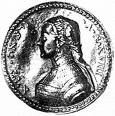



 "
"
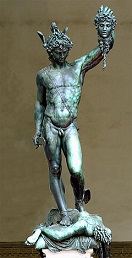
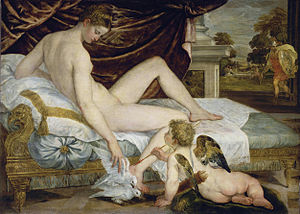
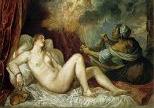
1554 On Jan. 25 Sao Paulo in SE Brazil (modern-day pop. 12M/21.2M) is founded by Jesuit missionaries Manuel da Nobrega and Jose de Anchieta on an Indian campsite 45 mi. from the coast. On Feb. 12 Lady Jane Grey (b. 1537) and her husband Guildford Dudley (b. 1534) are beheaded for treason. On Feb. 23 5K Mapuch warriors under chief (toqui) Lautaro battle 180 Spanish soldiers and 1.4K-2.1K Indian auxiliaries under Francisco de Villagra (1511-63) at the Marihueno (Marihueñu) Hill, and score a V, killing 84 Spaniards and most of the auxiliaries, and capturing all the artillery, but the lengthy V celeb allows the Spaniards to regroup in Santiago, by which time the Mapuches catch smallpox from them. On Mar. 3 John Frederick I the Magnanimous (b. 1503) dies, and his eldest son John Frederick II (1529-95) succeeds him as duke of Ernestine Saxony (until Nov. 1566), moving his court to Gotha; he gives his younger brothers Johann Wilhelm (1530-73) (Weimar) and Johann Frederick III (1538-65) (Gotha) a split of his lands, keeping Eisenach and Coburg, later absorbing Gotha on the death of JFIII in 1565; meanwhile recovers the title of elector of Saxony, but loses it again in 1556, after which he begins an ill-fated war against the HRE to get it back. On Mar. 16 the body of St. Francis Xavier arrives in Goa to a celebration; the next day the body is examined and declared to have no sign of decay, causing a brisk business in his holy remains for curative purposes. On Mar. 23 (Good Friday) Nostradamus (1503-66) writes his first quatrain after evoking his demon in accordance with rites prescribed by Michael Psellus the Elder (1019-78) in De Daemonibus? In Mar. after being condemned to death for treason by a secular court but the sentence not carried out, then held for trial for heresy after Parliament reestablishes papal jurisdiction, Thomas Cranmer is moved to a common prison in Oxford, where he is coerced into making seven recantations of his earlier beliefs, proclaiming faith in the articles of the Roman Catholic Church and repudiating his writings, which doesn't save him from being deposed from his archbishopric and excommunicated, and condemned by a secular court to burning at the stake; meanwhile the revolt against Mary peaks and fails, and several nobles are executed. On Apr. 12 the Earl of Arran is removed, and Mary de Guise becomes regent of her French-fried daughter Mary, Queen of Scots. On July 26 38-y.-o. Queen Bloody Mary the Catholic of England marries 27-y.-o. Spanish king (1556-98) Philip II (the Prudent) (1527-98), son of Inquisition-loving HRE Charles V (his 2nd wife after Mary of Portugal, mother of Don Carlos de Austria), who is made king of Naples by his father as a wedding gift, and together they officially restore the Roman Catholic Church in England, reviving the 1401 De Heretico Comburendo act so they can burn heretics (300+ total starting in Feb. 1555, some getting bags of gunpowder tied to their legs to finish them off quickly); Philip II is now king of England, and Mary falls madly in love with him; Mary's popularity in England at first soars when she announces that she's preggers, and therefore her Catholic dynasty is here to stay, then plummets after it turns out to be a fantasy in 1555 and they joke about her being pregnant with a lapdog; meanwhile she imprisons her half-sister and heir presumptive Elizabeth Tudor on false charges of participating in Wyatt's Rebellion, along with Sir John Harrington and his wife Isabella Markham, who are rewarded in 1561 by Liz by standing godmother to their eldest son John (she is later released, after professing to be Catholic); Robert Dudley is released from the Tower after Philip II intercedes. In Sept. John Knox travels to Frankfurt to pastor English refugees from Mary's persecution. In Dec. Francisco Hernando Giron is executed, ending the Spanish revolt in Peru (begun 1550). The Portuguese defeat an Ottoman fleet off Hormuz, preventing them from controlling the Persian Gulf, and closing it to Ottoman shipping. HRE Charles V obtains a bull from Pope Julius III granting him a dispensation from fasting, and allowing him to break his fast early in the morning even when he is to take the sacrament; "Fish of every kind was to his taste, as, indeed, was anything that in its nature or habits at all approached to fish. Eels, frogs, oysters, occupied an important place in the royal bill of fare" (H.G. Wells, vol. 2, p. 634). A Persian army defeats a Turkish force under Suleiman I at the Battle of Bitlis 15 mi. SW of Lake Van, and Suleiman makes peace with Persia, retaining Mesopotamia. Japan invades Zhe Jiang. Dragut begins attacking Hapsburg outposts in N Africa. Wealthy Spanish Marrano Jewish businessman Don Joseph Nasi (1524-79) moves to Constantinople from Venice after sidestepping the Inquisition in Spain, Portugal and Antwerp, and begins financing the rise to power of Suleiman's son Selim II, working with his rich Portuguese-born aunt Dona Gracia Nasi Mendes (1510-69), who moved there the previous year, both of them and their families giving up the Christian conversion act and openly living as Christ-habit-kicking Jews. Sir John Cheke is released from prison and permitted to travel on the Continent and teach until 1556, when he is forced to return to England as a political prisoner and become a Catholic to please Queen Mary. Antonio Moro becomes court painter to Philip and Mary. London trader John Lok (Locke) leads a voyage to Guinea, and next year becomes the first Englishman to bring slaves from Africa, a whopping five - let's bungle in the jungle, well that's all right by me? Mines in Saxony come under state supervision. Shanghai, China builds a 3-mi.-long 33-ft.-high wall to protect itself from raids by Japanese pirates. Architecture: Ottoman chief architect Mimar Sinan (1489-1588) begins the Madrasa (religious college) and Takiyye Mosque (Sufi lodge) in Damascus (finished 1566). Science: Realdo Colombo's Catalan pupil Juan Valverde de Amusco (Hamusco) (1525-?) pub. the first account of the Pulmonary (Lesser) Circulation. Swiss naturalist Conrad Gessner pub. the first scientific description of the Guinea pig; the earliest known portrait of a guinea pig is painted in Elizabethan England in 1580. Nonfiction: Ulisse Aldrovandi (1522-1605), Herbarium (17 vols.); biggest herbarium of the cent. Theodore Beza (1519-1605), De Heraeticis a Civili Magistratu Puniendis; defends the burning of Servetus. Sebastian Castellion (1515-63), Concerning Heretics (De Haereticis); treatise against religious persecution; pub. anon. Diego de Covarrubias y Leiva (1512-77), Variarum; first explanation of the source of economic value; "The value of an article does not depend on its essential nature but on the estimation of men, even if that estimation is foolish." Rembert Dodoens (1517-85), Cruydeboeck (herbal); divides the plant kingdom into six groups. Louis of Granada (1505-88), The Book of Prayer and Meditation; a hit, launching his writing career while living an ascetic life. Joseph ben Ephraim Karo (1488-1575), Shulchan Aruch; last great codification of Jewish law. Francisco Cervantes Salazar, Chronicles of New Spain; first mention of the avocado (alligator pear) as growing in Mexico. Juan Valverde de Amusco, Anatomia del Corpo Umano. Novels: Anon., Lazarillo de Tormes; autobio. of a Spanish boy rogue who takes advantage of his many masters, founding the picaresque (Sp. "picaro" = rogue) genre of fiction. Matteo Bandelle, Le Novelle; 214 short stories. Jorg Wickram, Der Goldfaden. Art: Benvenuto Cellini (1500-71), Perseus with the Head of Medusa (1545-54) (Apr. 27) (bronze sculpture); debuted in the Loggia dei Lanzi in the Piazza della Signoria in Florence, joining Michelangelo's David, Donatello's Judith and Holofernes, and Bandinelli's Hercules and Cacus; the first statue since antiquity where the base incl. a figurative sculpture forming an integral part of the work. Hans Eworth (1520-74), Mary I. Lambert Sustris (1515-84), Venus and Love. Titian (1488-1576), Danae and the Shower of Gold; manly woman raises her hip in expectation of a little hanky panky?; best handling of color ever, although Michelangelo claims that the drawing behind it is deficient? Births: Portuguese Avis king #16 (next to last) (1557-78) Sebastian (Sabastiao) I (the Desired) (d. 1578) on Jan. 20 in Ribeira Palace, Lisbon; posth. son of Prince John Manuel (1537-54); grandson of Joao III (1502-57). Spanish Carmelite nun Marina de Escobar (d. 1633) on Feb. 8 in Valladolid; establishes a Brigittine (literary) Catholic order in Spain. French Catholic League leader Charles of Lorraine, Duke of Mayenne (Charles de Guise) (d. 1611) on Mar. 26 in Alencon; 2nd son of Francis of Lorraine II, duke of Guise (1519-63) and Anna d'Este, daughter of Ercole d'Este II, duke of Ferrara and Renee of France. Russian tsarevich Ivan Ivanovich (d. 1581) on Mar. 28; eldest son of Ivan IV the Terrible and 1st wife anastasia Romanovna; brother of Feodor I (1557-98). English priest-theologian Richard Hooker (d. 1600) in Mar. in Heavitree (near Exeter), Devon; educated at Corpus Christi College, Oxford U.; spends his life defending the Anglican form of church org. against Presbyterianism. English anti-theater clergyman writer Stephen Gosson (d. 1624) on Apr. 17 in Canterbury; educated at Corpus Christi College, Oxford U.; rector at Great Wigborough, Essex (1591) and St. Botolph's, Bishopgate (1600). Belgian (Flemish) "On Justice and Law" moral theologian (Jesuit) Leonardus Lessius (Lenaert Leys) (d. 1623) on Oct. 1 in Brecht. English poet-playwright-statesman Sir Fulke Greville, 1st Baron Brooke (d. 1628) on Oct. 3 in Beauchamp Court (near Alcester), Warwickshire; educated at Shrewbury School (where he becomes friends with Sir Philip Sidney), and Jesus College, Cambridge U.; created baron in 1621. English "Astrophel and Stella" poet-soldier-courtier Sir Philip Sidney (d. 1586) on Nov. 30 in Penshurst Place (near Tunbridge Wells), Kent; educated at Shrewbury School, and Christ Church, Oxford U.; knighted in 1583. French fortifications expert Jean Errard (d. 1610). English theologian-bishop Miles Smith (d. 1624) in Hereford; educated at Corpus Christi College and Brasenose College, Oxford U. Flemish landscape painter Paul Bril (d. 1626); brother of Mathys Bril (1550-84). English adventurer Sir John Lancaster (d. 1618). Deaths: Ottoman adm. Piri Reis (b. 1465). English soldier Thomas Howard, 3rd duke of Norfolk (b. 1473) on Aug. 25. Italian architect Sebastiano Serlo (b. 1475) in Lyons, France. Italian painter Il Moretto (b. 1498). German elector John I the Magnanimous of Saxony (b. 1503) on Mar. 3 in Weimar. Spanish explorer Francisco Vasquez de Coronado (b. 1510) on Sept. 22 in Mexico City. German duchess Sybille of Cleves (b. 1512) on Feb. 21 in Weimar. English nobleman (Lady Jane Grey's father) Henry Grey, 1st duke of Suffolk (b. 1517) on Feb. 23 (beheaded for high treason in the Wyatt Rebellion); his head in oak sawdust is discovered in London's Holy Trinity Church in 1851. Spanish conquistador-chronicler Pedro Cieza de Leon (b. 1520) in Seville. English rebel Sir Thomas Wyatt the Younger (b. 1521) on Apr. 11 in Tower Hill, London (beheaded); his head is hung on a gallows until it is stolen on Apr. 17; his limbs are circulated around England. English almost-king Guilford Dudley (b. 1536) on Feb. 12 (beheaded). English queen Lady Jane Grey (b. 1537) on Feb. 12 (beheaded).










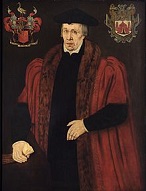
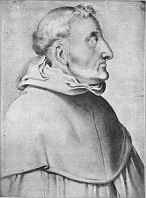

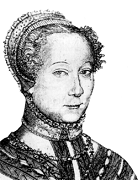
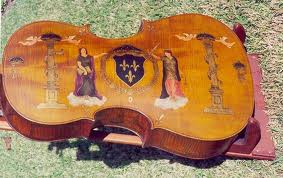

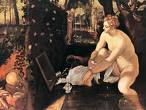
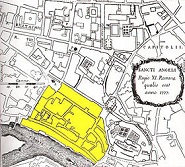

1555 On Mar. 23 Pope (since 1550) Julius III (b. 1487) dies, and on Apr. 9 Marcello Cervini Degli Spannochi is elected Pope (#222) Marcellus II (1501-55); he dies after a reign of 22 days on Apr. 30-May 1, and on May 23 ardent Italian nationalist and narrow intolerant bigot Giovanna Pietro Carafa is elected Pope (#223) Paul IV (1476-1559) (until Aug. 18, 1559), going on to stink up the Roman Catholic Church as the Father of the Roman Inquistion, cutting off Michelangelo's pension and ordering the nudes in his Last Judgment in the Sistine Chapel to be clothed, then persecuting the Spirituali, which Michelangelo is a secret member of, who want to reform the Church without going Protestant; on July 14 he issues the anti-Semitic bull Cum Nimis Absurdum ("Since it is absurd and utterly inconvenient to be in a situation where the pesky Jews - who through their own fault were condemned by God to perpetual slavery - have access to us or even our society... and instead of the slavery they deserve, they dare to claim superiority over us..."), setting up the first-ever legally compulsory Jewish ghetto in Rome, surrounded by brick walls and locked at night, with punishments for being caught out at night, esp. without wearing the yellow star of David on their clothing, plus a yellow hat for males and yellow kerchief for females (the original yellow safety clothing?) (the Satan-worshipers might try to get some Christian infants for who knows what, I can't control myself, burn baby burn?); as self-chosen slaves who reject Our Dear Lord, Jews are prohibited from owning real estate or practicing medicine; by 1870 Rome has the last legally compulsory ghetto in Europe, which is abolished by King Victor Emmanuel - here comes the rooster? On Apr. 30 crowds gather in London to await news of the birth of a baby to Queen Mary after she had proclaimed her pregnancy, only to figure out by June that it is imaginary, and her hubby Philip II didn't have the heart; meanwhile on May 4 Nostradamus pub. the first ed. of his Centuries, perhaps in a rush to predict the future of a new heir to the Tudors and Hapsburgs who will unite all of Europe incl. Britain under the Roman Catholic Holy Roman Empire - somehow I get it, I would sell my very soul and not regret it, for to live without your love is just impossible? In Apr. the free town of Siena, Italy, which had held out with French help finally falls to the Florentine states. On May 25 Henry II of Navarre (not to be confused with Henry II of France) is killed in a riding accident, and his son-in-law Duke Anthony of Bourbon-Vendome (head of the House of Bourbon since 1537) becomes king Anthony (Antoine) of Navarre (Bourbon) (1518-62), giving the House of Bourbon its first throne. On May 29 the Ottomans and Persians agree to the Peace of Amasya, defining the border between Persia and the Ottoman Empire, and giving permission to Persian pilgrims to visit Mecca and Medina; meanwhile a revolt against the Ottoman sultan in Macedonia and Thrace is led by a man claiming to be the dead (executed in 1553?) prince Mustafa, but Suleyman's son Bayezid suppresses it and executes him right this time? On July 19 after Henry VIII travels to Portsmouth and watches from shore, his fleet fights a French fleet of 230 ships; too bad, Henry's favorite ship, the carrack-style Mary Rose (launched July 1511) is sunk in the Solent Straits N of the Isle of Wright, along with vice-adm. Sir George Carew (b. 1504); it is rediscovered in 1971, and salvaged in 1982 and put in a museum. Ow? Ow? Augsburg? On Sept. 25 after HRE Ferdinand I attends the Diet of Augsburg to force the 225 German princes to agree, the Peace of Augsburg (Augsburg Settlement) is signed by HRE Charles V, giving imperial recognition to the 1530 Confession of Augsburg, granting Lutheran (not Calvinist) states equal rights with Roman Catholic states, and establishing the principle "cuius regio ejus religio" (the confession of the subject is dependent on that of the territorial prince), incl. the right to introduce the Lutheran faith (jus reformandi), although no provision is made for the Calvinist faith; by imperial decree Roman Catholic bishops and abbots who go Lutheran lose their offices and incomes; the Holy Roman Empire (and the idea of world imperialism?) begins to decay, leading to a bunch of personal one-valley monarchies, and eventually to the Thirty Years' War (1618-48). In Sept. Philip II, pleading important royal business (fed-up with his ditsy wife?) leaves England (until 1557). On Oct. 16 English Protestant bishops Hugh Latimer (b. 1485) and Nicholas Ridley (b. 1500) are burned at the stake by Bloody Bonner under the orders of Bloody Mary, while Archbishop Thomas Cranmer is forced to watch from Bocardo Prison in Cornmarket; Latimer's last words: "Be of good cheer, Master Ridley, and play the man, for we shall this day light such a candle in England as I trust by God's grace shall never be put out." On Oct. 25 gout-ridden HRE Charles V officially abdicates as duke of Burgundy, giving rule of the Low Countries (Netherlands and Belgium) to his son Philip II; during the ceremony Charles V leans on the shoulder of William I the Silent, Prince of Orange (1533-84), who converts from Lutheran to Roman Catholic to please him, and is given command of troops on the French frontier. On Nov. 13 Thomas Cranmer is deposed as archbishop of Canterbury (enthroned Mar. 30, 1533). In Dec. Pope Paul IV forms a new league to kick the Spanish out of the Papal States, with the French agreeing to ally with the pope and Ferrara to conquer Milan and Naples, then to set up French princes to rule with the pope as suzerain, and also to kick the Medici out of Florence and restore the repub.; Charles of Guise, cardinal of Lorraine signs for France. Hapsburg Duke Cosimo unsuccessfully defends Elba and the surrounding areas from the French, who ravish them. French pirates plunder Havana. Japanese pirates seige Nanking. French knight Nicolas Durand de Villegagnon, having become disillusioned by the failure of the Order of St. John to hold Tripoli against the Turks leads a group of French Huguenots to Brazil, and discovers the site of Rio de Janeiro. English capt. Sir John Hawkins (1532-95), backed by a syndicate of wealthy London merchants sails with three ships to the Caribbean via Sierra Leone, hijacks a Portugese slaver and captures 300 African slaves, then sells them in Santo Domingo even after two of his ships are seized by the Spanish, who ban all English ships from trading in the West Indies; after making a profit, Hawkins goes on to plan to get England, esp. himself into the African slave trade bigtime. An army of 4K Chilean Mapuches under Lautaro siege Concepcion, and only 38 Spaniards escape; too bad, the Mapuches, thinking they've kicked Spanish butt break up, and Lautaro's army dwindles to 600, while the Spaniards regroup in Santiago. John Knox returns to Scotland from exile in Geneva for a short visit, then high-tails it back, carrying on a correspondence with Protestant nobles in Scotland; by now John Calvin has completely defeated the "Libertines" and erected a society based on stern Biblical Mosaic Law, incl. the death penalty for incest, adultery, homosexuality, blasphemy, witchcraft, idolatry, apostasy, even striking one's parents; mid-teenies are hanged for disrespecting parents, but small children are only hung by the elbows? Henry II of France begins sending ships to Morocco. Sir Peter Carew (1514-75), who had been a truant as a child and ended up in France as a muleteer before entering the service of the prince of Orange and gaining military fame, becoming an English MP in 1545 and 1553 dutifully proclaims Queen Mary I in W England but gets caught conspiring against her marriage to Philip II and flees to the Continent, is arrested in Venice and held in the Tower of London until Dec. 1556, then rehabilitated by Elizabeth I, ending up as the constable of the Tower by 1572. Pope Paul IV issues a bull recognizing Mary I of England as queen of Ireland, uniting the kingdoms of Ireland and England. Fleming Ogier Ghiselin de Busbecq (Augier Busbequius) (1520-92) becomes HRE Ferdinand I's ambassador to Turkey (until 1562); he gets some tulip seeds from a garden in Constantinople, and names them from the Turkish word for turban ("tulbend"), later taking them back to Europe. Spanish soldier Alonso de Ercilla y Zuniga (Zúñiga) (1533-94) sails with a royal Spanish squadron to South Am. and fights the Araucanian Indians of Chile, later writing the epic poem La Araucana, where he notes the heroism of both Indians and Spanish; of course, for this transgression he gets accused of treason, and is about to be executed when his sentence is commuted, and after being vindicated he returns to Spain in 1562, and is made a duke in 1564. The Kingdom of Baol (Bawol) in C Senegal N of the Kingdom of Sine and S of the Kingdom of Cayor splits off from the Jolof Empire, with capital at Diourbel; the French conquer it in 1859-95. The town of Tsaritsyn (later Stalingrad, Volgograd) in Russia at the confluence of the Tsaritsa River and the right bank of the Volga River at a sudden SE bend 40 mi. from the Don River is founded?; first mentioned in 1589. Portuguese Goa becomes home to the first printing press in Asia. Queen Catherine de Medici moves Balthasar de Beaujoyeulx from Italy to France to become her dancing master and stage dances. A man calling himself the Son of the King of Persia arrives at the U. of Wittenberg from Italy, causing Philipp Melanchthon to write a glowing letter for him to take back home, pointing out that the Shiite Persians are the main reason that the Sunni Ottoman Empire have been held back from taking over Europe. Richard Chancellor returns to London, and forms the Muscovy Co., the first major English joint stock trading co. with Sebastian Cabot to trade English wool for Russian furs, returning to Moscow via Archangel, then discussing routes to China. Italian physician-naturalist Andrea Cesalpino (1519-1603) succeeds Luca Ghini as dir. of the botanic gardens of Pisa (until 1558); he is later called to be a prof. of medicine at the U. of Rome and physician to Pope Clement VIII, trying to figure out the circulation of the blood by explaining it as due to repeated evaporation and condensation, getting closer to the truth than anybody until William Harvey. The Jewish Roman Ghetto is established in Rione Sant'Angelo in Rome, Italy around the Via del Portico d'Ottavio near the Tiber River and the Theatre of Marcellus, under the control of the papacy until 1870 (except 1808-15, 1798-99, and 1849). Coffeehouses and coffee are introduced to Constantinople by Hakan from Aleppo and Shams from Damascus, which become popular, although some Muslim religious thinkers continue to question the morality of it. Trinity College at Oxford U. is founded on land previously occupied by defunct Benedictine Durham College by Sir Thomas Pope (1507-59); Trinity gets is name from Durham College's dedication to the Virgin Mary, St. Cuthbert, and the Trinity. St. John's College at Oxford U. is founded by cloth merchant Sir Thomas White (1492-1567) (lord mayor of London in 1553) for Roman Catholic clerics to support the Counter-Reformation, becoming Oxford's wealthiest college - after all, it's the last chance (the 1555 before the big 1666 in St. John's Revelation)? Lord mayor of London (since 1547) Sir John Gresham (1495-1556) founds Gresham's School in Holt, Norfolk, England. Architecture: Gray's Inn Hall in London is begun (finished 1560). St. Basil's (Vasily the Blessed's) Cathedral (original Trinity Church/Cathedral) in Red Square in Moscow, Russia is begun on orders of Ivan IV the Terrible to commemorate the capture of Kazan and Astrakhan, becoming the tallest bldg. on Earth until the Ivan the Great Bell Tower of 1600; it connsists of eight churches arranged around a central church of the intercession, with a 10th church added in 1588 over the grave of local St. Basil, becoming the Russian Orthodox Jerusalem, with bizarre onion domes that represent flames rising into the sky; it is finished in 1561, after which Ivan allegedly orders the architect Postnik ("Faster") Yakovlev (Ivan Yakovlevich Barma [the Mumbler]) (Varfolomey) blinded to prevent it from being recreated. Inventions: Andrea Amati (1505-78) of Cremona, Italy makes the first modern 4-string violin. Nonfiction: Pierre Belon, L'Histoire Naturelle des Oisseaux (L'Histoire de la Nature des Oyseaux); comparative study of bird and human anatomy, in which he discovers homologies (morphological similarities in skeletal structure). Alvar Nunez Cabeza de Vaca (1490-1557), Commentarios; his New World adventures. Luis Cabrera, Aztec Dictionary (Diccionario de Aztequismos); pub. in Europe. Peter Canisius (1521-97), Summa Doctrinae Christianae (Cologne); bestselling Roman Catholic catechism. Louis of Granada (1505-88), The Sinner's Guide (La Guia de Pecadores); becomes a classic of asceticism, #2 after Thomas a Kempis' "Imitation of Christ". Nostradamus (1503-66), Almanac (1555-63); on May 4 he pub. an incomplete 1st ed. of his Les Propheties (The Prophecies) in Lyons, a collection of three Centuries and 53 quatrains, becoming the rage at the French court; in 1568 the 4th ed. is posth. pub., containing 10 Centuries of 100 quatrains each, with quatrains 55-100 of Century 7 missing; by 1643 26 genuine and four forged eds. are pub.; the first English ed. is printed in 1672; they go on to become a hit with believers in prophecies, who use them to predict the future or justify a past event. Petrus Ramus (1515-72), Dialectic (Dialectique); the first French philosophical work not written in Latin. Giambattista Ramusio (1485-1557), Navigatione et Viaggi (Voyages and Travels) (3 vols.); collection of first-hand accounts of travels by famous explorers incl. Marco Polo, Magellan, Alvar Nunez Cabeza, Niccolo Da Conti et al., containing the first mention of tea in Euro lit. as "Chai Catai" in an account of 16th cent. Persian traveler Chaggi Memet (Haji Mohamed): "He told me that all over Cathay they made use of another plant or rather of its leaves. This is called by those people Chai Catai, and grows in the district of Cathay which is called Cacian-fu [Szechwan]... They take of that herb, whether dry or fresh, and boil it well in water. One or two cups of this decoction taken on an empty stomach removes fever, headache, stomach ache, pain in the side, or in the joints, and it should be taken as hot as you can bear it... And it is so highly valued and esteemed that every one going on a journey takes it with him, and those people would gladly give a sack of rhubarb for one ounce of Chai Catai. And those people of Cathay do say if in our part of the world, in Persia, and the country of the Franks, people only knew of it, there is no doubt that the merchants would cease altogether to buy rhubarb." Guillaume Rondele, Histore Naturelle des Poissons; shows the anatomical differences between a viviparous dolphin and an ovoviviparous shark. Jorg Wickram, Das Rollwagenbuchlein. Music: Pierre de Ronsard (1524-85), Hymnes. Art: Michelangelo (1475-1564), Pieta (sculpture) (Florence); shows himself helping to hold the body of Christ; it is meant for his own tomb. Tintoretto (1518-94), Susanna Bathing; St. George and the Dragon (1555-8). Daniele da Volterra (1509-66), David Killing Goliath (2-sided); originally attributed to his boss Michelangelo. Plays: Lewis Brecht, Euripus (Vienna); first Jesuit play? Poetry: Louise Labe (1524-66), Ouevres; incl. 24 poems in her honor by Maurice Sceve, Pontus de Tyard, Clement Marot, Jean-Antoine de Baif et al. comparing her to Sappho and proclaiming her the Tenth Muse, although her enemies incl. Jean Calvin claim she is a courtesan and/or whore. Births: English politician Sir John Leveson (d. 1615) on mar. 21 in Cuxton, Kent; father of Sir Richard Leveson (1598-1661); educated at Queen's College, Oxford; knighted in 1589. French Protestant leader Hercule Francois (Francis), Duke of Alencon and Anjou (d. 1584); youngest son of Henry II and Catherine de' Medici; last of the Valois line; contracts smallpox at age 8, leaving his face pockmarked, which he covers up with a beard; Elizabeth I's true love? Italian painter Lodovico Carracci (Caracci) (d. 1619) on Apr. 21 in Bologna; cousin of Agostino Carracci (1557-1602) and Annibale Carracci (1560-1609), co-founders of the Bolognese Eclectic School of Painting; pupil of Prospero Fontana. Italian-Austrian composer, music theorist and Augustinian priest Lodovico (Ludovico) Zacconi (d. 1627) on June 11 in Pesaro, Marche. Italian astronomer-cartographer Giovanni Antonio Magini (Maginus) (d. 1617) on June 13 in Padua. Italian (Venetian) feminist writer-poet Moderata Fonte (Modesta di Pozzo di Forzi or Zorzi) (d. 1592). Japanese Christian daimyo Konishi Yukinaga (d. 1600). English soldier (Roman Catholic) Sir Christopher Blount (d. 1601) in Kidderminster, Worcestershire; grows up in Lovain, Belgium; stepfather of Robert Devereaux, 2nd earl of Essex (); husband (1589-) of Lettice Knollys (1543-1634). English Jesuit Father and Gunpowder Plotter Henry Garnet (Garnett) (d. 1606). German composer Bartolomaus Gese (d. 1613). German physician-chemist (Lutheran) Andrea (Andrew) Libavius (Libau) (d. 1616) (AKA Basiliius de Varna) in Halle; educated at the U. of Wittenberg, and U. of Jena. German Lutheran pietist theologian Johann Arndt (Arnd) (d. 1621) in Ballenstedt, Anhalt. English clergyman-scholar Lancelot Andrewes (d. 1626) in London; educated at Pembroke College, Cambridge U.; author of the King James Bible 23rd Psalm. French anti-Romantic poet-critic Francois de Malherbe (d. 1628) in Le-Locheur (near Caen), Normandy; court poet of Henri IV and Louis XIII; makes the Parisian dialect the std. of France. Deaths: Portuguese explorer Pedro Mascarenhas (b. 1470) on June 16 in Goa, India. Spanish queen Joanna the Mad of Castile (b. 1479) on Apr. 12 in Tordesillas. English bishop Stephen Gardiner (b. 1483) on Nov. 12. English Protestant bishop Hugh Latimer (b. 1485) on Oct. 16 (burned). Italian pope (1550-5) Julius III (b. 1487) on Mar. 23. Spanish Augustinian friar St. Thomas of Villanova (b. 1488) in Valencia. Scottish poet Sir David Lindsay (b. 1490). German mineralogist Georgius Agricola (b. 1494) on Nov. 21 in Chemnitz; burgomaster of Chemnitz at time of death. English naturalist Edward Wotton (b. 1492). German painter Barthel Bruyn (b. 1493) in Cologne. Italian painter Moretto (b. 1494). English Protestant bishop Nicholas Ridley (b. 1500) on Oct. 16 (burned). Flemish cartographer Gemma Frisius (b. 1508) on May 25 in Louvain, Brabant.

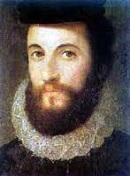



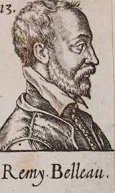

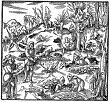
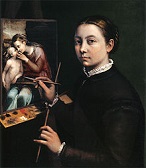
1556 On Jan. 22 Polish theology student Peter Gonesius (Piotr of Goniadz) (1525-73) gives a speech against the doctrine of the Trinity at a gen. synod of Calvinist (Reformed) churches in Secemin, Poland, causing him to be excommunicated by the Council of Pinczow in Apr. and banished from Lesser Poland, gaining protection in 1558 from Jan Kiszka (1552-92) and becoming head of the Protestant commune in Wegrow, causing a split in the Calvinist community, which Sigismund II Augustus attempts to heal with a debate called in 1565, which only hardens their division, causing the anti-Trinitarian Polish Brethren (Minor Reformed Church) to hold their own synod in Brzeziny on June 10, 1565; too bad, it is dissolved on July 20, 1658 with their expulsion from Poland, emigrating the Prussia, Transylvania, and the Netherlands. On Jan. 23 (a.m.) the 1556 Shaanxi Earthquake in Shensi (Shaanxi) Province in Ming China kills 830K, becoming the worst earthquake on record (until ?). India becomes the center of the Earth? On Jan. 27 Mughal emperor #2 (since 1530) Humayun (b. 1508) dies, and his son (grandson of Babar) Akbar (Akhbar) the Great (Jalaluddin Muhammad Akbar) (1542-1605) becomes Mughal (Mogul) emperor #3 of N India (until Oct. 27, 1605), a Muslim ruling a Buddhist nation from the city of Agra S of the Himalayas, going on to extend the empire S to the Deccan while fostering the arts, architecture, and poetry, and trying unsuccessfully to establish a syncretistic court religion bringing the different religions of India together, sponsoring open court debates between followers of all religions and encouraging free speech and expression; he sends an expedition to find the source of the Ganges River, and receives report of a paradise called Shambala (Shangri-La) (Gyanganj) N of the Himalayas. On Feb. 5 after Guise rival Anne de Montmorency (1493-1567), constable of France arranges it, Henri II of France and Philip II of Spain sign the Treaty (Truce) of Vaucelles with Spain, frustrating Guise plans in Italy. So be honest with yourself, don't try to fake romance, it's the good life to be free and explore the unknown? Maybe this is where all those jokes about women on the rag come from? On Mar. 21 despite publicly recanting Protestantism to save himself, giving her a propaganda coup, Bloody Mary goes overboard and orders Archbishop Thomas Cranmer (b. 1489) burned anyway, but he turns her propaganda coup on its ear by publicly repudiating his recantations, uttering the immortal soundbyte: "And as for the Pope, I refuse him, as Christ's enemy and Antichrist, with all his false doctrine", and then holding his right hand that had signed them exposed to the flames, letting it burn to a crisp before the flames reach his body, while repeating the words "this unworthy right hand" a holy bird flip?); on Mar. 22 Cardinal Reginald Pole (1500-58) becomes the last Roman Catholic archbishop of Canterbury and papal legate (until 1558), getting imprisoned next year by Pope Paul IV in Castel Sant'Angelo on suspicion of being a Lutheran; meanwhile the Protestant persecution in England reaches its peak in Mar., with 300+ burned at the pole. In summer after Martin Guerre (1524-) disappeared in 1548, leaving his wife Bertrande and son without a trace, a man arrives in Artigat who claims to be him, living with her for three years and having two more children until the villagers grow suspicious, getting him tried in Rieux in 1560, and after several witnesses ID him as Arnaud "Pansette" du Tilh from the nearby village of Tilh, he is convicted and sentenced to beheading, and he almost convinces the parlement of Toulouse of his innocence until the real Martin shows up complete with wooden leg from the Aug. 10, 1557 Battle of St. Quentin, after which he is hanged on Sept. 16, 1550 in front of Guerre's house. On July 14 after Queen Catherine de' Medici sends for Nostradamus (1503-66), he leaves Salon for Paris, using horses posted for him by the queen to cut the travel time from two mo. to one; he arrives on Aug. 15, and has a 2-hour audience with her on July 15, followed by a brief audience with skeptical Henri II; he spends two weeks in residence at the palace of the archbishop of Sens seeking his guidance, then returns for a 2nd audience with his fan the queen, and draws up horoscopes for her seven children using a magic mirror, assuring her that all her sons will be kings; fleeing the Justices of Paris, who suspect him of magic practices, he returns to Salon, and spends the rest of his life finishing his Centuries and casting horoscopes. On July 31 Jesuit Order (Society of Jesus) founder (St.) Ignatius of Loyola (b. 1491) dies in Rome; the order is established in Prague; by now it has about 1K members worldwide - bon appetit? On Aug. 27 after his brother Ferdinand I's work at Augsburg restores good relations, which had grown icy after he designated the imperial crown for his Valladolid-born Hapsburg son Philip II (the Prudent) (1527-98) instead of him on Jan. 16, gout-suffering HRE Charles V (Charles I of Spain) gets religion and officially abdicates at Brussels, designating Ferdinand I as king of Germany (reserving his title of HRE until 1558) and Philip II as "Most Catholic King" of Spain (until Sept. 13, 1598), although his "advice" remains a command; under Philip II Spain reaches the height of its grate wealth and powah, entering its Golden Age as "the empire on which the Sun never sets", although Spain declares bankruptcy in 1557, 1560, 1569, 1575, and 1596, allowing the Dutch Repub. to declare independence in 1581; the war with France continues; Charles V retires to a luxurious life in the monastery of Yuste N of the Tagus Valley as a private individual not a monk, with 150 attendants (who are forever busy digging up fishy delicacies for his table), giving official control of the Hapsburg lands to Ferdinand I, while Philip II gets Spain, its overseas colonies, the Spanish islands in the Mediterranean (incl. Sicily), the Italian possessions (incl. Naples, Milan), Franche-Comte, and the Netherlands, causing speculation that there will be a winner-take-all war later; daddy "advises" Philip II to be "cutting out the root of heresy with rigor and rude chastisement", causing him to order the duke of Alva to give up his attacks on the Papal States in the Italian campaign so he can go toast some Dutch butt; Philip II speaks only Spanish but now rules the Netherlands along with his 2nd wife Bloody Mary Tudor of England, and reenacts Charles V's Edict of 1550, beginning "the longest, the darkest, the bloodiest, the most important episode in the history of the religious reformation in Europe"; he appoints inquisitor-gens. who send out a dozen inquisition officers throughout the Netherlands (Peter Titelmann et al.) to arrest people and burn them at the stake for offenses incl. reading the Bible, joking as they writhe in the flames; meanwhile during his reign Spain enters its Golden Age, reaching the height of its grate wealth and powah, becoming known as "the empire on which the Sun never sets" - yes I've seen it before, just little bits of history repeating? In Sept. the duke of Alva is ordered to move against Rome to stop persecution of the pro-Spanish clique by Pope Paul IV. In fall Richard Chancellor returns from Russia with Osep (Osip) (Joseph) Nepeja (Nepeya), the first Russian ambassador to England; too bad, on Nov. 7 Chancellor dies in a wreck at Pitslago off the coast of Scotland, but the ambassador makes it to London. In Oct. Lautaro and his reduced force move N to the Mataquito River, are attacked by the Spanish, and retreat S to the Itara River, planning a sneak attack of Santiago; too bad, a traitor tips the Spanish off. In Nov. Francois de Lorraine, 2nd Duc de Guise crosses the Alps with his army and marches on Naples, but the pope reneges on promised support, causing him to be forced back but remain in Italy; meanwhile the duke of Alva marches to the outskirts of Rome. The Spanish finish conquering Venezuela. Ivan IV the Terrible conquers the Tartar khanate of Astrakhan, bringing the Volga River within Russia's borders; the last khanate, the Crimea holds out until 1783. Under the pressure of Suleyman I the Magnificent, the Transylvanian Diet recalls John II and his mother Isabel, splitting it off from Hungary again; Ferdinand I refuses to recognize them. Johan Vasa (b. 1537) (future John III of Sweden) becomes duke of Finland. Tobacco is introduced into France by Andre Thevet, a monk from Angouleme. Father Gaspar Da Cruz becomes the first Roman Catholic missionary in China; in 1560 after returning he pub. the first description of tea in Portuguese": "A drink called ch'a, which is somewhat bitter, red, and medicinal". London trader William Towerson leaves with a fleet from Plymouth for Africa, where he becomes the 2nd Englishman to bring back African slaves next year. The handwritten montly Notizie Scritte, one of the first newspapers begins pub. in Venice. Italian scholar Lodovico Castelvetro (1505-71) translates Aristotle, and begins demanding that Aristotelian principles be applied to Italian drama, getting a tight version of his Three Unities adopted; too bad, he gets caught translating Protestant texts, is labeled a heretic, and exiled next year. Architecture: Suleiman I's Mosque in Constantinople (begun 1550) is completed. Nicholas Brigham (-1558) builds Geoffrey Chaucer's Tomb in Westminster Abbey, founding Poet's Corner; next is Edmund Spenser in 1599. Art: Sophonisba Anguissola (1532-1625), Self-Portrait; in 1559 she becomes tutor to Spanish queen Elizabeth of Valois in Madrid, going on to become official court painter to Philip II, helping open the painting profession to women. Nonfiction: Georgius Agricola (Georg Bauer) (1494-1555), De Re Metallica (On the Nature of Metals); first comprehensive treatise on mineralogy, founding the study of physical geology, and used as the std. textbook for the next 250 years; by an Italian-trained physician from Saxony who settled in Joachimsthal, Bohemia in 1527 and began a lifelong study, ending up with the #1 book on mining from A-Z, incl. miners diseases; later tr. into English by U.S. pres. Herbert Hoover. Daniele Barbaro (1514-70) (tr.), Vitruvius' Ten Books of Architecture; improved trans., incl. an extensive commentary, making a fan of El Greco (Domenikos Theotokopoulos (1541-1614), who criticizes Vitruvius' technique of distorting proportions in order to compensate for distance from the eye, with the soundbyte: "I would not be happy to see a beautiful, well-proportioned woman, no matter from which point of view, however extravagant, not only lose her beauty in order to, I would say, increase in size according to the law of vision, but no longer appear beautiful, and, in fact, become monstrous." French composer Philibert Jambe de Fer, Epitome Musical, des Tons, Sons, et Accordz... Violes & Violons; contains the first mention of the violin and cello. Martin de Azpilcueta Navarrus (1493-1586), Manual on Moral Theology; first to state clearly that govt. price-fixing won't work? Poetry: Remy Belleau (1528-77), Les Petites Inventions; inspired by ancient Greek lyric poet Anacreon and launching his style of paradoxical poems of praise for simple things incl. butterflies, cherries, coral, oysters, shadows, and turtles. Music: Juan de Avila (1499-1569), Audi Filia. Orlando di Lasso (1532-94), First Book of Motets; "Motet: a contrapuntal, polyphonic unaccompanied sacred song". Births: German musical historian, composer, chronologer-astronomer Sethus Calvisius (Setho Calvisio) (Seth Kalwitz) (d. 1615) on Feb. 21 in Gorsleben, Thuringia. English poet-dramatist George Peele (d. 1596) on July 22; baptized on July 25. Spanish priest (founder of the Piarists) (St.) Joseph Calasanctius (Calasanz) (d. 1648) on Sept. 11 in Calasanza Castle (near Petralta de la Sal), Aragon; feast day: Aug. 27. French cardinal-theologian-diplomat Jacques Davy Duperron (d. 1618) on Nov. 15 (Nov. 25 Old Style) in St-Lo, Normandy; born of Calvinist parents, he studies St. Augustine and St. Thomas Aquinas and converts to Roman Catholicism in 1577-8, then is created cardinal in 1604 after defeating Calvinists in a public debate and becoming their poster boy. French architect Jacques II Androuet du Cerceau (d. 1614). English miniature painter Isaac Oliver (Olivier) (d. 1617) (1565?) in Rouen, France; French Huguenot parents; emigrates to England in 1568; husband of the daughter of Marcus Gheeraerts the Elder; father of Peter Oliver. Dutch Later Mannerist sculptor Adriaen de Vries (d. 1626) in The Hague. Italian-Swiss Baroque architect Carlo Maderno (Maderna) (d. 1629) in Capolago (modern-day Ticino, Switzerland); brother of Stefano Maderno (1576-1636)? Deaths: Italian-born Russian Greek Orthodox monk Maxim Grek (b. 1470). English Protestant archbishop of Canterbury (1533-55) Thomas Cranmer (b. 1489) on Mar. 21 (burned at the stake); the Catholics spread rumors that he kept his 2nd wife Margaret concealed in a box when traveling, with the soundbyte "He kept his woman very close, and sometimes carried her about with him in a great chest full of holes, that his pretty nobsey might take breath at." Italian painter Lorenzo Lotto (b. 1480). German composer Martin Agricola (b. 1486) on June 10 in Magdeburg. Spanish mystic and Jesuit Order founder Ignatius Loyola (b. 1491) on July 31 in Rome. Italian author Pietro Aretino (b. 1492) on Oct. 21; "He is said to have died of suffocation from laughing too much". Italian painter Pontormo (b. 1494). Italian poet Luigi Alamanni (b. 1495) on Apr. 18 in Amboise. English merchant-financier Sir John Gresham (b. 1495) on Oct. 23. Dutch Anabaptist leader David Joris (b. 1501) in Basel; wrote 200+ works; since 1544 lived under the alias of Jan van Brugge, pretending to be a member of the Reformed Church; in 1559 he is found out, his remains exhumed and burned by church officials for heresy. English author-dramatist Nicholas Udall (b. 1504). Indian Mughal emperor #2 (1530-40) Humayun (b. 1508) on Feb. 22 (Old Style) in Delhi. Spanish conquistador Domingo Martinez de Irala (b. 1509) in Paraguay. Ottoman Persian-Turkish poet Mehmed Fuzuli (b. ?); leaves the poem Leyl and Majnum on Platonic love.



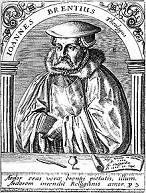

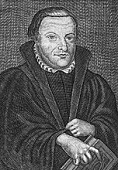
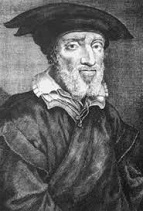

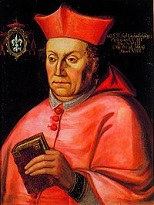
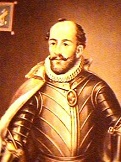






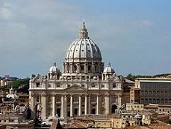
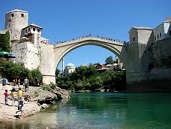
1557 This year there is an influenza epidemic throughout Europe. The Double Default of 1557 sees the Spanish and the French default on their debts. On Mar. 30 Andres Hurtado de Mendoza (Andrés Hurtado de Mendoza, 3rd Marquis of Cañete) (1495-61) becomes viceroy #5 of Peru (until Mar. 30, 1561), finally establishing Spanish authority, while his son Garcia Hurtado de Mendoza (1535-1609) resumes the Spanish conquest of Chile, with special permission to enslave rebel Indians, and goes after Lautaro. You're a carousel, you're a wishing well? In Mar. Philip II returns to England, gives Queen Mary a "second honeymoon", and persuades her to enter the war against pesky France; he also tries unsuccessfully to persuade Princess Elizabeth to marry his protege Duke Emmanuel Philibert of Savoy; in July Philip II leaves England and Queen Mary forever, hoping to return after his Spanish Armada kicks Protestant butt; meanwhile an English messenger is sent to France to deliver a declaration of war to Henry II. On Apr. 29 the Spanish stage a surprise attack on Lautaro (b. 1534) from the Caune Hills and kill him. Oh the games people play now, every night and every day now? In May Anne de Montmorency, constable of France orders the duke of Guise to leave Italy and return to France to face the Spanish buildup in the Netherlands, but he procrastinates in hopes of beating the duke of Alva. On June 11 king (since 1521) Joao III the Pious (b. 1502) dies, and his 3-y.-o. grandson Sebastian (Sabastiao) I (the Desired) (1554-78), son of Prince John Manuel and Joanna of Austria, and grandson of John III and HRE Charles V becomes Avis king #16 (next-to-last) of Portugal (until Aug. 4, 1578) - at least the port's still good? You say poh-tay-toe, I say poh-tah-toe, let's call the whole thing off? On Aug. 10- (Feast of St. Lawrence)-Aug. 27 the Battle of St. Quentin (Saint-Quentin) sees Saint-Quentin in Picardy taken from the French by a 60K-80K-man Spanish Hapbsburg army under the duke of Alva supported by Mary I's English under Duke Emmanuel Philibert of Savoy, becoming a costly D for ambitious Valois king Charles V, who loses 3K KIA, 14K-15K injured, and 7K taken POW; Constable Anne of Montmorency is taken POW; "The sight of the battlefield gave Philip a permanent distaste for war", withdrawing to the Spanish Netherlands; both the Spanish and French crowns declare bankruptcy; too late, in Oct. the duke of Guise rushes back to France and is appointed lt-gen. On Sept. 11-Oct. 8 the Colloquy of Worms between Protestant Lutheran theologians Philip Melanchthon (1497-1560), Johannes (Johann) Brenz (1499-1570), Theodore Beza (1519-1605), and Erhard Schnepf (1495-1558), and Roman Catholic theologians Michael Helding (1506-61) (AKA Sidonius), Jesuit (St.) Peter Canisius (1521-97), and Johannes (Johann) (John) Gropper (1503-59) (who started out as a follower of Erasmus then couldn't give up the security of the Church and the problem that if God meant Christians to be Protestants, why did he let the Church run things all this time), the last imperial conference of the cent. starts out with the Catholics questioning the Bible as the only source of authority, and ends when they bring up the Protestants' dirty laundry of disagreements among themselves about basic doctrines of original sin and justification based on Bible reading; Beza suggests that all Protestant sects unite, and is told to fork off by Zurich and Bern, causing him to settle in Geneva next year. On Sept. 27 emperor (since 1526) Go-Nara (b. 1497) dies, and on Oct. 27 his eldest son Ogimachi (1517-93) (personal name Michihito) becomes Japanese Yamato emperor #106 (until Dec. 17, 1586). In Dec. the First Covenant (Congregation of the Lord) is signed in Scotland, creating the Protestant Lords of the Congregation (Faithful Congregtion of Christ Jesus in Scotland), pledged to maintain Presbyterian as Scotland's sole religion and later establishing the supremacy of Parliament over the crown in Scotland, becoming the "First Blast of the Trumpet". After agreeing to pay 550 taels/year of silver (1 tael = 41.6 lbs.), the Portuguese colonize the Chinese seaport of Macau (Macao), which they hold until 1999. The Ottomans capture the ports of Suakin and Massawa (Mitsiwa, Batsi) on the African shores of the Red Sea, allowing them to resume trade through Egypt; they found the province of Habesh (Abyssinia), governed from Massawa. The Burmese destroy the N Thai state of Chiengmai (Chiang Mai) after it is weakened by Siam. The Spanish begin mining silver in Potosi (Potosí), Bolivia at the foot of Cerro Rico (Sp. "rich mountain"), becoming Spain's major silver supply. The title of surgeon is first recorded in the British navy. The Stationers' Co. of London (founded 1403) is granted a royal charter with a printing monopoly in England. Gonville College in Cambridge (founded in 1348 by Edmund Gonville) is refounded as Gonville and Caius College by John Caius (Kays) (1510-73) (pr. like keys), royal physician to Edward VI, Mary I, and Elizabeth I. Repton School for boys is founded in Derbyshire, England. Architecture: After succeeding Antonio da Sangallo the Younger as the architect of St. Peter's Basilica (begun Apr. 18, 1506) in 1547, and transforming the plan to finish the W end and dome to his design, Michelangelo gets pissed-off at his builders when a portion of it has to be dismantled and redone because of an erroneous calculation, writing that it's all their fault, "As the model, such as I make for everything, was exact"; it is not completed until Nov. 18, 1626. The Stari Most (Old Bridge) in Mostar ("bridgekeeper"), Herzegovina over the Neretva River is begun by Suleiman the Magnificent; it is finished in 1567; too bad, on Nov. 9, 1993 it is destroyed during the Bosnia-Herzegovina War, and reopens on July 23, 2004. Inventions: Sevillean merchant Bartolome de Medina invents the Patio Ore Reduction Process for the rich silver mines of Pachuca in Hidalgo, Mexico (55 mi. NE of Mexico City), which were worked before the Spanish conquest. Inventions: French Huguenot potter Bernard Palissy (1510-89) invents Enamel after 16 years spent trying to imitate Chinese porcelain, causing imitators to begin cranking out Palissy Ware, featuring molds of real creatures incl. fish and crabs. Science: The one year that English math and poetry go hand-in-hand? Italian scholar-physician Julius Caesar Scaliger (1484-1558) discovers the metallic element Platinum (pt) (#78) Jean Pena, royal mathematician at Paris rejects the spheres of fire and of the planets after determining by optical reasoning that some comets are beyond the Moon. Nonfiction: Robert Recorde (1510-58), The Whetstone of Witte; introduces the = (equals) symbol into mathematics. Julius Caesar Scaliger (1484-1558), Exercitationum Exotericarum Liber XV de Subtilitate ad Hieronymum Cardanum - dirty deeds done dirt what? Hans Staden, The New World; titillates Euros with depictions of cannibalism by the Tupinamba (Tupinambá) tribe of Brazil. Thomas Tusser, A Hundreth Good Pointes of Husbandrie. William Whittingham (1524-79), Myles Coverdale (1488-1569) et al., The Geneva Bible (London) (1557-60); an inexpensive portable English Bible with extensive Calvinist-slanted "annotations upon all the hard places" (marginal glosses), which piss-off Anglican prelates, who associate it with Presbyterians, who wish to abolish the Episcopalian form of govt. by bishops and replace it with govt. by lay elders; it's also furnished with instructional aids, becoming the first study Bible, and the first using verse numbering by Robert Estienne (Stephanus) of Paris; dedicated to Queen Elizabeth I, it is often used and/or quoted by John Knox, John Bunyan, John Donne, Oliver Cromwell, and Shakespeare, and later preferred by Puritans over the King James Bible, dissing the divine right of kings and always translating the word king as tyrant, causing Charles I to ban it in 1644, leading to Puritan takeover of the govt. and his beheading, even though they later realize the superiority of the 1611 KJV. Plays: ?, The Sack-Full of Newes; first English play to be censored? Poetry: Sir Thomas Wyatt (1503-42), Certain Bokes of Virgiles Aenaeis turned into English Meter; tr. of books 2-3 of Vergil's "Aeneid" in blank verse of five iambic feet, becoming the first use of this form in English. Richard Tottel (-1594) (ed.), Songs and Sonnets written by the Ryght Honorable Lorde Henry Howard late Earle of Surrey, and Other (Tottel's Miscellany); the first anthology of English poetry, and the first pub. of the poetry of Sir Thomas Wyatt (1503-42) and Henry Howard, Earl of Surrey (1517-47), introducing the English 14-line sonnet (based on Italian models); Wyatt uses the Italian or Petrarchan sonnet form (abba, abba, cdc, dee), while Howard invents the English or Shakespearean form of three quatrains (abab, cdcd, efef) and a couplet (gg); later Sir Edmund Spencer invents his own form (abab, bcbc, cdcd, ee). Births: Transylvanian prince (1604-6) Stephen Bocskai (Istvan Bocskay) (d. 1606) on Jan. 1 in Kolozsvar (Cluj-Napoca). Bohemian Hapsburg king (1611-9) and HRE (1612-9) Matthias (d. 1619) on Feb. 24 in Vienna; son of HRE Maximilian II (1527-76) and Maria of Spain (1526-1603); husband of archduchess Anna of Austria. Russian tsar (1584-98) Fyodor (Theodore) ("divine gift") I (the Bellringer) (d. 1598) on May 31 in Moscow; son of Ivan IV the Terrible (1530-84). English soldier (martyr) Philip Howard, 20th (13th) Earl of Arundel (d. 1595) on June 28 in Strand, London; eldest son of Thomas Howard, 4th duke of Norfolk (1536-72) and Lady Mary FitzAlan; first Howard to become an earl of Arundel. Italian painter Agostino Carracci (Caracci) (d. 1602) on Aug. 16 in Bologna; father of Antonio Marziale Carracci (1583-1618). English poet Thomas Watson (d. 1592) in London; educated at Winchester College, and Oxford U. English composer-theorist Thomas Morley (d. 1603). Italian Venetian School composer Giovanni Gabrielli (Gabrieli) (d. 1612) in Venice; son of Andrea Gabrieli (1520-86). Deaths: Italian-born English historian Polydore Virgil (b. 1470) in Urbino, Italy. Italian explorer Sebastian Cabot (b. 1476) in Dec. Spanish historian Gonzalo Fernandez de Oviedo y Valdes (b. 1478); leaves Las Quinquagenas de la Nobleza de Espana, a collection of anecdotes about contemporaries, pub. in 1880. Italian author Giovanni Francesco Straparola (b. 1480). Italian geographer Giambattista Ramusio (b. 1485) on July 10 in Padua. Spanish cardinal Juan Alvarez de Toledo (b. 1488) on Sept. 15. Scottish stud Archibald Douglas, 6th earl of Angus (b. 1489). Spanish conquistador Alvar Nunez Cabeza de Vaca (b. 1490). French explorer Jacques Cartier (b. 1491) on Sept. 1 in St. Malo. Italian scholar Niccolo Tartaglia (b. 1500) on Dec. 13. Portuguese king (1521-57) Joao III the Pious (b. 1502) on June 11 in Ribeira Palace, Lisbon. Italian condottiero Ferrante I Gonzaga (b. 1507) on Nov. 15 near Brussels; dies after falling from his horse from fatigue after the Battle of St. Quentin. Lutheran theologian (bishop of Turku) Michael Agricola (b. 1510) on Apr. 9; dies on a return trip from Moscow to arbitrate boundary disputes between Russia and Sweden. English Greek scholar Sir John Cheke (b. 1514) on Sept. 13 in London. German-born English queen (1540) Anne of Cleves (b. 1515) on July 16 in Hever, Kent. German margrave of Brandenburg-Kulmbach (1527-53) Albert II Alcibiades (b. 1522) on Jan. 8 in Pforzheim; dies during a campaign to regain his lands; gains the cognomen Alcibiades posth.; "A failure of a Fritz", with "features" of Frederick the Great, "but who burnt away his splendid qualities as a mere temporary shrine for the able editors, and never came to anything, full of fire, too much of it wildfire, not in the least like an Alcibiades except in the change of fortune he underwent" (Thomas Carlyle). Chilean rebel leader Lautaro (b. 1534) on Apr. 30 in Maule. Scottish Protestant theologian John MacAlpine (Maccabeus) (b. ?) on Dec. 6 in Cophenhagen, Denmark; trans. Martin Luther's German Bible into Dutch.







1558 On Jan. 7 the duke of Guise captures Calais from the English, leaving them with ixnay in France - time to put on your thinking cap with the row of nuts and bolts? On Feb. 2 the U. of Jena in Thuringia is chartered by HRE Ferdinand I after deceased Saxon elector John Frederick I the Magnanimous (who originally wanted to put it in Wittenberg) planned it out during his imprisonment and his three sons carry out his will; it goes on to produce German brain men Gottlieb Fichte, Georg Wilhelm Friedrich Hegel, Friedrich Schelling, and Friedrich Schiller; it is renamed for Schiller in 1934. In Mar. HRE Charles V (b. 1500) formally abdicates at the Monastery of Yuste in Spain, then dies on Sept. 21; he recognizes his illegitimate son Don Juan of Austria (b. 1547) in his will, and entrusts him to the care of Philip II, who grants him the rank of a prince of the House of Austria with a residence in Madrid next year; on Mar. 15 handsome goateed Ferdinand I (1503-64) is crowned HRE in Frankfurt (until July 25, 1564), working to effect a Roman Catholic-Protestant reunion, which ultimately flops because of his insistence that bishops retain their secular authority. On Apr. 11 15-y.-o. Mary Stuart, Queen of Scots (niece of the Duke of Guise) is formally betrothed to 14-y.-o. dauphin Francis II (b. 1544), son of Henry II of France, her childhood playmate, causing public rejoicing in Paris; the official marriage contract reaffirms the Auld Alliance, incl. dual nationality for Scots and French; if Mary dies the succession is given to the Earl of Arran, but by a secret treaty signed by the ditzy teen queen, if she dies without issue it goes to Francis, which is later found out, pissing-off the Scottish parliament; on Apr. 24 they are married at Notre Dame Cathedral, where she becomes the first bride to have a white wedding (the color of mourning); at the urging of Henry II, Mary quarters the arms of England in her new coat of arms; half of the Scottish commissioners die on the way back to Scotland; meanwhile Sir William Maitland of Lethington (1525-73) becomes Scottish secy. of state to queen regent Mary of Guise. On May 11 after Ivan the Terrible defeats the Livonian Knights (Brothers of the Sword), who place Livonia under Lithuanian protection, after which Poland, Russia, Sweden, and Denmark get in a dispute over succession and territory, starting the Livonian War (ends 1583); the Swedes take Estonia, and the Danes take part of Courland; Narva in modern-day Estonia is captured by the Russians, causing Ivangorod to become the main Russian seaport on the Baltic coast; Tartu in Estonia (pop. 6K) surrenders without a fight, and the bishop is imprisoned in Moscow, ending the bishopric in Estonia and adjacent states. On June 27 Nostradamus signs an Epistle to Henry II, which is used as the preface to the 3rd enlarged ed. of his "Centuries" (300 more quatrains), pub. in 1568. On July 13 the Spanish under the duke of Alva defeat the French at the Battle of Gravelines near Calais, causing them to finally cry oncle? One of the biggest turning points in history: The Red Queen is followed by a White Queen? On Nov. 17 (7:00 a.m.) after learning of the loss of Calais, English queen (since July 1553) Bloody Mary I Tudor (b. 1516) dies childless (she had a tumor not a child) (but just in case she's got a bun in the 42-y.-o. oven she leaves her child the throne in her will?), and after holding out until 10 days before her death to name her as heir, is succeeded by her witch-lucky Protestant half-sister Elizabeth I (1533-1603) (until Mar. 24, 1603) (last Tudor monarch); English Roman Catholics forever consider her to be an illegitimate bastard, while English Protestants forever consider her to be their Virgin Mother, saving them from becoming toast; she becomes the 3rd child of Henry VIII who considers it their right to dictate the religion of the nat. church; she promptly swings it back to Protestant, but calls it the "Middle Path" of Protestant doctrines and Roman Catholic ceremonies, robes, and trappings to please the crowd (a Catholic Protestantism?); at her coronation a ring is placed on the 4th finger of her right hand to symbolize her mystical marriage with her people; the exhilarating golden Elizabethan Age (Era) is launched (ends 1603), marked by nat. cultural renaissance, internat. expansion, and naval triumph; her minister Sir William Cecil soon manipulates her to get extreme Protestantism back with a vengeance; after defending his Roman Catholic beliefs, cardinal (since Aug. 7, 1587) William Allen (1532-94) is forced into exile, founding a seminary in the Spanish Netherlands to provide priests for the English; on Nov. 17 (7:00 p.m.) Cardinal Reginald Pole (b. 1500), archbishop of Canterbury since 1556 dies in London - Anglicanism = Roman Catholic Protestantism? The English Immaculate Conception? On Nov. 20 at Hatfield Elizabeth I names male supremacist Sir William Cecil (1520-98) (pr. SEHS-ul) (Baron Burleigh in 1571) as secy. of state (he thinks a woman can't run the country, but she proves him wrong?), and Sir Nicholas Bacon (1510-79) (later the foster father of Sir Francis Bacon) as lord keeper of the Great Seal (lord privy seal). On Nov. 23 Elizabeth I leaves Hatfield with 1K courtiers and travels trimphantly through Hertfordshire and Middlexex to London for her official reception; at the city walls of London she is greeted amid cheering throngs by the Lord Mayor, but snubs Edmund "Bloody" Bonner, bishop of London, who had been responsible for Mary's burning of Protestants, and after he refuses to take the oath of supremacy removes him from office and locks him in the Tower until death (1569); she moves into royal apts. in the Tower of London on Nov. 28, pausing to express gratitude for not being executed there earlier; on Dec. 23 she moves to Whitehall Palace, her favorite residence. On Dec. 13 the Battle of Quiapo in Arauco Province, Chile is another V for 200 Spaniards under Garcia Hurtado de Mendoza over 7K-8K Mapuchi under chief (toqui) Lemucaguin or Caupolican (Caupolicán) the Younger. On Dec. 14 Queen Mary is buried in Westminster Abbey with traditional Roman Catholic ritual - did they burn incense? On Dec. 25 Elizabeth I celebrates Christmas Mass in her chapel in Whitehall Palace; as no Roman Catholic bishop will help her, Bishop of Carlile (since 1557) Owen Oglethorpe (-1559) celebrates it, but when he begins elevating the host, Elizabeth orders him to desist, and when he refuses, walks out? On Dec. 27 Elizabeth I issues a proclamation declaring that parts of the Mass may be said in English rather than Latin, and forbidding all preaching until further notice. After the accession of Elizabeth I, Puritanism, a movement inside the Anglican Church that disses all Roman Catholic trappings esp. ritual and ceremony has its beginnings in England. 90-y.-o. imperial adm. Andrea Dora begins fighting the French in Corsica (until 1560). Philip II sends Don Gomez Suarez de Figueroa, Count de Feria to England as Spanish ambassador, exploring a possible marriage proposal to Elizabeth; meanwhile Philip II's mistreatment of the Netherlands reaches a head, causing them to go into revolt. Thomas Gresham calls for a reform of English currency after noting that Henry VIII's debasement of it has lowered its value in relation to the currency of other countries, formulating Gresham's Law that "bad money drives out good"; the queen knights him for it next year. Tobacco is brought from America to Spain for cultivation for the first time by physician Francisco Fernandes after being sent by Philip II to report on its products; the Portuguese soon introduce the delights of snuff to Europe. Anthony Jenkinson travels to Bokhara. Italian sculptor Benvenuto Cellini (1500-71) becomes a Roman Catholic priest (should we say a crafty priest?), despite having a mistress (Piera) and two children (Constanza, Jacopo Giovanni), plus another which died during infancy; he is released from his vows in 1560 to marry her, and go on to have more children (Giovanni, Elisabetta, Lipterata) before getting legally married in 1564. The Hamburg Stock Exchange in Germany is founded. Architecture: Suleymaniye Mosque (begun 1550) is finished; Sultan Suleiman the Magnificent and his wife Roxelana are later buried in the cemetery behind it in tombs built by Mimar Sinan. Nonfiction: John Knox (1505-72), The First Blaste of the Trumpet Against the Monstrous Regiment of Women (Geneva); quotes the Bible to diss govt. by women; directed chiefly against Mary of Guise and her daughter Mary Stuart, Queen of Scots, but even Elizabeth is implied?; "I am assured that God hath revealed to some in this our age that it is more than a monster in nature that a woman should reign and bear empire over man" - God gave men testicles for a reason? Giambattista della Porta (1535-1615), Magia Naturalis (Natural Magic) (20 vols.) (1558-70); "Wherein are set forth all the riches and delights of the Natural Sciences"; explains the difference between magical and physical events such as magnetism, and shows how to put a convex lens inside the aperture of a camera obscura to brighten the projected image, making it more popular. Gioseffo Zarlino (1517-90), Institutioni Harmoniche; defines most major and minor musical scales. The 13th cent. Qabbalistic work Zohar is printed. Art: Pieter Brueghel the Elder (1522-69), Children's Games. Titian (1477-1576), Diana and Actaeon; Europa on the Bull; Actaeon Torn to Pieces by His Dogs. Daniele da Voltera, Massacre of the Innocents. Poetry: Margaret of Navarre (1492-1549), Heptameron des Nouvelles (posth.). Births: English "The Spanish Tragedy", "Edward III" dramatist Thomas Kyd (d. 1594) on Nov. 3 in London; baptized on Nov. 6. English poet-dramatist-pamphleteer Robert Greene (d. 1592) in Norwich; educated at St. John's College, Cambridge U. - our house, just one sip and you'll be sold? English dramatist George Peele (d. 1598). Wallachian prince Michael the Brave (d. 1601). English Gunpowder Plotter Thomas Percy (d. 1605); educated at Cambridge U. Italian composer Giovanni Gabrieli (d. 1613). English poet-dramatist Thomas Lodge (d. 1625) in West Ham, Lincolnshire; educated at Trinity College, Oxford U. Dutch explorer Olivier van Noort (d. 1627) in Utrecht. Japanese artist (founder of the Rinpa School) Hon'ami Koetsu (d. 1637). Deaths: Italian scholar Julius Caesar Scaliger (b. 1484) on Oct. 21 in Agen, France. German Protestant leader Johannes Bugenhagen (Doktor Pomeranus) (b. 1485) on Apr. 20 in Wittenberg, Saxony. Portuguese poet Francisco de Sade Miranda (b. 1485); leaves the plays Comedia dos Estrangeiros, Comedia dos Vilhapandos, and Cleopatra. German Lutheran theologian Erhard Schnepf (b. 1495) on Nov. 1 in Jena. French physician Jean Francois Fernel (b. 1497) in Fontainebeleau. Spanish king (1516-56) and HRE (1519-56) Charles V (b. 1500) on Sept. 21 in Yuste, Spain. English archbishop of Canterbury (1556-8) cardinal Reginald Pole (b. 1500) on Nov. 17 in London. English ambassador Sir Philip Hoby (b. 1505) on May 31 in Blackfriars, London. English mathematician Robert Recorde (b. 1510). English queen (1553-8) "Bloody" Mary I Tudor (b. 1516) on Nov. 17 in St. James's Palace, London; buried in Westminster Abbey on Dec. 14. English scholar Nicholas Brigham (b. ?).




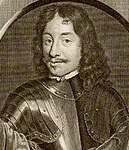








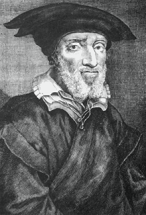






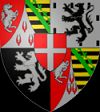
1559 On Jan. 1 Christian III (b. 1503) dies, and after Christian II (b. 1481) obligingly dies on Jan. 25, Christian III's son Frederick II (1534-88) succeeds him as king of Denmark and Norway (until Apr. 5, 1588), going on to become a typical Euro Renaissance monarch who likes to play soldier. The original L.A. woman? On Jan. 15 to large cheering crowds "Virgin Queen" Elizabeth I (1533-1603) is crowned queen of England in Westminster Abbey (until Mar. 24, 1603) (the 43rd British monarch), the last of the Tudor Dynasty, immediately reverting to Protestantism; at the coronation a ring is placed on the 4th finger of her left (right?) hand to symbolize her mystical marriage with her people; her childhood friend Sir Robert Dudley (1533-88) becomes master of the horse (the original Italian Stallion?), riding immediately behind her in procession, and becomes her favorite, causing marriage rumors to spread; on Jan. 15 Henry II of France publicly declares her a bastard unfit to be queen of England, and proclaims his daughter-in-law Mary Stuart (the French spelling of Stewart), Queen of Scots (great-niece of Henry VIII) as the true queen; Miles Coverdale returns to England; the exhilarating Elizabethan Age (Era) is launched (ends 1603), marked by nat. cultural renaissance, internat. expansion, and naval triumph; her minister Sir William Cecil soon manipulates her to get extreme Protestantism back with a vengeance. In Jan. Elizabeth I's First Parliament (with a Protestant majority) meets, and on Feb. 9 it debates a Commons bill to restore royal supremacy over the Church of England, but throws it out, and on Mar. 18 an amended bill calling the queen the Supreme Governor (instead of Supreme Head, which St. Paul says no woman is "suffered" to be in 1 Tim. 2:12) passes the Commons, causing grumbling among clergy and laity that leads to the Elizabethan Puritan Movement, which starts out underground and begins agitating in Parliament, becoming a serious threat to the state. On Feb. 15 Pope Paul IV issues the bull Cum ex Apostolatus Officio ("By virtue of the apostolic office"), proclaiming that only Roman Catholics can be elected pope, and that all rulers who maintain heretical doctrines may be deposed by the faithful - a clear signal to English Catholics? On Feb. 20 Count von Helfenstein, sent by HRE Ferdinand I arrives in England to explore a marriage between Elizabeth I and one of the emperor's two young sons, archdukes Ferdinand and Charles. On Apr. 3 Henry II of France makes peace with England and Spain by the Treaty (Peace) of Chateau-Cambresis (Chateau-Cambrésis), ending the Italian Wars and the Hapsburg-Valois catfight, and granting a V to Spain after 60 years of war, recognizing Spanish hegemony over Italy and Franche-Comte, and rectifying France's border with the Spanish Netherlands; England confirms French possession of Calais for the next eight years, after which it's supposed to be ceded back to England; France returns Savoy to Duke Emmanuel Philibert, victor of St. Quentin, who marries Henri II's Margaret of France, Duchess of Berry (1523-74) and does away with the Austrian and French factions, restores prosperity, proclaims a cool Savoy Coat of Arms, and works to regain more territory from the French and Spanish, esp. Turin; Henry II's support for the claim of his daughter-in-law Mary Stuart, queen of Scots to the throne of England is temporarily halted. On Apr. 23 (St. George's Day) Elizabeth I bestows the Order of the Garter on her beau Robert Dudley, along with the three senior peers of the realm, the duke of Norfolk (his rival), the marquess of Northampton, and the earl of Rutland, which only makes them jealous of this son and grandson of upstart traitors who's good at riding mares? On Apr. 29 Parliament passes the stringent First Act of Supremacy and Uniformity (2nd in 1662), making Protestantism the official religion of England, reinforcing the Book of Common Prayer, and making failure to attend church each Sunday a stiff 12-pence fine; 14 bishops are dismissed from their seas, leaving only the bishop of Llandaff in office; the Book of Common Prayer is revised again, and the Black Rubric disappears from the new Elizabethan Anglican Prayer Book, which is pub. in English and Latin, but not Gaelic, although the Bible is trans. into Welsh as a concession to her own Welsh roots; De Heretico Comburendo is repealed, hopefully for the last time; Edmund Grindal (1519-83) returns to London and succeeds Edmund "Bloody" Bonner as Anglican bishop of London; on Aug. 1 Cambridge U. vice-chancellor (favorite chaplain of Elizabeth I's mother Anne Boleyn) Matthew "Nosey" Parker (1504-75) (known for trying to dig up evidence that the English church was founded independently of the Roman) is elected archbishop of Canterbury, defending the church against encroachments by the crown; meanwhile, since only the bishop of Llandaff has not been dismissed over the Act of Uniformity, and he refuses to consecrate Parker, it takes until Dec. 19 for his coronation at Lambeth by ex-bishops William Barlow, John Scory, Miles Coverdale, and John Hodgkins, causing the Jesuits to later (1604) spread the Nag's Head Fable that he was consecrated in a tavern - with the Bible open at page 1? Come on in, the coast is clear? In Apr. after the Geneva congregation of English Protestant refugees returns to England, John Knox (1505-72), having pub. A Brief Exhortation to England (anti-Mary-Stuart propaganda), sails for Scotland, where he is ordained as a minister in the Kirk of Scotland at St. Giles Cathedral (High Kirk) in Edinburgh (until 1572), and soon wins Perth and St. Andrews to his cause; his Sermon at Perth starts the Protestant Reformation going in Scotland, and he founds the first Calvinist Presbyterian (Scottish Reformed) Church (Kirk), inciting the Protestant Lords of the Congregation to religious violence, with St. Giles as the nerve center of the ruckus for the next 130 years (until 1690); Mary of Guise is deposed as regent for encouraging the French fortification of her HQ at Leith Harbor across the Firth of Forth from Edinburgh, causing it to be seiged by the Protestants. In May Sir Nicholas Throckmorton (1515-71), who narrowly escaped conviction over Wyatt's Rebellion in 1554 and escaped to France, then was pardoned in 1557 becomes English ambassador to France (until Apr. 1564), playing both sides with Queen Mary and Princess Elizabeth, secretly aiding the Huguenots. On July 10 Henry II (b. 1519) dies after a freak jousting accident on June 30 with the Count of Montgomery, capt. of the Scottish Guard leaves a large wooden splinter from a lance lodged in his eye and brain during the festivities of the marriage of Philip II of Spain (his 3rd) to his daughter Princess Elisabeth (Elizabeth) of Valois (childhood friend of Mary, Queen of Scots, who grows up to become a top scholar), who was originally betrothed to Philip II's son Prince Don Carlos de Austria but switched as a result of the Treaty of Chateau-Cambresis; the Duke of Savoy also marries Henry II's sister; on his deathbed he repeatedly calls out for his mistress (since 1534) Diane de Poitiers (1499-1566), who is blocked by Queen Catherine de' Medici, causing her to slink off into obscurity; in Sept. sickly airhead Francis (Francois) II (1544-60) is crowned Valois king #11 of France in Rheims (until Dec. 5, 1560), making his dummy corporation wife Mary Stuart, Queen of Scots also queen of France; Catherine de' Medici becomes queen mother to the next three French kings; Mary Stuart also claims the throne of England through her grandmother Margaret Tudor, citing Elizabeth's alleged illegitimacy; jousting is discontinued in France; although both France and Scotland are swarming with pesky Calvinists, Francis II prefers to go hunting, while Mary's mother Mary de Guise is facing civil war in Scotland; Nostradamus' Century I, Quatrain 35 is rumored to have predicted Henry II's death, causing him to lie low and not pub. any more; Gaspard de Coligny resigns as adm. of the French fleet to join up with the Calvinists. On Aug. 15 after a Spanish treasure ship wrecks on Padre Island in 1554, causing New Spain viceroy Luis de Velasco to want a new settlement on the N Gulf Coast to protect shipping and rescue castaways, Tristan (Tristán) de Luna y Arellano (1519-71) lands at Pensacola Bay (westernmost point in the Fla. panhandle) with 1.4K people on 11 ships and founds a colony, becoming the first Euro settlement in the continental U.S.; too bad, nobody told them, a hurricane hits on Sept. 19, killing 200, sinking five ships, and destroying most of their ships and supplies, after which they sail up the Alabama River to an abandoned Indian village - and wait for Godzilla? On Aug. 18 Pope (since 1555) Paul IV (b. 1476), Father of the Roman Inquisition dies, and on Sept. 5 a papal conclave meets; on on Dec. 25 Milan-born lawyer (cardinal since 1549) Giovanni Angelo d'Medici is elected Pope (#224) Pius IV (1499-1565), immediately reversing some of the policies of his unpopular predecessor, esp. papal hostility to Spain, and reaching out to Philip II of France and HRE Ferdinand I, whom he officially recognizes - come on, say pucker? On Aug. 28 after leading the war in Fife, Scotland in Jan., causing reports that the Scottish rebels wish to make him king, the James Hamilton, 3rd Earl of Arran (1532-1609) secretly visits London, and on Aug. 29 meets with Elizabeth I at Hampton Court, then on Aug. 31 leaves with Thomas Randolph for Scotland to lead the rebel Protestant lords of the congregation against the govt. of queen regent Mary of Guise; her secy. of state Sir William Maitland joins them and goes on a mission to Elizabeth I to negotiate a union between the two countries; Elizabeth is not impressed with Arran enough to let him pursue a marriage alliance, and he later goes insane - blame it on papa roach? In Aug. HRE Philip II withdraws from the BBQ-basting Netherlands after appointing his able half-sister (Charles V's illegitimate daughter) Duchess Margaret of Parma (1522-86) as the Hapsburg gov. (regent) #3 of the Netherlands (until 1567), but gives her nominal authority so he can deal with the revolt himself; longtime imperial statesman (secy. of state since 1550) Antoine Perrenot de Granvelle (1517-86), bishop of Arras is appointed as her PM, going on to repress the pesky Dutch Protestants so cruelly over the next five years that he is elevated to archbishop and cardinal in 1561 before beating a hasty retreat in 1564. In Oct. the Duke of Savoy and his new bride visit Nostradamus in Salon. Suleyman's Selim defeats his brother Bayezid near Konya, causing Selim to be appointed royal heir; Bayezid flees to Persia and is executed at Suleyman's request - they're all bastards anyway? HRE Ferdinand I reorganizes the Aulic Council, and reforms the German monetary system. Philip II of Spain establishes the Roman Catholic U. of Douai (Douay) in Douai, N France; lectures begin in 1562; it goes on to become the 2nd largest univ. in France in the late 17th and 18th cents., becoming a main center of neo-Latin lit. along with math and physics esp. ballistics; it is closed in 1795-1808; in 1887 it is transferred 27 km. away, becoming the U. of Lille. The first French Protestant Nat. Huguenot Synod is held in Paris, attended by reps. of 15 churches, producing the Calvinistic French Confession; two years later 2K+ churches send reps. Spanish Capt. Pedro de Urzua (-1561) leads an expedition of Spanish soldiers from coastal Peru across the Andes to the Amazon Basin in search of El Dorado and its fabled goodly bricks of gold (ends 1561). Swiss naturalist Konrad von Gesner returns to Germany with tulip seeds from Turkey, and soon tulip growing becomes a W Europe fad. That program you wanted to see is on PBS tonight NOT? "The Church has always fulfilled its duty to keep books under surveillance, but until the invention of printing, it did not feel the need to compile a catalog of prohibited books because those writings considered dangerous were burned" (Enciclopedia Cattolica); now that the Devil's invention of the printing press is running amok, threatening the status quo, Pope Paul IV pub. the first Index Autorum et Librorum Prohibitorum AKA the infamous Index of Forbidden Books, used to retard any and every religious, scientific, social or political advance from here on out, going through 19 eds.; Roman Catholics are forbidden to read, sell, translate, or possess them under penalty of excommunication; the reading of vernacular translations of the Bible is prohibited; "In practice, Bible reading by laymen ceased completely for centuries. The Bible became virtually an unknown book, and millions of Italians lived their lives without ever reading a page of it" (Mario Cignoni); "All prohibited books contained in the brief shall be collected. Those by heretical authors shall be burned publicly in the auto da fe; the rest shall be placed in some well-secured room of the inquisition... As far as books in the humanities are concerned, which may contain glosses, arguments, letters, or annotations by Philipp Melanchthon or other heretics, they will be returned to their owners once the heretical annotations have been removed or crossed out... A book of medicine, entitled 'Paradoxas de Fusion', printed in Venice in 1547, is said to contain suspicious things even though it is not placed in the catalogue; it must be prohibited." (Decree of the Supreme on Books, 1558) When you have a yeast infection, get treated immediately, cheese it? Siena, Italy-born theologian Faustus Socinus (Faust Socyn) (Fausto Paolo Sozzini) (1539-1604) who picked up the crypto-Protestant Bible-based anti-Trinitarian views of his learned uncle Laelius Socinus (1525-62) (who picked them up from Michael Servetus?) is made a convenient example of by the Inquisition, causing him to flee from Italy for three years, returning to Florence in 1563 and keeping quiet, then getting brave and moving to Basel, where he develops his doctrinal system of Nontrinitarian (Arian) humanist Socinianism, an early form of Unitarianism, leaving for Poland in 1579, where he helps organize the Polish Brethren (Minor Reformed Church) (founded 1565), and later gets a movement going in Transylvania. Jesuit theologian Peter Canisius, fresh from his claimed V in the 1557 Colloquy of Worms becomes the main pulpit spokesman in Augsburg Cathedral (until 1567), where he convinces hundreds of Protestants to come back to Mother Church, while helping pump up the Jesuits into a powerful tool for the Counter-Reformation, getting him sainted. 15 headless strange men appear among the oats at harvest time in Marchia, Wales to warn of an approaching plague? Science: Italian anatomist Renaldus Columbus (Matteo Realdo Colombo) (1516-59) puts forward the idea of pulmonary blood circulation, and details experiments supporting it, incl. finding that the pulmonary vein contains blood not fumes like the Galenists claimed; describes the position and posture of the human embryo, and provides the first description of Ankylosing Spondylitis, which causes the vertebrae to fuse together; he claims to be the first anatomist to observe the clitoris, "seat of woman's delight", uttering the immortal soundbyte: "Since no one has discerned these projections and their workings, if it is permissible to give names to things discovered by me, it should be called the love or sweetness of Venus" - so we have to eat the box to get the fiber? Nonfiction: Renaldus Columbus (Matteo Realdo Colombo) (1516-59), De Re Anatomica. Matthias Flacius (1520-75) et al. (the Centuriators of Magdeburg, Germany), The Magdeburg Centuries (Historia Ecclesiae Christi) (13 vols.) (1559-74); a history of the Roman Catholic Church to 1298 C.E. (different vol. for each cent.), attempting to prove that it is the Antichrist and enemy of the true church of Christ, which shows a "perpetual agreement in the teaching of each article of faith in all ages", becoming a model for modern church histories; "This very form of the teaching which we now have in our churches because of the great kindness of God is that very ancient one, not a new one; genuine, not adulterous; true, not fabricated." Stanislav Pavao Skalic (Skalich) (1534-73), Encyclopaedia seu Orbis Disciplinarum tam Sacrarum Quam Prophanarum Epistemon (Encyclopedia, or Knowledge of the World of Disciplines) (Basel); the first book with the title of encyclopedia, one-upping Joachim Sterck van Ringelbergh, who titled his work "cyclopaedia" in 1541? Art: Pieter Brueghel the Elder (1522-69), Proverbs. Titian (1477-1576), Diana and Calliste. Poetry: Thomas Sackville (1536-1608) Induction; the new age of Elizabethan lit. begins? Novels: William Baldwin (1515-63) (ed.), A Mirror for Magistrates; written in 1555 and suppressed until Mary I's death. Jorge de Montemayor (1520-61), La Diana (pastoral romance); #1 Spanish pastoral novel, and it's written by a Portuguese? Births: French #1 scholar-theologian Isaac Casaubon (d. 1614) on Feb. 18 in Geneva, Switzerland; French Huguenot immigrant parents; emigrates to France in 1562. Flemish gen. (Roman Catholic) Johann Tserklaes (Tserclais), Count of Tilly (d. 1632) in Feb. in Brabant. Austrian prince-bishop of Salzburg (1587-1612) Wolf Dietrich Reitenau on Mar. 26 in Lochau (near Bregenz); son of Col. Hans Werner von Raitenau and Helene von Hohenems, niece of Pope Pius IV; educated at Collegium Germanicum. Netherlands Hapsburg gov. (1598-1621) archduke (Roman Catholic) Albert VII (d. 1621) on Nov. 13 in Wiener Neustadt; son of HRE Maximilian II and Maria of Spain. French minister (of Henri IV) Maximilien de Bethune (Béthune), Duke of Sully (d. 1641) (b. 1559?) on Dec. 13 in Rosny Chateau, Seine-St-Denis (near Mantes); created duke in 1606. British (Welsh) Protestant martyr John Penry (d. 1593) near Llangammarch, Brecknockshire, Wales; educated at Peterhouse, Cambridge U., and St. Alban Hall, Oxford U. Japanese samurai cmdr. Ishida Mitsunari (Sakichi) (d. 1600) in Omi Province (modern-day Nagahama City, Shiga Prefecture). Spanish historian Antonio de Herrera y Tordesillas (d. 1625) in Cuellar; appointed by Philip II as the first historiographer of the Indies and chronicler of Castile. Chinese Manchurian Hou (Later) Jin (Chin) (Qin) emperor #1 (1616-26) Nurhachi (d. 1626); father of Abahai (1592-1643). English "Iliad-Odyssey" tplaywright-writer George Chapman (OE "peddler") (d. 1634) in Hitchin, Hertforshire; the Rival Poet in Shakespeare's Sonnets, according to William Minto. Deaths: Japanese court painter Kano Motonobu (b. 1476). Italian Roman pope (1555-9) Paul IV (b. 1476) on Aug. 18. Franco-Flemish composer Bendictus Appenzeller (b. 1480). Irish king of Tir Eogain Conn O'Neill, 1st earl of Tyrone (b. 1480). Danish-Norwegian (1513-23) and Swedish (1520-1) king Christian II (b. 1481) on Jan. 25 in Kalundborg Castle. Italian painter Benvenuto da Garofalo (b. 1481). French composer Jachet da Mantova (b. 1483) in Mantua, Italy. French composer Clement Janequin (b. 1485). German mathematician Adam Riese (b. 1492) in Annaberg. English lord deputy of Ireland (1540-) Sir Anthony St. Leger (b. 1496) on Mar. 16. English painter Hans Burgkmair the Younger (b. 1500). German count Otto Henry, elector Palatine (b. 1502) on Feb. 12 in Heidelberg. Danish-Norwegian king (1537-59) Christian III (b. 1503) on Jan. 1 in Koldinghus. French printer Robert Estienne (Stephanus) (b. 1503) on Sept. 7 in Geneva. German Roman Catholic cardinal Johann Gropper (b. 1503) on Mar. 13 in Rome. Italian anatomist Renaldus Columbus (Realdo Colombo) (b. 1516) in Rome. French king (1547-59) Henry II (b. 1519) on July 10 in Paris (lance in the eye); his heart is kept in a bronze vase supported by a Statue of the Three Graces designed by tomb sculptor Germain Pilon (1525-90). English mathematician-surveyor Leonard Digges (b. 1520); lost his estates after participating in the Wyatt Rebellion of 1554. Ethiopian emperor (1540-59) Gelawdewos (b. 1521) on Mar. 23.
+







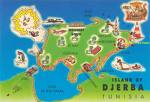





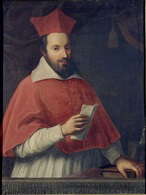
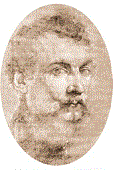
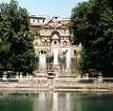
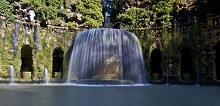
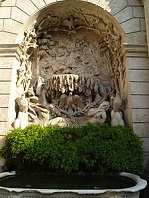


1560 Between this year and 1600 240K Spaniards emigrate to the Americas, incl. a number of conversos (Spaniards of Jewish ancestry); meanwhile the lucky few, incl. a brother of St. Teresa of Avila return with fortunes. On Apr. 10 after Catherine de' Medici calls him from Nice to succeed Francois Olivier, Michel de l'Hopital (1507-73) becomes chancellor of France, leading the Averagers (humanists who believe that Protestants and Roman Catholics can reconcile via reciprocal concessions), immediately working to get all Inquisition proceedings against heretics (esp. Protestants) suspended pending a gen. or nat. church council, and registering the Edict of Romorantin with the French parliament in May, becoming the beginning of freedom of religious conscience in France; he then gets an estates-gen. convoked in Dec. sans consent of Pope Pius IV, almost causing a split. On May 9-14 the naval Battle of Djerba sees the Turks under adm. Piyale (Piali) Pasha (1515-78) and the corsair Dragut Reis (1485-1565) defeat the mainly Spanish Holy League fleet under old fart Giovanni Andrea Doria (1466-1560) et al. near Djerba Island off Tunisia, sinking half its ships, then taking the Spanish fort at Djerba after 3-mo. siege; all 5K POWs are massacred, the bones forming 20-ft.-high Skull Fort, which lasts three cents. Scotland goes through a Protestant Reformation, one of those Pyrrhic victories as it ends its 250-y.-o. Auld Alliance with Roman Catholic France, which had kept it from being absorbed by the stanking English? On June 10 Mary of Guise (b. 1515) dies of dropsy after having been regent of Scotland for six years, and the Feb. 27 Treaty of Berwick along with the July 2 Treaty of Edinburgh formalize Elizabeth I's financial and military aid to the Protestant Lords of Scotland, who establish a council of regents for her daughter Mary, Queen of Scots, recognize Elizabeth, annul the now-pesky 1294 Auld Alliance, and expel the Catlicking French from Scotland; Elizabeth grumbles that William Cecil couldn't get the French to return Calais or reimburse her for the cost of the war, causing Cecil to blame Robert Dudley and begin plotting against him?; on Aug. 1 the Estates of Parliament meet, and order the ministers of the new Reformed Kirk (Church) of Scotland to draw up a Scots Confession of Faith (25 chapters), written in four days by the Six Johns, incl. John Knox (main writer), John Winram, John Spottiswoode, John Willock, John Douglas, and John Row, and approved by parliament on Aug. 27, which Mary, Queen of Scots refuses to approve, and has to wait for her overthrow in 1567; on Aug. 11 the Latin Mass is prohibited in Scotland, and on Aug. 17 Calvinistic Protestantism is officially established as the religion of Scotland; the Knox-backed Scottish Reformation, masterminded by the Lords of the Congregation is in like MacFlynn before Mary, Queen of Scots can do anything about it. In June the Battle of Okehazama sees Oda clan lord Oda Nobunaga (1534-82) defeat rival lord Imagawa Yoshimoto's attempt to capture Kyoto, kicking the butts of his 25K-man army with his 3K-man army, after which in 1562 he enters the city of Kyoto and sets up shop in Komaki Castle, beginning a new era of unification in Japan, starting by going after the rival Saito clan then proceeding to conquer the whole island, with the motto "Tenka Fubu" ("Everything Under the Sky"); In June Mother Annie Dowe of Brentwood, Essex starts a rumor that Dudley had made Queen Elizabeth preggers, and is arrested in Aug. and jailed after a closed trial; the rumors of a royal bastard keep spreading and many end up in jail or getting ears lopped - the Virgin Queen is an expensive dummy corporation? On Aug. 7 Ivan IV the Terrible's not-so-terrible first wife Anastasia (Gr. "resurrection") Romanovna (1530-60) dies, causing him to lose it and turn against his advisers and the boyars, whom he blames for her death; his reign starts to tank as he becomes a bitter insane sadistic tyrant who never forgets, and begins surrounding himself with a select group of noblemen whom he allows to exercise despotic power over his domain? On Aug. 21-26 after the first iconoclasm in Provence in spring, and a summer of Huguenot unrest from Anjou to Dauphine incl. Poitou, Guyenne, Perigord, Languedoc, and Provence, an assembly of notables in Fontainebelau, where Huguenot adm. Gaspard de Coligny reads a petition from Norman Protestants asking for freedom of religion; on Sept. 4/5 (night) armed Huguenot militants attempt to take over Lyon, pissing-off Francis II, who sends troops to quash them, and has the prince of Conde arrested on Oct. 31. On Sept. 29 Gustav I Vasa (b. 1496) dies, and his son Eric XIV (1533-77) becomes king of Sweden (until 1568), soon going insane, which he makes worse by killing several members of the Sture family in 1566; meanwhile Gustavus's 2nd son Duke Johan of Finland waits in the wings. On Dec. 5 after the first fireworks display in France is given in Amboise to celebrate the the accession of Francis II, the Amboise Conspiracy (Tumult of Amboise) by the Bourbon and Montmorency clans (led by Louis I of Bourbon, Prince of Conde and supported by Queen Elizabeth I and John Calvin) to seize Francis II (husband of Mary Stuart, Queen of Scots) and exterminate the House of Guise in order to save France is exposed and foiled, resulting in a massacre of Huguenots; on Dec. 5 Francis II (b. 1544) dies from a brain abscess six weeks before reaching the age of 17, leaving his wrongly-educated (woman stuff instead of statecraft) widow to return to Scotland, at first bitching and bawling then coming to realize the power is hers as ambassadors flock to her chambers with offers of royal marriage; after the French reject her idea of marrying Spanish Prince Don Carlos, she decides to return to Scotland, and 10-y.-o. Charles IX (1550-74) is crowned Valois king #12 of France (until May 30, 1574), with his mother Catherine de' Medici as queen regent, making her virtual ruler, proving to be a treacherous Macchiavellian type with the goal of royal power at any cost, which ends up demoralizing France; like all her children, Charles IX is a sickly disgusting prick (mentally unstable sadist subject to mad rages) who is betrothed at age 11 to Elizabeth of Austria; courtiers now openly quote Nostradamus' Century X, Quatrain 39 ("First son, widow, unfortunate marrage, without any children, two isles in discord"), which they claim predicts Francis II's death; meanwhile English ambassador Sir Nicholas Throckmorton is imprisoned by Duke Francis of Guise for suspected involvement in the Amboise Conspiracy, but talks his way out of it. Maximilian II, son and heir apparent of HRE Ferdinand I abandons his Lutheran leanings, causing a sigh of relief about a Protestant Holy Roman Empire, which had caused Philip II to formulate plans to succeed Ferdinand instead of him. The Portuguese destroy Villegagnon's French Protestant colony in Brazil. King Anthony of Navarre invites Theodore Beza to try and talk him into becoming a Protestant at Castle Nerac, but isn't converted. Robert Dudley's wife dies under mysterious circumstances. The Case of Martin Guerre, an imposter of a French Basque peasant (b. 1524) who lives with the real one's widow and son for three years is tried in Rieux, France; he almost survives until the real one, who had a leg amputated after the 1557 Spanish attack on St. Quenin and lived in a monastery to recuperate returns; the imposter is found to really be Arnaud du Tilh, and executed. The village of San Luis de Tampico in Tex. is founded by Spanish Franciscan Father Andres de Olmos, later becoming Tampico in Tamaulipas, Mexico. The Merchant Adventurers of London (founded 1407) is given a monopoly on exporting cloth to the Netherlands and W Germany, pissing-off their rivals, who force them to move their trading center (stape) from Amsterdam to Hamburg in 1567, and Dordrecht in 1655. Westminster School in London is founded by Elizabeth I. Italian polymath Giambattista della Porta (1535-1615) founds the Academia Secretorum Naturae (Accademia dei Segreti), the first modern scientific society in Naples; it is ordered closed by the Church in 1580. Franco-Flemish composer Orlando di Lasso (Orlande de Lassus) (1532-94) becomes court kappellmeister in Munich, founding the polyphonic Franco-Flemish School along with Roman organist-composer Giovanni Pierluigi da Palestrina (1525-94). A new system of silver coinage replaces the old debased one of the three previous reigns in England; a special mint is established, and owners of the debased coins have to turn them in and get new coins based on the actual (not face) value; prices fall to normal levels, and confidence in English money is restored - it takes a woman? French ambassador to Portugal Jean Nicot (1530-1600) imports the tobacco plant to Portugal, and sends some tobacco to Catherine de' Medici of France, who doctors her son Francis II with it, causing it to become known as the Queen's Herb; it is renamed Nicotiana tabacum. Italian architect Andrea Palladio (1508-80) moves to Venice (until 1580), designing a number of churches, all of them keepers. In this decade blonde beautiful Albanian babe Sophia (Sofia) Baffo (1550-1603) sails from Venice to visit relatives, and is captured by Muslim pirates, then sold into the sultan's harem of 250 women, working her way up to become the top concubine of Nur-Banu's son Murad III (1546-95) into the throne, pussy-whipping him enough to rule the Ottoman Empire behind the scenes as Sultan Safiye ("Pure One"), while Jewish harem mgr. (kira) Esperanza Malchi (-1600) (suspected lezzie lover) helps her lick her problems. After becoming the first Roman Catholic missionary in China in 1556, Father Gaspar Da Cruz pub. the first description of Chinese tea in Portuguese: "A drink called ch'a, which is somewhat bitter, red, and medicinal." After the accession of Queen Elizabeth I, high-class English women begin wearing large elaborate coiffures. French surgeon Ambroise Pare (Paré) (1510-90) describes the case of 15-y.-o. Champagne region farm girl Marie, who is leaping a ditch when something rips in her crotch, and a penis and two testicles descend through a rip in the skin; the bishop of Chalons rechristens him Germain, and a decade later he is an athletic man of medium height with a thick red beard. In July Villa d'Este on Lake Como in Tivoli (near Rome), Italy, commissioned by Cardinal (since 1538) Ippolito II d'Este (1509-7) (son of Lucrezia Borgia) and designed by architects Alberto Galvani and Pirro Ligorio (1512-83) is begun (finished 1575), developing the finest Renaissance garden in Italy AKA Tivoli Gardens; it becomes known for its 500 beautiful fountains incl. a Neptune water organ fountain, Fountain of Venus, and the Oval Fountain; too bad, d'Este loots the nearby 2nd cent. C.E. Hadrian's Villa for marbles and statues for his super villa, and never makes pope; The Uffizi in Florence is founded as an office for magistrates, after which the top floor is turned into a private art gallery and museum. Inventions: In this decade brass is first used in clocks and watches in Europe and England. In this decade visiting cards are used for the first time by German students in Italy. Nonfiction: William Baldwin (1515-63), The Funerals of King Edward the Sixth> Theodore Beza (1519-1605), Confession of Faith; Protestant bestseller that is widely translated for cents. Thomas Blundeville (1522-1606), The Arte of Ryding and Breakinge Greate Horses; first work on horsemanship (equitation) in English. Franciscus Patricius (1529-97), Della Historia Diece Dialoghi (Basel); takes a skeptical view of the possibility of historical knowledge. Novels: Hsu Wei, Ching P'ing Mei (The Plum in the Golden Vase); the first classic Chinese novel, a novel of manners and erotic realism - bring your own chopsockey FX? Art: Tintoretto (1518-94), Susanna and the Elders (1560-2). Paolo Veronese (1528-88), St. Geminianus and St. Severus. Births: Swiss botanist Gaspard (Caspar) Bauhin (d. 1624) on Jan. 17 in Basel. German surgeon ("the Father of German Surgery") Wilhelm Fabry of Hilden (Guilelmus Fabricius Hildanus) (d. 1634) on June 25 in Hilden; husband (1587-) of Marie Colinet (1560-1640). Hungarian witch-vampire and serial murderer ("Bloody Lady of Cachtice") Countess Elizabeth (Erzsebet) (Erzsébet) Bathory (Báthory) (d. 1614) on Aug. 7 in Nyirbator. Scottish poet "The Admirable" James Crichton (d. 1585) on Aug. 19. English explorer Sir Thomas "the Navigator" Cavendish (d. 1592) on Sept. 19 in Trimley St. Martin (near Ipswich), Suffolk; educated at Corpus Christi College, Cambridge U.; knighted in 1588. German Protestant Wettin elector of Saxony (1586-91) Christian I (d. 1591) on Oct. 29 in Dresden; son of Augustus I (1526-86) and Anna of Denmark; father of Christian II (1583-1611) and Johann Georg I (1585-1656). Dutch Reformed (free-will anti-predestination) theologian (founder of Arminianism) Jacobus (Jacob) Arminius (Harmensen) (Hermansz) (Jakob Hermanszoon) (d. 1609) on Oct. 10 in Oudewater-an-der-Yssel, Utrecht; educated at the U. of Leiden; opponent of Dutch Calvinist theologian Franciscus Gomarus; teacher of Simon Episcopius. Italian Baroque painter Annibale Carracci (Caracci) (d. 1609) on Nov. 3 in Bologna; rival of Michelangelo da Carivaggio (1571-1610). Dutch scholar-critic Jan Gruter (Gruytere) (d. 1627) on Dec. 3 in Antwerp; Dutch father, English mother. French minister (to Henri IV) Maximilien de Bethune (Béthune), Duke of Sully (d. 1641) (b. 1559?) on Dec. 13 in Rosny Chateau, Seine-St-Denis (near Mantes); created duke in 1606. Portuguese explorer Sebastiao Rodrigues Soromenho (Sebastian Rodriguez Cermeno) (Cermeño) (d. 1602) in Sesimbra. Spanish viceroy #9 of New Spain (1595-1603) Gaspar de Zuniga (Zúñiga) Acevedo y Fonseco, 5th Count of Monterrey (d. 1606) in Monterrey, Andalusia. English dramatist Henry Chettle (d. 1607). French Protestant explorer Pierre du Guast, Sieur de Monts (d. 1611) in Saint-Onge. Italian architect Flaminio (It. "Roman priest") Ponzio (d. 1613) in Viggiu (near Varese). French statesman-chef Guillaume Fouquet de la Varenne (d. 1616) in La Fleche; starts out in 1578 as cook for Catherine de Bourbon (1559-1604), wife of Henry II and sister of Henry IV, who makes him his portmanteau in 1580, after which he serves him for 30 years; knighted in 1598; created marquis in 1616. German alchemist Andreas Libavius (d. 1616). English mathematician-astronomer-explorer Thomas Harriot (Hariot) (Heriot) (Harriott) (d. 1621) in Oxford; educated at St. Mary Hall, Oxford U.; first Englishman to smoke tobacco?; introducer of the potato to the British Isles? English historian Sir John Hayward (d. 1627) near Felixstowe, Suffolk; educated at Pembroke College, Cambridge U.; knighted in 1619. Dutch city architect of Haarlem (1592-) Lieven de Key (d. 1627). English astrologian-theologian Richard Harvey (d. 1630) in Saffron Walden; brother of Gabriel Harvey (1552-1631) and John Harvey (1564-92); educated at Pembroke Hall, Cambridge U. British (Welsh) New River engineer Sir Hugh Myddleton (Middleton), 1st Baronet (d. 1631); brother of Sir Thomas Middleton (1550-1631) and William Middleton (1556-1621); created baronet in 1622. Italian painter Bartolommeo Carducci (Bartolome Carducho) (d. 1638) in Florence. English soldier-courtier Robert Carey, 1st Earl of Monmouth (d. 1639) in Arkestone, Herefordshire; youngest son of Henry Carey, 1st Baron Hunsdon (1526-96) (1st cousin of Elizabeth I) and Anne Morgan. Swiss surgeon Marie Colinet (d. 1640) in Geneva; wife (1587-) of Wilhelm Fabry (1560-1634). Deaths: Italian (Genoese) adm.-statesman Andrea Doria (b. 1468) in Genoa. Italian sculptor Baccio Bandinelli (b. 1493) on Feb. 6 in Florence. Swedish king (1523-60) Gustavus I (b. 1496) on Sept. 29 in Stockholm Palace. German Protestant humanist reformer Philipp Melanchthon (b. 1497) on Apr. 19 in Wittenberg. German Lutheran champion Philip I the Magnanimous of Hesse (b. 1504) on Mar. 31. Spanish explorer Juan de Salazar de Espinoza (b. 1508) in Asuncion, Paraguay. Spanish Dominican theologian-bishop Melchior Cano (b. 1509) on Sept. 30 in Toledo. French Renaissance sculptor-architect Jean Goujon (b. 1515) (d. 1565) in Bologna?; designed the Henry II staircase in the Louvre and the bas-relief Nymphs in the Fountain of the Innocents in Paris. French-born queen consort of Scotland (1538-42) Mary of Guise (b. 1515) on June 10 in Edinburgh (dropsy). French author-poet Joachim du Bellay (b. 1525); leaves 115 poems modeled after Plutarch - you seem kind of bummed out, why? French king (1559-60) Francis II (b. 1544) on Dec. 5 in Orleans.


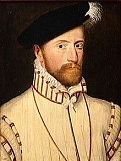



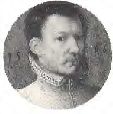





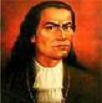
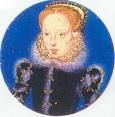
1561 In Jan. the Edict of Orleans grants toleration to French Huguenots, leading to the Edict of St. Germain next Jan. In Jan. Capt. Pedro de Urzua is killed by his own men, who mutiny under the leadership of Basque-descent conquistador Lope "El Loco" (the Madman) de Aguirre (1510-61) after they despair of finding El Dorado in the Amazon Basin and renounce allegiance to Spain, seeking to return to Peru and establish an independent kingdom; on Mar. 23 Aguirre makes his 186 men sign a statement acknowledging him as "Prince of Peru, Tierra Firme and Chile"; while marching through Venezuela, the Spanish defeat them and kill Aguirre in Barquisimeto on Oct. 27 after he murders his daughter Elvira for being "bedded by uncouth people", after which he is beheaded and his body quartered and sent to nearby towns; the story is depicted in the 1973 film Aguirre, Wrath of God. On Mar. 2 the Spaniards under Pedro del Castillo reach Cuyo, Chile and found the city of Mendoza (Ciudad de Mendoza del Nuevo Valle de La Rioja) in W Argentina (modern-day pop. 115K/1M), named after Chile gov. Garcia Hurtado de Mendoza, utilizing the old Huarpe irrigation system. On Mar. 6 after Spanish viceroy Luis de Velasco decides to replace incompetent Tristan de Luna as gov. of Pensacola, Angel de Villafane ((Ángel de Villafañe) 1504-?) arrives, and tries unsuccessfully to colonize the Carolinas, leaving 50 men to guard the Ochuse settlement, and taking the rest (230) to Santa Elena on the coast (modern-day Parris Island, S.C.), only to be struck by a hurricane, causing them to pack up and head back via Hispaniola and Cuba, telling Velasco that the region sucks, after which no Spanish attempt is made to settle NW Fla. for 135 years; meanwhile the French start to become interested. On Apr. 4 UFOs are seen over Nuremberg, Germany - aliens from outer space cause all human wars? In Apr. Francois (Francis) de Lorraine, 2nd Duke of Guise (1519-63) (younger brother of Charles of Guise, Cardinal of Lorraine), Anne, Duc de Montmorency (1493-1567), constable of France, and marshal Jacques d'Albon de Saint-Andre (Saint-André) (1505-62) form a triumvirate to undermine Catherine de' Medici's attempts at reconciliation with French Huguenots, with a double-pronged approach of allying with Spain and the pope while keeping the Calvinists from helping them militarily. On Aug. 7 (dawn) UFOs in the form of spheres are seen by the citizens of Basel, Switzerland. In Aug. Lady Catherine (Katherine) Grey (1540-68) (younger sister of Lady Jane Grey, who is next in line to the English throne after Elizabeth I) and Edward Seymour, 1st Earl of Hertford, 1st Duke of Somerset (1539-1621), who secretly married last Dec. and are found out are imprisoned in the Tower of London, but are allowed many comforts, incl. conjugal visits (without the queen's knowledge); she gives birth to 2nd son Thomas in Feb. 1563, making the queen furious at the prospect of yet another rival to the throne, ordering the lovers forever separated; Hertford is convicted by the Star Chamber of "deflowering a virgin of the blood royal in the queen's house" and fined £15K (later reduced to £3K); Sir Edward Warner, lt. of the Tower who had allowed the conjugal visits is sacked. On Aug. 14 tall widowed (and probably virtually virgin) 19-y.-o. Mary Stuart, Queen of Scots, accompanied by French biographer Pierre de Brantome, Seigneur de Bourdeille (1540-1640) leaves Calais, France for Scotland, being denied safe passage through England by her rival Elizabeth I (who sends aggressive warships to play cat and mouse, then changes her mind too late?), and lands at Leith on Aug. 19, where there is no welcoming committee because they didn't expect her so soon, but after they organize one they are wowed by this 6-ft. twos-company-threes-an-audience finishing school model with the walk and the talk, plus royal Stewart, Tudor, and Guise blood flowing in her unmarried what's-up-everybody royal veins; John Knox and other Protestants stand her up, and soon get in a war over who controls Scotland, starting with making a fuss over her going to Mass in Holyrood Chapel a few days later, being stopped from rioting after her half-brother Lord James Stewart intervenes and she declares that Scots can worship as they please, she is granted noblesse oblige and allowed to hear Mass in her private chapel; she then meets with John Knox (1505-72), and tells him to obey or be considered a traitor, which he brushes off, trying to convert her to Protestantism, calling a Catholic queen a "monstrous regiment"; Mary holes-up in quadrangular Holyrood Palace; Sir William Maitland of Lethington continues as her secy. of state, directing Scottish foreign policy for the next six years; James Hepburn, 4th Earl of Bothwell (1536-78), lord high adm. of Scotland, who was in the deputation of lords which conveyed her to her kingdom is made a privy councilor, but ends up getting kicked out of Edinburgh; Mary then begins an extensive tour of her kingdom (until 1567); meanwhile Elizabeth fears that taller-prettier Mary might marry a powerful Catholic prince and threaten her throne; their rivalry becomes the focal point of Anglo-Scottish relations for the next quarter cent. On Sept. 8 Elizabeth I arrives to take up residence at St. James' Palace in London, and 10K people turn out to see her. On Sept. 9 the Colloquy of Poissy, called by Catherine de' Medici at the convent of Poissy in France attempts to reconcile French Roman Catholics and Protestants, and after Theodore Beza gives a fine speech explaining Protestant beliefs, and debates Charles de Guise, Cardinal of Lorraine (1524-74), who chokes on the idea of giving up the Catholic Communion, the Catholics bring in their heavy gun, Jesuit gen. Diego Laynez (Lainez) (1512-65), and after he is through painting them as roasted wieners the colloquy breaks up on Oct. 7 with few if any minds changed; meanwhile the French Huguenots and major German theologians have no input, the latter arriving after it's over; French Huguenot potter Bernard de Palissy (1510-89), who ever seeks the secret of white enamel is set free, and appointed "inventor of rustic figurines" to Catherine de' Medici (until 1588); meanwhile the first Calvinist refugees from Flanders settle in England. In the fall Erik of Sweden (d. 1577) attempts to court Elizabeth I, but she toys with him until he gives up. In Nov. Elizabeth I is seen leaving Whitehall by a back exit in disguise to watch her real beau Robert Dudley in a shooting match; on Dec. 22 Dudley is admitted to membership in the Inner Temple of the Inns of Court after he supports them in a land dispute; on Dec. 28 plays are performed there with the theme that the queen should marry him; on Dec. 26 Elizabeth I restores the earldom of Warwick to Robert Dudley's brother Ambrose along with Warwick Castle and large tracts of land in the Midlands; meanwhile Robert Dudley secretly proposes to Philip II to restore Roman Catholicism to England if he will endorse his marriage to her. The Poles take over Livonia; the Baltic states of the Order of the Teutonic Knights are secularized; the Livonian Knights are disbanded, and their grandmaster becomes the first Duke of Courland under Polish suzerainty. Inca king Sayri Tupac dies in Cusco after accepting an offer from the Spaniards to move there; Manco's son Titu Cusi Yupanqui (Don Diego de Castro) (1529-71) becomes Inca (king) and agrees to let Roman Catholic priests enter Vilcabamba to preach. Valladolid burns down, and Philip II declares his hometown of Madrid the capital of Spain. St. Paul's Cathedral in London is badly damaged by a fire. The jealous Christian-run city council of Hagenau in Alsace, known as a fortified haven for wealthy Jews passes a regulation prohibiting non-resident Jews from attending the synagogue, under penalty of closing it; by now only six of the original houses settled by Jewish families in the 1160s are considered permanent, all other Jews being required to lease "temporary" houses at exorbitant fees, while all Jews are heavily taxed - who's zoomin' who? Catherine de' Medici terms snuff "Herbina Regina" after it cures her son Francis II's migraine headaches. After English Benedictines and Franciscans move in and establish seminaries, English College is founded in Douai (Douay) (Doway), N France under the patronage of Philip II and Pope Pius V, where exiled English priest (later cardinal) William Allen (1532-94) and other Assburger, er, Oxford U. alumni to train Jesuit missionaries for England, causing the word "seminarist" to become synonymous with traitor there - you big fat muscle-headed sack of rotten seminarist waste - you just called me a seminarist? Venetian humanist publisher (Aldine Press head) Paulus Manutius (1512-74) begins pub. books in Rome under the patronage of the popes. The Merchant Taylors' School in London is founded by headmaster Richard Mulcaster (1531-1611), becoming the largest school in England and taking on pupils incl. Edmund Spenser, Thomas Kyd, and Thomas Lodge, teaching Latin, Greek, music, drama, phys-ed incl. soccer ("footeball"), and "good manners". Sports: Spanish chess-playing bishop Rodrigo "Ruy" Lopez de Segura (1540-80) develops the modern technique of chess playing, incl. the Ruy Lopez Opening, and becomes the world's first chess champ. Architecture: The Basilica of St. Basil in Moscow (begun 1534) is finished. Cornelis Floris begins work on the Antwerp Town Hall (finished in 1572). Michelangelo designs St. Maria degli Angeli in Rome. Andrea Palladio designs the Convent of the Carita in Venice. Inventions: Pieter Breughel the Elder invents the first dredger for his soggy Low Country. Nonfiction: Guido de Bres (1522-67), The Belgic Confession of Faith; challenged by Jacobus Arminius, founder of Arminianism. Philibert Delorme (1514-70), New Inventions for Good Buildings and Small Fees (Nouvelles inventions pour bien bastir et à petits frais). Gabriele Falloppio (1523-62), Anatomy; his only work pub. during his lifetime. Sir Thomas Hoby (1530-66), The Courtyer of Count Baldesser Castilio; English tr. of Baldassare Castiglione's "Il Libro Del Cortegiano" (1527). John Knox (1513-72), The Scottish Confession of Faith; mainly the work of John Knox; the authorized Scottish creed for the next 2 cents. George North, The Description of Swedland, Gotland and Finland. Thomas Norton (tr.), John Calvin's "Institution of the Christian Religion"; originally pub. in 1536. ? (tr.), Julius Caesar's "Poetics". Plays: Thomas Sackville (1536-1608) and Thomas Norton (1532-84), Gorboduc, or Ferrex and Porrex (historical tragedy); first English drama written in blank verse; performed before Elizabeth I next Jan. 18 in the Inner Temple. Births: English brainy lawyer, essayist, statesman (MP and Lord Chancellor), historian and philosopher (gay) (inventor of the scientific method?) Sir Francis Bacon, Viscount St. Albans (d. 1626) (whose portrait bears a striking resemblance to actor Walter Pidgeon (1898-1984)?) on Jan. 22 [Aquarius] in Strand, London; son of Lord Keeper Sir Nicholas Bacon and William Cecil, Lord Burghley's sister; he and his elder brother Anthony are gay; "Of middling stature, his countenance had indented with age before he was old; his presence grave and comely" (Arthur Wilson); he tries to "purify" the science of astrology, and ends up renouncing stargazing? Spanish Baroque poet-dramatist Luis de Gongora (Góngora) y Argote (d. 1627) on July 11 in Cordoba; son of Francisco de Argote, chief magistrate of Cordoba, and blue-blooded Leonora de Gongora; his florid, elegant, exaggerated style becomes known as Gongorism, and later becomes a favorite target of mockery for inferior poets? English courtier-writer-poet (inventor of the flush toilet) Sir John Harington (Harrington) (d. 1612) on Aug. 4 in Kelston, Somerset; eldest son of pet Sir John Harington and Isabella Markham; "saucy godson" of Elizabeth I. Italian "Euridice" composer (1597 inventor of the opera) Jacopo Peri (d. 1633) on Aug. 20 in Rome; music dir. at the Medici court; inventor of the recitative, which goes between the aria and the chorus to move the action along. Spanish gov. of Rio de la Plata (1597-99) and Paraguay (1615-17) Hernando Arias de Saavedra (AKA Hernandarias) (d. 1634) on Sept. 10 in Asuncion, Paraguay; first Am.-born gov. of a New World Euro colony; husband of Jeronima de Contreras, daughter of Juan de Garay (1528-83). English lord Edward Seymour, Lord Beauchamp, 2nd Earl of Hertford (d. 1612) on Sept. 21 in the Tower of London; son of Edward Seymour, 1st earl of Hertford (1539-1621) and Lady Jane Grey's sister Catherine Grey (1540-68); husband of Honora Rogers; father of William Seymour, 2nd duke of Somerset (1588-1660). English Roman Catholic Jesuit priest-poet (St.) Robert Southwell (d. 1595). German mathematician Bartholomaeus (Barthelemy) (Bartholomeo) Pitiscus (d. 1613) in Gruenberg, Lower Silesia (modern-day Poland). Italian anatomist Giulio Casserio (d. 1616); successor to Fabrizio at Padua. English Renaissance poet and Calvinist theologian Mary Sidney Herbert, Countess of Pembroke (d. 1621) on Oct. 27 in Tickenhill, Bewdley; daughter of Sir Henry Sidney (1529-86) and Mary Dudley (daughter of Duke John Dudley of Northumberland, and sister of Robert Dudley, 1st earl of Leicester); wife (1577-) of Henry Herbert, 2nd earl of Pembroke (1534-1601); niece of Lady Jane Grey (1536-54); sister of Sir Philip Sidney (1554-86); mother of William Herbert, 3rd earl of Pembroke (1580-1630) (the young man described in Shakespeare's Sonnets?) and Philip Herbert, 4th earl of Pembroke, later becoming the "Incomparable Pair" to whom Shakespeare's First Folio is dedicated; most-educated woman in England after Elizabeth I; the real Shakespeare? Flemish Baroque painter Marcus Gheeraerts the Younger (d. 1636). Italian physician Santorio Santorii (Santorio) (d. 1636); founder of the scientific study of metabolism. English noble William Stanley, 6th Earl of Derby (d. 1642); son of Henry Stanley, 4th earl of Derby and Lady Margaret Clifford (1540-96); mother is heir to Elizabeth I under the Third Succession Act; the real Shakespeare? Deaths: French publisher Claude Garamond (b. 1480). Italian painter Ridolfo Ghirlandaio (b. 1483). Spanish painter-sculptor Alonso Berruguete (b. 1488). Polish-Lithuanian hetman Jan Amor Tarnowski (b. 1488) on May 16 in Wiewiorka, Poland. Ottoman scholar Ahmed Tashkopruluzade (b. 1495); leaves Miftah al-sa'ada (a compendium of all known knowledge), and Shaqa'iq al-nu'maniyaa (bio. dict. of 600 learned men). English surgeon Thomas Vicary (b. 1490) in London. Flemish painter Lancelot Blondeel (b. 1496). Dutch Mennonite founder Menno Simons (b. 1496) on Jan. 31 in Wustenfelde, Holstein: "The regenerated do not go to war nor engage in strife"; "True evangelical faith cannot lie dormant. It clothes the naked, feeds the hungry, comforts the sorrowful, shelters the destitute, serves those that harm it, binds up that which is wounded. It has become all things to all people." German painter Christoph Amberger (b. 1500). Spanish viceroy #5 of Peru (1556-61) Andres Hurtado de Mendoza, 3rd marquis of Canete (b. 1500) on Mar. 30 in Lima, Peru. German Roman Catholic bishop Michael Helding (b. 1506) on Sept. 30 in Merseburg. Spanish conquistador Lope de Aguirre (b. 1510) on Oct. 27 in Barquismeto, Venezuela (KIA). French musician Louis Bourgeois (b. 1510). Portuguese writer Jorge de Montemayor (b. 1520).



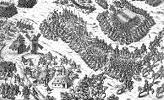



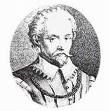








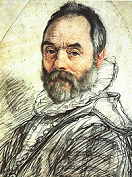
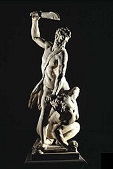
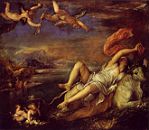
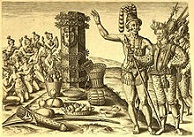
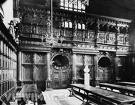
1562 The plague hits Paris again. One of these crazy crazy crazy nights I'm gonna find you, or, Take it, take another little piece of my heart, baby? On Jan. 17 after French regent Catherine de' Medici's chancellor Michel de l'Hopital convenes another colloquy to stop the Roman Catholic-Protestant feud by reason, the Edict of Saint-Germain (January) (the most liberal given French Protestants until the 1598 Edict of Nantes) suspends persecution of French Huguenots, officially recognizing them, but only granting limited toleration, forbidding public worship in towns but allowing it in suburbs; there are 2,150 French Huguenot congregations by now; too bad, the Vatican works to undermine it, and its terms aren't carried out, and papal legate Ippolito d'Este gets l'Hopital dismissed (until 1563); on Mar. 1 the Massacre of Vassy (Wassy) in Wassy-sur-Blaise in Haute-Marne sees Francois (Francis) de Lorraine, 2nd Duke of Guise (1519-63) (younger brother of Charles of Guise, Cardinal of Lorraine) returning from a conference with the Duke of Wurttemberg at Saverne, Alsace, where he convinced him that the Colloquy of Poissy had failed and Calvin is full of merde, then get pissed-off at seeing Huguenots holding Satanic religious ceremonies without benefit of true Catholic clergy, and order the church fired to send the devil spawns back to their father in Hell, killing 23 and wounding hundreds, starting the dog-eat-dog French Wars of Religion (ends 1598), eight bloody civil wars between the Roman Catholics and Protestant Huguenots in France, ending as a struggle for control of France by the Roman Catholic House of Guise (Lorraine) (descended from Norman knight Sir William Gyse, who fought with William I the Conqueror in the 1066 Battle of Hastings) (goes extinct in 1688), and the Protestant Huguenot House of Bourbon; the initial Huguenot leaders are Louis I of Bourbon, Prince of Conde (Condé) (1530-69) and Adm. Gaspard de Coligny (1519-72); the initial Roman Catholic leaders are Duke Francis of Guise and Catherine de' Medici; later Henri IV (Henry of Navarre) is the Huguenot leader, and Henry III the Catholic leader; the Huguenots obtain aid from England, Germany, and Switzerland, and the Catholics from Spain, and go to it - kill-kill-killing for the God of Love and just knowing that they will be saved in yummy-yummy-heaven? In Feb. French Huguenot Adm. Gaspard de Coligny does the Star Trek thang and sends a colonizing expedition to Fla. under the command of Jean Ribault (Ribaut) (1520-65), which arrives in Apr. then sails to Port Royal Sound, S.C., where it tries unsuccessfully to colonize Parris Island near Ft. Royal (near Beaufort), building Charlesfort; in June 1996 U. of S.C. profs. Chester DePratter and Stanley A. South announce discovery of the site; in June a 2nd expedition to Fla. under Rene Goulaine de Laudonniere (Laudonnière) (1529-87) arrives next year at the St. Johns River in Fla., then sails N to S.C., founding Ft. Caroline near modern-day Jacksonville, Fla., threatening the Spanish treasure fleets; the news causes Philip II to order their expulsion, appointing Spain's #1 adm. Don Pedro Menendez de Aviles as gov. of Fla. with the mission of driving out any settlers or pirates and then exploring and colonizing it once and for all; after all, Ponce de Leon claimed it for Spain way back in 1513; meanwhile French Calvinist artist Jacques le Moyne de Morgues (1533-88) accompanies them, making engravings of the local Timucua and Saturiwa tribes. On Mar. 25 Theodore Beza sends a circular letter to all the Protestant congregations, and travels to Orleans with the prince of Conde and his troops, then is sent as emissary to England, Germany and Switzerland to raise funds, returning on Sept. 4, after only Strasbourg and Basel turn him down. In the spring the Countess of Lennox and her darned son Lord Darnley are released from house arrest in London and received back into the queen's favor; the countess begins scheming to marry him to Mary, Queen of Scots, but hints at deposing Elizabeth, landing her in the Tower. In the summer Mary, Queen of Scots leaves Holyrood for a tour of Angus, Aberdeenshire, Banff, and Inverness, returning in the fall by a different E coast route. In Apr. the prince of Conde takes over Newhaven (modern-day Le Havre), causing English ambassador Sir Nicholas Throckmorton to talk Elizabeth I into sending a military expedition to aid the Huguenots, and in Sept. she signs a treaty pledging assistance to the Huguenots in return for their placing of the port of Newhaven in English hands as surety for the future restoration of Calais to the English; in Oct. she orders 6K men under Ambrose Dudley, earl of Warwick to sail to Newhaven and Dieppe, but after arriving they quarrel with the Huguenots, who turn against them. On May 12 the U. of Innsbruck in Tyrol, Austria is founded as a grammar school by Dutch Jesuit priest (St.) Peter Canisius (1521-97), opening for classes on June 24 under the direction of the Jesuits at the request of HRE Ferdinand I; in 1677 HRE Leopold I and Pope Innocent XI charter it as a univ. with four faculties; on Sept. 14, 1782 HRE Joseph reduces it to a lyceum, with Jesuit doctrines suppressed incl. "The Imitation of Christ" suppressed in 1773-1822, then reestablished in 1826 by Emperor Francis I under the name Leopold-Franzens-Universitat Innsbruck. On June 25 the French War of Religion reaches an uneasy peace, but war breaks out again in three weeks, causing Elizabeth I on July 15 to cancel a planned visit by Mary Stewart, Queen of Scots. On July 12 Yucatan Roman Catholic Bishop Diego de Landa holds an auto da fe, burning thousands of Mayan codices (books) and 5K Mayan religious images; he later admits to only 27 books; in 2014 a treasure trove of thousands of codices is discovered near Uxmal in the Yucatan Peninsula; Roman Catholic apologists call this book burning story part of the Black Legend, an alleged false attempt to smear Holy Mother Church - black as in soot? In Sept. Duke Francis of Guise sieges Huguenot-held Rouen, and takes it on Oct. 26 after 1 mo. 10-10-1562, Queen Liz Is Almost Through? On Oct. 10 English queen (since Nov. 17, 1558) Elizabeth I (1533-1603) falls sick with the smallpox at Hampton Court, and remains bedridden for six days, going into a coma for 24 hours on Oct. 16 and having a close brush with death which scares her subjects into a realization that there is no clear Protestant successor; on Oct. 17 physician Dr. Burcot (at the point of a dagger?) tries an old Arab cure recommended by English medieval physician John of Gaddesden, giving her a potion, wrapping her in red flannel and laying her on a pallet beside a fire, causing her to regain consciousness in two hours; on Oct. 17 she orders the councillors to appoint Robert Dudley as lord protector of England, with a salary of £20K a year, plus a £500 a year pension to his valet Tamworth, causing whispers that she is buying his silence for guarding them both when they are alone, causing her to protest that "although she loved... Lord Robert dearly, as God was her witness, nothing unseemly had ever passed between them"; she returns to her duties on Oct. 25, and only shows pox marks on her hands, although she goes bald and begins wearing wigs, starting a fashion vogue in Europe which lasts for cents.; meanwhile she gets into that lead and antimony-based white paint stuff for her face (to cover the officially nonexistent pox marks?), creating "the Mask of Youth", and probably neuters herself, how convenient for the Virgin Queen AKA the 16th cent. Madonna Like A Virgin; too bad, she starts a trend for women to covet pale skin, causing them to bleed themselves; meanwhile her councilors never intended to appoint Dudley?; Robert Dudley's sister Mary Dudley (mother of newborn brain babe Mary Dudley Sidney, a future candidate for the real Shakespeare) nurses Elizabeth I through the smallpox and gets it herself, becoming severely disfigured. What makes a man with shoulder pads move like a pro? On Oct. 28 after Mary, Queen of Scots creates her staunchly Protestant older half-brother James Stewart (one of numerous bastards of James V) as James Stewart (Stuart), 1st Earl of Moray (Murray) (1531-70), and he becomes her chief advisor; the first noble insurrection against Mary, led by the Earl of Huntly is defeated at the Battle of Corrichie (Corrichy) by the queen's forces, led by James Stewart and backed by the Cameron (Gael. "broken nose") clan; Huntly dies before his trial for treason; meanwhile the earl of Bothwell is imprisoned on a charge of attempting to seize the queen, escapes, is briefly imprisoned in the Tower of London, then flees to France until 1565). On Dec. 19 the Battle of Dreux sees the French Huguenots under Louis I of Bourbon, prince of Conde retreat after one of the bloodiest battles of the cent. with French Roman Catholics led by French constable-marshal Duke Anne de Montmorency (1493-1567), who is captured after his cavalry is routed early in the battle; but God is on the Catholics' side, as they not only win but capture Conde. HRE Ferdinand I signs an 8-year truce with Suleiman I the Magnificent, and recognizes John II as ruler of Transylvania; Hungary now has Austrian, Ottoman, and Transylvanian sections. Ferdinand I's son Maximilian II becomes king of the Romans (Germany) and king of Bohemia. Anthony of Navarre is killed in battle, and his 9-y.-o. son Henry of Navarre (b. 1553) (future Henri IV of France) succeeds him as king of Navarre. Catholic King Sigismund II of Poland abolishes ecclesiastical courts. English profiteer Sir John Hawkins (Hawkyns) (1532-95) (2nd cousin of Sir Francis Drake, who starts out as his apprentice) sails to the New World along with three ships, kidnapping 301 African slaves from a Portuguese slave ship in Sierre Leone before reaching Borbuta, Venezuela, then Rio Hacha in Colombia, selling the slaves for sugar, ginger, and pearls in Santo Domingo after flaunting the Spanish, who try to impose taxes, which he laughs off with a threat of burning them down, causing them to ban all English ships from trading in the West Indies; he then returns to England via the French colony in Fla., arriving next Sept., giving his backers a tidy 60% profit, becoming the first to run the Triangular Trade to the Spanish colonies in the Americas and make a profit, interesting Queen Elizabeth I, who takes shares in his expeditions in 1564 and 1567, during which he makes improvements to English ships that help them win against the Spanish Armada in 1588, for which he is promoted to rear adm., while he introduces tobacco smoking to English sailors, along with sweet potatoes; thanks to Hawkins late in this cent. the Transatlantic Triangular Slave Trade is developed between W Africa, the Caribbean, and Europe (ends early 19th cent.). After allying with the Scottish McDonnell clan who had settled in Antrim, Ireland, Shane O'Neill is inaugurated as The O'Neill, visiting Queen Elizabeth I in 1563 and claiming the title of 2nd Earl of Tyrone, who agrees to recognize his claims over Brian O'Neill, son of the assassinated Feardorcha, Baron of Dungannon on the condition that he submit to her authority and that of her deputy the Earl of Sussex, but the deal falls through when he demands a guarantee of his safety, causing Elizabeth I to establish Brian O'Neill in his place, only to see him KIA in Apr. in Shane's absence by Shane's Tanaiste (designated heir) Sir Turlough Luineach O'Neill (1532-95), after which Hugh O'Neill succeeds Brian as Baron of Dungannon, and when he returns Shane goes to war with the O'Donnells and MacDonnells to recognize his hegemony in Ulster, using his deal with Elizabeth I to justify turning on the Scots, burning Armagh Cathedral and fighting to a push in 1564 with Sorley Boy MacDonnell (Domhairle Buidhe Mac Domnhnaill) (1505-90) near Coleraine, and routing the MacDonnells at the Battle of Glentasie in N Ulster on May 2, 1565, killing 300-400; meanwhile in 1565 Sir Henry Sidney (1529-86) becomes lord deputy of Ireland, uttering the soundbyte: "Lucifer himself was not more puffed up with pride and ambition than O'Neill", causing the English to invade Donegal and restore the O'Donnells, while Shane O'Neill ravages the Pale, makes an unsuccessful attempt to take Dundalk, makes a truce with the MacDonnells, and seeks the help of the Earl of Desmond, losing the decisive Battle of Farsetmore near Letterkenny, County Donegal on May 8, 1567 to the O'Donnells of Tyrconnell, losing 600-1,300 KIA, ending Shane O'Neill's aspirations of becoming king of Ulster, fleeing to his enemies the MacDonnells hoping for an alliance, only to be assassinated by them on June 2 after they make a deal with Sir Henry Sidney and William Piers (1510-1603), Seneschal of Clandeboyne, cmdr. of the English garrison in Carrickfergus, who sends Shane's head to Dublin Castle, after Shane's death; Turlough Luineach O'Neill is inaugurated as The O'Neill (until Sept. 1595), managing to fight off the stankin' English despite his rep among the English of being a drunken bum. The rajah of Jaipur submits to Akbar the Great. The Goa Inquistiion in SW India by the Portuguese begins (ends 1812), trying 16,202 by 1774, executing 57, and burning 64 in effigy; it is suspended in 1774-8; the inquisition causes Roman Catholic settlers to begin migrating N to Canara (Kanara) (until 1763), creating the Mangalorean Catholics. Pope Pius IV convokes the 3rd session of the Council of Trent, which had been suspended since 1552 (ends 1563). French #1 scholar Joseph Scaliger (1540-1609) travels to Italy, England, and Scotland, and becomes a Protestant. Spanish capt.-gen. Francisco de Ibarra (1539-75) becomes gov. of Nueva Vizcaya in New Spain, and begins its subjugation (ends 1570). HRE Maximilian II brings a Spanish horse to Austria and founds the court stud at Kladrub; in 1572 the Spanish Riding School is founded in Vienna, becoming the oldest classical dressage riding school to survive to modern times; in 1580 his brother Archduke Charles II founds another court stud at Lippiza (Lipca) in Slovenia, from which the Lipizzaner Stallions descend, which are later adopted by the Spanish Riding School - confusing Gen. George S. Patton Jr.? Fruit-and-nut man Giuseppe Arcimboldo (1527-93) becomes court portraitist to HRE Maximilian II in Vienna, and later to his fruity son Rudolf II in Prague. Italian violin maker Gasparo Bertolotti de Salo (1542-1609) moves to Brescia and gains fame. William I the Conqueror's tomb in Caen, France is robbed by vandals, who steal everything except a thighbone, which is interred in 1642 in another tomb; the latter is stolen by looters during the French Rev. Milled coins are introduced in England. Hans Wilhelm Kirchhof Kassel writes that Jews love their fattened goose livers. Architecture: The 101'x41' Elizabethan-style Middle Temple Hall in London is built. Nonfiction: John Michael Bruto (1515-93), Historia Florentina; pisses off the Medicis, causing him to flee to exile in Transylvania. Diego Gutierrez and Hieronymous Cock, Map of America; "the fourth part of the world". Gabriele Falloppio (1523-62), Observationes Anatomicae (posth.); claims he wrote it in 1557 and discovered the clitoris before Renaldus Columbus despite the 1559 pub. of his discovery - how could I have missed that? Rabelais (1495-1553), Pantagruel, Book Five (posth.). Jeronimo de Zurita y Castro (1512-80), Anales de la Corona de Aragon (History of the Kings of Aragon) (1562-80); first modern historical work in Spain, making use of researches in the libraries of Rome, Naples, and Sicily. Poetry: Arthur Brooke (Broke) (-1563), The Tragicall Historye of Romeus and Juliet; basis of Shakespeare's 1595 play "Romeo and Juliet". Torquato Tasso (1544-95), Rinaldo. Art: Giuseppe Arcimboldo (1527-93), Winter. Giambologna (1529-1608), Sampson Slaying a Philistine. Pieter Brueghel the Elder (1525-69), Two Chained Monkeys. Hans Eworth (1520-74), Margaret Audley, Duchess of Norfolk; Thomas Howard, 4th Duke of Norfolk. Tintoretto (1518-94), Christ at the Sea of Galilee. Titian (1477-1576), The Rape of Europa. Paolo Veronese (1528-88), The Marriage at Cana. Births: Italian duke of Savoy (1580-1630) Charles Emmanuel I (the Great) (d. 1630), AKA "Head of Fire" (Testa d'Feu) on Jan. 12 in Rivoli, Piedmont; only child of Duke Emmanuel Philibert (1528-80) and Margaret of France, Duchess of Berry (1523-74) (daughter of Francis I); husband (1585-) of Catherine Michelle of Spain (1567-97), daughter of Philip II and Elizabeth of Valois; father of Thomas Francis, prince of Carignano (1596-1656). Italian poet-librettist Ottavio Rinuccini (d. 1621) on Jan. 20; first opera librettist. Chinese Roman Catholic writer Xu Guangqi (Hsu Kuang-ch'i) (d. 1633) (AKA Paul) on Apr. 24 in Shanghai; one of the Three Pillars of Chinese Catholicism; beatified on Apr. 15, 2011. Dutch organist-composer Jan Pieterszoon Sweelinck (d. 1621) in Apr./May in Deventer. Japanese daimyo Kato Kiyomasa (d. 1611) on July 25 in Owari Province; his mother Ito is a cousin of Toyotomi Hideyoshi's mother, and he becomes his right hand man. Italian duke of Mantua and Montferrat (1587-1612) Vincenzo I Gonzaga (d. 1612) on Sept. 21 in Mantua; son of Guglielmo I of Mantua (1538-87) and Eleanora of Hapsburg; maternal grandson of HRE Ferdinand I and Anna of Bohemia-Hungary. English archbishop of Canterbury (1611-33) George Abbot (d. 1633) on Oct. 19 in Guildford, Surrey; educated at Balliol College, Oxford U. Spanish playwright-poet ("The Phoenix of Wits") ("The Monster of Nature") Lope de Vega y Carpio (d. 1635) on Nov. 25 in Madrid; first great dramatist of the Spanish Golden Age. German composer Philipp Dulichius (d. 1631) on Dec. 18 in Chemnitz. French adm.-marshal Charles de Gontaut, Duc de Biron (d. 1602); son of Armand de Gontaut (1524-92). English clergyman Thomas Brightman (d. 1607) in Nottingham; educated at Queens' College, Cambridge U. English poet-playwright-historian Samuel Daniel (d. 1619) near Taunton, Somerset; son of a music master; brother of musician John Daniel; educated at Magdalen Hall (Hertford College), Oxford U. English vice-adm. Sir Richard Hawkins (d. 1622); only son of Sir Jack Hawkins (1532-95); knighted in 1603. English organist-composer John Bull (d. 1628) in Radnorshire, Wales. English sci-fi writer and bishop-historian Francis Godwin (d. 1633) in Hannington, Northamptonshire; educated at Christ Church, Oxford U. English atty.-MP (Anne of Denmark's atty.-gen.) Sir Lawrence Hyde II (d. 1641); 2nd son of Lawrence Hyde I (-1590) and 2nd wife Anne Sibell; brother of Henry Hyde (1563-1634) and Sir Nicholas Hyde (1572-1631); educated at Magdalen Hall, Oxford U.; knighted in 1614. Deaths: German knight Gotz von Berlichingen (b. 1480) on July 23; subject of a play by Johann Wolfgang von Goethe. Italian novelist-poet Matteo Bandello (b. 1485). Italian painter Francesco Torbido (b. 1486) in Verona. French composer Claudin de Sermisy (b. 1490). Dutch Flemish composer Adrian Willaert (b. 1490) on Dec. 7 in Venice. French soldier Jacques d'Albon, Seigneur de Saint-Andre (b. 1505). Flemish-born English printer Thomas Geminus (b. 1510) in May in London. Spanish-born Italian duchess of Florence (1539-62) Eleanor of Toledo (b. 1522) on Dec. 17 in Pisa, Florence. Italian anatomist Gabriele Falloppio (b. 1523) on Oct. 9 in Padua. Italian Socinianism founder Laelius Socinus (b. 1525) in Zurich. French poet-courtier Pierre de Boscosel de Chastelard (b. 1540) in Edinburgh (executed) - the young die like bozos?



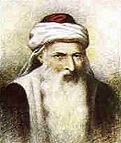



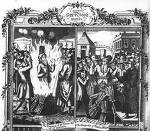
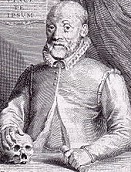
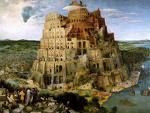
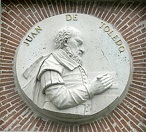
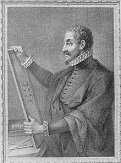
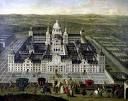
1563 The plague breaks out all over Europe; 20K die in London. On Jan. 11 Elizabeth I's Second Parliament meets, and presses her on the matter of succession, with both houses petitioning her to answer them. On Jan. 13 under the influence of architect Giorgio Vasari, Cosimo I de'Medici founds the Accademia e Compagnia delle Arti del Disegno (Academy and Co. for the Arts of Drawing) in Florence. On Feb. 18 the Roman Catholics under Duke Francis of Guise are about to capture Orleans from the Huguenots when he is wounded by Jean de Poltrot de Mere (Méré) (1537-63), a fanatical Huguenot whose swarthy complexion earned him the nickname "Espagnolet" (allowing him to act as a spy in the wars with Spain), who snuck into the Catholic camp and fired at the duke from ambush as he passed on the road; the duke dies on Feb. 24, and on Mar. 18 the Holy Catholic French have their fun with the Spic, er, Espagnolet heretic, torturing, drawing and quartering him, then hacking him to pieces with cutlasses when the horses can't pull him apart - Jesus wept, the Roman Pope laughed, go figure? On Feb. 22 Mary Stuart's secy., the obsessed hardly chaste French bozo poet-courtier Pierre de Boscosel de Chastelard (1540-62), former court poet of her hubby Francis II of France, who accompanied her to Scotland as a page of Marshal Damville and who exchanged love letters with her is found hiding under her bed at Rossend Castle on the night of Feb. 14 by Scottish lords jealous of his influence, and he is well, er, hung next year in Edinburgh - the first Valentine's Day massacre? On Mar. 19 the First French War of Religion (begun Mar. 1562) ends with the Edict of Pacification (Amboise), signed by Catherine de' Medici as regent for her son Charles IX, and Roman Catholics and Protestants unite to drive the English army in France from Le Havre (Newhaven), aided by a plague among the English invaders; after Elizabeth I sends ambassador Sir Nicholas Throckmorton to negotiate with Catherine de' Medici, she gets suspicious of the snake and places him under house arrest, and it takes until next year for Greek scholar Sir Thomas Smith (1513-77) (new French ambassador until 1566) to get him released, during which time the two become enemies; meanwhile pissed-off Theodore Beza heads back to Geneva after a 22-mo. absence, finding John Calvin ailing, alternating duties with him week-by-week until he croaks next May 27 and he takes over; in July Ambrose Dudley is shot in the leg by an enemy musket, and by the end of the month the English withdraw to England, bringing the plague with them, killing 20K by the end of summer; the English people blame the queen (a woman) for losing Calais, saying, "God help England and send it a king". On Apr. 10 Elizabeth I attends the closing ceremonies of the English Parliament, delivering a handwritten "answer answerless". In Apr. Elizabeth I orders atty. John Hales imprisoned for writing a pamphlet deriding Mary's claim to the English throne and supporting that of Lady Catherine Grey. In Apr.-June the Sieges of Oran and Mers El Kebi in N Africa by 100K Ottoman troops in 30 galleys led by Adm. Hasan Pasha, son of Hayreddin Barbarossa is ended by the arrival of a Spanish fleet under Francisco de Mendoza. In the spring Elizabeth I releases Lady Lennox from the Tower on the condition that she promise never again to scheme to marry her son off to Mary Stuart. In June Elizabeth I bestows Kenilworth Castle in Warwickshire (5 mi. S of Warwick Castle, residence of his brother Ambrose) to Robert Dudley, who proceeds to make it the most magnificent of all Elizabethan mansions. In the summer Mary, Queen of Scots leaves Edinburgh on a progress to Inverary Castle, Whithorn, Peebles and Holyrood, wowing the crowds. In Aug. 13-y.-o. Charles IX of France is declared of age in Rouen in order to give queen mother Catherine de' Medici maneuver room in her war with the pesky Guise family, and her adviser Michel de l'Hopital is recalled. On Oct. 20 Elizabeth I makes her beau Robert Dudley a privy councillor with a pension of £1K a year, then bestows the same on his rival Norfolk. Them Protestants got the devil's printing press, we Catholics got holy BBQ chefs? On Dec. 4 the Council of Trent (begun 1545) finally ends successfully with the aid of (St.) Carlo Borromeo (1538-1584), nephew of Pope Pius IV, who is known for his harsh ecclesiastical discipline; Pope Pius IV confirms the Council of Trent's Professio Fidei Tridentina, and issues it in his bull Injunctum Nobis on Nov. 13, 1565; the old problem brought up the pesky Arians is dealt with at the start: "I believe in one God, the Father Almighty, Maker of Heaven and Earth, and of all things visible and invisible. And in one Lord, Jesus Christ, the Only-begotten Son of God. Born of the Father before all ages. God of God, Light of Light, true God of true God. Begotten, not made, of one substance with the Father. By whom all things were made. Who for us men and for our salvation came down from heaven. And became incarnate by the Holy Spirit of the Virgin Mary: and was made man"; the One Truth Faith having been authoritatively laid out in black-and-white for everybody, and printed on the One True Printing Press of God, of course anybody publishing anything that doesn't fit in its cookie cutter must be a Satanic pawn, so Pope Pius IV also approves the Index Librorum Prohibitorum (Index of Prohibited Books) (Tridentine Index), which is pub. in Venice next year. Wilhelm von Grumbach (1503-67), gen. of Duke John Frederick II of Saxony captures and plunders Wurzburg, then forces the chapter and the bishop to restore it to hs duke, pissing-off HRE Maximilian III, who orders him to withdraw in vain; meanwhile Grumbach plots the assassination of rival Saxon elector Augustus I, causing him and the duke to be placed under the imperial ban by Nov., and Augustus to plan an invasion of the duke's capital of Gotha. The Russians conquer part of Livonia incl. Polotsk; it is returned to Lithuania in 1578. Maximilian II is elected king of Hungary, ending all doubts about succeeding his daddy HRE Ferdinand. Johan Vasa is imprisoned by his elder brother Eric XIV of Sweden (until 1567). Philip II, who stole his betrothed babe Princess Elizabeth of France decides that his son Don Carlos de Austria (1545-68) can't succeed him either, pissing him off and causing him to conspire against his daddy during the 1567 Netherlands revolt, causing Philip to imprison him in 1568 and order his death, giving dramatists a good story about dying with a little dignity? The English Parliament passes Acts for the Regulation of the Poor and the Regulation of Apprentices (repealed in 1814). The governorship of Tucuman (Tucumán) in Paraguay is established, under the jurisdiction of the audiencia of Charcas. Charles IX creates the Gardes Francaises (French Guards), which by 1635 has 9K men in 30 cos.; they are given special rights incl. choosing battle positions, leading an assault during a siege, choice of barracks, first postion in military parades, and special trial rights; they are disbanded on Aug. 31, 1798 after joining the French Rev., and form the core of Lafayette's Nat. Guard. The word "Puritan" is first used in England - I love you just because you're pure? The Convocation of 1563 (begun Jan. 1562) under Archbishop of Canterbury Matthew Parker reduces the English Articles of Religion of 1552 to the Thirty-Nine Articles, drafted as a doctrinal statement by a convocation of the Church of England; Parliament approves them in 1571; assent is still required by the Anglican clergy; they condemn several Roman Catholic beliefs and practices, incl. the power of the papacy, indulgences, reverence for saints and relics, transubstantiation, and the doctrine of Purgatory, affirming infant baptism and predestination and rejecting free will; all believers must obey the secular govt. and bear arms for it; Miles (Myles) Coverdale (1488-1569) becomes rector of St. Magnus (near London Bridge), but resigns in 1566 after refusing to conform with the Act of Uniformity. The Shulkhan (Shulchan) Arukh (Heb. "Set Table") Jewish law code is written in Safed, Palestine by Spanish-born rabbi Yosef Karo (Joseph ben Ephraim Karo) (1488-1575), and pub. in Venice in 1565, launching the age of the Acharonim (Heb. "last ones") poskim (legal judges), who succeed the Rishonim (Heb. "first ones"), who did the judging since the 11th cent., becoming the main Jewish law code to modern times. The first printing presses begin operation in Russia. The city of Durango in NW Mexico (first settled in 1556) (modern-day pop. 1.75M) is founded by silver-seeking Basque explorer Capt. Francisco de Ibarra (1534-75), who names it after his native town in Biscay, Spain, facing immediate challenges from the indigenous pop., who make it difficult to settle there. William Shakespeare's father John Shakespeare is appointed chamberlain for the Stratford Corp. (until 1564), authorizing a 2 shilling payment for "defasying ymages in ye chapel", as required by an English Reformation law passed by Edward VI in 1547. Architecture: Giovanni da Bologna begins the Neptune Fountain in Bologna, Italy (finished in 1567). The huge granite San Lorenzo de El Escorial (Span. "exhausted mine") Palace is begun for gold-rich Philip II of Spain in San Lorenzo de El Escorial 28 mi. NW of Madrid (finished in 1584), designed by Spanish architect Juan Bautista de Toledo (1515-67); when he dies his apprentice Juan de Herrera (1530-97) takes over - good name for the whole country? The Hofkirche dafwin Innsbruck is built, becoming the royal church of the HREs. Nonfiction: Melchior Cano (1509-60), Loci Theologicis (posth.) (Salamanca); #2 Roman Catholic theological work after Thomas Aquinas? John Foxe (1516-87), Foxe's Book of Martyrs (Acts and Monuments of these Latter and Perillous Days, Touching Matters of the Church) (2 vols.) (Mar. 20); makes him "England's first literary celebrity", selling for 10 shillings (3 weeks' pay), even though he receives no royalties; Pt. 1 is about persecution, torture, and burning of early Christian martyrs, Pt. 2 is about the reign of Henry VII and Edward VI, and Pt. 3 is about the burning of Protestants by Roman Candle Catholics under Bloody Mary, all detailed with relish in a 2-vol. 2.3K-page superbook (largest pub. project in England to date), complete with gruesome woodcuts, convincingly portraying the Pope as the Antichrist, and England as the new Chosen Nation of Israel, which God has picked to save Da WQorld; becomes the #2 bestseller in England after the Bible, and starting with the 2nd ed. in 1570 every cathedral church in England is ordered to carry a copy; deeply influences William Bradford, founder of Plymouth Colony, becoming the theme for all future U.S. Protestant-dominated govts.? Gerardus Mercator (1512-94), Map of Lorraine; first accurate one (lost). Garcia de Orta (1501-68), Conversations on the simples, drugs and materia medica of India and also on some fruits found there, in which some matters relevant to medicine, practice, and other matters good to know are discussed (Colóquios dos simples e drogas he cousas medicinais da Índia e assi dalguas frutas achadas nella onde se tratam alguas cousas tocantes a medicina, pratica, e outras cousas boas pera saber) (Apr. 10) (Goa); first Euro to catalog Indian medicinal herbs in their native habitat, pioneering tropical medicine. Giambattista della Porta (1535-1615), De Furtivis Literarum (On Secret Writing); on cryptography. Portuguese (Goa) physician Garcia da Orta (1490-1570), Colloquies on the Simples and Drugs of India; the 3rd book printed in India; a favorite with herbalists and explorers, esp. when it discusses marijuana. Ambroise Pare (1509-90), Cinq Livres de Chirurgie (Five Books on Surgery). Johann Weyer (1515-88), De Praestigiis Daemonum et Incantationibus ac Venificiis (On the Illusions of the Demons and on Spells and Poisons); the appendix lists the names and titles of infernal spirits along with their powers, which is circulated independently. Art: Pieter Brueghel the Elder (1525-69), The Tower of Babel. Births: Dutch Calvinist (anti-Arminian) theologian Franciscus Gomarus (d. 1641) on Jan. 30 in Bruges; family flees to the Palatinate in 1577. English secy. of state (1596-1612), lord high treasurer (1608-12), and lord privy seal (1598-1608) (spymaster) Robert Cecil, 1st Earl of Salisbury (d. 1612) on June 1 in Westminster; son of William Cecil, 1st Baron Burghley (1520-98); half-brother of Thomas Cecil, 1st Earl of Exeter (1542-1623); a nursemaid allegedly drops him in infancy, causing his back to be deformed and his growth to be stunted, after which Elizabeth I calls him her "elf" or "pygmy"; educated at St. John's College, Cambridge U.; created baron in 1603, viscount in 1604, and earl in 1605. Chinse Ming emperor #13 (1572-1620) Wanli ("ten thousand calendars") (Zhu Yijun) (d. 1620) on Sept. 4; 3rd son of Longqing (1537-72); father of Taichang (1582-1620). English lord-lt. of Ireland Charles Blount (pr. like blunt), 8th Baron Mountjoy and 1st Earl of Devonshire (d. 1606) in Hooke Park, Dorset. Dutch merchant Jan Huyghen van Linschoten (d. 1611) in Haarlem; grows up in Enkhuizen. English inventor William Lee (d. 1614) in Calverton, Nottinghamshire; educated at Christ's College and St. John's College, Cambridge U. English lord high adm. Thomas Seymour (d. 1619) in the Tower of London; son of Edward Seymour, 1st earl of Hertford (1539-1621) and Catherine Grey (1540-68), sister of Lady Jane Grey; husband of Isabella Onley; brother of Edward, Lord Beauchamp (1561-1612). English "Come, Heavy Sleep", "Flow My Tears", "I Saw My Lady Weepe" Renaissance lutenist-composer-singer John Dowland (d. 1626) in London (Westminster) (Dalkey near Dublin, Ireland?). English Elizabethan poet Michael Drayton (d. 1631) in Hartshill (near Nuneaton), Warwickshire. English soldier Lord William Howard of Naworth Castle (d. 1640) on Dec. 19 in Saffron, Walden, Essex; 3rd son of Thomas Howard, 4th duke of Norfolk (1536-72); great-grandfather of Charles Howard, 1st earl of Carlisle (1629-85). German Calvinist political philosopher Johannes Althusius (d. 1638) in Diedenshausen, Siegen-Wittgenstein. English courtier Sir Henry Montague (d. 1642); advisor to Charles I. Deaths: Ottoman grand vizier Lutfi Pasha (b. 1488); leaves Asafname, a treatise on good govt. English Protestant writer John Bale (b. 1495) in Nov. Spanish Gothic architect Diego de Siloe (b. 1495). English novelist William Baldwin (b. 1515). French humanist Sebastian Castellion (b. 1515) on Dec. 29 in Basel, Switzerland; his enemies dig up his body and burn it. French Roman Catholic gen.-statesman Francois of Lorraine, 2nd duke of Guise (b. 1519) on Feb. 24 near Orleans (assassinated). English architect John Shute (b. ?); born in Cullompton, Devon; built a wing at Dudley Castle for John Dudley, 1st Duke of Northumberland; leaves First and Chief Grounds of Architecture Used in all the Ancient and Famous Monuments, with a Farther and More Ample Discourse Upon the Same than Hitherto Hath Been Set Out By Any Other (London), the first English work on classical architecture.


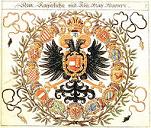
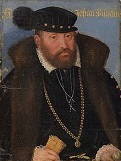


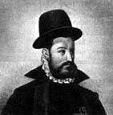
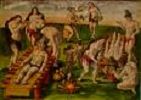
1564 On Mar. 25 the Battle of Angol near Los Infantes, Chile is a V for 60 Spaniards with 12 arqubusiers and a field gun and 500 Indian auxiliaries under Lorenzo Bernal del Mercado over 4K Mapuches under chief (toqui) Illangulien (Illangulién), who lose 1K KIA. On Apr. 11 England and France sign the Trojan Horse Second Treaty (Peace) of Troyes (first in 1420), ending English involvement in the First War of Religion (begun 1562) and renouncing English claims to Le Havre for 120K gold crowns, placing Calais beyond hopes of English recovery. On Apr. 18 after elector Augustus I of Saxony invades Gotha, the pop. fails to resist, and a mutiny gives up the town, pesky gen. Wilhelm von Brumbach (b. 1503) is tortured and executed; meanwhile pesky duke John Frederick II (1529-95) is captured, and spends the rest of his life as an imperial prisoner, and in Nov. 1566 his younger brother Johann Wilhelm (1530-73) becomes sole ruler of the duchy of Saxony (until 1572), and duke of Saxe-Weimar in 1572 (until Mar. 2, 1573); too bad, he allies himself with Charles IX of France against the Huguenots, pissing-off the HRE, whose Hapsburg family are hereditary enemies of the French kings. On May 27 John Calvin (b. 1509) dies in Geneva of TB, and Theodore Beza becomes Protestant leader in Geneva, concentrating on higher ed. of a new crop of Protestants - his dreams fulfilled? In June Philip II of Spain sends Don Diego de Guzman de Silva as his new ambassador to England to replace the Bishop de Quadra, who died last Aug. of the plague. On July 25 HRE (since 1558) Ferdinand I (b. 1503) dies, and his eldest son (king of Bohemia since May 14, 1562, king of Germany since Nov. 24, 1562, and King of Hungary-Croatia since Sept. 8, 1563) Maximilian II (1527-76) becomes HRE (until Oct. 12, 1576). On July 31 New Spain viceroy (since 1550) Luis de Velasco (b. 1511) dies after going into debt to help the poor Indians, and on Oct. 16, 1566 Gaston Carrillo de Peralta y Bosquette, 3rd Marquis of Falces (1510-87) succeeds him (until Mar. 10, 1568), and immediately deals with a revolt of the Spanish nobles by Hernan Cortes' sons Luis and Martin, sending them back to Spain, his leniency toward the rebels getting him recalled, put on trial, and acquitted. In Aug. Elizabeth I makes a progress, staying in Cambridge on Aug. 5-10, where her subjects extol her virginity - she's now the Virgin Mary and Vicar and Bride of Christ, what next, Immaculate Conception? On Nov. 21 the Spanish leave Mexico for the Philippines in hopes of finding a return route (ends 1565). On Dec. 25 the first Scottish Psalter is pub. in Edinburgh, and the Gen. Assembly of the Church of Scotland ordains its use throughout the church. Transylvania under John II adopts Calvinism as its state religion; meanwhile the polish-sausage-frying Counter Reformation begins in Poland - what's that smell? The French royal council under the influence of Michel de l'Hopital refuses to authorize the pub. of the anti-Protestant acts of the Council of Trent, claiming inconsistency with Gallican liberties; meanwhile l'Hopital accompanies teenie king Charles IX on a tour of France (ends 1566). Elizabeth I offers her favorite pretty boy Robert Dudley's hand to Mary, Queen of Scots, and creates him Earl of Leicester for the purpose; by this year (age 31) Elizabeth has lost most of her hair. The Medicis crawl back into nearly deserted Florence. Sir John Hawkins partners with Elizabeth I, leasing the old 700-ton Jesus of Lubeck and sailing with three small ships with his 2nd cousin Francis Drake to the W African coast, returning to Borburata on the Venezuelan coast with 400 slaves. Ivan IV is forced in his power struggle with the boyars to abandon Moscow for Alexandrovsk, returning only after being granted a rich boyar territory called the oprichnina, in which he begins exterminating the boyars to get even for his wife Anastasia. The Co. of English Merchant Adventurers in London (founded in 1551) is granted a new royal charter. Jacques Le Moyne de Morgues (1533-88) of France, who accompanied Rene Laudonnier in 1562 leads an expedition to the N lake region of Fla., maps the coast and visits the half-naked herb tea-drinking gator-eating Timucua Indian confederation, making art and drawings, which are pub. in 1591; next year the Spanish attack and drive the Frogs away; the Timucuas are eventually converted to Christianity, but disease and extermination raids make them extinct by 1819. Queen Regent Catherine de' Medici begins a 2-year royal progress through France with her 2nd son Charles IX and the royal family and a royal entourage of 800, visiting Nostradamus in Salon, and giving him the title of Physician in Ordinary along with 300 gold crowns, a salary and fringe benefits; he tries to examine the moles of 11-y.-o. Henry of Navarre (3rd in line for the throne), who is shy and runs away, prompting to sneak up on him while asleep, examine him, and declare that one day he will be king of France (Henri IV). Elizabeth I is so irked by the relaxed dress of Puritan clergymen that she orders the Archbishop of Canterbury to hold them to a dress code, but the Puritans, fearing a return to the vestments of Roman Catholic priests refuse to obey. The horse-drawn coach (carriage) is introduced in England from Holland. The Borrowdale Mines in Cumberland, England begin producing plumbago, used for leads in the best pencils; they are exhausted by 1850. Guy de la Fontaine attempts to corner the mummy market in Alexandria, Egypt and discovers that merchants had been selling phony mummies made from recently deceased derelicts. Catherine de' Medici first claims to see the Little Red Man, a ghost that haunts the Louvre and Tuilieries in Paris, and later becomes known as a harbinger of tragedy in France, allegedly appearing to Henri IV in 1610, Louis XVI in 1792, Marie Antoinette and Louis XVI in 1793, and Napoleon in 1798 (making a 10-year bargain with him) and 1814 (to collect). Architecture: Chinese City (Nan Cheng) in Peking (begun 1553) is completed. Lima Cathedral (begun 1535) is finished. Nonfiction: Bartolommeo Eustachio (1500-74), Opuscula Anatomica. Music: Pope Pius IV appoints a committee of cardinals to rid Church music of polyphonic harmony, which had grown unnecessarily complex, but the lovers of the polyphonic style put up noted composer Giovanni Pierluigi da Palestrina (1525-94) to do their talking for them, and he submits three masses, incl. Missa Papae Marcelli (his masterpiece), which show how to do Medieval church modes right, and wins the pope over, causing him to be appointed composer to the papal chapel, and begin a glorious career as the king of Roman Catholic polyphonic music. Art: Pieter Brueghel the Elder (1525-69), Christ Carrying the Cross. Philibert Delorme (1514-70) begins work on the Tuileries in Paris - what is the color of innocence, bravado, passion, defiance? Michelangelo sculpts the thin-limbed Rondanini Pieta, which is considered his best work by many modern sculptors (Henry Moore et al.) - thin is already in? Jacopo Tintoretto begins his paintings for the Scuola di San Rocco (finished 1587). Births: English "Dido, Queen of Carthage" , "The Jew of Malta" playwright-poet-spy (gay?) Christopher "Kit" Marlowe (Marley) (d. 1593) on Feb. 23 in Canterbury, Kent; son of a cobbler; educated at the King's School, and Corpus Christi College, Cambridge U. Italian scientist ("Father of Observational Astronomy") ("Father of Science") ("Father of Modern Physics") Galileo Galilei (d. 1642) on Feb. 15 [Aquarius] in Pisa, Tuscany (home of the Leaning Tower); son of Vicenzo Galilei (1520-91). English #1 Elizabethan/Jacobean poet-playwright ("the Bard of Avon") William "Will" Shakespeare (d. 1616) (anagram for "We all make his praise", "I am a weakish speller") on Apr. 23 (May 3 Gregorian) (Sun.) (St. George's day) [Taurus] in a half-timber Tudor house in Stratford-upon-Avon (Stratford-on-Avon) (100 mi. N of London), Warwickshire (2nd w not pronounced); baptized on Apr. 26; eldest of six children (3rd eldest of eight, of whom the first two died before him) incl. Joan (1558), Margaret (1562-3), Gilbert (1566-1612), Joan II (1569-1646), Anne (1571-79), Richard (1574-1613), and Edmund (1580-1607); father John Shakespeare (1531-1601) from Snitterfield is a glove maker and leather merchant, and works for the town council tasting locally-produced beer and acts as bailiff (sheriff); mother Mary Arden (1537-1608) (married in 1557) is from a wealthy local family; Will's father John is plagued with accusations of illegal moneylending and wool dealing by professional informers starting in 1569, and is in financial and legal trouble until 1583, shaping Will's attitude to power and morality as seen in "King Lear" and "Macbeth"?; in the summer the plague kills 200+ of his neighbors; attends King Edward VI Grammar School, whose teachers come from Oxford U.; coiner of the words "hurry", "assassination", "bump", and "fancy-free", and the phrases "all that glitters is not gold", "all's well that ends well", "bated breath", "dead as a doornail", "fool's paradise", "good riddance", "heart of gold", "in a pickle", "laughing stock", "laugh it off", "love is blind", "naked truth", "neither rhyme nor reason", "one fell swoop", "pomp and circumstance", "pound of flesh", "star-crossed lovers", "too much of a good thing", "wear my heart upon my sleeve", "wild goose chase", "the world's my oyster" et al. - is the Shakespeare Code a conspearacy? English aristocrat ("the Wizard Earl") Henry Percy, 9th Earl of Northumberland (1564-1632) on Apr. 27 in Tynemouth Castle, Northumberland; son of Henry Percy, 8th earl of Northumberland (1532-85); father of Algernon Percy, 10th earl of Northumberland (1602-68); a pseudo-Protestant in a Roman Catholic family; known for his great wealth, learning, and scientific-alchemical experiments, along with mild deafness and speech impediment. German duke (1572-96) John Casimir of Saxe-Coburg (d. 1633) on June 12 in Gotha; youngest of three sons of Duke John Frederick II of Saxony and Countess Palatine Elisabeth of Simmern-Sponheim. English navigator William Adams (Miura Anjin) (d. 1620) on Sept. 24 in Gillingham, Kent. English peer Henry Brooke, 11th Baron Cobham (d. 1618) on Nov. 22; son of William Brooke, 10th baron Cobham and 2nd wife Frances (daughter of Sir John Newton); educated at King's College, Cambridge U. German "De Synagoga Judaica" Hebrew scholar ("Master of the Rabbis") Johannes Buxtorf (d. 1629) on Dec. 25 in Kamen (Bockstrop), Westphalia; prof. of Hebrew at the U. of Basel; father of Johannes Buxtorf the Younger (1599-1664). English politician-diplomat Sir Henry Neville (d. 1615); son of Sir Henry Neville (-1593) and 2nd wife Elizabeth Gresham (-1573), granddaughter of Sir Richard Gresham, lord mayor of London; distant relative by marriage of William Shakespeare's mother; educated at Merton College, Oxford U.; the real Shakespeare? English adventurer Sir Thomas Shirley Jr. (d. 1620) in Wiston, Sussex; eldest son of Sir Thomas Shirley Sr. (1542-1612); brother of Sir Anthony Shirley (1565-1635) and Sir Robert Shirley (1581-1628); father of dramatist John Shirley (1596-1666). Indian Muslim Sufi scholar ("Reviver of the Second Millennium") Shaykh Ahmad al-Furuqi al-Sirhindi (d. 1624) in Punjab. Italian Baroque composer and Franciscan friar Lodovico Grossi da Viadana (Grossi) (d. 1627) in Viadana (near Parma). Flemish (Dutch) painter Pieter "Hell" Brueghel the Younger (d. 1638) in May 23-Oct. 10 in Brussels; eldest son of Pieter "Peasant" Brueghel (Breughel) the Elder (1522-69); his studio cranks out copy of his father's work, spreading them throughout Europe; nicknamed for painting depictions of Hell, although his brother Jan Brueghel the Elder really did it? English scholar Henry Spelman (d. 1641) in Congham, Norfolk; educated at Trinity College, Cambridge U.; father of Sir John Spelman (1594-1643). English Anglican bishop Thomas Morton (d. 1659) in York; educated at St. John's College, Cambridge U. Deaths: Italian superstar artist Michelangelo (b. 1475) on Feb. 18; leaves 435-ft.-tall St. Peter's Basilica unfinished, reaching the lower part of the dome, and another architect is assigned to finish it: "Trifles make perfection and perfection is no trifle." French poet Maurice Sceve (b. 1501) in Lyon? French anatomist Charles Estienne (b. 1503). Spanish HRE (1556-64) Ferdinand I (b. 1503) on July 25 in Prague, Bohemia. French-born Swiss Protestant leader (Presbyterian Church founder) John Calvin (b. 1509) on May 27 in Geneva (TB); buried in the gen. cemetery of Plain-Palais. Dutch anatomist (founder of anatomy) Andreas Vesalius (b. 1514) on Oct. 15 on Zakynthos Island, Greece; after being persecuted as a graverobber, sorcerer et al., he dies in poverty in a shipwreck while returning from the Holy Land. French naturalist Pierre Belon (b. 1517) in Apr. in Bois de Boulogne, Paris (assassinated).






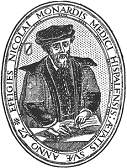



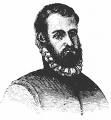

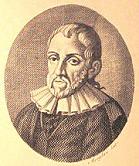
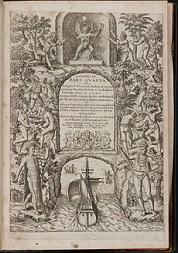

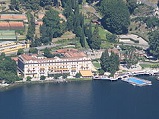
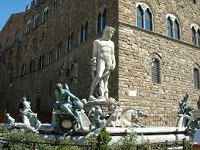
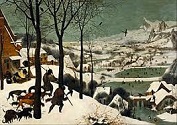
1565 On Jan. 26 the Hindu Vijayanagra Empire suffers a disastrous defeat by invaders from the Muslim sultanates of the Deccan to the N at the Battle of Talikota, and the royal capital of Vijayanagra is destroyed, greatly weakening the empire. On Feb. 13 Spanish conquistador Miguel Lopez de Legazpi (1502-72) and his navigator (Augustinian friar) Andres de Urdaneta (1498-1568) arrive from Acapulco, New Spain (Mexico) in the Philippines, and on June 24, 1571 after conquistador Miguel Lopez de Legazpi conquers it from the Muslims found the city of Manila on Manila Bay in the South China Sea (modern-day pop. 1.8M/12.8M); in July they and found the city of Manila on Manila Bay in the South China Sea (modern-day pop. 1.8M/12.8M); in July they discover a good route back to Acapulco, which becomes known as Urdaneta's Route, and Legazpi returns as royal gov. of the Philippines to establish the "China route" through the "Spice Islands"; Augustinian friars follow and become a force in the islands, later joined by other orders, incl. Franciscans, Jesuits, Dominicans, and Recollects; tequila (distilled agave nectar) begins to be exported from Mexico via the Camino Real through the Sierra Madre Mts.; galleons are built in Barra de Navidad for the route from Veracruz to Spain. In Feb. after the Old English (descendants of those who moved to Ireland in the 12th-13th cents.) families Butler of Ormonde and Fitzgerald of Desmond in Munster in S Ireland almost end their 13th cent. feud with the "Battle That Never Was" in 1560, when the widowed Countess of Ormonde marries the Earl of Desmond, only to die in 1564, leaving her Protestant pro-Elizabeth I son Thomas Butler, 10th Earl of Ormonde (1531-1614) and his Roman Catholic hereditary enemy Gerald Fitzgerald (FitzGerald), 15th Earl of Desmond (1533-83) (head of the Geraldines) to go back to their billy goat ways, they escalate it to all-out war and fight the private Battle of Affane in County Waterford in Munster in SE Ireland, one of the last private battles in the British Isles, which is a V for the Butlers but leads to the Desmond Rebellions in 1569-73 and 1579-83 in Munster; the feud doesn't end until 1629. On Mar. 1 the city of Rio de Janeiro ("January River") (Sao Sebastiao do Rio de Janeiro) (modern-day pop. 6.4M/12.3M) in Brazil is founded, becoming a favorite target for French buccaneers and pirates; on Jan. 27, 1763 the colonial admin. of Portuguese Am. is moved there from Salvador, after which in 1808 the Portuguese royal family and nobles flee Napoleon's invasion of Portugal there. On May 18-Sept. 11 the Great Siege of Malta sees the Ottoman Muslims unsuccessfully try to take Malta from the Hospitallers (Order of St. John) under grandmaster (since 1557) Jean Parison de la Valette (1494-1568); the Battle of Malta (the last battle of the Crusades?) ends cross-slappin' happily for the Crusaders with the arrival of Spanish troops, forcing the Turks to abandon their seige after losing 25K-35K, vs. 2.5K troops, 500 slaves, and 7K civilians for the Christians, after which the siege becomes one of the most celebrated events of the cent. in Christendom, ending the aura of Ottoman invincibility and beginning the era of Spanish domination of the Mediterranean; Ottoman Gen. Dragut is KIA by cannon fire from Ft. St. Elmo in Il-Qortin (modern-day Sliema); French biographer Seigneur de Brantome, Seigneur de Bourdeille joins the expedition sent to Malta to assist the Knights of St. John, and later goes to Italy, Africa, and Hungary to gain mucho material for his cool memoirs; the 9/11 attack is meant to get even for this D along with the one in Vienna in 1683? On July 29 after Elizabeth I sends Sir Nicholas Throckmorton in vain in May to try to prevent it, Queen Mary Stuart of Scotland marries her 2nd hubby, handsome Catholic 2nd cousin Henry Stuart, Lord Darnley, Duke of Albany (1545-67), whom she had just met on Feb. 14 after Elizabeth I pitched him at her in a plot to get her to fall for him then forbid her from marrying an English subject, but falls in love with and refuses to send back (ah, the wrong night?); she holds the ceremony at Holyrood at 6 a.m. to prevent rioting over the Catholic rites; on June 30 she declares the arrogant prick king of Scotland to stony silence without approval by anybody, and is forced to quiet near revolts by Protestants who hoped she'd marry one of theirs; the "crown matrimonial" is not hers to give anyway; meanwhile James Stuart, earl of Moray (Murray) flip-flops, going back to supporting John Knox (1505-72), and on Aug. 26 stages the unsuccessful Chaseabout Raid against Mary with other Protestants, which Knox sits out, withdrawing to Kyle in Ayrshire in 1566; Mary takes personal control, and recalls the earl of Bothwell from exile in France to suppress Murray's revolt, getting him chased to England; Mary becomes preggers in the fall, and jealous prick Darnley targets Mary's Italian secy. David Rizzio (Riccio) (1533-66), while treasonably plotting with sympathetic nobles to gain the crown matrimonal and put himself in charge. On Aug. 28 after Florida (Fla.) is settled by French Huguenots, troops sent by Spanish King Philip II, led by adelantado adm. Pedro Menendez de Aviles (Menéndez de Avilés) (1519-74) found the Spanish city of St. Augustine (San Augustin) (modern-day pop. 14K), with the parish church run by Padre Lopez, and build the massive coastal fort Castillo de San Marcos, designed by Ignacio Daza; on Sept. 20 they capture Huguenot-held Ft. Caroline, and in Oct. wipe out a Huguenot relief force under Jean Ribault in the Mantanzas Inlet, hanging their bodies with the legend "Not as Frenchmen but Lutherans"; the Spanish go on to build presidios and posts across the area and support the establishment of missions by Jesuits and Franciscans as far N as Va. On Dec. 9 Pope (since 1559) Pius IV (b. 1499) dies. In Dec. winter in N Europe is super-cold, killing birds and fruit trees; on Dec. 25-Jan. 13 the Thames River freezes solid, and Elizabeth I becomes fond of daily trips on the ice. HRE Sigismund II introduces the Jesuits into Poland-Lithuania to stop the pesky Protestants, Calvinists, and Anti-Trinitarian Arians. Ivan IV the Terrible creates the Oprichnina, an order of black-cowled oprichniks (the original Dark Riders?), who instill terror throughout Russia. Veera Kerala Varma dies, and Keshava Rama of Varna (-1601) becomes ruler of little, out-of-the-way Cochin. Torquato Tasso (1544-95) becomes court poet at Ferrara. The Royal Exchange of London is founded by Sir Thomas Gresham (1519-79) as the commercial center of London, and officially opened by Elizabeth I on Jan. 23, 1571; his family symbol of a grasshopper is used in its weathervane. The 300-ton Spanish Basque galleon San Juan sinks in Red Bay, Canada; it is recovered in 1978. Dutch painter Arnold Bronckhorst (Bronckorst) begins his career in Scotland, becoming James VI's court painter (until 1583), painting him as a cute little boy in 1574 et al. Women first perform as actresses in Italy. A paper mill is founded in Moscow. Italian missionary in Japan Father Louis Almeida writes a letter containing the first news of Japanese tea in Italy, with the soundbyte: "The Japanese are very fond of an herb agreeable to the taste, which they call chia." Architecture: The 4.2m-tall Fountain of Neptune in Florence, Italy, designed by Baccio Bandinelli after being commissioned in 1559 by Cosimo I de' Medici is finished in time for the wedding of Francesco de' Medici to Grand Duchess Johanna of Austria; too bad, the local pop. thinks that it stinks, and nickname it "Il Biancone" (the White Giant); a fountain is completed by 1575; on Aug. 4, 2005 three vandals cut of one of Neptune's hands holding a trident; it is restored in 2007. The Renaissance Villa d'Este (originally Villa del Garovo) in Cernobbio on the shores of Lake Como in N Italy is begun (finished in 1570) by Milan-born Bolognese architect Pellegrino Tibaldi (Pellegrino di Tibaldo de Pellegrini) (1527-96) as a residence for Cardinal Tolomeo Gallio, complete with a Renaissance garden, becoming a luxury resort for the elite; in 1749-69 it is used by the Jesuits for spiritual exercises; in 1815 it is acquired by Caroline of Brunswick after leaving her hubby future George IV, who relandscapes the 25-acre park in the English style; in 1873 it becomes a luxury hotel; in 1848 wealthy silk manufacturer Carlo Sacchi was murdered by his lover Countess Pia Bellentani during a gala dinner using his Fegyverzyar automatic pistol. Science: The Royal College of Physicians in London is empowered to carry out human dissections. The first known drawings of fossils are pub. by Swiss naturalist Conrad Gessner (Konrad von Gesner) (1516-65); meanwhile after graphite was discovered last year in Cumberland, the first Graphite (Plumbago) Pencils (invented by von Gesner) begin to be manufactured in England from graphite mined in Borrowdale in the Lake District of N England, the purity being so high that it corners the Euro market. In this decade the fictitious island of Friesland (Frisland) (Frischlant) (Frisianda) (Frislandia) (Fixland) (Fer Island) (Fair Isle) off the S coast of Greenland begins appearing on maps, not being discovered to not exist until the mid-18th cent. Nonfiction: Jacobus Anconcio, Stratagemata Satanae; advocates religious toleration? St. Teresa of Avila (1515-82), The Way of Perfection. Girolamo Benzoni (1519-?), History of the New World (Historia del Mondo Nuovo) (Venice); dedicated to Pope Pius IV; written after a stay of 15 years, bristling with hatred for the Spanish and full of errors, but important for the controversy over the treatment of Native Ams.; French trans. pub. in 1579; German trans. pub. in 1579; English trans. by William Henry Smyth pub. in 1857. Theodore Beza (1519-1605), Parallel New Testament; his own trans. (1556), the Greek text, and the Latin Vulgate; 2nd ed. 1582. Thomas Cooper (1517-94), Thesaurus Linguae Romanae et Britannicae (Cooper's Dictionary); big hit, praised by Elizabeth I, followed by 3 more eds., used by William Shakespeare, getting him elected bishop of Loncoln on Feb. 4, 1571, and translated to Winchester on Mar. 12, 1584. Nicolas Monardes (1493-1588) Historia medicinal de las cosas que se traen de nuestras Indias Occidentales (Medical study of the products imported from our West Indian possessions) (2 vols.); 2nd ed. 1569; 3rd ed. 1574; first description of "el tobaco" and other Am. plants, praising tobacco smoke as a panacea. Pierre de la Place, Histore de Nostre Temps. Charles Stephens, Dictionarium Historico-Geographicum; the first modern European geographical dictionary, chock full of serious errors. Bernardino Telesio (1508-88), De Rerum Natura Luxta Propria Principia (On the Nature of Things According to Their Own Principles); bases his theory on not matter and form but matter and force, the latter consisting of heat (which expands) and cold (which contracts); too bad, his attacks on Aristotelianism piss-off the Church, and his books are banned for awhile after his death. Art: Giovanni da Balogna, Samson. Pieter Brueghel the Elder (1525-69), A Country Wedding; The Corn Harvest; The Hunters in the Snow (Return of the Hunters); stark portrayal of global cooling? Tintoretto (1518-94), Flight into Egypt. Poetry: Remy Belleau (1528-77), La Bergerie (1565-72); a mixed verse-prose work modeled on Jacopo Sannazaro's "Arcadia" (1544). Thomas Craig (1538-1608), Epithalamium; in honor of the marriage of Mary, Queen of Scots and Lord Darnley. Pierre de Ronsard (1524-85), Elegies. Giambattista Cinzio Giraldi, Ecatommiti; collection of moral and love stories. Arthur Golding (tr.), Metamorphoses, Books 1-4. Births: English celeb Elizabeth "Bess" Raleigh (nee Throckmorton) (d. 1647) on Apr. 16; daughter of Sir Nicholas Throckmorton (1515-71); wife (1591-) of Sir Walter Raleigh (1554-1618); mother of Damerei Raleigh. Italian poet-writer Alessandro Tassoni (d. 1635) on Sept. 28 in Modena. Italian scientist (archenemy of Galileo) Lodovico delle Colombe (d. 1616) in Florence. English miniature portraitist (Huguenot) Isaac Oliver (d. 1617) in Rouen, France; emigrates to England in 1568. Anglo-Welsh poet Sir John Davies of Hereford (d. 1618); not to be confised with Sir John Davies (1569-1626). French Jesuit missionary (to Am.) Pierre Biard (d. 1622) in Grenoble. Georgian queen (Christian) (St.) Ketevan the Martyr (d. 1624); daughter of Prince Ashotan of Mukhrani (Bagrationi); wife of David I of Kakheti. English adventurer Sir Anthony Shirley (Sherley) (d. 1635) in Wiston, Sussex; 2nd son of Sir Thomas Shirley Sr. (1542-1612); brother of Sir Thomas Shirley Jr. (1564-1620) and Sir Robert Shirley (1581-1628); educated at Oxford U. French feminist writer Marie de Gournay (d. 1645). Am. Narragansett Indian chief (during the 1620 Mayflower landing) Canonicus (d. 1647). Deaths: Ottoman Greek adm. Dragut Reis (b. 1485) on June 23 in Malta (KIa). French Protestant reformer William Farel (b. 1489). French bibliophile Jean Grolier de Servieres (b. 1489) on Oct. 22 in Paris. German-Danish Protestant gen.-statesman Johan Rantzau (b. 1492) on Dec. 12. Italian Pope (1559-65) Pius IV (b. 1499) on Dec. 9. Spanish conquistador Francisco de Montejo, El Mozo (b. 1502) on Feb. 8 in Merida. German-Swiss naturalist Konrad von Gesner (b. 1516). Dutch composer Cyprien de Rore (b. 1516). French navigator Jean Ribault (b. 1520) on Oct. 12 in St. Augustine, Fla. Italian mathematician Ferrari (b. 1522). Italian cardinal Ranuccio Farnese (b. 1530) on Oct. 29.


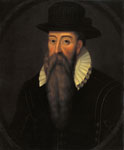









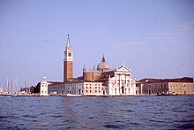
1566 On Jan. 7 Milan-born Dominican grand inquisitor (cardinal since 1557) Antonio Michele (Michaele) Ghisleri (Ghislieri) is elected Pope (#225) (St.) Pius V (1504-72) (until May 1, 1572) immediately showing his blood-red saintly colors by opposing all religious tolerance, enforcing the decrees of the Council of Trent, aiding French Huguenot persecution, and expelling Jews from the Papal States, mobilizing all his resources to punish those pesky heretics who don't recognize him as the one and only maximum bridgemaker to God? On Mar. 9 David Riccio (Rizzio) (b. 1533) is murdered by Lord Darney, Lord Ruthven, Lord Lindsay, Mary's Protestant stepbrother John Erskine, 1st Earl of Mar (-1572) et al. in Holyrood Palace in front of pregnant Mary, Queen of Scots, almost causing her to miscarry and turning her against Darnley, starting by pardoning the lords involved in the Chaseabout Raid who were not involved in Riccio's murder; on June 19 she bears Prince James (future James VI) in Edinburgh Castle, giving Scotland a male heir, weakening her grip on the throne rather than strengthening it (the Stewart disease?); too bad, for safety she sends the infant to Stirling Castle in the care of the Earl and Countess of Mar, where he is baptized a Roman Catholic in Dec. in a magnificent rite; a blood stain on the wooden floor left by dying Rizzio remains to modern times. On Mar. 28 Hospitaller grandmaster Jean Parisot de la Valette founds the city of Valletta (modern-day pop. 6.4K) in Malta on the slopes of Mount Sciberras near Ft. St. Elmo, which held out to the Turks for 30 days; the city goes on to become known as "Superbissima" (Most Proud) as it holds out against pesky Muslims. In Apr. the Ottoman navy captures Chios from the Genoese. In May despite the 1562 truce, Ottoman sultan (since Sept. 30, 1520) Suleiman (Suleyman) I the Magnificent (b. 1494) leaves Constantinople with 100K-300K troops in his last Hungarian campaign against the Hapsburgs, with the goal of capturing Vienna; on Aug. 6-Sept. 8 the Battle of Szigetvar (Szigeth) in Croatia near the Hungarian border sees 2.3-3K Croatians under Nikola Subic Zrinski (1508-66) defend their fort to the last man after killing 20K Ottomans, holding back the Ottoman attack on Vienna, causing Cardinal Richelieu to later call it "the battle that saved civilization"; after capturing the strategic fort of Gyula (until 1694), Suleiman I falls ill and dies on Sept. 5/6/7, and is succeeded as Ottoman sultan #11 (until 1574) by his blonde-haired sauce-loving only surviving son Selim II (the Yellow) (the Sot) (1524-74), who takes the title of "Universal Lord of Everything Under the Sun, Descendant from Divine Lineage, Destroyer of the Christian Faith, Dominator of the Universe", then retires to his harem, leaving affairs of state to his Bosnian grand vizier Pasha Mehmet Sokullu (Sokollu) (1506-79), causing his princes to do the same, setting a bad example for the future as palace hos find a chance to rule behind the sultan's skirts, er, whatever they wear?; Jewish financier Don Joseph Nasi becomes the sultan's diplomatic rep. and is appointed duke of Naxos; he and his aunt Dona Gracia Mendes finance the rebuilding of Tiberias in Palestine as a center for Jewish learning, unsuccessfully trying to resettle Jews there; Suleimen's internal organs are buried in a shrine on the top of a hill near Szigetvar, which is destroyed in 1692 by the Hapsburgs, after which they are moved to the Szuz Maria Church 3km NE of the fortress. The closest thing Roman Catholicism has produced to an uncrowned pope sets up permanent shop in Salon? On June 17 after contracting dropsy, Nostradamus (b. 1503) writes his will, then dies on July 1 after being given the last rites by a local French priest; he is buried upright in a wall of the Church of the Cordeliers at Salon, and leaves his wife Anne 3,444 crowns; his grave is opened by superstitious soldiers during the French Rev., then reburied at the Church of St. Laurent in Salon. On Aug. 1 Catherine de' Medici finally leaves off mourning for her dead hubby Henri II seven years after his death; meanwhile her man Michel de l'Hopital gets an edict promulgated reforming abuses in the admin. of justice in France. In summer the Beeldenstorm (Ger. "iconoclastic outbreak"), a wave of image-breaking begins, spreading through the Low Countries, with Calvinists destroying statues of Catholic saints in hundreds of churches and monasteries, which causes Netherlands gov. Margaret of Parma to promise to give Dutch noblemen more power and abolish the Inquisition, only to be countermanded by her brother Philip II. Sir Hugh O'Donnell (-1600) becomes king of Tyrconnell in Ulster, Ireland, seeing his sons stage a violent succession dispute in the 1580s until he abdicates in 1592 in favor of son "Red" Hugh Roe O'Donnell. Emperor (since 1521) Ming Shi Zong (Jiajing) (b. 1506) dies, and Ming Mu Zong (Mu Tsung) (-1573) becomes Ming emperor #12 of China (until 1573). Italian Latin and Greek prof. Antonius Palearius is burned in Rome as "Inquisitionis Detractator" for calling the Inquisition a dagger pointed at the throats of lit. men; proof of his heresy is that he signs his name as Aonius, proving he hates the sign of the cross? Barom Reachea I (d. 1576) becomes king of Khmer (Cambodia). Heinrich Bullinger unites Calvinism and Zwinglianism in the Second Helvetian Confession - a lot of it is a blur but I'll try to remember? Duke Albrecht I of Prussia, who since the 1552 death of his mentor Andreas Osiander has increasingly become an old fart under the control of Osiander's son-in-law, German Lutheran preacher Johann Funck (Funk) (Funccius) (1518-66) and Croatian adventurer and self-proclaimed know-it-all encyclopedic Croatian writer Stanislav Pavao (Paul) Skalic (1534-73) (who both used him to get rich), is finally reined-in by the estates, who get his cousin Sigismund II Augustus of Poland to send a commission to Konigsberg, which on Oct. 28 has Funck executed and Scalic condemned, saving himself by fleeing; Albrecht's only son Albrecht Frederick (b. 1553) is confirmed as his heir, with a regent appointed, Lutheranism is confirmed as Prussia's state church, and the old fart lives two more years stripped of power, living with his 2nd wife Anna Maria, daughter of Duke Eric I of Brunswick-Luneburg. Volcanic 18,700-ft. Pico de Orizaba (Citlaltepetl) in S Mexico between Mexico City and Veracruz (highest peak in Mexico and 3rd highest in North Am. after Mount McKinley and Mount Logan) erupts. 20-y.-o. Father of the Nerds, Danish astronomer Tycho Brahe (1546-1601) (pr. TOO-koh BRA-huh) loses part of his nose in a duel in Wittenberg at the U. of Rostock with fellow student Manderup Parsbjerg over a math equation, and gets a metal (gold-silver) replacement - the first German bra? The first newspapers take the form of Avvisi (It. "advice", "announcement"), weekly handwritten news sheets folded to form four pages circulated in Venice, Italy, filled with news of politics and war; the first printed newspapers appear in Germany in 1605. Architecture: Andrea Palladio begins the Church of San Giorgio Maggiore in Venice (finished in 1610), known for its brilliant white marble which gleams above the blue water of the lagoon opposite the Piazzette, forming the focal point of every view from the Riva degli Schiavoni. Nonfiction: Jean Bodin (1530-96), Methodus ad Facilem Historiarum Cognitionem (Method for the Easy Knowledge of History); rejects Franciscus Patricius, emphasizing the role of knowledge of politics and legal systems in interpreting historical writings, also social life, rejecting the pagan Golden Age and Biblical Four Kingdoms of Daniel models of history; "Of history, that is, the true narration of things, there are three kinds: human, natural, and divine." Diego de Landa (1524-79), Relacion de las Cosas de Yucatan; catalogs the Mayan language, religion, culture and writing system, ordering two Mayans to write down the symbols for each letter in the Spanish alphabet, not realizing that the Mayan script is syllabic, and therefore produces duplications and inconsistencies; funny justice, it's by the same guy who orders all Mayan writings burned, and in 1952 Russian linguist Yuri Valentinovich Knorosov (Knorozov) (1922-99) uses his work to crack Mayan writing, although only an abridged vers. survived, discovered in 1862 by French cleric Abbe Charles Etienne Brasseur de Bourbourg (1814-74), and pub. in 1864. St. Teresa of Avila (1515-82), Autobiography. Plays: George Gascoigne (1539-78), The Supposes; based on Lodovico Ariosto's "Gli Suppositi"; the first English prose comedy?; source of William Shakespeare's "Taming of the Shrew"? - I promise to keep doing this if you'll keep laughing? Art: Giuseppe Archimboldo (1527-93), The Librarian. Titian (1477-1576), Self-Portrait (1560?). Novels: William Adlington (tr.), Apuleus Golden Ass. Willliam Painter (1540-95), The Palace of Pleasure Beautified (2 vols.) (1566-67) (combined ed. 1575); a tr. of a collection of 94 Italian novellas, allegedly used by Shakespeare as a source of several plots. Births: French nun Barbe Jeanne Acarie (Madame Marie of the Incarnation) (Barbara Avrillot) (d. 1618) on Feb. 1 in Paris; founder of the Discalced Order of Carmelite Nuns; feast day: Apr. 18. Italian shockingly intense madrigal composer-murderer Carlo Gesualdo da Venosa, Prince of Venosa and Count of Conza (d. 1613) on Mar. 30 in Venosa. Ottoman fratricidal sultan #13 (1595-1603) Mehmed III Adli (d. 1603) on May 26 in Manisa; son of Murad III (1546-95); father of Ahmed I (1590-1617). English king (1603-25) and Scottish Stewart king (1567-1625) (Freemason) James I of England (James VI of Scotland) (d. 1625) on June 19 in Edinburgh Castle; only son of Mary Stuart (Stewart), Queen of Scots (1542-87) and Henry Stewart, Lord Darnley (1545-67). Polish king (1587-1632) and Swedish king (1592-9) Sigismund (Zygmunt) III Vasa (Wasa) (d. 1632) on June 20 in Gripsholm Castle, Sweden; son of John III of Sweden and his 1st wife Catherine Jagellonica of Poland; Swedish nephew of Sigismund II (son of King John). English #1 Elizabethan actor Edward Alleyn (d. 1626) on Sept. 1 in Bishopsgate, London; being tall helps. English soldier-courtier Robert Devereux, 2nd Earl of Essex (d. 1601) on Nov. 10 in Netherwood, Cumbria; son of Walter Devereux, 1st earl of Essex (1539-76) and Lettice Knollys (1540-1634); favorite of Elizabeth I, and stepson of her lover Robert Dudley, earl of Leicester, who marries Lettice in 1578. English explorer Henry Hudson (d. 1611). Portuguese missionary to China Jean de Rocha (d. 1623). Dalmatian archibishop-scientist Marco Antonio de Dominis (d. 1624) in Arbe Island; educated at Loreto College (Jesuit), and U. of Padua. Italian musician-priest Pietro Cerone (d. 1625) in Bergamo. English traveler Fynes Moryson (Morison) (d. 1630) in Lincolnshire; educated at Peterhouse, Cambridge U. Italian Mannerist-Baroque painter and art historian Giovanni Baglione (AKA Il Sordo del Barozzo) (d. 1643) in Rome; pupil of Francesco Morelli. English soldier-colonizer Sir Ferdinando Gorges (d. 1647) in Ashton, Somersetshire. Dutch painter-engraver Abraham Bloemaert (d. 1651) in Dordrecht; influenced by Italian rather than Dutch masters. Deaths: Spanish missionary-historian Bartolome de Las Casas (b. 1484) on July 17 in Madrid; leaves Historia General de las Indias, which isn't printed until 1875 - after there aren't any Indians left? Italian poet Marcus Hieronymus Vida (b. 1485) on Sept. 27. German diplomat-historian Sigismund von Heberstein (b. 1486) on Mar. 28. German prince Wolfgang of Anhalt-Kothen (b. 1492) on Mar. 23 in Zerbst. German Protestant preacher Johann Agricola (b. 1494) on Sept. 22 in Berlin. Ottoman sultan (1520-66) Suleiman I the Magnificent (b. 1494) on Sept. 5/6/7 in Szigetvar, Hungary (near the modern-day Hungarian-Croatian border); his tomb is discovered in 2016. French noblewoman Diane de Poitiers (b. 1499) on Apr. 25 in Anet, Eure-et-Loir; killed by drinking too much gold? Spanish composer Antonio de Cabezon (b. 1500). German botanist Leonhard Fuchs (b. 1501) on May 10 in Tubingen; the genus Fuchsia (AKA the Earring) of the evening primrose family is named for him by Linnaeus - release the hummingbirds? French profound prognosticator Nostradamus (b. 1503) on July 1. French physician and anatomist Guillaume Rondelet (b. 1507) on July 30. Croatian ban (1542-56) Nikola Subic Zrinski (b. 1508) on Sept. 7 in Szigetvar, Hungary. Italian artist Daniele Ricciarelli da Volterra (b. 1509) on Apr. 4 in Rome. German Lutheran theologian Johann Funck (b. 1518) on Oct. 28 in Kneiphof (executed). French humanist Renaissance poet Louise Labe ("La Belle Cordiere") (b. 1520). English diplomat Thomas Hoby (b. 1530) on July 13. Italian secy. David Riccio (b. 1533) on Mar. 9 in Holyrood House, Edinburgh (murdered).



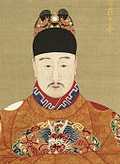


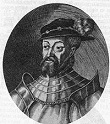
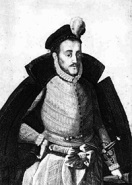
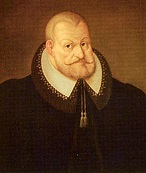
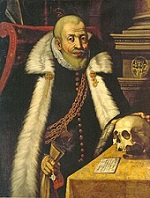


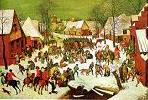
1567 By this year 2M South Am. natives die of typhoid fever - run that by me again? Be nice to Dutch Protestants, yes, and or duh, my bad? The Dutch Protestant revolt against Spain and its Roman Catholic inquisitors (ends 1648) heats up when oh-so-bloody Catholic Spanish "Iron Duke" Fernando Alvarez de Toledo y Pimentel, 3rd Duke of Alva (Alba) (1507-82) (whited sepulcher?) is dispatched from Spain with 24K soldiers (incl. 10K of Europe's best soldiers), 6K horses, and 2K hos with orders to stamp out the heretical rebels, causing Calvinists and Lutherans to flee, incl. Flemish prince William I the Silent of Orange (1533-84), who up till now had been a tolerant Catholic, HRE Charles V's favorite in his teens, who had been awarded governorship of three N Netherlands provinces, but is financially involved with several rebels; in Aug. Alva arrives, and on Sept. 9 founds the Council of Troubles (Blood Council), a kangaroo star chamber without legal status which often convicts people just for being wealthy so they can rob them, and goes on to become such a mean ass that he whips the Dutch into a full-scale war of independence after summoning 10K to the Blood Council, incl. William I the Silent, who fails to appear, is declared an outlaw and forfeited, turning him into the rebels' leader, financing the Watergeuzen (Sea Beggars) (coastal corsairs), and organizing an army of German Protestant mercenaries; meanwhile Alva arrests Flemish statesmen Count Lamoral of Egmont (1522-68) and Count Philip de Montmorency Hoorn (1518-68), condemns them and confiscates their property, becoming his biggest fish-kills; Margaret of Parma resigns her regency in his favor and returns to Italy; if you're caught with a Bible or Protestant lit. in the Low Countries your ass is grass and Alva's got the lawnmower; "Alva's six-year reign was to be an unforgettable reign of terror in which the Spanish government attemped forcibly to uproot the now firmly entrenched Protestantism of the Northern provinces" (New Catholic Encyclopedia); to help him Pope Pius V's Holy Office condemns all 3M Netherlanders to death as heretics, a decree confirmed by his boss Philip II of Spain. On Jan. 23 emperor (since May 27, 1521) Jiajing (b. 1507) dies, and on Feb. 4 his speech-impaired son Longqing ("great celebration") (Zhu Zaihou) (1537-72) (AKA the Prince of Yu) becomes Ming emperor #12 of China (until July 5, 1572). On Feb. 10 Mary, Queen of Scots' husband Darnley, who had refused to rule as consort of the Queen but wanted to rule as king is assassinated in Kirk-on-Field in Edinburgh, the house being blown up early in the morning and his body mysteriously found lying on the lawn of a nearby garden without a scratch on it, probably the work of her boyfriend James Hepburn, 4th earl of Bothwell and his agents in revenge for his killing of Riccio); Bothwell is put on trial for the murder, appears with 4K armed retainers and is quickly acquitted; on Apr. 24 he kidnaps Mary while she is returning to Edinburgh from Stirling, takes her to Dunbar, "ravishes" (with devilish charm) then marries her on May 15 in a Protestant ceremony, becoming her 3rd hubby after first divorcing his 1-year wife Jean Gordon, sister of the earl of Huntly, and being created duke of Orkney and Shetland; they enjoy a brief honeymoon at Borthwick Castle S of Edinburgh before they are separated forever, Mary climbing out a window dressed as a page boy after the pissed-off Catholic and Protestant Scottish nobles revolt, with the "King's Men" favoring young Prince James opposing the "Queen's Men" who want to keep Mary in power; on June 15 she surrenders at Carberry Hill near Musselburgh (E of Edinburgh) after Bothwell and her Queen's Men desert, and she is captured, paraded through Edinburgh in front of hostile crowds, and imprisoned at Lochleven Castle on an island in the middle of a lake in Kinross; on June 20 after Elizabeth I sends Sir Nicholas Throckmorton to Scotland with instructions to talk the barons into restoring Mary (which he personally disagrees with), Mary's Casket Letters to Bothwell are discovered by James Douglas, earl of Morton, incriminating her as an accessory to murder; on July 23 she miscarries twins while being pressured to abdicate, which she does on July 25, handing the throne over to 1-y.-o. "cradle king" James VI (1566-1625), who is crowned on July 29 at Stirling; Throckmorton pisses Elizabeth I off by revealing her instructions to the Scottish barons and is recalled in Aug.; Bothwell escapes to Orkney and Shetland, becomes a pirate leader, dodges the English, and reaches Norway, then ends up in Copenhagen, where he promises the Danes to restore the Orkneys and Shetlands to them for good treatment; only seven lords show up at James VI's coronation on July 29 (worst attendance at a Scottish coronation), where John Knox gives a sermon certifying the Scottish Protestant Kirk as PC in Scotland, which ends up being governed by a succession of regents during the king's minority, beginning with his half-uncle James Stewart, earl of Moray (until 1570); the earl and countess of Mar raise the king tough-love style without parental affection, and have him turned into a Protestant and serious scholar by humanist terrorist ("spare the rod and spoil the child") tutor George Buchanan (1506-82), who is fond of calling Queen Mary a whore, causing him to like to call himself "Without father or mother, brother or sister" - if I was a dog I'd like to sniff some of my friends at the park and chase an occasional tennis ball? Hesse becomes a Messe? On Mar. 31 Philip I the Magnanimous (b. 1504) dies, and the landgraviate of Hesse is partitioned among his four sons; only two lines, Hesse-Darmstadt, founded by George I of Hesse-Darmstadt (1547-96) (ends 1806), and Hesse-Cassel (Hesse-Kassel) (ends 1803), founded by William IV, Landgrave of Hesse-Cassel (1532-92) survive to the 19th cent., the others, Hesse-Hanau and Hesse-? being absorbed by the others, and Hesse-Darmstadt (capital in Darmstadt) ending up with most of the pie. In Sept. Hans Steininger, known for having the longest beard in the world stumbles on it while climbing the staircase leading to the council chamber of Brunn in Austria, then falls down the stairs and dies. On Nov. 10 the Battle of Saint-Denis near Paris sees a 16K-man Roman Catholic army led by Duke Anne de Montmorency (1493-1567) attack 3.5K Huguenots under the prince of Conde, who hold them off for several hours and mortally wound Montmorency before being driven off; Montmorency dies in Paris on Nov. 12; Swiss military leader Ludwig Pfyffer (1524-94) safely leads the royal family of Charles IX from Meaux to Paris under Huguenot attack, making him a celeb. On Nov. 28 the first potatoes arrive in Antwerp from Las Palmas, Canary Islands, becoming the first formal arrival of potatoes in Europe; between 1588-93 more potatoes arrive in the British isles in the baggage of sailors along with plundre. Akbar the Great conquers Chitor. Oda Nobunaga attempts to depose the shogun and centralize the Japanese govt. Myonjong dies, and Sonjo (-1608) becomes Yi king of Korea. The Zaydi Revolt in Yemen against the Ottomans led by the Zaydi imam begins (ends 1570), capturing almost the whole country except Zabid. HRE Maxmilian II establishes a monastery council to superintend the clergy. After all the shenanigans of Queen Mary, the Scottish Marriage Act is passed, prohibiting all marriages not allowed by Leviticus ch. 18, incl. a man marrying his deceased wife's sister, all of which is considered incest, and punishable Biblically with death, while incest per se is not a crime in England. After sexual deviance becomes defined as religious heresy, 71 men are burned in Seville, Spain for pecado nefando (anal intercourse with other men) - doctor doctor, can you tell me what's ailing me? Sir John Hawkins makes his Third Voyage to the West Indies, accompanied by his 2nd cousin Francis Drake, and after taking 400 slaves to Vera Cruz he is ambushed by the Spanish, losing one of his three ships before barely making it home, later recouping some of the lost dough by writing the bestseller An Alliance to Raid for Slaves, portraying the slaving biz as that's the way to do it, money for nothing and chicks for free. Alvaro (Álvaro) de Mendana (Mendaña) de Neyra (1541-95) of Spain sails from Callao in Nov. to explore Melanesia in the Pacific, discovering the Solomon Islands 500 mi. E of New Guinea next year; Francisco Fajardo unsuccessfully tries to found a plantation there in 1562. Caracas (Santiago de Leon de Caracas) (modern-day pop. 1.9M/2.9M) in Venezuela is founded on July 25 by Diego de Losada (1611-69) in a fertile Caracas Valley 3K ft. above sea level (6 mi. SE of the Caribbean port of La Guaira) (in the crack of the valley's what?), becoming the first important settlement in Venezuela. The Rugby School for boys in Warwickshire in C England is founded by the will of wealthy townsman (grocer to Elizabeth I) Lawrence Sheriff (1510-67). The Red Lion Theatre in Whitechapel (modern-day Tower Hamlets) outside London is built, becoming the first permanent theater in England built since Roman times; too bad, it folds after presenting The Story of Samson because it's built on open farmland that's too hard to get to in the winter. Armenian priest Apkar of Sivas founds the first Armenian printing press in Constantinople after studying in Venice. Elizabeth I founds a grammar school in the thriving market town of Blackburn, which later becomes England's cotton weaving center and the birthplace of spinning jenny inventor James Hargreaves (b. 1720). The first bardic competitions since the 12th cent. are held in Wales. The Eastern Orthodox Church names its first doctors: Sts. Athanasius, Basil, Chrysostom, and Gregory of Nazianzus; the Roman Catholic Church, who beat them to the punch in 1298 proclaims St. Thomas Aquinas a doctor of the Roman Catholic Church - I didn't know it was sick? Russian travelers Ivan Petroff and Boornash Yalysheff return from China, bringing the first news of tea to Russia. Architecture: The St. Trinita Bridge in Florence, Italy is built. Inventions: In 1567 Italian mathematician Fabrizio Mordente (1532-1608) pub. the first description of the Proportional (Military) Compass (Sector). Nonfiction: Francisco Balbi di Correggio (1505-89), Journal of the 1565 Siege of Malta. Philibert Delorme (1514-70), The First Book of Architecture (Le Premier Tome de l'Architecture). Francesco Guicciardini (1483-1540), Storia d'Italia (History of Italy) (posth.); the greatest European historical work of the 16th cent., noted for scientific impartiality and for treating Italy as a whole rather than as a group of separate sovereignties. Edward Hake (tr.), Thomas a Kempis' "The Imitation of Christ". George Turberville, Epitaphs, Epigrams, Songs, Sonnets. Poetry: Isabella Whitney (1548-), The Copy of a Letter, Lately Written in Meeter, by a Yonge Gentilwoman to Her Unconstant Lover. Art: Giovanni da Bologna (1524-1608), Mercury (sculpture). Pieter Brueghel the Elder (1522-69), Adoration of the Magi; The Massacre of the Innocents. Jan Luiken, Burning of Dutch Anabaptists by the Inquisition. Titian (1477-1576), Jacopo de Strada. Births: Italian #1 composer Claudio Giovanni Antonio Monteverdi (Monteverde) (d. 1643) on May 15 in Cremona; inventor of the modern opera and the aural sleeping pill (madrigal); pupil of Marco Antonio Ingegneri. Swiss (Geneva) bishop (leader of the Counter-Reformation) (St.) Francis de Sales (d. 1622) on Aug. 21 in Thorens, Savoy. Japanese strongman ("the One-Eyed Dragon") Date Masamune (d. 1636) on Sept. 5 in Yonezwa Castle, Yamagata Prefecture. Dutch prince of Orange (1618-25) (Protestant) Maurice of Nassau (d. 1625) on Nov. 14 in Dillenburg, Nassau; son of William I the Silent (1533-84) and Anna of Saxony (1544-77); brother of prince Philip William of Orange (-1618); half-brother of prince Frederick Henry of Orange (1584-1647); named after maternal grandfather elector Maurice of Saxony. Italian duchess of Savoy Catherine Michelle (Catalina Micaela) (d. 1597) on Oct. 10 in Madrid; daughter of Philip II of Spain (1527-98) and Elisabeth of Valois (1546-68); wife (1585-) of Duke Charles Emmanuel I of Savoy (1562-1630). English pamphleteer-poet-dramatist Thomas Nashe (d. 1601). English Gunpowder Plotter (Roman Catholic) Francis Tresham (d. 1605); son of the sheriff of Northamptonshire. French composer-lutenist Jean-Baptiste Besard (d. 1618) in Burgundy. English "Cherry Ripe", "Whether Men Do Laugh or Weep" poet, musician, physician, and lit. critic Thomas Campion (d. 1620) in London; educated at Cambridge U. Dutch navigator Willem Cornelis Schouten (d. 1625) in Hoorn; first Euro to round Cape Horn, naming it for his birthplace. French explorer (Protestant) (founder of Quebec) ("Father of New France") Samuel de Champlain (d. 1635) in Brouage (near Rochefort), Saintonge; illegitimate son of Henri IV?; makes 27 Atlantic crossings in 1599-1633. Scottish diplomat-poet-dramatist-courtier Sir William Alexander, Earl of Stirling (d. 1640) in Menstrie; courtier for James VI/I; knighted in 1609, and raised to the peerage in 1630; secy. of state for Scotland (1626-40). Dutch merchant (Dutch West India Co. founder) Willem Usselincx (d. 1647) in Antwerp. English "Theatrum Botanicum" herbalist-botanist John Parkinson (d. 1650). Deaths: English lord mayor of London (1553) Sir Thomas White (b. 1492) on Feb. 12. French marshal Anne de Montmorency (b. 1493) on Nov. 12 in Paris. English lord chancellor Sir Richard Rich (b. 1496) on June 12. Spanish conquistador Cristobal de Onate (b. 1504) on Oct. 6 in Panuco, Zacatecas, Mexico. Spanish Escorial architect Juan Bautista de Toledo (b. 1515) on May 19. English royal admin. Thomas Mildmay (b. 1515). Dutch theologian Guido de Bres (b. 1522) on May 31 in Valenciennes (hanged); becomes a martyr. Irish king Shane O'Neill (b. 1530) on June 2 in Cushendun, County Antrim (assassinated). Polish composer Waclaw of Szamotuli (b. 1533). English royal stud Lord Darnley (b. 1545) on Feb. 10 in Kirk-on-Field, Edinburgh (assassinated) - the good die young? Ottoman physician (to Selim I and Suleiman I) (Spanish Jew) Moshe Hamon (b. ?); leaves son Joseph Hamon (d. 1577).
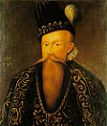

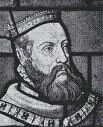


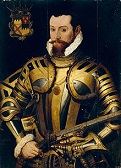

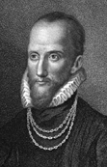

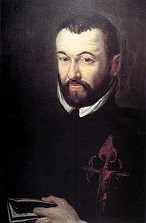


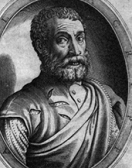


1568 On Feb. 17 after a year of hostilities on the Hungarian frontier the Ottomans under Selim I and the Hapsburgs under HRE Maximilian II sign a peace treaty, which is renewed until 1590. In Feb. after Catherine de' Medici gets in over head in playing off one faction against the other in the religious wars of France, she dismisses Michel de l'Hopital, the last anchor stopping the big Protestant Weenie Roast of 1572? On Mar. 23 the Treaty of Longjumeau in Longjumeau commune 11 mi. S of Paris ends the Second War of Religion in France. In Apr. Sultan Selim II unifies the two provinces in rebel Yemen under one gov. and prepares an expedition to quash the rebels. I'm half going crazy in here? On Mar. 25 Mary Stuart, Queen of Scots escapes from Lochleven Castle in Kinross, Scotland and attempts to reclaim her throne, but is defeated at the Battle of Langside by her half-brother the Earl of Moray on May 13; Secy. Lethington, who might have been involved in Darnley's murder flops and fights with the queen's enemies out of dislike for James Hepburn; on Apr. 3 Sir William Drury (1527-79), hired to spy on her in Lochleven writes a letter to his boss Lord Burghley about her escape to warn him; on May 16 she flees to England, and seeks refuge in the English court, but is put under house arrest by her half-sister Queen Elizabeth I for 19 years until her death, plotting until the end to become queen of England; a conference opens in York to inquire into her conduct, with Thomas Howard, 4th duke of Norfolk as pres. of the investigating commission, keeping Mary in his custody; it later reopens at Westminster; Scotland is now firmly in the control of the Knox Protestants, Moray becomes regent for James VI, and the acts of 1560 in favor of the Reformed religion are ratified by the Estates of the Realm. On May 23 the Battle of Heiligerlee in Groningen in N Netherlands sees the Protestants under William I of Orange's brothers Louis of Nassau and Adolf of Nassau score their first V against a Roman Catholic army led by Jean de Ligne, Duke of Arenberg (b. 1528), who is KIA (along with Adolf of Nassau), pissing-off the Duke of Alva, who has the Count of Egmont and the Count of Hoorn beheaded in Brussels on June 6, then leads an expedition to Groningen, annihilating Louis of Nassau's army on July 21 at the Battle of Jemmingen (Jemgum) in East Frisia (Louis escapes); the gauntlet having been thrown down, on Aug. 13 William I the Silent makes a loud formal declaration of war against the duke of Avarice, er, Alva, beginning the Dutch Eighty Years' War (Dutch Revolt) (ends 1648), during which the seven N Protestant provinces break with the 10 S Catholic provinces (modern-day Belgium) in a war of independence against the cruel Spanish Hapsburg rulers and their Roman Catholic Inquisition; "Father William" at first puts out propaganda that he's not fighting the Spanish monarchy but only foreign invaders and incompetent governors, but later converts to Protestantism and becomes a soldier of the Reformation, his Sea Beggars keeping them afloat despite defeats on land, starting next year when he leads a large army into Brabant, then watches it dissolve when he can't afford to pay them; on Oct. 20 the Battle of Jodoigne in the Spanish Netherlands (modern-day Belgium) sees 21.5K Spanish troops under the Duke of Alba destroy the rear guard of William I the Silent's 30K-man invading army, with 3K Dutch soldiers KIA vs. only 20 Spanish soldiers, forcing him to retreat into Germany; in Nov. Spanish ships carrying £85K loaned to Philip II by Genoan bankers to pay the wages of the Duke of Alva's soldiers founders off Southampton, and the English govt. confiscates the money, Elizabeth I declaring next Jan. that she would assume the loan herself, which pisses-off Philip, who orders his troops in the Netherlands to seize English ships and property; on Dec. 22 Alva makes a triumphal entry into Brussels, then sets up a statue of himself in Antwerp after demolishing two statues representing the nobles and people of the Netherlands - now I'm doing something I enjoy and making a good living? On June 11 Welf prince (since 1514) Henry V the Younger (b. 1489) dies, and his youngest son Julius, Duke of Brunswick-Luneburg (Brunswick-Lüneburg) (1528-89) becomes prince of Brunswick-Wolfenbuttel (until May 3, 1589), going on to embrace the Protestant Reformation, reform the court system, reform the tax system in favor of farmers, and found a citizen militia. On July 13 Alexander Nowell (1507-62), dean of St. Paul's in London leaves his bottle of beer by a river bank for a few days, and when he comes back it "opened with a bang" and was "very tasty", becoming the first known mention of Bottled Beer. In Aug. Sir Peter Carew (1514-75) sails to S Ireland by leave of Elizabeth I to stake a murky legal claim to lands granted to a remote ancestor by Henry II, and ends up stepping on the toes of the Anglo-Norman Butler family, headed by Protestant Sir Thomas Butler, 10th Earl of Ormonde (1531-1614), starting the Desmond Rebellions (1569-73, 1579-83) after they all step on the toes of the Roman Catholic Desmond (Gael. "south Munster") family in Munster, led by the Protestant FitzGerald (Geraldine) family, devastating Munster, slaughtering the rural pop. and stripping them of food and shelter, making them resort to cannibalism; "They looked like anatomies of death; they did eat the dead carrion and one another soon after, insomuch as the very carcasses they spared not to scrape out of their graves" (Edmund Spenser); the fear of marauders destroying their crops causes the Irish to begin relying on potatoes, ending up with overreliance on a single crop and regular famines?; by 1845 potatoes take up one-third of Ireland's cultivated land. On Sept. 30 after a conspiracy between Johan Vasa and his younger brother Charles (later Charles IX), nutso Eric XIV is declared unfit to reign, and Johan (John) III Vasa (1537-92) becomes king of Sweden (until Nov. 17, 1592). Don John (Juan) of Austria (1547-78) is given command of a Spanish naval squadron fighting Barbary pirates. The First Russo-Turkish War (ends 1570) begins over the Astrakhan Khanate, which was conquered in 1566 by Russian tsar Ivan the Terrible; first of 12 Russo-Turkish wars (until 1918). The 2nd Rebellion of the Alpujarras (first in 1499-1501) in the mountainous Alpujarra region of Granada, Spain of Moriscos (Muslim Moors who had been faking Christian conversion) begins (ends 1571), and is viciously put down by HRE Charles V's bastard son Don John of Austria. Oda Nobunaga (1534-82) enters the city of Kyoto and sets up shop in Komaki Castle, beginning a new era of unification in Japan, starting by going after the rival Saito clan, then proceeding to conquer the whole island, with the motto "Tenka Fubu" ("Everything Under the Sky"); after Ashikaga Yoshihide (b. 1538) is named Ashikagi shogun #14 then dies on Oct. 28 from disease, Oda Nobunaga marches on the Japanese capital Kyoto, gains the support of the emperor, and installs his own candidate in the succession struggle for shogun, Ashikaga Yoshiaki (1537-97) (15th and last Ashikagi shogun), brother of shogun #12 Ashikaga Yoshiteru; Jesuit missionaries are welcomed into Japan. Pope Pius V issues the Brevarium Romanum (Roman Breviary), containing the canonical daily hours of Roman Catholic prayer, based on the "Breviarium secundum usum Romanae Curiae", imposing it on the Roman Catholic Church except for the Benedictines and Dominicans; in 1974 Pope Paul VI replaces with the "Liturgy of the Hours". Early in the year Alvaro Mendana de Neyra sights Tuvalu and Ontong Java, then later discovers the Solomon Archipelago. The first modern eisteddfod (pr. eye-STETH-vode) (Welsh bardic competition) is held in Caerwys; Elizabeth I recognizes it. Juan Fernandez de Navarrete (1526-79) "El Mudo" (the Mute) becomes court painter to Philip II of Spain. A botanical garden is established in Bologna, Italy, presided over by Ulisse Aldrovandi and Andrea Cesalpino. The Co. of London Tylers and Bricklayers is incorporated. The Bannatyne Ms. by Scottish student George Bannatyne contains the first known use of the word "fuck": "wan fukkit funling", used as an insult between Scottish poets William Dunbar and Walter Kennedy. Architecture: Robert Smythson begins Longleat House in Wiltshire (finished 1574). Giacomoda Vignola (1507-73) begins the Gesu Church in Rome. Inventions: Flemish geographer-cartographer Gerhard (Gerardus) Mercator (1512-94) (Lat. "merchant") develops the Mercator Projection, a cylindrical projection for maps and charts, and pub. a a cylindrical projection for maps and charts, and pub. a World Projection showing North and South Am. separated from Europe and Asia by vast oceans, which wows the crowds and pretty much puts the flat Earthers out of biz?; the distortion shows Greenland as larger than South Am., shrinking Africa and other equatorial regions and enlarging the polar areas - motivated by white racism? Nonfiction: Camillo Agrippa (-1595), Trattato di Scienza d'Arme; fencing manual. Jean Bodin (1530-96), Reply to Malestroit; the first known analysis of the phenomenon of economic inflation, claiming that it is being caused by importation of silver and gold from South Am., making him an early proponent of the Quantity Theory of Money. Bernardino Daniello (1500-65), Commentary on Dante's Divine Comedy (posth.). Humphrey Llwyd (1527-68), Commentarioli Britannicae Descriptionis Fragmentum; coins the term "British Empire". Benito Arias Montano (1527-98) (ed.), The Royal Bible (Biblia Regia) (Antwerp or Plantin Polyglot Bible) (8 vols.) (1568-73) (Hebrew, Greek, Aramaic, Latin, Syriac); pub. by Christophe Plantin (1520-89) of Antwerp; sponsored by Philip II of Spain; based on the Complutensian Polyglot of 1514; 1,213 copies made at 70 guilders each; the first Bible to make the 5th cent. Syriac Peshitta vers. of the New Testament available to European scholars; the most important typographic achievement by a single printer in the 16th cent.?; used by the translators of the 1611 King James vers.; Spanish theologian Leon de Castro of the U. of Salamanca gets Montano in trouble for using Jewish rabbinical writings and for deleting pro-Trinitarian texts found in the Latin Vulgate but not in the original Hebrew text, such as 1 John 5:7 ("in heaven, the Father, the Word, and the Holy Ghost: and these three are one"), and it takes until 1580 for him to beat the charges. Nostradamus (1530-66), Centuries (posth.); since he had permitted ms. copies to circulate in advance, the truly elite already knew the future? Archbishop Matthew Parker (1504-75) (ed.), The Bishops' Bible; rev. eds. in 1572 and 1602; supersedes the Great Bible of 1539, and the Geneva Bible of 1557-60; trans. by a committee of bishops appointed by Elizabeth I to supposedly be free of political influence, producing an uneven product that satisfies nobody, spurring production of the 1611 King James Bible?; produced by the Church of England to succeed the Great Bible of 1539 and the Geneva Bible of 1557-60; the Old Testament and Apocrypha are translated from the original languages instead of the Latin Vulgate like the Geneva Bible. Novels: Anon., The Merry Tales of the Mad Men of Gotham; the 13th cent. Gothamites vs. King John I. Art: Pieter Brueghel the Elder (1522-69), The Faithlessness of the World. Births: English prototypical Shakespearean tragedian Richard Burbage (d. 1619) on Jan. 6; son of actor James Burbage (1531-97); brother of actor Cuthbert Burbage (1566-1636). French "L'Astree" novelist-writer Honore d'Urfe (Honoré d'Urfé), Marquis de Valromey, Comte de Chateauneuf (Châteauneuf) (d. 1625) on Feb. 11 in Marseille. English MP (1614-25) and diplomat-writer Sir Henry Wotton (d. 1639) on Mar. 30 in Bocton hall, Boughton Malherbe, Kent; educated at Winchester College, New College, and Queen's College, Oxford U.; friend of John Donne (1572-1631) and Izaak Walton (1594-1683); knighted in 1603. Italian pope (1623-44) Urban VIII (Maffeo Barberini) (d. 1644) on Apr. 5 in Florence; educated at the U. of Pisa. Italian Roman Catholic Jesuit leader (St.) Aloysius (Luigi) Gonzaga (d. 1591) in Castiglione delle Stiviere, Mantua; educated in the Florentine court of the Medici in Rome and Philip II's court in Spain; student of St. Robert Bellarmine (1542-1621; canonized in 1726; feast day: June 21. Italian composer-organist-poet Adriano (Tommaso) Banchieri (d. 1634) on Sept. 3 in Bologna. Italian Renaissance pro-science philosopher-monk Tommaso (Giovanni Domenico) Campanella (d. 1639) on Sept. 5 in Stignano, Stilo, Calabria. English printer (of Shakespeare's First Folio) William Jaggard (d. 1623) in London. Flemish (Dutch) painter Jan "Velvet" Brueghel the Elder (d. 1625); son of Pieter Brueghel the Elder (1525-69). English gardening writer Gervase Markham (d. 1636); importer of the first Arab horse to England, and proponent of the "strictly English" garden. English Plymouth Colony Pilgrim founder and preacher William Brewster the Elder (d. 1644) in Scrooby, Nottinghamshire; asst. to Queen Elizabeth I's secy. of state William Davison; has sons Love and Wrestling with wife Mary; ancestor of Lyndon LaRouche (1922-). English statesman-historian Sir Richard Baker (d. 1645) in Sissinghurst, Kent; educated at Oxford U. Deaths: German duke of Brunswick-Wolfenbuttel (1514-68) Heinrich V the Younger (b. 1489) on June 11 in Wolfenbuttel; dies after converting to Protestantism. Prussian duke #1 (1525-68) Albrecht of Hohenzollern (b. 1490) on Mar. 20 in Tapiau. French last Crusader Jean Parisot de la Valette (b. 1493) on Aug. 21 in Valletta, Malta; dies while building the new city, and is buried in the crypt of the St. John's Co-Cathedral there. English cleric and composer William Whytbroke (b. 1495). Spanish explorer-friar Andres de Urdaneta (b. 1498) on June 3 in Mexico City, Mexico. Portuguese Jewish physician Garcia de Orta (b. 1501) in Goa; after he dies the Portuguese Inquisition burns his sister at the stake then exhumes his remains and burns them in effigy. English botanist William Turner (b. 1510). Portuguese botanist Amatus Lusitanus (b. 1511) English scholar Roger Ascham (b. 1515). Dutch statesman-gen. Lamoral, Count of Egmont (b. 1522) on June 5 in Brussels (beheaded); subject of a 1787 play by Johann Wolfgang von Goethe, and an 1810 overture by Beethoven. Dutch stadtholder Jean de Ligne, duke of Arenberg (b. 1525) on May 23 in Heilgerlee, Groningen (KIA). Welsh cartographer-MP Humphrey Llwyd (b. 1527) in Denbigh. English countess Lady Catherine (Katherine) Grey (b. 1540) on Jan. 26 (TB); dies in the Tower of London's Lieutenant's house in Cockfield Hall, Suffolk on a short visit; the queen attends her funeral in Salisbury Cathedral; her hubby Lord Hertford is released from the Tower, and marries 2x more and lives to a ripe age. Spanish prince Don Carlos de Austria (b. 1545); executed at the orders of his daddy Philip II.




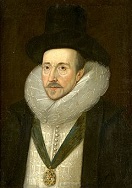

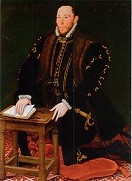
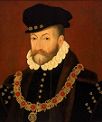

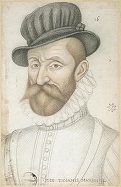






1569 A carbuncular fever epidemic in Lisbon kills 50K, incl. Portuguese poet Antonio Ferreira (b. 1528). On Feb. 2 Mary Stuart is moved to grim old Tutbury Castle in Staffordshire in the Midlands under the care of George Talbot, 6th Earl of Shrewsbury (1528-90) and his 2nd wife Elizabeth Cavendish (Elizabeth Talbot, Countess of Shrewbury) (Bess of Hardwick) (1527-1608), and the English council warns that: "She is able, by her great wit and sugared eloquence, to win even such as before they shall come to her company shall have a great misliking" to "gain rule over him, or practise for her escape", Elizabeth I commenting that there must be something "divine about the speech and appearance of the Queen of the Scots, in that one or the other obliges her very enemies to speak for her"; meanwhile Thomas Howard, 4th Duke of Norfolk (1538-72), aided by his sister Jane Neville (nee Howard), Countess of Westmorland (Westmoreland) (1533-93), wife and 1st cousin of Charles Neville, 6th Earl of Westmorland (Westmoreland) (1542-1601) (grandson of Ralph Neville, 4th Baron Neville, whose daughter Cicely Neville was the mother of Edward IV and Richard III) begin the Ridolfi Plot to marry Mary Upstart, er, Stuart to become king of a Protestant Scotland or a Catholic England (whatever), sending Florentine banker Roberto di Ridolfi (Ridolfo) (1531-1612) to Philip II; too bad, in June the Duke of Alva tells Norfolk's Spanish connection that Philip II won't go to war with England right now, and in Aug. the earl of Moray informs Elizabeth that Mary is not welcome back to Scotland; Sir Nicholas Throckmorton is imprisoned at Windsor for suspected involvement in the plot, and his diplomatic career is over although he is never put on trial; the only hope remaining is to overthrow Queen Liz? On Mar. 13 the Battle of Jarnac on the right bank of the Charente River between Angouleme and Cognac sees the Huguenots defeated by the Roman Catholic army led by marshal Gaspard de Saulx, Sieur de Tavannes (1509-75); Huguenot leader Louis I of Bourbon, prince of Conde (b. 1530) is KIA; after Adm. Gaspard de Coligny saves most of the Huguenot army and regroups in the Limousin region, they meet again on June 25 at the Battle of La Roche-l'Abeille, and this time 11K Huguenots led by Coligny accompanied by 14K troops led by Wolfgang, Count Palatinate of Zweibrucken (b. 1526) (who is KIA in Nexon, Burgundy June 11) and financed by Elizabeth I score a V over a 29.5K-man Catholic army led by the duke of Anjou; the Huguenot army heads toward Perigord, massacring 350 infantry and 250 peasants in retribution for the death of Conde. In summer a force of 20K Turks and 50K Tatars under Kasim Pasha sieges Astrakhan, while an Ottoman fleet sieges Azov and another force attempts to built a canal to unite the Volga and Don Rivers; too bad, a 30K-man Russian army scatters the workmen and their Tatar protection force, and 70% freeze or are killed by Circassians, while the fleet is destroyed by a storm, and the Astrakhan garrison under Knyaz Serebrianyi drives the siege off. This land is your land, this land is my land? On July 1 the Diet of Lublin, called by Sigismund II in 1568 unites the Roman Catholic Kingdom of Poland with the Roman Catholic Grand Duchy of Lithuania (despite Lithuanian opposition) in the Union of Lublin; Lithuania retains a separate admin. and army, with a common king and diet called the Sejm, going from an absolute monarchy to a democracy of noblemen; the autonomy of Royal Prussia is abandoned; the Duchy of Livonia (united to Lithuania since 1156) becomes a Polish-Lithuanian condominium; the Lithuanian capital of Vilnyus (Vilnius) goes on to become a center of Polish culture and Jewish learning ("the Jerusalem of Lithuania") despite plagues, fires, and Swedish and Russian invasions during the next two cents. In July Elizabeth I gets an open ulcer above the ankle, which causes her to have to travel in a litter, and doesn't heal until 1571, leaving her with a slight limp - he should have taken off his spurs before mounting her? On Aug. 16 French page Nicholas Paris (Nicholas Hubert), known as the French Paris is hanged as an accessory to Darnley's murder. On Aug. 21 duke of Florence (since Jan. 6, 1537) Cosimo I the Great de' Medici (1519-74) is crowned grand duke of Tuscany by Pope Pius V (until Apr. 21, 1574), adding Siena to his territories; the gift binds the Medicis to Spain for the next two cents. On Oct. 3 the Battle of Moncontour near Poitiers in Vienne between the Roman Catholic forces of Charles IX led by Duke Henry of Anjou and the French Huguenot forces led by Adm. Gaspard de Coligny is another D for the Huguenots, after which the Catholics take their turn at the massacre baby love game; Walter Raleigh is a minor Protestant contributor to the D. On Oct. 3 Elizabeth I has ailing Ridolfi Plot leader Thomas Howard, 4th Duke of Norfolk (1536-72) arrested and thrown in the Tower (until 1570) along with his crypto-Catholic younger brother Henry Howard, 1st Earl of Northampton (1540-1614) after she suspects him of planning to join the Northern Rising (Rebellion) (Revolt of the Northern Earls), which sees the Roman Catholic nobles of N England, led by Charles Neville, 6th Earl of Westmorland (Westmoreland) (1542-1601) and Thomas Percy, 7th Earl of Northumberland (1528-72), backed by Charles IX France and a promise of Spanish aid, and financed by Roberto Ridolfi form an army of 2.5K men (with Neville's wife Jane Howard doing much of the recruiting) to attempt Mary Stuart's liberation at Tutbury, capturing and sacking Durham, and celebrating Mass at Durham Cathedral, then marching S to Bramham Moor, planning on sieging York; too bad, on Nov. 25 Elizabeth I has Mary moved to Coventry (Lady Godiva's town) in the Protestant Midlands, foiling them; on Dec. 20 after capturing Barnard Castle on the N side of the Tees River, then marching to Clifford Moor hoping to raise support in vain (their total army only reaching 4.6K men), the rising collapses as a 7K-man army under Walter Devereux, 1st Earl of Essex (1541-76) and a 12K-man army under Edward Clinton, 1st Earl of Lincoln (1512-85) puts them on the run back to Scotland; 600-750 commoners are hanged by next Feb. 4, and 200 gentry are deprived of their estates; Neville flees to Flanders, is attained, and dies broke in Spain, and Raby Castle confiscated; Percy is captured in Scotland, deprived in 1571 in absentia of his hereditary titles and estates, shipped back to York and beheaded in 1572; his wife Jane Howard flees to the Continent, where she spends the rest of her life under house arrest; Thomas Howard is imprisoned and later pardoned; meanwhile Roman Catholic clergy are executed or flee into exile while calling on Big Papa in Rome for help. On Oct. 18 the Ottomans capitulate to the French, allowing them free passage into Ottoman waters, requiring vessels from other Euro countries to fly the French flag in order to enjoy the same privileges; the treaty is renewed through May 1740. On Oct. 19 the first stone is placed in a new wall around the Prostitutes' Quarter in Rome, ordered by Pope Pius V; completed 1 mo. later, it has only two gates so that the pope himself can decide when hos and johns can cum and go? Welcome back to The Most Outrageous Moments? On Nov. 30 Francisco de Toledo, Count of Oropesa (1515-84) becomes viceroy #5 of Spanish Peru (until May 1, 1581), instituting repressive measures on the native pop. to make them give up their independence, er, paganism and ancestor worship and reduce them to slaves, establishing the corregimientos (govt. districts), a tribute system, the mita (forced Indian labor), and forcing them out of the country into the towns where he can have them brainwashed and regimented, becoming known as "the Virreinal Solon"; he also orders a visita (economic survey and demographic census) so he can give his Spanish lords every peseta possible? The Mughals under Akbar the Great attack the Rajput Ranthambore Fort. Thomas Cartwright (1535-1603) is appointed Lady Margaret prof. of divinity at Cambridge U., where he first formally outlines the wonderful Puritan program in black and white; too bad, next Dec. John Whitgift becomes vice-chancellor, and fires him. English trade with the Netherlands is put under an embargo (ends Mar. 1573). The Swedish 2nd largest island of Oland (Öland) in the Baltic Sea off Smaland is given to the Hanseatic League as a hunting grounds, and the locals are reduced to serfs. Roman Catholic bishop Diego de Landa, called back to Spain for his practices of torturing Mayans during interrogation is cleared by a "committee of doctors", and sent back to become official bishop of Yucatan in 1571. After resigning his position as chief rabbi and giving his fortune to the poor, Spanish-born Jewish sage Radbaz (David ben Solomon ibn Zimra (1479-1573) moves to Jerusalem, but soon relocates to Safed to escape high Ottoman taxes, spending the rest of his life on the rabbinical court. A public lottery is held in London to finance repairs to the port. Sailors working for English slaver John Hawkins introduce the word "shark" to England when they bring one to exhibit, based on the Mayan word "xoc". Architecture: Selimiye Mosque in Edirne, designed by Mimar Sinan (1489-1588) is begun (finished 1574) (his best work?). Inventions: Jacques Besson (1540-76) of France invents a screw-cutting machine and an ornamental turning lathe. Tycho Brahe begins construction of a 19-ft. quadrant and a 5-ft.-diam. celestial globe in Augsburg. Nonfiction: Jacques Besson (1540-76), Theatrum Instrumentorum (Theatrum de Instrumens Mathematiques et Mechaniques); his screw-cutting lathe designs, incl. cams and plates, making him the 2nd Leonardo da Vinci? Henry de Bracton (1268-), On the Laws and Customs of England (posth.); tr. Richard Tottel. Philip van Marnix (1540-98), Biencorf der Heiligher Roomscher Kercke (The Roman Beehive); pub. during his exile in Fiesland; one of the bitterest satires ever directed against the Roman Catholic Church, getting translated and distributed throughout Europe. Gehard Mercator (1512-94), Cosmographia. Poetry: Alonso de Ercilla y Zuniga (1533-95), La Araucana; epic of the Spanish conquest of Chile; first Spanish epic poem about the New World - from the winner's viewpoint, after the detergent is applied? Art: Anon., Unknown Girl; shows how great English girls dress at this time? Hans Eworth (1520-74), Queen Elizabeth Confounding Juno (Elizaeth I and the Three Goddesses). Births: Italian duke of Parma and Piacenza #4 (1592-1622) Ranuccio I Farnese (d. 1622) on Mar. 28; son of Alessandro Farnese (1545-92) and Maria of Portugal (1538-77); great-nephew of Henry I of Portugal (1512-80). English poet Sir John Davies (d. 1626) on Apr. 16 in Tisbury, Wiltshire; educated at Queen's College, Oxford U.; not to be confused with John Davies of Hereford (1565-1618). German Thirty Years' War Protestant gen.-poet Count Georg Friedrich von Hohenlohe-Neuenstein-Weikersheim (d. 1645) on Sept. 5 in Neuenstein; educated at the U. of Vienna. Indian Mughal emperor #4 (1605-27) (Muslim) Nuruddin (Arab. "Light of the Faith") Salim (Arab. "Peace") Jahangir (Pers. "Conqueror of the World") (d. 1627) on Sept. 20 (Aug. 31 Old Style) in Sikri (near Agra); son of Akbar the Great (1542-1605); father of Shah Jahan (1592-1666). Italian Baroque poet Giambattista Marini (Marino) (d. 1625). Flemish Jesuit hagiographer Heribert Rosweyde (d. 1629). Spanish dramatist Guillen (Guillén) de Castro y Bellvis (d. 1631) in Valencia. Irish priest-scholar Geoffrey Keating (Seathrun Ceitinn) (d. 1644) in Burgess, Ballylobby, County Tipperary. English "Salve Deus Rex Judaeorum" poet (first prof. woman English poet) Emilia Lanyer (Lanier) (Aemilia Bassano) (d. 1645); mistress of Henry Carey, 1st baron Hunsdon (cousin of Elizabeth I). Deaths: Danish marshal Otte Krumpen (b. 1473); last of his family line. English Bible scholar Miles Coverdale (b. 1488) on Jan. 20 in London. Spanish preacher St. Juan de Avila (b. 1499) on May 10 in Montilla, Cordoba. English prelate Edmund Bonner (b. 1500). Polish poet Nikolaj Rej of Naglowice (b. 1505). Russian metropolitan St. Philip II of Moscow (b. 1507) on Dec. 12 (murdered). Portuguese Jewish financier Dona Gracia Mendes (b. 1510). Christian theologian Sixtus of Siena (b. 1520). Flemish painter Pieter "Peasant" Brueghel the Elder (b. 1522) on Sept. 9. German Count Palatinate Wolgang of Zweibrucken (b. 1526) on June 11. Portuguese poet Antonio Ferreira (b. 1528) on Nov. 29 in Lisbon (carbuncular fever). French prince of Conde (b. 1530) on Mar. 13 (KIA in the Battle of Jarnac). English composer Thomas Caustun (b. ?).







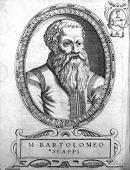



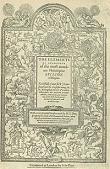
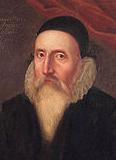
1570 Pop. of Incan Peru: 1.3M; down to 600K by 1620. A plague ravages the Russian countryside. In late Jan. Sir Leonard Dacre (1533-1573) of N England, heir of George Dacre, 5th Baron Dacre of Gillesland, who had tricked Northumberland and Westmorland into starting the Northern Rising last year in hopes of betraying them and inheriting more land from his nieces is found out, and starts his own mini-rising with 3K Cumbrians, which is quashed within a week (early Feb.) by the queen's lt. gen. Henry Carey, 1st Baron Hunsdon (1526-96), Elizabeth I's cousin, son of Anne Boleyn's sister Mary Boleyn (-1543) and William Carey (-1528); after his men stage "the bravest charge that I ever saw" (Hunsdon), Dacre escapes to exile in Flanders, where he dies in poverty, while his men flee to Scotland and are mopped-up by the Scottish regent; Hunsdon becomes privy counselor in 1577, and lord chamberlain lt. "for the defence and surety of our own Royal Person" in 1588. On Jan. 9 40-y.-o. Ivan IV the Terrible sends his army to punish Novgorod for allegedly plotting to change its allegiance to Lithuania, sacking and burning the city and torturing thousands of inhabitants in a 5-week binge, incl. throwing children into an icy river - throw another shrimp on the Volgie, mate? On Jan. 23 uppity Scottish regent James Stewart, earl of Moray (b. 1531) is assassinated in Linlithgow by James Hamilton of Bothwellhaugh and Woodhouselee (-1581) at the house of his uncle Archbishop John Hamilton to get even for confiscating his lands for supporting Mary Stuart, Queen of Scots, and on July 12 pro-Elizabeth Matthew Stuart (Stewart), 4th Earl of Lennox (1516-71) (James VI's grandfather) (whose wife Laddy Lennox is kept in the English court as a hostage) is named regent of Scotland (until 1571), hanging Roman Catholic Archbishop Hamilton for complicity in Darnley's murder; meanwhile Scottish secy. of state Sir William Maitland of Lethington (1525-73) et al. begin a plot to restore Queen Mary Stuart, while the French threaten Elizabeth with war if she doesn't restore her, causing her to make Mary an offer contingent upon ratification of the Treaty of Edinburgh and sending her son James to England as a hostage first, which Mary agrees to in Oct. On Jan. 23 Queen Elizabeth I opens the Royal (Stock) (London) Exchange in London, and dines at the house of its builder, wealthy merchant Sir Thomas Gresham (1519-79) on Bishopsgate St. On Feb. 8 Pope Pius V orders the hos in the walled Prostitutes' Quarter in Rome to be given a daily food allowance during the springtime weeks of Lent when the two gates to the quarter are locked per his orders. Speaking of giving no quarter to prostitutes? On Feb. 25 Pope Pitiless Five-O, er, Pius V pub. the fatwah, er, bull Regnans in Excelsis (Reigning on High) (claiming he's above all earthly princes so he has jurisdiction to step in?), excommunicating that bastard Elizabeth I, "the pretended queen of England, the serpent of wickedness", inciting her pius, er, pious Catholic subjects to rebel and kill her if they want to get a special place in heaven next to his holy ghisler, and urging foreign princes to rise against her in a holy crusade; too bad, he issues it before learning of the collapse of the Northern Rising, causing it to backfire when the English begin clamping down on all Roman Catholics, considering them not just heretics but traitors, with Elizabeth I making it a crime to become a Roman Catholic priest in England, while Philip II and Charles IX, who are not ready to invade England get pissed off for not being consulted first. Swiss theologian Heinrich Bullinger writes the soundbyte: "The spring of this year was like winter, cold and wet, the wine blossom terrible, and the harvest bad." On July 14 Pope Pius V issues the Missale Romanum (Roman Missal), the liturgal book containing the texts and rubrics for celebration of the Roman Mass - that's great, now shave and put on your tux? In July the Ottomans under Selim II invade Cyprus and capture Nicosia, then siege Famagusta in Aug. (until 1571), and declare war on Venice (ends 1573); meanwhile the Algerians retake Tunis from the Hapsburgs for the Ottoman Empire (until 1573), and siege Cyprus, causing Pope Pius V to form the Holy League next year with Spain and Venice against the Muslims; in 1569-74 Selimiye Mosque is built over St. Sofia Church in Nicosia. On Aug. 5 Charles IX of France and the Queen Mother Catherine de' Medici sign the Peace (Treaty) of St. Germain-en-Laye, ending the 3rd French War of Religion and granting Huguenots amnesty and freedom of worship - very little amnesty or freedom? In Aug. the Thomas Percy, 7th Earl of Northumberland (b. 1528) is by captured the Scots, handed over to the English and put to death at York; the Earl and Countess of Northumberland make it to exile in Flanders. In Aug. Ridolfo Plot suspect Thomas Howard, 4th Duke of Norfolk (1536-72) is released from the Tower and placed under house arrest in Charterhouse near Smithfield on condition of good behavior, but (liking Stuart poon and/or remaining a loyal Catholic?) he resumes his Ridolfi Plot with Mary Stuart - I just might turn into smoke but I feel fine? In Sept. Elizabeth receives an out-of-the-blue marriage proposal from 19-y.-o. Duke Henry of Valois (1551-89) (later Henry III), brother and heir of French king Charles IX (whose portrait bears a striking resemblance to Hollywood actor David Faustino (1974-)?) in an effort to unite France and England against Spain, causing her to send her swarthy Puritan "Moor" Sir Francis Walsingham to Paris as an envoy, where he finds out that Anjou is not only priest-ridden but a bisexual, wearing a double row of rings, and pendants in his ears (in later life he becomes a transvestite); not that that would stop her if it would save England? - viva Viagra? On Nov. 17 Queen Elizabeth's Accession (Golden) Day is first celebrated publicly in England as an Anglican holy day in an attempt to supplant Virgin Mary worship by Roman Catholics, hailing Liz as Judith and Deborah, and holding costumed jousts at the Horse Guards Parade at Whitehall, with Sir Henry Lee of Ditchley (1533-1611) as the queen's champion (until 1590), the queen changing costumes each year, top hits incl. Astraea (virgin goddess of justice), Cynthia (lady of the sea), Diana (the huntress), and Gloriana (the Faerie Queen); meanwhile special services, feasts, and fireworks are held all over England; the day is celebrated until the late 1600s, becoming the last flowering of chivalry in England. On Nov. 22 the first St. Cecilia Festival (patron saint of musicians) is held in Evreux, Normandy, France. On Dec. 13 the Peace of Stettin is signed, and Denmark recognizes the independence of Sweden. The Imperial Diet meets in Speyer. The 2nd Rebellion of the Alpujarras in Granada, Spain (begun 1568) is quashed. The Calvinists, Lutherans, and Moravian Brothers of Poland form the Consensus of Sendomir against the Jesuits. London Anglican bishop Edmund Grindal is transferred to the archbishopric of York after his laxity in punishing Bible-thumping Puritans gets him in trouble; most of the non-conformists in York are Roman Catholics. The First Russo-Turkish War (begun 1568) ends with an Ottoman military defeat but a commercial V when Russia destroys their fort on the Terek River and allows Muslim trades access through Astrakhan. The Ottomans regain their lost terrorities in Yemen and drive the rebels into the mountains. Two English forces invade Scotland. Holy Inquisition tribunals are established in grateful Lima, Peru and Mexico City, Mexico - I'll show you a rock slide? The Portuguese assassinate Sultan Hairun of Ternate in North Maluku (E Indonesia), causing his son and successor Sultan Baabullah (-1583) of Ternate to expel them, then get infected with Euro imperialism and conquer the neighboring kingdoms of Tidore and Bacan, followed by Banggai, Tobunku, Butung, and Salayar. Charles IX of France marries HRE Maximilian II's daughter Elizabeth; Philip II marries HRE Maximilian II's daughter Anne of Austria (his 4th wife); Queen Mary of Scots divorces James Hepburn, 4th earl of Bothwell; Margaret of Valois is betrothed to future French king Henry of Navarre (Henri IV), lineal descendant of 13th cent. Robert, 6th son of Louis IX and his Bourbon wife Beatrix through Antoine de Bourbon, duc de Vendome and Jeanne d'Albret, heiress of Navarre, which is good, since the main line of Bourbon went extinct in 1527 when traitor Charles of Bourbon got killed while sacking Rome; Antoine is the son of Charles, comte de Vendome, brother of Cardinal Charles of Bourbon and long gone Prince Louis I of Conde; Henry I, 2nd duke of Guise courts Marguerite of Valois, pissing-off her brother Charles IX, but he marries Catherine of Cleves, getting him back in his good graces. In this decade the term "punk" is first used in the ballad "Simon: The Old Kinge" to mean a prostitute: "Soe fellowes, if you be drunke, of frailtye itt is a sinne, as itt is to keepe a puncke." An earthquake devastates Ferrara, Italy, home of the late Lucrezia Borgia. Japan opens the port of Nagasaki to overseas trade. About this time gold mining peters out in Puerto Rico. About this time the Venetians import coffee from Turkey; in return tobacco arrives in Turkey and Poland; European tobacco cultivation begins in Cuba. Postal services begin in Nuremberg. The Whitechapel Bell Foundry in Whitechapel, Tower Hamlets, London is founded, going on to crank out the Liberty Bell and Big Ben, becoming the oldest manufacturing co. in Great Britain in modern times. The English govt. orders Foxe's Book of Martyrs to be placed with the Bible in all cathedral churches. Girolamo Cardano is imprisoned by the Inquisition for casting the horoscope of Jesus Christ - it said he's never amount to anything? Jean Antoine de Baif (1532-89) founds the Academie de Poesie et de Musique in Paris. Milan archbishop (St.) Carlo Borromeo (1538-84) founds the Helvetic College in Milan for Swiss (esp. Graubunden) clerics. Architecture: Mar's Wark (finished in 1572) in Stirling, Scotland is begun by John Erskine, earl of Mar (1531-72). Nonfiction: Roger Ascham (1515-68), The Scholemaster (posth.). Henry Billingsley (-1606) (tr.), The Elements of Geometrie of the Most Ancient Philosopher Euclide of Megara; first English trans. of "Euclid's Elements"; printed in folio by John Day, incl. several 3-D fold-up diagrams illustrating solid geometry; the preface by mathematicisn-astrologer John Dee (1527-1609) preface by John Dee (1527-1609) extols the virtues of mathematics, becoming more important than Francis Bacon's "The Advancement of Learning" (1605). Thomas Blundeville (1522-1606), A Very Brief and Profitable Treatise Declaring How Many Counsels and What Name of Counsellors a Prince That Will Govern Well Ought to Have. John Dee (1527-1609), Brytannicae Reipublicae Synopsis; outlines the state of the Elizabethan realm, advocating a policy of imperial expansion into the New World. Al-Istakhri, Map of the World; in Arabic, based on a 10th cent. Ptolemaic projection with S at the top. Thomas Kirchmeyer, The Polish Kingdom (tr. Barnabe Googe). Blaise de Monluc, Commentaires. Abraham Ortelius (1527-98), Theatrum Orbis Terrarum (May 20); the first modern atlas (53 maps); the result of being turned on to geography by Gerhardus Mercatur in 1560; gets him an appointment as royal geographer to Philip II of Spain in 1575. Andrea Palladio (1518-80), The Four Books of Architecture (I Quattro Libri dell'Architettura); bestseller; vol. 1 is trans. to English in 1663 by Godfrey Richards, and all 4 vols. in 1715-20 by Giacomo Leoni. Bartolomeo Scappi (1500-77), Opera dell'Arte del Cucinare; a cookbook by Pope Pius V's head chef, which incl. 1K recipes, displays the first known picture of a fork, and waxes lyrical about Parmesan cheese, and how the Jews fatten goose livers to weigh between 2-3 lbs., becoming the first celebrity chef? Poetry: Art: Hans Eworth (1520-74), Elizabeth I. El Greco (1541-1614), Portrait of Giorgio Giulio Clovio; his earliest surviving portrait. Lucas de Heere, A Group of Englishwomen; their cool headwear. Nicholas Hilliard (1547-1619), Portrait of Queen Elizabeth I. Tintoretto (1518-94), Moses Striking the Rock. Titian (1477-1576), Philip II Presenting His Son to Victory. Births: English Gunpowder Plotter Thomas Bates (d. 1606); servant of Robert Catesby (1573-1605). English Gunpowder Plot masked fall guy Guy Fawkes (d. 1606) in York; a Protestant by birth, becomes a Roman Catholic after his widowed mother marries a Catholic man. English Baptist church founder John Smyth (d. 1612) in Lincolnshire. Moroccan Barbary pirate leader (Muslim convert) Murad (Murat) Reis (the Younger) (Jan Janszoon van Haarlem) (d. 1641) in Haarlem, Netherlands. French Canadian Acadian historian Marc Lescarbot (d. 1642). English playwright Thomas Dekker (d. 1632). Deaths: Italian sculptor-architect Jacopo Sansovino (b. 1486) on Nov. 27 in Venice. French writer Francois Bonivard (b. 1493). Swiss "Prisoner of Chillon" Francois Bonivard (b. 1496) in Geneva; leaves History of Geneva (pub. 1831). German Protestant reformer Johann Brenz (b. 1499) on Sept. 11 in Stuttgart; his grave is destroyed by the Jesuits. Italian artist Francesco Primaticcio (b. 1504). German composer Johann Walther (b. 1504). Flemish painter Frans Verbeeck (b. 1510) in Mechelen. Italian architect-cardinal Daniele Barbaro (b. 1514) on Apr. 13 in Udine. French architect Philibert Philibert Delorme (b. 1514) on Jan. 8 in Paris. English lord Henry Clifford, earl of Cumberland (b. 1517). Dutch Flemish painter Frans Floris (b. 1517) on Oct. 1 in Antwerp. Scottish regent James Stewart, earl of Moray (b. 1531) on Jan. 23 in Linlithgow (assassinated).






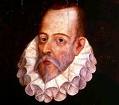



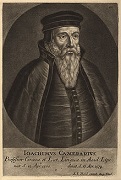
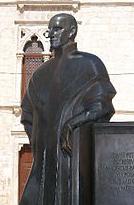
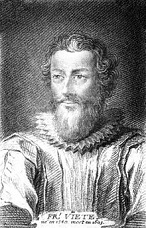

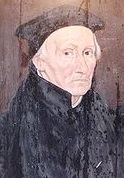




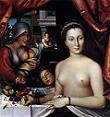
1571 On Mar. 14 after abdicating and becoming the first prince of Transylvania last year, John II Sigismund Zapolya (b. 1540) dies, and Roman Catholic Stephen (Stefan) Bathory (Báthory) (1533-86) becomes prince of Transylvania, followed on May 1, 1576 by king of Poland and grand duke of Lithuania (until Dec. 12, 1586). In Mar. Elizabeth I tells her council that she intends to marry Duke Henry of Valois (1551-89), causing Lord Burghley to declare that this will make "the Pope's malice vanish away in smoke"; by Sept. despite Catherine de' Medici sending two special envoys, the marriage negotiations fail because Henry won't give up his Roman Catholic faith and/or everybody thinks Elizabeth is too old for him. On Apr. 2 the earl of Lennox lays siege to Castle Dumbarton, and on Apr. 7 John Hamilton is hanged for Darnley's murder; Lennox is assassinated (shot) on Sept. 4, and James VI's guardian John Erskine, Earl of Mar (1531-72) is named regent (until 1572). On May 15 the Furmint (Lat. "froment" = wheat-gold color) grape is first mentioned as growing in the Hetszolo Vineyard in Tokaj, Hungary. On June 24 the Spanish under conquistador Miguel Lopez de Legazpi capture the Muslim-controlled city of Manila (modern-day pop. 1.8M/12.8M), and make it their new Philippine capital. On June 27 after lobbying by Welsh lawyer-clergyman Hugh Price (1495-1574), Elizabeth I founds Jesus College at Oxford U. for the education of Protestant clergymen. On Aug. 3 after an 11-mo. siege, 70K Turks capture Famagusta, capital and chief city of Cyprus, and massacre its pop. On Sept. 3 after he is discovered sending money and ciphered letters to Mary Stuart, Thomas Howard, 4th duke of Norfolk is arrested, and put in the Tower on Sept. 7, then confesses on Oct. 11 to avoid torture; on Oct. 24 Mary's envoy the Bishop of Ross is put in the Tower and tortured, giving up Mary, Norfolk, the Earl of Southampton, the Earl of Arundel, Lord Cobham and Lord Lumley; Arundel lives but never clears his name; Southampton spends a year in the Tower; the Spanish ambassador is expelled; Ridolfi safely flees; from now on Elizabeth will never free Mary or restore her to the Scottish throne, and recognizes James VI as Scottish king; the affair drives her to revive the match with Duke Henry of Anjou, but he is having an affair with Mademoiselle de Chateauneuf and trying to be crowned king of Poland, so Catherine de' Medici suggests her puny 17-y.-o. pockmarked (with a funny nose and slightly deformed spine) son Hercules Francois, Duke of Alencon (Alençon) and Anjou (1555-84), who is sympathetic toward the Huguenots, has ambitions of leading the Protestants against the Spanish in the Netherlands, and can grow a beard to help hide the pockmarks, but despite he being a young stud and she a Cougar, he is such an immature twerp that she rejects him? On Sept. 4 Scottish regent the Earl of Lennox is murdered at Stirling Castle in revenge for his hanging of Archbishop Hamilton, and replaced by the Earl of Mar, which by luck is Elizabeth I's favorite. On Oct. 7 after Pope (1566-72) Pius V (Antonio Michele Ghislieri) (1504-72) signs the Holy League Alliance with Spain and Venice, 200 Spanish and Venetian galleys under 24-y.-o. Don John (Juan) of Austria (1547-78) (half-brother of Philip II of Spain, and illegitimate son of HRE Charles V) defeat the 230-galley Turkish fleet at the 6-hour Battle of Lepanto (Naupactos) in a bay at the mouth of the Gulf of Patras (entrance to the Gulf of Corinth) off Lepanto in W Greece (biggest naval battle in Mediterranean history?) (last major naval battle fought exclusively by rowing vessels?) just before 5 p.m., with 12K Christian casualties vs. 6K Muslim POWs taken and 30K of 56K KIA, incl. Turkish fleet grand adm. Muezzinzade Ali Pasha aboard his ship, becoming the first defeat of Muslims by Christians on the sea, a big V for Western military technology, and the beginning of the end of the Ottoman naval threat in the C Mediterranean, destroying the myth of their invicibility, although both fleets are heavily damaged and the Ottomans speedily rebuild their fleet and restore their supremacy on the W and E sides; Spanish writer Miguel de Cervantes Saavedra (1547-1616) is wounded in the battle, calling it "the most noble and memorable event that past centuries have seen or future generations can ever hope to witness"; Italian-born Muslim convert Ottoman adm. Uluj Ali Reis (Giovanni Diongini Galeni) (1519-87) captures the flagship of the Maltese Knights along with its great banner before gathering the fleet's remaining 87 ships and returning to Constantinople, getting promoted on Oct. 29 to grand adm.; since most of the Ottoman sailors had been sent home for winter and the rest were involved in political squabbles, and the Christians outnumbered them, it was an overrated V for Christ?; the failures of war galleys cause their use to decline as better designs are sought and bigger vessels built; many Muslim POWs are taken and used to man Christian oars; bald, white-bearded future saint Pope Pius V allegedly sees the V in a vision in Rome at the exact moment it happens, ascribing it to intercession by the Virgin Mary, establishing the Feast of Our Lady of Victory (the Holy Rosary) on Oct. 7, even though he isn't informed of it officially until Oct. 21? - Playtex, who knows you like we do? On Dec. 19 glammed glowing William Shakespeare, er, Edward de Vere, 17th Earl of Oxford (1550-1604), known for his slender figure and hazel eyes, good classical education, and skill in dancing, horsemanship, and playing the virginals marries Anne Cecil (1556-89), daughter of Lord Burghley at Westminster Abbey, and Queen Elizabeth I attends, giving him the nickname of "her Boar"; expected to be a court favorite, with the queen "delighting more in his personage and his dancing and valiantness than any other", he ends up going for overseas adventure. After coming under the influence of Adm. Gaspard de Coligny, Charles IX of France and the Huguenots reconcile, and a marriage is arranged between Charles IX's sister Margaret of Valois and Huguenot leader Henry of Navarre (future king Henry IV), setting the wedding for next Aug. 18. Sir William Cecil becomes Lord Burghley, with Elizabeth I uttering the soundbyte: "No prince in Europe hath such a counselor." Incan king Tigu Cusi (b. 1535) dies, and Tupac (Túpac) Amaru (Thupa Amaro) (1545-72) succeeds him, deciding to avoid further contact with the Spics, er, Spaniards? - if he won't come to them, they'll go to him? Moscow is devastated by a fire. Francis Drake, known as "El Draque" to the Spanish attacks Panama; Philip II offers a reward of 20K ducats for his head. The English Parliament forbids the export of wool from England, and also enforces subscription to the Thirty-Nine Articles of 1563 by the English clergy. Sir Humphrey Gilbert (1539-83), half-brother of Sir Walter Raleigh, who fought in the war with France in 1562-4, was commissioned a capt. in the English army in Ireland in 1566, unsuccessfully petitioned the queen to be allowed to find the Northeast and Northwest Passages in 1566-7, was appointed gov. of Munster in 1569, and knighted in 1570 is elected to Parliament from Plymouth. Elizabeth I gets a Mandatory Woollen Cap Law passed requiring everybody over age six to wear a woollen cap on Sundays and holidays in order to help England's wool trade; of course, the upper classes are exempt. The Gen. Protestant Synod of La Rochelle goes with Theodore Beza's suggestion that church discipline should not be abolished, while civil govt. should not be acknowledged as the head of the church, pissing off Paris minister Jean Morel and French philosopher Pierre Ramus; the Zwinglian doctrine of the Lord's Supper is rejected in favor of Calvin's "substance of the body of Christ". Money-for-nothing-and-chicks-for-free slaver John Hawkins (1532-95) plays double agent for Elizabeth I with the Spanish, pretending to be in on the Ridolfi plot to help foil it, as well as pump info. about the big coming invasion, for which he is rewarded by becoming an MP this year, followed by treasurer and comptroller of the Royal Navy from 1573-89, which allows him to improve English ships and raise sailor pay, almost getting canned in 1583 for being too good - the money's all right, the hours' all right, it's just a little wind? Kremenchug in the Ukraine on the Dnieper River 160 mi. SE of Kiev is founded. Spanish explorers in Mexico discover the wild turkey, and carry some to Europe, so that the Pilgrims are familiar with them before they arrive in America in 1620. Oxford U. and Cambridge U. are incorporated and reorganized by act of Parliament to put them on a Protestant rather than Roman Catholic foundation regarding land and revenues. Oda Nobunaga battles the militant Tendai Buddhists, destroying their main center at Mt. Hiei NE of Kyoto and killing thousands of monks. The Worshipful Co. of Blacksmiths livery co. in London is incorporated for blacksmiths, gunsmiths, clockmakers, and spurriers, later becoming the Blacksmiths and Joiners Cos. The Bibliotheca Laurenziana in Florence opens to the public. Hear it for Harrow? Harrow School at Harrow on the Hill, Middlesex (North West London), England is founded by John Lyon (-1592) of Preston under a royal charter; in 1590 its statutes provide for the education of 30 poor boys of Harrow parish, with two-thirds of his fortune left in his will; by the 1660s "foreign" (nonparish) paying scholars are admitted, and it goes on to graduate big names incl. Sir Robert Peel, Sir Winston Churchill, Lord Byron, Anthony Trollope, Richard Brinsley Sheridan, and Lord Palmerston. Giovanni Pierluigi da Palestrina is appointed master of music at Cappella Giulia in Rome, and in conjunction with Orlando di Lasso the the vocal polyphonic a cappella style reaches its apex. The Bible becomes available in Portuguese. Architecture: Andrea Palladio designs the Loggia del Capitanio in Vicenza. Guadalajara Cathedral in Mexico is begun (finished 1618). Inventions: The Strasbourg Cathedral Astronomical Clock, designed by Conrad Dasypodius (1530-1600) is begun by brothers Isaac Habrecht (1544-1620) and Josias Habrecht (1552-75) from Schaffhausen, becoming the flagship of math, physics, and scientific know-how (finished 1574) (replaced 1842). Science: English mathematician Leonard Digges (1520-59) (father of astronomer Thomas Digges) invents the Theodolite for surveying. French mathematician Francois Viete (Viète) (Franciscus Vieta), Seigneur de la Bigotiere (Bigotière) (1540-1603) pub. his first mathematical work Francisci Vietœi universalium inspectionum ad canonem mathematicum liber singularis, a book of trigonometry, containing many sine and cosine formulas, and making use of decimal fractions; he then gets into codebreaking for Henry III and Henry IV during the Wars of Religion while working on his Analytical Art (New Algebra) (Species Logistic) (The Logic of Species), becoming the first to use letters as parameters in algebraic equations, discovering Vieta's formulas relating the coefficients of a polynomial to sums and products of its roots; in 1593 he pub. the first infinite product in an expression for pi as 2 x 2/sqr(2+sqr(2+sqr((2+sqr((2+sqr(2+)...); in modern times the technique of Vieta Jumping is developed to solve mathematical olympiad problems; Rene Descartes builds on Viete's work. George Buchanan (1506-82), A Detection of the Doings of Queen Mary - talk about burning feminine itch? Joachim Camerarius the Elder (1500-74), Short and Ordered Considerations for the Formation of a Well-Ordered Medicine; calls for reforms in Nuremberg to authorize physicians to oversee the work of apothecaries and give them a monopoly on diagnosis, starting a war. Andrea Cesalpino (1519-1603), Quaestionum Peripateticarum; contains observations on the movement of blood and the heart, confusing circulation with evaporation and condensation. Thomas Digges (1546-95), Pantometria; manual of surveying, pitching his father Leonard Digges (1520-59) as the inventor of the reflecting and refracting telescopes between 1540-59; too bad, he brags too much and claims that he could "read letters, numbered pieces of money with the very coin and superscription thereof, cast by some of his friends of purpose upon downs in open fields, but also seven miles off declared what hath been done at that instant in private places." John Kearney (treasurer of St. Patrick's Cathedral, Dublin), Aibidil Gaoidheilge agus Caiticiosma (Alphabet of the Irish language and Catechism; That is, Christian instruction or teaching along with certain articles of the Christian rule that are proper for everyone who would be obedient to the law of God and the Queen in this kingdom) (June 20) (Dublin); Protestant primer; the first book printed in the Irish language in Ireland. Hugh Latimer (1485-1555), Frutefull Sermons. Georgette de Montenay, Emblemes, ou Devises Chrestiennes. Philippe de Mornay (1549-1623), Dissertation sur l'Eglise Visible. Franciscus Patricius (1529-97), Discussiones Peripateticae (Discussionum Peripateticorum) (15 vols.) (Basel); claims that Aristotle's teachings directly oppose Christianity, while Plato's foreshadow it, attacking Aristotle's life and character and the authenticity of his works, attempting to refute his doctrines theologically. Music: Andrea Gabrieli (1520-86), Conzoni Alla Francese. Art: Francois Clouet (1510-72), Diane de Poitiers. Tintoretto (1518-94), The Origin of the Milky Way. Titian (1477-1576), Christ Crowned with Thorns. Paolo Veronese (1528-88), Art in San Sebastiano, Venice. Poetry: Fernando de Herrera (1534-97), Ode on the Naval Battle of Lepanto; Ode on Don John of Austria; his masterpieces, causing him to be called El Divino. Births: Austrian field marshal Baron Charles Bonaventure (Karel Bonaventura) de Longueval, Count of Bucquoy (d. 1621) on Jan. 9 in Arras, France. English scholar (founder of the Cotton Library) Sir Robert Bruce Cotton, 1st Baronet of Connington (d. 1631) on Jan. 22 in Denton, Huntingdonshire; descendant of Robert the Bruce; educated at Westminster School, and Jesus College, Cambridge U.; knighted in 1603 after divising the title of baronet to help James I to raise funds. Persiah Safavid shah #5 (1587-1629) Abbas I (the Great) (d. 1629) on Jan. 27 in Herat; 3rd son of Mohammad Khodabanda and a Georgian mother. German Lutheran composer-musicologist Michael Praetorius (Schultze) (d. 1621) on Feb. 15 in Creuzburg. English economist (mercantilist) Thomas Mun (d. 1641) on June 17 in London. Italian #1 Baroque painter Michelangelo Amerighida Merisi da Caravaggio (d. 1610) on Sept. 29 in Milan; teacher of Jusepe de Ribera (1591-1652); rival of Annibale Carracci (1560-1609); known for his chiaroscuro technique, great success, and nasty dueling habit. Spanish Baroque dramatist-poet (#2 of the Golden Age) and priest Tirso de Molina (Gabriel Tellez) (d. 1648) in Oct. in Madrid; disciple of Lope de Vega. German world-shaking astronomer-astrologer-mathematician Johannes Kepler (d. 1630) on Dec. 27 [Capricorn] in Weil der Stadt on the edge of the Black Forest; born almost exactly 1 cent. after Nicolaus Copernicus (b. Feb. 19, 1473). English explorer (founder of the Va. Co. of London) Bartholomew Gosnold (b. 1607) in Grundisburgh, Suffolk; educated at Cambridge U. Spanish Jesuit missionary to China Father Diego de Pantoja (Didaco Pantoia) (d. 1618) in Apr. in Valdemoro. Polish mentor Nicolaus Copernicus (b. 1473); asst. of Tycho Brahe; court mathematician to HRE Rudolf II. Japanese samurai Hasekura Rokuemon Tsunenaga (d. 1622) in Sendai. Persian Twelver Shiite Sufi philosopher Mulla (Molla) Sadra (Sadr al-Din Mohammad ibn Ibrahim ibn Yahya Wawami Shirazi) (d. 1640) in Shiraz. Korean king (1608-23) Kwanghaegun (d. 1641). Deaths: Italian sculptor Benvenuto Cellini (b. 1500) on Feb. 13 in Florence. Italian organist-composer Francesco di Bernardo Corteccia (b. 1504). German prince-elector of Brandenburg (1535-71) Joachim II Hector (b. 1505) on Jan. 3 in Kopenick Palace. English diplomat Sir Nicholas Throckmorton (b. 1515) on Feb. 12. Polish king Sigmund II (b. 1520); last of the Jagellon Dynasty. Incan ruler Titu Cusi (b. 1529) in Vilcabamba (pneumonia). Hungarian king (1540-70) John II Sigismund Zapolya (b. 1540) on Mar. 14 in Gyulafehervar, Romania.





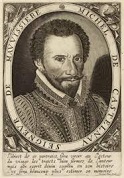



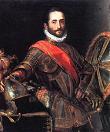


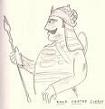
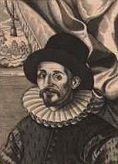





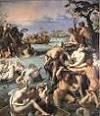
1572 On Jan. 1 the earl of Leicester presents Elizabeth I with a jewelled bracelet set with a tiny timepiece, the first known wristwatch. On Jan. 16 the duke of Norfolk is tried by a 26-man jury in Westminster Hall and found guilty of 13 counts of high treason. On Feb. 28 Maharana Udai Singh II (b. 1522) dies, and on Mar. 1 his son Pratap Singh I (1540-97) becomes maharana of Mewar in NW India (until 1597), going on to become its greatest hero. The Low Countries are a sea of blood and flames because of their love of Christ? On Apr. 1 the Dutch Watergeuzen (Sea Buggers, er, Beggars) of William I the Silent of Orange capture Brielle in S Holland, and for the first time stay and occupy it, and the idea catches on, with most of the cities in Holland and Zeeland soon falling into their hands, with the exception of the capitals Amsterdam and Middelburg (capital of Zeeland); the captured cities then convene an estates-gen. in Dordrecht, which confirms William I as stadtholder (gov.), who goes on to score several land Vs at Deventer, Mons, Roermond, Leuven, and Dendermonde at the confluence of the Dender and Scheldt Rivers in Belgium; the silver Geuzen medal is struck celebrating the capture of Brielle; virulent anti-Catholic polemicist Philip van Marnix, author of the Dutch nat. anthem Wilhelmus van Nassouwe (in which the first letters of the couplets form the name "Willem van Nassov") is sent by William I as his rep. to the estates-gen. On Apr. 19 hoping to isolate Spain, England, and France conclude the Treaty of Blois, promising to provide each other with military-naval assistance against their common enemies, incl. Spain and the Netherlands, which ends England's isolation along with French support of Mary Stuart; Elizabeth I also hopes this will prevent France from invading Flanders; meanwhile Catherine de' Medici pushes her teenie son Duke Francois of Alencon on Elizabeth I harder. On May 1 Pope (since 1566) Pius V (b. 1504) dies with sweet dreams of Lepanto dancing in his head (canonized in 1712) (no need for any more Piuses until 1775), and on May 14 Ugo Buoncompagni is elected Pope (#226) Gregory XIII (1502-85); his Buoncampagni family patronizes female Bolognese painter Lavinia Fontana (1552-1614), daughter of Prospero Fontana - it sure looks good on you, and when you smile for the camera I know I love you better? On May 8 the English Parliament meets to demand that Mary, Queen of Scots be executed, but Queen Elizabeth I nixes them, saying she couldn't "put to death the bird that, to escape the pursuit of the hawk, has fled to my feet for protection"; on May 26 Parliament passes a milder bill listing Mary's offenses, and depriving her of all claims to the English throne, making it an offense to proclaim or assert it; the queen vetoes it, and writes a sonnet about her, later pub. by George Puttenham in The Art of Poesie (1589); "The Daughter of Debate, that eke discord doth sow,/ Shall reap no gain where former rule hath taught still peace to grow/ No foreign banish'd wight shall anchor in this port..." In May a French nat. Protestant synod is held in Nimes in S France. On June 2 (7 a.m.) (after her cousin the queen delayed the execution, originally set for Jan. 21, and visited the night before to make sure he was comfy?) Thomas Howard, 4th duke of Norfolk (b. 1536) is beheaded on Tower Hill after declaring that he had never been a papist, and that "Since the beginning of our most gracious Queen's reign I am the first, and God grant I may be the last"; he refuses a blindfold, and is buried before the altar of the Chapel of St. Peter ad Vincula in the Tower between his cousins Anne Boleyn and Catherine Howard; his son Philip Howard, 20th Earl of Arundel (1557-95) is prevented from inheriting his dukedom, but he makes out okay as his maternal grandfather croaks in 1580, and becomes the 1st, 13th or 20th earl of Arundel, depending on whom you talk to. In June Francis Drake sacks Nombre de Dios on the Isthmus of Panama, and next Apr. ambushes the Silver Train, a mule convoy carrying precious metals. On July 5 emperor (since Feb. 4, 1567) Longqing (b. 1537) dies, and on July 19 his 3rd son Wanli ("ten thousand calendars") (Zhu Yijun) (1563-1620) becomes Ming emperor #13 of China (until 1620); beginning of the Wan Li Period in Porcelain (ends 1619). On July 7 king (since Apr. 1, 1548) Sigmund II Augustus (b. 1520) of Poland dies childless, and the Jagiellon line comes to an end; the Estates of Poland declare the monarchy elective, and next May 16 Duke Henry of Valois becomes king Henry III (1551-89) of the Polish-Lithuanian commonwealth (until May 12, 1575), becoming shocked at Polish culture incl. taking shit outside castle walls, taking baths with regulated hot and cold water, and eating with forks, which he takes back to France - and deep down in your heart, you know it ain't right? On Aug. 18 Protestant Henry of Navarre (b. 1553) (future Henri IV of France) marries Charles IX's sister Marguerite (Margaret) de Valois (1553-1615) (until 1599) at Notre Dame Cathedral in Paris, and he becomes King Henry III of Navarre, the first member of the House of Bourbon to achieve royal rank, pissing-off the Roman Catholic Guise party, backed by Catherine de'Medici, and causing them to attempt to assassinate Huguenot leader Adm. Gaspard de Coligny (1519-72)) on Aug. 22 for his influence over Charles IX, which fails, only shattering his left elbow and tearing a finger from his right hand and causing riots in Paris; on Aug. 23/24 (Aug. 13/14 Old Style) (Thur.) (night) the Fourth French War of Religion (ends Aug. 25, 1573) begins with the St. Bartholomew's Day Massacre, approved by Charles IX of France and Queen Mother Catherine de' Medici; it starts out as a surgical assassination of Adm. Gaspard de Coligny and other Huguenot leaders in Paris, with Coligny killed in his house by Duke of Guise henchman Charles Danowitz AKA Karel Janovic and hung from a gibbet by one foot before being beheaded, after which the king orders all Huguenots cleared from Paris, but it gets out of hand, and 2K-4K Protestants are murdered, exploding into a nat. killing spree as over 100K French Protestants are murdered like maggots by French Catholic mobs on a mission from God to exterminate the "Lutheran scum" (Henri II); Henry of Navarre saves himself by abjuring Calvinism, and becomes a virtual prisoner until 1576, after which he returns to practicing it; the news cause Philip II to dance for joy, Mary Stuart to stay up all night celebrating, and Pope Gregory XIII to express satisfaction at the killing of heretics; Sir Francis Walsingham hides in Paris during the massacre and barely escapes, sending a message to Elizabeth I which arrives on Sept. 3 and causes her to go into mourning and postpone plans for marrying the duke of Alencon, who had nothing to do with the massacre and speaks out against it; Catherine's internat. rep. plummets and never recovers; Walsingham is put in charge of England's security, and immediately identifies Mary Stuart, Queen of Scots as public enemy #1; a mass exodus begins of Huguenots from France to London, Geneva, Amsterdam et al., all telling horror stories; on Sept. 5 French ambassador Fenelon tells Elizabeth that the massacre as an "accident", and makes up a story about a Protestant plot to overthrow Charles IX; in Oct. Charles sends Michel de Castelnau, Sigeurde la Mauvissiere (Mauvissière) (1520-92) to London to ask Elizabeth to be godmother to his infant daughter as a gesture, even though Liz is excommunicated and the daughter is a Catholic; Liz responds by sending the Earl of Worcester with a gift of a gold salver, which is stolen by pirates on the Channel; after the massacre causes cries for Mary Stuart's head, on Sept. 10 Elizabeth secretly proposes to the Earl of Mar to take her back and try her for Darnley's murder in the hopes she will be executed, but the plan falls through when Mar demands the English admit to wanting her dead; on Nov. 24 Mar dies of natural causes, and Mary's enemy James Douglas, 4th Earl of Morton (1516-81) is named regent (until 1580); the countess of Mar gains custody of James VI. On Sept. 28 Gidobaldo II della Rovere (b. 1514) dies, and his son Francesco Maria II della Rovere (1549-1631) becomes the last duke of Urbino (until Nov. 3, 1621). In Oct. the Dutch Protestant rebel army of William I the Silent of Orange gets pushed by the Spanish into the harbor town of Enkhuizen in N Holland after promised French Huguenot support evaporates, allowing the Spanish army under the Duke of Alva's super-cruel 2nd son Don Fadrique (Don Frederick) Alvarez (Álvarez) de Toledo, 4th Duke of Alva (Alba) (1537-83) to sack several rebel cities, massacring the pops. of Mechelen (Mechlin), Zutphen (Nov. 17), and Naarden (Dec. 1); meanwhile on July 4 the formerly pro-Spanish city of Haarlem has seen enough and declares for the rebels, and on Dec. 11 the Spanish Siege of Haarlem (ends July 13, 1573) begins, continuing through the winter; on Dec. 19 the Spanish fire 625 artillery shots at its weak defensive wall, causing them to have to build a new one fast; Sir Humphrey Gilbert is sent with an English force; Dutch pigeons carry letters during the siege of Haarlem; Kenau Simonsdochter Hasselaer (1526-88), daughter of the mayor leads her own troop of 300 women, causing the Dutch word "kenau" to come to mean a bossy bitch. On Nov. 9 the Siege of Sancerre in C France begins with a surprise attack by the Roman Catholics, with the Huguenot pop. holding out in the fortified hilltop stronghold for almost 8 mo. and losing 500 (incl. most of the children) to famine plus 600 when a wall collapses until the siege is abandoned next Aug. 25, becoming celebrated as the Protestant version of the 70 C.E. Siege of Jerusalem; "We light here, we fight here, go assassinate elsewhere." Rudolf II is crowned king of Hungary - I think of it as a blue ribbon from my old man? The Saxe-xyz duchies are born, later putting monarchs on the British throne? After the HRE gets fed up with Duke Johann Wilhelm of Saxe-Weimar (1530-73) for supporting the French king, the Diet of Speyer proclaims the Division of Erfurt, dividing the Ernestine duchy of Thuringia, Saxony between him and his sons, leaving Johann Wilhelm with Weimar, Altenburg, Gotha and Meiningen, and giving the duchy of Saxe-Coburg-Eisenach to his eldest son Johann Casimir, Duke of Saxe-Coburg (1564-1633) (later known for creating a cultural and building boom in Coburg while sponsoring witch-burnings) and Johann Ernst, Duke of Saxe-Eisenach (1566-1638), who in 1596 split it up, with Hildburghausen being shared; Johann Wilhelm dies next year, leaving his share to his young son Frederick Wilhelm I, Duke of Saxe-Weimar (1562-1602) (11th great-grandfather of Elizabeth II of Britain), from which the house of Saxe-Gotha-Altenburg later splits in 1672. Handsome studly Walter Devereux (1541-76) is made a knight of the garter, and created 1st earl of Essex for his help in suppressing the Northern Rebellion. Lord Burghley becomes lord high treasurer of England (until 1598). Ivan IV the Terrible dismisses the Oprichniki - for plotting against him? Mercury is discovered in Peru, which is used to refine silver, leading to a flood of silver into Spain, causing happy Philip II to increase military expenditures using galleon futures to get credit from Genoese bankers. William Byrd (1540-1623) (organist of Lincoln Cathedral from 1563) (a Roman Catholic) and his former teacher Thomas Tallis (1505-85) become organists at the Chapel Royal; in 1575 they are granted a 21-year monopoly in music printing in England, and dedicate Cantiones Sacrae, a collection of motets to Queen Elizabeth I; when Tallis dies in 1585 Byrd keeps the monopoly - holding back music in England for almost 50 years like Bill Gates later did with software? Italian violin maker Andrea Amati (1505-78) of Cremona begins making the studly cello Il Re (The King) for Charles IX of France. The Society of Antiquaries of London is founded in England by Canterbury archibishop Matthew Parker, who is always digging around trying to find evidence that the Roman Catholic Church sucks, although they already believe that if you stack the entire Catholic hierarchy on one pan of a scales, they will be outweighed by the Bible alone. The Spanish Riding School is founded in Vienna, becoming the oldest classical dressage riding school to survive to modern times, featuring the Lipizzaner (Lipizzan) Stallions. The mayor of London bans plays and playhouses to protect against the plague, and in 1575 he bans players too, causing playhouse owners to begin building outside London's city limits. Science: Danish metal-nosed astronomer Tycho Brahe (1546-1601) (known for keeping a tamed elk and a dwarf named Jepp as a jester) discovers a supernova ("New Star") in the constellation Cassiopeia, startling the establishment, who believe that the heavens are unchanging; the discovery wows Danish king Frederick II, who pays for two new observatories for him; he also produces the first star catalog, correcting grave errors in the Alfonsine and Prutenic Tables; meanwhile English astronomer Thomas Digges (1546-95) uses the parallax of the supernova to conclude that it has to lie beyond the orbit of the Moon, shocking the establishment, which believes that no change can take place among the fixed stars. Nonfiction: Anon., Artis Auriferae Quam Chemium Vocant ' (Basel); one of the earliest books on alchemy. Rafael Bombelli (1526-72), Algebra; shows the use of continued fractions. Annibale Caro, Lettere Familiari; history of the Tuscan lit. language in Italy. Henri Estienne, Thesaurus Linguae Graecae. John Knox (1505-72), An Answer to a Scottish Jesuit (last book). Matthew Parker (1504-75), De Antiquitate Britannicae Ecclesiae. Jean de Serres, Commentarii de Statu Religionis et Republicae; on the French wars of religion. Art: Alessandro Allori (1535-1607), The Pearl Fishers. Poetry: Luis Vaz de Camoes (Camoens) (1524-80), Os Lusiadas (The Lusiads); 1,102 stanzas about Vasco da Gama's voyages; written in exile in Macau; becomes the Portuguese nat. epic. George Gascoigne (1539-78), A Hundredth Sundry Flowres. Pierre de Ronsard (1524-85), La Franciade. Novels: Guillaume de Salluste, Sieur Du Bartas (1544-90), Judith. Births: English "Every Man in His Humour", "Volpone, or The Foxe", "The Alchemist" lyric poet-dramatist-critic (English poet laureate #1) Benjamin "Ben" Jonson (d. 1637) on June 11 in Westminster, London; posth. son of an impoverished gentleman; #2 English playwright after William Shakespeare during the reign of James I, with his vast classical education and appetite for controversy influencing poets in the Jacobean (1603-25) and Caroline (1625-42) eras. Irish penultimate king of Tyrconnell (1592-1602) "Red" Hugh Roe O'Donnell (d. 1602) on Oct. 30 in Lifford, County Donegal; son of Sir Hugh O'Donnell (-1600) and 2nd wife Ineen Dubh; elder brother of of Rory O'Donnell (Red Hugh II) (1575-1608); son-in-law of Hugh O'Neill, earl of Tyrone (1550-1616). Japanese emperor #107 (1586-1611) Go-Yozei (Kazuhito) (Katahito) (d. 1617) on Dec. 31; eldest son of Prince Masahito, 5th son of Ogimachi (1517-93). English Gunpowder Plotter Thomas Wintour (d. 1606). Transylvanian prince (1588-1613) Sigismund (Zsigmond) Bathory (d. 1613); nephew of Stephen Bathory (1533-86). German "Uranometria" astronomer-atty. Johann Bayer (d. 1625) in Rain, Bavaria. English Jacobean "For whom the bell tolls", "No man is an island" metaphysical poet John Donne (d. 1631) on Jan. 22 in London; great-great-nephew of Sir Thomas More (1478-1535); educated at Hart Hall (Hertford College), Oxford U., Cambridge U., and Lincoln's Inn; born to a recusant Roman Catholic family, he converts to the Church of England, becoming dean of St. Paul's Cathedral in 1621. Czech defenestrated nobleman (Protestant-to-Roman Catholic convert) Count William Slawata (Schlabata) (Vilem Slavata) of Chlum (d. 1652) on Dec. 1 in Cestin (near Kutna Hora). Dutch submarine inventor Cornelis (Cornelius) Jacobszoon Drebbel (d. 1633) in Alkmaar. Lebanese Druz prince Fakhr al-Din II the Great (d. 1635). English Puritan divine "Roaring" John Rogers (d. 1636) in Moulsham, Essex; educated at Emmanuel College, Cambridge U. German scientist Daniel Sennert (d. 1637). Greek ecumenical patriarch of Constantinople Cyril Lucaris (Lucar) (d. 1638); gets influenced by Calvinism and advocates a Greek vernacular trans. of the Bible. Welsh Tudor-Stuart madrigal composer Thomas Tomkins (d. 1656) in St. David's, Pembrokeshire; Deaths: Ottoman legal scholar and grand mufti (1545-74) Ebussuud Efendi (b. 1490) on Aug. 23. Ottoman naval officer-artist Nigari (b. 1492); leaves color portraits of Suleiman the Magnificent, Selim II, and Admiral Barbarossa II. Italian painter Giulio Campi (b. 1502). Spanish conquistador Miguel Lopez de Legazpi (b. 1502). Italian painter Agnolo Bronzino (b. 1503) on Nov. 23 in Florence. Scottish "hellfire and damnation" preacher John Knox (b. 1505) on Nov. 24 in St. Andrews, where he retired after a paralytic stroke; dies pointing his finger toward heaven after somebody asks him "Have ye hope"?; his tombstone reads "I.K. 1572" (Ioannes Knox); he spawns a long line of Scottish ministers. Swiss historian Aegidius Tschudi (b. 1505) on Feb. 28. Italian cardinal Ippolito II d'Este (b. 1509) on Dec. 2 French portrait painter Francois Clouet (b. 1510). Italian architect Galeazzo Alessi (b. 1512). Italian duke of Urbino (1539-74) Guidobaldo II della Rovere (b. 1514) on Sept. 28 in Pesaro. French Huguenot adm. Gaspard de Coligny (b. 1519) on Aug. 24 in Paris (assassinated). Polish king (1548-72) Sigismund II Augustus (b. 1520) on July 7 in Knyszyn. French painter Francois Clouet (b. 1522). Scottish regent (1571-) John Erskine, 1st earl of Mar (b. 1531) on Oct. 28 in Stirling after a banquet at Dalkeith Palace given by the earl of Morton (poisoned?). Jewish mystic Rabbi Isaac Luria (b. 1534) on July 25 in Safed, Palestine. English wannabe Thomas Howard, 4th duke of Norfolk (b. 1536) on June 2 (beheaded). Chinese Ming emperor #12 (1567-72) Longqing (b. 1537) on July 5.



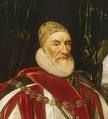
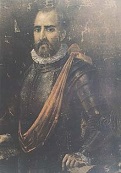
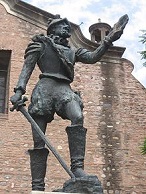

1573 On Jan. 1 Scottish regent James Douglas, earl of Morton sends Sir William Drury to lay seige to Edinburgh Castle, and secy. of state William Maitland again becomes the queen's champion, defending the castle along with Sir William Kirkcaldy of Grange (1520-73); too bad, in May they are forced to surrender, and Maitland dies in prison, while Kirkcaldy is hanged on Aug 3. On Jan. 1 a revolt against duke Guidobaldo II della Rovere of Urbino (d. 1574) over his excessive taxes is bloodily suppressed. On Mar. 7 the Peace of Constantinople ends the war between Venice and Turkey; Venice recognizes the Ottoman conquest of Cyprus, with only Crete (Candia) and the Ionian Islands left in their once great eastern empire; the rebuilt Ottoman navy ravages the coasts of Sicily and S Italy. In Mar. the English trade embargo on Spain is lifted. Rock 'em, rack 'em and shellac 'em? On Mar. 29 after sieging Haarlem since Nov., the pro-Spanish Amsterdam army cuts off the Haarlemmermeer Lake, causing it to begin to starve, which causes the mad pop. to murder several pro-Spanish POWs on May 27; on July 13 Haarlem surrenders to the Duke of Alva after 7 mo., and the pop. saves itself with a 240K guilder ransom, while the defending army is slaughtered and the city has to host a Spanish garrison; the Spanish lose a total of 12K men; although it is a V for the Spanish it convinces the Dutch rebels that the Spanish can be beat; Alva finally sneaks out of the Netherlands (Brussels) to elude his creditors, after pillaging the towns of Mons, Malines, Zutphen, and Maarden, boasting that he had executed 18.6K heretics during his six years there, incl. 800 in one "holy week" - the original holy no-fault insurance? On Apr. 14 Elizabeth I of England writes the soundbyte: "We are given to understand that a nobleman named 'Sorley Boy' [MacDonnel] and others, who be of the Scotch-Irish race", becoming the first known reference to the Scotch-Irish (Ulster Scots) from NE Ireland. In Apr. the gov. of Asuncion sends Spanish conquistador Juan de Garay (1528-83) with 80 men on an expedition up the Parana River, founding the city of Santa Fe de la Vera Cruz (modern-day pop. 450K) in modern-day NE Argentina near the junction with the Cayasa River, later moving after constant flooding to the junction near the Salado River 106 mi. N of modern-day Rosario; in 1576 Garay is appointed gov. of Asuncion. On May 11-15 Duke Henry of Valois is elected king of Poland, and in July the Edict of Boulogne (Peace of La Rochelle) is signed by Charles IX in Chateau de Madrid in Bois de Boulogue, ending the Fourth French War of Religion (begun 1572), with the Huguenots (what's left of them) granted an amnesty but with severely curtailed rights, with freedom to worship only in La Rochelle, Montauban, and Nimes, and only in their homes; assemblies for the purpose of marriage and baptism can be presided over certain Protestant nobles, with a max of 10 attendees outside the family - is chateauneuf for him? On July 6 after being appointed corregidor of Potosi, Peru in 1571, and commissioned by the gov. of Tucuman Province to explore NW Argentina, leaving Santiago del Estero last year with 100 men and 40 supply wagons, the city of Cordoba (Córdoba), Argentina on the Suquia River in the foothills of the Sierras Chicas Mts. 250 mi. S of Santiago de Estero and 435 mi. NW of Buenos Aires (modern-day pop. 1.3M/1.5M) is founded by Spanish conquistador Jeronimo (Jerónimo) Luis de Cabrera (1528-74), who names it after his wife's birthplace of Cordoba, Spain. In July Walter Devereux, 1st earl of Essex heads a military expedition to Ireland with 1.2K men to quell a revolt by wild Ulster chieftain Shane (Sean) O'Neill the Proud (1528-67) (ends 1575); too bad, after a storm he ends up wintering in Belfast, and by spring he's down to 200 men. In Aug. before sailing back to Plymouth with his treasure, Francis Drake sees the Pacific Ocean for the first time, and brings some captured potatoes from the West Indies to Sir Walter Raleigh, who cultivates them on his estates in Virginia and Youghal, County Cork, Ireland; he also brings samples of tobacco - now millions of new Irish will sprout up, all having a bad habit, and knowing where to migrate when they overbreed? On Oct. 3 the 1568 Ottoman-Hapsburg Hungarian peace treaty is renewed. Paolo Veronose is called before the Inquisition in Rome. Francis Walsingham becomes Elizabeth I's secy. of state. The Holy League under Don John of Austria takes Tunis from the Turks for the Spanish (until 1574). The Earl of Essex attempts to establish a colony in Antrim on the NE shore of Lough Neagh; in July 1575 Essex sends Francis Drake and John Norreys to oust Scottish refugees on the reverse L-shaped Rathlin Island, massacring hundreds of men, women, and children of Clan MacDonnell. James Hepburn, 4th earl of Bothwell is placed in close confinement in Dragsholm Castle in Zealand, Denmark where he goes insane until his death in 1578. Japanese warlord Oda Nobunaga (1534-82) ushers in the Azuchi-Momoyama Period in Japan (ends 1603); the gold-splashed Momoyama (Jap. "Peach Hill") Art Period in Japan begins (ends 1615). After galleons began arriving there from Asia in 1550, causing 30 Spanish families to move there to establish a permanent base, building a port and a road to Mexico City in 1531, and the Marques Wharf between Bruja Point and Diamond Point in 1533, Spanish king Philip II declares the port city of Acapulco, Mexico (Nahuatl "Acapolco" = where the reeds are washed away) (modern-day pop. 687K) the official trading port of the Manila galleons in America, with a trading monopoly; the W end of the route in the Philippines is named Capul. Spanish viceroy Francisco de Toledo draws up rules for creation of reducciones (reductions) in South Am., self-sufficient Jesuit frontier settlements of a few thousand people each with their own churches and a barter-based economy, which become a bastion against Portuguese encroachment while stirring the jealousy of other Spanish settlers; 1.4M Indios of the former Inca Empire are resettled into 840 communities. Sir Humphrey Gilbert retires (until 1578), writing a plea to the queen to be allowed to find the NE and NW Passages (pub. 1576). William Howard, 1st Baron of Effingham (b. 1510) dies, and his son Charles Howard, 1st Earl of Nottingham (1536-1624) becomes 2nd Baron Howard of Effingham, then is made knight of the Garter next year, preferring the seafaring side of the service; he goes on to become lord high adm. under Elizabeth I, commanding the navy against the 1588 Spanish Armada - the Howard name keeps shalalaing regardless of strawberry alarm clocks? Targovishte (Bulgarian "marketplace") in Bulgaria 210 mi. NE of Sofia is first mentioned in Ottoman tax registers; by the 18th cent. it becomes a popular market for animals and craft products called Eski Cuma (Old Bazaar). Palacky U. in Olomouc, Moravia is founded by the Jesuits, becoming the 2nd oldest univ. in Czech.; alumni incl. Albrecht von Wallenstein; in the 1770s king HRE Joseph II turns it into a public univ. Joseph Scaliger begins pub. eds. of numerous Roman poets (until 1579), founding the modern scientific method of textual criticism. The first German cane sugar refinery is built in Augsburg. Capt. Francesco De Marche and Francesco Di Domenico of Bologna, Italy make the first ascent of Corno Grande, highest peak in the Italian peninsula. Architecture: Mexico City Cathedral is begun (finished 1813). Science: Constanzo Varolio (1543-75) of Italy pioneers a new method of dissecting the brain by starting at the base, and discovers the Optic Nerve and Pons. Music: Orlando di Lasso (1532-94), Patrocinium Musices. Nonfiction: Tycho Brahe (1546-1601), De Nova Stella. Francois Hofman, Francogallia; on election and deposition of kings. Heinrich Knaust (1520-80), Der Philosphischen, Hochtouren and Wunderbaren Kunst Bier zu Brauen (5 vols.); the first beermaking manual in Germany, describing 150 different beers, incl. "noble Hamburg beer the queen of all other wheat beers." Ambrose Pare (1510-90), Des Monstres; describes alleged monsters and marvels in nature - remember the frowns on the jugglers and the clowns when they did tricks for you? Poetry: Johann Fischart (1547-90), Der Flohatz; satiric poem on women. Isabella Whitney (1548-), A Sweet Nosegay, or Pleasant Posye Contayning a Hundred and Ten Phylosophicall Flowers; first woman to pub. secular poetry in English? Births: German astronomer Simon Marius (d. 1625) on Jan. 20 (Jan. 10 Old Style) in Gunzenhausen, Ansbach; spends his life in Ansbach. Belgian theologian Jacques Bonfrere (d. 1642) on Apr. 12 in Dinant. Bavarian Wittelsbach duke-elector (1597-1651) Maximilian I (the Great) (d. 1651) on Apr. 17 in Munich; eldest son of William V and Renata of Lorraine; brother of Ferdinand of Bavaria (1577-1650); educated at the Jesuit U. of Ingolstadt; husband (1595-1635) of Elizabeth of Lorraine (Renata) (daughter of Duke Charles III of Lorraine) and (1635-51) Maria Anna of Austria (daughter of HRE Ferdinand II); father of Ferdinand Maria (1636-79) by 2nd wife Maria Anna. English architect ("the English Palladio") Inigo Jones (d. 1652) (pr. IHN-ih-go) on July 15 in Smithfield, London; of Welsh ancestry. English William Shakespeare's patron (bi) Henry Wriothesley, 3rd Earl of Southampton (d. 1624) on Oct. 6 in Cowdray, Sussex; 2nd son of Henry Wriothesley, 2nd earl of Southampton (1545-81) and Mary Browne, daughter of Anthony Browne, 1st viscount Montagu (1528-92); educated at St. John's College, Cambridge U. French satirist Mathurin Regnier (Régnier) (d. 1613) on Dec. 21 in Chartres. English Gunpowder Plotter (Roman Catholic) Roger Catesby (d. 1605) in Lapworth, Warwickshire; educated at Oxford U. English archbishop of Canterbury (1633-45) William Laud (d. 1645) in Reading, Berkshire; educated at St. John's College, Oxford U. British (Welsh) vice-adm. Sir Robert Mansell (Maunsell) (Mansfield) (d. 1656) in Margam, Glamorganshire. Deaths: Spanish-born Jewish chief rabbi Radbaz (b 1479) in Safed, Palestine. Swedish Lutheran bishop (of Uppsala) Laurentius Petri (b. 1499); author of the Swedish Church Order. French chancellor Michel de l'Hopital (b. 1507) on Mar. 13 in Vignay (Bellebat?). English physician John Caius (b. 1510) on July 29 in London. English soldier William Howard, 1st baron Howard of Effingham (b. 1510). Italian architect Giovanni Sallustio Peruzzi (b. 1511). French Protestant philosopher Petrus Ramus (b. 1515) on Aug. 26; slain in the St. Bartholomew Massacre; his followers become known as the Ramists. Portuguese aristocrat Ruy Gomez de Silva (b. 1516) n July 29 in Madrid, Spain. Japanese warlord Takeda Shingen (b. 1521). Polish religious leader Peter Gonesius (b. 1525) in Wegrow (plague). Scottish secy. of state William Maitland of Lethington (b. 1525) (dies in prison). German duke (1566-72) Johann Wilhelm of Saxony (b. 1530) on Mar. 2 in Weimar. French dramatist-poet Etienne Jodelle (b. 1532) in July. Croatian humanist writer Pavao Skalic (b. 1534).







1574 In Feb. a failed coup in Saint-Germain with the aim of releasing Henry I de Bourbon, prince of Conde and Henry of Navarre (future Henry IV) from imprisonment at the royal court, along with successful Huguenot uprisings in Lower Normandy, Poitou, and the Rhine Valley lead to the Fifth War of Religion in France (ends May 6, 1576). On Mar. 8 English Capt. William Martin sieges Rockfort Castle on Clare Island in Connaught (Connacht), W Ireland, stronghold of notorious female Irish pirate Granuaile (Grainne) (Grace) O'Malley (1530-1600), and after 18 days gives up, enhancing her rep.; in 1577 she offers her services along with three galleys and 200 men to English gov. Sir Henry Sidney in Galway, but ends up getting caught raiding English lord Earl of Desmond, and imprisoned until 1581. On May 30 (St. Bartholomew's Day) Bad Boy French king (since Dec. 5, 1560) Charles IX (b. 1550) dies, and his sickly disgusting prick of a brother Henry of Valois, elected king of Poland in 1572 secretly rushes back to France 3 mo. after his coronation to become Henri (Henry) III (1551-89) (until Aug. 2, 1589), the lucky 13th (and last) Valois king of France, leaving Poland and its elective kingship for the much more cushy hereditary French throne; to stifle criticism he prohibits the age-old tradition of inserting political prophecies in almanacs - how does it feel when you're on your own with no direction home? In May after the Dutch city of Leiden joins the anti-Spanish revolt, the Spanish siege it, but it is saved when the dikes are cut, flooding the meadows and allowing William I's navy to sail in and relieve it on Oct. 3. In July the Earl of Essex resumes his military expedition in Ireland, treacherously capturing and executing O'Neill leader Sir Brian Mac Felim O'Neill of Clandeboy, then commits various other atrocities against the Scots of Rathlin Island before Elizabeth I tells him to cool it and return to England. On Aug. 17 after establishing good relations with the native Comechingones and leaving Cordoba going E and reaching the Parana River 200 mi. away and founding the Fort of San Luis near modern-day Santa Fe, Argentina, becoming the viceroyalty of Peru's first usable beachhead towards the Atlantic Ocean, jealous Capt. Juan de Garay (1528-83) from Asuncion gets Jeronimo Luis de Cabrera condemned by arbitrer Gonzalo de Abreu for insubordination, with his sentence of garoting commuted to decapitation on Aug. 17 in Lima (Santiago del Estero?). On Aug. 25 250-300 Turkish galleys with 75K-100K men under the command of Muslim convert adm. Cigalazade Yusuf Sinan Pasha (Scipione Cicala) (1545-1605) and grand adm. Uluj Ali Reis (Giovanni Diongini Galeni) (1519-87) capture the port of La Goleta in Tunisia, followed on Sept. 13 by Tunis, ending the Spanish Conquest of North Africa begun by Ferdinand II and Isabella I, and insuring Ottoman domination of the E and C Maghreb. On Nov. 22 Spanish navigator Juan Fernandez (Fernández) (1536-1602), after making repeated voyages between Panama and Peru or Chile and discovering the trade winds, shortening his sailing time so much that he ends up being tried and acquitted of witchcraft, and discovering a faster maritime route between Callao and Valparaiso that avoids the Humboldt Curent, discovers the Juan Fernandez Islands, which become a haven for pirates, incl. Alexander Selkirk; in 1966 Chile renames the islands of Mas Afuera as Alejadro Selkirk Island, and Mas a Tierra as Robinson Crusoe Island; meanwhile in 1575 Fernandez allegedly discovers the continent of Australia and/or New Zealand. Pierre qui roule n'amasse pas mousse? On Dec. 12 debauched harem-dwelling blonde-haired sultan (since 1566) Selim II the Yellow (Sot) (b. 1524) (the Elvis of Turkey?) (did he die his hair jet black and use pomade?) dies, becoming the first Ottoman sultan to die in Constantinople, and after Nur-Banu hides his corpse in an icebox to give him time to arrive from Manisa, he is succeeded by her eldest son Murad (Murat) (Amurath) III (1546-95) as Ottoman sultan #12 (until 1595), which keeps going downhill like a rolling stone just as Europe is about to take over the world, becoming the last sultan to possess some field experience, while his mother Nur-Banu, the new Valide sultan (co-regent) (until 1583), and his chief wife Sofia Baffo pretty much pussy-whip him; speaking of pussy, the post of Kizlar Agha (Agha of the House of Felicity) (Chief Black Eunuch) is created to guard the harem of the sultans in Istanbul, starting with Ethopian-born Mehmed Agha, ending the domination of the palace by white eunuchs from the Balkans and Caucasus. Francesco I de' Medici (1541-87) becomes grand duke of Tuscany, going on to preside over the decline of the Medici Family. Monteferrat is elevated to a duchy, with Guglielmo I Gonzaga of Mantua as its first duke (until 1587). Viceroy Toledo organizes the mita (forced Indian labor) system in Peru for the silver mines at Potosi (Potosí) in modern-day Bolivia (which end up producing 45K tons of pure silver) and the mercury mines of Huancavelica (discovered in 1563-4, and founded on Aug. 5, 1572) - Baby Doe Toledo? Burgos, Spain, capital of Castile at the edge of the C Iberian plateau becomes an archiepiscopal see. Henry III founds the Academie du Palais in Paris, associated with de Baif's Academie, switching from music and poetry to eloquence in the service of morality. Architecture: The Longleat House in Wiltshire, England (begun 1568), designed by Robert Smythson is finished, becoming the seat of the marquesses of Bath. Nonfiction: Ulissi Aldovrandi, Antidotarii Bononiensis Epitome. Jean-Antoine de Baif (1532-89), Etrenes de Poeie Fransoeze an Vers Mezures (Etrénes de Poéie Fransoëze an Vers Mezurés); uses his new system of orthography. Theodore Beza (1519-1605), De Jure Magistrautum (On the Right of Magistrates); the right of a people to overthrow the govt. if it is forcing them the wrong way in religious matters. Thomas Blundeville (1522-1606), The True Order and Methode of Wryting and Reading of Hystories. Jean Bodin (1530-96), Discours sur les Causes de l'Extreme Cherte en France; how all that silver from Potosi, Peru is causing inflation. Hubert Languet, Vindiciae Contra Tyrannos; Huguenot political theories. Justus Lipsius (ed.), The Annals of Tacitus (Antwerp). Reginald Scott (Reynold Scot) (1538-99), A Perfect Platform of a Hop-garden, and necessary instructions for the making and maintenance thereof, with Notes and Rules for Reformation of all Abuses; first practical treatise on hop culture in England; 2nd ed. 1576; 3rd ed. 1578; "You cannot make above viii or ix gallons of indifferent ale out of one bushel of malt, yet you may with the assistance of hoppe make xviii or xx gallons of very good beere, neither is the hoppe more profitable to enlarge the quantity of your drink than necessary to prolong the continuance thereof; for if your ale may endure a fortnight, your beer through the benefit of the hoppe shall continue a month, and what grace it yieldeth to the taste, all men may judge that have sense in their mouths... And if controversy be betwixt Beer and Ale, which of them shall have the place of pre-eminence, it sufficeth for the glory and commendation of the Beer that, here in our own country, ale giveth place unto it and that most part of our countrymen do abhor and abandon ale as a loathsome drink." Births: Bavarian elector (Calvinist) Friedrich (Frederick) IV (d. 1610) on Mar. 5 in Amberg; son of elector Louis VI and Elisabeth of Hesse; husband (1593-) of Louise Juliana of Nassau (daughter of William I of Orange); father of elector Friedrich V (1596-1632), Elisabeth Charlotte of the Palatinate (1597-1660), and Louis Philip, count Palatine of Simmern-Kaiserslautern (1602-55). English composer John Wilbye (d. 1638) on Mar. 7 in Brome (near Diss), Suffolk. Swiss physician Thomas Platter the Younger (d. 1628) on July 24 in Basel; son of Thomas Platter the Elder (1499-1582); brother of Felix Platter (1536-1614). Scottish-English queen consort (of James VI/I) (1589-1619) Anne (Anna) of Denmark (d. 1619) on Dec. 12 in Skanderborg, Denmark; daughter of Frederick II and Sophia; older sister of Christian IV; wife (1589-) of James VI/I; namesake of Queen Anne's Lace. English poet Richard Barnfield (d. 1620) in Norbury, Staffordshire; educated at Brasenose College, Oxford U. English Renaissance man, physician, astrologer and mystic hermeticist Robert Fludd (Robertus de Fluctibus) (d. 1637) in Bearsted, Kent; son of Sir Thomas Fludd; educated at Oxford U. Dutch painter Jacob Molijn (d. 1649). Deaths: German humanist doctor Johannes Gunther (b. 1487). German scholar Joachim Camerarius the Elder (b. 1500) on Apr. 17 in Leipzig. Italian anatomist Bartolomeo Eustachio (b. 1500) on Aug. 27. Italian painter and art historian Giorgio Vasari (b. 1511) on June 27 in Florence. Italian printer Paulus Manutius (b. 1512). Italian singer-composer Domenico Maria Ferrabosco (b. 1513) in Feb. in Bologna. Austrian mystic mathematician and Copernicus' spokesman Rheticus (b. 1514) on Dec. 4. Spanish adm. Menendez de Aviles (b. 1519) on Sept. 17 in Santander. Grand duke of Tuscany Cosimo I de' Medici the Great (b. 1519) on Apr. 21. Dutch Flemish painter Hans Eworth (b. 1520). Ottoman sultan (1566-74) Selim II the Sot (b. 1524) on Dec. 12 in Constantinople. Spanish conquistador Jeronimo Luis de Cabrera (b. 1528) on Aug. 17 in Lima, Peru (beheaded). French explorer Rene Goulaine de Laudonniere (b. 1529) in St. Germain-en-Laye. French king (1560-74) Charles IX (b. 1550) on May 30.






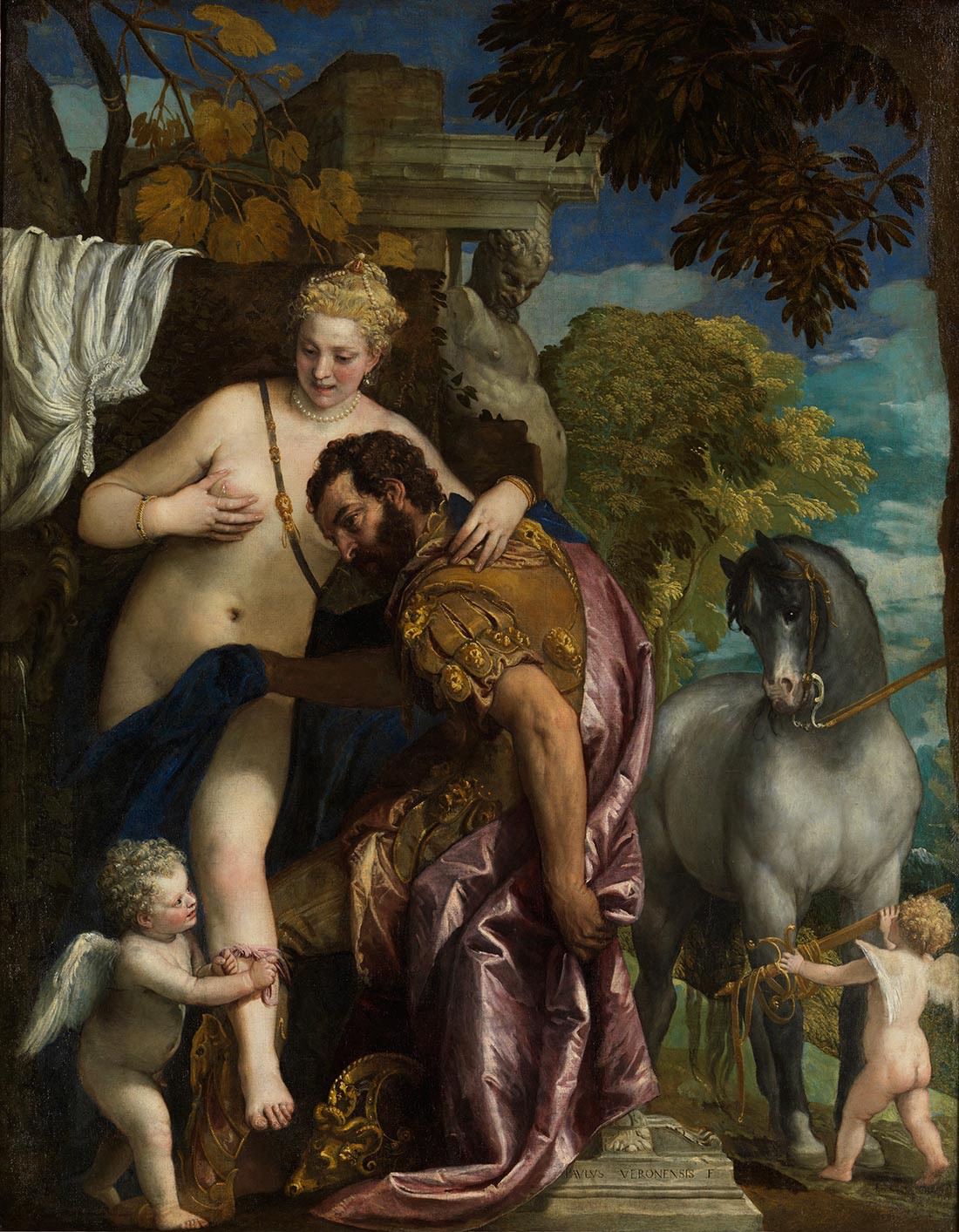
1575 Plague breaks out in Sicily, and spreads up to Milan, reducing the pop. of Venice by 90%; pop. of Paris 300K; London 180K; Cologne 35K. Between this year and 1600 192K slaves are transported from West Africa by the Portuguese. In Jan. the Protestant states of the Netherlands ask Elizabeth I to accept the crown of Holland and Zeeland, but she waffles because of her disapproval of republicanism and ends up offending them. On Feb. 8 Leiden U. in Leiden, South Holland is founded by Prince (1544-84) William I the Silent of Orange (1533-84) as a reward for their heroic defense against the Spanish the year before, becoming the oldest univ. in the Netherlands in modern times; they were offered the choice of a univ. or a tax cut; the city becomes known for as a center for science, gaining the nickname "City of Discoveries", with alumni and faculty incl. Jacobus van't Hoff, Johannes Diderik van der Waals, and Kamerlingh Onnes. On Feb. 13 Henry III is crowned king of France at Rheims Cathedral. In Apr. Henry III requests a renewal of the 1572 Treaty of Blois against Spain, to which Elizabeth I responds by giving him the Order of the Garter. On May 17 archbishop of Canterbury (since 1559) Matthew Parker (b. 1504) dies, and Lord Burghley nominates Edmund Grindal (1519-83), who opposes Elizabeth I's demand that he suppress discussion meetings of the Puritans, pissing her off; Parker leaves his collection of historical mss. to his alma mater Corpus Christi College in Cambridge. In the spring the Earl of Oxford travels to Europe, returns after squandering most of his inheritance, then presents Elizabeth I with a pair of embroidered gloves, causing gossip that they are lovers, and years later, that the Earl of Southampton (born this year) is their love child. In the summer Elizabeth I goes on another progress, culminating in the "princely pleasures" at Kenilworth, provided by her host the Earl of Leicester from July 9-18. On Sept. 21 (St. Matthew's Day) the San Mateo Hurricane devastates Puerto Rico. On Sept. 22 HRE Rudolf II is crowned king of Bohemia (until Mar. 11, 1611). On Sept. 22 after returning to England late last year, then being made earl marshal of Ireland by the queen and returning, only to fall ill with dysentery in Dublin Castle (claiming that he has been poisoned), Walter Devereux, 1st earl of Essex dies, and his studly son Robert Devereux (1566-1601) becomes the 2nd earl of Essex. On Sept. 26 Miguel de Cervantes is captured on the galley Sol near the Catalan coast by Algerian corsairs under Capt. Arnaut Mami (Mahomed the Albanian) ), and spends five years as a slave in Algiers, with four escape attempts until his family ransoms him in 1580. On Oct. 10 the Battle of Dormans sees French Roman Catholic hero Henry I, 2nd duke of Guise wounded, causing him to become known as Le Belafre (the Scarred), just like his daddy the 1st duke. In Nov. Essex returns from his 1573 Irish military expedition; Elizabeth I changes her daddy's policy of conciliating Irish chieftains and gets an act passed making all Ireland into shireland and investing the commissioners of justice with military powers which they soon abuse at will, pissing-off the Irish and causing them to look for a new William Wallace who will lead them in their fight for their free-ee-dom. At the Conference of Breda Philip II refuses to grant concessions to the Dutch rebels; meanwhile Diederik Sonoy, (a Protestant) becomes gov. of the Northern Quarter, and soon begins surpassing the Catholic Inquisitors in his cruel torture of Roman Catholics, despite warnings to desist by "Father William" of Orange - freedom is just a word for nothing left to what? Akbar the Great conquers Bengal, and next year it becomes part of the Mughal Empire, causing the pop. to convert to Islam. French Huguenot leader Philippe de Mornay, Seigneur du Plessis-Marly (1549-1623) is captured then ransomed, taking refuge with Henri de la Tour d'Auvergne, duc de Bouillon at Sedan, where he marries Charlotte Arbaleste. Spain declares bankruptcy again. The English Parliament grants freedom from arrest to its members and their servants. Elizabeth I orders the Coventry Cycle of Mystery plays (which the Puritans had banned) to be restored. By this year only three of Catherine de' Medici's seven children are still alive: Henri III, Duke Francois of Alencon, and Marguerite of Navarre. In 1575 (1576?) after joining Francis Drake's expedition to Panama in May 1572, returning to England with him, and sailing back to Panama with a 120-ton ship with a crew of 70, John Oxenham (Oxnam) (-1580) becomes the first non-Spanish Euro explorer to cross the Isthmus of Panama after starting from the coastal town of Careta and receiving aid from the Cimarrones to climb the Cordillera de San Blas to the mouth of the Chucunaque River on the Pacific Ocean; too bad, after building a shallow 45-ft. oared boat from milled cedar trees (first ship built in the New World by Englishmen), and using it to pirate Spanish ships, he is captured in mid-1578, and executed in Lima on Sept. 30, 1580. The Roman Catholic Church prohibits tobacco-smoking in any place of worship in the Spanish colonies. The Portuguese occupy and rebuild the destroyed town of Anfa (Casablanca) on the Moroccan coast, and name it Casa Branca (Casablanca); the surrounding Muslim tribes keep it under constant attack until they abandon it after an earthquake in 1755. The English word "goodbye" (originally godbye), a contraction of "God be with ye" is first used in a letter by Gabriel Harvey (1552-1631). The first Benandanti (It. "Good Walkers") from Friuli, Italy, claiming to travel out of their bodies while asleep to fight bad witches and ensure good harvest are accused of being heretics or witches; the last are in 1675. The Congregation of the Oratory is founded in Rome by St. Philip Neri. Louis de Gonzague (Gonzaga), Duc de Nevers (1539-95) succeeds his uncle Ferdinand de Gonzaque as grandmaster of the Priory of Sion (until 1595) :). Architecture: Tycho Brahe begins Uraniborg Castle ("fortress of the heavens") (finished in 1580), with a complete observatory, all paid for by Frederick II of Denmark on Hven Island between Sweden and Denmark; too bad that Frederick II's successor starts cutting him off, causing him to go to Bohemia in 1597. Inventions: The first European imitations of Chinese porcelain are made in Venice and Florence. Music: William Byrd (1540-1623) and Thomas Tallis (1505-85), Cantiones Sacrae (34 motets); dedicated to the queen after she grants them a monopoly in music printing. Art: Paolo Veronese (1528-88), Moses Saved from the Waters; Mars and Venus United by Love (157?). Nonfiction: Georg Braun and Franz Hogenberg, Map of London, England (Cologne); earliest known map of London. Thomas Blundeville (1522-1606), Arte of Logike; not pub. until 1599. Huarte de San Juan (1529-88), Examin de Ingenios para las Ciencias; the first to connect psychology with physiology. Christopher Saxton, Country Atlas of England and Wales. George Turberville, Book of Falconrie. Abraham Veale, Cookbook; English. Poetry: Tulsi Das (1532-1623), Ramcaritmanas; a retelling in the Hindi language of the story of ancient hero Rama, sparking his special worship in India. George Gascoigne (1539-78), The Posies. Torquato Tasso (1544-95), Gerusalemme Liberata (Jerusalem Liberated); about the Crusades. Plays: Anon., Gammer Gurton's Needle (English farce). Novels: Johann Fischart (1547-90), Geschichtsklitterung; adaptation of Rabelais' "Gargantua". Births: French mystic statesman-cardinal (founder of the French congregation of the Oratory) Pierre de Berulle (d. 1629) on Feb. 4 in Chateau Cerilly (near Troyes), Champagne. English clergyman-mathematician William Oughtred (d. 1660) on Mar. 5 in Eton, Buckinhamshire; educated at King's College, Cambridge U.; inventor of logarithmic scales and the slide rule; creator of the terms "x" for multiplication, "sin" for sine, and "cos" for cosine. French queen (1600-10) Marie (Maria) de' Medici (de Medici) (de Medicis) (d. 1642) on Apr. 26 in Florence; daughter of Grand Duke Francesco I de' Medici of Tuscany (1541-87) and Archduchess Johanna of Austria (1547-78) (daughter of HRE Ferdinand I and Anna of Bohemia); 2nd wife of Henri IV of France (1600-10); mother of Louis XIII (1601-43). German Jesuit astronomer (anti-Galileo) Christoph Scheiner (d. 1650) on July 25 in Markt Wald (near Mindelheim), Swabia. Italian Baroque painter Guido Reni (d. 1642) on Nov. 4 in Bologna; pupil of Denis Calvaert (1540-1619). British (Welsh) Benedictine monk-priest (St.) John Roberts (d. 1610) in Trawsfynydd, Merionethshire, N Wales; educated at St. John's College, Oxford U.; converts to Roman Catholicism in 1598. English "Weep, O Mine Eyes", "All Creatures Now" madrigal composer John Bennet (d. 1615). English pretender Arbella Stewart (Arbella Stuart) (d. 1615); daughter of Elizabeth Cavendish (-1581) (daughter of Bess of Hardwick) and Charles Stewart, 6th earl of Lennox, brother of James VI/I's father Henry Stewart, Lord Darnley. English Baptist co-founder Thomas Helwys (d. 1616); collaborator of John Smyth (1570-1612). Italian politician (favorite of Louis XIII's mother) Concino Concini, Marquis d'Ancre (d. 1617) in Florence. French "Sophonisbe" soldier-dramatist-economist Antoine de Montchrestien (d. 1621) in Falaise, Normandy. German theologian-theosophist-mystic Jakob Boehme (Böhme) (Behmen) (d. 1624) in Goerlitz, E Germany; brought up Lutheran; has his 1st mystical vision in 1600 via a beam of sunlight in a pewter dish, and his 2nd in 1610; influences mystics and Romantics alike for cents. English Jacobean "The Revenger's Tragedy", "The Atheist's Tragedy" poet-dramatist Cyril Tourneur (d. 1626). Italian "Pentamerone" poet and fairy tale writer Giovanni Battista (Giambattista) Basile (d. 1632) in Feb. (1575?) in Naples. British MP (1601-2) and lord deputy of Ireland (1622-9) Henry Cary, 1st Viscount Falkland (d. 1633); son of Sir Edward Cary and Catherine Knevet; educated at Exeter College, Oxford U.; husband (1602-) of Elizabeth Tanfield (1585-1639); father of Lucius Cary, 2nd viscount Falkland (1610-43); created viscount in 1620. German publisher Johann Carolus (d. 1634) in Muhlbach-sur-Munster. German composer Johann Stadlmayr (d. 1648) in Bavaria. Deaths: Spanish-born Jewish legal scholar Rabbi Joseph ben Ephraim Karo (b. 1488) on Mar. 24 in Safed, Palestine. Flemish religious poet Anna Bijns (b. 1493) in Antwerp. Spanish poet and statesman Diego Hurtado da Mendoza (b. 1503). English archbishop of Canterbury Matthew Parker (b. 1504) on May 17. English Bible scholar Richard Taverner (b. 1505) on July 14 in Oxford. Italian scholar Federico Commandino (b. 1509) on Sept. 5. French Roman Catholic marshal Gaspard de Saulx, sieur de Tavannes (b. 1509) in Sully; leaves valuable memoirs. English adventurer Sir Peter Carew (b. 1514) on Nov. 27. Dutch architect Cornelis Floris (b. 1514). Croatian Lutheran scholar Matthias Flacius (b. 1520) on Mar. 11 in Frankfurt, Germany. Spanish explorer Francisco de Ibarra (b. 1534) on June 3 in Panuco, Sinaloa, Mexico. Italian anatomist Constanzo Varolio (b. 1543).


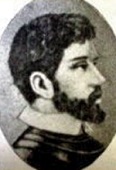

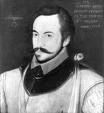



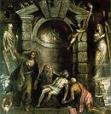
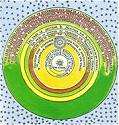

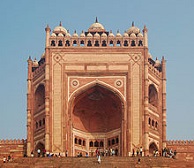
1576 On Jan. 25 attracted by the silver mines of Cambambe, the Portuguese colonize Angola in Africa, and found the port city of Luanda (São Paulo da Assunção de Loanda) (modern-day pop. 2.8M) with 400 settlers (100 families) and 400 soldiers under Paulo Dias de Novais (1510-89) - luanda take a little boat trip? On Feb. 8 radical Protestant MP Sir Peter Wentworth (1529-96) (brother of Radical Protestant MP Paul Wentworth) delivers his Famous Wentworth Parliamentary Address, arguing that MPs have the right to discuss any subject they wish, incl. Elizabeth I's succession, causing the other MPs to cut him off and send him to the Tower; when he gets out he is unrepentant, getting sent there again next Feb., becoming the first famous English MP? In Feb. Philip II sends Sieur de Champigny to ask Elizabeth I if she intends to aid Protestant rebels in the future, but she keeps him waiting for two weeks and sends the envoy back with an enigmatic answer. On Apr. 25 Holland and Zeeland, the two strongly Calvinist provinces (out of 17 provinces) of the Low Countries sign an Act of Federation in Delft, and since Muslim-killer Don John of Austria doesn't have a drop of toleration in him, war is inevitable. In the spring Elizabeth I drops all plans for marrying the twerpy duke of Alencon. On Apr. 9-June 7 the Lutheran League of Torgau meets in Torgau, Saxony, drawing up the Formula of Concord, eliminating Calvinism from Lutheranism, which is presented to elector August of Saxony next May 28, and signed by three electors, 20 dukes and princes, 35 free imperial cities, 24 counts, four barons, and 8K pastors, representing two-thirds of the Lutherans in Germany, but rejected by the Lutherans of Hesse, Zweibrucken, Anhalt, Pommeranian (land), Holstein, Denmark, Sweden, Nuremberg, Strasburg, and Magdeburg, and lobbied against by Elizabeth I of England. Set the boil to low? On May 6 after his brother the duke of Alencon supports the Protestant army sieging Paris, the Fifth French War of Religion (begun 1574) ends with the Edict of Beaulieu (Peace of Monsieur), promulgated by Henry III from Beaulieu-les-Loches, officially tolerating the "so-called reformed religion" in France again, except in Paris and the court, with special chambers created in eight parliaments with equal numbers of Huguenots and Catholics, and the Massacre of St. Bartholomew disclaimed, with the families who suffered from it reinstated; Alencon is created duke of Anjou; Henry of Navarre is released from house arrest and returns to the Protestant faith, causing the Duke of Guise and his brothers to form the Catholic (Holy) League of France to unite all French Catholics against Protestants; the "War of the Three Henries", a 3-way power struggle between Henry III, the Guise family, and the Huguenots begins, while the king's brother duke Francois of Alencon is used by the Guises. On May 24 Persian shah (since May 23, 1524) Tahmasp I (b. 1514) dies, and his son Ismail II (1537-77) becomes Safavid shah #3 of Persia (until Nov. 24, 1577); his younger brother Heydar Mirza seizes the throne and imprisons him, but the Qizilbash Asfhar tribe assassinates him and puts their boy Ismail back on the throne; too bad, he proves a cruel tyrant, and doesn't last long; meanwhile next year an Ottoman-Persian War begins (ends 1590) when the Ottomans attempt to conquer the Caucasus and Azerbaijan. In May Don John of Austria (most famous soldier in Europe) is ordered by his half-brother Philip II to proceed to the Low Countries as the new regent (gov.-gen.) of the Netherlands, and he accepts on condition that his plan to liberate Mary, Queen of Scots is approved, only to find that his secy. Juan de Escobedo (-1578) had not been able to get cheap Philip II to pay for it, making success in the Low Countries a condition, causing Don John to speed up and race across France disguised as a Moorish slave. On June 21 the gruesome Battle of Haldighat is a V for Mogul Emperor Akbar the Great over Rana Pratrap Singh of Mewar, whose blue-tinged horse Chetak (Cetak) is KIA. In the fall Elizabeth I orders archbishop of Canterbury Edmund Grindal to suppress all Puritan forms of worship, but he balks, writing his objections to her in Dec., causing her to get more pissed-ff and ban him from court. On Oct. 12 HRE (since 1564) Maximilian II (b. 1527) dies, and his brother Rudolf II (1552-1612) (with the hoglike Hapsburg lip) is crowned HRE and archduke of Austria (until jan. 20, 1612), proving to be an able astronomer but a dud as a ruler, suffering a nervous breakdown next year - still going with that AEIOU Austria rules the world bullwhacky, hand me my telescope and Miltown pills? On Oct. 15 the U. of Helmstedt (Academia Julia) is founded in Brunswick-Wolfenbuttel, Germany by the prince of Brunswick-Wolfenbuttel (1568-89) Julius, Duke of Brunswick-Luneburg (Brunswick-Lüneburg) (1528-89), becoming the first Protestant univ. of the N Holy Roman Empire, training Lutheran preachers along with law, medicine, and liberal arts. On Nov. 17 Queen Elizabeth's Ascension Day is upgraded to a great holy day ("Golden Day") in England. In Nov. Philip II's army of Flanders mutinies over an arrears in pay and sacks Antwerp in the "Spanish Fury", burning 600 houses and killing thousands, causing Dutch Roman Catholics and Protestants to unite against them under William of Orange, agreeing on Nov. 8 in Ghent to the Pacification of Ghent, granting limited tolerance to Protestants while authorizing a new army to take care of the mutinous troops; when Don John arrives in Luxembourg he is informed that he must accept the Pacification of Ghent to become gov.-gen.; Elizabeth I gives the Protestants gold in secret while putting on an act to fool Philip II. In Dec. the Sixth French War of Religion (ends 1577) begins when the Catholic League led by Duke Henry I of Guise and the Estates-Gen. of Blois fail to honor the Edict of Beaulieu, with Huguenots rebelling in Poitou and Guyenne. In Dec. the Admiral's (Lord Howard's) (Earl of Nottingham's) Men (Company), backed by powerful patron Lord High Adm. Charles Howard, 1st Earl of Nottingham (1536-1624) (cmdr. of the English fleet against the 1588 Spanish Armada) began performing at the Theatre, the first purpose-built public theater in London, becoming the #2 acting troupe after Shakespeare's Lord Chamberlain's Men. In Dec. after James Burbage (Burbadge) (1531-97) (father of Richard Burbage) gets pissed-off at the city of London for passing regulations on Inn-yards in 1574 and signs a 21-year lease of land in Finsbury Fields, Shoreditch (modern-day Hackney) outside the City of London Wall in an area known for houses of sin, with permission to build a playhouse, he opens The Theatre, becoming London's 2nd permanent theater after the Red Lion (1567), and the first successful permanent dedicated theatre built in England since Roman times, becoming home to the Lord Chamberlain's Men and actor-playwright William Shakespeare. Barom Reachea I dies, and Chey Chettha I (-1594) becomes king of Khmer (until 1594). English navigator Martin Frobisher (1535-94) (who had started out as a cabin boy in 1544) is placed in command of an expedition to the New World with the aid of the earl of Warwick, becoming the first English attempt to find a Northwest Passage to India, sailing in the ships Gabriel and Michael; he continues on the Gabriel after Michael rows back to shore, then 2 mo. later discovers Frobisher Bay in Canada; he returns with some pieces of "black earth", rumored to be gold, causing him to be sent on a 2nd voyage by the queen next year, which fails to find valuable ores, causing a 3rd flop to be tried, with Frobisher continuing in the queen's favor. The Jews of Poland are allowed to carry on unrestricted trade. Francis Bacon leaves Cambridge, and travels for three years with Sir Amyas Paulet, English ambassador in France, visiting Navarre, and later inspiring Shakespeare's play Love's Labour's Lost. Architecture: Andrea Palladio begins decorating the Il Redentore (Non Basilica del Santissimo Redentore) Church in Venice (finished 1577); the church is completed in 1592. Buland Darwaza in Fatehpur Sikri (25 mi. from Agra), India the largest gateway in India is built by Akbar the Great to commemorate his conquest of Gujarat, becoming the highest gateway on Earth. Science: Flemish physician-botanist Carolus Clusius (1526-1609) pub. a treatise on the flowers of Spain and Portugal, founding Modern Botany. English hydrographer Robert Norman rediscovers the Magnetic Dip (Inclination) of the compass (1544). French mathematician Francois Viete (Franciscus Vieta) (1540-1603) discovers Music: Tomas Luis de Victoria (1548-1611), Liber Primus. Nonfiction: Francois de Belleforest, Histoires Tragiques; incl. the story of Danish prince Amlet, who avenges his father's murder on his uncle after he marries his mother Geruthe, becoming a source for William Shakespeare'e "Hamlet"? Jean Bodin (1530-96), Six Books on the State (Commonwealth) (Les Six Livres de la Republique); rev. ed. in 1586; coins the term "republic" (Lat. "respublica" = govt. by the people) for matters of public law; a discussion of the ideal form of govt., which he considers to a hereditary monarchy be midway between the absolute monarchy of Niccolo Macchiavelli and the popular sovereignty of Protestants and monarchomachs; a big hit, helping him found the Politiques, who help bring about the 1598 Edict of Nantes; "The sovereign prince is only accountable to God"; on the importance of climate in shaping the character of a people (climatic determinism); "Men of a fat and fertile soil are most commonly effeminate and cowards, whereas a barren country makes men temperate by necessity, and by consquence careful, vigilant, and industrious"; "Sovereignty is that absolute and perpetual power vested in a commonwealth." Carolus Clusius (1526-1609), Treatise on the Flowers of Spain and Portugal; founds modern botany. John Dee (1527-1609), General and rare memorials pertayning to the Perfect Arte of Navigation; advocates British imperial expansion; frontispiece incl. a drawing of Britannia kneeling by the shore beseeching Elizabeth I to strengthen her navy, popularizing the term "British Empire". Thomas Digges (1546-95) (ed.), A Prognostication Everlasting; his father's perpetual almanac, with a new appendix containing the first detailed discussion of the Copernican heliocentric theory in the English language; "This orb of stars fixed infinitely up extends itself in altitude spherically, and therefore immovable the palace of felicity garnished with perpetual shining glorious lights innumerable, far excelling over [the] Sun both in quantity and quality the very court of celestial angels, devoid of grief and replenished with perfect endless joy, the habitacle for the elect." Sir Humphrey Gilbert (1539-83), A Discourse of a Discovery for a New Passage to Cataia; gets him a royal charter in 1578 to explore and colonize North Am. Fiction: Johann Fischart (1547-90), Das Gluckhafft Schiff von Zurich (satire). Poetry: Remy Belleau (1528-77), Les Amours et nouveaux Eschanges des Pierres precieuses (last book); poems of praise about precious stones. George Gascoigne (1539-78), The Steele Glas (verse satire). Art: Titian (1477-1576), Pieta; Christ suffers in a night setting; intended for his own tomb chapel; his last painting, left incomplete at his death, and finished by Jacopo Palma the Younger. Births: German scholar (Protestant-to-Roman-Catholic-convert) Caspar Schoppe (Jasper Scioppius) (d. 1649) on May 27 in Neumarkt, Upper Palatinate. Italian Baroque painter Giovanni Battista Viola (d. 1622)on June 16 in Bologna. English composer-organist (Winchester College) Thomas Weelkes (d. 1624) on Oct. 25 in Elsted, Sussex. English "Pericles, Prince of Tyre" dramatist George Wilkins (d. 1618). English wit and travel writer Thomas Coryat (Coryate) (d. 1617) in Somerset; educated at Winchester School, and Gloucester Hall, Oxford U.; court jester to James I. English Pilgrim Father John Carver (d. 1621); gov. #1 of Plymouth Colony. French engineer-physicist Salomon de Caux (Caus) (d. 1626); gets an English education. English dramatist-satirist John Marston (AKA W. Kinsayder) (d. 1634) in Coventry; educated at Oxford U. English-born Am. anti-Puritan atty.-writer Thomas Morton of Merry Mount (d. 1646). Am. Puritan gov. of Mass. (1634-) Thomas Dudley (d. 1653) in Northampton; founder of Newtowne, Mass. and First Church in Charlestown, Mass.; overseer of Harvard College. Spanish painter ("El Viejo") Francisco de Herrera (d. 1656); founder of the Seville School. Deaths: Venetian painter Titian (b. 1477) on Aug. 27 in Venice (plague); only victim of the plague to be given a church burial; many of his last paintings are stolen by looters - one shy of the big 100 and a lousy bug gets ya? German poet Hans Sachs (b. 1494); leaves 34 vols. containing 6.3K Meisterlieder - less is not more? Italian mathematician Girolamo Cardano (b. 1501) on Sept. 21 in Rome (suicide). Hungarian composer-lutenist Balint Bakfark (b. 1507) on Aug. 15; leaves Gaillarde Non Dite Mai - Bakfark is almost as fun to say as Bo Bice? Italian astronomer Aloysius Lilius (b. 1510) in Rome. Dutch portraitist Sir Antonis Mor (b. 1520). Austrian HRE (15464-76) Maximilian II (b. 1527) on Oct. 12 in Regensburg. Dutch anatomist Volcher Coiter (b. 1534); studied animal hearts, noting that the auricles contract before the ventricles, that the heart lengthens in systole and shortens in diastole, and that detached pieces of heart muscle continue to beat. English earl marshal Walter Devereux, 1st earl of Essex (b. 1541) on Sept. 22 in Dublin (dysentery) (poisoned by the earl of Leicester?).
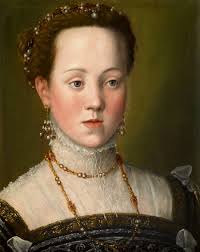
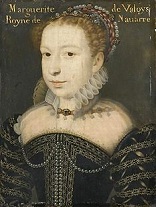

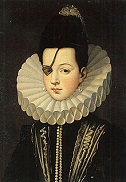

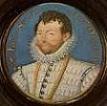




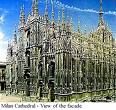


1577 On Jan. 1 the 1568 Ottoman-Hapsburg Hungarian peace treaty is renewed. In Jan. the Dutch reject an offer from Elizabeth I to mediate the dispute between the Dutch and Don John of Austria, who first tries to keep his mutinous troops then requests that they be given ships, then settles for them marching S loaded with their plunder, finally issuing the Perpetual Edict of 1577 to settle the civil war in the Netherlands, not exactly accepting the Pacification of Ghent, but requring a panel of theologians to hammer the toleration thingie out, which is rejected by William of Orange; meanwhile Walsingham's spies uncover a plot by Don John (assisted by the Duke of Guise) to invade England with 10K troops, depose Elizabeth, and marry Mary Stuart, which causes Elizabeth to knight Walsingham; Don John's plan never comes off because that's why he wanted them ships, but in May he makes his Joyous Entry into Brussels, promising to defend its historic privileges, along with that of the 17 Dutch provinces. On Apr. 17 the Battle of Lubieszow Lake sees the forces of the city of Danzig led by Jan Winkelbruch decisively defeated by Polish Winged Hussars led by Jan Zborowski. On May 21 after Queen Joan tries in vain to stop it, the law forbidding pesky Jews from emigrating to the Spanish colonies in Am. is repealed - let the profits roll? In May Elizabeth I places archbishop of Canterbury Edmund Grindal under house arrest at Lambeth Palace, deprives him of his jurisdictional powers, and orders the bishops to suppress all forms of Puritan worship; after the earl of Leicester intercedes, she lets him remain in office, but bans him from carrying out his official duties, leaving the Church of England without a spiritual leader for five years (until 1582). In the summer there is another bad outbreak of the plague in London, causing the queen to remain at Greenwich. In July after taking care of his scandalously loose low-class widowed mother Barbara Blomberg (1527-97) (former mistress of HRE Charles V) by promising to send her to Italy to meet Margaret of Parma but actually shipping her off to Spain, Don John of Austria meets Margaret (Marguerite) of Valois, Queen of Navarre (1553-1615), daughter of Henry II and Catherine de' Medici, and sister of Frances II, Charles IX, Henry III, and Elizabeth of Valois, and after she leaves he seizes Namur, after which rumors spread of a love tryst; meanwhile he sends his secy. Juan de Escobedo (1530-78) to plead with Philip II to send his so-called mutinous troops back so he can finish off the Protestants, and the states-gen. figure him out and declare war on him; meanwhile when Escobedo gets to Spain, he ends up blabbing about a love affair between Philip II's chief secy. (since 1543) Antonio Perez (1540-1611) of Aragon (former friend and now mortal enemy, who had got Escobedo his job to spy on Don Juan, only to find him become loyal) and the widowed (since 1573) eyepatched Ana Mendoza de la Cerda (1540-92), princess of Eboli, which, combined with a bunch of lies concocted by Perez, causes pissed-off Philip II to order his assassination, which after three attempts is finally done on Easter Monday night, Mar. 31, 1578 in an alley outside the Church of St. Maria in Madrid (demolished 1868); too bad for Perez, Philip II finally becomes suspicious of him and gets him in legal and criminal hot water for years, getting the princess put under house arrest for life, while he escapes one jail after another until fleeing to France on Nov. 23, 1591 disguised as a shepherd in a snowstorm, spending the last 20 years of his life selling all his state secrets and painting Philip II as a cruel, intolerant, fanatical, er, never mind. In Sept. after Henry of Navarre is recognized as the head of the Huguenot party, the Sixth French War of Religion (begun 1576) ends with the Peace (Treaty) of Bergerac, with Henry III rescinding most of the concessions to the Protestants made in the Edict of Beaulieu, confirming it six days later in the Edict of Poitiers. On Nov. 11 Elizabeth I appoints anti-Puritan Sir Christopher Hatton (1540-91) to her Privy Council, knights him, and makes him vice-chamberlain of her household; he also becomes her lover (does he do it with his hat on?); meanwhile in Nov. not-yet-sir Francis Drake (1543-96), after being presented to the queen and sponsored by Hatton sets out from England with five ships to circumnavigate (not circumcize?) the world via Cape Horn while sacking Spanish towns and harrying Spanish ships that had been attacking English ships ("So it is that I would be revenged on the king of Spain for divers injuries that I have received" - Elizabeth I); his own ship is the Pelican, which he renames the Golden Hind (Hinde) as he enters the Strait of Magellan in honor of Hatton, whose coat of arms is a golden female deer; he completes his epedition in 1580, and is knighted in 1581. Danzig surrenders, ending Polish opposition to Stephen Bathory; Danzig issues a silver necessity thaler containing one of the finest numismatic portraits of Christ. Lord Nobunaga dispatches his chief gen. Hideyoshi to conquer 12 W Honshu provinces; Hideyoshi seizes Nagasaki. The Doge's Palace in Venice burns down, taking Titian's painting of the Battle of Cadiz with it. Sir Fulke Greville, 1st Lord Brooke (1554-1628) goes to Queen Elizabeth I's court with his handsome poetic school chum Philip Sidney (1554-86), and both become prominent courtiers. Pope Gregory XIII commissions Giovanni Pierluigi da Palestrina to totally revise the Gregorian Chant. Katharina Kepler gets her 6-y.-o. son Johannes Kepler out of bed to see Tycho Brahe's comet. A botanical garden is founded in Leyden, presided over by de l'Ecluse. The Curtain Theatre, London's 2nd playhouse opens in Finsbury (until 1622?). A Hebrew press is established in Safed, Palestine by Eliezer Ashkenazi and Abraham Ashkenazi, becoming the first press E of Constantinople and W of China; it stays in operation for only a decade. Architecture: High Gothic Milan Cathedral is consecrated by Cardinal Carlo Borromeo. Science: Tycho Brahe measures a comet as at least 4x as distant as the Moon, proving that they're not atmospheric phenomena. Nonfiction: William Allot, Thesaurus Bibliorum. Jacob Andreae, Martin Chemnitz et al., Lutheran Book of Concord. Richard Eden, History of Travel in East and West Indies. William Harrison, The Description of Britain; incl. a description of the important place of hopped beer in Elizabethan society, calling it the preferred beverage of the elite, while unhopped ale is an "old and sick men's drink"; contains a complete description of the beer-making process; "Our drink, whose force and continuance is partly touched already, is made of barley, water, and hops, sodden and mingled together, by the industry of our brewers in a certain exact proportion." Raphael Holinshed (1529-80) (ed.), Chronicles of England, Scotland, and Ireland (2 vols.) (1577, 1587); histories of England, Scotland, and Ireland by various writers; incl. Description of Elizabethan England by William Harrison (1534-93); Holinshed wrote the history of England; started out as a universal history by his boss, Dutch-born printer Reginald (Reyner) Wolfe (-1573), and this is an abridged vers.; used by Elizabethan dramatists incl. Shakespeare. Philippe de Mornay (1549-1623), Excellent Discours de la Viet et de la Mort. St. Teresa of Avila (1515-82), The Interior Castle; the soul as a crystal globe-shaped castle with seven mansions representing the seven stages to union with God. Johann Weyer, De Praestigiis Daemonum; incl. False Hierarchy of Demons (Pseudomonarchia Daemonum). Art: El Greco (1541-1614), The Disrobing of Christ (1577-9) (Toledo Cathedral); his first work in Spain. Martin de Vos (1532-1603), Nativity. Music: Anon., Geuzenlied Boek; an anthology of Dutch songs, incl. the nat. anthem Wilhemus van Nassouwe (William of Nassau) (AKA Het Wilhelmus or The William), written by Philip de Marnix (1540-98)? Births: Italian tragic heroine Beatrice Cenci (d. 1599) on Feb. 6 in Rome. English "Anatomy of Melancholy" writer-clergyman Robert Burton (d. 1640) (AKA Democritus Junior) on Feb. 8 in Lindley Leicestershire; educated at Brasenose College, Oxford U. Danish-Norwegian king (1588-1648) Christian IV (d. 1648) on Apr. 12 in Frederiksborg Palace; son of Frederick II and Sofie of Mecklenburg-Schwerin. Flemish "Rubinesque" baroque painter and diplomat Sir Peter Paul Rubens (d. 1640) on June 28 in Siegen, Westphalia; Protestant father (d. 1587) and Roman Catholic mother; knighted in 1630 (Charles II) and 1631 (Philip IV) - chunky love? English colonial admin. Thomas West, 3rd Baron de La Warr (d. 1618) (Lord Delaware) on July 9 in Wherwell Abbey, Hampshire; son of Thomas West, 2nd baron De La Warr and Anna Knollys (daughter of Catherine Carey); great-grandson of Mary Boleyn (1499-1543); first English colonial gov. of Va. (1610-11); educated at Queen's College, Oxford. German prince-elector archbishop (1612-50) Ferdinand of Bavaria (d. 1650) on Oct. 6 in Munich; son of Duke William V; brother of Maximilian I (1573-1651). Italian Mannerist portraitist Cristofano Allori (d. 1621) on Oct. 17 in Florence; son of Alessandro Allori (1535-1607); pupil of Gregorio Pagani. French Roman Catholic Capuchin friar (l'Eminence Grise") Father (Pere) Joseph (Francois Leclerc du Tremblay) (d. 1638) on Nov. 4 in Paris; confidant and secret agent of Cardinal Richelieu. English atty. gen. (1631-4) William Noy (d. 1634) in Pendrea Estate, St. Buryan, Cornwall; educated at Exeter College, Oxford U. English "Earthly Joys" naturalist-gardener-traveller John Tradescant the Elder (d. 1638) in Suffolk; father of John Tradescant the Younger (1608-62). Dutch poet Jacob "Father" Cats (d. 1660). Deaths: Italian chef Bartolomeo Scappi (b. 1500) on Apr. 13. Belgian Walloon composer Mattheus Le Maistre (b. 1505) in Dresden, Germany. English scholar-diplomat Sir Thomas Smith (b. 1513) on Aug. 12. French poet Remy Belleau (b. 1527) in Paris. Swedish king (1560-8) Eric XIV (b. 1533) on Feb. 26 in Orbyhus Castle (poisoned bowl of pea soup). German composer Jakob Meiland (b. 1542) on Dec. 31; leaves St. Matthew Passion. German mad duchess Anna of Saxony, princess of Orange (b. 1544) on Dec. 18 in Dresden. Italian physician-botanist Matthiolus (b. 1501).


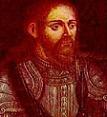
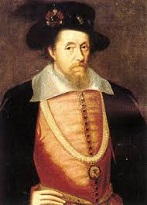







1578 On Jan. 31 the Battle of Gembloux in Gembloux, Brabant in modern-day Belgium sees a 1.2K-man Spanish advance force spook a 20K-man retreating Dutch Protestant army, allowing the rest of the 17K-man Spanish force to crush them; Alessandro Farnese (1545-92), son of duke Ottatvio Farnese of Parma-Pacienza gets the credit, and replaces Don John of Austria, who claims ill health, and after receiving news of the Mar. 31 assassination of his personal secy. Antonio Perez, he continues campaigning although ill, dying on Oct. 1; no loss, as Farnese proves as able as William I the Silent, and uses every trick in Machiavelli's book to sow discord in the S Netherlands? In Mar. James VI (1566-1625) is declared old enough to assume rule of Scotland after the lords mount a coup against the earl of Morton, causing him to resign the regency. In the spring Elizabeth I's longtime lover Robert Dudley, 1st earl of Leicester secretly weds her tighter, er, nicer cousin Lettice Knollys, Countess of Essex (Viscountess Hereford) (1543-1634), daughter of Sir Francis Knollys (1514-96) and Catherine Carey (1524-69), daughter of Anne Boleyn's sister Mary Boleyn (1499-1543); on Apr. 28 Elizabeth finds out, and in May she sends a marriage proposal to the duke of Alencon with the secret goal of getting the French king (his brother) to commit France to the Dutch cause against Philip II; she offers to mediate between the Dutch and Don John of Austria, but finds him dead and Alessandro Farnese in charge; luckily for Elizabeth, Lettice has a young son, Robert (b. 1567), by her first marriage to Walter Devereux, 1st earl of Essex, who will grow up to comfort her old age. On July 31 the Battle of Rijmenam (Rijmenam-Mispeldonck) in Rijmenam in modern-day Belgium is a D for the Protestants under ailing Don John of Austria (b. 1547), who regroups in Namur in Sept., and dies of typhus on Oct. 1, leaving Alessandro Farnese in sole charge. Rocking the suburbs, just like Michael did? Pushy Portugual goes too far, tries to reverse 7/11, and ends up zonking itself, letting Spain take it over? On Aug. 4 after ambitious Sebastian I of Portugal (b. 1554) leads an expedition to Morocco to Christianize the Muslim Moors in alliance with deposed sultan al-Mutawakkil, his 20K-man army is drowned and he is KIA along with al-Mutawakkil at the Battle of the Three Kings (Alcacer Quibir) in Alcazar; since his body is never found, his subjects keep hoping for his return, calling him "the Desired"; Portugal begins its decline after his death; his regent and great-uncle Cardinal Henrique, the penultimate male prince of the legitimate line of the House of Braganza (Braganca) (founded 1442) becomes Henry (Henrique) I (1512-80), king #17 of zonked Portugal, which on his watch falls under Spanish control for 60 years; Abd al-Malik dies, and his brother Ahmad I al-Mansur (El-Mansour Eddahbi) (1549-1603) becomes emir of Morocco (until Aug. 25, 1603), building the El Badi ("Marvelous") Grand Palace in Marrakesh and claiming the caliphate; Philip II of Spain orders the aged Duke of Alva on his last mission for the House of Hapsburg to conquer Portugal. In Sept. sure-to-be-Sir Francis Drake (1543-96) discovers the 400-mi.-wide Drake Passage between Cape Horn and the South Shetland Islands, rounding the Horn in 17 easy days, easily sailing past the lethal Four Evangelists and Desolation Island at the W end. In Dec. Elizabeth I has a tooth pulled after 9 mo. of pain only after Bishop Aylmer of London has one of his teeth pulled out in her presence; she refuses to have any more pulled for life. Swedish king (since Sept. 30, 1568) John (Johan) III Vasa (1537-92) secretly converts to Roman Catholicism, and tries unsuccessfully to make Sweden a Roman Catholic country (until 1584), entering the anti-Russian league with Stephen Bathory of Poland. Ismail II is killed after ordering the execution of all his brothers, and his brother Mohammed Mirza becomes Mohammed Khodabanda (Khudabanda) (-1595), Safavid shah #4 of Persia (until 1587), taking over the war against the Ottomans and sending his #1 son Hamzeh Mirza to fight them. Born to be wild? Japanese feudal lord Otomo Sorin (Otomo Yoshishige) (Fujiwara no Yoshisige) (1530-87), daimyo of the Otomo Clan in Funai (Oita), Kyushu, who met St. Francis Xavier in 1551 then became a Buddhist monk in 1562 under the name Sanbisai Sorin converts to Christianity, and is baptized under the name Francisco; too bad, it's only a political move? - underlying issues need to be addressed? Sir Humphrey Gilbert and his half-brother Sir Walter Raleigh begin an expedition to North Am., but their ships are attacked by the Spaniards off Cape Verde, forcing them to return to England. The Shroud of Christ is transported permanently from Chambery, France (since 1453) to Turin, Italy, new capital of the Savoys, and placed in the Cathedral of St. John the Baptist, where it is publicly displayed only 11x in the next four cents., and is given in 1983 to the Vatican under the custody of the archbishop of Turin. The Catacombs of Rome, lost since the 10th cent. are rediscovered. The leader of the Tibetan Gelugpas receives the title "Dalai" (Ocean) from Altan Khan. The Levant Trading Co. is founded in London. The Conrade Brothers start a faience pottery factory in Nevers, France. A grammar of the Zapotec language of Oaxaca, Mexico is pub. in Cordova, Spain by Dominican friars; by modern times there are still 500K speakers of the language. Architecture: Pont Neuf, the oldest bridge over the Seine River in Paris to survive to modern times, designed by Jean Baptiste Androuet du Cerceau (1544-90) is built. The Purana Pul ("Old") Bridge across the Musi River in Hyderabad, India is built. Nonfiction: Jacques Cujas (1520-90), Commentaries on Roman Law. John Florio (1553-1625), First Fruits, Which Yield Familiar Speech, Merry Proverbs, Witty Sentences, and Golden Sayings; A Perfect Induction to the Italian and English Tongues; dedicated to Robert Dudley, 1st earl of Leicester; gets him admitted to Magdalen College, Oxford U. in 1881. Abraham Ortelius (1527-98), Synonymia Geographica; criticism of ancient geographers; pub. in 1596 as "Thesaurus Geographicus", and again in 1596, containing the first mention of continental drift. Poetry: Nicholas Breton (1545-1626), The Workes of a Young Wit; A Floorish upon Fancie. Pierre de Ronsard (1524-85), Sonnets pour Helene; to Helene de Surgeres. Guillaume de Salluste, Sieur Du Bartas (1544-90), La Sepmaine; ou, Creation du monde (The First Week, or, the Creation of the World); hexameter epic based on the Seven Days of Creation in Genesis, which is a hit, going through 42 eds. by 1632, getting widely translated and becoming the basis of Milton's "Paradise Lost", making him France's #1 poet of the late 16th cent., and a hit in England and Scotland after James VI becomes a fan; he follows with a 2nd part "La Seconde Sepmaine" (1584), which is left unfinished at his death, and completed in 1603. Novels: John Lyly (1554-1606), Euphues (Gr. "graceful, witty"): the Anatomy of Wyt (Dec. 2); first English novel?; starts the florid trend of "Euphuism", a preciously ornate, sophisticated, and erudite writing style, which is picked up by Elizabeth I in her writing and public speaking, incl. the sayings "All is fair in love and war" and "Be valyaunt (valiant), but not too vetnurous". Births: German landscape painter Adam Elsheimer (d. 1610) on Mar. 18 in Frankfurt am Main. English physician (founder of modern physiology) (discoverer of the complete systemic circulation and properties of blood) William Harvey (d. 1657) on Apr. 1 in Folkestone ; educated at the King's School, Canterbury, and Gonville and Caius College, Cambridge U. - no fool? Spanish Hapsburg king (1598-1621) Philip III (the Pious) (d. 1621 on Apr. 12 in Madrid; son of Philip II and 4th wife Anna, daughter of HRE Maximilian II and Maria of Spain; husband (1599-1611) of Margaret of Austria, sister of HRE Ferdinand II. Austrian HRE (1619-36), archduke of Styria (1590-1637), king of Bohemia (1617-37), and king of Hungary and Croatia (1618-25) (Roman Catholic champion) Ferdinand II of Styria (d. 1637) on July 9 in Graz, Styria; son of Archduke Charles of Styria; grandson of HRE Ferdinand I; educated by the Jesuits, who teach him to hate the P word? English bishop of Worcester John Prideaux (d. 1650) on Sept. 7 in Hartford (near Ivybridge), Devon; educated at Exeter College, Oxford U.; father of Matthias Prideaux (-1646); teacher of Sixtinus Amama (1593-1629). English Gunpowder Plotter Ambrose Rokewood (d. 1606) in Stonegate, York. Spanish king (1598-1621) and king of Naples-Netherlands-Portugal-Sicily (1598-1621) Philip (Felipe) III (d. 1621) in Madrid; son of Philip II of Spain and Anna of Austria. Dutch (Flemish) anatomist Adriaan van der Spiegel (Adrianus Spigelius) (d. 1625) in Brussels; Casserio's successor at Padua and the last of the great Paduan line of anatomists; pupil of Girolamo Fabrici. Ukrainian divine Meleci Smatrycki (d. 1634); founder of Church Slavonic. Neapolitan painter Giovanni Battista Caracciolo (d. 1635). English jurist Sir Thomas Coventry, 1st Baron Coventry of Aylesborough (d. 1640); educated at Balliol College, Oxford U.; knighted in 1617; created baron in 1628. Deaths: Italian artist Giulio Clovio (b. 1498) on Jan. 5 Portuguese mathematician Pedro Nunes (b. 1502) on Aug. 11 in Coimbra. Italian violin maker Andrea Amati (b. 1505). French surgeon Pierre Franco (b. 1505). French Louvre architect Pierre Lescot (b. 1515) on Sept. 10 in Paris. Croatian Ottoman adm. Piyale Pasha (b. 1515) on Jan. 21. Scottish countess Margaret Stewart (b. 1515). Scottish nobleman James Hepburn, 4th earl of Bothwell (b. 1536) (Mary Stuart's husband) on Apr. 4; dies mad and chained to a pillar in the dungeons of Dragsholm Castle in Zealand, Denmark; his titles and lands are forfeited to the crown; his mummified body is kept under glass at Faarevejle Church near Dragsholm. English playwright George Gascoigne (b. 1539) in Oct. European super-soldier and regent of the Netherlands Don John of Austria (b. 1545) on Oct. 1 near Namur (typhus); buried in the Escorial. Portuguese king (1557-78) Sebastian (Sabastiao) I (b. 1554) on Aug. 4 in Alcazar, Morocco (KIA).



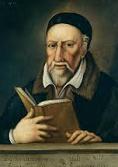
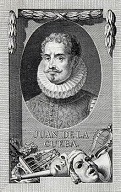
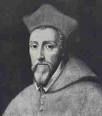



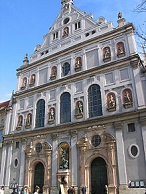

1579 On Jan. 23 the Union of Utrecht, engineered by Prince William I the Silent of Orange's younger brother Count John (Johann) VI of Nassau-Dillenburg (1536-1606) unites the seven Protestant N provinces of the Netherlands into the Repub. of the United Netherlands, which signs a military alliance with the English. On Mar. 11 solicitor-gen. (since Mar. 14, 1569) Sir Thomas Bromley (1530-87) is appointed privy counsellor of England, followed on Apr. 26 by lord chancellor (until Apr. 11, 1587), succeeding Sir Nicholas Bacon (b. 1510), who died on Feb 20. On Mar. 12-July 1 after it falls into the hands of the rebels, the Siege of Maastricht in the Netherlands sees the Spanish under Gen. Alexander Farnese siege it with 20K men, with the 1.2K brave defenders fighting them underground in tunnels, killing 2.5K Spanish while losing 1K soldiers along with 800-4K civilians killed during a 3-day looting spree. On May 17 the Treaty of Arras sees the 10 "Malcontent" Roman Catholic (mainly Walloon) provinces of S Netherlands agree to form a union and support Philip II's cause under Gen. Alessandro Farnese, who sets up his base in Hainaut and Artois; Farnese goes on to take Tournai, Maastricht, Breda, Bruges, and Ghent, aiming to reconquer all of Brabant and Flanders, and the northern cause seems hopeless unless Queen Elizabeth I can get the French to aid them, causing her to flirt more openly with Mr. Pockmarks Francis of Valois, duke of Anjou, who makes a secret visit to her on Aug. 17-29, quiets rumors that he is not a hunk, and ardently woos her, but withdraws, er, shoots, er, leaves abruptly before marriage is agreed to. On June 17 after Sir Francis Drake and his crew get chased by Spaniards up the coast of Calif., seeking escape by the nonexistent Northwest Passage, they land at Drake's Bay 30 mi. NW of modern-day San Francisco (near tall white cliffs), where the friendly Indians think they are gods, and on June 26 offer them their entire country; he accepts, and leaves a brass plate announcing the new English domain of New Albion (N Calif.) "by the grace of God and in the name of her majesty Queen Elizabeth of England"; in 1932 chauffeur William Caldeira finds the plate under some dirt on the shore, but later tosses it on the N shore of the Golden Gate Bridge, where in 1936 San Fran. store clerk Beryle Shinn finds it again while hunting pheasant; it ends up in the U. of Calif. On July 17 Queen Elizabeth is almost killed accidentally by fowler Thomas Appletree on her royal barge near Greenwich as she is on her way to visit Deptford in the company of the earl of Lincoln and the French ambassador as he is rowing up and down the river with some children of the queen's chapel randomly shooting with a caliver, and one shot passes within 6 ft. of her royal person, piercing both arms of an oarsman; on July 21 she pardons him from the gallows at the last moment after the rope is put around his neck to make him think about it - she would have made a good football coach? On July 18 the Second Desmond War (Rebellion) (ends Nov. 11, 1583) in Munster, Ireland begins when the oppressed pissed-off Roman Catholic Irish, led by Gerald FitzGerald, 15th Earl of Desmond (1533-83) In Sept. John Stubbs (Stubb) (1543-91) of Lincoln's Inn pub. the pamphlet The Discovery of a Gaping Gulf whereunto England is Like to be Swallowed by another French Marriage, claiming she is too old to have children and that English values would be undermined by her marriage to a Frog; on Sept. 27 Elizabeth issues a proclamation condemning it, and orders the right hands of Stubbs and his publisher William Page stubbed, er, severed at Westminster under an old law of Mary I against sedition by stubby pages; "Pray for me, now that my calamity is at hand" says comedian Stubbs, right before his right arm becomes a bloody stubb, after which he screams "God save the Queen!"; on Nov. 24 cradle-robber Elizabeth I is publicly betrothed to her "Frog" Anjou in front of witnesses, and signs marriage articles that give her 2 mo. to get her subjects to agree to it before it becomes final, but they don't and it doesn't, and after hanging on for 3 mo. he begs for money and she gives him 10K pounds and sends him off to the Netherlands; at first she rejected him, but when he matures she finds her soulmate and really falls in love with him, and when her subjects won't accept him and approve their marriage, it breaks her heart for life, and she gives up all pretence to wanting to be married to anybody? On Oct. 24 Bavarian duke (since Mar. 7, 1550) Albert (b. 1528) dies, and is succeeded (until 1597) by Jesuit-educated Duke William V the Pious (1548-1626) (until Oct. 15, 1597); he hires Italian-Dutch painter-architect Friedrich Sustris (1540-99) as chief architect, who goes on to expand the Residenz in Munich (founded 1385), and design St. Michael's Church in Munich (1585-97), which becomes a spiritual center of the Counter-Reformation, and the Old Academy (Wilhelminum) next door, a college for Jesuits (finished 1590), which after their expulsion in 1773 is used by army cadets, becoming the court library-archives in 1783-1826, followed by a school of painting and sculpture. At the instigation of Sultan Murad II's mother, Mehmed Sokullu is executed, and grand viziers begin to change almost yearly at the whim of his wimmin? A papal nuncio is sent to Switzerland, and he chooses Lucerne as his seat - that'll churn things up? Portuguese merchants set up a trading station in Bengal. The cloth-making industry is introduced to the city of Liberec in Bohemia (first mentioned in 1348), after which it becomes the #2 city in Bohemia and the "Manchester of Bohemia". English Jesuit father Thomas Stephens (1549-1619) becomes the first Englishman to settle in Portuguese India (Goa). The English Eastland Co. (Merchants of Elbing) is founded for trading with Scandinavia. Venerable English College is founded in Regola, Rome as a clone of the one in Douai. Philip Sidney and Edmund Spencer form a lit. society to encourage the writing of English poetry in classical meters. Torquato Tasso is committed to the Sant' Anna Hospital in Ferrara, which becomes a 20th cent. tourist spot. The U. of Vilnius (Vilnyus) (origially the Jesuit College of Vilnius) is founded by Stephen Bathory (Báthory) (1533-86), grand duke of Lithuania and king of Poland (since May 1, 1576), becoming the first in the Baltic States, the 3rd in the Polish-Lithuanian Commonwealth (after Cracow U. and Konigsberg U.); in 1831-1919 it is closed down. Architecture: Andrea Palladio designs the Teatro Olimpico (Olympic Theater) in Vicenza, Italy (finished in 1585). Art: El Greco (1541-1614), L'Espolio. Inventions: Coaches are introduced in England; before this everybody incl. the queen rode on horseback. Nonfiction: George Buchanan (1506-82), De Jure Regni apud Scotos; big hit, in the form of a dialogue, teaching the doctrine that all political power comes from the people, and that the king is bound by these conditions and may be resisted and punished; in 1584 Parliament passes an act condemning it, doing ditto in 1664; in 1684 Oxford U. burns copies; his ideas lead to the deposition of James VII in 1688? Thomas Digges (1546-95), Arithmetical Military Treatise; contains the first printed use of the term "pynt blancke" (Fr. "pointe a blanc" = pointed at white) is first used to mean the white bulls-eye of practice targets used by archers. Stephen Gosson (1554-1624), Schoole of Abuse, Containing a Pleasaunt Invective against Poet, Pipers, Plaiers, Jesters and such like Caterpillers of a Commonwelth; a violent attack on the theater and poetry; contains an unauthorized dedication to Philip Sidney, causing him to write the reply Apologie for Poetrie in 1580. Thomas Lodge (1558-1625), A Defense of Poetry, Music and Stage Plays; contra Gosson. Sir Thomas North (1535-1604) (tr.), Plutarch's Lives of the Noble Grecians and Romans; becomes a major source for Shakespeare's plays. Paolo Paruto, Historia Vinetiana. Unity of the Brethren, Kralice Bible (6 vols.) (1579-83); first complete Bible trans. in Czech from the original languages; 3rd ed. 1613; incorporates the Czech trans. of the New Testament by Jan Blahoslav (1523-71). Poetry: St. John of the Cross (1542-91), Dark Night of the Soul. Edmund Spenser (1552-99), The Shepheardes Calendar (12 eclogues). Plays: Juan de la Cueva (1550-1612), Primera parte de las Comedias y Tragedias; first of 14 poor plays and four bad poems. Novels: John Lyly (1553-1606), Euphues and His England (July 24). Births: German Welf duke of Brunswick-Luneburg (1635-66) Augustus the Younger (d. 1666) (Gustavus Selenus) on Apr. 10 in Dannenberg; father of Rudolph Augustus (1627-1704), Anthony Ulrich, Ferdinand Albert, and Clara Augusta. French Huguenot leader Henri II, Duke of Rohan (d. 1638) on Aug. 21 in Chateau Blain, Brittany; son of Rene II (1550-86); husband (1603-) of Marguerite de Bethune, daughter of the duke of Sully. Dutch dramatist Samuel Coster (d. 1665) on Sept. 16 in Amsterdam. Peruvian Dominican monk (St.) Martin de Porres Velazquez (Velázquez) (d. 1639) on Dec. 9 in Lima; Spanish father, Panamanian-born black slave mother; patron saint of mixed-race people; canonized in 1962 by Pope John XXIII; feast day: Nov. 3. Dutch (Flemish) "Wild Boar Hunt" painter Frans Snyders (Snijders) (d. 1657) on Nov. 11 in Antwerp; student of Pieter Brueghel the Younger and Hendrick van Balen; friend of Sir Anthony van Dyck. English dramatist John Fletcher (d. 1625) in Dec. in Rye, Sussex; collaborator of Francis Beaumont (1584-1616) - Beaumont makes it to 32, Fletcher to 46? Italian Baroque painter ("first class painter of the second rank") Carlo Saraceni (d. 1620) in Venice; speaks French. English statesman (founder of Md.) (Roman Catholic) George Calvert, 1st Lord (Baron) Baltimore (d. 1632) in Kilpin, Richmondshire; father of Cecil Calvert (1605-75), Leonard Calvert (1606-47), and Philip Calvert (1626-82). French Baroque painter ("Master of Candlelight") Trophime Bigot (d. 1650) in Arles. Deaths: Swiss Protestant leader Hans Franz Nageli (b. 1497) on Jan. 9 in Bern. Spanish conquistador Gonzalo Jimenez de Quesada (b. 1509). English politician Sir Nicholas Bacon (b. 1510) on Feb. 20 in Gorhambury; buried in St. Paul's Cathedral. Italian anatomist Giambattista Canano (b. 1515) in Ferrara. English merchant-financier Sir Thomas Gresham (b. 1519); endows Gresham College in his will (founded 1596). Spanish-born Jewish Ottoman diplomat-financier Don Joseph Nasi (b. 1524) in Constantinople. English Bible scholar William Whittingham (b. 1524) on June 10 in Durham. English soldier-statesman Sir William Drury (b. 1527) on Oct. 13 in Dublin. Bavarian duke (1550-79) Albert V (b. 1528) on Oct. 24.



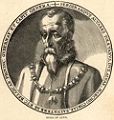
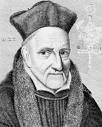
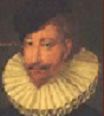


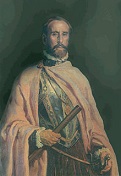







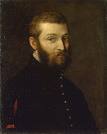
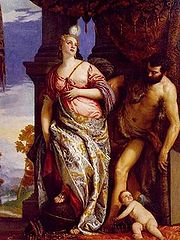

1580 There is an earthquake in London; new bldgs. are banned to restrict growth of the city. On Jan. 31 King-Cardinal Henry (Henrique) I (b. 1512) dies, leaving no heir (he wants to admit to?), and the Avis (Aviz) Dynasty in Portugal (founded 1385) ends (in with a Henrique, out with a Henrique?), causing the Portuguese secession crisis of 1580; in June old fart "Iron Duke" Fernando Alvarez (Álvarez) de Toledo y Pimentel, 3rd Duke of Alva (Alba) (1507-82) and a 40K-man army of Spanish troops along with German and Italian mercenaries land in Portugal, meeting a ragtag 8.5K-man Portuguese army along with 3K African slaves at the Aug. 25 Battle of Alcantara near Lisbon, which is captured on Aug. 27, after which Henry I is succeeded by Philip II (the Prudent) of Spain (1527-98) after six other less rich claimants are dealt with, esp. Duke John of Braganza (1543-83) (grandfather of Joao IV), and crowned next Mar. 25, founding the House of Hapsburg (Philippine Dynasty) in Portugal (ends Dec. 1, 1640), ruled by three Spanish Hapsburg kings named Philip, while the Spanish under the cruel-is-cool pain-no-problemo Duke of Alva crush all opposition; Philip II now rules the original empire in which the Sun never sets, taking the title of richest ruler in history (there's a crime in every fortune, to the nth power?); Ceuta reverts from Portugal to Spain; the annexation of Portugal vastly increases Spain's already formidable naval fleet. And now England's ass is grass and he's got the lawnmower? Pope Gregory XIII reissues his predecessor's bull against the excommunicated heretic bastard Queen Elizabeth I, and Philip II begins planning the Enterprise of England (Roman Catholic invasion); meanwhile the pope sends English Jesuits (St.) Edmund Campion (1540-81) (who had once been a top Protestant cleric in line for archbishop of Canterbury, then "took a remorse of conscience and detestation of mind" in 1569 and ended up fleeing to Douai, France in 1571 and converting) and Robert Parsons (Persons) (1546-1610) (an Oxford don who had fled in 1574) to England to aid in undermining Elizabeth, and on June 24 Campion arrives in London pretending to be a jewel merchant, but when he finds they know his identity he begins openly preaching to Catholics while eluding capture, causing Queen Liz to become antsy while he plays the Jesus-in-Jerusalem part; meanwhile Parsons flees to Spain and plots with Philip II to invade the stankin' infidel English and finish them off; by this year there are 100 Roman Catholic seminary priests in England, who are usually hidden in "priest holes" in Catholic homes, causing experienced priest hole finders to case them in order to make them say prayers from the Anglican Book of Common Prayers to expose them to heresy prosecution when they refuse, causing the nursery rhyme Goosie Goosie Gander to be created; "Goosie goosie gander,/ Whither shall I wander?/ Upstairs and downstairs/ And in my lady's chamber./ There I met an old man/ Who wouldn't say his prayers;/ I took him by the left leg/ And threw him down the stairs" - don't just look smart, play smart? In Jan. after Muslim religious leaders object to it, Sultan Murad III orders the destruction of the astronomical observatory in Constantinople. On Feb. 7 a UFO is sighted in the Atlantic Ocean off Magallanes, Chile. On Mar. 5 James VI raises recently-returned (from France) Esme (Esmé) Stewart (Stuart) (1542-83) (cousin of his father Lord Darnley) to 1st earl of Lennox, followed next Aug. 5 to 1st duke of Lennox, and he converts from Roman Catholic to Protestant to please the king and silence rumors that he is an agent for the Counter-Reformation; meanwhile rumors spread about their suspected love affair - after all, my mommy is about to give head at Fotheringay? On June 11 Spanish conquistador Juan de Garay (b. 1528) (who got his rival Jeronimo Luis de Cabrera executed in 1574) leads an expedition from Asuncion and refounds Buenos Aires (1st time 1536); too bad, on Mar. 20, 1583 he is ambushed and killed on the banks of the Carcarana River by Querandi (Querandí) natives, inventors of the bola. In June England signs the English-Ottoman Commercial Treaty with the Ottomans (ratified in Constantinople on May 3, 1583), giving England privileges formerly limited to France and Venice; it is renewed through 1675. On Aug. 30 Emmanuel Philibert (b. 1528) dies while trying to acquire the marquisate of Saluzzo, and his only son Charles Emmanuel I "the Great" (1562-1630) becomes duke of Savoy (until 1630), going on to try to recover lost territories Geneva, Montferrat, and Saluzzo, flip-flopping between alliances with Spain and France and ending with little gained and the French overruning his Italian-speaking Turin-based duchy. On Sept. 10 after being secretly sent by Spanish king Philip II and financed by Pope Gregory XIII, Spanish ships under command of Adm. Don Juan Martinez de Recalde (1540-88) land 600 Italian-Spanish freelance soldiers supporting the Desmond Rebellion commanded by Sebastiano di San Giuseppe (da Modena) in Smerwick on the Dingle Peninsula (westernmost point of Ireland/Europe); meanwhile 4K men East of their position led by Lord Desmond, John of Demond, and Lord Baltinglass attempt to link up with them for supplies, but are blocked by English forces under the 10th Earl of Ormond and Arthur Grey, 14th Baron Grey de Wilton (1536-93), new lord deputy of Ireland (until 1582), while English ships under Richard Bingham blocked Smerwick Bay, causing the papal forces to retreat to the nearby Fort of Gold (Slaughter) (Dun an Oir); on Nov. 7-10 the English stage the Siege of Smerwick (Ard na Caithne); when the papal forces surrender they are summarily executed under de Wilton's orders. On Sept. 26 after crossing the Pacific to the East Indies, Francis Drake (1543-96) arrives in Plymouth, England, becoming the 2nd man to lead a round-the-world voyage (36K mi.) (began 1577); the queen gives him a green silk scarf, but rumors of his pirate habits eventually take the shine off, and the queen keeps 20% of his £800K treasure haul. On Nov. 19 in a fit of insane rage, 50-y.-o. Russian tsar Ivan IV the Terrible (b. 1530) strikes and kills his son and heir (tsarevich) Ivan Ivanovich (b. 1554) with his iron staff - you can't please everyone so you got to please yourself? On Dec. 30 after being plotted against by the duke of Lennox and his companion James Stewart, earl of Arran, Scottish regent James Douglas, 4th Earl of Morton (1516-81) is deposed for his part in the murder of Lord Darnley, and he is executed next June 2 on the Scottish Maiden, which he introduced to Scotland; the regency now belongs to whomever has custody of the king, who is warmly in the hands of Esme Stewart. The Venetians import coffee from Turkey; in return tobacco arrives in Turkey and Poland; European tobacco cultivation begins in Cuba. Portugal and Spain send reinforcements to the Philippines to protect the Portuguese traders and missionaries in Cambodia; meanwhile the Dutch work in secret with natives in Jambi, Sumatra to corner pepper production. The British navy introduces the rank of lieutenant (lt.) (pr. LEF-tenant) (Fr. "holding in lieu of") as an asst. to the capt. who is qualified to relieve him. St. Peter Canisius leaves Germany and founds the Jesuit Seminary of St. Michel in Fribourg, Switzerland, which evolves into the U. of Fribourg. A stud farm for 16-hand small-headed pure white silky-coated Lipizzaner (Lipizzan) Horses is founded in Lipizza (near Trieste) from stallions presented to Maria Theresa by the Jerez Monastery in Spain, who kept their bloodlines pure after they were originally bred from Roman and Moorish stock to fight the Moors. Lodovico Carracci (1555-1619) and his cousins Agostino Caracci (1557-1602) and Annibale Carracci (1560-1609) found the eclectic Bolognese School of Painting, synthesizing the best elements of the other Italian styles, founding landscape painting as an art form, and collaborating on painting projects for the next decade, incl. the Palazzo Ghisilardi Fava (1582), Palazzo Magnani (1577-83), and Farnese Palace in Rome (1597-1604). Jan Sweelinck becomes organist at Dude Kerk in Amsterdam. The last miracle play is performed in Coventry, England. Architecture: English architect Robert Smythson (1535-1614) begins the Elizabethan-style Wollaton Hall near Nottingham (finished 1610), becoming a prodigy house, "the architectural sensation of its age". Nonfiction: Jean Bodin (1530-96), De la Demonomanie des Sorciers (Of the Demon Mania of the Sorcerers); pleases the public with the assertion that an accusation of witchcraft (pact with the Devil) is almost always true, and nobody can be erroneously condemned if the correct torture procedures are used, even on children? Francois de la Noue, 24 Discours Politiques et Militaires; pro-Huguenot. Johann Fischart (1547-90), Das Jesuitenhutlein; anti-Jesuit. Michel de Montaigne (1533-92), Essays; incl. the meaty On Cannibals, waxing lyrical over the "noble savage"; "What a stupid thing is an old man learning an alphabet." (II) Bernard de Palissy (1510-89), Discours admirables, de la nature des eaux et fontaines, tant naturelles qu'artificielles, des metaux, des sels et salines, des pierres, des terres, du feu et des maux (Paris); applies ancient Alexandrian principles of hydraulics, and incl. a theory of the origin of springs and underground waters, enunciating the modern theory of the origin of fossils. John Stow (1525-1605), The Chronicles of England (1580-92). Art: The Valois Tapestries, a series of eight tapestries depicting festivities of the French royal court are made in the Spanish Netherlands in this decade. Tintoretto (1518-94), Christ at the Sea of Galilee (1575-80). Paolo Veronese (1528-88), Wisdom and Strength. Poetry: Fernando de Herrera (ed.), Poetry of Garcilaso de la Vega. Jan Kochanowski (1530-84), Threny (Polish laments). Music: Richard Jones, A Newe Northen Dittye of ye Ladye Greene Sleves (Sept.) (London); "a new courtly sonnet of the Lady Greensleeves"; doesn't stop the myth that Henry VIII composed it; mentioned by Shakespeare. Births: Belgian (Flemish) physician-scientist ("Founder of Pneumatic Chemistry") Johann (Jan) Baptista (Baptist) van Helmont (d. 1644) on Jan. 12 in Brussels; disciple of Paracelsus; coiner of the term "gas". French soldier-poet-dramatist Honorat de Bueil, Seigneur (Marquis) de Racan (d. 1670) on Feb. 5 in Aubigne-Racan, Sarthe. English courtier (gay?) William Herbert, 3rd Earl of Pembroke (d. 1630) on Apr. 8; son of Henry Herbert, 2nd earl of Pembroke (1534-1601) and Mary Sidney Herbert (1561-1621); brother of Philip Herbert, 4th earl of Pembroke (1584-1649);royal chamberlain 1615-25; lord steward 1626-30; chancellor of Oxford U. 1617-30; namesake of Pembroke College, Oxford U.; patron of Ben Jonson and Philip Massinger; Shakespeare's secret lover in 1597-1609?; Shakespeare's "Sonnets" are inscribed to "Mr. W.H."; Shakespeare's First Folio is dedicated to the "Incomparable Pair of brethren". French priest (St.) Vincent de Paul (d. 1660) on Apr. 24 in Guyenne, Gascony; captured by Turkish pirates in 1605-7. German mathematician Johann Faulhaber (d. 1635) on May 5 in Ulm. Dutch Renaissance scholar-poet Daniel Heinsius (Heins) (d. 1655) on June 9 in Ghent. Dutch Snell's Law mathematician-astronomer Willebrord Snell (Snellius) (Willebrord Snel van Royen or Roigen or Roijen) (d. 1626) on June 13 in Leiden. French Vernier scale mathematician Pierre Vernier (d. 1637) on Aug. 19 in Ornans, Franch-Comte. Spanish poet-writer-statesman Francisco Gomez de Quevedo y Santibanez (Santibáñez) Villegas (d. 1645) on Sept. 14 in Madrid. Italian surgeon-anatomist Marco Aurelio Severino (d. 1656) in Nov. in Tarsia, Calabria; student of Tommaso Campanella in Naples. French astronomer Nicolas-Claude Fabri de Peiresc (d. 1637) on Dec. 1 in Belgentier, Var. German Thirty Years' War Protestant gen. Count Ernst von Mansfeld (d. 1626); illegitimate son of Count Peter Ernest von Mansfeld. English "A Chaste Maid in Cheapside" Jacobean playwright-poet Thomas Middleton (d. 1627) in Apr. in London; educated at Queen's College, Oxford U.; collaborator of William Rowley (1585-1626); only dramatist other than Shakespeare who can write both comedy and tragedy. Romanian Calvinist king of Hungary (1620-1) and prince of Transylvania (1613-29) Bethlen Gabor (Gabriel Bethlen) (d. 1629) in Marosillye. English adventurer-explorer ("America's first rebel") Capt. John Smith (d. 1631) in Jan. in Willoughby (near Alford), Lincolnshire; founder of Jamestown (1607). English Jacobean "The Duchess of Malfi", "The White Devil" dramatist John Webster (d. 1635) in London; last of the great Elizabethan playwrights. Dutch gov.-gen #3 of the New Netherlands (1626-31) (Protestant) Peter (Pieter) Minuit (Minnewit) (d. 1638) (b. 1685?) in Wesel, Cleves (modern-day North Rhine-Westphalia, Germany) - and he drives a great bargain too? Dutch "Laughing Cavalier" Dutch Golden Age portrait-genre painter Frans Hals (d. 1666) (b. 1582?) in Antwerp, Flanders. Deaths: English dramatist John Heywood (b. 1497) in Mechelen, Belgium: "The moon is made of a green cheese." Chinese novelist Wu Cheng'en (b. 1500); leaves the novel Journey to the West. Italian High Renaissance architect Andrea Palladio (b. 1508) on Aug. 19. Portuguese king-cardinal (1578-80) Henrique I (b. 1512) on Jan. 31. Spanish historian Jeronimo Zurita y Catro (b. 1512) on Nov. 3 in Saragossa. German dramatist-poet Heinrich Knaust (b. 1520) on Nov. 7 in Erfurt. Portuguese poet Luis Vaz de Camoes (Camoens) (b. 1524). English horticulturist Thomas Tusser (b. 1524). Italian duke of Savoy (1553-80) Emmanuel Philibert (b. 1528) on Aug. 30 in Turin. English historian Raphael Holinshed (b. 1529). Spanish chess champ Ruy Lopez de Segura (b. 1540). Russian tsarevich Ivan Ivanovich (b. 1554) on Nov. 19 in Alexandrov; killed by his daddy Ivan IV the Terrible.




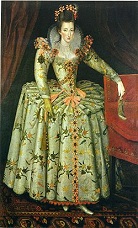




1581 On Mar. 18 Parliament passes a Revised Statute of Recusancy, making conversion to the Roman Catholic faith tantanount to treason in England; over the next 20 years 250 Catholics are executed or die in prison. On Mar. 23 English maid of honor Anne Vavasour (1560-1650) secretly bears the Earl of Oxford's illegitimate son Edward in the Maidens' Chamber, and he refuses to marry her, but Elizabeth I makes him pay her £2K, banishes him from court, and imprisons him for several mo. in the Tower, then banishes him from court until June 1582; meanwhile he reconciles with his wife Anne Cecil in Jan. 1583; during her reign she approves 18 marriages for her maids. On June 27 400 copies of the pamphlet Decem Rationes (Ten Reasons) by pesky English Jesuit (St.) Edmund Campion (1540-81) are found in the pews of St. Mary's in Oxford, causing a sensation, and on July 14 he is arrested in Lyford, Berkshire and taken to London with a sign on his hat reading "Campion, the Seditious Jesuit"; after the queen personally offers him wealth and titles if he gives up that Catlick stuff, he refuses and is hanged, drawn, and quartered on Dec. 1 for treason, but not before new official censor (a learned poet) Thomas Norton (1532-84) (known by English Catholics as the "Rackmaster General") uses his favorite toy on him three different times; too bad, rabid Calvinist Norton later slips into Puritanism and is thrown in the Tower, released, then dies of ill health in 1584. On Sept. 8 a 31K-man Polish-Lithuanian army under Polish king Stephan Bathory invades Russia and begins the Siege of Pskov, defended by 16K men under Prince Ivan Shusky, forcing the Russians to cede Livonia on the Baltic; on Sept. 6 the Swedes recapture Narva; the town of Pskov remains unconquered. On Sept. 11 the English Levant (Turkey) Co. receives a royal charter to trade with the Ottomans as a monopoly (ends 1825). On Oct. 31 the Duke of Anjou returns to England to woo Elizabeth again; she promises to marry him formally on Nov. 22, then waffles and finally rejects him, using him as a tool to hold off Spain from attacking. In Dec. Walter Raleigh (1552-1618) is sent to England with dispatches, and attracts the queen's favor, allegedly by placing his embroidered cloak on a puddle of water so she can pass over it dry-shod, and becomes her favorite, receiving large estates and becoming one of the wealthiest men in England, getting knighted in 1584; meanwhile Elizabeth I knights Sir Francis Drake (1543-96) in Deptford - watch the ear? The seven Dutch provinces within the Union of Utrecht (Guelders, Holand, Zeeland, Utrecht, Overijssel, Frisia, Groningen and Ommelanden) proclaim their independence from Spain, founding the Repub. of the Seven United Netherlands (Provinces) AKA the Dutch Repub., United Provinces, Federated Dutch Provinces, and Dutch Federation (ends 1795). Fear of restoration of Roman Catholicism in Scotland causes the Gen. Assembly of Scotland to denounce the pope and Roman Catholicism in emphatic language, ratify the Nat. Covenant (King's Confession), drafted by John Craig (Gael. "rock") (1512-1600), and force James VI to sign it; its signatories and adherents become known as Supplicants. James VI raises the earl of Lennox to duke (the only duke in Scotland); rumors that they are lovers and that he has too much influence with the king stink up the court? The Russians double the size of their territory by taking control of the Tartar Khanate of Siberia (1581-98) via Cossack hetman Ermak Timofeev, becoming the sole achievement of Crazy Ivan IV since his wifey croaked in 1560. Morocco under sultan (1578-1603) Ahmad I al-Mansur (1549-1603) begins expanding across the Sahara Desert, targeting the gold-rich Songhai Empire of W Africa. Peruvian viceroy Francisco de Toledo sends a military expedition to the Inca hideout of Vilcabamba, captures Inca (chief) Tupac Amaru, and executes him. Spanish explorers probe N along the Rio Grande River into New Mexico, and do it again in 1583. Spanish Capt. Ivan Sabala leads 100 soldiers and their families to Cagayan in NE Philippines to explore the Cagayan Valley, convert the natives to Roman Catholicism, and settle; in 1583 the entire NE are of Luzon Island is organized into the Province of Cagayan. Pope Gregory XIII attempts to reconcile the Roman Catholic Church with the Russian Orthodox Church. 17-y.-o. Christopher "Kit" Marlowe (1564-93) becomes a divinity student at Benet (later Corpus Christi) College at Cambridge; he leaves before taking Anglican orders to become a playwright, writing his first play Dido, Queen of Carthage (debuts in London in 1587-1593) (which contains suspiciously homoerotic scenes?), and joining London's entertainment industry, which is always looking for good scripts? - I like the nightlife, I love to boogey? Collegio dei Raxonati is founded in Venice, becoming the first prof. assoc. of bookkeepers (accountants). Matteo Ricci (1552-1610) and Lazzaro Cattaneo (1560-1640) become the first Roman Catholic missionaries sent to China. Architecture: A cylindrical column topped by a pelican is erected in Corpus Christi College, Oxford U., becoming its symbol. Inventions: The Scots begin using the Scottish Maiden, a head-cutting machine with horizontal blades (until 1685), while the Germans in this cent. begin using a similar machine called the Dolabra. Sedan chairs come into use in England. Science: With clocklike precision, Italian scientist Galileo Galilei (1564-1642) discovers that the time taken by a swinging lamp in the Cathedral of Pisa does not depend on the angle through which it swings (i.e., a pendulum swings isochronously). Nonfiction: Thomas Watson (1557-92) (tr.), Sophocles' Antigone. Music: Balthazar de Beaujoyeux, Le Ballet Comique de la Reine (5+-hours long); the first ballet for which a complete score survives; performed in Paris before Henry III and his court in honor of a royal wedding in a decorated palace hall, helping to make Paris a center of ballet - how can a 50-y.-o. grandmother look this good, simple? Plays: George Peele (1556-96), The Arraignment of Paris (pastoral); performed before Queen Elizabeth I; pub. anon. in 1584; contains the poem Oenone's Complaint. Nonfiction: Cardinal Robert Bellarmine (1542-1621), Polemic Lectures Concerning the Disputed Points of the Christian Belief Against the Heretics of This Time (1581-93); disses the Lutherans who preach that the papacy is the Antichrist, claiming that it will be a single individual in the future (AKA Jesuit Futurism); Protestants don't buy it until Samuel Roffrey Maitland (1729-1866) comes along, then a bunch of them bite bigtime, right Hal Lindsey? Theodore Beza (1519-1605), Histoire Ecclesiastique des Eglises Reformes au Royaume de France. William Borough, A Discourse on the Variation of the Compass or Magneticall Needle. Coroso, Il Ballerino. Vincenzo Galilei (1520-91), Dialogo della Musica Antica e Moderna. Stefano Guazzo, Civil Conversations (tr. George Pettie). Richard Mulcaster (1531-1611), Positions Wherein Those Primitive Circumstances Be Examined, Which Are Necessarie for the Training Up of Children; advocates "footeball" (soccer) for students, and calls for the introduction of referees, containing the first pub. reference to teams ("sides" and "parties"), positions ("standings"), and coach ("trayning maister") - he's the king of reinvention? Robert Norman), The Newe Attractive; retired mariner pub. his independent discovery of the magnetic dip (first observed in 1544). Lancelot Popeliniere, Premier Livre de l'Idee de l'Histoire Accomplie. Art: Caravaggio (1571-1610), Martyrdom of St. Maurice. Births: Irish world-dating scholar and Anglican archbishop of Armagh and primate of all Ireland (1625-56) James Ussher (Usher) (d. 1656) on Jan. 4 in Dublin; educated at Trinity College, Dublin. Dutch poet-dramatist-historian Pieter Corneliszoon Hooft (d. 1647) on Mar. 16 in Amsterdam; son of mayor Cornelis Hooft (1547-1627). Italian "The Maiden and the Unicorn" Bolognese Baroque painter Domenichino (Domenico Zampieri) (d. 1641) on Oct. 21 in Bologna; pupil of Denis Calvaert (1540-1619); so slow and plodding he gets the nickname "Ox". English "The Wife" poet-essayist Sir Thomas Overbury (d. 1613) in Compton-Scorpion (near Ilmington), Warwickshire; knighted in 1608. Italian physician-anatomist Gasparo (Gaspare) Aselli (Asellio) (d. 1626) in Cremona; discoverer of the lacteal vessels. English mathematician Edmund Gunter (d. 1626) in Hertfordshire; of Welsh extraction; educated at Westminster College and Christ Church, Oxford U.; inventor of Gunter's chain (22 ft.) and Gunter's scale; coins the terms "cosine" and "cotangent"; discovers the magnetic variation of the compass. English adventurer Sir Robert Shirley (d. 1628) in Wiston, Sussex; 3rd son of Sir Thomas Shirley Sr. (1542-1612); brother of Sir Thomas Shirley Jr. (1564-1620) and Sir Anthony Shirley (1565-1635). Spanish "La Verdad Sospechosa" Golden Age #1 dramatist (hunchback) Juan Ruiz de Alarcon (Alarcón) y Mendoza (d. 1639) in Real de Taxco, Guerrero, Mexico. French Roman Catholic Jansenist theologian-monk (Abbot of Saint-Cyran) Jean du Vergier de Hauranne (d. 1643) in Bayonne; butcher father; educated at the Catholic U. of Leuven; co-founder of Jansenism with Cornelius Jansen (1585-1638) and The Great Arnauld (1612-94). Italian Baroque painter Bernardo Strozzi (d. 1644) in Genoza. Am. Wampanoag (Mass.) chief (sachem) Massasoit ("supreme leader", "great sachem") (Owsamequen) (Woosamequen) of Pokanoket (d. 1661) in Bristol, R.I.; father of Metacomet (1639-76). Deaths: Spanish soldier-historian Diaz del Castillo Bernal (b. 1492). Scottish regent (of James VI) James Douglas, 4th earl of Morton (b. 1516) on June 2 in Edinburgh (executed on the Maiden, which he introduced to Scotland); leaves the unfinished Drochil Castle above the Lyne Water 6 mi. NW of Peebles in the Scottish Borders. Sir Thomas Wilson (b. 1524) (Elizabeth I's secy.) on May 20. English Roman Catholic priest St. Edmund Campion (b. 1540) on Dec. 1 in Tyburn (executed).

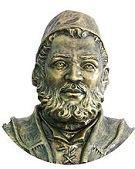

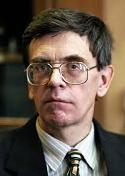






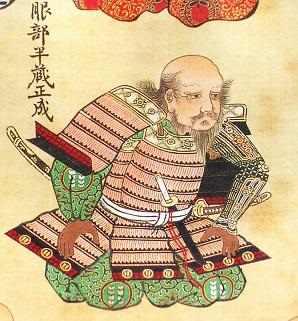
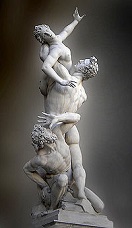
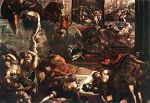

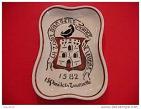
1582 On Feb. 7 frustrated in his marriage hopes by cagey Elizabeth I, Huguenot-friendly pockmarked French Duke Hercules Francois, Duke of Alencon (Alençon) and Anjou (1555-84) accepts an invitation from Lutheran leader William I the Silent, Prince of Orange (1533-84) (father of Maurice of Nassau) to become protector of the Netherlands; too bad, his attempts to secure absolute power piss-off everybody and get him expelled, and both die in 1584, letting everybody off the hook. On Feb. 24 upon the recommendation of German Jesuit astronomer Christopher Clavius (1538-1612), Pope (since May 13, 1572) Gregory XIII (1502-85) issues the bull Inter Gravissimas, decreeing a changeover from the Julian Calendar to the Gregorian Calendar; 10 days (lost since Jan. 1, -46, when the Julian Calendar began) are to be dropped, so that Oct. 15 (Fri.) immediately follows Oct. 4, or Dec. 20 (Mon.) follows Dec. 9; the Papal States, Spain, Portugal, and Poland change in Oct., France, Holland, Belgium, and Scandinavia in Dec.; the Roman Catholic states of Germany and Switzerland adopt it in 1584, followed by Hungary in 1587; too bad, Protestant countries suspect a rat and refuse to change, and the Continental Protestant states hold out until 1700, and England and its colonies till 1752; Russia holds out until 1918, Greece until 1924, and non-Euro states don't adopt it until the 19th and 20th cents., Japan in 1873, Egypt in 1875, Turkey in 1926, and China in 1949; the figure for the length of the year from Copernicus' De Revolutionibus Orbium Coelestium is proposed but not used as the basis of the reform calendar; after a suggestion by Vatican librarian Topo Gigio, er, Aloysius Lilius (Luigi Lilio or Giglio) (1510-76), only century years (1600, 1700, etc.) with the century part itself evenly divisible by four (1600 but not 1700) are leap years, which causes three leap years to be taken out of each 400, trimming the avg. calendar year down quite fortunately to only about 26 sec. longer than the Earth's real orbital period, which will take 3,323 years to become 1 day out of synch; too bad, there should have been a 13-day discrepancy, not a 10-day one, causing the Phantom Time Hypothesis to be developed by Herbert Illig (1947-), Anatoly Fomenko (1945-), Uwe Topper (1940-) et al., that phony phantom centuries were manufactured during the Renaissance to create a nonexistent Dark Ages; Pope Gregory's new calendar for the Christian world changes the date of the new year from Apr. 1 to Jan. 1, and those who still celebrate New Year's Day on Apr. 1 begin to be known as April Fools. On Mar. 4 Henry III of of Navarre (1553-1610) (later Henry IV of France) allegedly dines at the new Tour d'Argent (Silver Tower) inn in Paris (oldest Parisian restaurant to survive to modern times), discovers the fork being used by guests from Venice, and adopts it, his mommy Catherine de' Medici insisting that everybody use it; starting in the 19th cent. every diner who orders the house specialty canard rouennais (pressed duck in blood sauce) is given a momento ticket and recorded in a visitors' book; #112,151 goes to Pres. FDR, #203,728 to Marlene Dietrich, and #253,652 to Charlie Chaplin. On May 15 the Scottish ministry is informed that "the Duke [of Lennox] goes about to draw the king to carnal lust"; in July King James VI issues a proclamation ordering people to desist in spreading "such false bruits and manifest lies"; in Aug. a band of anti-Lennox Protestant nobles led by William Ruthven, 4th Lord Ruthven, 1st Earl of Gowrie (1541-84) stages the Ruthven Raid, kidnapping James VI and imprisoning him in the House of Ruthven for 10 mo. (until June, 1583), making him sign a document banishing his cousin Esme Stuart, duke of Lennox from Scotland as a suspected batter for the other team, er, agent for the Counter-Reformation; Lennox leaves for France on Dec. 21 - only time for the one chic mesh bag with the cordura on the sides? In May a Roman Catholic plot to overthrow Elizabeth I and put Mary Stuart on the English throne is hatched in Paris by the Guises, Pope Gregory XIII, Philip II of Spain, and the Jesuits; on May 30 after being tortured on the Scavenger's Daughter, English Roman Catholic priest Thomas Cottam (b. 1549) is hanged in Tyburn for high treason, and his mutilated corpse boiled in water to prevent Roman Catholics from using it for relics; the Jesuits in England gain one of their top martyrs. On Nov. 28 William Shakespeare (1564-1616) marries 8-year-older farmer's daughter Anne Hathaway (1556-1623) from nearby Shottery on the edge of the Forest of Arden (Lat. "burning for enthusiasm") ("William Shaxpere and Anne Whateley of Temple Grafton", according to the Nov. 27 episcopal register at Worcester); their children are Susannah Hall (nee Shakespeare) (May 1583-July 1649), and twins Hamnet Shakespeare (Jan. 1585-Aug. 1596) and Judith Quiney (nee Shakespeare) (Jan. 1585-1662). After Italian Jesuit papal legate Antonio Possevino (1533-1611) mediates, the 10-year Peace of Jam-Zapolski is signed, ending the Livonian War (begun 1558); Ivan IV the Terrible loses the Russian lands around the Gulf of Finland and on the W and N s hores of Lake Ladoga to Sweden; Sweden gets Estonia; Poland gets Latvia and Tartu; Russia loses access to the Baltic. Edmund Grindal is reinstated as archbishop of Canterbury by Elizabeth I. Japanese warlord Oda Nobunaga (b. 1534) is assassinated by one of his generals, Akechi Mitsuhide (1526-82); his other general Toyotomi Hideyoshi (1537-98) assumes control of his forces and kills Mitsuhide; samurai Hattori Hanzo (1542-96) saves shogun Tokugawa Ieyasu by leading him across Iga territory to his native Mikawa Province, becoming Japan's Robin Hood. The Venetian Constitution is amended to restrict the authority of the Council of Ten. The U. of Edinburgh in Scotland is founded, becoming the 6th oldest univ. in the English-speaking world. Utrecht Library in the Netherlands is founded. A Jesuit mission is founded in China. The English word "coffee" is coined from the Dutch word koffie, which comes from the Turkish word Kahve, which comes from the Arabic word qahwah. The English Royal Navy begins graduated pay according to rank. Louis de Gonzague (Gonzaga), Duc de Nevers (1539-95) visits sir Philip Sidney and John Dee in Oxford, England to discuss esoteric b.s.; next year Giordano Bruno visits Oxford and does ditto. Architecture: London's first waterworks are founded, and water wheels are installed on London Bridge. Alessandro Vittoria begins the Baroque Palazzo Balbi in Venice. Science: Urbain Hemand studies the anatomy of the teeth. Tycho Brahe builds a large triangular sextant with a globe mount at Uraniborg. Nonfiction: Anon., Life of St. Declan; about a 5th cent. Irish monk; the oldest surviving copy dates to this time. Robert Browne (1550-1633), Treatise of Reformation Without Tarrying for Any; by the first seceder from the Church of England, who tries to set up a Congregationalist church and dies in jail for assaulting a constable; used as a manifesto by the Puritans who found the Mass. Bay Colony. Giordano Bruno (1548-1600), De Umbris Idearum (On the Shadows of Ideas) (Paris); dedicated to Henry III; Ars Memoriae (The Art of Memory) (Paris); his system of mnemonics. George Buchanan (1506-82), Rerum Scoticarum Historiae (History of the Scottish Kings) (posth.); the purpose is to "purge" Scottish history "of sum Inglis lyis and Scottis vanite", pissing-off the govt., which recalls all copies to purge them of "offensive and extraordinary matters". English College of DDouai, The Douay (Douai) New Testament; English Roman Catholic trans. of the 5th cent. Latin Vulgate Bible, produced at the English College in Douai in N France on the Scarpe River, and pub. in Reims, France; the Old Testament follows in 1609-10. Alberico Gentili (1552-1608), De Legationibus Libri III (3 vols.); his first book on internat. law; De Juris Interpretibus Dialogi Sex. Richard Hakluyt (1552-1616), Diverse Voyages Touching the Discovery of America. Juan Ponce de Leon II (1524-91) and Antonio de Santa Clara, Relacion de la Isla de Puerto Rico; written in response to orders of Spanish king Philip II by Juan Ponce de Leon's son, who in 1579 became the first Puerto Rican-born gov. of Puerto Rico. Giovanni Antonio Magini (1555-1617), Ephemerides Coelestium Motuum. Richard Mulcaster (1531-1611), Elementarie; argues for teaching English instead of Latin, and for standardizing spelling; "I do not think that anie language... is better able to utter all arguments, either with more pith, or greater planesse, than our English tung is", although "forenners and strangers do wonder at us, both for the uncertaintie in our writing, and the inconstancie in our letters"; it ends with an 8K-word spelling list and a call for an English dictionary. Lancelot Voisin de La Popelinier (1541-1608), Les Trois Mondes; a history of the discovery of the globe, advocating French expansion in the "Third World" of the S hemisphere, now that North Am. has been lost. Art: Giambologna (1529-1608), The Rape of the Sabine Woman (1574-82). Tintoretto (1518-94), The Massacre of the Innocents (1582-7). Plays: Giordano Bruno (1548-1600), Il Candelaio (The Torchbearer) (comedy) (Paris). Births: Bohemian defenestrated nobleman (Roman Catholic) Jaroslav Borzita (Borita) (Borsita) of Martinice (Martinic) (Martinitz) (d. 1649) on Jan. 6. English "Three Blind mice" composer Thomas Ravenscroft (d. 1635) on ?; educated at Cambridge U. English poet-philosopher-diplomat-soldier ("Father of English Deism") Edward, 1st Baron Herbert of Cherbury (Chirbury) (d. 1648) on Mar. 3; brother of George Herbert (1593-1633); educated at Oxford U.; created baron in 1629. Italian Baroque "Dafne" composer Marco da Gagliano (d. 1642) on May 5 in Florence; studies with Luca Bati. German postmaster (1615-28) (Lutheran) Johann von den Birghden (d. 1645 on Aug. 7 in Aachen. Italian Roman Catholic superstar Humilis de Bisignano (d. 1637) on Aug. 26. Chinese Ming emperor #14 (1620) Taichang ("grand prosperity") (Zhu Changluo) (d. 1620) on Aug. 8; eldest son of Wanli and Lady Wang; father of Tianqi (1605-27) and Chongzhen (1611-44). Italian Jesuit missionary-scholar Giulio Alenio (Aleni) (d. 1649) in Brescia. Chinese Catholic missionaries Francesco Sambiaso (d. 1649) and Julio Aleni (d. 1649). Flemish painter David Teniers the Elder (d. 1649) in Antwerp; father of David Teniers the Younger (1610-90). English poet-dramatist Phineas Fletcher (d. 1650) in Cranbrook, Kent; son of Giles Fletcher the Elder (1549-1611); brother of Giles Fletcher the Younger (1586-1623); educated at Eton and King's College, Cambridge. Italian tenor singer-composer Gregorio Allegri (d. 1652) in Rome. Scottish Covenanter gen. Alexander Leslie, 1st Earl of Leven (d. 1661) in Balgonie Castle, Fife. African queen Ann Nzingha of Ndongo (d. 1663) (present-day Angola); her resistance to the white devil slows down the Portuguese slave trade. English archbishop of Canterbury (1660-3) William Juxon (d. 1663) in Chichester; educated at St. John's College, Cambridge U. Dutch painter Frans Hals (d. 1666). Deaths: Swiss scholar Thomas Platter the Elder (b. 1499) on Jan. 26 in Basel; leaves Autobiography; tr. into English in 1839. Scottish scholar (#1 16th cent. Euro Latin scholar) George Buchanan (b. 1506) on Sept. 28 in Edinburgh. Spanish gen. Fernando Alvarez de Toledo, duke of Alva (Alba) (b. 1507) on Dec. 11 in Lisbon - he may have messed up the Netherlands, but he redeemed himself in Portugal? Spanish do-I-look-Amish Carmelite nun St. Teresa of Avila (b. 1515) on Oct. 4 in Alba de Tormes, Salamanca; dies just as the switch from Julian Calendar to Gregorian Calendar is made, causing Oct. 4 to jump to Oct. 15; beatified on Apr. 24, 1614 by Pope Paul V; canonized on Mar. 12, 1622 by Pope Gregory XV; named the first woman doctor of the church on Sept. 27, 1970 by Pope Paul VI: "To wish to act like angels while we are still in this world is nothing but folly"; "Untilled ground, however rich, will bring forth thistles and thorns; so also the mind of man"; "It is love alone that gives worth to all things." English Roman Catholic priest-martyr Thomas Cottam (b. 1549) on May 30 in Tyburn (hanged for treason). English Roman Catholic scholar Gregory Martin (b. ?) in Maxfield, Sussex; educated at Oxford U.; tutor of Philip Howard, 13th earl of Arundel, who induces him and his family to retain the Catholic faith, then flee to Douay in Flanders in 1570, where he prepares the Douay Bible, pub. this year. Chinese ruler Giocanqqa (b. ?); grandfather of Nurhaci, founder of the Qing Dynasty; becomes the direct male ancestor of 1.5M men by modern times.


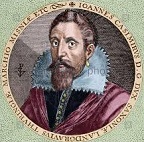



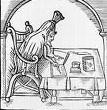




1583 In Jan. the Duke of Anjou turns on the Dutch rebels and attacks several of their cities, sacking Antwerp, but is forced to flee to France in disgrace; William of Orange accepts the sovereignty of the N Netherlands. In Feb. the Cologne (Seneschal) (Sewer) War (ends 1588) begins when drunken horndog Gebhard Truchsess von Waldburg (1547-1601), archbishop-elector of Cologne, who was caught living with concubine Agnes and decided to become a Protestant to make an honest woman of her, announcing his conversion last Dec., but refusing to resign, finally goes through with the marriage, and is excommunicated and deposed in Apr. by Pope Gregory XIII, who appoints genuine Catholic throwback Ernest of Bavaria (1554-1612), bishop of Liege (brother of Duke William V of Bavaria) as his successor (after which the position becomes a Bavarian thing until 1761); meanwhile Gebhard, who had already built up an army doesn't just hand the bishopric over, and after asking for help from elector Augustus I of Saxony, who doesn't like his Calvinist friends, and Henry of Navarre, who tries in vain to form a coalition to aid him, Calvinist John Casimir, Count Palatinate of Simmern (1543-92) (who sent his portrait to Elizabeth I of England in 1564 hoping to wow her, in vain), the new regent of the Rhine Palatinate (until 1592) comes to his aid in Oct., but is defeated, and Gebhard is driven from Bonn to refuge in Strasbourg, where he later moves to the Netherlands and becomes friends with Robert Dudley, 1st earl of Leicester, but fails to talk Elizabeth I into helping him make a comeback. On May 23 the exiled Duke of Lennox dies in Paris; on June 27 James VI escapes from imprisonment at the House of Ruthven after 10 mo. (Aug. 1582), and James Stewart, earl of Arran begins regent (until 1585). On June 11 Sir Humphrey Gilbert (1539-83) (half-brother of Sir Walter Raleigh), looking for a passage to Cathay sails from Plymouth, England to Newfoundland in the 40-ton flagship Golden Hind (Hinde) (originally the Pelican until 1577), arriving on Aug. 3 and becoming the founder of the first English colony in North Am. at St. John; after the colonists mutiny, he dies on the return voyage on Sept. 9 after deciding to sail in the 10-ton Squirrel, and it goes down with the entire crew in a storm off the Azores. On July 6 Edmund Grindal (b. 1519) dies, and John Whitgift (1530-1604), bishop of Worcester becomes archbishop of Canterbury, going on to persecute Puritans without any mental qualms and become known as a "narrow, mean, tyrannical priest, who gained power by servility and adulation" (Thomas Babington Macaulay), sometimes being attended by a retinue of 800 horsemen. In July after Elizabeth's secy. Francis Walsingham arrests several of the conspirators in an alleged plot by Philip II, the Spanish ambassador, and the Guises to invade England and overthrow her, Sir Francis Throckmorton (b. 1554) is arrested and executed. In Oct. after announcing that he's going to shoot Elizabeth I and setting out for London, secret Roman Catholic John Somerville of Warwickshire (b. 1560) of Castle Bromwich, Park Hall, Warwickshire is arrested, and after being racked and confessing hangs himself in his cell in the Tower of London after implicating his priest named Hall and his father-in-law Edward Arden (b. 1542), son of William Arden, 2nd cousin of Shakespeare's mother Mary Arden, who is hanged, drawn, and quartered on Dec. 20 in the Smithfield for plotting against Elizabeth I and being a secret Roman Catholic. The Desmond War (begun 1579) ends with the Irish put back in their place, until next time. Philip Sidney, who had retired to live with his sister Lady Pembroke after falling under the queen's displeasure is knighted and restored to her favor. A Jesuit residence is built in Tartu by Polish king Stefan Bathory, who gives Tartu a red-white flag. The Siamese invade Cambodia with 100K men, killing the king and departing with 50K POWs. Despite the attempts of Valide sultan (co-regent) Nur Banu (b. 1525) (widow of Selim the Sot) to lure her son Sultan Murad III (d. 1595) away from his favorite wife, Venetian-descent Sophia (Sofia) (Safieh) ("the light or pure one") Baffo (1550-1605) (a distant relative?) by delivering him a stream of curvaceous concubines on Fridays, she dies (poisoned by an agent from Genoa?), and Sophia Baffo becomes the new Valide Safiye Sultan (until 1594). After entreaties from his envoy Bogdan Yakovlevich Belsky (-1611), Elizabeth I refuses aging Tsar Ivan IV the Terrible permission to marry Lady Mary Hastings in order to cement an alliance, and she becomes known as the Tsarina of Muscovy. English expeditions to Mesopotamia, India and the Persian Gulf are led by merchants Ralph Fitch and John Eldred (end 1591). Mughal emperor Akbar the Great changes the name of the N Indian city of Prayag in Uttar Pradesh at the confluence of the Ganges and Yamuna Rivers (where Brahma allegedly offered his first sacrifice after creating the world) to Allahabad (City of Allah) (modern-day pop. 1.1M/1.2M). San Luis Potosi (Potosí) in C Mexico (modern-day pop. 2.7M) is founded by Franciscan monks as a mission. The Accademia della Crusca scholarly society is founded in Florence, Italy by Antonio Francesco Grazzini (Il Lasca) (1503-84), with the mission of maintaining the purity of the Italian language, going on to compile a definitive dictionary, and administrate the Test di conoscenza della lingua italiana (Test of knowledge of the Italian language). The first known life insurance England is issued on the life of William Gibbons. The Queen's Co. of Players is formed in London by Sir Edmund Tilney (Tylney) (1536-1610) after the Puritan-run Corp. of London closes the theaters on the Surrey shore under the claim that they spread the plague each summer. English dramatist Robert Greene (1558-92) returns from a 5-year tour of Europe and settles in London, spending the rest of his short life in debauchery while writing some great drama, verse, and prose. Architecture: Gen. Toyotomi Hideyoshi lays the foundation of Osaka Castle in Osaka, the Venice of Japan at the head of the Gulf of Osaka at the mouth of the Yodo River, whose source is Lake Biwa (finished in 1587). Nonfiction: Andrea Cesalpino (1519-1603), De Plantis (16 vols.); dedicated to Francesco I de' Medici; most important work on botany until Carl Linnaeus, making the first scientific classification of flowering plants, using the organs of fructification as the foundation. Carolus Clusius (1526-1609), Rariorum Stirpum per Pannonias Observatorium Historiae; first book on Austrian-Hungarian alpine flora, which he studied under the auspices of HRE Maximilian II, becoming the first botanist to climb Mt. Otscher and Mt. Schneeberg. Henry Howard, 1st Earl of Northampton (1540-1614), A Defensative against the Poyson of Supposed Prophecies; an attack on judicial astrology, declared to contain heresy and treason, getting him imprisoned for a time. Francesco Sansovino, Del Governo et Ammistrazione di Diversi Regni et Republiche. Joseph Justus Scaliger (1540-1609), Opus Novum de Emendatione Temporum (Paris); lays out a system of chronology on scientific principles, expanding the realm of classical history from ancient Greece and Rome to Egypt, Babylonia, Israel, and Persia, establishing him as the "Father of Chronological Science" and the leading Renaissance scholar of the classics (greatest since Aristotle or Marcus Terentius Varro?); Bible-thumpers later latch onto his work to prove the divine origin of the Bible and predict the date of Armageddon; really a bunch of moose hockey based on the Qabala and repeating shifts of dates based on the numbers 333 and 360? Sir Thomas Smith (1513-77), De Republica Anglorum: The Manner of Government or Policie of the Realme of England (posth.); says that England is a commonwealth, and all commonwealths are of mixed character. Philip Stubbes, Anatomie of Abuses; a lampoon of Elizabethan dress and manners. Art: Giovanni da Bologna (1524-1608), The Rape of the Sabines (sculpture). Music: Claudio Monteverdi (1567-1643), Madrigali Spirituali (First Book of Madrigals) (four parts); his first work, at age 16. Plays: Robert Ganier (1545-90), Les Juives (The Jews) (tragicomedy). Poetry: Baptista Honwaerd, Pegasides Pleyn Amorosity (didactic). Novels: Robert Greene (1558-92), Mamillia; written in imitation of John Lyly's "Euphues". Births: Dutch theologian Simon Episcopius (Bisschop) (d. 1643) on Jan. 8 in Amsterdam; educated at the U. of Leiden. Dutch statesman-jurist Hugo Grotius (Huig de Groot) (d. 1645) on Apr. 10; he, Samuel von Pufendorf, and Emerich de Vattel codify the protocols of ambassadors, such as whether they should meet at the foot or top of stairs? Swedish chancellor (1612-54) Count Axel Gustafsson Oxenstierna (Oxenstjerna) (Oxenstiern) (d. 1654) on June 16 in Fano (Fanö), Uppland; created count in 1645. German Thirty Years' War soldier Dodo Knyphausen (d. 1636) on July 2 in East Frisia. French Jesuit theologian Dionysius Petavius (Denis Petau) (d. 1652) on Aug. 21 in Orleans; educated at the U. of Paris. German Lutheran elector of Saxony (1591-1611) Christian II (d. 1611) on Sept. 23; eldest son of Christian I (1630-91) and Sophie of Brandenburg; brother of Johann Georg I (1585-1656). Italian composer Girolamo Frescobaldi (d. 1643) in Sept. in Ferrara; student of Luzzasco Luzzaschi and Carlo Gesualdo. English organist-composer Orlando Gibbons (d. 1625) on Dec. 25 in Cambridge. Italian painter Antonio Marziale Carracci (d. 1618) in Venice; son of Agostino Carracci (1557-1602). Austrian gen. (military leader in the Thirty Years' War) Albrecht Eusebius Wenzel von Wallenstein, Duke of Friedland and Mecklenburg, and Prince of Sagan (d. 1634) near Koniggratz. Indonesian Aceh Darussalam sultan (1607-36) (Sunni Muslim) Iskanadar Muda 9d. 1636). English "A New Way to Pay Old Debts" dramatist Philip Massinger (d. 1640) in Salisbury; educated at St. Alban Hall, Oxford U. German nobleman Georg of Calenberg, Duke of Brunswick-Luneburg-Calenberg (d. 1641). French chemist-physician Jean Rey (d. 1645) (b. 1582?) in Le Bugue, Perigord; educated at the U. of Montpellier. Scottish theologian (#2 after John Knox) Alexander Henderson (d. 1646) in Criech, Fife; educated at the U. of St. Andrews. Deaths: Italian architect-artist Pirro Ligorio (b. 1512) on Oct. 30 in Ferrara. Flemish composer Ihan Gero (b. 1518). English archbishop of Canterbury (1576-83) Edmund Grindal (b. 1519) on July 6. Swiss theologian Thomas Erastus (b. 1524) on Dec. 31 in Basel. Venetian-born Ottoman Valide sultana (1574-83) Nur-Banu (b. 1525). Spanish conquistador Juan de Garay (b. 1528) on Mar. 20 near Rio de la Plata; ambushed by Querandies natives on the Carcarana River en route from Buenos Aires to Santa Fe. English soldier-navigator Sir Humphrey Gilbert (b. 1539) (drowned in the Azores). English royal favorite Esme Stewart, 1st duke of Lennox (b. 1542) on May 26.



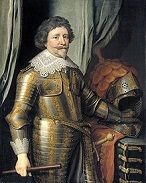



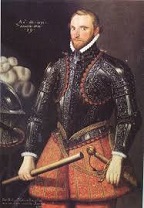




1584 The Roman Catholic states of Germany and Switzerland adopt the Gregorian Calendar. On Mar. 25 Sir Walter Raleigh (1552-1618) is knighted and granted a patent by Elizabeth I to explore and colonize North Am., threatening revocation if he doesn't establish a colony, causing him to explore the E coast, founding the first English settlement on Roanoke Island off the coast of N.C. next year by sending a 7-ship fleet under adm. his cousin Sir Richard Grenville (1542-91) and gen. Sir Ralph Lane (1532-1603), where Bohemian mining expert Joachim Gans (Ganse) researches the copper smelting techniques of the native tribes, which take only four days vs. 16 weeks for Euros; Jews are still not allowed in England under thhe 1290 expulsion order of Edward I; Raleigh sends Philip Amadas and Arthur Barlowe to explore the coast of modern-day N.C., and they return with news of king Wingina, ruler of the kingdom of Wingandacoa, causing England to annex the vast undefined area of Virginia (Va.) (N.C. to Fla.), named for Virgin Queen Elizabeth I, which is good, since on his next voyage Raleigh finds out that wingandacoa actually means "What good clothes you're wearing" in Algonquian - he ought to know better? Out steps Johnny B. Goode? On Mar. 28 (Mar. 18 Old Style) after becoming overwhelmed with guilt and remorse and entering a religious order of hermits under the name of Jonah, tsar (since Dec. 3, 1533) Ivan IV the Terrible (b. 1530) dies after conquering the khanates of Kazan, Astrakhan, and Sibir (Siberia) and expanding his state to 1.56M sq. mi. (4.05M sq. km), his kingdom on the verge of anarchy, and his feebleminded son Fyodor (Theodore) I (the Bellringer) (1557-98) becomes the last Rurikid tsar of Russia (until Jan. 7, 1598); Boris Godunov (1551-1605), brother of his wife, whom Ivan IV had appointed guardian and regent becomes the #1 big man in Russia and head of state, colonizing Siberia and becoming the first Russian ruler to exile political enemies there; meanwhile Ivan IV's other son tsarevich Dmitri Ivanovich of Uglich (Moscow) (1582-91) waits in the wings, but is declared illegitimate and banished from Moscow because he is the son of Ivan's 8th wife, and the Orthodox Church only recognizes the right to have three - mama don't take my cold old throne away? On Apr. 17 the earls of Mar and Angus storm Stirling in an attempt to seize William Ruthven, 4th Lord Ruthven, 1st Earl of Gowrie (b. 1541), and on Apr. 28 Gowrie is charged with treason, and executed in May. On June 19 Henry II's and Catherine de' Medici's son Duke Francois of Alencon (b. 1555) dies of a fever in France at Chateau-Thierry, becoming the last direct Valois heir to the French throne; Henry III having no sons, the French succession passes to Huguenot Henry of Navarre (1553-1610) (future Henry IV), freaking out the Guise family and their Catholic Holy League and causing them to step up their popular movement and secure control of most French cities. On June 19/20 after being smuggled into Dublin in fall 1583 and getting arrested in Sept. while staying with Lord treasurer of Ireland Thomas Butler, 10th Earl of Ormond without his consent, followed by torture and a kangaroo trial after refusing to convert to Protestantism, Roman Catholic archbishop of Cashel, Ireland (since 1583) Dermot O'Hurley (b. 1530) is hanged in Hoggen Green, Dublin, joining the Irish Catholic Martyrs; on Sept. 27, 1992 he is beatified by Pope John Paul II.
If you can't win by the front door, try the back door? On July 10 after Philip II puts a price on his head in 1581, 51-y.-o. "Soldier of the Reformation" Lutheran prince of Orange (since July 15, 1544) William I the Silent (b. 1533) is assassinated in Delft by insane Balthazar Gerard (Gérard) (1557-84); next Nov. 1 after being elected as statholder, his son Maurice of Nassau, Prince of Orange (1567-1625) carries on for the next 40 years (until Apr. 23, 1625), followed by his other son Frederick Henry (Frederik Hendrik), Prince of Orange (1584-1647) for 22 years (until Mar. 14, 1647), followed by Frederick Henry's son William II, Prince of Orange (1626-50) (until Nov. 6, 1650), who finally gains the Dutch a guarantee of freedom. In July the Spanish army under Spanish Netherlands gov. (1578-92) Alessandro Farnese, Duke of Parma and Piacenza (1545-92) begins the Siege of Antwerp (ends Aug. 1585), defended by Philip (Philips) van Marnix, Lord of St. Aldegonde (1540-98); Farnese cuts off sea access with a boat bridge across the Scheldt from Calloo to Oordam; the siege becomes the first time a bomb is used; too bad, the porous lines of the siege allow smugglers to bring in grain, until the city decides to set a maximum price on it, making them not want to bother, causing starvation. In the autumn the Protestant League of Gentlemen is formed in England to protect Queen Elizabeth and kill Mary, Queen of Scots in the event of a Roman Catholic invasion; it is legalized by parliament in 1586. In Oct. the pamphlet Leicester's Commonwealth: The Copy of a Letter Written by a Master of Arts of Cambridge is pub., attacking Queen Elizabeth's favorite Robert Dudley, 1st earl of Leicester as a traitor like his father the Lord Protector Northumberland, accusing him of Puritan sympathies, calling him an amoral opportunist of "almost satanic malevolence", detailing stories of his scandalous deds and dangerous plots; she has it suppressed as Roman Catholic propaganda, which doesn't stop it from hurting his rep for cents. On Aug. 9 Philip II of Spain appoints the most Catholic Alvaro de Bazan (Álvaro de Bazán), 1st Marquis of Santa Cruz (1526-88) as Capt.-Gen. of the Ocean Sea to kick pesky Protestant British naval butt; known for never having lost a battle and for his personal galley La Loba (the She-Wolf) (named after its golden figurhead), he is given orders to plan an invasion of England after assembling a Spanish Armada, but the ineptness of the king and his administrators keeps him from getting very far before his premature death in Lisbon on Feb. 9, 1588. Philip Howard, 13th earl of Arundel is suspected of plotting against Queen Elizabeth's govt. and ordered to remain under house arrest, but attempts to flee England (for Douay?), is caught and sentenced to life in prison; being a Howard, he is released after a time, then rearrested for high treason and condemned to death, croaking in prison in 1595; meanwhile he manages to father a son, Thomas Howard, 2nd Earl of Arundel (1585-1646) - reflections of the way life used to be? In late Dec. Welsh courtier and MP William Parry (Parrie) (-1585), a Roman Catholic double agent hides in Elizabeth's gardens at Richmond, intending to assassinate her, but chickens-out and is exposed six weeks later, then expelled from Parliament on Feb. 11, tried on Feb. 18, and hanged on Mar. 2 in front of Westminster Palace - thanks for being the best agent in the whole wide world? A royal audiencia is established in the Philippines to check abuses of power by the colonial govs., who are virtually independent of Manila. Earthquakes, plague, and crowds in Vienna cause moody, nervous, reclusive Rudolf II to move the residence of the HRE permanently to Prague, where in the comparative tranquility he takes up the collection of rare and beautiful things, as well as magic and astronomy, and assembles a cast incl. Tycho Brahe and Johannes Kepler, giving Prague its golden age. Gen. Toyotomi Hideyoshi takes complete control of Kyoto and gains the title kanpaku, representing civil and military control of all Japan. The Dutch found a trading post in Archangel, Russia. The city of Thingvalla on the island of Tingvalla in Lake Vaner, Sweden near the estuary of the Klar R. 200 mi. W of Stockholm is renamed to Karlstad. The Accademia Lucchese dei Scienze, Lettere ed Arti is founded in Lucca, Italy. Emmanuel College at Cambridge U. is founded by Puritan Sir Walter Mildmay (1523-89), English chancellor of the exchequer to produce learned Protestant religious ministers to compete with the output of the Roman Catholic Dominican schools. Uppingham School is founded in Uppingham, Rutland, England as a hospital by Robert Johnson (1540-1625), archdeacon of Leicester. Architecture: The Cordouan Lighthouse at the mouth of the Gironde River in France is begun (finished 1611), becoming the oldest wave-swept lighthouse to survive to modern times. Nonfiction: Giordano Bruno (1584-1600), La Cena de le Ceneri (The Ash Wednesday Supper) (London); De la Causa, Principio et Uno (On Cause, Principle and Unity) (London); De l'Infinito Universo et Mondi (On the Infinite Universe and Worlds) (London); Lo Spaccio della Bestia Trionfante (The Expulsion of the Triumphant Beast) (London). Richard Hakluyt (1552-1616), A Discourse of Western Planting; written by an English Roman Catholic priest, it provides Protestants with an impetus to colonize America to beat the Catholics to it. Jon Jonsson, Gudbrands Biblia; the first complete printed Bible in Icelandic. John Knox (1505-72), Hystory of the Reformation of Religioun within the Realme of Scotland (posth.). Gian Paolo Lomazzo (1538-1600), Trattato dell'Arte della Pittura, Scoltura et Architettura; art crticism based on the concept of decorum. Nicholas Sanders (1530-81), De Origine ad Progressu Schismatis Anglicani (posth.). Reginald Scot (1538-99), The Discoverie of Witchcraft, wherein the Lewde dealing of Witches and Witchmongers is notablie detected, in sixteen books ... whereunto is added a Treatise upon the Nature and Substance of Spirits and Devils (16 vols.); argues against belief in witches, showing how their feats of magic are accomplished, becoming the first textbook on magic (conjuring). Plays: John Lyly (1553-1606), Alexander and Campaspe (Jan. 1) (Blackfiars Theatre, London); Sapho and Phao (Mar. 3) (Blackfriars Theatre, London).Poetry: Honore d'Urfe (1568-1625), La Sireine; pastoral poem. Guillaume de Salluste, Sieur Du Bartas (1544-90), L'Uranie; Judit. Novels: John Lyly (1553-1606), Euphues; The Myrrour of Modestie. Barnabe Rich, Second Tome of the Travels and Adventures of Don Simonides. Births: Dutch prince of Orange (1625-47) Frederick Henry (Frederik Hendrik) (d. 1647) on Jan. 29 in Delft; youngest child of William I the Silent (1533-84) and Louise de Cologny; half-brother of Prince Maurice of Orange (1567-1625); born 6 mo. before his father's assassination on July 10. English Civil War Parliamentary gen. Ferdinando, 2nd Lord Fairfax of Cameron (d. 1648) on Mar. 29 in Yorkshire; father of Thomas, 3rd lord Fairfax of Cameron (1612-71); MP from 1614-29 and 1640 (Long Parliament). German composer Melchior Teschner (d. 1635) on Apr. 29 in Silesia. German poet Georg Rudolf Weckherlin (d. 1653) on Sept. 15 in Stuttgart; secy. for foreign tongues in England (1644-9). English courtier (favorite of James I) Philip Herbert, 4th Earl of Pembroke, 1st Earl of Montgomery (d. 1650) on Oct. 16 in Wilton House; son of Henry Herbert, 2nd earl of Pembroke (1534-1601) and Mary Sidney Herbert (1561-1621); brother of William Herbert, 3rd earl of Pembroke (1580-1630); educated at New College, Oxford U.; husband of Susan de Vere (daughter of the 17th earl of Oxford); Shakespeare's First Folio is dedicated to the "Incomparable Pair of brethren". English "The Knight of the Burning Pestle", "The Maid's Tragedy" dramatist Francis Beaumont (d. 1616) in Grace-Dieu, Leicestershire; partner of John Fletcher (1579-1625). Italian freethinking philosopher Lucilio Vanini (d. 1619) in Taurisano (near Lecce). English navigator-explorer William Baffin (d. 1622) in London. English Puritan MP John Pym (d. 1643) in Brymore, Somerset; educated at Pembroke College, Oxford U. Spanish dramatist Tirso de Molina (Gabriel Tellez) (d. 1648). Flemish Baroque painter Cornelis de Vos (d. 1651) in Hulst (near Antwerp). English Puritan soldier Capt. Myles (Miles) "Capt. Shrimp" Standish (d. 1656) in Lancashire (Isle of Man?); born of "the house of Standish of Standish"; his ancestral lands are "surreptitiously detained from him", forcing him to become a mercenary in Holland. French physician (Henry IV, Louis XIII, Louis XIV) Charles de Lorme (De L'Orme) (d. 1678) in Moulins; son of Marie de' Medici's doctor Jean Delorme; educated at the U. of Montpellier. English pickpocket ("the Roaring Girl") Mary Frith (Moll Cutpurse) (d. 1659) in the Barbican, London. Deaths: Indian saint Surdas (b. 1478). Italian scholar Antonio Francesco Grazzini (Il Lasca) (b. 1503) on Feb. 18 in Florence. French architect Jacques Androuet du Cerceau (b. 1515). Russian tsar (1543-84) Ivan IV the Terrible (b. 1530) on Mar. 28 (Mar. 18 Old Style) in Moscow. Polish poet Jan Kochanowsky (b. 1530) on Aug. 22 in Lublin. English interrogator-poet Thomas Norton (b. 1532) on Mar. 10. Dutch prince of Orange (1544-84) William I the Silent (b. 1533) on July 10 in Delft (assassinated). Italian composer Pietro Vinci (b. 1535). Italian prelate (St.) Carlo Borromeo (b. 1538). Flemish painter Mathys Bril (b. 1550). French duke Francois of Alencon (b. 1555) on June 19 in Chateau-Thierry, Paris (malaria); last of the Valois line.




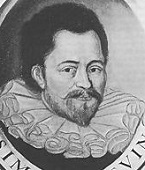


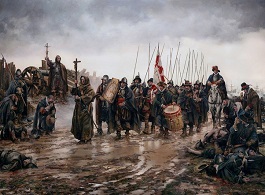
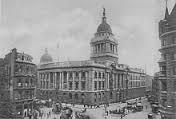
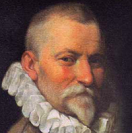
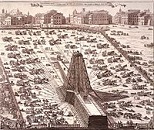
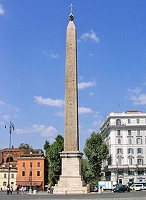
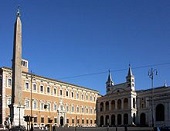
1585 On Apr. 10 Calendar Pinup Pope (since 1572) Gregory XIII (b. 1502) dies, and on Apr. 24 former swineherd Felice Peretti is elected Pope (#227) Sixtus (Sextus) V (1521-90), becoming known as "the Iron Pope"; Nostradamus had allegedly long before (c. 1540) passed the young monk on the street, knelt down, and addressed him as "Your Holiness"; on Sept. 9 he excommunicates Huguenot Henry of Navarre (Bourbon) (future Henri IV), who raises taxes to pay for a huge construction program. In May Philip II orders the seizure of all English ships in Spanish ports, to be added to his Lisbon fleet; meanwhile Elizabeth I shocks Roman Catholic Europe by corresponding with Sultan Murad III in hopes of a miltiary alliance against Spain, writing that Islam and Protestantism have "much more in common than either did with Roman Catholicism, as both rejected the worship of idols" - which doesn't mean that Islam doesn't want to exterminate both? On July 4 a 7-ship fleet under Sir Richard Grenville (1542-91) brings 100 English settlers under Ralph Lane (1532-1603) to Roanoke Island in Virginia (in modern-day N.C.) to set up a base for privateering on Spanish treasure fleets, and they settle on the N side (until 1586); too bad, they kidnap Indians and hold them hostage in exchange for info. on food, pissing them off; the settlers incl. Celts, Germans, Jews et al.; in 1593 Lane is knighted by Elizabeth I. In July the Munster Plantation is begun by the stankin' English as punishment for the Desmond Rebellions, with the depopulated estates of the Geraldine Desmond dynasty confiscated and given to colonists from England and Wales as a bulwark against future rebellions, starting with sending a commission led by Ireland surveyor-gen. (since 1559) Sir Valentine Browne (1510-89) to allocate confiscated lands to English Undertakers, wealthy colonists who undertake to import tenants, develop new towns, and provide for common defense; lands are confiscated in the modern-day counties of Cork, Kerry, and Limerick; by 1589 700 English tenant families plant 500K acres; too bad, English soldiers are withdrawn in the 1590s, and in 1598 the Nine Years War causes most settlers to flee to walled towns or back to England, and the plantation isn't reconstituted until after the rebellion ends in 1603 by Munster gov. George Carew. On Aug. 6 commoner Gen. Toyotomi Hideyoshi (1537-98) is appointed regent (tampaku), and attempts to establish a dictatorship in Japan; in Nov. he holds a Grand Kitano Tea Ceremony to wow his subjects, followed by the Great Sword Hunt, wherein he confiscates his subjects' weapons. On Aug. 15 Antwerp capitulates due to famine, after which it starts to fall behind Rotterdam and Amsterdam as an internat. port; Philip van Marnix is dissed by the English and Dutch for surrending, causing him to retire from public service and begin a translation of the Bible; the Spanish go on to reconquer practically all of S Netherlands; meanwhile after both Henry II of France and Elizabeth I of England decline sovereignty of the Netherlands, in Aug. Elizabeth makes a treaty taking them under her protection, and on Sept. 17 sends English troops to their aid, led by the earl of Leicester, with Sir Thomas Fludd (1530-1607) (Robert Fludd's father) as treasurer; in Sept. she makes Sir Francis Drake an admiral with a fleet of 22 ships, and sends him to capture Spanish bases Santo Domingo, Havana, and Cartagena in the Caribbean; he does so after first capturing Vigo on the coast of Spain; Martin Frobisher accompanies him as vice-adm. on the Primrose. On Nov. 2 the Earl of Arran's control over the king is brought to an end, and 19-y.-o. James VI of Scotland, after four regents begins his rule at age 21; Scotland has suffered from a long succession of child kings and has been ruled by regents for 100 of the years since 1406? - whadya expect for men who wear skirts? On Dec. 8 the Battle (Miracle) of Empel in the Netherlands sees 3K-4K Spanish soldiers under Juan de Aguila surrounded by 100 Dutch heretic ships under Adm. Philip of Hohenlohe-Neuenstein, causing the Spanish to be resigned to die rather than surrender until a soldier digs up a painting of the Virgin Mary and an unexpected night freeze allows them to burn the ships and kill hundreds of heretics, scoring a big V that they give to Mary, who is proclaimed the patroness of the Spanish Tercios of Flanders and Italy; after the battle, the Dutch adm. utters the soundbyte: "It seems that God is Spanish to work such a miracle for them." The original That Girl? On Dec. 24 (Xmas Eve) Mary Stuart is moved from Tutbury to Essex's moated castle at Chartley 12 mi. away. Pasquale Cicogna (-1595) becomes doge #88 of Venice (until 1595), which is in such a bad way that he throws silver instead of gold coins at his ascension, causing them to be called cicognini; he goes on to convert the Rialto Bridge over the Grand Canal from wood to stone in 1588-91. Elizabeth I quashes a Puritan Bill attempting to ban all entertainment and sports on Sunday. Pope Sixtus V appoints his protege, Swiss architect Domenico Fontana (1543-1607) as papal architect (until 1592), and he begins completing Michelangelo's 1547 plans for the dome of St. Peter's in Rome along with Giacomo della Porta (finished 1590); next year he engineers the moving of a 327-ton Egyptian obelisk from the Roman Circus of the Vatican to the front of St. Peter's Square, which requires 900 men and 75 horses, going on to erect three more in the Piazza del Popolo (where public executions are held until 1826), incl. the Piazza di Santa Maria Maggiore, and Piazza di San Giovanni in Laterano (Aug. 9, 1588); he also designs the Palace of Monte Cavallo, the Vatican Apostolic Library, the Lateran Palace (Apostolic Palace of the Lateran) (1586-9), the Acqua Paolo Fountain, the Acqua Paolo Fountain on the Janiculum Hill (1612), and the Acqua Felice Aqueduct (along with his brother Giovanni Fontana) in the Quirinal (1585-8). The Kingdom of Luba in modern-day Katanga, S Dem. Repub. of Congo (DRC) is founded by King Kongolo Maniema, whose nephew-successor Kalala Ilunga expands the empire to the upper left bank of the Lualaba River, with a pop. of 1M, and an economy based on fishing, farming, and metal-working, with the kings considered sacred like in ancient Egypt; in 1889 after white Euro (mainly Belgian) colonists raid the empire for slaves, the kingdom is split in two by a succession dispute, and is later absorbed into Belgium's Congo Free State. A Jesuit U. is founded in Graz, Austria, future home of Ahnuld (Arnold Schwarzenegger) - conspiracy theory here? The Frankfurt Stock Exchange in Germany is founded to set up fixed currency exchange rates, moving in 1874 to a new bldg. at Borsenplatz where a statue of a bull and bear stand in front (stealing the idea from the Yanks?), and going on to become the 3rd biggest world stock exchange. Old Bailey is first mentioned as the sessions house of the lord mayor and sheriffs of the city of London and of Middlesex, located next to the Newgate Gaol, funded by wealthy former mayor of London Sir Richard "Dick" Whittington (1354-1423); it burns down during the 1666 Great Fire of London, and is rebuilt in 1674, with an open court to prevent the spread of disease until 1734, when it was enclosed, leading to typhus outbreaks, with 60 dying in 1750 incl. the lord mayor and two judges; it is rebuilt again in 1774, and a 2nd courtroom added in 1824; in 1674-1834 100K+ criminal trials are held. English explorer John Davis (1543-1605) searches for a Northwest Passage in two ships named Sunshine and Moonshine, discovering the Davis Strait between Baffin Island (Canada) and Greenland; he gives up in 1587. William Shakespeare (1564-1616) leaves Stratford-upon-Avon for London, joining a band of actors and promising to send money back to his family (an unhappy marriage, or too dangerous for them to come along?); he signs up with one of the two chief playing companies, that of James Burbage (Burbadge) (1531-97) (father of Richard Burbage), beginning his Johannes Factotum (Jack of All Trades) Age (1587-92) - signed, sealed, delivered, I'm yours? English actor Edward Alleyn (1566-1626) becomes head of the Lord Chamberlain's Men and the Lord Admiral's Company. Florentine painter Bartolommeo Carducci (1560-1638) accompanies his teacher Federico (Federigo) Zuccari (1542-1609) to Madrid to decorate the new Escorial Palace, where he is known as Bartolome Carducho, going on to paint the ceiling of the Escorial Library; Zuccari returns to Rome at the end of 1588 after Philip II finds his paintings disagreeable. Architecture: The Teatro Olimpico (Olympic Theater) in Vicenza, Italy opens, designed by Andrea Palladio (1508-80). Inventions: Bartholomew Newsam (1530-87) of the Strand, London constructs the first English traveling and standing clocks. Flemish mathematician-engineer Simon Stevin (Stevinus) (1548-1620) pub. the booklet "Die Thiende" (The Art of Tenths), expounding the use of decimal fractions, causing their daily use; he goes on to predict the universal introduction of decimal coinage, weights, and measures; in 1600 he invents the first wind-driven land vehicle. Art: El Greco (1541-1614), The Virgin of the Immaculate Conception and St. John. Paolo Veronese (1528-88), Apotheosis of Venice (Sala de Gran Consiglio, Venice). Nonfiction: Giordano Bruno (1548-1600), De gl'Heroici Furori (On Heroic Frenzies) (London). Lucas Janszoon Waghearen, Spiegel der Zeevaart. Plays: Miguel Cervantes (1547-1616), Galatea (pastoral romance). Battista Guarini (1538-1612), Il Pastor Fido (pastoral) (Turin). Births: English Catholics founder Mary Ward (d. 1645) on Jan. 23. Danish physician-scientist (child prodigy) Caspar Bartholin the Elder (d. 1629) on Feb. 12 in Malmo, Sweden; head of a family of scientists, 12 of whom become profs. at the U. of Copenhagen; father of Thomas Bartholin (1616-80) and Erasmus Bartholin (1625-98); gives up science for theology after an illness. German Protestant Wettin elector of Saxony (1611-56) Johann Georg (John George) I (d. 1656) on Mar. 5 in Dresden; 2nd son of Christian I (1560-91) and Sophie of Brandenburg; brother of Christian II (1583-1611); father of Johann Georg II (1613-80). English art collector Thomas Howard, 2nd (21st) Earl of Arundel, 2nd (4th) Earl of Surrey and 1st Earl of Norfolk (d. 1646) on July 7; son of Philip Howard, 13th Earl of Arundel (1557-95) and Anne Dacre (daughter of Thomas Dacre, 4th baron Dacre); grandfather of Thomas Howard, 5th duke of Norfolk. French statesman cardinal (1622-) ("the Red Eminence") Armand Jean du Plessis, Duke de Richelieu (d. 1642) on Sept. 9 in Paris; founder of the Academie Francaise. German composer-organist Heinrich Schutz (Schütz) (d. 1672) on Oct. 8 in Kostritz; influences J.S. Bach and Dietrich Buxtehude. Dutch Roman Catholic bishop-theologian (founder of predestinationist Jansenism) Cornelius Jansen (Corneille Janssens) (d. 1638) on Oct. 28 in Acquoy, Gelderland. Am. "Milk for Babes" Puritan divine ("the Patriarch of New England") John Cotton (d. 1652) on Dec. 4 in Derby, England; grandfather of Cotton Mather (1663-1728). Scottish author-poet William Drummond of Hawthornden (d. 1649) on Dec. 13 in Hawthornden Castle, Midlothian. English explorer (Maine) George Weymouth (d. 1612) in Cockington, Devon. Am. religious leader ("the Apostle of Virginia") Alexander Whitaker (d. 1616) in Cambridge, England; son of William Whitaker (1548-95); educated at Trinity College, Cambridge U. Dutch poet-playwright (co-founder of the Amsterdam Theater) Gerbrand Adriaensz Bredero (d. 1618). Virginia tobacco pioneer John Rolfe (d. 1622) in May in Heacham, Norfolk. Am. Pilgrim-friendly Patuxet Indian Squanto (Tisquantum) (d. 1622) in Mass. English Jacobean dramatist-actor William Rowley (d. 1626); collaborator of Thomas Middleton (1580-1627); known for playing fat clowns. Dutch skeptical Jewish philosopher Uriel Acosta (Gabriel da Costa) (d. 1640) in Porto; from a family of conversos (Jews converted to Roman Catholicism); father is a Catholic priest; whole family returns to Judaism in 1617 and flees to Amsterdam; too bad, he becomes a skeptic, and is savagely persecuted by the rabbis. Dutch merchant Pieter van den Broecke (d. 1640) on Feb. 25 in Antwerp. French architect Jean Androuet III du Cerceau (d. 1650); son of Jean Baptiste Androuet du Cerceau (1544-90); famous for his hotels particuliers in Paris. French Baroque architect Jacques Lemercier (d. 1654) in Pontoise. Portuguese Jesuit priest-missionary (in China) Alvaro (de) Semedo (d. 1658 (b. 1586?) in Nisa. Dutch mariner Jacob Le Maire (d. 1616) in Antwerp (Amsterdam?). Am. Puritan tailor Isaac Allerton (d. 1659) in London, England; ancestor of U.S. presidents Zachary Taylor and Franklin D. Roosevelt. Deaths: English organist-composer Thomas Tallis (b. 1505). Flemish botanist Rembert Dodoens (b. 1517) on Mar. 10. French court poet Pierre de Ronsard (b. 1524). Scottish poet "The Admirable" James Crichton (b. 1560) in Mantua (killed in swordfight).








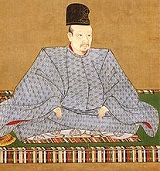
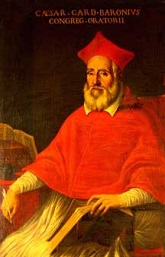
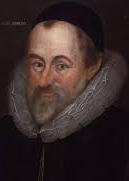

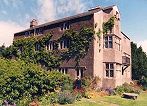
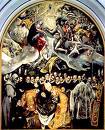
1586 On Jan. 15 the Dutch give Robert Dudley, 1st Earl of Leicester (1533-88) the office of supreme gov. of the Netherlands, which throws Elizabeth I into a jealous tizzy until he steps down? On Feb. 11 Augustus I (b. 1526) dies, and his 6th (eldest surviving) son Christian I (1560-91) becomes elector of sexy Lutheran Saxony (until Sept. 25, 1591), going on to appoint Calvinist councillor Nikolaus Krell (1551-1601), who introduces the Second Reformation, prohibiting the practice of exorcism in 1591 and promoting reconciliation with the Calvinists, promoting them into govt. and church offices and bringing out a German trans. of the Bible with Calvinist annotations. On Mar. 14-27 the Colloquy of Montbeliard ( Montbéliard) attempts a union of the Lutherans and Calvinists, but they can't agree on the universalism or particularism of grace, and after a debate on Sept. 2, 1587, followed by another on Apr. 15-8, 1588 in which Theodore Beza (1519-1605) participates, particularism wins, but they still never unite. Mary Stuart, Queen of Scots nominates Philip II as her successor to the English throne; in Mar. Philip II writes to Pope Sixtus V asking for and receiving the Church's blessing on his planned Enterprise of England, the invasion of England and overthrow of Elizabeth I; Pope Sixtus V promises financial aid to the Spanish Armada. In the spring Sir Francis Drake introduces tobacco pipe smoking to Sir Walter Raleigh before capturing Cartagena in Colombia (capital of the Spanish Main) and sacking St. Augustine on the E coast of Fla.; on June 26 Drake visits Roanoke Island and learns of its woes of recurring Indian attacks and supply shortages; in July after dropping off 15 of his own men (who are never heard from again), he returns the disheartened colonists to England, who cause a sensation by smoking (drinking?) sotweed (tobacco) from pipes; Sir Walter Raleigh becomes the first ranking Englishman to smoke, helping to make the nasty habit fashionable (along with boy buggering)? - red eyes plus a grunt, it'll all make sense? In May James VI of Scotland makes the squabbling nobles walk hand in hand to a royal banquet - to show he's a peacemaker, not to convert them to the other team? On July 6 after meeting in Tolboothin Berwick upon Tweed for a week, Elizabeth I's ambassador Edward Manners, 3rd Earl of Rutland (1549-87) and James VI's ambassador Francis Stewart, 5th Earl of Bothwell (1562-1612) sign the Treaty of Berwick, a mutual alliance guaranteeing aid from the other if an invasion of their homeland should occur; James VI is granted a £4K annual pension from England, signaling that he is considered an heir to the English throne; a plan to make the people of Scotland English citizens is scrapped. On July 21 Thomas Cavendish (1560-92) leaves Plymouth, England on a voyage of circumnavigation with three ships and 123 men, becoming the first to emulate Sir Francis Drake, raiding Spanish towns and ships in the Pacific and circumnavigating the Earth, reaching the Strait of Magellan next Jan. 6, reaching Guam on Jan. 3, 1588, the coast of Africa on May 14, 1588, and returning to Plymouth on Sept. 9, 1588 (2 years 49 days) (9 mo. faster than Drake) with only one ship and 48 crew, parading up the Thames River through London displaying new blue damask sails before being knighted by Elizabeth I, the captured treasure making him rich. On Aug. 9 the Anthony Babington (b. 1561) Conspiracy to assassinate Elizabeth I, traced-out by the spies of Sir Francis Walsingham causes his arrest while out hunting at Chartley; on Sept. 13 Babington and his associates are put on trial, condemned, and executed on Sept. 20-21; the episode convinces the public that Elizabeth cannot be safe as long as Mary lives, causing Parliament to request her to order Mary's execution. On Sept. 18 Ottavio Farnese (b. 1521) dies, and his son Alessandro Farnese (1545-92) (a talented field cmdr., known for his successful campaign against the Dutch Revolt in 1578-92) becomes duke #3 of Parma and Piacenza (until Dec. 3, 1592), requesting leave to visit his new dukedom, and being refused by Philip II, who needs him in the Netherlands; Farnese then proposes an invasion of England with 30K troops in hopes of sparking a Roman Catholic uprising, but Philip II nixes him, instead beginning the planning for the 1588 Spanish Armada. On Sept. 22 a small English army under the earl of Leicester wins a V against Alessandro Farnese's forces at the Battle of Zutphen near Arnhem; Sir Philip Sidney (b. 1554), who had been forbidden by the queen to accompany Drake on one of his expeditions, causing him to go with Leicester to the Netherlands is wounded in the leg, and dies 26 days later on Oct. 17, becoming renowned for refusing a cup of water in favor of a dying soldier, uttering the soundbyte "Thy need is greater than mine", causing his school chum Sir Fulke Greville, who had been forbidden by Elizabeth I to go with him on the expedition to write his "Life of the Renowned Sir Philip Sidney" (pub. 1625); after this the English begin to lose the war, and Leicester returns to England on leave; too bad that Philip II decides it's time for the Spanish Armada to take the English out before their combo with the Dutch gets too dangerous? On Oct. 14 Mary Stuart's trial for treason begins at Fotheringay, and ends with a guilty verdict, leaving her punishment to Parliament and Queen; Parliament convenes on Oct. 29 and votes unanimously for death, which is pub. on Dec. 4, but the queen delays in signing the warrant until next year. On Oct. 19 Egnatio Danti (b. 1536) dies, and in 1588 geocentric astronomer Giovanni Antonio Magini (1555-1617) is chosen over Galileo Galilei for his chair of math at the U. of Bologna. On Dec. 3 after bringing them to Ireland last year, Sir Walter Raleigh's 2nd in command Sir Thomas Herriot arrives in England with the first potatoes (Solanum tuberosum), just in time to combat a severe corn shortage in England this year; too bad, Bible-thumpers can't find them mentioned, so they don't want to plant them, although Roman Catholics later settle for sprinkling them with holy water and planting them on Good Friday; Sir Walter Raleigh later gets the credit instead of him; actually, Raleigh never visited a country that had potatoes? On Dec. 3 Pope Sixtus V issues a bull fixing the number of cardinals at 70 (50 priests, 6 bishops and 14 deacons); he also issues the bull Detestabilis, forbidding usury. On Dec. 12 Stephen Bathory (b. 1533) dies, and his 16-y.-o. nephew Sigismund (Zsigmund) Bathory (1572-1613) becomes prince of Transylvania (until 1613), attaining the age of majority in 1588 and joining the Christian league of princes against the Turks, scaring the turds out of his nobles, who at the Diet of Turda demand that he take the coronation oath a 2nd time, and when he refuses, they begin a revolt, which he quells by 1595, executing every last one of the bums. On Dec. 17 Japanese emperor (since 1557) Ogimachi (b. 1517) resigns in favor of his grandson (eldest son of his 5th son Prince Masahito) Go-Yozei (1571-1617) (personal name Kazuhito) becomes Japanese emperor #107 (until May 9, 1611), going on to preside over the rise of Toyotomi Hideyoshi and the Edo Shogunate (bakufu). Sir John Maitland, 1st Lord Maitland of Thirlestane (1537-95) becomes lord chancellor of Scotland to James VI (until 1593). Swiss Roman Catholic military leader Ludwig Pfyffer (1524-94), known as "the king of the Swiss" forms the League of the Seven Swiss Roman Catholic Cantons (Golden League) (Borromean League), which pledges to expel Protestant heretics, nearly destroying the Swiss Confederation and dividing the canton of Appenzell along religious lines. The military revolts in Egypt, putting the Ottoman gov. under house arrest before it is suppressed; the first of many revolts (1589, 1598, 1601, 1604, 1609), all of which are also suppressed. Tyumen, Russia on the Tura River 1.6K mi. E of Moscow is founded to support eastward expansion. The city of Kuybyshev (Samara) in Russia on the Volga River (modern-day pop. 1.1M) is founded. Architecture: St. John Lateran in Rome is rebuilt. The Escorial Palace near Madrid (begun 1563) is completed. The Egyptian Obelisk brought to Rome in 40 C.E. by Roman Emperor Caligula, which fell sometime in the distant past is moved 275 ft. from the site of the proposed new St. Peter's Basilica to the center of the proposed St. Peter's Square using 40 winches, each operated by a 4-horse team pulling 3-in.-thick ropes with water poured on them to prevent sparks; the task takes 4 mo.; Pope Sixtus V blesses the pagan monument to the Sun with the soundbyte "I exorcise you to bear the holy Cross and remain devoid of all pagan impurity and all assaults of spiritual iniquity". Swarthmoor Hall in Ulverston, Cumbria, England is built by George Fell (son of Margaret Fell), and in 1652 it becomes the birthplace of the Quaker (Society of Friends) movement. Nonfiction: Caesar Baronius (1538-1607), Annales Ecclecsiastici (12 vols.) (1588-1607); history of the Roman Catholic Church to 1198 C.E., bolstering its claims to authority; produced to counter the anti-Catholic "Magdeburg Centuries"; coins the term "Dark Ages" for the period from 500-1100 C.E. Cardinal Robert Bellarmine (1542-1621), Disputations about the Controversies of the Christian Faith Against the Heretics of this Time (1586-93); gives ammo to Roman Catholics against Protestants. William Camden (1551-1623), Britannia; or a Chorographical Description of Great Britain and Ireland, Together with the Adjacent Islands; written in Latin; bestseller, going through seven eds. by 1607; first English ed. tr. by Philemon Holland pub. in 1610; a chorography of Britain county-by county incl. maps and history, becoming the first to paint a coherent picture of Roman Britain. Dirk Volkertszoon Coornhert (1522-90), Zedekunst, dat is Wellevens Kunst. Rene Goulaine de Laudonniere (1529-74), L'Histoire Notable de la Floride, contenant les trois voyages faits en icelles par des capitaines et pilotes français (autobio.) (posth.). Simon Stevin, De Beghinselen der Weeghconst; introduces the law of equilibrium and the triangle of forces; also states that unequal weights fall a given distance in the same time. William Webbe, Discourse of English Poetrie.; reviews English poetry up to his day, and discusses prosody. Art: El Greco (1541-1614), The Burial of Count Orgaz (1586-8); shows his son in the background. Births: German "Musical Banquet" composer Johann Hermann Schein (d. 1630) on Jan. 20 in Grunhain; importer of Italian Baroque music to Protestant Germany. Dutch East Indies gov.-gen. #5 (1623-7) Pieter de Carpentier (d. 1659) on Feb. 19 in Antwerp. Italian Roman Catholic Jesuit philosopher-mathematician Niccolo (Niccolò) Cabeo (Nicolaus Cabeus) (d. 1650) on Feb. 26 in Ferrara. Italian traveler (Asia) Pietro della Valle (d. 1652) on Apr. 2 in Rome. English "Love's Sacrifice", "'Tis Pity She's a Whore" dramatist-poet John Ford (d. 1640) on Apr. 17 in Ilsington, Devonshire; educated at Exeter College. Am. Puritan leader (founder of Conn.) Thomas Hooker (d. 1647) on July 5 in Marefield (Birstall?), Leicestershire, Endland; educated at Emmanuel College, Cambridge U. German "The Chymical Wedding of Christian Rosenkreutz" theologian (Lutheran pietist) Johann Valentin Andreae (Johannes Valentinus Andrea) (d. 1654) on Aug. 17 in Herrenberg, Wurttemberg. Italian astronomer Niccolo Zucchi (d. 1670) on Dec. 6. English "Christ's Victory and Triumph" poet Giles Fletcher the Younger (d. 1623); son of Giles Fletcher the Elder (1549-1611); brother of Phineas Fletcher (1582-1650); cousin of John Fletcher (1579-1625); educated at Westminster School, and Trinity College, College U. Spanish painter Luis Rodriguez Tristan (Tristán) de Escamilla (d. 1624) in Toledo; asst. of El Greco (1603-7). English soldier John Mason (d. 1635) in King's Lynn, Norfolk; founder of New Hampshire (N.H.). French physician ("the first French journalist") ("the inventor of the personal ad") Theophraste (Théophraste) Renaudot (d. 1653) in Loudun; educated at the U. of Montpellier; runs the first pawn shop in Paris (1637); starts out Protestant, then is converted to Roman Catholicism by Cardinal Richelieu after meeting him in London, returning with him to Paris and rising to royal physician of Louis XIII. Greek theologian (keeper of the Vatican Library in 1661-9) Leo Allatius (d. 1669) in Chios. Deaths: English poet Sir Richard Maitland (b. 1496). Spanish painter Luis de Morales (b. 1510) on May 9 in Badajoz. French cardinal-statesman Antoine Perrent de Granvelle (b. 1517) on Sept. 21 in Madrid; leaves a magnificent art collection by Titian, Leone Leoni, Pieter Brueghel, Hieronymus Bosch et al., which HRE Rudolf II buys at lowball prices. Italian composer Andrea Gabrieli (b. 1520). Italian duke of Parma and Pacienza #2 (1556-86) Ottavio Farnese (b. 1521) on Sept. 18. Dutch gov. of the Netherlands (1559-67) Duchess Margaret of Parma (b. 1522) on Jan. 18 in Ortona. German elector of Saxony (1553-86) Augustus I (b. 1526) on Feb. 11 in Dresden. English politician Sir Henry Sidney (b. 1529) on May 5. Italian madrigal composer Bartolommeo Spontone (b. 1529). Polish-Transylvanian king Stephen Bathory (b. 1533) on Dec. 12. Italian priest-astronomer Egnatio Danti (b. 1536) on Oct. 19 in Alatri. English poet-soldier Sir Philip Sidney (b. 1554) on Oct. 17 in the Netherlands (wound in thigh from the Battle of Zutphen); last words: "Thy necessity is yet greater than mine"; buried in St. Paul's Cathedral on Feb. 16, 1587; leaves The Countess of Pembroke's Arcadia., a sensational novel about the Duke of Basilius, who travels to the Oracle at Delphi.




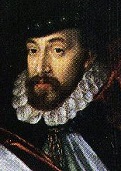





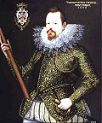

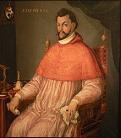





1587 On Feb. 8 after years of cat-and-mouse games trying to position herself to take over and re-Catholicize Elizabeth I's England, 45-y.-o. Mary Stuart (Stewart), Queen of Scots (b. 1542) is executed for treason at Fotheringhay Castle in Northamptonshire after 18 years of house arrest by order of her half-sister Elizabeth I; she dies in grand style, clutching a crucifix and wearing a scarlet petticoat, the Roman Catholic symbol of martyrdom; it takes 3 (15?) strokes of the axe to sever her head, on which the lips keep moving, and the bungling axeman has to finish with a knife; when her head is picked up her red wig falls off, revealing an old woman, partially bald with white hair; her dog runs from out of her cloak, and lays down between her head and body; her clothes are burned and the castle is ordered torn down to discourage pilgrimages by Catholics who consider her a martyr; Elizabeth I, who has never met her makes a show of blaming Mary's execution on errant councillors, admitting that she signed the execution warrant but claiming that she didn't authorize it to be delivered to the executioners, and that they had held a secret meeting to transmit it without authorization, fixing the blame on secy. of state William Davison (1541-1608), whom she dismisses and imprisons as the fall guy, causing his asst. William Brewster (1567-1644) to return to his home town of Scrooby, becoming postmaster and later founding the Puritan Separatists that end up founding Plymouth Colony; James VI of Scotland stifles his urges to avenge his mother because of the large annuity he receives from Elizabeth, and also because he wants to succeed her to the English throne and has to be nice; too bad, Mary had bequeathed her claims to the English throne to Philip II of Spain, providing him with an excuse for an invasion, and the execution of a Roman Catholic martyr by the hated English bastard heretic queen whips up Catholics everywhere; too bad also, the example of a sacred cow royal being executed when their religion stands in the way of the English regime ends up backfiring bigtime with the Stuarts, and forever putting English monarchs on notice? On Apr. 11 3 mo. after presiding over the trial of Mary, Queen of Scots, English lord chancellor (since 1579) Thomas Bromley (b. 1530) dies, and Edward Manners, 3rd Earl of Rutland (1549-87) succeeds him, but dies two days later on Apr. 14 (Good Fri.). In Apr.-June the English under Sir Francis Drake attack the Spanish Armada at Cadiz and Lisbon, delaying it for more than a year; at Cape St. Vincent he destroys their food and water barrels, and captures a huge haul of Spanish treasure in the Azores, incl. 2.9K barrels of sherry, making it popular in Britain. On June 25 Robert Dudley, 1st earl of Leicester sails to the Netherlands with a new English army of 3K men, causing the Duke of Parma to sue for peace, which drags on until Nov. 10, when Leicester returns to England. On July 20 the pope signs a treaty with Spain, calling for a Roman Catholic crusade for the invasion of England, and consenting to Philip II nominating whomever he pleases to rule England, as long as the Roman Catholic faith is restored; Philip choses his daughter the Infanta Isabella Clara Eugenia. On July 30 Mary's coffin is moved to Peterborough Cathedral for burial, where it rests until 1612, when James I has it moved to Westminster Abbey - well bear my pall? The original Don't Be a Paleface? The foolhearty Anglo whites take a dare in Injunland a little too early? In July after John White (1540-93) (half-brother of Sir Walter Raleigh) visits the North Carolina area and returns with shocking but cool, twisted-to-Euro-prejudices paintings of the half-naked but partly civilized and hence useful Indians (hence kinda a little bit white?), he leads a party of 116 English settlers (90 men, 17 women, 9 children) and lands on Roanoke Island off the N.C. coast; on Aug. 18 Virginia Dare (1587-) is born to Gov. John White's daughter Ellinor and Ananias Dare, becoming the first white European child born in the Am. colonies (don't think Heidi Klum and Seal?); wasting no time to make the place liveable, the colonists brew their own ale from corn; on Aug. 27 Gov. White leaves for England with a skeleton crew of 15 to seek help and supplies, leaving instructions that if the colonists are forced to leave in his absence they should inscribe their destination in a "conspicuous place"; too bad, the war between England and Spain keeps him from returning until 1590; the paintings start out circulating in the hands of the elite only, but eventually get made into prints which circulate in Europe for two cents., forming their main impression of Am. Indians; meanwhile white men's diseases (smallpox, typhus, measles) begin their genocidal effect on the defenseless pop., aggravated by a drought lasting until 1589. On Aug. 14 Guglielmo I Gonzaga (b. 1538) dies, and his (impotent?) son Vincenzo I Gonzaga (1562-1612) becomes duke of Mantua and Montferrat (until Feb. 9, 1612), going on to turn Mantua into a cultural center with composer Claudio Monteverdi (1567-1643), painter Peter Paul Rubens (1577-1640), poet Torquato Tasso (1544-95) et al.; he allegedly sends a secret expedition to the New World to find a cure for his impotence; too bad, he spends Mantua into financial decline and doesn't leave his son much (if he left a son?). In Aug. after taking Otend, Alessandro Farnese takes Sluis in Zeeland, the planned staging point for the invasion of England, and waits a year for the Armada to come - what's going through your head? In Sept. the die having been cast when Mary's head fell, Philip II orders the Duke of Parma to assemble an invasion force of barges in the Netherlands to finish English Protestantism off; on Dec. 21 Charles Howard, 2nd Baron Howard of Effingham, 1st Earl of Nottingham (1536-1624) is appointed lord high adm. and cmdr. of the English fleet, which is mobilized effinghamly at jet speed; his flagship is the galleon Ark Royal, built this year in Deptford on the Thames River. On Oct. 19 Francesco I de' Medici (b. 1541) dies, and his younger brother cardinal Ferdinando I de' Medici (1549-1609) becomes grand duke of Tuscany (until Feb. 7, 1609), going on to give up the office of cardinal to marry in 1589 and become a just and mild ruler (the opposite of his brother), even enacting an edict of tolerance for Jews and heretics that causes Livorno to become a haven for Jews expelled from Spain in 1492. On Oct. 20 the French Huguenots led by Henry of Navarre crush the French Roman Catholics at the Battle of Coutras. In Hungary Nov. 1 follows Oct. 21 as the Gregorian Calendar is adopted. Sigismund (Zygmunt) III Vasa (1566-1632), a Swedish nephew of Sigismund II (son of King John) is elected king of Poland and grand duke of Lithuania (until Apr. 19, 1632). Wolf Dietrich Raitenau (1559-1617), son of a niece of Pope Pius IV is elected prince-bishop of Salzburg (until 1612), continuing the harsh measures of the Counter-Reformation, expelling all Protestants from Salzburg next year, going on to promote Baroque architecture N of the Alps while battling his neighbor Duke Maximilian I of Bavaria until he is captured, deposed, and imprisoned for life in 1612. After his younger brother Duke Francis of Anjou dies in 1584, and it becomes apparent that he won't produce an heir, Henry III of France fights in the War of the Three Henrys with the Holy League, headed by Henry of Lorraine, 3rd Duke of Guise (1550-88) and the Guise Family against Huguenot leader Henry of Navarre (Henry III's distant cousin), started by Philip II of Spain to keep France from interfeing with his Spanish army in the Netherlands and the planned invasion of England; it ends in 1589 when Henry of Navarre outlives the other two and becomes king Henry IV of France. The Thai unsuccessfully seige the Khmer capital of Longvaek. Robert Devereux, 2nd Earl of Essex (1565-1601), stepson of her former lover Robert Dudley, 1st earl of Leicester replaces Sir Walter Raleigh in the queen's bed, er, favor - now now, it wasn't your head was it? Boris Godunov issues an edict legalizing serfdom in its most degrading form, binding serfs to the land by prohibiting their transfer between landowners. The first English Poor Laws are enacted. Christopher Marlowe joins Queen Elizabeth I's spy network run by Sir Francis Walsingham to make money on the side as a courier and info.-gatherer, traveling abroad on assignments. Toyotomi Hideyoshi banishes Portuguese missionaries from Japan. The Tondo Conspiracy of 1587 (Conspiracy of the Maharlikas) (Revolt of the Lakans) sees Magat Salamat (1550-95), crown prince of the kingdom of Tondo and Augustin de Legazpi, son of a Tondo maginoo (chieftain) and a Spanish mother stage an abortive indio revolt against the Spanish in the Philippines (ends 1588). St. Bonaventure (1221-74) is declared #6 of the great doctors of the Roman Catholic Church by Pope Sixtus V; Pope Sixtus IV canonized him in 1482; he is also called "Seraphic Doctor". The first co. of English players is organized in Germany. The Banco della Piazza di Rialto is founded in Venice by the state to hold the funds of merchants on safe deposit. Architecture: English architect Inigo Jones begins Cobham Hall in Kent as the home of William Brooke, 10th Baron Cobham (1527-97) (completed by the Adam brothers); in 1957 it becomes a girls' boarding school. Architecture: Osaka Castle in Japan (begun 1583) is finished. Music: Zeminoth Israel, Collection of Jewish Songs. Plays: Robert Greene (1558-92), Euphues, his Censure to Philautus; a continuation of Lyly's 1578 Euphues. Christopher Marlowe (1564-93), Tamburlaine the Great (blank verse drama); his first big success, causing him to write Tamburlaine the Great, Pt. 2; title role played by tall London thespian Edward Alleyn (1566-1626), who stars in all of Marlowe's major plays and becomes the #1 Elizabethan actor, although he never acts in a Shakespeare play. Johann Spiess (-1607), Das Volksbuch von Dr. Faust (Frankfurt) (English trans. 1588); Faust has a son with Helen of Troy? Nonfiction: Antonio Agustino, Dialogo de Medallas y Inscriciones (posth.). John Bridges, Defence of the Government of the Church of England; "A foole and his money is soone parted"; cf. Proverbs 21:20. Isaac Casaubon (1559-1614) (ed.), The Works of Strabo. Hugo de Groot (1583-1645), Rederijckunst; Dutch manual on rhetoric. Richard Hakluyt (1552-1616), Notable History, Containing Four Voyages Made by Certain French Captains Into Florida. Raphael Holinshed (1529-80), Chronicles of England, Scotland, and Ireland (rev. ed.) (2 vols.) (posth.); pisses-off Elizabeth I, who orders some offensive passages excised; an uncensored 6-vol. ed. is pub. in 1808; used by Elizabethan dramatists incl. Shakespeare (for "Macbeth", "King Lear", "Cymbeline"). Abd-Al-Qadir Al-Jaziri, Umadat Al-Safwa fi hill Al-Qahwa; first known work on the history of coffee; claims that Sheikh Jamal al-Dain al-Dhabhani (-1470), mufti of Aden was the first to use it: "He found that among its properties was that it drove away fatigue and lethargy, and brought to the body a certain sprightliness and vigor." Franciscus Patricius (1529-97), The New Geometry (15 vols.). Births: Spanish PM (valido) (1621-43) Gaspar de Guzman y Pimentel, Count of Olivares and Duke of Sanlucar la Mayor (d. 1645) on Jan. 6 in Rome; father is a Spanish ambassador. Dutch East Indies gov.-gen. #4 (1618-23, 1627-9) Jan Pieterszoon Pieters Coen (d. 1629) on Jan. 8 in Hoorn. Italian duke of Mantua and Montferrat (1612-26) Ferdinando (Ferdinand) I Gonzaga (d. 1626) on Apr. 26 in Mantua; son of Vincenzo I Gonzaga (1562-1612) and Eleanora de' Medici; brother of Vincenzo II Gonzaga (1594-1627). Italian duke of Savoy (1630-7) ("the Lion of Susa") Victor Amadeus I (d. 1637) on May 8 in Turin; son of Duke Charles Emmanuel I (1562-1630) and Catherine Michaela of Spain (1567-97) (daughter of Philip II); husband (1619-37) of Christine Marie of France (1606-63), daughter of Henry IV and Marie de' Medici. Dutch (Flemish) Baroque landscape painter (Protestant) Esaias van de Velde (d. 1630) on May 17 in Amsterdam; brother of Jan van de Velde (1595-1652). English adm. (Puritan) Robert Rich, 2nd Earl of Warwick (d. 1658) on June 5; brother of Henry Rich, 1st earl of Holland, lord Kensington (1590-1649). Italian "La Liberazione di Ruggiero" Baroque composer-singer-lutenist-poet Francesca Caccini (d. 1642) on Sept. 18 in Florence; daughter of Giuilio Caccini (1551-1618). English Renaissance poet-novelist Lady Mary Wroth (d. 1653) on Oct. 18. Dutch "Cavalry" dramatist-poet Joost van den Vondel (d. 1679) on Nov. 17 in Cologne. German organist-composer Samuel Scheidt (d. 1654). Deaths: Spanish viceroy #3 of New Spain (1566-8) Gaston de Peralta (b. 1510). English "Foxe's Book of Martyrs" martyrologist John Foxe (d. 1516) on Apr. 18 in London. Italian-born Ottoman grand adm. Uluj Ali (b. 1519) on June 21 in Constantinople. Italian painter Antonio Campi (b. 1524). English lord chancellor (1579-87) Sir Thomas Bromley (b. 1530) on Apr. 11 in London; buried in Westminster Abbey on May 2. Italian duke of Mantua and Montferrat (1550-87) Guglielmo I Gonzaga (b. 1538) on Aug. 14. Italian grand duke (of Tuscany) Francesco de' Medici (b. 1541) on Oct. 17; dies a few hours after his 2nd wife (former mistress) Bianca Cappello; his younger brother Cardinal Ferdinando I de' Medici, who took charge of their 11-day illness orders immediate autopsies to coverup the fact that he had them poisoned with arsenic to get the duke's title, which is proved by Italian scientists in 2006-7. Scottish queen (1542-67) Mary Stuart, Queen of Scots (b. 1542) on Feb. 8 in Fotheringhay Castle, Northamptonshire, England (beheaded). English diplomat Edward Manners, 3rd earl of Rutland (b. 1549) on Apr. 14 (Good Fri.) in London; dies two days after succeeding Sir Thomas Bromley as lord chancellor.

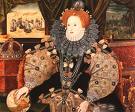








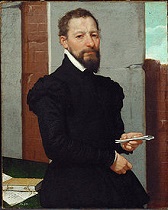


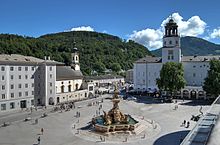
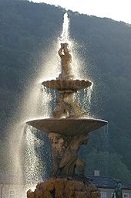

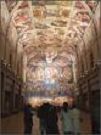

1588 On Feb. 11 Pope Sixtus V issues a bull creating 15 permanent congregations to lessen his work, incl. the Congregation of the Holy Roman and Universal Inquisition or Holy Office - he was expecting an English defeat and a glut of work for the new hires? It's getting to be a habit with me? Another big V for Protestantism? The future of the English is so bright they need to wear shades? In Feb. the Marquis of Santa Cruz dies, and is replaced by Don Juan Alonso Perez de Guzman el Bueno, Duke of Medina-Sidonia (1502-58) as cmdr. of the Invincible Spanish Armada (130 galleon ships carrying 19K-27K men), whose plan is to land in Sandwich-Deal and support an invasion of England through Kent by the Duke of Parma's professional soldiers coming from Flanders (reinforced through the Spanish Road from N Italy), capturing it for the Roman Catholic faith, with exiled English Cardinal William Allen (1522-94) waiting in the wings; it sets sail from Lisbon on May 30, the very day that peace commissioners sent by both sides meet in Parma; after stopping at Corunna for supplies, it sets sail again, then is scattered by a storm from the Bay of Biscay; in early July it leaves La Coruna; on July 19 it is sighted off the The Lizard (Peninsula) by the 197-ship English navy (34 royal warships, 163 armed merchant vessels); on July 21 there is a skirmish off Eddystone, Plymouth, and another on July 23 off Portland, Dorset; on July 27 the Armada anchors off Gravelines between France and Spanish Netherlands to await for communications from Parma's army, the stench from its filthy galleys rowed by slaves chained to their benches carrying for miles on the wind; on Aug. 7-8 (July 28-29 Old Style) (Sun.-Mon.) English "hell-burners" (fire ships) are sent into the 130-ship (22 galleon and 108 armed merchant vessels) Spanish Armada (known for its powerful crescent formation) at the Battle of Gravelines, causing it to break ranks, after which it is defeated by the English guns at close quarters, losing five ships, with the rest badly damaged, and 600 KIA, 800 wounded, and 397 POWs taken; it then makes for Scotland without Parma's army, where it is broken up by a great "Protestant wind" off the coast on July 30, then forced onto the N and W Irish coasts, where 24+ ships are wrecked; the Spanish warship La Girona fires a broadside at the Chimney Tops in the Giant's Causeway on the N coast of Ireland (60 mi. NW of Belfast) after believing them to be an enemy fortress, ending up wrecked on Oct. 26, losing all but nine of 1.3K aboard; on Aug. 19 (Aug. 9 Old Style) glammed and glowing queen (since Nov. 17, 1558) Elizabeth I (1533-1603) rides down to Ft. Tilbury in Essex to cheer up the troops and see the Armada, and rides out with a 6-man bodyguard, giving her big Tilbury Speech while mounted on a grey gelding and dressed in white with a silver cuirass (metal breastplate), with the immortal soundbyte: "I have the body but of a weak and feeble woman, but I have the heart and stomach of a king"; after waiting two more days for a possible invasion by Parma's army from Dunkirk, the English troops disperse and party hearty; meanwhile the remaining 53 intact Spanish ships, having lost two-thirds of their men (15K-20K of the 11K sailors and 19K soldiers) straggle back to Spain by Oct. 14; the English lose eight ships, 50-100 killed, and 400 wounded, although 6K-8K later die of disease; Drake's co-admirals Martin Frobisher and John Hawkins are knighted for their role in the big British V; Elizabeth I hands out medals with the inscription "God breathed and they were scattered"; on Sept. 29 Spanish warship San Esteban is wrecked on the W coast of Ireland, with all survivors killed or taken POW and hanged after reaching shore; 10K English troops were equipped with firearms as an experiment, while the Spanish relied on archers, and the English success convinces military experts to give up on archery; the Armada Portrait of Elizabeth I, by an unknown artist shows her resting her hand on a globe over America; English Roman Catholic Charles Neville, 6th Earl of Westmorland (1542-1601), who commanded a 700-man army of English fugitives from Flanders flees to the Continent, and is attainted by Parliament, living on a small pension from the Spanish king until he dies broke on Nov. 16, 1601; after getting separated from the fleet in July and forced to battle some of England's most powerful ships until putting into port in Ireland, Spanish 2nd in command Adm. Don Juan Martinez de Recalde (1540-88) returns to A Coruna, dying of his wounds on Oct. 23 a few days after docking; British sea supremacy begins, along with increasing nationalism in England, helping secure Protestantism as England's state religion, and being white and not olive-skinned or some other shade of red, brown or black as the metareligion; Spain's officer class is wiped out, the Duke of Medina-Sidonia never recovers from the humiliation, the Duke of Parma's rep. remains under a cloud, but the Spanish keep hoping for a miracle from God to defeat the infidels, sending four more armadas until 1601; the Dutch are greatly helped in their battle for independence from the Spanish, going on to clear them from the territories of the Seven United Provinces by the end of the cent. Big day for the Huguenots and anybody named Lorraine, and a blois year for French Catholics named Guise? In May Henri I de Lorraine, 3rd Duke of Guise (b. 1550) (leader of the Holy League) turns against Henry III, and on May 12 leads the Parisians in revolt on the Day of the Barricades (timed to distract Protestant Huguenots from helping the English fight the Spanish Armada), placing excommunicated Henri IV on the throne; Henry III is allowed to escape to Blois after he makes Lorraine the lt.-gen. of France, but after summoning the Estates-Gen. the pissed-off king engineers the assassination of the Duc de Guise along with his brother Cardinal de Guise on Dec. 23 at Blois; Queen Mother Catherine de' Medici is mad at her son's actions, along with the Estates-Gen. at Blois, who remonstrate strongly about the murders; too bad, Henry III leaves the House of Guise viable, and fails to kill the real troublemaker, the third brother Charles of Lorraine, Duke of Mayenne (Charles de Guise) (1554-1611), who leads a revolt against him, causing him to belatedly try to exterminate the whole house; Philippe de Mornay becomes the sole leader of the French Huguenots, becoming known as the "Huguenot Pope"; in the shuffle, all plans for revenging Mary, Queen of Scot's death are dropped? On Apr. 4 Frederick II (b. 1534) dies, and his son Christian IV (1577-1648) becomes king of Denmark and Norway (until Feb. 28, 1648), going on to rule for almost 60 years, initiate many reforms and projects, and have at least 26 children, legitimate and not - that's Folketing great? On Sept. 4 Leicester dies of stomach cancer, ruining her celebration of Accession Day, which continues this year from Nov. 17 until Nov. 19, St. Elizabeth's Day. In Sept. having seen the defeat of the Spanish Armada, Alessandro Farnese breaks his camp in Dunkirk, and finds that the pesky Dutch Protestant heretics have regrouped. In the fall Duke Charles Emmanuel I of Savoy takes advantage of the civil war in France to occupy the marquisate of Saluzzo. In Oct. Persian hero, prince, and heir apparent Hamzeh Mirza is assassinated, and his 17-y.-o. younger ascetic brother Abbas I the Great (1571-1629) (Abbas Mirza) (ruler of Khorasan since 1581) comes to Qazvin to claim the crown in his brother's name, and Mohammed Khodabanda (d. 1595), who suffers from near blindness personally crowns him as Safavid shah #5 of Persia and resigns after being deposed and imprisoned; Abbas goes on to gain support from the common people, modernize and de-Qazilbash the army with Euro help, secure the borders against the pesky Turkmen tribes and Uzbeks, and make Persia (Iran) a power in the world, with the Persian Gulf opened to trade; in his reign Persian Safavid Art reaches its summit. English ambassador to Russia Giles Fletcher the Elder (1549-1611) reestablishes the treaty with Tsar Feodor I. The Spanish Armada carries a large number of bilboes for restraining English POWs; after getting hold of some, they begin to be used for punishing imaginary or slight offenses in the English colonies. Cardinal Robert Bellarmine becomes spiritual dir. of the Collegio Romano - the flat men? The English Guinea Co. is founded to challenge the Dutch West India Co., but proves ineffective. Corrientes (San Juan de Vera), 25 mi. below the junction of the Parana and Paraguay Rivers in Argentina is founded by the Spanish. The first English paper mill is founded in Dartford. Architecture: The Residenzplatz in Salzburg, Austria is begun on the cemetery of the old monastery N of Salzburg Cathedral, starting with the Renaissance Neue Residenz, featuring a prominent bell tower, becoming the home of the prince-archbishops of Salzburg; in 1656-61 the Baroque Untersberg limestone Residenzbrunnen fountain is built, designed by Tommaso di Garona and topped by a statue of Triton based on the Triton Fountain in Rome, becoming the largest Baroque fountain in Europe. Italian architect Antonio da Ponte (1512-95) begins the stone arch Rialto Bridge over the S-shaped 2-mi. palace-lined Grand Canal in Venice (finished 1591); it goes on to become Venice's top tourist attraction. Domenico Fontana builds the Sistine Hall of the Vatican Library in Rome, which was originally founded in 1447-55 by Nicholas V with a nucleus of 340 vols. Fort Duncannon (Gael. "Dun Conan" = "Fort of Conan") in Duncannon Harbour in County Wexford, Leinster, Ireland is built to withstand the Spanish Armada. Science: Tycho Brahe rejects Copernicus' system, and proposes his own where the Sun, Moon, and fixed stars orbit the stationary Earth, and the five planets orbit the Sun - your future's worth a five minute phone call? Art: Annibale Carracci (1560-1609), Frescoes in Magnani Palace (Bologna). Tintoretto (1518-94), Paradiso (Doge's Palace, Venice) (1588-92); o ne of his last commissions, won after a competition. Music: William Byrd (1540-1623), Psalms, Sonets and Songs of Sadnes and Piete. Nicholas Yonge, Musica Transalpina (London) (57 madrigals). Nonfiction: Jean Bodin (1530-96), Colloquium of the Seven; a Calvinist, a Lutheran, a Jew, a Roman Catholic, a Muslim, and a skeptic debate, finally agreeing to tolerate each other; circulated only in ms. form. Giovanni Botero (1544-1617), On the Causes of Greatness in Cities (Delle Cause Della Grandezza Delle Citta); claims that cities grow when their nutritive virtue is greater than their generative virtue, and vice-versa; mentions the Chinese habit of tea drinking: "The Chinese have an herb from which they press a delicate juice which serves them instead of wine. It also preserves the health and frees them from all those evils that the immoderate use of wine doth breed in us." Timothie Bright, An Arte of Shorte, Swifte, and Secrete Writing by Character; first English shorthand manual. Giordano Bruno (1584-1600), Cause, Principle, and Unity; "I say the universal physical efficient cause is the universal intellect, which is the first and principle faculty of the world soul, which, in turn, is the universal form." Joachim Camerarius, Hortus Medicus. Thomas Hariot (1560-1621), A Briefe and True Report of the New Found Land of Virginia; written after having been sent to the colonies by Sir Walter Raleigh; incl. paintings of the aborigines by Roanoke gov. John White (1540-1618), and the first Map of Virginia; Hariot is the first Englishman to smoke tobacco? Giovanni Pietro Maffei (1533-1603), Historica Indica (Rome); talks about tea drinking in Japan, with the soundbyte: "The Japanese have as yet no use for grapes, but they make a kind of wine from rice. But that which before all they delight to drink is water almost boiling, mingled with the powdered chia." Michel de Montaigne (1533-92), Essais, Vol. III. William Morgan (tr.), The Bible Translated into Welsh. Thomas Stapleton, Tres Thomae. Plays: Robert Greene (1558-92), Pandosto, or Dorastus and Fawnia (romance). Christopher Marlowe (1564-93), Doctor Faustus (The Tragical History of the Life and Death of Doctor Faustus) (tragedy) (1588-93); performed 25x by the Admiral's Men between Oct. 1594 and Oct. 1597; scholar Faust makes a pact with the Devil, allowing him to become invisible and steal from the pope, then finds himself unable to burn his books or repent to God to get the contract annulled, and is carried off by demons; gets Marlowe arrested on blasphemy charges, insuring his fame? Novels: Robert Greene (1558-92), Perimedes the Blacke-Smith. Births: English "City Upon a Hill" Puritan leader John Winthrop (OE "friend's village") (d. 1649) on Jan. 12 in Edwardstone, Suffolk; first gov. of Mass. Bay Colony; father of John Winthrop Jr. (1606-76); educated at Trinity College, Cambridge U.; father of John Winthrop the Younger (1606-76) - the Puritan Nehemiah? English "Leviathan", "nasty, brutish and short" philosopher Thomas Hobbes of Malmesbury (Thomas Hobbs of Malmsbury) (d. 1679) on Apr. 5 in Malmesbury (Wiltshire?); born as rumors of the Spanish Armada cause theologians to pore over the Book of Revelation in an attempt to see that Spain is the Antichrist and that the End of Days is Near, causing his mother to go into premature labor?; "My mother was filled with such fear that she bore twins, me and together with me fear", causing him to think himself excessively timid?, and later write the soundbyte: "The original of great and lasting societies consisted not in mutual good will men had toward each other, but in the mutual fear they had of each other"; educated at Hertford College, Oxford U.; breaks English philosophy from scholasticism and founds scientific sociology, ethics, and politics. English Cavalier poet-hymnodist George Wither (d. 1667) on June 11 in Bentworth (near Alton); educated at Magdalen College, Oxford U. French philosopher-naturalist-mathematician and musical theorist Marin Mersenne (d. 1648) on Sept. 8. English composer-singer-lutenist-painter Nicholas Lanier (Laniere) (d. 1666) on Sept. 10 in Greenwich. Mongol khan (1603-34) Ligdan Khutugtu Khan (d. 1634) in Sira Moren Valley. English (Welsh) bishop of Bristol (1644-5) Thomas Howell (d. 1650) in Llangamarch, Brenockshire, Wales; son of a Welsh clergyman; brother of James Howell (1594-1666); educated at Jesus College, Oxford U. English royalist gen. William Seymour, 2nd Duke of Somerset (d. 1660); son of Edward, Lord Beauchamp (1561-1612); grandson of Edward Seymour, 1st earl of Hertford (1539-1621) and Catherine Grey (1640-68); husband of Arbella Stewart (1575-1615). English Puritan Mass. gov. (1629-) John Endicott (Endecott) (d. 1665) in Chagford?; other first gov. of Mass. Bay Colony. Deaths: Ottoman chief architect Mimar Sinan (b. 1489); designed 476 bldgs. incl. 360 monuments - bring your Turkish towel but don't fall for the soap trick? Spanish physician-botanist Nicolas Monardes (b. 1493) on Oct. 10 in Seville (cerebral hemorrhage). Spanish mystic poet Luis de Granada (b. 1505) in Lisbon. French pot Jean Dorat (b. 1508) on Nov. 1. Italian philosopher Bernardino Telesio (b. 1509) on Oct. 2 in Cosenza. Dutch occultist writer Johann Weyer (b. 1515) on Feb. 24 in Tecklenburg. Spanish adm. Alvaro de Bazan, 1st marquis of Santa Cruz (b. 1526) on Feb. 9 in Lisbon, Portugal; Philip II's anger at his independent judgment hastens his death? Italian painter Paolo Veronese (b. 1528) on Apr. 19 in Venice. Spanish physician Juan Huarte de San Juan (b. 1529) in Linares. Spanish painter Alonzo Sanchez Coello (b. 1531) on Aug. 8 in Madrid. English queenly beau Robert Dudley, 1st earl of Leicester (b. 1532); dies after the Spanish Armada is defeated, ruining her victory celebrations? French artist-explorer Jacques Le Moyne (b. 1533). Danish-Norwegian king (1559-88) Frederick II (b. 1534) on Apr. 4. Spanish adm. (2nd in command of the Spanish Armada) Juan Martinez de Recalde (b. 1540) on Oct. 23 in A Coruna, Spain (fever and battle wounds). French gen.-statesman Henri de Lorraine, 3rd Duc de Guise (b. 1550).







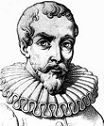




1589 On Jan. 14 Anglican clergyman (Corpus Christi College, Cambridge U. grad) Francis Kett (b. 1547) is burned in the ditch of Norwich Castle for Arian heresy and for claiming that the Jews would one day return to their Promised Land, "leaping and dancing... clapping his hands... until the fire had consumed all his nether parts, and until he was stifled with the smoke." In July the Oxford Executions of Roman Catholics take place, followed by priest-catching and other Catholic persecution in England. The French House of Valois lasts a year of years, less a hundred and four, because its value wa' gone? On Aug. 1 after French king (since May 30, 1574) Henry III (b. 1551) flees to the camp of Calvinist Huguenot Henry of Navarre in Saint-Cloud (St. Cloud) outside Paris for protection, he is murdered while in council by fanatical Dominican monk Jacques Clement (Clément) (b. 1567), who claims to be delivering a secret letter, then stabs him in the stomach, after which the king's attendants immediately kill him (Jesuit intrigue is alleged), and he dies on Aug. 2; three days earlier the king told his attendants that he dreamed of the royal regalia, his blue cloak, two crowns, scepter, sword, and spurs all trodden underfoot by monks and the mob; on his deathbed he names his distant cousin Henry of Navarre as his successor, and on Aug. 4 he is crowned Henri (Henry) IV (1533-1610) of France (until May 14, 1610), ending the Valois Dynasty (founded 1328) after 261 years, and founding the Bourbon Dynasty in France (ends 1830), becoming known as "Father and Friend of the People"; meanwhile on Aug. 2 the Catholic League refuses to recognize him and proclaims old fart Cardinal Charles de Bourbon (imprisoned by Henry since last Dec. 23) as French king Charles X (1523-90) (until May 9, 1590), striking coins in his name in 15 mints inc. Paris, after which parliament recognizes him on Nov. 21, causing Henri IV's enemies to split into two camps, the more patriotic and the more Catholic; Alessandro Farnese is ordered to leave the Low Countries for France to fight against Henri IV; on Sept. 15-18 Henri IV, supported by marshal Armand Louis de Gontaut, Baron de Biron (1524-92) defeats his arch-enemy, the fat Charles of Lorraine, Duke of Mayenne (1554-1611) at the Battle of Arques - now all Henri IV has to do to end 37 years of religious civil war is become a Catholic (1593) and issue the Edict of Nantes (1598)? On Aug. 20 after rejecting 31-y.-o. Katherine of Navarre, 23-y.-o. stylish learned stud and heartthrob James VI (1566-1625) of Scotland marries 15-y.-o. Lutheran Anne (Anna) of Denmark (1574-1619) (daughter of Frederick II and Sophia and older sister of future king Christian IV) by proxy at Kronborg Castle in Denmark, then after her flotilla gets bogged down in Norway he can't wait and sails to Norway, meets her on Nov. 19 and marries her again, spends the winter honeymooning at the Danish court, then proceeds to give her nine children, most not surviving infancy; they speak to each other in their only common language, French. Sir Francis Drake and Sir John Hawkins begin an expedition to seize Philip II's colonial treasure to prevent any more Spanish Armadas, and attack Lisbon with 150 ships and 18K men, but fail to take it. The English House of Commons appoints its first Standing Committee for Privileges. Roman Catholic lords of Scotland supporting the Earl of Huntly battle the king's troops at the Battle of Brig o'Dee road bridge over the Dee River (built 1527) near Aberdeen and lose; since Huntly doesn't show up in person, and is married to the king's kinswoman Henrietta Stewart, he is forgiven and sent home for a few mo., pissing off the Scottish churchmen, who want all Catholic nobles exiled from Scotland. The city of Hyderabad in Golconda, India, 400 mi. SE of Bombay (modern-day pop. 6.8M/7.7M) is founded by Kutb Shahi king Mohammed Kuli as the capital. Boris Godunov's Moscow patriarchate establishes itself as separate and independent from Constantinople. The city of Volgograd (originally Tsaritsyn) is founded at the confluence of the Tsaritsa and Volga Rivers near the unstable S border of Russia; in 1925-61 it is renamed Stalingrad, becoming the scene of the surrender of the German Sixth Army in WWII after the largest and bloodiest battle in history (until ?); in 1961 it is renamed Volgograd. Forks are used for the first time at the French court. After Italian astronomer Guidobaldo del Monte, Marquis del Monte (1545-1607) is wowed by his essay on hydrostatic balance, and commends him to his brother Cardinal del Monte, who refers him to Ferdinando I de' Medici, duke of Tuscany, Galileo Galilei gets a job as prof. of math. at the U. of Pisa; in 1592 Guidobaldo intervenes again in getting him math. chair at the U. of Padua over the opposition of Giovanni de' Medici, son of Cosimo I - making him the Jolly Greek Giant of Science? Francois de Malherbe (1555-1628) becomes court poet to Henri IV, going on to fight Romanticism and the luxuriant style of the Pleiade poets, and restore simplicity, restraint, euphony and exactness to French poetry and prose, going on to make the Parisian dialect the French standard - it's so good to wake up to you? Kiev Academy is founded as a Russian Orthodox copy of a Jesuit college. The Carracci family founds the Accademia degli Incamminati (Academy of Those on the Right Road) to teach their eclectic painting style, employing live models, dissection, plaster casts etc. Sir Walter Raleigh gives up colonizing efforts in Virginia and plants the first potatoes in Europe in Youghal, County Cork, Ireland, first smoking Am. tobacco there - like wow? Inventions: William Lee (1563-1614) of Calverton (near Nottingham) invents the Stocking Frame, the first hosiery-knitting machine; too bad, despite demonstrating it for Elizabeth I, the govt. won't issue a patent for fear of putting manual laborers out of work; he dies in Paris after James I refuses a patent also, and it doesn't become commercially successful until Jedediah Strutt introduces the Derby Rib in 1758 - Leonardo da Vinci missed one? Pineau des Charents fortified aperitif wine is accidentally discovered after an apprentice winemaker in the Charente dept. of SW France (part of the Cognac region) adds grape must to a barrel he believed to be empty but which contained eau de vie (cognac), and is allowed to age for a few years. Music: Thoinot Arbeau (1519-95), Orchesographie; treatise on dancing, with dance tunes. William Byrd (1540-1623), Songes of Sundrie Natures. Nonfiction: Amador Arrais, Dialogues de Dom Frei Amador Arraiz. Caesar Baronius (1538-1607), Martyrologium Romanum (Rome). Thomas Blundeville (1522-1606), Briefe Description of Universal Mappes and Cardes; pub. his invention of the protractor. Giovanni Botero (1544-1617), The Reason of State (Della Ragion di Stato); disses Machiaveli's "The Prince", claiming that a prince must base his power on some form of consent of his subjects, and not only seem but be just. Giordano Bruno (1548-1600), De Magia (On Magic); De Vinculis In Genere (A General Account of Bonding); all pub. in Germany and dedicated to his secy. Girolamo Besler. Alberico Gentili (1552-1608), De Jure Belli (On the Law of War) (3 vols.); his main work on public internat. law; dedicated to the earl of Essex. Richard Hakluyt (1552-1616), The Principall Navigations and Discoveries of the English Nation. Justus Lipsius, Politicorum sive Civilis Doctrinae. Giovanni Antonio Magini (1555-1617), Novae Coelestium Orbium Theoricae Congruentes cum Observationibus Nicolas Copernici (New Theories of the Celestial Orbs Agreeing with the Observations of Copernicus) (Venice); his geocentric system of 11 rotating spheres. Giovanni Mazza, Map of Asia. Thomas Nashe (1567-1601), Anatomie of Absurdities; criticism of contemporary lit.; "There be three things which are wont to slack young Students endeavour, Negligence, want of Wisedome, and Fortune"; "Our learning ought to be our lives amendment, and the fruits of our private studie ought to appeare in our public behavior". Giambattista della Porta (1535-1615), Phytognomonica; expounds the doctrine of Signatures in Nature. George Puttenham (-1590), The Arte of English Poesie. Pontus de Tyard (1521-1605), Discours philosophiques. Plays: Thomas Kyd (1558-94), The Spanish Tragedy; or, Hieronimo is Mad Againe; the most popular Elizabethan play, and the first English revenge play, featuring a play within a play, copied by Shakespeare in Hamlet. William Shakespeare (1564-1616), The Two Gentlemen of Verona (1589-91) (comedy); his first play, showing that he's not ready to handle scenes with more than four characters?; smallest cast of any Shakespeare play, and first in which the heroine (Julia) dresses as a boy; borrows from Jorge de Montemayor's 1559 romance "Diana Enamorada", and John Lyly's 1589 play "Midas"; not performed until 1762; first of three plays (The Taming of the Shrew, Romeo and Juliet) set in Verona on the Adige River in N Italy, known for its humid subtropical climate; Valentine, his clownish servant Speed and babe Silvia (daughter of the duke of Milan); friend Proteus, whose servant is Launce (whose dog is Crab), and who jilts his babe Julia (whose maid is Lucetta) for Sylvia, and gets Valentine banished so he can close in; meanwhile foolish Thurio has been chosen for Sylvia by her daddy, and closes in on her, while pissed-off Julia dresses in drag and becomes Proteus' page Sebastian to win him back, after which Proteus tries in vain to woo Silvia, and finally tries to rape her, but she is saved by Valentine, who then turns around and gives her to him for friendship's sake, causing Julia to faint, give her identity away, and cause Proteus to suddenly fall in love with her, allowing Valentine to marry Silvia; "To be in love, where scorn is bought with groans" (Valentine) (1.1.30); "I have no other, but a woman's reason;/ I think him so because I think him so" (1.2.23-4) (Lucetta); "They do not love that do not show their love. (Julia)/ O! they love least that let men know their love (Lucetta)" (1.2.31); "Though ne'er so black, say they have angels' faces./ That man that hath a tongue, I say, is no man,/ If with his tongue he cannot win a woman" (3.1.103-4) (Valentine); "Nay then, the wanton lies; my face is black" (Thurio)/ "But pearls are fair, and the old saying is,/ Black men are pearls in beauteous ladies' eyes" (Proteus)/ 'Tis true, such pearls as put out ladies' eyes;/ For I had rather wink than look on them" (5.2.10-14) (Julia). William Shakespeare (1564-1616), Henry VI, Pt. 1 (1589-90) (history); based on Raphael Holinshed's "Chronicles"; the first appearance of Sir John Falstaff, who flees a battle to save his skin; portrays La Pucelle (Joan of Arc) as a witch whore; Henry VI; Duke Humphrey of Gloucester, Duke John of Bedford, Duke Thomas Beaufort of Exeter, Cardinal Henry Beaufort, bishop of Winchester, John Beaufort, 1st duke of Somerset, Duke Richard Plantagenet of York, Richard de Beauchamp, 13th earl of Warwick, Thomas Montagu, 4th earl of Salisbury, John Talbot, 1st earl of Shrewsbury, John Talbot, 1st viscount Lisle, Edmund Mortimer, 5th earl of March; Poetry: Robert Greene (1558-92), Menaphon: Sephesta's Song to Her Child; written in imitation of Philip Sidney's "Acadia"; "Weep not, my wanton, smile upon my knee,/ When thou art old there's grief enough for thee". Thomas Lodge (1558-1625), Scillaes Metamorphosis; pub. in 1610 under the title "Glaucus and Scilla"; sea god Glaucus' courtship of nymph Scilla, who is cruel to him, causing him to turn her into a lonely rock in the sea; first romantic treatment of a classical subject in English verse?; "He hath seene the sweete Arcadian boy/ Wiping the purple from his forced wound." George Puttenham (-1590), The Art of Poesie. Deaths: German humanist educator Johannes Sturm (b. 1507) on Mar. 3 in Strasbourg. English surveyor-gen. of Ireland (1559-89) Sir Valentine Browne (b. 1510) in Feb. French Huguenot potter Bernard de Palissy (b. 1510) in the Bastille, where he was imprisoned for his religion in 1588 after being betrayed by a fellow Huguenot. French queen mother ("Madame La Serpente") Catherine de' Medici (b. 1519) on Jan. 5 in Chateau de Blois (pleurisy). French printer Christophe Plantin (b. 1520) on July 1 in Amsterdam; printed 1,863 different book eds. in a printing plant with 22 presses and 160 workers. English statesman Sir Walter Mildmay (b. 1523) on May 31 in Apethorpe, Northamptonshire. German prince of Brunswick-Wolfenbuttel (1568-89) Julius, duke of Brunswick-Luneburg (b. 1528) on May 3 in Wolfenbuttel. Italian-born French poet Jean-Antoine de Baif (b. 1532) on Sept. 19 in Paris. French last Valois king (1574-89) Henry III (b. 1551) on Aug. 2 in Paris (murdered).











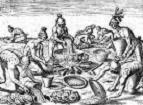




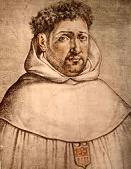

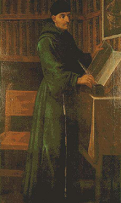




1590 On Feb. 26 the Baltic seaport of Ivangorod is returned to Russia. On Mar. 14 Henri IV of France defeats Charles of Lorraine, duke of Mayenne at the decisive Battle of Ivry, then seiges Paris in Sept., causing a famine, driving some to cannibalism until it is relieved by Mayenne and Duke Alessandro Farnese of Parma. On Mar. 21 after abandoning Tabriz and Georgia, Shah Abbas I of Persia signs a peace treaty with the Ottomans, ending the war begun in 1577, and promising to end all Shiite propaganda in Sunni Ottoman lands and stop persecution of Persian Sunnis, while ceding a large portion of NW Iran incl. E Armenia and Azerbaijan; the Ottomans now rule the Caucasus as far as the Caspian Sea. On Apr. 6 Sir Francis Walsingham (b. 1530) dies, having bankrupted himself in the queen's service with a European network of 50 spies, and Sir Robert Cecil (1563-1612), son of William Cecil, Lord Burghley takes over his secy. of state duties, being called "my pigmy" or "my elf" by the queen because of his deformed back and stunted build; the prejudice against female rulers still PC, he says of her, "Our blessed Queen was more than a man, and in truth, something less than a woman", to which her answer is that, though as a "woman wanting both wit and memory", whom God had made "though a weak woman, yet Thy instrument", she is Henry VIII's daughter, and "I am a lion's cub, and inherit many of his qualities"; meanwhile an ancient prophecy of Merlin the Druid is trotted out to prove she's okay: "Then shall a Royal Virgin reign, which shall stretch her white rod over the Belgic shore and the great Castile smite so sore withal that it shall make him shake and fall" - it's as easy as a phone call? In Apr. Robert Devereux, 2nd earl of Essex secretly marries Sir Francis Walsingham's daughter and heiress Frances Walsingham (1567-1631), widow of Sir Philip Sidney; the queen doesn't find out till autumn, and is pissed-off for two weeks before she forgives him, although she never agrees to receive his wife as his countess. On May 1 James VI and Anne of Denmark land at Leith, and she is crowned queen of Scotland on May 17; she miscarries in the summer, which messes up her tubes? On May 9 after recognizing the royal title of his nephew Henry IV, old fart Charles X (Cardinal Charles de Bourbon) (b. 1523) dies in prison in Fontenay-le-Comte. On Aug. 18 a relief expedition reaches the Roanoke Colony and finds it deserted, with the word "Croatoan" carved on a post, indicating that they had gone to Croatoan Island to the S to live with the friendly Hatteras tribe, which in 1650 migrates to the Lumber River Valley 200 mi. away, becoming the Lumbee Indians of Robeson County, N.C.; at the time, though, nobody can figure out what happened to them, and suspect the worse; Roanoke Island becomes submerged by modern times - see that great episode of the Fess Parker TV series "Daniel Boone"? On Aug. 27 (since 1585) Pope Sixtus V (b. 1521) dies, ending his plan to convert the Roman Colosseum into a wool factory for ex-hos, and on Sept. 15 Rome-born cardinal (since 1583) and Inquisitor-gen. (since 1586) Giambattista Castagna is elected Pope (#228) Urban VII (1521-90), but he dies 12 days later on Sept. 27 before he can be crowned, and on Dec. 5 Niccolo Spondrati (Sfondrati) (Sfondrato) is elected Pope (#229) Gregory XIV (1535-91), plotting to depose Henri IV; relics (organs removed during embalming) of all popes from Sixtus V to Leo XIII (d. 1903) begin to be kept in Rome's St. Vincent and Anastasio Church near the Trevi Fountain. In Aug. heedless of his little 1576-7 Tower stays, English radical Protestant MP Peter Wentworth (1524-96) pub. a tract titled A Pithie Exhortation to Her Majesty for Establishing her Successor to the Crown, suggesting James V of Scotland as the likeliest candidate, which pisses-off the queen, causing him to end up in the Tower again, this time permanently, leaving son Thomas Wentworth (1559-1628), who continues his daddy's program of opposing royal absolutism in Parliament. On Sept. 3 the Battle of Doire Leathan in SW County Donegal, Ulster, Ireland sees a force of Scottish Redshank mercenaries working for Queen Ineen Dubh on behalf of her son "Red" Hugh Roe O'Donnell (1572-1602) (great-great-grandson of Hugh Roe O'Donnell, Tyrconnell king in 1461-1505) (who is imprisoned in Dublin Castle) defeat and kill his elder half-brother Sir Donnell O'Donnell (b. ?), the leading rival to the lordship of Tyrconnell, allowing him to finally succeed in 1592 on his father Sir Hugh O'Donnell's abdication after he marries Rose O'Neill, daughter of Hugh O'Neill, 2nd earl of Tyrone in 1587. On Oct. 16 Italian madrigal composer Carlo Guesualdo da Venosa (1566-1613) brutally murders his wife-cousin Donna Maria d'Avalos and her lover Fabrizio Carafa, duke of Andria after catching them in the act in the Palazzo san Severo in Naples, and leaves their mutilated bodies in front of the palace for public view; he later murders his 2nd son by Maria after suspecting he's Fabrizio's; being a nobleman he is immune to prosecution. In Oct. Spanish forces allied with the French land in Brittany; Drake, Hawkins, and Frobisher return to England from their unsuccessful expedition to the Spanish coast; the war between England and Spain reaches an uneasy stalemate which lasts several years. On Nov. 17 (Accession Day) Essex enters the tiltyard at Whitehall dressed in black in a funeral procession to apologize for his marital misconduct; Elizabeth's champion Sir Henry Lee manages the jousts for the last time, and is replaced next year by George Clifford, 3rd Earl of Cumberland (1558-1605). On Nov. 29 the 1568 Ottoman-Hapsburg Hungarian peace treaty is renewed. Morocco under Al-Mansur begins the conquest and annexation of the Songhai Empire (ends 1591). Akbar the Great of India conquers Orissa. Prince Fakhr al-Din II (1572-1635) of the Ma'nid (Maani) Druze family becomes emir of Lebanon, going on to develop a prof. mercenary army and promote religious tolerance while playing chicken with the sultan. James VI of Scotland reendorses the Nat. Covenant; meanwhile in this decade his Lutheran-raised wife Anne of Denmark converts to Roman Catholicism, adding to the friction between James and the Scottish churchmen, who criticize them for drinking, feasting, and dancing and being lenient to the Roman Catholic nobles of Scotland, esp. after the Spanish Blanks Plot of late 1592, where cipher letters from Catholic earls of N Scotland to the king of Spain are intercepted. Lutheran pastor Johann Arndt (Arnd) (1555-1621) of Badeborn, Anhalt, Germany is deposed for refusing to remove religious pictures from his church and cease using exorcism during baptism, and he goes on to found the Pietism movement, which uses both the Bible and the writings of Christian mystics. The Portuguese explore and name Taiwan ("the beautiful"). Riyadh (Arab. "gardens") in C Arabia is first mentioned by name; its previous name was Hajr. Queen Elizabeth's godson Sir John Harington makes a bawdy trans. of the 28th book of Ariosto's poem "Orlando Furiosi", circulating it among the queen's maids of honor, pissing-off the queen, who calls him a "saucy poet" and commands him to not return to court until he retranslates the whole poem with taste, which takes a year to do. Coal mining begins in the Ruhr Valley. The first paper mill in Scotland is founded in Edinburgh. Venetian alchemist Marco Bragadini (Bragadino) (1545-91) fools the whole republic into believing that he can make gold with quicksilver and a secret powder, promising the senate to deliver 6M ducats worth; after he fails to deliver, he hightails it to Munich to the protection of Duke William the Pious, but new Pope Gregory XIV considers him and his two dogs to be the Devil's spawn and has him executed in Munich on Apr. 26, 1591. In this decade Elizabethan courtier George North (ambassador to Sweden) writes the unpub. ms. A Brief Discourse of Rebellion and Rebels, which in 2018 is discovered to be a source of 11 of William Shakespeare's plays (incl. "King Lear", "Macbeth", "Richard III", and "Henry V") by Dennis McCarthy and June Schlueter. In this decade the full-blown gallery picture emerges in Rome, with painter Michalangelo Merisi da Caravaggio (1573-1620) cranking out scenes of extreme violence and realism that influence painting for decades, becoming the precursor of modernism. In this decade the first short railway lines (made of hardwood) are laid in Nottinghamshire and Shropshire in England to carry 4-wheeled horse-drawn trucks hauling coal from the mines. The Italian Commedia dell' arte company I Accesi is founded. In this decade Belgian-born engraver Theodor de Bry (1528-98) of Frankfurt-am-Main begins pub. books with the first halfway accurate drawings of life in the New World for Euro readers, starting this year with a new illustrated ed. of Thomas Harriot's "Brief and True Report of the New Found Land of Virginia". Ciriegiulo, alias of Italian Florentine agronomist Giovan Vettorio Soderini (1526-96) pub. the first mention of Sangiovese (Lat. "sanguis Jovis" = blood of Jove or Jupiter) grapes from C Italy incl. Romagna, Lazio, Campagnia, and Sicily, which goes on to be mixed into Brunello di Montalcino, Rosso di Montalcino, Carmignano, Chianti, Vino Nobile di Montepulcian, and Morellino di Scansano, Sangiovidi di Romagna, and Tignanello; it was grown since the time of the ancient Etruscans? Sports: In this decade Skittles (in use since the end of the 12th cent.) becomes popular in Germany. Architecture: The red-pink sandstone Govind Dev Ji Temple dedicated to Lord Krishna is built in the Hindu holy city of Brindaban on the Jumna River 80 mi. S of Delhi. Inventions: About this time the first linen Condoms are used in Italy to prevent disease, after which their contraceptive use begins to be recognized - not that everybody didn't want big families to support them in their old age? Science: Flemish physician-botanist Charles de l'Ecluse (l'Écluse) (L'Escluse) (Carolus Clusius) (1526-1609) receives some coffee beans from a friend in Italy, becoming the first coffee beans to cross the Alps - I had another sneeze and blew my nose? German scholastic philosopher (believer in witchcraft) Rudolph (Rudolf) Goclenius (Gockel) (Göckel) (1547-1628) coins the term "psychology"; really coined in the 1530s by Croatian humanist Marko Marulic (1450-1524)? Dutch spectacle-maker Zacharias Janssen (1580-1638) allegedly invents the Compound Microscope, using two double convex lenses in a tube. Nonfiction: Jose de Acosta (1539-1600), Historia Natural y Moral de las Indias. Galileo Galilei (1564-1642), De Motu (On Motion); dumps Aristotle and postulates his law of falling bodies - a century after Columbus and they're still trying to get it right? Gian Paolo Lomazzo, Idea del Tempio della Pittura (The Ideal Temple of Painting); the four temperaments theory: perspective, prattica, aniera, iconography. Francisco Ribera (1537-91), In Sacrum Beati Ioannis Apostoli, & Evangelistiae Apocalypsin Commentarii; Spanish Jesuit priest uses Daniel 9:27 and its week #69 of 70 to interpret the Bible Book of Revelation as predicting a coming Antichrist who will lead the Roman Catholic Church away from the pope into apostasy, reign for 3-1/2 years (1260 days), rebuild the Temple of Jerusalem, deny Christ, claim to be God, and conquer the world; Cardinal Robert Bellarmine adds that he will be a Jew; written to oppose Martin Luther (1483-1546), who has been claiming that the papacy is the Antichrist and that it has already been 1260 years and is already happening, starting an eternal war between the two Antichrist camps; founds the Biblical doctrine of Futurism, which interprets the Book of Rev. and other Bible books as prophesies of coming events right before the Second Coming rather than as past events, foreshadowing Premillennialism and Dispensationalism - when opportunity comes knocking, the whole neighborhood starts walking? Immanuel Tremellius (1510-80) et al., Latin Bible. Music: Emilio de' Cavalieri (1550-1602), Il Satiro (pastoral fable). Claudio Monteverdi (1567-1643), Second Book of Madrigals. Art: Giuseppe Arcimboldo (1527-93), Vertumnus (Portrait of HRE Rudolf II) (1590-1); portrait of HRE Rudolf II using fruits, flowers, and veggies as pixels. Giovanni da Bologna (1524-1608), Mercury. El Greco (1541-1614), St. Jerome; Christ Carrying the Cross. Cornelis Van Haarlem (1562-1638), The Massacre of the Innocents I. Plays: Robert Greene (1558-92), Mourning Garment; Never Too Late (pamphlets). Battista Guarini (1538-1612), Il Pastor fido (pub. pastoral play). Thomas Lodge (1558-1625), Rosalynde, Euphues Golden Legacie; prose pastoral romance; written during a freebooting expedition to the Canary Islands in 1588; basis of Shakespeare's "As You Like It". William Shakespeare (1564-1616), The Taming of the Shrew (1590-3) (comedy); first performed on June 13, 1594 at Newington Butts Theatre; his first play, which shows that he isn't ready to handle scenes with more than four characters; has the smallest cast of any Shakespeare play, and is the first in which the heroine (Julia) dresses as a boy; borrows from Jorge de Montemayor's 1559 romance "Diana Enamorada", and John Lyly's 1589 play "Midas"; not performed until 1762; first of three plays set in Verona (The Taming of the Shrew, Romeo and Juliet); Baptista of Padua has two daughters, the shrew Katherina and the beautiful money daughter Bianca, and holds off marrying Bianca until somebody takes Katherina off his hands; enter Petruchio, who tames her, allowing Lucentio to pay a fortune for the other; "I'll not budge an inch" (1.14); "Such duty as the subject owes the prince/ Even such a woman oweth to her husband" (Katherina) (5.2.156-7); Henry VI, Pt. 2 (1590-1) (history) ("The First part of the Contention betwixt the two famous Houses of Yorke and Lancaster, with the death of the good Duke Humphrey: And the banishment and death of the Duke of Suffolke, and the Tragicall end of the proud Cardinal of Winchester, with the notable Rebellion of Jack Cade: and the Duke of Yorke's first claim unto the Crowne"); Henry VI and his son Prince Edward of Wales (Edward VI), Duke Humphrey of Gloucester, Cardinal Beaufort, bishop of Winchester (great-uncle of Henry VI); Duke Richard Plantagenet of York and his son Duke Richard of Gloucester (Richard III); Edmund Beaufort, 2nd Duke of Somerset; William de la Pole, 1st Duke of Suffolk; Humphrey Stafford, 1st Duke of Buckingham, Thomas Clifford, 8th Baron de Clifford and his son John, Richard Neville, 5th Earl of Salisbury; Richard Neville, 16th Earl of Warwick, Thomas de Scales, 7th Baron Scales; James Fiennes, 1st Baron Saye and Sele; "Open your ears; for which of you will stop/ The vent of hearing when loud Rumor speaks?" (Intro., lines 1-2); "To weep is to make less the depth of grief" (2.1.85); "The game's afoot" (3.1.32); "Smooth runs the water where the brook is deep" (3.1.53); "Small things make base men proud" (4.1.106); "The first thing we do, let's kill all the lawyers" (Dick the Butcher) (4.2.83-4); "Presume not that I am the thing I was" (5.5.57); Henry VI, Pt. 3 (1590-91) (history) (best of the three?); Henry VI, Queen Margaret of Anjou and son Prince Edward of Wales (Edward VI), Louis XI of France, Edmund Beaufort, 4th Duke of Somerset, Henry Holland, 3rd Duke of Exeter, John de Vere, 13th Earl of Oxford, Henry Percy, 3rd Earl of Northumberland, Ralph Neville, 2nd Earl of Westmorland, John Clifford, 9th Baron de Clifford, Duke Richard Plantagenet of York and his son Duke Richard of York (Richard III), Earl Edmund of Rutland, Duke George of Clarence, John Mowbray, 3rd Duke of Norfolk, John Neville, 1st Marquess of Montagu, Richard Neville, 16th Earl of Warwick, William Herbert, 1st Earl of Pembroke, William Hastings, 1st Baron Hastings; "O tiger's heart wrapped in a woman's hide!" (1.4.137); "The battle fares like to the morning's war,/ When dying clouds contend with growing light,/ What time the shepherd, blowing of his nails,/ Can neither call it perfect day nor night." (2.5.1-4); "Peace! Impudent and shameless Warwick, peace;/ Proud setter up and puller down of kings!" (3.3.156); "I'll drown more sailors than the mermaid shall;/ I'll slay more gazers than the basilisk;/ I'll play the orator as well as Nestor,/ Deceive more slily than Ulysses could,/ And, like a Sinon, take another Troy./ I can add colours to the chameleon,/ Change shapes with Proteus for advantages,/ And set the murderous Michiavel to school./ Can I do this, and cannot get a crown?/ Tut, were it farther off, I'll pluck it down." (3.3.187-94); "Hasty marriage seldom proveth well" (4.1.18); "A little fire is quickly trodden out/ Which, being suffered, rivers cannot quench" (Duke of Clarence) (4.8.7); "Why, what is pomp, rule, reign, but earth and dust?/ And, live how we can, yet die we must" (5.2.23-28); "Suspicion always haunts the guilty mind;/ The thief doth fear each bush an officer" (5.6.11-12); "Down, down to hell; and say I sent thee thither" (Gloucester) (5.6.69). Sir Philip Sidney (1554-86), The Countess of Pembroke's Arcadia (posth.); coins the name Pamela for one of its characters. Robert Wilson, Three Lords and Three Ladies of London (morality play). Poetry: Michael Drayton (1563-1631), The Harmony of the Church (debut); pisses off the Archbishop of Canterbury for turning scripture into poetry, causing almost the entire ed. to be burned. George Peele (1556-96), Polyhmnia (verses for a tournament). Edmund Spenser (1552-99), The Faerie Queen (6 vols.) (1590, 1596); long English Arthurian epic poem praising Queen Elizabeth AKA Gloriana, earning him a life pension of £50 a year; pioneers the Spenserian stanza (ababbcbcc); an allegorical work "cloudily enwrapped in allegorical devices" with the aim of "fashioning a gentleman or noble person in virtuous and gentle discipline"; the earliest poetical allusion to tobacco in English lit.; the Redcrosse Knight and his lady Una symbolize holiness, fighting the wizard Archimago, the dragon Errour, the sorceress Duessa, and the giant Orgoglio; Sir Guyon symbolizes temperance, fighting the witch Acrasia; female knight Sir Britomart symbolizes chastity (Elizabeth I), fighting Sir Artegal (who symbolizes justice) and founding the English monarchy with help from wizard Merlin; Sir Cambell and Sir Triamond symbolize friendship; Sir Calidore symbolizes courtesy; coins the term "braggadocio"; Sir Walter Raleigh composes an introductory sonnet, Methought I Saw the Grave Where Laura Lay; "The land which warlike Britons now possess,/ And therein have their mighty empire raised,/ In antique times was savage wilderness,/ Unpeopled, unmanured, unproved, unpraised/... Ne did it then deserve a name to have/ Till that venturous mariner that way,/ Learning his ship from those white rocks to save,/ Which all along the southern seacost lay/... For safety that same his sea-mark made,/ And named it Albion". Births: Danish politician-atty. Dietrich Reinkingk (Theodor Reinking) (d. 1664) on Mar. 10 in Windau, Courland. English "Of Plymouth Planation" Mayflower organizer and Plymouth founder (2nd gov. of Plymouth Colony) William Bradford (d. 1657) in Mar. in Austerfield, Yorkshire (N of Sherwood Forest and near the Great North Road from London to Edinburgh); marries Dorothy May in 1613 in Leiden; has son John Bradford in 1617. Ottoman sultan #14 (1603-17) Ahmed (Ahmad) I (d. 1617) on Apr. 18; son of Mehmed III (1566-1603); brother of Mustafa I (1591-1639); father of Osman II (1604-22) and Murad IV (1612-40). French Baroque Huguenot-turned-atheist-turned-Roman-Catholic poet-dramatist Theophile de Viau (d. 1626) in Clairac (near Agen), Lot-et-Garonne. German gen. Baron Franz von Mercy (d. 1645) in Longwy; of a noble family from Lorraine. Dutch portraitist Daniel Mytens (Mijtens) the Elder (d. 1648) in Delft. Dutch architect-painter Bartholomeus van Bassen (d. 1652). English dramatist Richard Brome (d. 1652); secy. of Ben Jonson. Scottish "There was an ancient sage philosopher, who had read Alexander Ross over" writer Alexander Ross (d. 1654) in Aberdeen; vicar of Carisbrooke in the Isle of Wight (1634-54); chaplain to Charles I. Portuguese merchant (Jewish) Antonio Fernandez Carvajal (d. 1659) in Fundao. Spanish feminist writer Maria de Zayas y Sotomayor (d. 1661). Deaths: Spanish Franciscan friar Bernardino de Sahagun (b. 1499) on Oct. 23 in the Convent of San Francisco, Mexico (grippe); leaves the 12-vol. Gen. History of the Things of New Spain (Codex Florentine), a picture encyclopedia of the Aztec culture, which shows too much respect for the cannibalistic pagans, causing Philip II to prohibit its pub. (it takes 240 years to be pub.); although acknowledging that Satan controlled them, de Sahagun claims that the Aztecs showed "more signs of virtue and Christianity than are found in many in our own nation." Italian goldsmith-sculptor Leone Leoni (b. 1509). English Chief Gentlewoman of the Privy Chamber Blanche Parry (b. 1509); served Queen Elizabeth I since birth. French surgeon Ambroise Pare (b. 1510) on Dec. 20. Italian composer Gioseffo Zarlino (b. 1517). Italian painter Bernardino Campi (b. 1522). Dutch writer Dirk Volkertszoon Coornhert (b. 1522). French jurist Jacques de Cujas (b. 1522) on Oct. 4. French king (1589-90) Charles X (b. 1523) on May 9 in Fontenay-le-Cornte Castle (imprisoned). English statesman (Elizabeth I's secy. of state) Sir Francis Walsingham (b. 1530) on Apr. 6. French sculptor Germain Pilon (b. 1535). French Pont Neuf architect Jean Baptiste Androuet du Cerceau (b. 1544). French poet Guillaume de Salluste Du Bartas (b. 1544) in July in Mauvezin. French playwright Robert Ganier (b. 1545). German awriter Johann Fischart (b. 1547). English earl Ambrose Dudley, earl of Warwick; brother of Robert Dudley.


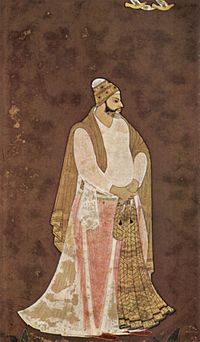







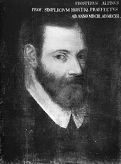
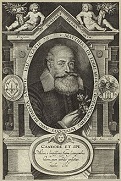
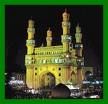


1591 On Mar. 1 Pope Gregory XIV writes to the Council of Paris, renewing Henri IV's excommunication, supporting Philip II of Spain and the French League, calling on the French to renounce him, and sending papal troops to France to depose him; Gregory dies on Oct. 16, his election being declared illegal, and on Oct. 29 Giovanni Antonio Facchinetti (Achinetti) is elected Pope (#230) Innocent IX (1519-91) on Oct 29, but he dies on Dec. 30. On Mar. 13 the Battle of Tondibi is a V for 1.5K Moroccan cavalry and 2.5K arquebusiers under Islamicized Spaniard Judar Pasha (-1606) over 40K bow-arrow-lance soldiers of the Sonhai Empire (begun 1464) under ruler (since 1588) Askia Ishaq II, becoming the first use of muskets in war in sub-Saharan Africa; after the capital of Gao is looted along with the trading centers of Timbuktu and Djenne, the Songhai Empire, the last great Sudanese empire becomes kaput. On Apr. 10 English adventurer Sir James Lancaster (1554-1618) leaves Plymouth on his first voyage to the East Indies with three ships, becoming the first English sea expedition to India; on Aug. 1 they reach Table Bay, then lose one ship on Sept. 12 off Cape Corientes - where is Krishna when you really need him? In July Elizabeth "Bess" Throckmorton (1565-1647), daughter of late diplomat Sir Nicholas Throckmorton (1515-71) and the oldest of Elizabeth I's maids of honor conceives a love child by Sir Walter Raleigh (1552-1618), and forces him to marry her in secret in the fall, while concealing her pregnancy from the queen. In Aug. Elizabeth I admits Robert Cecil to the Privy Council after spending 10 days in May with the Burghley family in Theobalds and knighting him, but ignores hints to appoint him official secy. of state? In Aug. Elizabeth I goes on a summer progress to Farnham, Petworth, Chichester, Titchfield, Portsmouth, and Southampton, returning via Basing, Odiham, and Elvetham (in Hampshire), where the Earl of Hertford stages a water pageant. In Aug. Elizabeth I, after entreaties by Henri IV sends her beau Essex with 4K men to Normandy, and he meets Henry IV in Compiegne, then lets Henry reduce Noyon while he sieges Rouen unenergetically, preferring to hold parties, parades, and hawking in enemy territory, which causes the queen's council to rebuke him, and the queen to order him to return, which he does after knighting 24 of his supporters against her wishes, which pisses her off, commenting, "His Lordship had done well to build his almshouses before he made his knights"; after he smooths things over, in a few days he returns to Rouen to join his troops, and takes Gournay, but 3K of his men die of illness or desert, and his brother is killed, and he is ordered to resign and return home again, embittered by the belief that Burghley and Cecil had poisoned the queen's mind against him. In Aug. Sir Thomas Cavendish (b. 1560) begins his 2nd expedition, accompanied by navigator John Davis, crossing the Strait of Magellan and returning to Brazil, where a battle with the Portuguese at Vitoria kills most of the crew, after which he sets off towards Saint Helena but dies off Ascension Island after writing a letter accusing Davis of being a "villain" who caused "the decay of the whole action"; the crew goes on to discover the Falkland Islands next Aug. before returning sans most of the crew. In Nov. Elizabeth I visits Sir Christopher Hatton during his sickness, feeding him "cordial broths with her own hands"; he dies soon after of kidney failure, owing her £56K, which causes her to get depressed as it is rumored that she killed him by demanding repayment; actually, she is down from facing her own mortality, scolding Lord North for calling a raised pie in a covered dish a "coffin"? On Sept. 10 vice-adm. Sir Richard Grenville (b. 1542) dies after a battle off Flores in the Azores in which his ship Revenge holds out for 12 hours against the Spanish fleet; a cyclone later sinks his ship along with 16 Spanish ships. On Sept. 25 Christian I (b. 1560) dies, and his eldest son Christian II (1583-1611) becomes elector of Saxony (until 1611); too bad, he's a boy, and this allows the many Lutheran enemies of Calvinist councillor (since 1586) Nikolaus Krell to get him thrown out of office and imprisoned, then finally tried and executed in 1601 before he attains the age of majority. Ivan IV's son Dmitri is assassinated by orders of Boris Godunov, spawning four pretenders (false Dmitris). Qutb Shahi sultan #5 (1580-1611) Muhammad Quli Qutb Shah (1565-1612) establishes the city of Hyderabad (originally Baghnagar = city of gardens) on the S bank of the Musi River in SC India (modern-day pop. 6.8M/7.7M) to extend the fortified capital of Golconda, named after Quli Qutb's dancing girl babe Bhagmati, who converted to Islam under the name Hyder Mahal; it is laid out in a grid plan; it goes on to become known as "the City of Pearls" as well as a diamond trading center; in 1687 it is annexed by the Mughals. Angel shark sword hilts makes me your man? Toyotomi Hideyoshi (1536-98) issues the Edict on Changing Status, forbidding samurai from farming, and farmers from owning weapons; his infant son Tsurumatsu dies in Nov., leaving him without an heir. Witch-Hunt Hysteria grips Scotland, and five witches, incl. Agnes Sampsoune and Gellie Duncan are burned, followed by 17 more in 1597, and ultimately 17K before they run out of poop. Edmund Spenser (1552-99) becomes the first unofficial poet laureate of England. (St.) Aloysius Gonzaga (1568-91), who renounced his right to the marquisate of Castiglione, Italy in 1585 and became a Jesuit devotes himself to caring for plague victims in Rome, and catches it himself and dies, becoming a saint in 1726, the patron saint of young Roman Catholic students - low-rise jeans aren't ruling the world? Sir Martin Frobisher marries for a 2nd time and settles in Yorkshire, but soon tires of country life. Peter Paul Rubens (b. 1577) of Westphalia begins his apprenticeship; next year he studies under Adam van Noort in Amsterdam, followed by Otto van Veen in 1596. A law is passed closing London theaters on Thursdays so that bull and bear baiting can be attended and bets taken. Architecture: Char Minar (Four Minarets) is constructed at the center of the new city of Hyderabad, India, with two roads intersecting and passing through its archways. The Rialto Bridge over the Grand Canal in Venice is finished (begun 1587). Science: Italian scientist Galileo Galilei (1564-1642) drops a 1 lb. and a 100 lb. weight from the Leaning Tower of Pisa simultaneously to prove a point in physics about bodies falling at the same speed regardless of mass, refuting the know-it-all Aristotelians. Thomas Harriot discovers that snowflakes are 6-sided (hexagonal). Nonfiction: Prospero Alpini (1553-1617), De Medicina Egyptiorum (Venice); the first account of the coffee plant pub. in Europe, describing a coffee tree he saw in the garden of the capt. of the Janissaries in Constantinople; follows next year with De Plantis Aegypti liber, introducing several new plant species to Europe, incl Abrus, Abelmoschus, Lablab, Melochia, Baobab, and Sesban. Giordano Bruno (1548-1600), De Imaginum, Signorum, Et Idearum Compositione (On the Composition of Signs, Images and Ideas) (Frankfurt); De Triplici Minimo et Mensura; De Monade Numero et Figura; De Innumerabilibus, Immenso et Infigurabili. John Calvin (1509-64) (tr.), The Geneva Bible; pub. by Cambridge U. Press with marginal notes that make it the most popular English trans. for the next cent.; James I of England is so enraged by the notes to Exodus 1:19 that he later orders his own noteless King James Version to be developed. Tommaso Campanella (1568-1639), Philosophia Sensibus Demonstrata (Philosophy Demonstrated by the Senses); his first work. Giles Fletcher the Elder (1548-1611), Of the Russe Common Wealth, Or, Maner of Gouernement of the Russe Emperour (Commonly Called the Emperour of Moskouia), with the Manners, and Fashions of the People of That Countrey. John Florio (1553-1625), Second Fruits, to be Gathered of Twelve Trees, of Divers but Delightsome Tastest to the Tongues of Italian and English Men; Garden of Recreation, Yielding Six Thousand Italian Proverbs. Matthias de Lobel (1538-1616), Icones stirpium, seu, Plantarum tam exoticarum, quam indigenarum :in gratiam rei herbariae studiosorum in duas partes digestae : cum septem linguarum indicibus, ad diuersarum nationum vsum (Images of plants, both exotic and native, for students of botany, arranged in two parts: with indices in seven languages for the use of different nationalities); the first attempt to classifly plants according to their natural affinities rather than medical uses. Franciscus Patricius (1529-97), Nova de Universis Philosophia (New Philosophy of Ideas) (Basel); goes back to the Ionians and Presocratics to portray God as "First Light", which is later adopted by Galileo to mathematize physics. Francois Viete (Franciscus Vieta) (1540-1603), In Artem Analyticem (Analyticam) Isagoge; first book to use letters for algebraic quantities (consonants for constants, vowels for variables); invents Analytical Trigonometry. Art: Giuseppe Arcimboldo (1527-93), Flora. El Greco (1541-1614), Coronation of the Virgin. Cornelis Van Haarlem (1562-1638), The Massacre of the Innocents II; more people, more action? Plays: Anon., The Troublesome Raigne of King John of England; used by William Shakespeare for his play "King John"; "Let England live but true within it selfe,/ And all the world can never wrong her State./ If Englands Peeres and people joyne in one,/ Nor Pope, nor Fraunce, nor Spaine can doo them wrong." Robert Green (1558-92), Philomela the Lady Fitz-waters Nightingale (romance). John Lyly (1553-1606), Endymion, the Man in the Moon (allegorical comedy). Christopher Marlowe (1564-93), Edward II - takes one to know one? Sir Philip Sidney (1554-86), Astrophel and Stella (posth.); 108 sonnets and 11 songs; inspired by Penelope Devereux, daughter of Lord Essex. William Shakespeare (1564-1616), Henry VI Pt. 1; his weakest play?; Titus Andronicus (1591-2) (tragedy) (Titus has 687 lines, 14th most); Roman Gen. Titus Andronicus vs. Gothic Queen Tamora; Titus' sons Lucius, Quintus, Martius, and Mutius; Tamora's sons Demetrius, Chiron, and Alarbus; Tamora's lover Aaron the Moor. Poetry: Edmund Spenser (1552-99), Complaints. Births: English gen. Robert Devereux, 3rd Earl of Essex (d. 1646) on Jan. 11 in London; son of Robert Devereux, 2nd Earl of Essex (1565-1601). Spanish Tenebrist painter Jusepe (Giuseppe) (Jose) de Ribera (Lo Spagnoletto) (Sp. "The Little Spaniard") (d. 1652) on Jan. 12 in Jatiba (near Valencia); pupil of Michelangelo da Caravaggio (1571-1610). French mathematician Girard Desargues (d. 1661) on Feb. 21. German Jesuit poet Friedrich von Spee (Spee von Langenfeld) (d. 1635) on Feb. 25 in Kaiserswerth. Am. New England settler Thomas Cornell Sr. (d. 1655) (b. 1592?) on Mar. 24 in Saffron Walden, Essex, England; emigrates to Boston in 1638; ancestor of Ezra Cornell, William Ellery, Ezekiel Cornell, Lizzie Borden, Elizabeth Monroe, Frances Folsom Cleveland, Amelia Earhart, John Kerry, Bill Gates, Jimmy Carter, and Richard Nixon. Am. religious leader (Rhode Island founder) Anne Hutchinson (nee Marbury) (d. 1643) on July 20 in Alford, England. French nun (St.) Louise de Marillac (Le Gras) (d. 1660) on Aug. 12 in Le Meux, Oise. English #1 ("gather ye rosebuds while you may") Cavalier poet (vicar of Dean Prior in Devonshire) Robert Herrick (d. 1674) on Aug. 24 in Cheapside, London; educated at Westminster School, and St. John's College, Cambridge U.; his portrait bears a striking resemblance to Beatle Ringo Starr (1940-)? Ottoman sultan #15 (1617-18, 1622-3) "Mad" Mustafa I (d. 1639) in Manisa Palace, Constantinople; younger brother of Ahmed I (1590-1617). German Roman Catholic missionary-astronomer Johann Adam Schall von Bell (d. 1666). Italian Baroque painter Guercino (Giovanni Francesco Barbieri) (d. 1666). English royalist Thomas Wentworth, Earl of Cleveland (d. 1667); not to be confused with his relative Thomas Wentworth, 1st earl of Stafford (1593-1641). Deaths: Italian lutenist and musical theorist Vincenzo Galilei (b. 1520) on July 2; father of Galileo Galilei. Spanish gov. of Puerto Rico (1579) Juan Ponce de Leon II (b. 1524) in San Juan, Puerto Rico. Spanish mystic poet Luis de Leon (b. 1527). Italian painter Vincenzo Campi (b. 1536). Spanish Jesuit scholar Francisco Ribera (b. 1537). Swiss engraver Jost Amman (b. 1539). English lord chancellor Sir Christopher Hatton (b. 1540) on Nov. 20 in London. Spanish mystic priest St. John of the Cross (Juan de la Cruz) (b. 1542) on Dec. 14 in Ubeda, Andalusia; leaves Ascent of Mount Carmel, Dark Night of the Soul, and A Spiritual Canticle of the Soul; canonized 1726. English vice-adm. Sir Richard Grenville (b. 1542) on Sept. 10 off Flores, Azores (KIA); Alfred, Lord Tennyson commemorates him in the poem The Revenge. German elector of Saxony (1586-91) Christian I (b. 1560) on Sept. 25 in Dresden. Spanish Jesuit priest Aloysius Gonzaga (b. 1568).










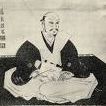


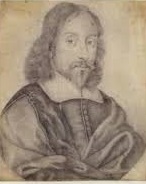
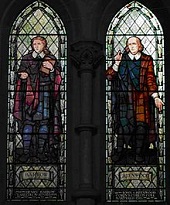

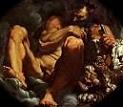
1592 A cent. after Columbus, smallpox and other Euro diseases have wiped out 90% of the aboriginal pop. of the New World; the pop. of Mexico has dropped from 30M to 3M, Peru from 8M to 1M? The pope who burns Bruno ain't so clement after all? On Jan. 30 Ippolito Aldobrandini is elected Pope (#231) Clement VIII (1536-1605), and the papacy settles down for a good decade of Texas BBQing as this deeply pious dude pushes the Tridentine measures for the reform of the clergy, builds up Rome's charitable institutions, and appoints Florence-born (St.) Philip Neri (1515-95) (founder of the Congregation of the Oratory) as cardinal, along with church historian Caesar Baronius (Cesare Baronio) (1538-1607); too bad, on May 22 after having made the mistake of returning to Italy (which he left in 1576 as they were about to prosecute him for heresy, spending most of his time in Paris and London, then ending up at the Frankfurt Book Fair in Germany last year, where Venetian patrician Giovanni Mocenigo talked him into it in hopes of becoming prof. of math. at the U. of Padua, which job is given to Galileo Galilei instead, after which Mocenigo gets into an argument with him and turns him into the Inquisition), Italian philosopher Giordano Bruno (1548-1600) is arrested by the Vatican for his scientific beliefs in the existence of multiple worlds, his belief in the transmigration of the human soul into animals, along with his heretical denial of the Trinity, the virginity of Mary et al., and after arriving in Rome next Feb. he spends seven years imprisoned in the Tower of Nona while defending himself from inquisitor Cardinal Robert Bellarmine (1542-1621), who keeps throwing mud at him until it sticks - the first Trekkie? In Jan. Essex returns to England from France, and loses an appointment to the chancellorship of Oxford U. to Cecil's man Lord Buckhurst, causing him to aim instead for high political office with the help of Sir Francis Bacon and his brother Anthony Bacon, agent of Sir Francis Walsingham and friend of Protestant French king Henri IV. In Jan. Toyotomi Hideyoshi (1537-98) adopts his nephew Hidetsugu, then retires as regent (tampaku) on Feb. 11, assuming the title of taiko (retired regent); on May 7 the naval Battle of Okpo sees 24 Korean panokson (roofed) ships plus 30 support ships under adm. Ri Sun Shin (Yi Sun-sin) (1545-98) surprise 50 Japanese ships anchored in Okpo Harbor while its troops loot the city, and force a surrender, then on May 8 do ditto at Chokjinpo Harbor; on May 29 (15?) the naval Battle of Sacheon sees adm. Ri Sun Shi first use his technological breakthrough turtle ship (kobukson) (a ramming ship with iron plating or spikes on the deck, which he designed and has constructed on Chon Do Island), attacking 70 Japanese ships in Sacheon with 25 regular ships plus his new secret veapon ship; a Japanese bullet punctures the skin of Ri's left arm in one of the big history what-ifs?; on May 23 the Japanese invade Busan (Pusan) in SE Korea with 7K men under Christian daimyo Konishi Yukinaga (1555-1600) with the aim of conquering the Asian mainland, and the cover story of obtaining safe passage to China, starting the Imjin (Seven-Year) War (ends Dec. 24, 1598); the initial force is mistaken by the Koreans for a trading mission, and has a cake walk, killing 8.5K-30K, then taking Dongnae on May 25 after killing another 3K; eventually 200K men under Kato Kiyomasa (1561-1611) et al. arrive, with the Japanese troops being armed with Euro arquebuses, while the Koreans only have archers; Confucian scholar Ryu Seong-ryong (1542-1607) (you sung wrong?) is appointed Korean PM, in charge of the military, and becomes a big backer of adm. Ri Sun Shin, who on July 8 uses turtle ships to thwart the invasion at the naval Battle of Hansan Island, capturing 47 Japanese ships and destroying 12, and capturing 8K POWs, after which the Korean navy scores continual Vs to undermine Japanese successes on land, with Ri winning all 22 of his naval battles; on Sept. 1 the naval Battle of Busan sees Ri's 60 turtle ships defeat 470 Japanese ships using long-range cannon, while losing only six dead and 25 injured, after which Ri stops the battle to leave the Japanese with some ships to evacuate Korea with; the Japanese introduce tobacco smoking to Korea during their invasion - good for lockjaw? In Feb. the English expedition of Sir James Lancaster retrofits in Zanzibar, then rounds Cape Comorin in mid-May, and reaches the Malay Peninsula in June, capturing every ship they encounter. On Apr. 16 Rouen, France is captured after a mini-siege by Duke Alessandro Farnese of Parma, who is wounded in the hand, which, combined with failing health causes him to put his son Ranuccio I Farnese (1569-1622) in charge of his troops, after which he returns to Flanders, gets removed as gov. of the Spanish Netherlands by a jealous Spanish court, and dies in Arras on Dec. 3, leaving his son the dukedom of Parma and Pacienza. On May 31 Sir Walter Raleigh's "brutish offense" of impregnating Bess Throckmorton (who gave birth to a son in Mar.) is found out by the queen, who becomes "most fiercely incensed"; meanwhile he is out in Panama fighting the Spanish, but is "speedily sent for and brought back" to face charges of seducing a noble virgin committed to the queen's care, and marrying without royal consent; in June Raleigh and Bess are sent to the Tower (separate apts.); on July 1 he attempts suicide after being refused permission by the Tower Lt. Sir George Carew to row out on the Thames and see Elizabeth I off on her summer progress; he is released in Aug. after a Spanish treasure ship carrying £800K worth of jewels is brought into Dartmouth and the crowd won't let the queen's rep. the Earl of Cumberland claim her share, and she lets him do it?; he gives her the loot, and is banned from court, and made to live "like a fish cast on dry land" for five years at Sherbourne Castle in Devon (given to him by the queen in Jan. 1591), joined by his wife Bess in Dec., whose child dies anyway, but they are too proud to beg pardon of queeny. In the summer Elizabeth I goes on progress again in order to escape the plague in London (15K die), travelling west to Sudeley Castle in Gloucestershire, then to Bath, where she visits Sir John Harington, and he presents her with a fancy bound copy of his new translation of "Orlando Furioso", and she forgives him for his earlier smut; in Sept. she visits Oxford, then winds up in Roycote to stay with her old friends Lord and Lady Norris. In Aug. English Capt. John Davis (Davys) (1543-1605) discovers the Davis, er, Falkland (Malvinas) Islands, which are populated and claimed by Argentinians in the 1820s - the longer after Columbus, the smaller they get? On Nov. 17 king (since Sept. 30, 1568) Johan III Vasa (b. 1537) dies, and Jesuit-educated Counter-Reformation Polish-Lithuanian king (1587-1632) Sigismund III Vasa (Zygmunt III Waza) (1566-1632) of Poland becomes king of Sweden (until July 24, 1559), going on to desperately try to unite the two countries under Roman Catholicism; HRE Rudolf II makes peace with Poland. - no matter how many have to die? Akbar the Great takes Sind. The Portuguese settle at Mombasa, Kenya on the E coast of Africa, and recognize the sultan of the coastal town of Malindi, who just captured it and moved there, moving their main base to Mombasa, after which Malindi goes feral. The Mac Dynasty in Vietnam is ended, with the Trinh and Nguyen families installing puppet Le Dynasty kings. Juan de Fuca (-1601) (a Greek sailing under the Spanish flag) discovers the Juan de Fuca Strait on the W coast of North Am. separating Vancouver Island from the Olympic Peninsula, along with British Columbia. Sir Martin Frobisher commands a fleet outfitted by Sir Walter Raleigh to harry Spanish merchant ships bringing gold from Panama. Shah Abbas I transfers the Persian Safawid capital from Ghazvin (Qazvin) (Casbin) (100 mi. NW of Tehran) to Isfahan (Ispahan) (Sepahan) (Esfahan) (Hispahan) in C Iran, turning into one of the most beautiful cities in the world. The English Parliament passes the Religion Act of 1592, providing "for the punishment of persons obstinately refusing to come to [an Anglican] church", giving them 3 mo. to comply or be exiled from England forever; it is targeted at the Congregationalist Church (originally known as Separatists, Independents, or Brownists), founded after a "Theory of Union" pub. in 1582 by Robert Browne (1550-1633), and led by Henry Barrow (Barrowe) (1550-93) and Separatist leader John Greenwood (-1593), who are later hanged at Tyburn after Browne chickens out and becomes an Anglican priest to save his hide; the basic principle is that each congregation is indendent and autonomous, and in particular isn't headed by a *!?*! monarch; the 1620 Mayflower passengers are Brownists, causing the Pilgrims to be originally known as the Brownist Emigrants; in 1661 John Bunyan is convicted of violating it. The Spanish galleon San Clemente brings 50kg of tobacco seed to the Philippines. The ruins of Pompeii are discovered by Roman papal architect Domenico Fontana, who is dismissed by Pope Clement VIII for suspected embezzlement of public funds, causing him to work for the viceroy of the Kingdom of the Two Sicilies. Hans von Aachen (1552-1615) of Cologne becomes official court painter of HRE Rudolph II. Trinity College (College of the Holy and Undivided Trinity) in Dublin, Ireland is founded by Elizabeth I for Anglicans only, with the intention of building a univ. around it, which never happens, causing it to also be known as the U. of Dublin; in 1793 Roman Catholics and Dissenters are admitted, but under restrictions that aren't lifted until 1873; in 1871-1970 the Roman Catholic Church prohibits members from attending without permission; women are admitted in Jan. 1904. William Shakespeare begins his Lyrical Age (1592-6); he is mentioned as an actor for the first time by Robert Greene (1558-92), who calls him an "upstart crow, beautified with our feathers". Inventions: Korean adm. Ri Sun Shi invents the iron-clad turtle war ship (kobukson), a ramming ship with iron plating or spikes on the deck. Galileo Galilei invents the thermoscope, the first primitive gas (air-based) thermometer. Science: Korean astronomers record a nova in the constellation Cetus, which is visible for 15 mo. David Fabricius discovers Mira, the first known variable star. Nonfiction: Sethus Calvisius (1556-1615), Melodiae Condendae Ratio (Erfurt). Robert Greene (1558-92), A Quip for an Upstart Courtier; Greene's Groates-Worth of Wit Bought with a Million of Repentence (posth.); an autobio., ed. by dramatist Henry Chettle (1560-1607), containing an alleged swipe on new kid on the block William Shakespeare, alluding to the line "O tiger's heart wrapped in a woman's hide" in "Henry VI, Part 3", with the soundbyte: "...for there is an upstart Crow, beautified with our feathers, that with his Tygers hart wrapt in a Players hyde, supposes he is as well able to bombast out a blanke verse as the best of you: and being an absolute Johannes fac totum, is in his owne conceit the onely Shake-scene in a countrey". Galileo Galilei (1564-1642), Della Scienza Mechanica (On Mechanical Knowledge). Philip Henslowe (1550-1616), Diary (1592-1603). Johannes Kepler (1571-1630), De Admirabili Proportione Coelestium Orbium (Mysterium Cosmographicum); claims that the spaces between the planetary orbits from Saturn to Mercury correspond to each of the five Platonic bodies (regular solids): cube, tetrahedron, octahedron, dodecahedron, icosahedron; impresses Tycho Brahe (1546-1601), causing him to invite him to become his assistant; meanwhile he goes on to dump this theory for elliptical orbits. Giovanni Antonio Magini (1555-1617), De Planis Triangulis; describes the use of quadrants in surveying and astronomy; Tabula Tetragonica. Juan de Mariana (1536-1624), Historiae de Rebus Hispaniae (20 vols) (Toledo); the history of the Iberian Peninsula since 1243, becoming a std. work; 10 more vols. pub. in 1605; it incl. De Rege et Regis Institutione (3 vols.) (1598), written at the request of Philip II and dedicated to his son Philip III, concluding that it is lawful for an individual or group to overthrow and kill a monarch who is a tyrant, the definition incl. violating the laws of religion, imposing taxes without consent, or preventing a dem. parliament from meeting, which makes it easier to point the finger at all Jesuits after the 1610 assassination of Henri IV of France?; some of his vols. get him imprisoned by the Inquisition, during which time they find another of his writings criticising the Jesuits themselves, later used by Charles III to ban them all from Spain. Thomas Sanchez, De Sacramento Matrimonii. Lodovico Zacconi (1555-1627), Prattica di Musica (Venice). Music: Claudio Monteverdi (1567-1643), Third Book of Madrigals. Lodovico Zacconi (1555-1627), Prattica di Musica. Art: Agostino Carracci (1557-1602), Pluto. Marcus Gheeraerts the Younger (1561-1636), Raleigh's Disgrace; shows the queen in the background with her back turned to him; Ditchley Queen Elizabeth I; commissioned by her former champion (1559-90) Sir Henry Lee of Ditchley (1533-1611), who lavishly feted her at in Ditchley near Oxford and shows her standing on a map of England with her feet on Oxfordshire. Freiherr Augustin von Moersperg, The Pied Piper of Hamelin; earliest known picture of the famous rat killer. Tintoretto (1518-94), The Last Supper (1592-4). Plays: John Lyly (1553-1606), Gallathea; Midas. Christopher Marlowe (1564-93), The Jew of Malta (The Famous Tragedy of the Rich Jew of Malta) (blank verse tragedy); written in 1589-90; based on Machiavelli; he gets a barbarous revenge against the city authorities; puts him on the top of the heap alongside Shakespeare? Thomas Nashe (1567-1601), Pierce Pennilesse His Supplication to the Devil (satire); Summers Last Will and Testament (fall); "Adieu, farewell earths blisse,/ This world uncertain is/ Fond are life lustful joyes,/ Death proves them all but toyes,/ None from his darts can flye;/ I am sick, I must dye:/ Lord, have mercy on us." William Shakespeare (1564-1616), Richard III (history) (Richard III has 1,124 lines, 3rd most); Edward IV of England (who usurped the throne from Henry VI), his brother George, Duke of Clarence, his other brother Richard, Duke of Gloucester (Richard III), his wife Elizabeth, Richard's ally the Duke of Buckingham, Lady Anne (widow of Edward, prince of Wales) (later Richard's wife), Henry VI's widow Margaret, the Earl of Richmond (Henry VII); "Now is the winter of our discontent/ Made glorious summer by this sun of York" (1.1.1); "No beast so fierce but knows some touch of pity" (1.2.71); "Talkers are no good doers" (1.3.351); "Things sweet to taste prove in digestion sour" (1.3); "For God's sake, let us sit upon the ground/ And tell sad stories of the death of kings"; (3.2); "Not all the water in the rough rude sea/ Can wash the balm from an anointed King" (3.2); "Discharge my followers; let them hence away,/ From Richard's night to Bolingbrooke's fair day" (3.2); "A horse! a horse! my kingdom for a horse!" (5.4.7); "Keep time! How sour sweet music is when time is broke and no proportion kept!/ So it is in the music of men's lives./ I wasted time, and now doth time waste me;/ For now hath time made me his numb'ring clock;/ My thoughts are minutes, and with sighs they jar/ Their watches on unto mine eyes, the outward watch,/ Whereto my finger, like a dial's point,/ Is pointing still, in cleansing them from tears”; (5.5.42-54); "No matter where; of comfort no man speak:/ Let's talk of graves, of worms, and epitaphs;/ Make dust our paper and with rainy eyes/ Write sorrow on the bosom of the earth"; "For sorrow ends not, when it seemeth done"; "No deeper wrinkles yet?/ Hath sorrow struck/ So many blows upon this face of mine/ And made no deeper wounds?'; "I hate the murderer, love him murdered"; "More are men's ends mark'd than their lives before:/ The setting sun, and music at the close,/ As the last taste of sweets, is sweetest last,/ Writ in remembrance more than things long past"; "Mine honor is my life; both grow in one./ Take honor from me, and my life is done"; "O that I were a mockery king of snow/ Standing before the sun of Bolingbroke/ To melt myself away in water drops!'; "Woe, destruction, ruin, and decay; the worst is death and death will have his day"; "This royal throne of kings, this sceptered isle/ This earth of majesty, this seat of Mars./ This other Eden, demi-paradise./ This fortress built by Nature for herself/ Against infection in the hand of war,/ This happy breed of men, this little world,/ This precious stone in the silver sea,/ Which serves it in the office of a wall/ Or as a moat defensive to a house,/ Against the envy of less happier lands, - / This blessed plot, this earth, this realm, this England." William Shakespeare (1564-1616) and Thomas Kyd (1558-94), Edward III; which is filled with gibes against Scotland and its people; pub. anon. in 1596; not included in the First Folio, which was pub. during the reign of Scottish king James I. Poetry: Nicholas Breton (1545-1626), The Pilgrimage to Paradise. Samuel Daniel (1562-1619), The Complaynt of Rosamond (soliloquy) (debut); Sonnets to Delia; written in Italy for his babe who lives on the banks of the Avon River. Christopher Marlowe (1564-93), Hero and Leander - night and day you are the one? William Shakespeare (1564-1616), Venus and Adonis; dedicated to his handsome bi patron Henry Wriothesley, 3rd Earl of Southampton (1573-1624); recorded in the Stationers' Register on Apr. 18, 1593; "Bid me discourse, I will enchant thine ear" (line 145); "Graze on my lips, and if those hills be dry,/ Stray lower, where the pleasant fountains lie" (lines 238-9); "Her lips are conquerors, his lips obey" (line 548); "The text is old, the orator too green" (line 806). Births: Indian Mughal emperor #5 (1628-58) (Muslim) (builder of the Taj Mahal) Shah Jahan (Jehan) (Pers. "King of the World") (d. 1666) on Jan. 5 in Umerkot, Sind; son of Jahangir (1569-1627); grandson of Akbar the Great (1542-1605); father of Aurangzeb (1618-1707). Czech Moravian educational reformer ("Father of Modern Education") ("Teacher of Nations") Johann (John) (Jan) Amos Comenius (Komensky) (d. 1670) on Mar. 28 in Komna; champion of universal education; first to teach classical languages by using parallel passages from modern languages. English courtier (lover of James I?) George Villiers, 1st Duke of Buckingham (d. 1628) (pr. like Villers) on Aug. 28 in Brooksby, Leicestershire; father of George Villiers, 2nd duke of Buckingham (1628-87); created duke in 1623. Italian Roman Catholic archbishop Giovanni Battista Rinuccini (d. 1653) on Sept. 15 in Rome; educated at the U. of Bologna, and U. of Perugia. Swedish field marshal Count Gustav Horn, Count of Pori (d. 1657) on Oct. 22 in Orbyhus Castle, Uppland. English polymath playwright royalist soldier William Cavendish, 1st Duke of Newcastle-upon-Tyne (d. 1676) on Dec. 6 in Handsworth, Yorkshire; created duke in 1665; student of Thomas Hobbes; husband (1645-) of Mary Cavendish, duchess of Newcastle-upon-Tyne (1623-73). English politician (friend of the Prince of Wales) John Harington, 2nd Baron Harington of Exton (d. 1614). British Am. colonist ("the first Yankee") David Thomson (d. 1628) in Corstorphine, Scotland; first English settler of N.H.; namesake of Thompson Island in Boston Harbor. English boat-rocking political leader Sir John Eliot (d. 1632) on Apr. 11 in Cuddenbeak, Port Eliot, Cornwall; educated at Exeter College, Oxford U.; knighted in 1618. French explorer Etienne Brule (Brulé) (d. 1633) in Champigny (near Paris); first Euro to explore beyond the St. Lawrence River into Canada. French Baroque "Les Grandes Miseres" etcher-printmaker Jacques Callot (d. 1635) in Nancy, Lorraine; the photojournalist of the 17th cent.? Chinese Qin emperor #2 (1626-43) Abahai (Hong or Huang Taiji) (d. 1643); 2nd son of Nurhachi (1559-1626). English super-popular religious poet Francis Quarles (d. 1644) in May near Romford. French atomist philosopher-priest Pierre Gassendi (d. 1655). English poet and bishop of Chichester Henry King (d. 1669) in Worminghall, Buckinghamshire in Jan.; brother of John King. educated at Christ Church, Oxford U. Am. Harvard College pres. (1654-72) Charles Chauncy (d. 1672) in Yardleybury, Hertfordshire, England; educated at Cambridge U.; emigrates to the Plymouth, Mass. in 1638. Dutch dir.-gen. #7 (last) of New Netherland (1647-64) Peter (Pieter) Stuyvesant (d. 1672) (1602?) (1612?) in Peperga, S Friesland. Am. fisherman (founder of Salem, Mass. in 1626) Roger Conant (d. 1679) in Devonshire, England; emigrates to Mass. in 1623. Deaths: Fleming ambassador Ogier Ghiselin de Busbecq (d. 1520) on Oct. 28 in St. Germain; leaves The Turkish Letters (pub. 1744 in London). French marshal Armand de Gontaut, baron de Biron (b. 1524) on July 26 in Epernay (KIA). French essayist Michel de Montaigne (b. 1533) on Sept. 13 in Bordeaux: "Nothing is so firmly believed as that which we least know"; "The thing I fear most is fear"; "Things are not bad in themselves, but our cowardice makes them so"; "I speak the truth, not so much as I would, but as much as I dare; and I dare a little more, as I grow older"; "All the opinions in the world point out that pleasure is our aim"; "Live as long as you please, you will strike nothing off the time you will have to spend dead"; "Whatever can be done another day can be done today"; "I want death to find me planting my cabbages." German landgrave William IV of Hesse-Cassel (b. 1532) on Aug. 25. Swedish king (1568-92) Johan (John) III Vasa (b. 1537) on Nov. 17 in Stockholm Castle. Spanish aristocrat Ana de Mendoza, princess of Eboli (b. 1540) on Feb. 2 in Pastrana, Guadalajara. German prince John Casimir, Count Palatinate of Simmern (b. 1543) on Jan. 16 in Heidelberg. Italian duke of Parma and Piacenza #3 (1586-92) Alessandro Farnese (b. 1545) on Dec. 3 in Arras. Italian feminist writer Moderata Fonte (b. 1555). English poet Thomas Watson on Sept. 26 in London. English playwright and pamphleteer Robert Greene (b. 1558) on Sept. 3; dies after a "banquet of Rhenish wine and pickled herring". English explorer Sir Thomas Cavendish (b. 1560) in May off Ascension Island.





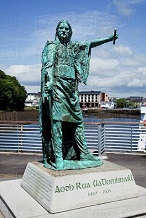


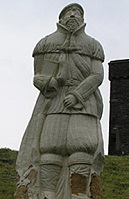

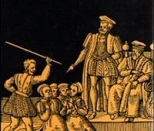
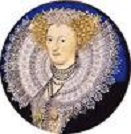
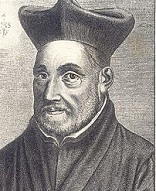

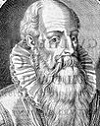
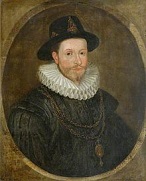


1593 On Jan. 8 the Siege of Pyongyang sees 36K Chinese Ming forces of Song Yingchang (1536-1606) under brothers Li Rusong (1549-98) and Li Rubo (1553-1619) cross the Yalu River and hook up with 4K Korean (Joseon) forces under chief minister Yu Seong-ryong (Songnyong) (1542-1607), then the 43K combined forces take Pyongyang from 42K Japanese forces under Christian gen. Konishi Yukinaga (1555-1600), with 16K Japanese vs. 800 allied casualties. On Feb. 6 French Jesuit (St.) James Sales (b. 1556) is shot in the back in the city of Aubenas in the Cevennes region of France by Calvinists after an inquisition the previous day, where he refuses to denounce the real presence in the Eucharist and allegedly beats them in a theology debate; on Feb. 6 lay brother (St.) William Saultemouche (b. 1555) volunteers to die with him, and is stabbed to death; the Protestants are back atcha, when on May 29 Welsh Puritan John Penry (b. 1559) of Breconshire, who pissed-off the Anglican bishops by preaching against their lack of education and their living off church lands they don't live on is hanged in St. Thomas-a-Watering for sedition for writing a rough draft of an unpub. petition to Elizabeth I, becoming a Puritan martyr (Wales' most famous), leaving The Notebook of John Penry. On Feb. 10 Charles de Guise convenes an Estates Generaux in Paris in hopes of electing himself to the French throne in place of pretender Henry IV (former Henry III of Navarre). On Feb. 12 the Battle of Haengju sees 2.3K Koreans under army CIC field marshal Gwon (Kwon) Yul (1537-99) repel 30K invading Japanese forces trying to storm a fortress, rolling boulders on them and giving them a taste of their technological breakthrough hwachas (anti-personnel mortars, each rocket containing 100-200 iron spikes), and finally stopping them after nine attacks; the Korean women help gather boulders while wearing "Haengju chimas", aprons to cover their sexy legs. In Feb. Elizabeth I appoints her 27-y.-o. "wild horse" Essex to the Privy Council. In Apr. Elizabeth I refuses to appoint Sir Francis Bacon to the post of atty.-gen., preferring solicitor-gen. Sir Edward Coke (1552-1634) (pr. like cook) instead, despite entreaties by Essex, because Bacon had fought against granting a subsidy to the crown by Parliament; Essex continues to pressure her all year, playing head games to see if the old dame can be dick-whipped? In Apr. Tyrone's Rebellion (Nine Years' War) begins (ends Mar. 31, 1603) when Gaelic Irish chieftain Hugh O'Neill, 2nd Earl of Tyrone (1550-1616) and his son-in-law, Tyroconnell king (since 1592) "Red" Hugh Roe O'Donnell (1572-1602) try to resist the advance of the stankin' English from the Pale to the whole island, rallying Irish septs. On May 11 the English privy council orders the arrest of all authors of "divers lewd and mutinous libels" that had been posted around London, and on May 12 dramatist Thomas Kyd (1558-94) is arrested at the Chislehurst home of Thomas Walsingham of Scadbury (1561-1630) (where he lives with Christopher Marlowe, who had been given the home to ride out the plague), and an Arian tract is found that "denies the eternal deity of Jesus Christ our Lord and Saviour", causing him to be tortured and rat out rommate Marlowe, who is arrested on May 20 to obtain his release; on May 30 after appearing before the privy council and awaiting their decision, Canterbury, Kent-born gay pedophile ("They that love not tobacco and boys are fools") and blasphemy-loving ("Christ was a bastard and his mother unchaste", "The woman of Samaria and her sister were whores and Christ porked them", "St. John the Evangelist was Christ's gay bud and that's why he always leaned in his bosom, he used him as the sinners of Sodom") poet-playwright Christopher "Kit" Marlowe (b. 1564) is killed (stabbed above the right eye) in a Deptford house brawl (after arguing over the bill) by Ingram Frizer (-1627) (a member of Walsingham's secret service, along with Marlowe?) with a dagger that he snatches from Marlowe's hand (after Marlowe snatches it from him and attacks him first?), dying theatrically with a blood-curdling scream, cursing and blaspheming; Frizer gets a royal pardon for self-defense on June 28; Kyd is ruined and soon dies bankrupt; was Marlowe meeting with agents of Sir Robert Cecil about a secret mission to Scotland concerning James VI?; was the corpse of a murdered sailor substituted for Marlowe's for the inquiry, and Marlowe faked his death, going on to be the real Shakespeare?; the murder takes place 4 mi. from the site of John Penry's execution. On June 20 Croatian Christian forces defeat the Turks at the Battle of Sisak (Sissek) on the Kulpa River, giving Sisak the European epithet "antemurale christianitatis"; Sultan Murad III's grand vizier declares war on Hapsburg HRE Rudolf II (ends 1606). In the summer unfavorable winds prevent a new Spanish fleet from sailing to invade England; Elizabeth I says, "My cause is just, and it standeth upon a sure foundation... I shall not fail, God assisting the quarrel of the righteous." In the summer London has another plague epidemic, worse than the previous year, causing London's theaters to be closed (until 1594), and the queen to stay at Windsor until Christmas, where she translates Boethius in 12 days. On July 18 Sir Francis Stewart, 5th Earl of Bothwell (1562-1612) (nephew of the earl who caused trouble for Mary, Queen of Scots) is smuggled into the bedroom of James VI at Holyrood by a conspiracy of popish nobles in an attempt to reconcile with him after challenging his authority; too bad, paranoid James believes he intended to assassinate him, and on Aug. 10 Bothwell is tried for witchcraft and acquitted after 24 days in prison; on Oct. 29 the Trial of the Popish Nobles begins in Scotland, and they are banished and forfeited, although they later return to Scotland with James looking the other way; the main Roman Catholic earls are Crawford, Errol, Huntly, and Maxwell, who control large areas in the Highlands and west; meanwhile Elizabeth I promulgates an Act Against Papists (Popish Recusants), outlawing Puritan assemblies and activities in England. On July 25 after hearing a Mass at St. Denis, French king (since 1589) Henry (Henri) IV (1533-1610) (who temporarily abjured Calvinism in 1572 to save himself after the St. Bartholomew's Day Massacre) announces his reconversion from Calvinism to Roman Catholicism as part of an attempt to secure his crown, allegedly announcing "Paris is well worth a Mass" after ignoring the urgent exhortations of Protestant leader Theodore Beza; Elizabeth I is horrified, writing to him: "Ah, what griefs, what regret, what groanings I feel in my soul at the sound of such news"; when he reissues his edicts of religious tolerance she continues to support him against Spain; meanwhile Jean de Beaumanoir, Marquis de Lavardin (1551-1614), who switched from Protestant to Catholic way back in 1572 after the St. Bartholomew's Day Massacre of 1572 (in which his daddy was killed), then fought against Henri III, switches sides again, and is made a marshal of France and gov. of Maine. On July 29 the Long (Thirteen Years') War (ends Nov. 11, 1606) between the Hapsburgs and the Ottomans begins when the Ottoman army under Albanian-born Sinan Pasha (1506-96) invades Royal Hungary (modern-day Slovakia), after which the war spreads to Transdanubia, Croatia, and S Romania;l Pope Clement VIII is instrumental in setting up an alliance of Christian nations to fight the infidel Muslim Ottoman Empire. In July famous female Irish pirate Grace (Granuaile) (Grainne) O'Malley (1530-1603) sneaks into London and has an audience with Elizabeth II, talking her into releasing her son Theobald and other prisoners held by the English; when she sneezes and is handed a handkerchief, she blows her nose then throws it into the fireplace, pissing-off the queen (who told her it is a gift and she has to keep it), by implying that the Irish are cleaner than the English and never put a soiled one in their pocket? In Sept. turban-wearing Michael the Brave (1558-1601) is created prince of Wallachia by the Ottoman sultan, then flops on him, joining the Christian alliance of Euro powers, signing treaties with Sigismund (Zsigmond) Bathory (1572-1613) of Transylvania and Aron Tiranul ("the Tyrant") of Moldavia, and attacking citadels around the Danube Valley. On Dec. 6 the long-standing feud between the Maxwells and the Johnstones in the Scottish West March is decided in the Johnstones' favor at the Battle of Dryfe Sands, where the Lockerbie Licks (downward sword strokes causing hideous facial disfigurement) are introduced by the winners, the Maxwells losing 700 out of 3K men. Hideyoshi's invasion of Korea fails as the country refuses passage of his troops to invade China; Hideyoshi's son and heir Hideyori (d. 1615) is born. Sir John Maitland of Thirlestan is deposed as Scottish chancellor after Queen Anne gets him dumped, causing James VI to rule on his own for several years. The Uppsala Synod forces Sigismund IIII Vasa to recognize that Sweden is a Protestant state. The first Marrano (Sp. "swine") (Portuguese Jew) settlement is founded in Amsterdam. Ft. Jesus on Mombasa Island is founded by Philip I of Portugal to guard the port of Mombasa, Kenya; from the air it has the shape of a man. On May 28 Sigismund III Vasa grants Magdeburg rights to the town of Tarnobrzeg (pr. tar-NOB-zek) on the E bank of the Vistula River in Lesser Poland, founded for the Tarnowski family by Stanislaw Tarnowski, constable of Sandomierz. The College of St. Omer is founded by Jesuit Father Robert Persons (Parsons) (1546-1610) in Artois, Spanish Netherlands (France); it is forced to relocate to Bruges in 1762 and Liege in 1773, settling in 1794 in Stonyhurst, England, becoming Stonyhurst College. The tulip is introduced to Holland again by Flemish physician-botanist Charles de l'Ecluse (l'Écluse) (L'Escluse) (Carolus Clusius) (1526-1609), head botanist of the U. of Holland in Leiden, and discovers the phenomenon of "tulip breaking", where a virus causes the creation of flames and feathered varieties, leading to tulipomania and Dutch tulip heads - together we can and we will make Holland tulipier? Scholar Joseph Scaliger becomes a prof. at the U. of Leiden (until 1609). Sant' Ambrogio Bank in Milan is founded. The U. of Montpellier founds Jardin des Plantes de Montpellier, become the first French botanical garden. Protestant layman George Keith, 5th Earl Marischal (1553-1623) founds Marischal College in Aberdeen, Scotland; in 1860 it is merged with the U. of Aberdeen, who leases it to the Aberdeen City Council. Prosecco sparkling white wine from NE Italy (named after a village near Trieste) is first mentioned by English traveler Fynes Moryson (Morison) (1566-1630), who claims it is a recreation of Pucinum, the wine celebrated by Pliny the Elder in his Natural History and Roman emperor Augustus' wife Livia for its medicinal qualities. Inventions: The first description of a modern abacus is pub. in China. Science: Italian scientist Galileo Galileo invents the Thermoscope, a primitive uncalibrated thermometer used as a novelty perpetual motion machine. German surgeon ("Father of German Surgery") Wilhelm Fabry of Hilden (Guilelmus Fabricius Hildanus) (1560-1634) becomes the first to recommend amputation above the gangrenous area, and to describe a windlass (twisting stick) tourniquet; his wife (1587-) Marie Colinet (1560-1640) of Geneva, Switzerland becomes his asst., improving the techniques for cesarean section, introducing the use of heat for dilating and stimulating the uterus during labor, and in 1624 becoming the first to use a magnet to remove metal from a patient's eye, although he gets the credit. Nonfiction: Andrea Cesalpino (1519-1603), Queaestionum Medicarum (2 vols.); discusses the circulation of the blood but fails to form any clear picture. Pierre Charron, Les Trois Verites. Henry Chettle (1564-1607), Kind Heart's Dream; a pamphlet apologizing for attacking Shakespeare in Greene's 1592 "Groates-worth of Wit". Cheng Da-Wei, Systematic Treatise on Arithmetic (Tong Zong); first pub. description of an abacus. Richard Harvey (1560-1630), Philadelphus, or a Defence of Brutes and the Brutans History; coins the term "anthropology" (Gr. "anthropos" + "logia" = humanity + study), becoming the first "ology". John Napier (1550-1617), A Plaine Discovery of the Whole Revelation of Saint John; the first important Scottish Biblical interpretation? Giambattista della Porta (1535-1615), De Refractione, Optices Parte; incl. an account of binocular vision. Cesare Ripa (-1622), Iconologia; handbook of symbolism in emblem books, incl. conventions of dress and appearance for figures of courage, virtue and wisdom in painting and plays; goes through multiple eds. in the 1600s and 1700s. The Doctrina Christiana is the first book printed in the Philippines. Art: El Greco (1541-1614), The Crucifixion; The Resurrection. Plays: George Peele (1556-96), The Chronicle of King Edward I; one of the first English historical plays, giving Shakespeare ideas. Poetry: Michael Drayton (1563-1631), Idea; the Shepheard's Garland; nine pastoral poems; Piers Gaveston; how he seduces sweet cheeks Edward III; "This Edward in the Aprill of his age,/ Whil'st yet the Crowne sate on his fathers head/ My Jove with me, his Ganimed, his page,/ Frolick as May, a lustie life we led". Giles Fletcher the Elder, Sonnets to Licia (sonnet series). Robert Henryson (fl. 1460-1500), The Testament of Cresseid (posth.); medieval-Renaissance transition poet in Dunfermline, Scotland. Mary Sidney Herbert (1561-1621), The Countesseof Pembroke's Arcadia (AKA New Arcadia); amplified vers. of her brother Philip Sidney's "Arcadia"; becomes a bestseller for 3 cents. William Shakespeare (1564-1616), The Rape of Lucrece (1593-4); about legendary Roman noblewoman Lucretia; dedicated to Henry Wriothesley, 3rd Earl of Southampton. William Shakespeare begins writing the 154 "sugred" Sonnets (pub. in 1609 without his permission) about the Dark Lady, "black as hell as dark as night"; "Then I will swear Beauty herself is black/ And all they foul that thy complexion lack" (#132); "Shall I compare thee to a summer's day?" (#18); earliest written in 1589? Thomas Watson (1557-92), The Tears of Fancie, or Love Disdained (posth.); 60 sonnets; influences Shakespeare; "Long time I fought, and fiercely waged warre, Against the God of amarous Desire: Who sets the senses mongst themselves at jarre, The harts inflaming with his lustful fire"; "Were words dissolved to sighs, sighs into teares,/ And evrie teare to torments of the mind:/ The minds distresse into those deadly feares,/ That find more death than death itself can find/ Were all the woes of all the world in one,/ Sorrow and death set downe in all their pride." Births: French "St. Joseph" painter Georges de La Tour (d. 1652) on Mar. 13 in Vic-sur-Seille. French Jesuit missionary (St.) Jean de Brebeuf (Brébeuf) (d. 1649) on Mar. 25 in Conde-sur-Vire, Normandy; uncle of poet Georges de Brebeuf (1618-61); feast day: Sept. 26/Oct. 19. English metaphysical poet-divine George Herbert (d. 1633) on Apr. 3 in Montgomery Castle, Wales; brother of Edward Herbert (1582-1648); educated at Trinity College, Cambridge U. English royal adviser (to Charles I) Sir Thomas Wentworth, 1st Earl of Stafford (d. 1641) on Apr. 13 in London; not to be confused with his relative Thomas Wentworth (1591-1667); educated at St. John's College, Cambridge U. Dutch (Flemish) "The King Drinks", "Fecundity" painter Jacob Jordaens (d. 1678) on May 19 in Antwerp; favorite pupil of Adam van Noort. Italian Baroque painter Artemisia Gentileschi (d. 1653) on July 8 in Rome; first female member of the Accademia di Arte del Disegno in Florence. English "The Compleat Angler" writer and fisherman (angler) Izaak Walton (d. 1683) on Aug. 9 in Stafford. Japanese overlord (last of the Toyotomi clan) Toyotomi Hideyori (d. 1615) on Sept. 8 in Osaka; son of Toyotomi Hideyoshi (1537-98) and Yodo-dono (niece of Oda Nobunga). Swiss engraver Matthaus (Matthäus) Merian der Altere (Matthew the Elder) (d. 1650) on Sept. 22 in Basel; father of Mattthaus Merian the Younger (1621-87). Dutch Reformed theologian Sixtinus (Sextinus) Amama (d. 1629) on Oct. 13 in Franeker, Friesland; educated at the U. of Franeker, Oxford U., and U. of Leyden; student of John Prideaux (1578-1650). English portrait painter Cornelis Janssens van Ceulen (d. 1661) on Oct. 14 in London; Dutch-Flemish parents; moves to Middleburg, Netherlands in 1643, moving to Amsterdam in 1646, then Utrecht in 1653. French diplomat Abel Servien, Marquis de Sable (Sablé) et de Boisdauphin (d. 1659) on Nov. 1 in Biviers (near Grenoble). Italian composer Paolo Agostini (d. 1629) in Vallerano. Dutch engraver-etcher Jan van de Velde (d. 1641); brother of Esaias van de Velde (1590-1630). Dutch navigator Anthony (Antonio) van Diemen (d. 1645) in Culemborg. French painter Louis Le Nain (d. 1648); brother of Antoine Le Nain (1599-1648) and Mathieu Le Nain (1607-77). Dutch navigator-explorer David Pieterszoon de Vries (d. 1655) in La Rochelle. Deaths: Japanese emperor #106 (1557-86) Ogimachi (b. 1517) on Feb. 6. Italian painter Giuseppe Arcimboldo (b. 1527) on July 11 in Milan. English lord Henry Stanley, earl of Derby (b. 1531). English MP Paul Wentworth (b. 1533). English military leader Arthur Grey, 14th baron Grey de Wilton (b. 1536) on Oct. 14. English painter John White (b. 1540). English Separatist Puritan John Barrow (b. 1550) on Apr. 6 (early a.m.); hanged for sedition along with Separatist leader John Greenwood (b. ?). Welsh Protestant martyr John Penry (b. 1559) on May 29 in St. Thomas-a-Watering (4:00 p.m.) (hanged on trumped-up sedition charges, with Canterbury Archbishop John Whitgift's signature at the top of the death warrant), becomes Welsh's most famous Protestant martyr. English playwright-poet Christopher Marlowe (b. 1564) on May 30 in Deptford, Kent (murdered); establishes blank verse in English theater, although his bombastic, blood-and-thunder plots, filled with improbabilites and impossibilities and wildly ranting dialogue are no match for Shakespeare?; leaves the poems The Passionate Shepherd to His Love (first line: "Come live with me and be my love") and Hero and Leander.









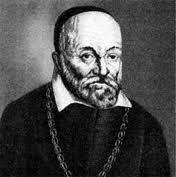
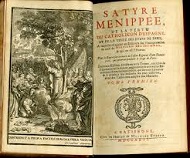


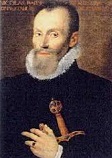
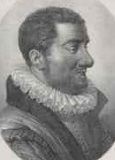
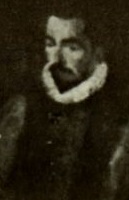
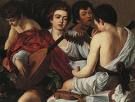
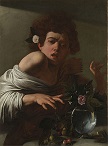
1594 Basically I find your screensaver offensive? On Jan. 1 Elizabeth's chief physician Roderigo (Ruy) (Roger) Lopez (Lopes) (b. 1517) (a Portuguese Jew who fled to England in 1559 to escape the Inquisition and converted to Christianity under the name Christian but can't fix his hook nose?) (inspiration for Shylock in Shakespeare's "The Merchant of Venice"?) is arrested for treason, railroaded to conviction by Essex and executed (hanged, drawn and quartered) on June 7 at Tyburn along with alleged accomplices Esteban Ferreira et al. after being accused of a plot to poison Portuguese pretender Don Antonio (living in London) and/or the queen; he protests his innocence to the end, with the soundbyte that "He loved the queen as he loved Jesus Christ", giving the crowd a big laugh because to them he's forever a Jew; he was probably innocent, and Essex just wanted to score one on a Christ-killer to please da queen, although it backfires when she keeps a ring that Philip II had given Lopez in 1587 which he had offered her but she had refused, wearing it until she dies? On Jan. 13 Elizabeth rebukes James VI for his leniency towards the popish nobles; on Apr. 24 popish noble Alexander Home, 6th Lord Home (Hume) (-1691) subscribes to the Confession of Faith to escape punishment and become a good homeboy, and after his buddy James I becomes king he is created duke, duke duke, duke of earl in 1605. On Feb. 27 after buying off the opposition and triumphantly entering Paris, the French House of Bourbon (branch of the House of Capet) (founded in 1268) is established with the coronation of Henri IV in Chartres, who goes on to become the most popular king in French history (until May 14 1610), while the Bourbons go on to hold thrones in Spain, Naples, Sicily, and Parma - love, love me do? On Mar. 26 Elizabeth I disappoints Essex by appointing Sir Edward Coke as atty.-gen., causing him to er, push his gay bud Sir Francis Bacon for the vacated post of solicitor-gen. for the next 18 mo. On Apr. 2 the British privy council issues a proclamation for a muster at Stirling to pursue Bad Ole' Bothwell, and on Apr. 3 he is attacked at Nidday and escapes to England, causing James VI to rebuke Elizabeth I for harboring him. On May 24 after his men mutiny in Ceylon (Sri Lanka) and he loses all but 24 of his men, Sir James Lancaster arrives back in Rye, England after failing to reach India, but his tales cause the British East India Co. to be formed in 1600, and the Portuguese trade monopoly in India is about to become kaput. In May the theaters in London reopens; the Lord Chamberlain's Men is chartered by Lord Chamberlain (1585-96) Henry Carey (1687-1743), 1st Baron Hunsdon (1526-96), son of Anne Boleyn's sister Mary and first cousin to Elizabeth I; when he dies his son George Carey, 2nd Baron Hunsdon (1547-1603) took over; Shakespeare works for the company for most of his career; besides Shakeaspeare, the company's main actor is Richard Burbage (1568-1619), son of impresario James Burbage, who plays the title role in Shakespeare's "Hamlet", "Othello", "Richard III", and "King Lear", having no problemo with the unprecedented number of lines he had to memorize; too bad, he has to play second fiddle to tall London thespian Edward Alleyn (1566-1626), who specializes in Marlowe's and Kyd's plays, and never act in one of Shakespeare's, founding the rival Admiral's Men at the Rose on the S shore. In June Sir Richard Hawkins (1562-1622), son of Sir John Hawkins is captured in San Mateo Bay after plundering Valparaiso in his ship Dainty, and ends up in priz in Spain until 1602, after which he is knighted in 1603, given a seat in Parliament in 1604, and promoted to vice-adm. of Devon to fight coastal pirates. In June Dutch explorers Willem Barents (Barentsz) (1547-97) and Cornelis Corneliszoon Nay leave Texel, Netherlands on the first of three voyages in the Barents Sea in N Russia to find the Northeast Passage (ends 1597); Nay reaches the Kara Sea this year, the second voyage next year is stopped by ice, and the third in 1596-7, by Barents alone results in his party wintering on Novaya Zemlya, after which Barents dies on the return voyage; although they fail to find the passage, they open up whale and seal fishing; in the 19th cent. Barents Sea (AKA the Murman Sea, Norwegian Sea) is named after Barents. In the summer too much rain ruins the English crops, leading to winter famine. In July Elizabeth I gives her favorite Essex £4K to defray his debts, then dismisses as a Roman Catholic plot an inflammatory book from Antwerp by Jesuit Robert Parsons titled A Conference about the Next Succession to the Crown of England, which claims he should play the part of kingmaker on her death. On Dec. 27 Henri IV of France is knifed at the Hotel de Schomberg while visiting his mistress Gabrielle d'Estrees by 21-y.-o. Jesuit-educated Jean Chatel (1575-94), who tries to slit his throat but botches it; he is put under pressure to implicate the Jesuits, but doesn't, and is executed by dismemberment on Dec. 29 in the Place de Greve after his offending hand is burned with molten sulfur, lead, and wax. The Camerons defeat the confederation of the Argylls, Atholls, Forbes, and Macintoshes at the Battle of Glenlivet. The Thai sack the Cambodian capital of Longvaek; Reamea Chung Prey (CHungprey) becomes king of Cambodia (until 1596). Akbar the Great takes Kandahar in Afghanistan. The Turks conquer Gyor (Györ) (Raab) (built on the ruins of the Roman city of Arabona) 67 mi. WNW of Budapest at the Austro-Hungarian border at the confluence of the Raab River with a tributary of the Danube, known as the gateway between east and west; too bad, they lose it in 1598. Henry IV relieves the town of Le Crotoy in NW France from taxes for supporting him in the wars of religion. French Huguenot leader Philippe de Mornay, Seigneur du Plessis-Marly (1549-1623), pissed-off by Henri IV's flip-flopping on Protestantism gets his plan for organizing the true blue Huguenots adopted at Sainte-Foy. The Lisbon spice market is closed to Dutch and English traders, causing them to begin seeking direct trade with the Far East. Spanish adventurer Blaz Ruiz de Hernan Gonzalez arrives in the Cambodian capital of Longvaek, finds himself in the middle of a war with Siam, gets captured and taken on a treasure-filled Siamese junk, but kills the captain, takes it over and returns to Manila with the loot. English traveler Ralph Fitch (1550-1611) returns from an overland journey to India and Ceylon, returning to London on Apr. 29, 1597 after eight years. Elizabeth I sends a Thomas Dallam organ to the sultan of Turkey. Johannes Kepler (b. 1571) gets a break when the math teacher at the Lutheran high school in Graz, Austria (the U. of Graz) dies, and he is picked to replace him. Pope Clement III celebrates his first Mass at the new high altar in St. Peter's in Rome built by Domenico Fontana - now all we need is some good BBQ? Budding Spanish writer Miguel Cervantes takes a job as a tax collector in Andalusia. Science: Italian "Father of Embryology" Hieronymus Fabricius (Girolamo Fabrici) (1537-1619) of the U. of Padua (Galileo's personal physician and William Harvey's teacher) performs the first public dissection. Art: Giovanni da Bologna (1524-1608), Cosimo I de' Medici (statue); Fernandeo de' Medici (statue). Michelangelo da Caravaggio (1571-1610), The Musicians (The Musical Party); 16th cent. Italian sex, drugs, and rock & roll complete with gorgeous young groupie babes?; By Bitten by a Lizard (1594-6); self-portrait?; an allusion to masturbation? Nonfiction: Thomas Blundeville (1522-1606), Exercises; first English work on plane trigonometry. Theodor de Bry (1528-98), The Great Voyages; the discovery of America illustrated, fawning all over Columbus; his most popular work, causing the English and Dutch to begin salivating about getting their piece? Robert Greene (1558-92), The Repentance of Robert Green (1558-92), Master of Arts (deathbed confession?); "To all the wanton youths of England, Robert Greene wisheth reformation of wilfulness... lust and lechery, which is the viper whose venom is incurable, and the only sin that in this life leadeth unto shame, and after death unto hell-fire, for he that giveth himself over to harlots selleth his soul to destruction, and maketh his body subject to all incurable diseases""; Greene's Vision. Richard Hooker (1554-1600), Of the Laws of Ecclesiastical Polity, Vols. 1-4; written in Boscombe, Wiltshire; draws a distinction between eternal unchangeable natural law and alterable positive law, applicable to govt. Pierre Matthieu (1563-1621), Histoire des derniers troubles de France. Nicolas Rapin (1535-1608), Jean Passerat (1534-1602), Florent Chrestien (1541-96), and Pierre Pithou (1539-96), Satyre Menippee (Ménippée) de la Vertu du Catholicon d'Espagne, et de la Tenue des Estates de Paris (Tours); a satirical political work in prose and verse written during the Etats Generaux convened by Charles of Lorraine, Duke of Mayenne (1554-1611) (AKA Charles de Guise) (leader of the Catholic League) on Feb. 10, 1593 in Paris in hopes of electing himself to the French throne in place of pretender "Good King" Henry IV (1553-1610) (former Henry III of Navarre) (who renounced Protestantism for Roman Catholicism on July 25, 1593, allegedly uttering the immortal soundbyte "Paris is well worth a Mass"), criticizing the excesses of the Catholic League and Spain during the French Wars of Religion (Mar. 1562-Apr. 1598), championing Henry IV and defending the idea of an independent Roman Catholic France that makes a political accomodation with the Huguenots, damaging the Catholic League's cause and helping Henry IV win in 1596. Joseph Scaliger (1540-1609), Epistola de Vetustate et Splendore Gentis Scaligerae et J.C. Scaligeri Vita; attempts to put over a scholarly laundering of his family's alleged patrician origin from the La Scala family of Verona, stinking up his name when Gaspar Scioppius pub. Scaliger Hypobolimaeus ("The Counterfeit Scaliger") in 1607, showing their scaggy base origin. Plays: Samuel Daniel (1562-1619), The Tragedy of Cleopatra. Robert Greene (1558-92), The Honorable History of Friar Bacon and Friar Bungay (comedy) (posth.); inspired by Marlowe's 1593 play "Faust" plus the pamphlet "The Famous History of Friar Bacon", about Bacon and his sidekick Bungay, and how they build a magical brass head that says "Time is, Time was, Time is past", which falls and breaks when Bacon's servant Miles fails to watch it; The Scottish History of James IV (posth.). Thomas Kyd (1558-94), Cornelia; dedicated to the countess of Sussex, alluding to his recent "bitter times and privy broken passions". John Lyly (1553-1606), Mother Bombie (comedy). Christopher Marlowe (1564-93), The Troublesome Reign and Lamentable Death of Edward II, King of England, with the Tragical Fall of Proud Mortimer (tragedy) (posth.). George Peele (1558-98), The Battle of Alcazar; Turkish Mahomet and Hyrin the Fair Greek (lost). William Shakespeare (1564-1616), The Comedy of Errors (The Night of Errors) (comedy); 1770 lines total (his shortst play); about two sets of twins, Antipholus of Syracuse and his servant Dromio, and Antipholus of Ephesus and his servant Dromio; Adriana, Luciana, Egeon and Emilia, Angelo; only play to mention America; "err" refers to syphilis; Love's Labour's Lost (1594-5) (comedy); first pub. in 1597; inspired by Sir Francis Bacon's travels in 1576-9 with Sir Amyas Paulet, English ambassador in France, incl. Navarre; the king of Navarre and his lords Berowne, Longaville and Dumain, Holofernes the schoolmaster (really Italian-born English court brain man John Florio (1553-1625)?), the princess of France and her attendants Rosaline, Maria, and Katherine, and her advisor Boyet, Don Armado from Spain, country girl Jacquenetta and her beau Costard the clown, who plays "fast and loose" (1.2.153) by breaking the king's commandment to keep all women at least 1 mi. from his court for 3 years; Act 1 Scene 5 contains Shakespeare's longest word (27 letters) (uttered by Costard), "honorificabilitudinitatibus" (the state of being able to achieve honors); an anagram for "hi ludi, F. Baconis nati, tuiti orbi" (these plays, F. Bacon's offspring, are preserved for the world" and/or "I, B. Ionsonii, uurit a lift'd batch" (I, Ben Johnson, writ a lift'd batch) - let me floccinaucinihilipilificate about that a minute?); King John (1594-6); not pub. until the First Folio (1623); King John of England, his mom Eleanor, his nephew Arthur, King Philip of France, justiciar Hubert de Burgh, Philip Faulconbridge the Bastard (Sir Richard Plantagenet, son of Richard Lionheart), Cardinal Pandulph; "To gild refined gold, to paint the lily.../ Is wasteful and ridiculous excess" (4.2.11-16); "This England never did, nor ever shall,/ Lie at the proud foot of a conqueror" (5.7.112-3). Poetry: Anon., The Arbor of Amorous Devises; English poets, incl. Nicholas Breton's A Cradle Song; "Come little babe, come silly soul,/ Thy father's shame, thy mother's grief,/ Born as I doubt to all our dole,/ And to thyself unhappy chief". Richard Barnfield (1574-1620), The Affectionate Shepherd (Nov.) (first work); pub. anon.; dedicated to Penelope, Lady Rich; paraphrase of Virgil. Diego Bernades, Varias Rimas ao Bom Jesus. Michael Drayton (1563-1631), Idea's Mirror (love sonnets); Matilda, the Faire and Chaste Daughter of the Lord Robert Fitzwater; "O my dread Soveraigne, rare and princely Mayd,/ From whose pure eyes the world derives her light,/ In Angels robes with majestie arayd,/ In whom true vertue is defin'd aright./ O let these lines be gracious in thy sight,/ In whom alone, as in a perfect glass,/ All may discerne how chaste Matilda was." Novels: Thomas Nashe (1567-1601), The Unfortunate Traveller, or the Life of Jack Wilton; first English picaresque novel, becoming the prototype of the English adventure novel. Births: Italian duke of Mantua and Montferrat (1626-7) Vincenzo II Gonzaga (d. 1627) on Jan. 7; son of Vincenzo I Gonzaga (1562-1612) and Eleonara de' Medici; brother of Ferdinand I Gonzaga (1587-1626). Italian violinist-composer Biagio Marini (d. 1663) on Feb. 5 in Brescia. Scottish/English prince of Wales Henry Frederick Stewart (d. 1612) on Feb. 19 in Scotland; eldest son of James VI of Scotland (James I of England) (1566-1625) and Anne of Denmark (1574-1619); named to flatter Elizabeth I. French "The Plague at Ashdod", "The Shepherds of Arcadia" painter (in Rome) Nicolas Poussin (d. 1665) on June 15 near Les Andelys, Normandy; develops the standard for French classical art; never paints a subject later than the 12th cent. C.E. Swiss diplomat Johann Rudolf Wettstein (d. 1666) on Oct. 27 in Basel. Swedish Protestant king (1611-32) ("Lion of the North") Gustavus II Adolphus Wasa (Vasa) (d. 1632) on Dec. 19 (Dec. 9 Old Style) in Stockholm; eldest son of Charles IX and Christina of Holstein; grandson of Gustavus I (1496-1560). Am. colonial "Bay Psalm Book" printer (first in English Am. colonies?) Stephen Day (Daye) (d. 1668) in London; emigrates to Mass. in 1638. English Cavalier poet Thomas Carew (d. 1640) (pr. "CARE-ee") in West Wickham, Kent; educated at Merton College, Oxford U. English anti-royalist statesman-legislator John Hampden (d. 1643) in London; educated at Magdalen College, Oxford U. English politician gen. Edward Conway, 2nd Viscount Conway (d. 1655) on Aug. 10 in Arow, Wawrwickshire; eldest son of Edward Conway, 1st viscount Conway; educated at Queen's College, Oxford U.; knight on Mar. 25, 1618; known for his 14K-15K-vol. library of English lit., incl. Ben Jonson, John Donne, Sir John Suckling, Sir John Beaumong, and Michael Drayton. English (Welsh) writer (first to earn his living solely from writing in the English language, and first writer of an epistolary novel) James Howell (d. 1666); son of a Welsh clergyman; brother of Bishop Thomas Howell of Bristol (1588-1650); educated at Jesus College, Oxford U.; spends his career working up to secy. of the privy council, only to see the English Civil war ruin it, causing him to turn to writing. Deaths: Flemish cartographer Gerhard Mercator (b. 1512) on Dec. 2 in Duisburg, Cleves, Westphalia; buried in the Gothic Church of St. Salvator in Duisburg - find that on your map? English lexicographer Thomas Cooper (b. 1517) on Apr. 29 in Winchester, Hampshire. Venetian painter Il Tintoretto (b. 1518) on May 31. French painter Jean Cousin (b. 1522). Swiss Counter-Reformation leader Ludwig Pfyffer (b. 1524) on Mar. 17. Italian #1 polyphonic composer Giovanni da Palestrina (d. 1525) on Feb. 2 in Rome (pleurisy); composed 104 masses, 68 offertories, 300+ motets, 72 hymns, 36 magnificats, 11 litanies, 4-5 lamentations et al.; his style becomes known as "prima pratica". English Roman Catholic cardinal William Allen (b. 1532). Franco-Flemish composer Orlando di Lasso (b. 1532) on June 14 in Munich; dies before hearing that his employer fired him; stays Roman Catholic to the end; composed over 2K works, incl. 530 motets, 175 madrigals and villanellas, 150 chansons, 90 lieder and 60 masses; likes to use the combo "la-sol" (A-G in the key of C) in his works. Spanish soldier-poet Alonso de Ercilla y Zuniga (b. 1533) on Nov. 29 in Madrid. English explorer Sir Martin Frobisher (b. 1535) in Nov.; dies during recapture of Brest from the Spanish at Ft. Crozon. English dramatist Thomas Kyd (b. 1558) on July 16 in London.

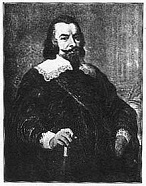
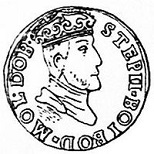











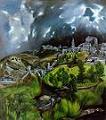

1595 On Jan. 16 sultan (since Dec. 15, 1574) Murad III (b. 1546) dies of apoplexy after fathering 105 children, and his son (by Sophia Baffo, who outmaneuvers the other wives to get him in) Mehmed III Adli (1566-1603) becomes Ottoman sultan #13 (until 1603) after inviting his 19 brothers (all sons of harem slave girls, ages 11 and under) to the palace and having them strangled with silk cords by deaf mutes (Ottoman law provides for the "right to execute his brothers"); he goes on to clog up the Bosphorus with the bodies of his daddy's pregnant mistresses, and enjoys watching women's breasts scorched off with hot irons; Baffo continues to rule behind the scenes, and ends the traditional practice of sending princes to governorships along with the need for fratricide with the supposedly more humane Kafes (cage), a palace prison for potential heirs served by deaf-mute eunuchs; although this produces lazy sexually-degenerate morons and idiots, some of them end up ruling anyway, hastening the decay and fall of the Ottoman Empire - later adopted by the U.S. for its presidents? In Jan. France declares war on Spain; in June Spain takes Doullens, followed in Oct. by Cambrai. In Jan. the English withdraw their forces from Brittany. On Feb. 21 after being imprisoned in 1592 and interrogated by grand inquisitor Richard Topcliffe (1531-1604) until he is convicted of high treason, English Jesuit priest-poet (St.) Robert Southwell (b. 1561) is hanged in Tyburn, his body quartered and displayed on London's four city gates; in 1970 Pope Paul VI canonizes him as one of the Forty Martyrs of England and Wales. On Apr. 26 Marino Grimani (1532-1605) becomes doge #89 of Venice (until Dec. 25, 1605). In Apr. Spanish explorer Alvaro Mendana de Neyra (b. 1542) sails from Callao on his second voyage to Micronesia; in May he discovers the Marquesas Islands (Las Marquesas de Mendoza); on Oct. 18 he dies in the Santa Cruz island group in the Solomons. On May 24 (June 3 Old Style) after Sigismund Bathory removes Aron Tiranul from power and replaces him as prince (voivode) of Moldavia by Stefan Razvan (-1595) (until Aug.), with the Treaty of Alba Iulia with Prince (since 1593) Michael the Brave (1558-1601) of Wallachia, placing the former Ottoman vassal principality of Moldavia under Razvan's overlordship; in Aug. Razvan signs a similar treaty in Alba Iulia with the Wallachians, becoming de facto prince of Transylvania, Wallachia and Maladavia, pissing-off the Polish-Lithuanian nobles, and on Aug. 23 (Aug. 13 Old Style) the Battle of Calugareni near the Neajilov River, is a V for the 15K-man army of Michael the Brave over 100K invading Turks under Sinan Pasha in Wallachia, after which Michael the Brave joins Bathory's 40K-man army led by Stephen Bocskay, and they go on to free Targoviste (Oct. 8), Bucharest (Oct. 12), then Braila, culuminating on Oct. 27-30 in a Christian V at the Battle of Giurgiu, catching the retreating Ottomans trying to use the same bridge over the Danube River they came in over, freeing Wallachia from Ottoman rule; after Michael retreats to the mountains at Stanilesti, the Ottomans begin plundering and taking slaves, causing Michael to revert to guerrilla warfare over the winter. On June 5 the Battle of Fontaine-Francaise is a strategic V for 3K French Protestant peasants under Henry IV over the 12K-man Spanish Catholic League under Don Juan Fernandez de Velasco, gov. of Milan and constable of Castile; Henry IV's life is saved by his sister Catherine de Bourbon's former chef Guillaume Fouquet de la Varenne (1560-1616), who is promoted to war commissioner followed by comptroller-gen. of posts, replacing Guise family member Hugues Du Mas, going on to reorganize the royal postal network and opening it to the public in 1598, with Catherine de Bourbon uttering the soundbyte: "It seems, la Varenne, that you have earned more by carrying my brother's chickens than by skewering mine." In the summer in England too much rain causes crops to fail for a 2nd straight year, resulting in another winter famine and many deaths. On July 5 Portuguese explorer Sebastiao Rodrigues Soromeno (Sebastián Rodríguez Cermeño) (1560-1602) sails from Manila in the San Agustin, reaching land between Point St. George and Trinidad Head in Calif. on Nov. 4, then S to Drakes Bay on Nov. 7, where Native Ams. greet him, but aren't as wowed as when they saw Sir Francis Drake in 1579; after a storm blows them N, their ship sinks, and they switch to a launch named the San Buenaventure, then leave on Dec. 8, heading S as fast as they can, failing to notice San Francisco Gay, er, Bay, discovering Monterey Bay on Dec. 10 and naming it Bahia de San Pedro in honor of St. Peter Martyr, and arriving at Puerta de Chacata, Mexico on Jan. 17. On July 21 after the earl of Tyrone tries to emulate Scotland's Auld Alliance by forming a similar alliance with Spain (but with less success because of the distances involved), four Spanish vessels are spotted off the coast of Cornwall, and on July 23 they land in Mount's (St. Michael's Mount) Bay (between Lizard Point and Gwennap Head), burn Penzance and sack Mousehole, but return to sea upon the arrival of English vessels, becoming the last Spanish landing in Cornwall. In Sept. Pope Clement VIII absolves Henri IV and recognizes him as king of France, thereby making it possible to end the Thirty Years' War in France. Elizabethan fag bashing? In Oct. Elizabeth I, saying that she would "seek all England for a solicitor" rather than appoint Bacon, appoints dark horse atty. Sir Thomas Fleming (1544-1613) as solicitor-gen., causing Essex to give up on her, and give Bacon some property worth £1.8K as compensation. On Nov. 5 Gaspar de Zuniga (Zúñiga) y Acevedo, 5th Count of Monterrey (1560-1606) becomes viceroy #9 of New Spain (until Oct. 26, 1603). On Nov. 17 (Accession Day) ends with a skit staged by Essex which strongly hints that the queen should "make him fit to command armies", causing her to comment that if she had known there would have been so much said of her, she would not have attended that night? On Dec. 12 the Battle of Suceava is a V for the Polish-Lithuanian army under Jan Potocki over the Transylvanian army under Stefan Razvan, who flees back towards Transylvania, is captured and impaled. Elizabeth I sends a treasure-hunting expedition from Plymouth to Puerto Rico headed by Sir Francis Drake, but the Spanish learn of it in time to defeat it; Sir John Hawkins (b. 1532) dies at sea near Puerto Rico. After govt. efforts to push the Counter-Reformation, a peasant revolt begins in Upper Austria. Polish king Sigismund (Zygmunt) III Vasa is forced by the Swedish Diet to accept Protestant Duke Charles of Sodermanland (future Charles IX), youngest son of Gustav I Vasa as regent; too bad, Charles tries to force Baron Klaus (Clas) Eriksson Fleming (1535-97), gov. of Finland to submit to his authority instead of the king's, causing a civil war (ends 1597), with Protestant and Roman Catholic nobles fighting the peasants. Caracas, Venezuela is sacked by English buccaneers. After hearing of a "city of gold" in South Am. last year, Sir Walter Raleigh explores 300 mi. up the Orinoco River, and discovers Guiana, but fails to find the fabled gold mine of El Dorado, or any gold mines, but goes on to pub. a book with an exaggerated account contributing to the legend. Hideyoshi orders his adopted son Hidetsugu to commit suicide, then wipes out his family in order to secure the succession of his son Hideyori. The Dutch East India Co. sends its first ships to the the East Indies, built using its wide-bodied fluyt design. Spain begins granting the asiento, a permit for a foreign trader to ship a certain number of slaves to its Am. colonies, causing the slave trade to blossom. Robert Fludd (1574-1637) succeeds Louis de Nevers as grandmaster of the Priory of Sion (until 1637) :). A movement begins in Poland to reunite the Eastern Orthodox and Roman Catholic churches, but it fails next year after Jesuit opposition, although the Uniate Church is formed by some Orthodox to recognize papal authority while retaining some Eastern rites. The English army finally abandons the bow as a weapon of war. Heels first appear on shoes - archers don't wear heels? German mathematician Bartholomaeus (Barthelemy) (Bartholomeo) Pitiscus (1561-1613) pub. the Latin work Trigonometria: sive de solutione triangulorum tractatus brevis et perspicuus (5 vols.) in Heidelberg, coining the term "trigonometry", which carries into English (1614) and French (1619) translations; je first borrows, er, uses decimal pits, er, points in his trigonometry tables, which he gets the big idea of using for problems on Earth instead of the heavens. Jesuit missionary Matteo Ricci mentions that the Chinese say that "The earth is flat and square, and the sky is a round canopy; they did not succeed in conceiving the possibility of the antipodes." Nonfiction: Samuel Daniel, The Civil Wars (8 vols.) (1595-1609); historical poem on the Wars of the Roses in ottava rima. Andreas Libavius (1540-1616), Opera Omnia Medico-Chymica. Andrew Maunsell, The Catalogue of English Printed Books; proposes that a book by indexed by author's surname, book subject, and translator. Gerardus Mercator (1512-94), Atlas (posth.). Abraham Ortelius (1527-98), Map of France; Map of Germany. Sir Walter Raleigh (1552-1618), The Discovery of Guiana. Sir Philip Sidney (1554-86), An Apologie for Poesie (The Defence of Poesy) (posth.); reply to Stephen Gosson's 1579 "Schoole of Abuse"; claims that poetry beats history and philosophy for rousing its readers to virtue. Faust Vrancic (1551-1617), Dictionary of Five European Languages: Latin, Italian, German, Dalmatian and Hungarian (Venice); 5K entries for each language; first use of the term Dalmatian for the Croatian language; Machinae Novae; contains 40 illustrations depicting 56 different machines or concepts, incl. the first Western drawings of a modern suspension bridge, becoming a big hit and getting translated into other Euro languages; incl. a sketch of a parachute he modelled after Leonaro da Vinci's and titles "Homo Volans", which he tests by jumping off St. Mark's Campanile n Venice in 1617 - and just happens to die early that year? Art: Bartolommeo Carducci (1560-1638), Descent from the Cross; his masterpiece. Annibale Carracci (1560-1609), Venus, Adonis and Cupid. El Greco (1541-1614), Study of a Man (Self-Portrait?) (1595-1600); View of Toledo (1595-1600). Novels: Gines Perez de Hita (1545-1619), Guerras Civiles de Granada (1595-1604); historical novel by narrator Abed Hamin about the 1491 fall of Granada. Plays: Antoine de Montchrestien (1575-1621), Sophonisbe, or La Carthaginoise (tragedy) (first play). George Peele (1556-96), The Old Wives' Tale (comedy). William Shakespeare (1564-1616), Richard II (history) (Richard II has 753 lines, 11th most); Richard II of England and his cousin Henry Bolingbroke (Henry IV), Henry's daddy John of Gaunt, Duke Edmund of York (John's brother), Thomas Mowbray, Duke of Norfolk; "The purest treasure mortal times afford/ Is spotless reputation" (1.1.177); "How long a time lies in one little word!" (1.3.213); "This royal throne of kings, this scepter'd isle/... This happy breed of men, this little world,/... This blessed plot, this earth, this realm, this England,/ This nurse, this teeming womb of royal kings,/ Fear'd by their breed and famous by their birth" (2.1.40); "The ripest fruit first falls" (2.1.154); "You pluck a thousand dangers on your head/ You lose a thousand well-disposed hearts" (Edmund) (2.1.205-6); "Not all the water in the rough rude sea/ Can wash the balm from an anointed king" (3.2.54); "The worst is death, and death will have his day" (3.2.103); "And nothing can we call our own but death,/ And that small model of the barren earth/ Which serves as paste and cover to our bones./ For God's sake, let us sit upon the ground/ And tell sad stories of the death of kings.../ All murdered; for within the hollow crown/ That rounds the mortal temples of a king/ Keeps Death his court... and with a little pin/ Bores through his castle wall, and farewell king!" (3.2.152-170). "He is come to open/ the purple testament of bleeding war" (3.3.93); "And my large kingdom for a little grave,/ A little little grave, an obscure grave" (3.3.153); Romeo and Juliet (tragedy); an update on the Pyramus and Thisbe story set in Verona; based on the 1562 poem The Tragicall Historye of Romeus and Juliet by Arthur Brooke (Broke) (-1563); "It is a play of itself the worst that I ever heard in my life" (Samuel Pepys, 1662); first romantic play to feature an onstage kiss between a man and woman; Romeo Montague and his friend Mercutio, Juliet Capulet and her nurse and cousin Tybalt, Friar Laurence, Count Paris (whom Juliet jilts for Romeo); Romeo means "pilgrim to Rome" in Italian, Juliet means "youthful"; "Two households, both alike in dignity"; "A pair of star-crossed lovers take their life" (Prologue, line 6); "O Romeo, Romeo! wherefore art thou Romeo?/ Deny thy father, and refuse thy name;/ Or, if thou wilt not, be but sworn my love,/ And I'll no longer be a Capulet" (2.2.33); "What's in a name? that which we call a rose/ By any other name would smell as sweet" (2.2.43); "Call me but love, and I'll be new baptized" (2.2.50); "For stony limits cannot hold love out" (2.2.67); "At lovers' perjuries/ They say, Jove laughs" (2.2.92); "In truth, fair Montague, I am too fond" (2.2.98); "O! swear not by the Moon, the inconstant Moon,/ That monthly changes in her circled orb,/ Lest that thy love prove likewise variable" (2.2.109-11); "Good night, good night! parting is such sweet sorrow,/ That I shall say good night till it be morrow" (Juliet) (2.2.184); "Wisely and slow; they stumble that run fast" (2.3.94); "O flesh, flesh, how art thou fishified!" (2.4.41); "A plague o' both your houses!/ They have made worms' meat of me" (3.1.112); "Adversity's sweet milk, philosophy" (3.3.54); "Hang up philosophy!/ Unless philosophy can make a Juliet" (3.3.54); "My only love sprung from my only hate" (Juliet); A Midsummer Night's Dream (1595-6) (comedy) (composed for a noble marriage in the winter of 1595-6 as a visualization of an ideal summer, and one of the few plots he didn't borrow from others?); Duke Theseus of Athens and his fiance Hipollyta the Amazon are to be married on the first night of the new Moon, and are approached by lovers Lysander and Hermia for permission to marry, but he orders her to marry Demetrius instead or face death or a nunnery, causing Lysander and Hermia to plan a secret elopement in the woods, filled with fairies ruled by King Oberon (whose servant is Puck AKA Robin Goodfellow) and Queen Titania; meanwhile Helena, who was jilted by Demetrius tries to get him back by giving away their plan, while in the woods, Quince the Carpenter, Snug the Joiner, Bottom the Weaver, Flute the Bellows-Mender, Snout the Tinker, and Starvelin the Tailor decide to stage a play about tragic lovers Pyramus and Thisby, which they turn into a comedy, while Titania falls in love with an ass; after a bunch of doo doo all four lovers are found in the woods by the duke, who first wants to kill Lysander, then changes his mind after Demetrius says he now loves Helena, allowing the two marriages to proceed after viewing the play; "The course of true love never did run smooth" (1.1.132) (Lysander); "Love looks not with the eyes, but with the mind,/ And therefore is wing'd Cupid painted blind" (1.1.234) (Helena); "The most lamentable comedy, and most cruel death of/ Pyramus and Thisby" (1.2.11); "Over hill, over dale,/ Thorough bush, thorough brier,/ Over park, over pale,/ Thorough flood, thorough fire" (2.1.2); "Ill met by moonlight, proud Titania" (2.1.60); "I'll put a girdle round the earth/ In forty minutes" (2.1.175); "Lord, what fools these mortals be!" (3.2.115); Love's Labour's Won (comedy); mentioned by Christopher Hunt in Aug. 1603; never found. Poetry: Richard Barnfield (1574-1620), Cynthia, with Certain Sonnets, and the Legend of Cassandra (Jan.); panegyric on Elizabeth I; dedicated to William Stanley, 6th Earl of Derby; written in the Spenserian stanza (8 lines of iambic pentameter and one Alexandrine line of iambic hexameter). Nicholas Breton (1545-1626), Marie Magdalen's Love: A Solemne Passion of the Soules Love. Thomas Campion (1567-1620), Poemata. Births: Polish-Lithuanian king (1632-48) and Russian tsar (1610-13) Wladyslaw IV Vasa (d. 1648) on June 9 in Lobzow (near Krakow); son of Sigismund III Vasa (1566-1632) and Anne of Austria (1573-98) (Hapsburg). English Puritan Separatist and Plymouth Colony gov. (1633, 1636, 1644) (ancestor of TLW?) Edward Winslow (OE "friend's hill", "wine's hill") (d. 1655) on Oct. 18 in Droitwich, Worcestershire; son of Edward Winslow (1560-1630) (son of Kenelm Winslow (1540-1607) and Katherine Perceday of Kempsey, Worcester) and Magdalene Ollyver (Oliver) Winslow; brother of John Winslow (1597-1674), Gilbert Winslow (1600-50), Josias (Josiah) Winslow (1605-74), and Kenelm Winslow; husband (1618-21) of Elizabeth Barker (-1621) and (1621-55) Susanna White (-1680); father of Josiah Winslow (1628-80); an ancestor of Thomas of Woodstock (1355-97), youngest son of Edward III; starts out apprenticed to London printer John Beale in Aug. 1613, joining the Separatists in Leiden in 1617, working for William Brewster. English diplomat Robert Sidney, 2nd Earl of Leicester (d. 1677) on Dec. 1; son of Robert Sidney, 1st earl of Leicester (1563-1626) and 1st wife Barbara Gamage (1563-1621); educated at Christ Church, Oxford U. French poet-critic Jean Chapelain (d. 1674) on Dec. 4 in Paris. Am. Indian princess Pocahontas ("frisky") (Matoaka) (Amonute) (Lady Rebecca Rolfe) (d. 1617); daughter of Powhatan Pawmunkey chief Wahunsunacock (1547-1618). French-Dutch mathematician Albert Gerard (Girard) (d. 1632) in Saint-Mihiel. English poet Thomas Carew (d. 1640). Acadian explorer Charles La Tour (d. 1665). English "In the Merry Month of May" singer-composer-lutenist John Wilson (d. 1674). Deaths: Italian architect Antonio da Ponte (b. 1512). Italian mystic (St.) Filippo (Philip) Neri (Nero) (b. 1515) on May 26 in Rome; beatified on May 11, 1615 by Pope Paul V; canonized on Mar. 12, 1622 by Pope Gregory XV. German duke of Saxony (1554-95) John Frederick II (b. 1529) on May 19 in Schloss Steyer, Upper Austria. English adm. Sir John Hawkins (b. 1532) on Nov. 12 at sea near Puerto Rico; in 2006 his descendant Andrew Hawkins publicly apologizes for his embarrassing slave trading - I'm just a ramblin' man? Irish lord of Tyrone Sir Turlough Luineach O'Neill (b. 1532) in Sept. Am. writer William Painter (b. 1540) in Feb. in London. Spanish explorer Alvaro de Mendana de Neyra (b. 1541) on Oct. 18 in the Solomons. Italian poet Torquato Tasso (b. 1544) on Apr. 25 in St. Anne's lunatic asylum, Sant'Onofrio; suffers from schizophrenia for the last 20 years of his life? English mathematician Thomas Digges (b. 1546) on Aug. 24 in London. Muslim sultan (1574-95) Murad III (b. 1546) on Jan. 15; leaves 103 children from his harem of 1.2K babes. English soldier Philip Howard, 13th earl of Arundel (b. 1557) on Oct. 19 in the Tower, London (dysentery); canonized in 1970. English Jesuit priest-poet St. Robert Southwell (b. 1561) on Feb. 21 in Tyburn (hanged). Scottish lord chancellor (1586-93) John Maitland, 1st lord Maitland of Thirlestane (b. 1587) on Oct. 3. Italian fencing master Camillo Agrippa (b. ?) in Milan.






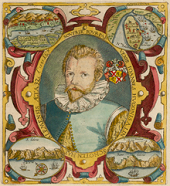






1596 On Jan. 31 the Decrees of Folembray, covering Mayenne, Nemours, and Joyeuse end the War of the Catholic League in France (begun 1588); on Feb. 17 the Duke of Guise enters Marseilles with help from the local pop. in time to stop the Spanish from seizing it, signing an agreement with Philip II on Mar. 24. In the spring Sir Francis Drake's expedition to Panama to divert the Spanish ends with no results to report except the death of Drake on Jan. 29 of dysentery; his crew buries him near Drake's Point on Drake's Island, then scuttles two ships, which are relocated in 2011. I like the way you move? In Mar. English courtier Robert Devereux, 2nd Earl of Essex (1565-1601) (first earl of Sex?), Elizabeth's favorite midnight snack goes from being "the greatest councillor of England, the Queen passing most of the day in private and secret conference with him", to a nat. military hero when he and Lord Charles Howard, 2nd Baron Howard of Effingham are appointed joint cmdrs. of an expedition of 150 ships and 10K men to destroy the Spanish Armada, sinking it and capturing Calais from the Spanish, which they had occupied on May 16, and sacking Cadiz (never ind about that awful dead Dr. Lopez who had said that his private parts suffer from shortcomings?); Sir Walter Raleigh returns from Guiana in time to ask to be appointed supreme cmdr. over them both, but the queen ends up making him rear adm. instead. In the spring Elizabeth I's cousin Henry Carey, first Baron Hunsdon (son of Mary Boleyn) dies, making the queen depressed; there being no Lord Chancellor, she promotes Essex's friend Sir Thomas Egerton to Kord Keeper of the Great Seal, saying that she had begun her reign with a Lord Keeper (Sir Nicholas Bacon, daddy of Sir Francis Bacon) and would end it with one. In June the Spanish merchant vessel San Andreas runs aground in Essex, England, causing William Shakespeare to refer to it in "The Merchant of Venice" when Salarino refers to "my wealthy Andrew docked in sand". In Aug. William Shakespeare's only son Hamnet (b. 1585) dies, and he makes the 2-day journey to Stratford-upon-Avon to see his family; he enters his Age of Histories (1596-99); his daddy John (d. 1601) successfully applies for promotion to the rank of gentleman with a coat of arms, which has a falcon and golden guess what? On Sept. 7 Elizabeth I celebrates her 63rd birthday, which in Tudor times is the grand climacteric year, which most people don't hope to survive. On Sept. 20 the city of Monterrey (Ciudad Metropolitana de Nuestra Señora de Monterrey) in the foothills of the Sierra Madre Mts. in NE Mexico (modern-day pop. 1.1M) is founded by new gov. #1 Diego de Montemayor (1530-1610) as the capital of the state of Nuevo Leon (Sp. "New Lion"). On Oct. 24-26 after capturing the fortress of Erlaus, the Ottomans under new sultan Mehmed III defeat the imperial Hapsburg army at the Battle of Keresztes (Cerestes) in N Hungary in a surprise V just as they were about to defeat them and kick them out of Bulgaria and half of Hungary, but political problems at home start to slow the Ottomans down in their Long War with the Hapsburgs - which is why it is so long? In Oct. after William Shakespeare's application to become a gentleman is denied, his father John Shakespeare is granted the Shakespeare Family Coat of Arms, consisting of "Gould, on a Bend, Sables, a Speare of the first Steeled Argent. And for his creast or cognizaunce a falcon, his winges displayed Argent standing on a wreath of his coullers", i.e., a yellow spear on a yellow shield, with the Latin inscription "Non Sans Droict", meaning "Not without Right". James VI of Scotland endorses the Nat. Covenant again; too bad, he sticks with the divine right of kings theory, arguing with leading Presbyterian churchman Andrew Melville (1545-1622), who calls him "God's sillie vassal" to his face, meaning that God is head of the Scottish kirk ahead of all people incl. him. The North Oxfordshire Uprising of 1596 against the landlords turns out a dud when leader Bartholomew Steere can only find nine followers. Afrasiyab becomes gov. of Basra, founding a dynasty that rules it as a virtually autonomous area until 1668. The Jelali Revolts begin in Anatolia under Ottomon soldier Kara Yaziji (d. 1602) (ends 1610), as unemployed soldiers become brigands. Zaydi imam Qasim leads a large revolt in Yemen (ends 1602). The Magalat Revolt of indios against the Spanish in the Philippines is led by Magalat, a chief of Cagayan. A Spanish-Portuguese expedition from the Philippines invades Cambodia, kills Chinese traders in Phnom Penh, kills the king and burns his palace; Barom Reachea V (Chau Ponhea Tan) (1579-99) becomes king of Khmer. After the Japanese fail to invade Korea, peace is declared between Japan and China. Sir Robert Carey, 1st Earl of Monmouth (1560-1639) succeeds to his father's office of lord warden of the Marches (until Feb. 1598), mopping up the lawless Border Reivers, which had been a nuisance since the late 13th cent. - erin go bragh? The Dutch set up a factory at Palembang in Sumatra. Warsaw (settled in the 11th cent.) becomes the capital of Poland (until 1794). Willem Barents discovers Spitsbergen ("Pointed Mountains") in the Barents Sea; really the largest island in the NW part of Svalbard, discovered in 1194 - sounds like a mirror trick? The Jesuits spread rumors that Theodore Beza and the Church of Geneva have done a Henri IV and returned to the Catholic Church, causing Beza to pub. a witty satire showing he's not an old fart, even though he retires next Jan. with a new 2nd wife, Catharina del Piano of Genoa, his 1st wife of 40 years Claudine having died childless in 1588. Stocky sawed-off future Jamestown founder John Smith (b. 1580) teaches himself swordsmanship, hand-to-hand combat and how to make bombs from clay pots and tar, then leaves England to lead a life of military adventure, fighting as a mercenary in France, the Netherlands and SE Europe, finally getting captured by the Turks in Hungary, who shave his head and rivet an iron ring around his neck; after enduring starvation rations and beatings Smith jumps his master, crushes his skull with a bat, steals his clothes, stuffs the corpse in a haystack and escapes on his horse along the Silk Road, returning to Europe in 1604. Tomatoes are introduced in England. An error in the printed text of a work by William of Malmesbury substitutes "niddering" for "nithing" (coward, wretch), and is later adopted by Sir Walter Scott and popularized. The 1559 Catholic Index of Prohibited Books is made more restrictive, and authorization is withheld for translating or printing Bibles in the vernacular, with all copies found to be destroyed. Sidney Sussex College is founded at Cambridge U. by a bequest from the will of Elizabeth's lady of the bedchamber Frances Radclyffe (nee Sidney), Countess of Sussex (1531-89) on the site of Grey Friars' House, which had been suppressed in 1538, and it becomes the first college at Cambridge to admit Scottish and Irish students, becoming known for its E-shaped bldgs.; its mascot is the blue and gold porcupine, taken from her family coat of arms; Oliver Cromwell is one of the first students, although he never graduates, and later his decapitated head is buried beneath the college chapel. In 1596 English impresario James Burbage (1531-97), father of actor Richard Burbage (1567-1619) purchases the old Blackfriars Theatre in London (founded on the site of a 13th cent. Dominican monastery), whose lease was held in the mid-1580s by well-connected courtier and art patron Edward de Vere, 17th Earl of Oxford (1550-1604), but because of neighborhood pressure he couldn't use it for his company, so in 1599 it ends up being used by the pre-pubescent boys from the Chapel Royal under the name Children of the Chapel, who innovate with artificial lighting and music between acts while successfully charging high prices; in 1608 Burbage finally gets control again, and uses it for winter performances, with the Globe used during the summer; it is demolished on Aug. 6, 1655. Inventions: Galileo Galilei invents the Galilean Thermometer, a sealed glass cylinder containing a clear liquid and a series of objects whose densities sink in sequence as the liquid is warmed and decreases in density - can it be stuck up one's you know what? Windmills are first used in Holland to drive mechanical saws by sawmill owner Cornelis Corneliszoon van of Uitgeest (Krelis Lootjes) (1550-1600), who speeds up the conversion of log timber into planks by 30x. Nonfiction: Anon., Spanish-Christian Christian tract; first book printed in the Philippines. Gaspard Bauhin (1560-1624), Pinax Theatri Botanici; exhaustive account of synonyms used by earlier botanists; introduces genera and species. Tycho Brahe (1546-1601), Epistolae Astronomicae. Andrea Cesalpino (1519-1603), De Metallicis (3 vols.) (Rome); a work on chemistry, mineralogy, and geology, showing a correct understanding of fossils, and anticipating some of the discoveries of Antoine Lavoisier and Rene Just Hauy. Ludolph van Ceulen, Van den Circkel; gives pi to 20 decimal places - 3.14159265358979323846[26]? Sir John Harington (Harrington) (1560-1612), A New Discourse of a Stale Subject, Called the Metamorphosis of Ajax; by a godson of Elizabeth I; punningly describes his invention of the first practical jakes (john) (flush toilet), complete with a water tank above, and a faucetlike handle for flushing, which he built for the queen at her palace in Richmond; the ridicule it draws causes the queen to banish him, deny a patent on grounds of propriety, and remove the stinking contraption, with the smell wafting up through the pipe (it takes until 1775 to figure out to put a curve in the pipe) - get that hairy john out of my bath? Jan Huyghen van Linschoten (1563-1611), Reys-gheschrift vande navigatien der Portugaloysers in Orienten (Itinerario) (Travel Accounts of Portuguese Navigation in the Orient) (English trans. "Iohn Huighen van Linschoten his Discours of Voyages into ye Easte & West Indies" pub. in 1598); details of his travels in the East Indies, with the first maps of the area, esp. India, obtained by ripping-off the secret charts of his patron the Portuguese viceroy, allowing the English and Dutch to learn the passage through the Malacca Strait via the Sunda Strait, enabling them to set up the British East India Co. and the Dutch East India Co. to break the Portuguese monoply; contains descriptions of tea drinking in Japan: "Their manner of eating and drinking is: everie man hath a table alone, without table-clothes or napkins, and eateth with two pieces of wood like the men Chino: they drink wine of Rice, wherewith they drink themselves drunke, and after their meat they use a certain drinke, which is a pot with hote water, which they drink as hot as ever they may indure, whether it be Winter or Summer... The aforesaid warme water is made with the powder of a certaine hearbe called Chaa, which is much esteemed, and is well accounted among them." Giovanni Antonio Magini (1555-1617), Geographiae Universae tum Veteris, tum Novae Absolutissimum Opus (2 vols.); atlas. Father Robert Persons (1546-1610), Memorial for the Reformation of England; Jesuit priest thinks out how England can return to the True Catholic Faith. Georg Joachim Rheticus (1514-76), Opus Palatinum de Triangulus (Trigonometric Tables) (posth.); completed by his student Valentin Otto; 100K data items with 10-decimal accuracy, used into the early 20th cent. - worked so hard that even Rainman would puke? Edmund Spenser (1552-99), A View of the Present State of Ireland; explains the ancient Irish Celtic Brehon Laws, where the hereditary brehons (judges) hold court in the open air seated upon sods. Poetry: Sir John Davies (1569-1626), Orchestra, or A Poem of Dancing, Judicially proving the true observation of time and measure in the authentical and laudable use of dancing; Gullinge Sonnets. Michael Drayton (1563-1631), Mortimeriados (about the Baron's Wars); Robert, Duke of Normandy. George Peele (1556-96), An Eclogue Gratulatory, Addressed to the Renowned Shepherd of Albion's Arcadia, Robert, Earl of Essex. Edmund Spenser (1552-99), The Faerie Queene, Books 4-6; Book 5 features the execution of Duessa, based on Mary, Queen of Scots; Book 6 features Sir Calladore fighting the Blatant Beast. Plays: William Shakespeare (1564-1616), The Merchant of Venice (tragi-comedy) (anti-Semitic?) (1596-8); written to capitalize on the success of Christopher Marlowe's 1592 play "The Jew of Malta"; Shylock the Jew and his daughter Jessica, her lover Lorenzo, servant Launcelot, rich heiress Portia, merchant Antonio and his friend Bassanio (Portia's beau); the name Jessica (the original Jewish American princess?) is invented for the play; a rich Jew lends 3K ducats with the surety being a pound of Antonio's flesh (to get even for all his mistreatment), but it backfires bigtime; "Your mind is tossing on the ocean" (1.1.8); "You have too much respect upon the world:/ They lose it that do buy it with much care" (1.1.74); "What news on the Rialto?" (1.3.34); "The devil can cite Scripture for his purpose" (1.3.99); "But love is blind, and lovers cannot see/ The pretty follies that themselves commit" (2.6.36); "Young in limbs, in judgment old" (2.7.71); "Here are a few of the unpleasant'st words that ever blotted paper" (3.2.252); "I am not bound to please thee with my answers" (Shylock) (4.1.65); "The quality of mercy is not strain'd,/ It droppeth as the gentle rain from heaven/ Upon the place beneath: it is twice bless'd" (4.1.184-6); "To do a great right, do a little wrong" (4.1.216); "He is well paid that is well satisfied" (4.1.416); "How sweet the moonlight sleeps upon this bank!/ Here will we sit, and let the sounds of music/ Creep in our ears" (5.1.54-6); Henry IV, Pt. 1 (1596-7) (history); Henry IV of England, his son Prince Hal, Hotspur (Henry Percy) (son of the earl of Northumberland), Sir John Falstaff, Welsh rebel Owen Glendower, English rebel Edmund Mortimer, Scottish rebel Earl of Douglas; "Sink or swim" (1.3.194); "I am not in the roll of common men" (3.1.43); "He was but as the cuckoo is in June,/ Heard, not regarded" (3.2.75); "My nearest and dearest enemy" (3.2.123); "The better part of valor is discretion" (5.4.130); "I have more flesh than another man, and therefore more frailty" (3.3.187); "The very life-blood of our enterprise" (4.1.28); Henry IV, Pt. 2 (1596-7) (history) (Falstaff has a total of 1,178 lines in Pts. 1 & 2); "It was always yet the trick of our English nation, if they have a good thing, to make it too common" (1.2.244); "He hath eaten me out of house and home" (2.1.82); "Let the end try the man" (2.2.53); "Is it not strange that desire should so many years outlive performance?" (2.4.283); "Uneasy lies the head that wears a crown" (3.1.31); "O God! that one might read the book of fate" (3.1.45); "There is a history in all men's lives" (3.1.80); "A man can die but once; we owe God a death" (3.2.253); "We see which way the stream of time doth run/ And are enforc'd from our most quiet sphere/ By the rough torrent of occasion" (4.1.70); "The wish was father, Harry, to that thought!" (4.5.91); "Before thy hour be ripe" (4.5.95); "Commit the oldest sins the newest kind of ways" (4.5.124); "His cares are now all ended" (5.2.3); "How ill white hairs become a fool and jester!" (5.5.52). Art: Michelangelo da Caravaggio (1571-1610), The Fortune Teller; Cupid with Arrows; Basket of Fruit. Lavinia Fontana (1552-1614), The Monkey Girl; portrait of Tognina Gonzales, daughter of Petrus Gonzales of the Canary Islands, whose family have hypertrichosis. Births: Dutch landscape painter Jan Joseph (Josephszoon) van Goyen (d. 1656) on Jan. 13 in Leiden; studies in Haarlem, then sets up his studio in The Hague at age 35; known for cranking them out quick and dirty to make more bucks. French "Meditations on First Philosophy" philosopher-mathematician-soldier (Roman Catholic) (Rosicrucian) ("Father of Modern Philosophy") (founder of analytic geometry) Rene (René) Descartes (d. 1650) (Renatus Cartesius) on Mar. 31 in La Haye en Touraine, Indre-et-Loire; author of the dictum "Cogito ergo sum" (Je pense donc je suis); does much of his thinking in and around the battlefields of Europe. Swedish field marshal Johan Baner (Banér) (d. 1641) on June 23 in Djursholm Castle; father and uncle are beheaded for treason in 1600 for supporting Sigismund I. Japanese emperor #108 (1611-29) Go-Mizunoo (Masahito) (d. 1680) on June 29; 3rd son of Go-Yozei (1572-1617). Russian Romanov tsar (1613-45) Michael (Mikhail Fyodorovich) I (d. 1645) on July 22 (July 12 Old Style) in Moscow; son of Feodor Nikitich Romanov (Patriarch Filaret) and Xenia (Great Nun Martha); nephew of Feodor I. Bohemian "Winter Queen" (1619-20) and Bavarian electress Palatine (1610-20) ("the Queen of Hearts") Elizabeth Stewart (Stuart) Bohemia (d. 1662) on Aug. 19 in Falkland Castle, Fifeshire, Scotland; eldest daughter of James VI of Scotland and Anne of Denmark; named to flatter Elizabeth I; wife (1613-) of Frederick V, Elector Palatine (1596-1632); mother of Palatine Elector Charles I Louis and Sophie of Hanover (1630-1714), mother of George I of England and founder of the English Hanover Dynasty. Bohemian "Winter King" (1619-29) and Bavarian elector Palatine (1610-23) Frederick (Friedrich) V (d. 1632) on Aug. 26 in Amberg; son of elector Frederick IV and Louisa Juliana (daughter of Prince William the Silent or Orange); husband (1613-) of Elizabeth Stewart (1596-1662). English dramatist ("last of the Elizabethans") James Shirley (d. 1666) on Sept. 18 in London; son of Sir Thomas Shirley (1564-1620). Italian Baroque painter-architect Pietro (Berrettini) da Cortona (d. 1669) (b. 1597?) on Nov. 1 in Cortona, Tuscany. Italian violin maker (luthier) Nicolo Amati (d. 1684) on Dec. 3 in Cremona; the most eminent of the Amati; son of Girolamo Amati (1551-1635); grandson of Andrea Amati (1505-78); father of Girolamo Amati (Hieronymus II) (1649-1740); teacher of Antonio Stradivari and Andrea Guarneri. Italian gen. Thomas Francis of Savoy, Prince of Carignano (d. 1656) on Dec. 21 in Turin; youngest son of Charles Emmanuel I of Savoy (1562-1630) and Catherine Michelle of Spain (1567-97), daughter of Philip II (1527-98) and Elisabeth of Valois (1545-68); founder of the Savoy-Carignano branch of the House of Savoy, which rules Sardinia in 1836-61, and Italy in 1861-46. Swiss Grisons leader George (Georg) (Jorg) (Jurg) (Jörg) (Jürg) Jenatsch (d. 1639) in Samedan. Russian tsar (1613-45) (founder of the Romanov Dynasty) Michael (Mikhail) I Fyodorovich Romanov (Romanoff) (d. 1645) on July 12 in Moscow; son of Patriarch Filaret (Feodor Nikitich Romanov) and Martha the Great Nun (Xenia); father of Alexis I (1629-76). Dutch poet-composer Sir Constantijn Huygens, Lord of Zuilichem (d. 1687) on Sept. 4 in The Hague; father of Christiaan Huygens (1629-95). Flemish Jesuit writer Jean de Bolland (d. 1665) in Tirlemont. Am. Puritan minister Richard Mather (d. 1669) in London, England; emigrates to the New england in 1635; father of Increase Mather (1639-1723); grandfather of Cotton Mather (1663-1728). Deaths: English lord chamberlain (1585-96) Henry Carey, 1st baron Hunsdon (b. 1526) on July 23. Italian agronomist Giovan Vettorio Soderini (b. 1526) on Mar. 3 in Volterra. Italian artist Pellegrino Tibaldi (b. 1527) n Milan. English MP Peter Wentworth (b. 1530) on Nov. 10. French political philosopher Jean Bodin (b. 1530) (plague); leaves Method for the Easy Understanding of History; "Of history, that is, the true narration of things, there are three kinds, human, natural and divine". Dutch composer Giaches de Wert (b. 1535). French lawyer-scholar Pierre Pithou (b. 1539) on Nov. 1 in Nogent-sur-Seine. English heir (to Elizabeth I) Lady Margaret Stanley, Countess of Derby (b. 1540) on Sept. 28. French poet Florent Chrestian (b. 1541) on Oct. 3. Japanese samurai Hattori Hanzo (b. 1542) on Dec. 23 in Edo (KIA). English adventurer Sir Francis Drake (b. 1545) on Jan. 29 in Panama (dysentery); buried at sea. German landgrave George I of Hesse-Darmstadt (b. 1547) on Feb. 7 in Darmstadt. English poet-dramatist George Peele (b. 1556) in Oct.-Nov.; leaves The Beginnings, Accidents, and End of the Fall of Troy.

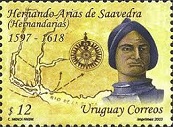


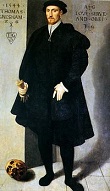
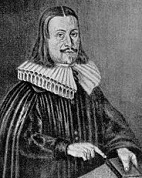
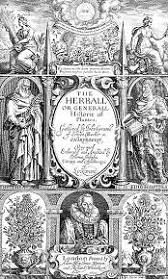
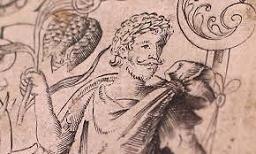
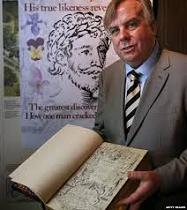

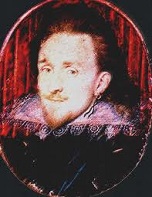



1597 On Feb. 5 the town of San Nicolas (Nicolás) de los Garza in NE Mexico near Monterrey is founded. On June 5 Robert Devereux, 2nd Earl of Essex (1565-1601) fails in an expedition to intercept the Spanish treasure fleet off the Azores, and loses his fortune and the queen's favor. On Mar. 19 Japan tries to conquer Korea for a 2nd time after the Chinese insult Hideyoshi by calling him king instead of emperor; in Aug. Hideyoshi and his son Hideyori amuse themselves with an elephant provided by the Spanish; on Aug. 28 after Korean adm. Ri Sun Shin is tortured and demoted for ignoring a message to meet the approaching Japanese fleet (thinking the area has hazardous rocks?), and is replaced with his rival adm. Won Gyun (Kyun) (1540-97), the naval Battle of Chilcheollyang on a narrow strait near Geoje Island becomes the only naval V for the Japanese in the Imjin War (begun 1592), with 500-1K Japanese ships surprising and defeating 169 turtle Korean ships, destroying 157 of them after inept Won Gyun makes all the wrong moves, and Adm. Bae Seol chickens out of this yang hell and runs with his 12 turtle ships; on Aug. 27 Korean adm. Yi Eok-gi (b. 1561) and adm. Won Gyun are killed after landing on a nearby island and stumbling into a fort filled with Japanese soldiers; after the battle, which destroys the Korean navy, adm. Ri Sun Shin is quickly reinstated, and is put in charge of the 12 ships and 200 men that had fled the battle of Chicken Hell Yang, redeeming himself on Oct. 26 by winning the naval "Miracle" Battle of Myongnyang (Myeongyang), defeating 133 Japanese ships and saving the war; Hideyoshi orders the crucifixion of Jesuits, and orders Christian missionaries to leave Japan, but backs off for fear of losing Portuguese trade. On Apr. 13 Baron Klas Fleming of Finland is killed, ending the Swedish Civil War (begun 1595); too bad, Duke Charles stinks himself up by defiling his body? On Oct. 15 Bavarian Wittelsbach duke-elector (since Oct. 24, 1579) William V the Pious (1548-1626) abdicates in favor of his son Maximilian I (the Great) (1573-1651), who becomes duke of Bavaria (until Feb. 25, 1623), followed by elector Palatine (until Oct. 24, 1648) and elector of Bavaria (until Sept. 27, 1650), then retires to a monastery, leaving his son to become great trying to handle the 30 Years' War (1618-48) and prevent Germany from becoming the battleground of Europe? The Spanish conquer the fortress town of Amiens (capital of Picardy) on the Somme River, 72 mi. N of Paris (until 1598). Philip II opens peace talks with Henri IV. Upper Austria is re-Catholicized by force - drop that Bible and kiss this crucifix? The Persians under Shah Abbas I defeat the pesky Uzbeks near Herat, and drive them over the Oxus River. The Christians under Michael the Brave decisively defeat the Muslim Ottomans at the Battle of Targoviste in Romania. Asuncion, Paraguay-born Hernando Arias (Hernandarias) de Saavedra (1561-1634) becomes gov. of Rio de la Plata (until 1599, then 1602-9), becoming the first person born in the Americas to become govt. of a New World Euro colony; in 1615-17 he becomes gov. of Paraguay. English privateer Sir Francis Drake lands in San Francisco Bay and conducts the first Anglican service in North Am. The Spanish city of Perpignan, 40 mi. S of Narbonne and 100 mi. N of Barcelona (last major town in Languedoc before the Spanish border) is sieged by the French. Convicted witches Bessie Thom and Christen Mitchell are executed in Aberdeen, Scotland; on Mar. 8, 2022 (Internat. Women's Day) the Scottish govt. formally apologizes for all its witchcraft trials. An English act of Parliament prescribes sentences of transportation to colonies for convicted criminals. English merchants are expelled from the Holy Roman Empire in retaliation for English treatment of the Hanseatic League in London. The first field hospitals and dispensaries appear in Europe. Gresham College is founded in Bishopsgate, London by a bequest from the will of wealthy merchant Sir Thomas Gresham (1519-79), founder of the Royal Exchange, establishing seven professorships (astronomy, divinity, geometry, law, music, physic, rhetoric), each who receive £50 a year to give six public lectures; early professors incl. Christopher Wren (astronomy) and Robert Hooke (geometry); in 1663-1710 it houses the Royal Society; in 1842 it moves to Gresham St., followed in 1991 to Barnard's Inn Hall in Holborn; in 1985 a professorship is added in commerce, followed in 2014 by environment, and in 2015 in info. technology. The Puritan-influenced English Council closes down theaters on the ground that they are hotbeds of subversive govt., but Elizabeth I makes them rescind their order. Playwright Ben Jonson volunteers to fight in Flanders, and kills a man in single combat. Love's Labour's Lost became the first play pub. under William Shakespeare's name; financially fixed, he buys the timber-brick New Place on Chapel St. for £60 from William Underhill, "a praty howse of brike and tymbar" (John Leland, Itinerary, 1540) (with 10 fireplaces), the 2nd largest house in Stratford-upon-Avon, built in 1486 by future lord mayor of London (1491-) Sir Hugh Clopton (1440-96) (demolished in 1759); meanwhile widowed brain babe (poet, scholar, theologian) Mary Sidney Herbert, Countess of Pembroke (1561-1621) (brother of Sir Philip Sidney) meets Shakespeare in her estate at Wilton, commissioning him to write 17 sonnets to persuade her son William Pembroke, 3rd Earl of Pembroke (1580-1630) to marry, after which she moves to London, while they become secret lovers until something makes one of them pub. the sonnets, messing Shakespeare up after he's afraid to be outed and the public hates them?; is she the real author of the First Folio, her connections to executed traitor Lady Jane Grey and her gender causing her to have to use him as her front - stay tuned? Aldine Press in Venice (founded 1494) ceases pub. after 908 works. Architecture: The Bridge of Sighs, designed by the same architect who did the Rialto Bridge (1591) is built in Venice across the narrow Rio della Paglia canal, connecting the Carceri (prison) with the Palace of the Doges (court) - don't ask? St. Michael's Church in Munich (begun 1585), designed by Italian-Dutch painter-architect Friedrich Sustris (1540-99) is finished, becoming a spiritual center of the Counter-Reformation. The Yeni Valide Mosque, in Istanbul, the last mosque to be built in the Ottoman imperial style is begun under Sultan Safiye; too bad, it costs so much that the Janissaries begin to grumble, and after her death it grinds to a halt, and is not finished until 1663; another one is built in 1708-10 by Sultan Ahmed III in honor of his mother Emetullah Rabi'a Gulnus Sultan. Inventions: Galileo Galilei develops the first proportional (sector) compass. Music: Orazio Vecchi (1550-1605), L'Amfiparnasso (Modena). Art: El Greco (1541-1614), St. Martin and the Beggar (1597-9). Nonfiction: Sir Francis Bacon (1561-1626), Essays, Civil and Moral, Vol. 1; describes the process of inductive reasoning, reversing Aristotle and his process of deductive reasoning, becoming the beginning of formal scientific thought in Europe. Nicholas Breton (1545-1626), Wit's Trenchmour. Theodor de Bry (1528-98), Icones Quinquaginta Virorum Illustrium; heraldic emblems. John Dowland (1563-1626), First Booke of Songes. John Gerard (1545-1612), The Herball, or Generall Historie of Plantes; 1,484 pages; England's best known herbal; mentions Carolus Clusius in 1585 but not Raleigh in 1586 concerning potato cultivation in Europe; the title page has an engraving by William Rogers; in May 19, 2015 historian Mark Griffiths announces that it contains the only true portrait of William Shakespeare, at his prime (age 33). Richard Hooker (1554-1600), Laws of Ecclesiastical Polity, Vol. 5; written in Bishopsbourne, Kent. James VI/I (1566-1625), Daemonologie; Andreas Libavius (1555-1616), Alchymia; the first systematic chemistry textbook; describes the use of chemistry for drugs, acknowledging the possibility of transmutation; describes how ammonia turns cuprous salt solutions dark blue; first to claim that fermentation and putrefaction are different processes, and to describe a method for distilling alcohol; describes how to make many useful chemicals such as hydrochloric acid and ammonium sulphate. Thomas Morley (1557-1602), A Plaine and Easie Introduction to Practicall Musick. Jean de Serres, Inventaire General de l'Histoire de France. Plays: Ben Jonson (1572-1637) and Thomas Nashe (1567-1601), The Isle of Dogs (first play); suppressed for sedition after a performance in July. John Lyly (1553-1606), The Woman in the Moone. William Shakespeare (1564-1616), The Merry Wives of Windsor (1597-8) (Falstaff has 436 lines, which would make his the role with the most lines if the 1,178 from "Henry IV, Pts. 1&2" are added); Falstaff, Master Ford and Mistress Ford, Master Page and Mistress Anne Page, Fenton, Doctor Caius, Sir Hugh Evans, Master Slender, Justice Shallow; "In despite of the teeth of all rhyme and reason, that they were fairies" (Falstaff) (5.5.126-7). Novels: Thomas Deloney (1543-1600), Jack of Newbury; one of the first English novels to depict the life of the common people, clothiers (tailors). Births: French poet-writer Vincent Voiture (d. 1648) on Feb. 24 in Amiens; son of a rich merchant. Sicilian priest-astronomer Giovanni Battista Hodierna (d. 1660) on Apr. 13. Dutch dir.-gen. of New Netherland (1638-47) Willem Kieft (d. 1647) in Sept. in Amsterdam. German #1 poet Martin Opitz von Boberfeld (d. 1639) on Dec. 23 in Bunzlau, Lower Silesia. English "A Mouzell for Melastomus" feminist poet-polemicist (first woman) (Calvinist) Rachel Speght (d. 1622). English Anglican clergyman Thomas Gage (d. 1656); brother of Sir Henry Gage (1597-1645); educated at the College of St. Omer, and English College, Vallidolid; starts out a Dominican friar then converts to Anglicanism in 1642. Dutch painter Jacob Jansz van Velsen (d. 1656). German celeb's father Friedrich Leibniz (d. 1652) in Altenburg; son of Ambrosious Leibniz and Anna Deuerlin; father of Gottfried Wilhelm von Leibniz (1646-1716); eucated at the U. of Leipzig. English Parliamentarian soldier Sir William Waller (d. 1668) in Knole House, Sevenoaks, Kent; educated at Magdalen Hall, Oxford U.; son of Sir Thomas Waller; cousin of Sir Hardress Waller (1604-66); knighted in 1622; inventor of the idea of the New Model Army. English physician-anatomist Francis Glisson (d. 1677) (b. 1599?) in Bristol; grows up in Rampisham, Dorset; educated at Caius College, Cambridge U. Deaths: Italian painter Prospero Fontana (b. 1512). German Counter-Reformation Jesuit theologian (St.) Peter Canisius (b. 1521) on Nov. 21 in Fribourg. English MP William Brooke, 10th baron Cobham (b. 1527) on Mar. 6. Italian philosopher-scientist Franciscus Patricius (b. 1529) on Feb. 6 in Rome. German organist-composer Elias Nikolaus Ammerbach (b. 1530). Spanish architect Juan de Herrera (b. 1530). Italian duke of Ferrara (1559-97) Alfonso II d'Este (b. 1533) on Oct. 27 in Ferrara. Spanish poet ("El Divino") Fernando de Herrera (b. 1534). Finnish adm. baron Klaus Fleming (b. 1535) on Apr. 13 in Pohja. Indian maharana of Mewar (1572-97) Pratap Singh I (b. 1540) on Jan. 29 (hunting accident). Dutch navigator Willem Barents (b. 1547) on June 20 on the Barents Sea near Novaya Zemlya, Russia. Austrian mother (of Don John of Austria) Barbara Blomberg (b. 1527) on Dec. 18 in Ambrosero, Cantabria, Spain. Italian printer Aldus Manutius the Younger (b. 1547).

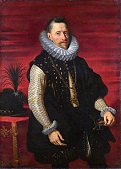











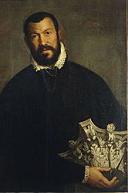


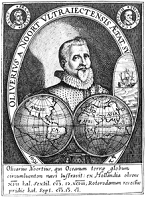


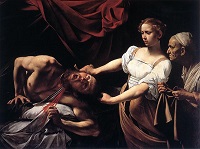
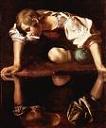
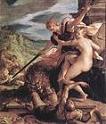
1598 On Jan. 7 tsar (since 1584) Fyodor I the Ding-Dong, er, Bellringer (b. 1557) dies, and Boris Godunov (1551-1605) seizes the throne (until Apr. 13, 1605), and is formally elected tsar of Russia by the Zemsky Sobor (nat. assembly); the Rurik Dynasty in Russia comes to an end, and the Time of Troubles begins (ends 1613) as the lack of an heir to the throne leaves it open to invasion by Swedish and Polish armies, while Cossack bands run riot, slaughtering officials and nobles; Godunov banishes the Romanovs, attempts to Westernize Russia, and strengthens commerce while running a spy service with a horde of informers; the Russian Orthodox Church is established. You Anglos can take Plymouth Rock and? Early in the year Zacatecas, Mexico-born Spanish conquistador Don Juan de Onate (Oñate) Salazar (1550-1626) leads a Spanish expedition of 400 colonists under royal patent to subjugate New Mexico and establish a permanent colony on the Rio Grande River; after five waterless days crossing the desert, he finds the Rio Grande Valley near present-day San Elizario, Tex. (20 mi. SE of El Paso), calling it "the Elysian field of happiness", and on Apr. 30 claims the land drained by the Rio Grande River in the name of King Philip II, holding a Mass and celebration which becomes known as the "First Thanksgiving in the U.S."; an 83-wagon train with 7K livestock then continues upriver, crossing at the site of modern-day El Paso; on May 21 they bury Pedro Robledo at the site of modern-day Mt. Robledo, then explore the 90-mi. Jornada del Muerto (Dead Man's Route) to the N, running out of water and losing many colonists, until they see a dog with a wet muzzle and follow him to modern-day Perillo (Los Charcos del Perillo) ("The Pools of the Little Dog"); he stops at a Piro Indian pueblo N of San Antonio, receiving corn from them, causing him to name the pueblo Socorro (Sp. "help") (alt. 4,579 ft.), and two priests are dropped off, who raise the first grapes in New Mexico; on July 11 Onate reaches modern-day Espanola, an Indian pueblo N of modern-day Santa Fe, and founds San Gabriel del Yunque, which becomes the first capital of New Mexico, with himself as gov. of Santa Fe de Nuevo Mexico; next Jan. 22-24 the Acoma Uprising (Massacre) (Battle of Acoma Pueblo) is caused by his troops demanding supplies they need to survive the winter, which causes them to kill 13 Spaniards, and in retaliation next Jan. 22-24 Onate orders the murder of 800 villagers, and amputates the left foot of each of the remaining 80 men over age 25, then enslaves the remaining 500 women and children. Can't we all just get along? On Apr. 30 Henri IV of France signs the Edict of Nantes, granting Protestant Huguenots the right to have their own fortified towns and to pray in selected locations, ending the Huguenot-Catholic civil wars in France (begun 1562); too bad, the French parliament resents it and doesn't recognize it until 1600, and after they get in the way of the absolutists Louis XIII and Louis XIV it is revoked in 1685, and Huguenot ass is grass in France? In Apr. Sigismund Bathory separates from his wife Christina of Austria, resigns as prince of Transylvania in favor of HRE Rudolf II in order to take holy orders, then in Oct. reneges and gives it to his cousin Cardinal Andrew Bathory (1563-99) (a grandmaster of the Order of the Dragon), which is approved by the Polish-Lithuanian Commonwealth, pissing-off the Hapsburgs, who recruit Michael the Brave to kick his butt. On May 2 the Treaty (Peace) of Vervins (Aisne) ends the 8th and last French War of Religion with Spain (begun 1592), with withdrawal of Spanish troops from France; Philip II resigns his claim to the French crown before croaking on Sept. 13 in Madrid, and France is united under Henri IV; on May 6 Roman Catholic archbishop Albert VII of Austria (1559-1621) (son of HRE Maximilian II) becomes Hapsburg gov. of the Netherlands (until July 13, 1621). On July 2 Dutch merchant Olivier van Noort (1558-1627) leaves Rotterday with four ships to attack Spanish possessions in the Pacific and trade with China and the Spice Islands, sailing through the Magellan Strait, losing two ships and capturing several Spanish ships along the Pacific Coast of South Am., fighting a naval battle off Fortune Island on Dec. 14, 1600 and sinking Spanish galleon San Antonio (their flagship) while losing the Eendracht, causing him to return to Rotterdam via the future Dutch East Indies and the Cape of Good Hope on his last ship Mauritius with 45 of 248 men, landing on Aug. 26, 1601 and barely breaking even, becoming the first circumnavigation of the Earth by a Dutchman, turning the Dutch on to returning bigly, er, big league. On Aug. 4 William Cecil, Lord Burghley (b. 1520) dies at age 78, leaving his son Robert Cecil (1563-1612) as secy. of state (lord privy seal) (until May 24, 1612), starting out a clever guy with none of his daddy's tact and experience? On Aug. 14 Irish forces under Irish "Erin go Bragh" freedom fighter Hugh O'Neill, 2nd Earl of Tyrone (1550-1616) ambush the stankin' English under Irish marshal Sir Henry Bagenal (b. 1556) at the Battle of the Yellow Ford near the Blackwater River in Ulster, and annihilate them, killing or wounding 1.2K English troops, which leaves English-held territory down to Dublin undefended; in return for sparing the remnant of Bagenal's army locked up in the Cathedral of Armagh, Tyrone is given Armagh and Portmore Fort on the Blackwater River, which becomes the home of the O'Neills; FitzGerald Land, an English colony in Ireland backed by Elizabeth is destroyed, pissing her off and convincing her that she needs to conquer Ireland once and for all; her favorite Robert Devereux, 2nd Earl of Essex (1565-1601) talks her into making him head of the English campaign against the Irish and Spanish as Lord Deputy of Ireland, commanding the largest force in Elizabeth's reign (16K infantry, 13K cavalry); the Spanish promise to help the Irish, but take till 1601, too little too late? On Sept. 13 to the great relief of the English and the Huguenots, after 50 days of intense pain Spanish king (since Jan. 16, 1556) Philip II (b. 1527) dies, covered with stinking, putrefying sores and with a lead coffin placed by his orders at his bedside, and his 20-y.-o. son Philip III (the Pious) (1578-1621) becomes king of Spain, plus (as Philip II) king of Portugal, Naples, Sicily, and the Netherlands (until Mar. 31, 1621); a weak pious whimp, he entrusts the conduct of public affairs to Francisco Gomez (Gómez) de Sandoval y Rojas, 1st Duke of Lerma (1553-1625) while he has fun with religious observances and court festivities and stays away from realities; meanwhile his ministers try to get Spain out of the European wars while it licks its stinking, putrefying wounds; the glory of Spain is never again what it once was, but the Spanish do a good job of hiding it for some time because it's only been a cent. since Columbus? On Sept. 18 Japanese ruler Toyotomi Hideyoshi (b. 1537) dies at Fushimi Castle, and his troups withdraw from Korea; on Dec. 16 the naval Battle of Noryang Sea sees 300 of 500 Japanese ships attempting to break out of a blockade destroyed or captured by 150 Korean and Chinese ships under Korean adm. Ri Sun Shin and Ming Chinese adm. Chen Lin (1543-1603), killing or wounding 12K-15K Japanese, with only 270 Korean and 400 Chinese casualties; too bad, Ri Sun Shin takes a Japanese bullet and is KIA while trying to rescue Chen Lin, who let his ship get too close to the front line and gts surrounded, after which his men conceal his death to keep the troops fighting, his nephew Yi Wan wearing his armor; on Dec. 24 the last Japanese troops evacuate Korea, ending the Ishin (Seven Years') War (begun 1592); Hideyoshi's 5-y.-o. son Toyotomi Hideyori (1593-1615) succeeds him under a council of regents led by Tokugawa Ieyasu (1543-1616), who restores the shogunate (until 1867). In the fall Michael the Brave leds a Wallachian army into N Bulgaria, triggering the First Tarnovo Uprising of the Christian Orthodox Bulgarians against the Muslim Ottoman Turks; Bulgarian tsar Shishman III is proclaimed, and the capital Tarnovo is liberated, only to see the Ottomans send an army to crush the uprising, causing 16K Bulgarians to flee to Wallachia. On Dec. 11 (night) Salzburg Cathedral in Austria is devastated by a fire, after which prince-archbishop Wolf Dietrich Raitenau hires Italian-born Venetian architect Vincenzo Scamozzi (1548-616) to lavishly rebuild it in Baroque style. On Dec. 24 Margaret Stewart is born to James VI and Anne of Scotland; she dies next year. Pope Clement VIII takes advantages of the demise of the House of Este to seize the duchy of Ferrara. French "Huguenot pope" Philippe de Mornay, Seigneur du Plessis Marly (1549-1623) gets in a dogma dispute with Jacques Davy Duperron (1556-1618), Roman Catholic bishop of Evreux (since 1591) (who was raised a Calvinist then converted to Roman Catholicism after studying St. Augustine and St. Thomas Aquinas), culminating in a big public debate in 1600 in Fontainebleau, which he wins, getting created cardinal on June 9, 1604 by Pope Clement VII and becoming their poster boy. Elizabeth I authorizes privateers from Guernsey to attack French ships. The Dutch capture Mauritius from the Portuguese (until 1705), and name it in honor of stadholder Maurice of Nassau. The Agreement (Bond) (House Treaty) of Gera (in Thuringia) between the branches of the Hohenzollern family defines mutual succession, requring the elector of Brandenburg to inherit the entire and undivided mark (AKA the indivisibility of the Mark of Brandenburg); it is ratified next Apr. 29 in Magdeburg. The Steelyard, the London HQ of the Hanseatic League (founded 1282) is closed after the City of London gets jealous; James I later reopens it, but it never recovers. English geographer Richard Hakluyt (1552-1616) begins pub. his 3-vol. Principal Navigations, Voyages, Traffics, and Discoveries of the English Nation, talking about how "valiant youths rusting [from] lack of employment" could flourish in America and create industry that "would yield unto us all the commodities of Europe, Africa and Asia", or better yet, discover gold. The Sable Island colony of Nova Scotia is founded, becoming known for horses and shipwrecks. The 400-mi. Camino Real ("royal road") in New Mexico from El Paso to Santa Fe is built, seeing a motley crew of conquistadors, colonists, friars, traders and soldiers for the next four cents. Henri IV reorganizes the U. of Paris. Sir Thomas Bodley (1545-1613) begins rebuilding the library at Oxford. The original I love my couch dot com? Ben Jonson kills Gabriel Spencer (an actor in Henslowe's co.) in a duel, and is saved from the gallows by "benefit of clergy", i.e., by proving his literacy in Latin by reading some "neck verse" to gain immunity; it also helps that he claims to have converted to Roman Catholicism. German traveler Paul Hentzner claims to have seen a unicorn horn among Queen Elizabeth I's crown jewels, which is valued at $500K; it is actually the tusk of a narwhal. The flightless Dodo Bird (Portuguese "doudo" = "foolish") (Raphus cucullatus) is discovered on the island of Mauritius by the Dutch after they occupy it; it becomes extinct by 1681. Italian composer Gabriele Fattorini becomes the first to use the new technique of Basso Continuo (figured bass) idiomatically - for English, say yes? Peter Paul Rubens becomes a member of the Antwerp painters guild of the Brotherhood of St. Luke. Inventions: Cornelius (Cornelis) Drebbel (1572-1633) of Holland receives a patent for a pump and clock that operates by perpetual motion powered by atmospheric changes, causing him to become a star in scientific circles. Fruit Fool (pureed fruit, whipped cream, sugar, rose water) is first mentioned as a desert; gooseberry fool becomes the most popular. Nonfiction: Robert Barret, The Theorike and Practike of Moderne Warres. Tycho Brahe (1546-1601), Astronomicae Instauratae Mechanica; his instruments and discoveries. John Florio (1553-1625), A World of Wordes; English-Italian dictionary; expanded ed. pub. in 1611. James I (1566-1625), Basilikon Doron; or, His Majesties Instructions To His Dearest Sonne, Henry the Prince; The True Law of Free Monarchies; or, The Reciprocal and Mutual Duty Betwixt a Free King and His Natural Subjects; the Divine Right of Kings theory; how kings are appointed by and only answerable to God, and hence should head the church and state both; Henri IV of France later calls him "the wisest fool in Christendom", because "he never said a foolish thing and never did a wise one", even though he is a top scholar. Barthelemy de Laffemas (1545-1612), Barthelemy (Barthélemy) de Laffemas (1545-1612) pub. Treasures and Riches to Put the State in Splendor; denounces those who pooh-pooh the purchase of French silks because the industry gives the poor a livelihood, becoming the first pub. of Underconsumption Theory, which is later taken up and refined by John Maynard Keynes. John Manwood, Treatise on the Laws of the Forest. Philibert Mareschal, Le Guide des Artes et Sciences. Francis Meres, Palladis Tamia; anthology of quotations from 125 English writers, listing Shakespeare, Ben Johnson, and Thomas Kyd as "our best for tragedy". Philippe de Mornay (1549-1623), De l'Institution, Usage et Doctrine du Saint Sacrement de L'Eucharistie en l'Eglise Ancienne; contains 5K citations from the Bible, Church Fathers, and schoolmen; Jacques Davy du Perron accuses him of 500 misquotes, causing the Fontainebleau Debate in 1600. Carlo Ruini, Dell' Anatomia e Dell' Infirmita de Cavallo, e Suoi Remedii; manual on veterinary science. John Stow (1524-1605), A Survey of London; 2nd ed. 1603; claims that there are 26 "beerhouses" in London, most located along the Thames River between St. Katharine's Hospital and Fleet St. Art: Hans von Aachen (1552-1615), The Triumph of Justice (Allegory). Jan Brueghel the Elder (1568-1625), Adoration of the Kings. Michelangelo Caravaggio (1571-1610), Narcissus; Judith Beheading Holofernes (1598-9). El Greco (1541-1614), Cardinal Don Fernando Nino de Guevara. Music: Jacopo Peri (1561-1633), Dafne (Paris); the first opera; libretto by Ottavio Rinuccini (1562-1621). Plays: Thomas Dekker (1570-1632), The Pleasant Comedy of Old Fortunatus. Ben Jonson (1572-1637), Every Man in His Humour (Curtain Theatre, London); performed by the Lord Chamberlain's Men, incl. Shakespeare; chars. represent the humours (physical-mental dispositions) of ancient physiology and psychology; his first success; The Case is Altered. William Shakespeare (1564-1616), Much Ado About Nothing (1598-9) (comedy) (a pun on Much Ado About an O Thing, i.e., vagina, and Noting, i.e., overheard gossip?); Prince Don Pedro of Arragon and his bastard brother Don Juan, Gov. Leonato of Messina and his niece Beatrice and her lover Benedick (bent his what on an O thing?), Leonato's daughter Hero and her lover Claudio, silly constable Dogberry; "I see, lady, the gentleman is not in your books (1.1.79); "I could not endure a husband with a beard on his face:/ I had rather lie in the woollen" (2.1.31); "As merry as the day is long" (2.1.52); "She speaks poniards, and every word stabs" (2.1.257); "I will tell you my drift" (2.1.406); ""To be a well-favored man is the gift of fortune, but to write and read comes by nature" (3.3.14); "There was never yet philosopher/ That could endure the toothache patiently" (5.1.35); "What though care killed a cat, thou hast mettle/ enough in thee to kill care" (5.1.135); "I was not born under a riming planet" (5.2.40); Henry V (1598-9) (Henry V has 1,025 lines, 5th most); Henry V of England, Charles of France and his daughter Princess Katherine ("Kiss me, Kate"), Welsh Capt. Fluellen, Pistol, Corporal Bardolph; "this wooden O" (Prologue 13); "That's the humor of it" (2.1.63); "As cold as any stone" (2.3.26); "I would give all my fame for a pot of ale, and safety" (3.2.14); "Men of few words are the best men" (3.2.40); "The fewer men, the greater share of honour" (4.3.22); "O Kate! Nice customs curtsy to great kings" (5.2.291). Novels: Thomas Deloney (1543-1600), The Gentle Craft; about shoemakers; used by Thomas Dekkers for "The Shoemaker's Holiday". Poetry: Richard Barnfield (1574-1620), The Encomion of Lady Pecunia; in praise of money; The Complaint of Poetry for the Death of Liberality; Poems in Diverse Humours; incl. A Remembrance of Some English Poets, containing the first known praise of Shakespeare, comparing him to Edmund Spenser (1552-99), Samuel Daniel, and Michael Drayton; also If Music and Sweet Poetrie Agree, As It Fell Upon a Day in the Merry Month of May. George Chapman (1559-1634) (tr.), Homer's Iliad. John Marston (1576-1634), The Metamorphosis of Pigmalion's Image (erotic poem); The Scourge of Villanie (1598-9) (12 bawdy satires on the vices of the times); "In serious jest, and jesting seriousness,/ I strive to scourge polluting beastliness"; both are pub. under the alias W. Kinsayder, and are burned by order of the archbishop of Canterbury. Lope de Vega (1562-1635), La Dragontea; Sir Francis Drake's adventures. Births: French Chateau Villette architect (Nicolas) Francois Mansart (Mansard) (d. 1666) on Jan. 23 in Paris; introduces classicism into French Baroque architecture; popularizes but does not invent the dancing-with-the-stars mansard roof. English antiquary-politician Sir Edward Dering, 1st Baronet (d. 1644) on Jan. 28 in the Tower of London; educated at Magdalene College, Cambridge U. German hymn composer Johann Cruger (Crüger) (d. 1662) on Apr. 9 in Gross Breesen (near Guben). Dutch adm. Maarten Harpertszoon Tromp (d. 1653) on Apr. 23 in Den Briel (Brielle) (Brill). Italian Baroque sculptor Alessandro Algardi (d. 1654) on July 31 in Bologna; student of Agostino Carracci (1557-1602) and Giulio Cesare Conventi (1577-1640); friend of Pietro da Cortona and Domenichino; rival along with Francesco Borromini and Pietro da Cortona of Gianlorenzo Bernini. Swedish "Hercules" poet-linguist ("Father of Swedish Poetry") Georg Stiernhielm ("star helmet") (d. 1672) on Aug. 7 in Svartskar, Dalarna; claims that Old Norse is the original human language, and Norseland is "Vagina Gentium" (birthplace of the human race). English 5'6" Parliamentary adm. ("Father of the Royal Navy") Robert Blake (d. 1657) on Sept. 27 in Bridgwater, Somerset; educated at Wadham College, Oxford U. Spanish Baroque painter ("the Spanish Caravaggio") Francisco de Zurbaran (Zurbarán) (d. 1664) on Nov. 7 in Fuente de Cantos, Extremadura. Italian architect-sculptor (successor of Michelangelo and creator of the Baroque style of sculpture) Giovanni (Gian) Lorenzo (Gianlorenzo) Bernini (d. 1680) on Dec. 7 in Naples; favorite of Pope Urban VIII - a secret Illuminati or a devout quasi-Jesuit? French explorer Jean Nicolet (Nicollet) (d. 1642) in Normandy. English MP (1624-45) William Strode (d. 1645) in Newnham, Plympton St. Mary, Devon; 2nd son of Sir William Strode (-1637). Italian mathematician-scientist Francesco Bonaventura Cavalieri (d. 1647) in Milan; founder of the "method of indivisibles", later developed by Newton and Leibniz into the integral calculus. Scottish soldier Archibald Campbell, Marquis of Argyle (d. 1661). English judge-MP Thomas Fell (d. 1658) in Swarthmoor Hall, Ulberston, Cumbria; son of George Fell; husband of Quaker leader Margaret Askew (1614-1702). Italian astronomer Giovanni Riccioli (d. 1671). English Fifth Monarchist preacher Praise-God Barbone (Barbon) (Barbone) (d. 1679). Italian (Venitian) Baroque architect Baldassarre Longhena (d. 1682) in Venice; student of Vincenzo Scamozzi (1548-1616). Deaths: English Elizabeth I's #1 advisor William Cecil, 1st baron Burghley (b. 1520) on Aug. 4 in Westminster, London; "This Cecil, who was a man of extraordinary abilities... was the chief prop of her throne for nearly 40 of the 43 years of her reign. If, so that you succeed in your end, apostasy, forgery, perjury, and the shedding of innocent blood be thought nothing of, this Cecil was certainly the greatest statesman that ever lived" (William Cobbet). German writer-statesman Heinrich Rantzau (b. 1526) on Dec. 31. Spanish scholar Benito Arias Montano (b. 1527) in Seville. Dutch geographer Abraham Ortelius (b. 1527) on June 28 in Antwerp. Spanish King Philip II (b. 1527) on Sept. 13 in Madrid. Belgian engraver Theodor de Bry (b. 1528) on Mar. 27 in Frankfurt-am-Main. Japanese overlord Toyotomi Hideyoshi (b. 1537) on Sept. 18. Dutch Flemish statesman-writer Philip van Marnix (b. 1540) on Dec. 15 in Leiden. Korean adm. Ri Sun Shin (b. 1545) on Dec. 16 (KIA). Russian tsar (1584-98) Fyodor I the Bellringer (b. 1557) on Jan. 7.






!['Beatrice Cenci [1577-99]' by Guido Reni, 1662](images/beatricecenci.jpg)

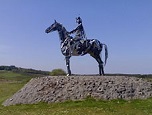
1599 There is plague outbreak in Spain. In Feb. Cambridge-educated historian Sir John Hayward (1560-1627) pub. The First Part of the Life and Raigne of King Henry the Fourth, dedicated to Robert Devereux, 2nd earl of Essex, which pisses-off Elizabeth I at the thought that the public might equate Essex with Henry Bolingbroke, and after ordering Sir Francis Bacon to find ways he can be charged for treason, to which Bacon comes back with the soundbyte: "Surely I found none, but for felony very many" because he plagiarized Tacitus, he is imprisoned for having discussed the deposition of a sovereign in print (until 1600); rumors start of an Essex coup on the aging queeny? On Mar. 27 the 2nd Earl of Essex leaves London, arrives in Dublin on Apr. 15 with 17K troops, and loses all but 4K of his men by Aug. without engaging Hugh O'Neill directly; on Aug. 15 (eve.) the Battle of Curlew Pass sees 1.5K tired-hungry English infantry and 200 cavalry under Sir Conyers Clifford get ambushed while marching through a pass in the Curlew Mts. near Boyle, W Ireland by an equal number of Irish troops plus 600 musketeers and 160 Gallowglassses led by Red Hugh O'Donnell, losing 231 KIA and 218 wounded vs. unknown losses for the Irish, becoming the last time the Irish Gaelic clans win on Irish soil before their final defeat at Kinsdale in 1601; in 1999 the sculpture the Gaelic Chieftain by Maurice Harron (1946-) is erected 2 km NE of the battlefield; on May 29 the Battle of Deputy's Pass in County Wicklow, Leinster is a V for 450 Irish under Felim McFiach O'Byrne (son of Fiach McHugh O'Byrne) over 500 English under Sir Henry Harrington, who lose 250, vs. only 20 Irish; on Sept. 7 outnumbered 2-to-1, Essex makes a secret truce with Irish rebel Hugh O'Neill at the Ford of Bellaclynth on the River Lagon near Carrickmacross, then suddenly abandons his army on Sept. 24, rushes back to England, and reaches Westminster on Sept. 28, where he brashly barges into the queen's bedchamber all muddy before she has time to put on her weird white (lead or bismuth based?) makeup (he has really done it this time?); after ascertaining that the rumors that he was leading his army to her palace to stage a coup are unfounded, she has him put under house arrest for botching the Ireland expedition (which MP Robert Cecil calls the heaviest loss by the English on Irish soil along with the Battle of Deputy's Pass in Wicklow), and on Nov. 29 the Star Chamber condemns him without a trial, causing him to get (play?) sick to try and get back in the queen's favor, without success? On Apr. 26 Mansa Mahmud IV (Mansa Mamadou III), last great emperor of the Mali Empire attacks Jenne (Jenné) in C Mali, but is repulsed by Moroccan forces from Timbuktu, ending Mali's influence in the middle Niger region and beginning its disintegration - go team? On June 1 Bishop's Ban of 1599 sees Archbishop John Whitgift of Canterbury and Bishop Richard Bancroft of London ban all satires and epigrams, along with any work written by Thomas Nash or Gabriel Harvey, nine specific books by John Davies, Joseph Hall, John Marston et al., and any books pub. without the approval of the Privy Council, becoming "the most sweeping and stringent instance of early modern censorship" (Debora Shuger). On Sept. 18-Oct. 20 Swiss physician Thomas Platter the Younger (1574-1628) visits London theatres, and on Sept. 21 (2:00 p.m.) attends a performance of Shakespeare's "Julius Caesar" at the Globe Theatre, later writing about it and giving precious details, incl. the stench in the dog enclosure in the rear, where 120 English mastiffs are chained in separate kennels next to a stall with 12 large bears, one blind, and another stall with several bulls: "And the place was evil-smelling because of the lights [offal] and meat on which the butchers fed the said dogs." On Sept. 11 (9/11) innocent beautiful 22-y.-o. babe Beatrice Cenci (b. 1577) is executed at Sant'Angelo Bridge in Rome along with three members of her family for murdering her brutal aristocrat dad Francesco, who had sexually abused her, after which she is buried in the Church of San Pietro in Montorio and becomes a symbol of resistance to the aristocracy, complete with a legend about her ghost returning to the bridge each year carrying the severed head; her portrait is painted by Guido Reni (1575-1642), and she later becomes a favorite subject for novelists and playwrights, incl. Percy Bysshe Shelley (who views the portrait in Palazzo Colonna in 1818), Nathaniel Hawthorne, and Alexandre Dumas pere. On Sept. 25 after being put up to it by Prince Iremia Movila of Moldavia (whose brother Simion claims the Wallachian throne), Prince-Cardinal Andrew Bathory of Transylvania issues an ultimatum demanding that Michael the Brave of Wallachia abdicate; on Oct. 18 a joint army led by Michael the Brave and Austrian Hapsburg gen. Giorgio Basta (1544-1607) defeats Bathory in the Battle of Selimbar near Sibiu, and Bathory is killed a few days later; after Michael gives Bathory an impressive funeral in Alba Iulia, he is given the keys to the fortress by Roman Catholic bishop of Kalocsa (since 108) Demeter Napragy (Napragyi) (1564-1619) (chancellor of Transylvania in 1598-1600), and on Oct. 10 the Transylvanian nobles elect him prince of Transylvania, and he acknowledges Hapsburg overlordship while planning to get even with Moldavia. On Dec. 17 James VI of Scotland changes the date of the Scottish New Year (Hogmanay) from Mar. 25 to Jan. 1. Sigismund III lands in Sweden to try to drum-up support for his Roman Catholic reign; too bad, the Swedes don't buy it, and next year the Riksdag formally deposes him. Maximilien de Bethune (Béthune), Duke of Sully (1560-1641), France's supt. of finances reforms taxation, economic policy, agriculture and overseas trade. The Confederation of Vilna is formed in Poland-Lithuania as an alliance between the Eastern Orthodox and Protestants against the pesky Roman Catholic Church, esp. the Jesuits. After spoilsport Christian IV of Denmark takes Uraniborg Castle back, HRE Rudolf II makes Danish astronomer ("The Nose Knows") Tycho Brahe (1546-1601) his royal astronomer and imperial mathematician in Bohemia, with a 3K ducat pension and an estate at Benatky (Benátky) near Prague, complete with a new Uraniborg; too bad, it isn't completed until after his death - lazy Bohemian comments here? China helps Korea expel the Japanese. Barom Reachea III (Ponhea An) becomes king of Cambodia (until 1600). Henri IV of France divorces 40-something Queen Margot (Margaret of Valois) (married one week before the Bartholomew's Day Massacre in 1572). After getting pissed-off at being taxed for their gold trade, the super-fierce head-shrinking Jivaro (Jivoaroan) tribes in the Peruvian Amazon band together and kill 25K Spanish in Logorno and another settlement, after which they are never conquered. The first postal rates are fixed in Germany. The first chamber of commerce is founded in Marseille, France. James VI of Scotland issues a charter to Arbroath. Edmund Spenser (b. 1552) dies, and Samuel Daniel (1562-1619) becomes unofficial poet laureate of England (until Oct. 14, 1619). Robert Bellarmine becomes a cardinal and a member of the Roman Congregation - I want somebody to burn? The Trinh family in N Vietnam takes the title of hereditary prince, pissing-off the rival Nguyen family in S Vietnam; both proceed to set up Confucian state govts. Sir Anthony Shirley (1565-1635) and his brother Sir Robert Shirley (1581-1628) travel to Persia to try and talk Shah Abbas I into attacking the Turks, and are warmly welcomed; elder bro' Anthony is made a prince (mirza) and becomes a Persian envoy, visiting Moscow, Prague, and Rome, but England won't allow him to enter, considering him a traitor (the original Dances With Wolves?), and he ends up a count of the HRE and Spanish adm.; meanwhile he leaves his brother Robert in Persia to modernize the Persian military (introducing muskets and artillery, plus English militia cavalry tactics), and he ends up marrying a Persian Circassian babe and becoming an envoy - it's the good life? Elizabeth I sends Ottoman sultana Sofia Baffo a carriage, which she rides in around Constantinople, scandalizing the pop. although it is covered. William Shakespeare enters his High Fantastical Age (1599-1601). The Farnese Hercules by 1st cent. B.C.E. sculptor Glycon of Athens is found in the ruins of the Baths of Caracalla in Rome. Architecture: The 2.5K-seat open-roofed Globe Theatre (a 20-sided icosagon) in Southwark, London is built by Richard Burbage and the Lord Chamberlain's Men after Giles Allen, owner of the land under the N London Playhouse they had been performing in claimed to own the playhouse as well, causing them to dismantle the building at night and ferry it across the Thames to the S bank and rebuild it; Allen tries to take them to court but loses. Inventions: Rev. William Lee of Calverton, Notts, England develops the first silk-knitting machine. Nonfiction: Ulisse Aldrovandi (1522-1605), Natural History (14 vols.); the first textbook on zoology: three vols. on ornithology (birds) are pub. this year, followed by a vol. on etymology (insects) in 1602; after his death his students go on to pub. 10 more vols. from his notes. Nicholas Breton (1545-1626), The Wil of Wit. Angel Day, The English Secretary. James VI of Scotland, Basilikon Doron (Gr. "royal gift"); pro divine right of kings; written for his son Prince Henry, who dies before becoming king. George Silver, Paradoxes of Defense; claims to prove that "the short sword has advantage over the long sword or rapier", and founds the art of fencing. Art: Giambologna (1529-1608), Hercules Beating the Centaur Nessus (1599); Caravaggio (1571-1610), The Martyrdom of St. Matthew; The Calling of St. Matthew; Jupiter, Neptune and Pluto. Plays: Guillen de Castro y Bellvis (1569-1631), Mocedades del Cid; used by Pierre Corneille as a basis for his "Le Cid" (1636). Thomas Dekker (1570-1632), The Shoemaker's Holiday. Ben Jonson (1572-1637), Every Man Out of His Humour. John Marston (1576-1634), Histriomastix (Middle Temple); how war results from pride, greed, and sloth, dissing women and prof. actors, along with Ben Jonson (Chrisoganus), beginning the War of the Theatres (Poetomachia) with him and Thomas Dekker (1599-1602). George Peele (1556-97), The Love of King David and Fair Bethsabe (posth.). William Shakespeare (1564-1616), Julius Caesar (tragedy) (Brutus has 701 lines, 12th most); Caesar speaks less than 150 lines, and is murdered in Act 3 Scene 1; Julius Caesar and his wife Calphurnia, Mark Antony, Octavius Caesar, Marcus Brutus ("the noblest Roman of them all" - Antony, 5.5.68), Cassius ("Yon Cassius has a lean and hungry look; He thinks too much: Such men are dangerous" - Caesar), Lepidus; the 2nd of four Shakespeare plays to have a ghost on stage ("Great Caesar's ghost") (Richard III, Hamlet, Macbeth); "It was Greek to me" (Casca) (1.2.288); "... and there have sat/ The livelong day, with patient expectation,/ To see great Pompey pass the streets of Rome" (Marullus) (1.1.38-43); "Beware the ides of March" (1.2.18); "Why, man, he doth bestride the narrow world/ Like a Colossus" (Cassius) (1.2.133-4); "Cowards die many times before their deaths;/ The valiant never taste of death but once." (Caesar) (2.2.32-3); "I am constant as the northern star" (Caesar) (3.1.60); "Et tu, Brute? Then fall, Caesar" (Caesar's last words) (3.1.77); "Not that I loved Caesar less, but that I loved Rome more" (Brutus) (3.2.21); "Friends, Romans, countrymen, lend me your ears;/ I come to bury Caesar, not to praise him./ The evil that men do lives after them,/ The good is oft interred with their bones" (Antony) (3.2.79-82); "For Brutus is an honorable man;/ So are they all, all honorable men" (3.2.88-9); "Ambition should be made of sterner stuff" (3.2.98); "This was the most unkindest cut of all" (3.2.188); "Cry Havoc!, and let slip the dogs of war" (3.1.273); "Put a tongue/ In every wound of Caesar, that should move/ The stones of Rome to rise and mutiny" (3.2.232-3); "Forever and forever, farewell, Cassius!/ If we do meet again, why, we shall smile;/ If not, why then, this parting was well made" (5.1.117); "It is is impossible... to look without a revulsion... at this travestying of a great man as a silly braggart, whilst the pitiful gang of mischief-makers who destroyed him are lauded as statesmen and patriots" (George Bernard Shaw); As You Like It (1599-1600) (comedy) (Rosalind has 668 lines, 16th most); based on Thomas Lodge's prose romance "Rosalynde" (1590); set in the Arden Forest in Warwickshire or the Ardennes in France; The Duke, his cross-dressing daughter Rosalind/Ganymede (most admirable Shakespeare character?) and her Herculean wrestler lover Orlando (son of Sir Rowland de Boys), the Duke's brother Duke Frederick, his attending lords Jaques (pr. likes Jakes) and Amiens, his courtier Le Beau, "motley fool" Touchstone the clown (truant court jester) (a touchstone to prove Rosalind's golden spirit), vicar Sir Oliver Martext, Orlando's brother Oliver and Rosalind's friend Celia/Aliena (daughter of Frederick), lovesick shepherd Silvius and Phoebe, old faithful servant Adam (played by Shakespeare?); "Sweep on, you fat and greasy citizens" (2.1.55); "I met a fool i' th' forest,/ A motley fool" (Jaques) (2.7.12-13); "All the world's a stage, and all the men and women merely players" (Jaques) (2.7.139-40); "Time travels in divers paces with divers persons" (3.2.328); "When a man's verses cannot be understood, nor a man's good wit seconded with the forward child, understanding, it strikes a man more dead than a great reckoning in a little room" (Touchstone) (3.3.9-11) (reference to Marlowe?); "Dead shepherd, now I find thy saw of might: "Who ever lov'd that lov'd not at first sight?" (3.5.91) (from Christopher Marlowe); "Men have died from time to time, and worms have eaten them, but not for love" (Rosalind) (4.1.103); "Why then, can one desire too much of a good thing?" (Rosalind) (4.1.116-7); "Men are April when they woo, December when they wed. Maids are May when they are maids, but the sky changes when they are wives" (Rosalind) (4.1.136-8). William Shakespeare (1564-1616), The Tragedy of Hamlet, Prince of Denmark (1600-1) (tragedy) (a first vers. was written in 1588-93?); set in Elsinore (Helsingor) (site of Kronborg Castle); hammy Hamlet has 1,422 lines, most of any Shakespearean role; Shakespeare plays the ghost?; Ophelia's death is based on the death of Shakespeare's 5-y.-o. cousin Jane Shaxspere (-1569), whose lifeless body was found in a pond in Upton Warren, Worcestershire 20 mi. from Stratford-upon-Avon in 1569?; Danish prince Hamlet avenges the murder of his father the king by killing evil uncle Claudius while fighting bipolar disease?; Prince Hamlet of Denmark, King Claudius of Denmark (Hamlet's uncle) and Queen Gertrude (Hamlet's mother), sententious advisor Polonius and his son Laertes and daughter (Hamlet's babe?) Ophelia (who goes mad); Norwegian Prince Fortinbras; Hamlet's loyal friend Horatio and disloyal friends Rosencrantz and Guildenstern; the fictitious play "The Murder of Gonzago"; "Some say that ever 'gainst that season comes/ Wherein our Saviour's birth is celebrated,/ This bird of dawning singeth all night long;/ And then, they say, no spirit dare stir abroad,/ The nights are wholesome, then no planets strike,/ No fairy takes, nor witch hath power to charm,/ So hallow'd and so gracious is the time." (1.1.11-17); "Not a mouse stirring" (1.1.10); "The memory be green" (1.2.2); "Frailty, thy name is woman!" (1.2.146); "It is not nor it cannot come to good" (1.2.158); "Thrift, thrift, Horatio! The funeral baked meats/ Did coldly furnish forth the marriage table" (Hamlet) (1.2.180-1); "In my mind's eye, Horatio" (1.2.185); "I doubt some foul play" (1.2.254); "Do not, as some ungracious pastors do,/ Show me the steep and thorny way to heaven,/ Whiles, like a puff'd and reckless libertine,/ Himself the primrose path of dalliance treads,/ And recks not his own rede" (1.3.51-5); "Neither a borrower nor a lender be,/ For loan oft loses both itself and friend" (Polonius) (1.3.75-6); "This above all: to thine own self be true,/ And it must follow, as the night the day,/ Thou canst not then be false to any man" (Polonius to Laertes) (1.3.78-82); "Something is rotten in the state of Denmark" (1.4.90); "Murder most foul, as in the best it is" (1.5.27); "Yea, from the table of my memory/ I'll wipe away all trivial fond records" (1.5.98-9); "Within the book and volume of my brain" (1.5.103); "One may smile, and smile, and be a villain" (1.5.108); "There are more things in heaven and earth, Horatio, than are dreamt of in your philosophy" (Hamlet) (1:5.166); "To put an antic disposition on" (1.5.172); "The time is out of joint" (1.5.188); "They say an old man is twice a child" (2.2.413); "The play, I remember, pleased not the million; 'twas/ caviare to the general" (2.2.465); "They are the abstracts and brief chronicles of the time" (2.2.555); "Oh! what a rogue and peasant slave am I" (2.2.584); "What's Hecuba to him or he to Hecuba,/ That he should weep for her?" (2.2.593); "Brevity is the soul of wit... More matter, with less art" (2.2.90-5); "The apparel oft proclaims the man" (Polonius); "There is nothing either good or bad, but thinking makes it so" (2.2.259); "This goodly frame, the earth, seems to me a sterile promontory" (2.2.317); "What a piece of work is a man! How noble in/ reason! how infinite in faculty! in form, in moving,/ how express and admirable! in action how like an/ angel! in apprehension how like a god!" (2.2.322-5); "The play's the thing/ Wherein I'll catch the conscience of the king" (Hamlet) (2.2.641); "To be, or not to be: that is the question/ Whether 'tis nobler in the mind to suffer/ The slings and arrows of outrageous fortune,/ Or to take arms against a sea of troubles,/ And by opposing end them?/... To die, to sleep;/ To sleep: perchance to dream: ay, there's the rub;/ For in that sleep of death what dreams may come/ When we have shuffled off this mortal coil/ Must give us pause" (Hamlet) (3.1.56-68); "The undiscover'd country from whose bourn/ No traveler returns" (3.1.79-80); "There's hope a great man's memory may outlive his life half a year" (3.2.141); "For 'tis a question left us yet to prove,/ Whether love lead fortune or else fortune love" (Player King) (3.2.197-8); "The lady doth protest too much, methinks" (3.2.242); "My words fly up, my thoughts remain below/ Words without thoughts never to heaven go" (Claudius) (3.3); "Oh shame! where is thy blush?" (3.4.82); "I must be cruel only to be kind" (3.4.178); "A man may fish with the worm that hath eat of a king,/ and eat of the fish that hath fed of that worm" (4.3.29); "We know what we are, but know what we may be" (4.5.43); "Alas! poor Yorick. I knew him, Horatio; a fellow of/ infinite jest, or most excellent fancy" (5.1.201-2); "Sweets to the sweet: farewell" (5.1.265); "Any dog will have his day" (5.1.313); "There's a divinity that shapes our ends,/ Rough-hew them how we will" (5.2.10); "It did me yeoman's service" (5.2.36); "The rest is silence" (Hamlet's last words) (5.2.372); "Good night, sweet prince,/ And flights of angels sing thee to thy rest!" (5.2.373); an "artistic failure" (T.S. Eliot); "The only objection to Hamlet is that it exists" (Ralph Waldo Emerson). Poetry: William Jaggard (1568-1623), The Passionate Pilgrim; printed by a London publisher whose shop is "at the sign of the Half-Eagle in Barbican", who later pub. Shakespeare's First Folio; contains 20 pieces attributed to "W. Shakespeare", of which only five really are?; some are claimed by Richard Barnfield, becoming his last work, after which dies in the London plagues. Samuel Daniel (1562-1619), Poetical Essays; incl. Musophilus, A Letter from Octavia to Marcus Antonius. Sir John Davies (1569-1626),Nosce Teipsum (Lat. "Know Thyself"); Hymns of Astraea; acrostic poems addressed to "Elizabetha Regina". Mary Sidney Herbert (1561-1621), The Sidney Psalms; presented to Elizabeth I; a trans. of the Psalms based on the 1560 Geneva Bible and commentaries of John Calvin and Theodore Beza (1519-1605), started by her brother Philip Sidney. Francois de Malherbe (1555-1628), Consolation a Duperier. Novels: Mateo Aleman (Alemán), Guzman de Alfarache (1599-1604) (picaresque); the son of a bankrupt Genoese moneylender. Births: Flemish Baroque painter ("the Mozart of Painting") Sir Antoon (Anthony) van Dyck (Vandyke) (d. 1641) on Mar. 22 in Antwerp; 7th child of silk merchant Frans van Dyck; apprentices at age 10 (1609) to painter Hendrick van Balen; pupil of Peter Paul Rubens (1618-20); in 1632 Charles I of England becomes his royal patron and knights him. English gen., statesman, Lord Protector of England and crypto-prophet ("more butcher than king in England") Oliver Cromwell (d. 1658) on Apr. 25 in Huntingdon, Cambridgeshire; 2nd son of Robert Cromwell; great-grandson of Richard Cromwell (Williams), nephew of Thomas Cromwell, earl of Essex (1485-1540); father of Richard Cromwell (1626-1712); educated at Huntingdon Free School under Puritan Dr. Thomas Beard, and Sidney Sussex College, Cambridge U. (1616-7); known for having three big moles on his face and telling his portraitist to show "warts and all"; his life rides a river of Millennium Fever straight to the year 1666; it helps being born in 1599 (66 upside down), along with the fact that 1+5=6? Spanish "Las Meninas", "The Rokeby Venus" #1 Baroque painter Diego Rodriguez de Silva y Velazquez (Velázquez) (Velasquez) (d. 1660) on June 6 in Seville, Andalusia; masters every branch of painting except marine? Swiss Baroque sculptor-architect Francesco Borromini (Castelli) (d. 1667) on Sept. 25 in Bissone, Ticino; asst. to Gian Lorenzo Bernini. English statesman-writer Sir Denzil Holles, 1st Baron Holles (d. 1680) on Oct. 31; 2nd son of John Holles, 1st earl of Clare (1564-1637) and Anne (daughter of Sir Thomas Stanhope). German electress Maria Eleonore of Brandenburg (d. 1655) on Nov. 11. Dutch painter Pieter Bodding van Laer (d. 1642) on Dec. 14 in Haarlem. Austrian field marshal Prince Octavio Piccolomini d'Aragona, Duke of Amalfi (d. 1656) in Florence. Italian Pope (1655-67) Alexander VII (Fabio Chigi) (d. 1667). Am. Pilgrim settler (cooper) John Alden (d. 1687) in Southampton, Hampshire, (Harwich, Essex?) England. Deaths: Italian radical Domenico Scandella (b. 1532) in Montereale (burned at the stake for heresy). Ottoman religious scholar Saduddin Efendi (b. 1536); leaves Taj ul-Tevarih (The Crown of Histories), a history of the Ottoman Empire to 1520. Korean field marshal Gwon Yul (b. 1537). English writer Reginald Scot (b. 1538) on Oct. 9 in Smeeth, Kent. Italian-Dutch painter Friedrich Sustris (b. 1540) in Munich. Ottoman historian Mustafa Ali (b. 1541); leaves Kunh ul-Ahbar (a universal history), and Book of Counsel for Sultans (1581), lamenting the Ottoman decline. Good year to die young? English poet Edmund Spenser (b. 1552). Italian composer Luca Marenzio (Marencio) (b. 1553). Italian tragic heroine Beatrice Cenci (b. 1577) on Sept. 11 at Sant'Angelo Bridge, Rome (beheaded).